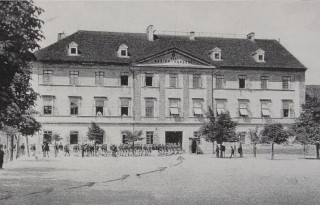
Mariánská kasárna in CB (Budweis). Until 1 June 1915 it was the home of the Good Soldier Švejk's Infanterieregiment Nr. 91. In 1915 Jaroslav Hašek also served with the regiment in these barracks.
The novel The Good Soldier Švejk refers to a number of institutions and firms, public as well as private. On these pages they were until 15 September 2013 categorised as 'Places'. This only partly makes sense as this type of entity can not always be associated with fixed geographical points, in the way that for instance cities, mountains and rivers can. This new page contains military and civilian institutions (including army units, regiments etc.), organisations, hotels, public houses, newspapers and magazines.
The line between this page and "Places" is blurred, churches do for instance rarely change location, but are still included here. Therefore Prague and Vienna will still be found in the "Places" database, because these have constant coordinates. On the other hand institutions may change location: Odvodní komise and Bendlovka are not unequivocal geographical terms so they will from now on appear on this page.
The names are colour coded according to their role in the plot, illustrated by these examples: U kalicha as a location where the plot takes place, k.u.k. Kriegsministerium mentioned in the narrative, Pražské úřední listy as part of a dialogue, and Stoletá kavárna, mentioned in an anecdote.
 Institutions index of institutions, taverns, military units, societies, periodicals ... (286)
Show all
Institutions index of institutions, taverns, military units, societies, periodicals ... (286)
Show all I. In the rear
I. In the rear  14. Švejk as military servant to senior lieutenant Lukáš (14)
14. Švejk as military servant to senior lieutenant Lukáš (14) II. At the front
II. At the front  1. Švejk's mishaps on the train (15)
1. Švejk's mishaps on the train (15) 2. Švejk's budějovická anabasis (38)
2. Švejk's budějovická anabasis (38) 3. Švejk's happenings in Királyhida (44)
3. Švejk's happenings in Királyhida (44) 4. New afflictions (26)
4. New afflictions (26)



|
I. In the rear |
 | |
Introduction | |||
 | Temple of Artemis |  | |||
| |||||


Výbor ze spisů Xenofontových, ,1880
Temple of Artemis is mentioned indirectly in the author's description of Herostratus, "he who set fire to the temple of the goddess in Ephesus".
Background
Temple of Artemis was a temple in Ephesus, regarded as one of the seven wonders of the world. It was raised in the honour of the goddess Artemis. The temple burnt down in 356 BC (Herostatos), but was rebuilt after. Today there are only ruins left.
Quote(s) from the novel
[Úvod] On nezapálil chrám bohyně v Efesu, jako to udělal ten hlupák Herostrates, aby se dostal do novin a školních čítanek.
Also written:Artemidin chrámczTempel der Artemisde



|
I. In the rear |
 | |
1. The good soldier Švejk acts to intervene in the world war | |||
 | Drogerie Průša |  | |||
| Královské Vinohrady/699, Tylovo nám. 19 | |||||
| |||||
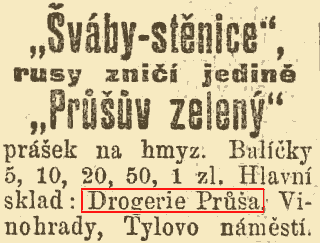
,24.6.1903
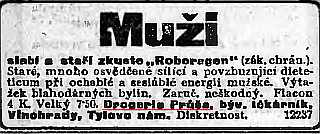
,6.5.1910
Drogerie Průša was the chemist's store where the first sluha u Průši Ferdinand was an assistant. He drank a bottle of hair oil by mistake.
Background
Drogerie Průša was a chemist's store at Tylovo náměstí right on the lower corner with Vávrova třída at Vinohrady. Jaroslav Hašek worked as an apprentice here some time between March 1898 and September 1899.
Over the years several newspaper adverts testify to the existence of the chemist's, confirmed by address book entries. In 1906 discrete newspaper adverts for remedies against "men's problems" appeared, but they also advertised remedies against bed-bugs. In August 1915 an advert appeared in Prager Tagblatt where large amounts of furniture was for sale, indicating that the shop was about to close down. The owner was drogista Průša (František).
Quote(s) from the novel
[I.1] Jednoho, ten je sluhou u drogisty Průši a vypil mu tam jednou omylem láhev nějakého mazání na vlasy, a potom znám ještě Ferdinanda Kokošku, co sbírá ty psí hovínka. Vobou není žádná škoda.“
Sources: Jaroslav Šerák, Radko Pytlík
Literature
- Z droguerieJaroslav Hašek24.3.1904
- Ferdinand Kokoška & spol.
- Roboragen21.4.1906
- Průšův prašek zelený7.5.1908
- Verkaufe billig18.8.1915
 | K.u.k. Heer |  | |||
| Wien I., Stubenring 1 | |||||
| |||||
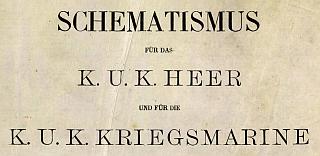
1914
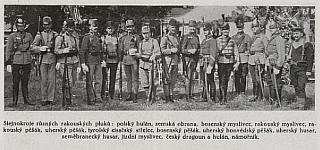
Uniforms of the Austro-Hungarian armed forces.
,31.7.1914
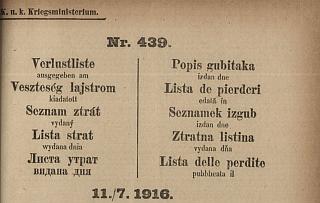
Example of a casualty list
,11.7.1916
K.u.k. Heer is first mentioned (as "the army") in an anecdote Švejk tells from his time doing compulsory military service. This is in the conversation with Mrs. Müllerová at the very start of The Good Soldier Švejk. After this the army is mentioned innumerable times, and is the most important backdrop for the novel where Švejk is a soldier) from the middle of Part One. The army is also the principal target of Hašek's satire.
Background
K.u.k. Heer (also called k.u.k. Armee or Gemeinsame Armee) was the largest and most important body in k.u.k. Wehrmacht. Together with the k.k. Landwehr (Austrian national guard) and the Honvéd (Hungarian national guard) it made up the Landstreitkräfte (terrestrial forces). These and the k.u.k. Kriegsmarine (navy) made up the total armed forces of the Dual Monarchy.
The common army consisted of infantry, cavalry, artillery, supply-troops and technical troops. The period of service was until 1912 three years, then two. During the war, losses were replaced by so-called march battalions, one of which Švejk was later to be assigned to. The common army existed from 1867 to 1918 and suffered disastrous losses in World War I, the only full-scale war it ever participated in. At various time it fought on four fronts; Serbia, Galicia, Romania and Tyrol and after the heavy losses in 1914 it became increasingly dependant on German support.
The army command was from 1913 located in the building of the k.u.k. Kriegsministerium at Stubenring 1, Vienna. At the time when Švejk did his military service they were surely still at the old premises in Am Hof 2. This building was demolished in 1912.
Oberbefehl formally lay with the monarch who communicated with the army through Militärkanzlei Seiner Majestät des Kaisers und Königs. Kriegsministerium was responsible for the day to day operation of the army. From 1914 to 1917 Archduke Friedrich was general inspector of the army but he delegated the operative responsibility to field marshal Feldmarschall Conrad.
Quote(s) from the novel
[I.1] Jó, paní Müllerová, dnes se dějou věci. To je zas ztráta pro Rakousko. Když jsem byl na vojně, tak tam jeden infanterista zastřelil hejtmana. Naládoval flintu a šel do kanceláře.
Also written:Austro-Hungarian ArmyenRakousko-uherská armádaczAusterrike-Ungarns Hærno
Literature
- Schematismus für das k.u.k. Heer (s. 50)1914
- Veltzés Internationaler Armee-Almanach1914
- The First World War and the end of the Dual Monarchy2014
- 1914 - 2014, 100 Jahre erster Weltkrieg
- Handbuch für den Infanteristen des k.u.k. Heeres, sowie der k. k. Landwehr1914
- Zákon branný1869
- Branná moc v míru i ve válce1914
- Österreich-Ungarns bewaffnete Macht 1900 - 1914
- Die Österreichisch-Ungarische Armee 1914 - 1918
- Zentralleitung und Militärbehörden
- Die Gesamtverluste ...
- Unteilbar und Untrennbar1917
 | U kalicha |  | |||||
| Praha II./1732, Na Bojišti 14 | |||||||
| |||||||
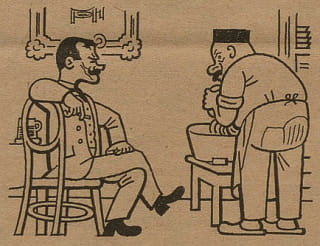
,11.11.1923

,2.8.1899

,7.11.1913

,17.11.1917

,14.11.1923

Chytilův adresář hl. města Prahy,1924
U kalicha is mentioned 17 times in The Good Soldier Švejk.
U kalicha is the tavern where Švejk and pubkeeper Palivec were arrested by detective Bretschneider at the very start of the novel. This probably happened on 29 June 1914 as the news about the murders in Sarajevo appeared in the newspapers on that day (Mrs. Müllerová had just read about it).
The plot returns to U kalicha in [I.6] when Švejk is released from his ordeal, again meets detective Bretschneider, and convinces the detective to buy dogs from him. His last visit is in [I.10,4] after he has started his career as officer's servant with Feldkurat Katz. Mrs. Palivcová refuses to serve him as she thinks he is a deserter.
U kalicha is also mentioned in [II.4] in the classic scene from Bruck when Švejk and Sappeur Vodička promise to meet there after the war, at six in the evening - one of the most famous quotes from the entire novel. Here Švejk reveals that U kalicha served beer from Velké Popovice.
Background
U kalicha is the name of a restaurant in Na Bojišti street in Nové město, and also the name of the building where the restaurant is located. Today it is, thanks to The Good Soldier Švejk, a major tourist attraction, but in 1914 it was an ordinary pub with one tap-room. Proofs of the tavern's existence appear already in 1896 when Vilém Šubert is listed as landlord at Na Bojišti 8. In 1899 adverts reveal that it already then was known as U kalicha and that it was located in Na Bojišti 1732/8, in the same building as today. That year the owner was trying to sell new bicycles, presumably as a side business. The building has existed since 1890 or slightly earlier. In 1907 the property was advertised for sale and the advert even mentioned the pub.
In the 1910 address book it is listed at Na Bojišti 1732/14. The landlord is now Vilém Juris, who in 1907 is registered as landlord of a pub in Smíchov. Police records reveal that he lived at Na Bojišti 1732 from 18 July 1908, was born in 10 June 1871 and married to Blahoslava. In 1913 he placed adverts specifically aimed at students and he used the name U zlatého kalichu. Juris marketed his establishment "as a well known meeting spot for students, with concerts every day and open until the morning". In 1917 some Vaneček had taken over the license. In April 1923 adverts reveal that the pub had been renamed Café Evropa and offered French cuisine, and the 1924 address book lists the owner as Josef Kyral. Adverts from November 1923 show signs that U kalicha had started to exploit its connection to The Good Soldier Švejk.
Hašek and U kalicha, an unclear connection

© VÚA
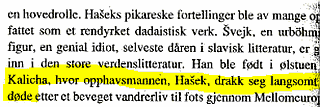
A blip from Elsbeth Wessel
It remains unclear why Jaroslav Hašek gave U kalicha such a prominent role in the novel as none of his biographers or friends mentions it as a place he frequented. Nor do we have been able to confirm that they actually served beer from Velké Popovice but as this was the largest producer in all of Bohemia there is every reason to believe that Švejk is right.
One possible connection is one Josef Švejk (1892-1965) who from 1912 onwards lived two houses down the street. This is a person the author may have known about, particularly since both were volunteers in České legie from 1916. In this context it is worth mentioning that there is no mention of U kalicha in the 1911 and 1917 versions of The Good Soldier Švejk so the author's knowledge of this person may indeed have inspired Hašek to introduce U kalicha in the novel. The soldier's first name Josef is also introduced for the first time in the novel from 1921.
We also know that Jaroslav Hašek associated with students from the technical college so he may have been drawn to U kalicha by them. That he knew the environs of U kalicha is also clear. Two houses down, in number 463/10, a brothel was registered on Antonín Nosek (1912). This could explain why Švejk told Sappeur Vodička that "they have girls there".
The well known Norwegian germanist Elsbeth Wessel contributes a most peculiar item. In an otherwise insightful chapter on Hašek she informs that "that the author slowly drank himself to death at U kalicha". Who the source of this nonsense is we don't know, but this should be regarded as a blip as the rest of her contribution is of high quality.
Legends forming

,5.12.1929
Over the years a number of legends have been spun around U kalicha and Jaroslav Hašek’s novel. An early example is Maxmilian Huppert[a] who claimed that a certain František Švejca (born 1875) was a regular there, traded in stolen dogs, and adds a number of details that bear the hallmarks of trying to adapt reality to fit the novel. Hupperts crown witness is a former landlord at U kalicha, Ferdinand Juris. He claims to have known this "Švejk". More tangible is the information that U kalicha no longer operated and that the premises now were used for storing flour.
In 1968 a related story appeared in the weekly magazine Květy (12 September 1968, signed J.R Veselý). It contained sensational claims that a Josef Švejk was in fact a friend of Jaroslav Hašek and that they met on several occasions before, during and after the war. Much of the story has been verified, but the details that attempt to connect this Švejk to Hašek appears to be invented. See Josef Švejk for details.
A web of hearsay
In his book Die Abenteuer des gar nicht so braven Humoristen Jaroslav Hašek (1989) Jan Berwid-Buquoy threw in several new but rather "colourful" items. It is claimed that a Marie Müllerova was a brothel madam in the same building, that František Strašlipka, the alleged model for Švejk, was a regular there and was even her lover, that Palivec was a waiter there, that the landlord was a certain foul-mouthed Václav Šmíd. The author has since re-spun and expanded the story a few times, through another book (2011) and an article in Reflex (2012). He even changed the name of the landlord and other details, but the essence of the information has not been possible to confirm. Later it was claimed that Anastasie Herzog bought the building in 1907. Police records show that the businessman Benno Herzog actually lived in the building in 1912, but the only Anastasie Herzog showing up in police records was his daughter, born in 1907! The 1906 address books lists the owner of the building U kalicha as Karel Císař.
In the end these stories appear to be based on hearsay. A more serious concern is that most it appears on the restaurant's own website (even in English and Russian), so the myths get propagated world-wide. Here even more "facts" are thrown in the pot: U kalicha is supposed to have become popular after the translation of The Good Soldier Švejk into German (1926) and particularly during the thirties when German journalists and men of letter came to visit Egon Erwin Kisch. In that case they would have been disappointed because the restaurant closed down some time between 1924 and 1929[a] (it is not present in the 1936 address book).
A tourist attraction
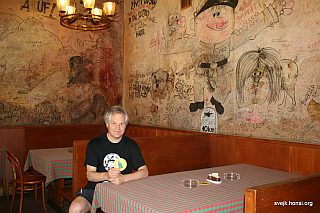
The original tap-room at No. 14 (2011)
Around 1955 U kalicha was expanded (probably re-opened), and deliberately turned into a tourist attraction. From then on the restaurant occupies both No 14. and No 12. It lives well on the connection with The Good Soldier Švejk, with prices above average and frequent tour groups visiting. Still U kalicha is worth a visit as it is decorated with memorabilia related to Švejk and the times of World War I. To avoid the crowds it is advisable to visit around lunchtime or early afternoon. The food is Czech, the menu comes in 27 languages!
Quote(s) from the novel
[I.1] Já teď jdu do hospody „U kalicha“, a kdyby sem někdo přišel pro toho ratlíka, na kterýho jsem vzal zálohu, tak mu řeknou, že ho mám ve svém psinci na venkově, že jsem mu nedávno kupíroval uši a že se teď nesmí převážet, dokud se mu uši nezahojí, aby mu nenastydly. Klíč dají k domovnici.“
[I.1] V hospodě U kalicha seděl jen jeden host. Byl to civilní strážník Bretschneider, stojící ve službách státní policie. Hostinský Palivec myl tácky a Bretschneider se marně snažil navázat s ním vážný rozhovor.
[I.1] A Švejk opustil hospodu U kalicha v průvodu civilního strážníka...
[I.1] Když vcházeli do vrat policejního ředitelství, řekl Švejk: "Tak nám to pěkně uteklo. Chodíte často ke Kalichu?" A zatímco vedli Švejka do přijímací kanceláře, u Kalicha předával pan Palivec hospodu své plačící ženě, těše ji svým zvláštním způsobem: "Neplač, neřvi, co mně mohou udělat kvůli posranýmu obrazu císaře pána?"
[I.1] Jestli situace vyvinula se později jinak, než jak on vykládal u Kalicha, musíme mít na zřeteli, že neměl průpravného diplomatického vzdělání.
[I.5] Nedávno u Kalicha nevyvedl jeden host nic jinýho, než že sám sobě rozbil sklenicí hlavu.
[I.6] Jeho uvažováni, má-li se stavit napřed ještě u Kalichu, skončilo tím, že otevřel ty dveře, odkud vyšel před časem v průvodu detektiva Bretschneidra.
[I.10.4] Pak se šel Švejk podívat ke Kalichu. Když ho paní Palivcová uviděla, prohlásila, že mu nenaleje, že asi utekl.
[I.16] Ceremoniář dr. Guth mluví jinak než hostinský Palivec u Kalicha a tento román není pomůckou k salónnímu ušlechtění a naučnou knihou, jakých výrazů je možno ve společnosti užívat. Jest to historický obraz určité doby.
[II.3] Jeden medik, který chodíval ke Kalichu, nám jednou vykládal, že to ale není tak jednoduchý.
[II.4] Když se Švejk s Vodičkou loučil, poněvadž každého odváděli k jejich části, řekl Švejk: "Až bude po tý vojně, tak mé přijel navštívit. Najdeš mé každej večer od šesti hodin u Kalicha na Bojišti."
[II.4] Potom se vzdálili a bylo slyšet zas za hodnou chvíli za rohem z druhé řady baráků hlas Vodičky: "Švejku, Švejku, jaký mají pivo u Kalicha?" A jako ozvěna ozvala se Švejkova odpověď: "Velkopopovický."
Also written:At the ChaliceenZum Kelchde
Literature
- Šubert Vilém1896
- Vilém Juris
- Pobytové přihlášky pražského policejního ředitelství1851 - 1914
- Pokoj12.11.1890
- Leštitelka6.9.1892
- Kolo7.5.1899
- Prodá se dům13.7.1907
- Kavárna U zlatého kalichu7.11.1913
- Zřisení kapely z vojenských invalidů8.10.1917
- Chytilův adresář hl. města Prahy1924
- Románové restaurační a jiné zábavní podniky2009 - 2021
- Osudy záhadného hostince U kalicha aneb Jak to vlastně bylo doopravdy?2.5.2012
- Povídání o Frantovi Strašlipkovi
- Between legends and reality
- Mezi legendou a skutečností
| a | Historisches vom Švejk | 5.12.1929 |
 | Staatspolizei |  | |||
| Praha I./313, Bartolomějská 4 | |||||
| |||||
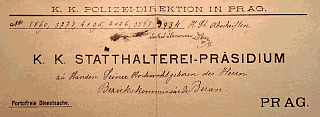
© LA-PNP
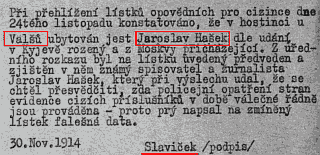
Hašek's encounter with state police after having registered as a Russian trader at U Valšů, 24 November 1914.
© LA-PNP

,21.8.1916
Staatspolizei is mentioned when it is revealed that detective Bretschneider is in the service of the state police.
Background
Staatspolizei (officially k.k. Staatspolizei) was the domestic civilian intelligence service of Cisleitanien, which main task was surveillance of potential enemies of the state. In the context of The Good Soldier Švejk we understand the Prag branch. The department was created in 1893 after civilian unrest and the unit reported directly to the "Statthalter" (Governor). In Prague their servicemen and agents were operating from the premises of c.k. policejní ředitelství. In their service were amongst others two young lawyers, Mr. Slavíček and Mr. Klíma. Head of the unit was Viktor Chum.
U Valšů
Jaroslav Hašek had intimate knowledge of the state police, originating from his period as an anarchist activist (from 1904). His most celebrated encounter with them was after his famous hoax at U Valšů on 24 November 1914 where he registered as a Russian trader, ostensibly to test the vigilance of the Austrian security service. He was let off with only 5 days in jail which he served immediately.
During the war
During the war the eyes of the state police again fell on Jaroslav Hašek. It happened after the author on 17 June 1916 published a story in Čechoslovan where he lets a tomcat soil pictures of the emperor. This led to charges of high treason and an arrest order was issued. Several of the other stories he wrote also aroused interest at home. They were translated to German for the benefit of the investigators and led to a lively exchange between the police headquarters in Prague and Vienna.
Dobrý voják Švejk v zajetí
… Švejka vedli k výslechu do oddělení státní policie přímo k policejnímu komisaři Klímovi a Slavíčkovi.
Quote(s) from the novel
[I.1] V hospodě „U kalicha“ seděl jen jeden host. Byl to civilní strážník Bretschneider, stojící ve službách státní policie. Hostinský Palivec myl tácky a Bretschneider se marně snažil navázat s ním vážný rozhovor.
Literature
- Pražské policejní ředitelství, jeho Státní(politická) policie a její informátoři …Zdeněk Kárník
- Za pana Drašnera
- Viktor Chum2018 - 2023
- Povídka o obrazu císaře Františka Josefa I.Jaroslav Hašek17.7.1916
- Po stopách státní policie v PrazeJaroslav Hašek21.8.1916
- Bašta germanisace3.12.1917
 | Vinárna Sarajevo |  | |||
| |||||
Vinárna Sarajevo was a wine tavern in Nusle where, according to pubkeeper Palivec, there was fighting every day.
Background
Vinárna Sarajevo has yet to be identified. According to Milan Hodík pubkeeper Palivec may have referred to a small pub known as Bosna in Michle[a].
Milan Hodík
Šlo nejspíš o malou hospodu zvanou Bosna na michelském kopce nad Bondyho statkem.
Quote(s) from the novel
[I.1] „Ty nám to pěkně v tom Sarajevu vyvedli,“ se slabou nadějí ozval se Bretschneider. „V jakým Sarajevu?“ otázal se Palivec, „v tej nuselskej vinárně? Tam se perou každej den, to vědí, Nusle.“
| a | Encyklopedie Švejka II. díl | 1998 |
 | Mladočeši |  | ||||
| Praha II./1987, Ferdinandova tř. 20 | ||||||
| ||||||
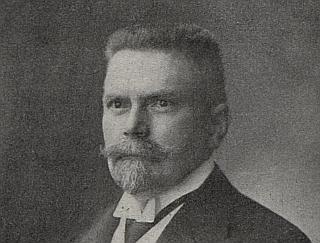
Karel Kramář, party chairman for many years.
,20.7.1917
Mladočeši is mentioned indirectly when pubkeeper Palivec tells detective Bretschneider that he serves whoever pays up, and that he didn't care at all if it was a Muslim, anarchist, Turk or a Young Czech who killed Archduke Franz Ferdinand.
Background
Mladočeši (the Young Czechs Party) - officially Národní strana svobodomyslná (the National Liberal Party), was a Czech political party that existed from 1874 to 1918. The party reached its zenith after 1890. Due to their for the time radical demands on universal suffrage and greater autonomy for the Czech lands of Austria-Hungary, they received considerable support in their homeland but faced correspondingly greater opposition from Vienna.
Thereafter the Social Democrats and the Agrarian Party made inroads into their electoral base, and the party lost much of its influence. The leading politician in the history of the party was Kramář. The party's official newspaper was Národní listy, to which Jaroslav Hašek contributed many short stories. At the 1911 election to Reichsrat they achieved 9.8 per cent of the votes in Bohemia and had 14 representatives.
Quote(s) from the novel
[I.1] „Host jako host,“ řekl Palivec, „třebas Turek. Pro nás živnostníky neplatí žádná politika. Zaplať si pivo a seď v hospodě a žvaň si, co chceš. To je moje zásada. Jestli to tomu našemu Ferdinandovi udělal Srb nebo Turek, katolík nebo mohamedán, anarchista nebo mladočech, mně je to všechno jedno.“
Also written:Young Czech PartyenJungtschechendeUngtsjekkaraneno
Literature
 | Věznice Pankrác |  | ||||
| Nusle/88, Palackého tř. - | ||||||
| ||||||
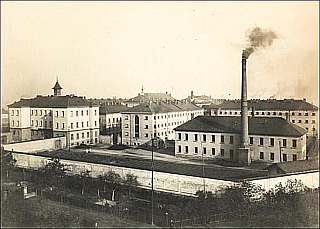
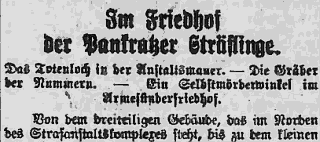
Bohemia,7.10.1913
Věznice Pankrác is implicitly mentioned by pubkeeper Palivec when he explains that talking politics might mean ending up in Pankrác.
The prison is also referred to in [I.3] where the unfortunate lathe operator who broke into Podolský kostelík was incarcerated and later died.
Background
Věznice Pankrác (c. k. trestnice pro mužké v Praze) was at the time a large jail for men, and "pankrác" is almost synonymous with prison in Czech slang. The prison is named after the Pankrác district where it is located. Construction started in 1885 and was completed in 1889.
It was at the time a modern prison with good conditions for the inmates. In Austrian times it mostly housed dangerous male criminals but also saw the odd political prisoner.
The prison later became the scene of executions and 1580 persons were killed; 1087 of them during the Nazi occupation. During Communist rule from 1948 another few hundred were executed.
Egon Erwin Kisch
The Raging Reporter has contributed his part to the fame of the prison. Denied permission to enter, he still climbed the walls, and reported from the cemetery of the inmates. Their graves were not marked! This is all revealed in the story Im Friedhof der Pankratzer Sträflinge (On the cemetery of the Pankrác inmates), first printed in Bohemia before the war [a], in 1931 appearing in the book Prager Pivatal with the title changed.
Quote(s) from the novel
[I.1] „Já se do takových věcí nepletu, s tím ať mi každej políbí prdel,“ odpověděl slušně pan Palivec, zapaluje si dýmku, „dneska se do toho míchat, to by mohlo každému člověku zlomit vaz. Já jsem živnostník, když někdo přijde a dá si pivo, tak mu ho natočím. Ale nějaký Sarajevo, politika nebo nebožtík arcivévoda, to pro nás nic není, z toho nic nekouká než Pankrác.“
[I.3] Potom ten soustružník zemřel na Pankráci.
Also written:Pankrác PrisonenPankratz GefängnisdePankrác fengselno
Literature
- The inside story of the history of Prague’s Pankrác prisonChris Johnstone2010
- Zu Besuch bei toten SträflingenEgon Erwin Kisch2010
| a | Im Friedhof der Pankratzer Sträflinge | Egon Erwin Kisch | 7.10.1913 |
 | Krajský soud Písek |  | |||
| Písek/121, Velké nám. 17 | |||||
| |||||
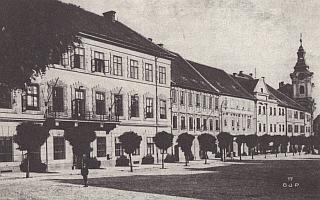
Velké náměstí in Písek (1917). The large building to the left housed the regional court.
© Písecký deník
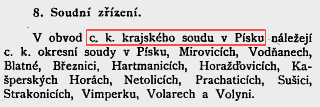
Královské město Písek, , 1898
Krajský soud Písek is where the pig gelder from Vodňany was sentenced and executed, all whilst uttering the worst imaginable things about the emperor. At least this is what Švejk tells detective Bretschneider at U kalicha.
Background
Krajský soud Písek was an institution that was part of the judiciary of Austria, and also remained functional in Czechoslovakia until 1945. It resided in a large building at southern part of Velké náměstí, down towards Otava and adjacent to the smaller Okresní soud Písek. The court president in 1915 was František Soukup. At the site is today (2021) located the latter, i.e. the district court, is but the building is newer.
Hilsner
The court in Písek hosted the 2nd trail of the infamous Hilsner affair (or Polna affair) where the young Jew Leopold Hilsner was accused of ritual murder. His death-sentence was confirmed in Písek on 14 November 1900 but was converted to life imprisonment by Emperor Franz Joseph I. and in 1918 he was set free during a general amnesty[a]. Future president Professor Masaryk put his academic career at stake during his defence of Hilsner, and an article he wrote in on the case was confiscated[b]. The verdict at Písek was quashed as late as 1998.
Quote(s) from the novel
[I.1] Když ho potom u krajského soudu v Písku věšeli, ukousl knězi nos a řekl že vůbec ničeho nelituje, a také řekl ještě něco hodně ošklivého o císařovi pánovi.“
Also written:Písek Regional CourtenKreisgericht PísekdeKretsretten Písekno
Literature
- Hilsner byl odsouzen k smrti u píseckého soudu. Ve vězení strávil 18 let.Libuše Kolářová2.11.2016
| b | Bericht über die Revision der Polnaer Processes | Tomáš Masaryk | 10.11.1900 |



|
I. In the rear |
 | |
2. The good soldier Švejk at police headquarters | |||
 | C.k. policejní ředitelství |  | |||||
| Praha I./313, Ferdinandová třída 15 | |||||||
| |||||||
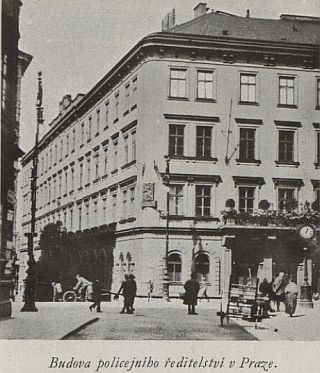
,13.9.1928

Like the author in the novel Břetislav Hůla (1950) mixes up the 3rd department with the State Police
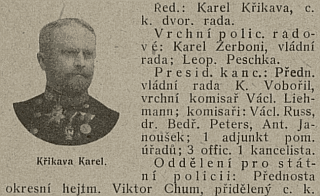
,1911
C.k. policejní ředitelství was where was Švejk was led by detective Bretschneider after his arrest at U kalicha. He was accused of high treason, insulting His Majesty, and even sedition - accusations he agreed to without flinching. He stayed at police HQ through the whole of [I.2], a chapter which took place in the course of just one evening/night. In the morning he was taken to c.k. zemský co trestní soud in a police car which left through the main gate, i.e. in ul. Karoliny Světlé 2.
The gate of the building and three places inside are mentioned: the reception, the cells on the first floor and the interrogation room in the 3rd department, up the stairs from the cells but unclear on which floor. Švejk rarely complained, but here he shows his dissatisfaction with the long way from the cell to the interrogators room.
In [I.6] Švejk pays police HQ another visit after he was arrested because of his strikingly enthusiastic reaction to the declaration of war. Her the author delivers his personal opinion of the institution "where the spirit of foreign authority wafted through the building".
Background
C.k. policejní ředitelství (C.k. policejní ředitelství v Praze) was the police HQ in Prague and it's official address in 1914 was Ferdinandova třída 15. The entrance was around the corner in ul. Karoliny Světlé 2. It was (and is) a huge complex, located between Ferdinandova, Karoliny Světlé and Bartolomejská. It is still (2018) the HQ of the Prague's police.
The Police HQ was organised in five departments where the State Police (Staatspolizei), department III (public order), and department IV (safety) are the ones that are relevant in the context of The Good Soldier Švejk. Department III is directly mentioned in the novel, although the author most probably has the State Police Department in mind. In 1913 the following of our acquaintances from the novel were employed: Mr. Slavíček and Mr. Klíma (State Police) and Polizeikommissar Drašner (department IV). Head of the 1st Department was Rudolf Demartini, a person who may have inspired Mr. Demartini, the fat gentleman at c.k. zemský co trestní soud.
The head of c.k. policejní ředitelství carried the title "Police Director" (from 1912 "Police President") and the position was in the period 1902 to 1915 held by Court Councillor Karel Křikava, uncle of the writer Louis Křikava. He frequented the same environs as Hašek and is mentioned several times in Strana mírného pokroku v mezích zákona. Head of the State Police Department was Viktor Chum.
Karel Křikava (1860 - 1935) made a rapid career in the police but was pensioned in 1915 for political reasons. He was not informed about the arrest of Kramář and as a result of the conflict that followed he was pensioned due to "health problems". After the war he was reactivated and was given the task of organising the police in Slovakia.
A Russian trader
In November 1915 Jaroslav Hašek acquired first hand knowledge of c.k. policejní ředitelství. As a premeditated provocation he registered at U Valšů as a Russian trader and the State Police soon arrived and arrested the "foreigner".
The good soldier Švejk in captivity
In the second version of The Good Soldier Švejk (Dobrý voják Švejk v zajetí), written by Jaroslav Hašek in 1917, police HQ is described in greater detail, particularly the department of Staatspolizei. Bartolomějská ulice is mentioned explicitly and so are the police commissioners Mr. Klíma and Mr. Slavíček and the author correctly notes that both worked for the state police. The description is more elaborate than in the novel and Chum is referred to as head of the "triumvirate".[1]
Švejka vedli k výslechu do oddělení státní policie přímo k policejnímu komisaři Klímovi a Slavíčkovi. Tito dva představitelé aparátu státní policie od vypuknutí války až po objevení Švejka v kanceláři vyšetřili několik set případů udání, provedli spoustu domovních prohlídek a odváděli muže od teplých večeří do Bartolomějské ulice. Jest zajímavé, proč department pražské státní policie právě se usadil v ulici připomínající svým jménem bartolomějskou noc …
Quote(s) from the novel
[I.2] Sarajevský atentát naplnil policejní ředitelství četnými oběťmi. Vodili to jednoho po druhém a starý inspektor v přijímací kanceláři říkal svým dobráckým hlasem: „Von se vám ten Ferdinand nevyplatí!“ Když Švejka zavřeli v jedné z četných komor prvého patra, Švejk našel tam společnost šesti lidí.
[I.6] Budovou policejního ředitelství vanul duch cizí authority, která zjišťovala, jak dalece je obyvatelstvo nadšeno pro válku. Kromě několika výjimek, lidí, kteří nezapřeli, že jsou synové národa, který má vykrvácet za zájmy jemu úplně cizí, policejní ředitelství představovalo nejkrásnější skupiny byrokratických dravců, kteří měli smysl jedině pro žalář a šibenici, aby uhájili existenci zakroucených paragrafů.
[I.10.1] I on, Švejk, byl tenkrát v tom houfu, poněvadž při své smůle řekl komisaři Drašnerovi, když ho vyzval, aby se legitimoval: „Mají na to povolení od policejního ředitelství?“
[II.3] Jako jsem znal jednoho uhlíře, kerej byl se mnou zavřenej na začátku války na policejním ředitelství v Praze, nějakej František Škvor, pro velezrádu, a později snad taky vodpravenej kvůli nějakej pragmatickej sankci.
Also written:Police HeadquartersenPolizeidirektiondePolitihovudkvarteretno
Literature
- C.k. policejní ředitelství v Praze
- Český antimilitarism1922
- Rücktritt des Polizeipräsidenten Křikava27.7.1915
- Právo lidu7.8.1915
- Bašta germanisace3.12.1917
- Der erste Polizeipräsident von Prag gestorben24.9.1935
- Pražské policejní ředitelství, jeho Státní(politická) policie a její informátoři …Zdeněk Kárník
| 1 | Dobrý voják Švejk v zajetí | 1917 |
 | U Brejšky |  | ||||
| Praha II./107, Spálená ul. 47 | ||||||
| ||||||
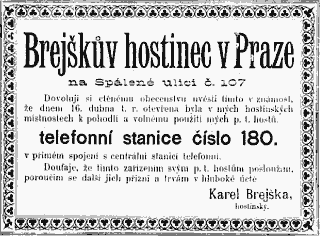
,15.5.1884
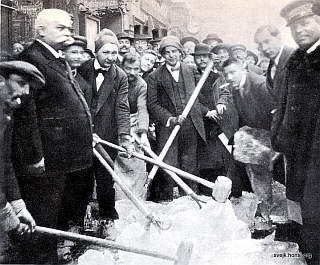
Breaking ice by U Brejšky. Jaroslav Hašek third from the left. Zdeněk Matěj Kuděj is in the middle. The tall man on the left is landlord Karel Brejška.
, 6.2.1914
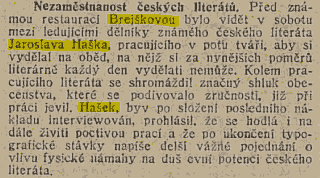
,19.1.1914
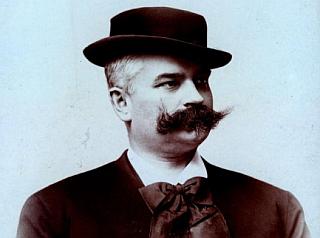
Karel Brejška,1912.
© Národní archiv - Archiv České strany národně sociální

Národní listy,17.5.1923
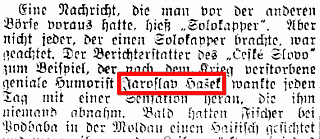
Egon Erwin Kisch
,6.12.1925

, 1925
U Brejšky was where detective Brixi arrested an unusually fat owner of a paper shop who had bought beer for two Serbian students. The generous man was one of Švejk's inmates in the cell at c.k. policejní ředitelství. The pub is mentioned several times, and in the final chapter it crops up in an anecdote Švejk tells Einjährigfreiwilliger Marek. In this anecdote it is named U Brejsků, a minor change from singular to plural.
Background
U Brejšky was a restaurant in Spalená ulice in Praha II. that in it's original form existed from 1884 until around 1920. It was known as a meeting place for journalists; Egon Erwin Kisch and others wrote about the phenomenon "news exchange" in Prager Tagblatt in 1925. Both Czech and German newspapermen frequented the place. Immediately after opening the restaurant had installed a telephone station (No. 180), a rare sight in 1884.
The restaurant served beer from Plzeň and was also known for its good food. Not only was it popular amongst journalists: visitors from the province also enjoyed it here. On the first floor it offered meeting rooms and accommodation. U Brejšky (aka. U Brejšků or Brejškova restaurace) was altogether one of the most best known and popular taverns in all of Prague, as indicated by the endless amount of newspaper clips. The restaurant was named after the original owner, Karel Brejška.
Jaroslav Hašek and Brejška
The author The Good Soldier Švejk frequented it regularly and he mentions the restaurant not only in the novel, but also in several of his short stories. Amongst them is Dobrý voják Švejk v zajetí (1917) but here it occurs only briefly. On the other hand U Brejšky is the main focus of a story he wrote in 1912 about a meeting with the enormous black American Zipps. The landlord himself appears in the story and is described in positive terms.
U Brejšky is known from a photo where Jaroslav Hašek and Zdeněk Matěj Kuděj break ice on the street outside. A note in Právo lidu 19 January 1914 indicates that the picture was taken on 17 January 1914 and that it was published with a text on 6 February in Světozor. Both texts refer to a strike amongst typographers. In his memoirs Hájek wrote about Karel Brejška, that the landlord liked Hašek and readily helped him when he was in trouble. Hájek incorrectly dates the picture to the winter of 1912, an error that later propagated into other literature about Hašek. Kuděj confirmed the information about the typographer's strike, that Brejška took pity on the two unemployed literates, and put them to work on writing menu's and breaking ice.
Karel Brejška
The owner of the restaurant was Karel Brejška (6 June 1856 - 15 May 1923), the big man seen to the left on the mentioned photo from Světozor. He bought the building Zlatá váha in Spalená ulice 117/47 for 60,000 guilders early in 1884. Prager Tagblatt reported that the restaurant operated from 19 January that year. Police records reveal that Brejška moved here in 1884, was married and had children. He was also a dedicated sportsman, above all in cycling, and readily took on duties. He edited the guest house owner's magazine Hostimil and hosted their editorial offices at U Brejšky. Karel Brejška was a popular figure and when he died after long illness in 1923, Eduard Bass, a friend of Jaroslav Hašek, wrote a long obituary in Lidové noviny[a]. They were not the only newspaper that fondly remembered him. Brejška sold the restaurant three years before he died.
Modern times
In 1939 was still listed in the address book but whether or not there has been continuous operation is not known. In any case it still exists in a modern variation (2016) with the name Haškova restaurace U Brejsků. It is decorated with photos from the era (many of them feature Hašek) and makes the most of its connection with him. Their web page say little about the historical lines. Instead it focuses on Hašek and the fact that the sports club Slavia was formed here on 31 May 1895. The current restaurant is located in the basement.
The good soldier Švejk in captivity
The pub is also mentioned in Dobrý voják Švejk v zajetí. In the first chapter it is revealed that the court medics at c.k. zemský co trestní soud fetched breakfast here when they discussed Švejk's case and his striking eagerness to serve his emperor.[1]
Pak přinesli soudním lékařům od Brejšky snídani a lékaři při smažených kotletách se usnesli, že v případě Švejkově jde opravdu o těžký případ vleklé poruchy mysli.
Quote(s) from the novel
[I.2] Výjimku dělal neobyčejně tlustý pán s brýlemi, s uplakanýma očima, který byl zatčen doma ve svém bytě, poněvadž dva dny před atentátem v Sarajevu platil „U Brejšky“ za dva srbské studenty, techniky, útratu a detektivem Brixim byl spatřen v jejich společnosti opilý v „Montmartru“ v Řetězové ulici, kde, jak již v protokole potvrdil svým podpisem, též za ně platil.
Sources: Ladislav Hájek, Egon Erwin Kisch
Also written:Die ZecheReiner
Literature
- Jak jsem přemohl černošského obra Zippse ze Severní AmerikyJaroslav Hašek3.5.1912
- Soupis pražských domovských příslušníků 1830-1910 (1920)
- Mitteilungen aus dem Publikum19.1.1884
- Směna držebnosti16.2.1884
- Brejškův hostinec v Praze15.5.1884
- Brejškova restaurace1886
- .. vyš. hpospodárské ústav ..
- Brejška okraden26.7.1913
- Následek sporu typografů se zaměstnavateli6.2.1914
- Hádanka22.10.1914
- Restaurateur Brejška gestorben17.5.1923
- Karel Brejška zemřel17.5.1923
- Die Börse der Nachrichten6.12.1925
- Z historie
- Románové restaurační a jiné zábavní podniky2009 - 2021
| a | Otec Brejška mrtev | 17.5.1923 | |
| 1 | Dobrý voják Švejk v zajetí | 1917 |
 | Montmartre |  | ||||
| Praha I./224, Řetězová ul. 7 | ||||||
| ||||||
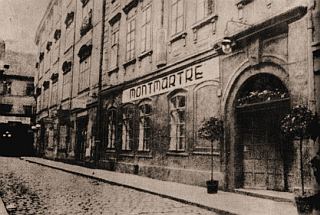
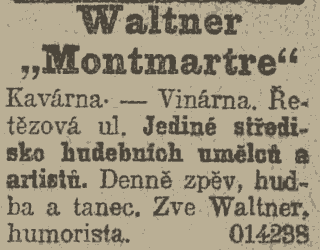
,2.9.1911
Montmartre is mentioned because the paper-shop owner who was Švejk's cell companion at c.k. policejní ředitelství had been observed drunk here together with the two Serbian students he had paid for earlier in the day, at U Brejšky.
Background
Montmartre was a café in the very centre of Prague which recently (as of 2010) was re-opened after a break of 70 years. The name is obviously taken from the famous Paris district of Montmartre. The café is decorated with period photos where Jaroslav Hašek plays a prominent role. The 1989 Sametová revoluce put a stop to official plans to turn Montmartre into a museum dedicated to Jaroslav Hašek.
Montmartre was opened in 1911 by the well-known actor and artist Josef Waltner. It was a night café and entertainment establishment, also known as Cabaret Montmartre. From the beginning it became a popular meeting place amongst artists, intellectuals and the bohemian set. Apart from Jaroslav Hašek it was also frequented by the likes of Zdeněk Matěj Kuděj, Max Brod, Egon Erwin Kisch, Franz Werfel and Franz Kafka. Hašek wrote four short stories where was Montmartre involved, and Kisch also immortalised the café through his writing[a].
Egon Erwin Kisch
Und einer von ihnen hatte doch während jener Tagung noch die Habsburger geschützt, indem er dem Delegierten Jaroslav Hašek auf dessen Zwischenruf: "Borg mir eine Krone" ex praesidio die feierliche Rüge ersteilte: "Bitte die Krone nicht in die Debatte zu ziehen".
Quote(s) from the novel
[I.2] Výjimku dělal neobyčejně tlustý pán s brýlemi, s uplakanýma očima, který byl zatčen doma ve svém bytě, poněvadž dva dny před atentátem v Sarajevu platil „U Brejšky“ za dva srbské studenty, techniky, útratu a detektivem Brixim byl spatřen v jejich společnosti opilý v „Montmartru“ v Řetězové ulici, kde, jak již v protokole potvrdil svým podpisem, též za ně platil.
Sources: Egon Erwin Kisch
Literature
- Románové restaurační a jiné zábavní podniky2009 - 2021
- Montmartre22.10.2023
- Černohorský jonák v úzkýchJaroslav Hašek1.8.1912
- Sen Josefa Waltnera, odvážného majitele kavárny MontmartreJaroslav Hašek1915
- Můj zlatý dědečekJar. Hašek1912
- Má tragedie montmartskáJaroslav Hašek1914
- Der Letzte vom Prager MontmartreMaxm. Huppert14.8.1928
| a | Zitate vom Montmartre |
 | Spolek Dobromil |  | ||||
| Podolí/55, Kublov | ||||||
| ||||||
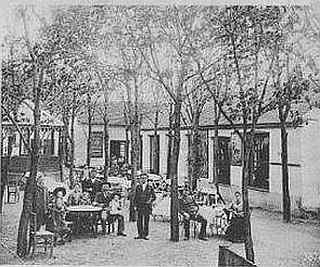
Garden restaurant in Hodkovičky, a possible location for Dobromil's celebration.

Address book from 1910
Spolek Dobromil was a charity in Hodkovičky who held a celebration on the day of the murders in Sarajevo. The police arrived and asked them to stop, but the chairman retorted that hey had to finish playing "Hej, Slované" (well known pan-slavic hymn) first. This led him straight to the cell at c.k. policejní ředitelství.
Background
Spolek Dobromil is an association which so far has not been fully identified. It is still very likely that they existed and may well have congregated in the centre of Hodkovičky. In 1910 such a society existed in nearby Podolí and Dvorce, so it is quite likely that these are the people Jaroslav Hašek refers to.
Quote(s) from the novel
[I.2] Třetí spiklenec byl předseda dobročinného spolku „Dobromil“ v Hodkovičkách. V den, kdy byl spáchán atentát, pořádal „Dobromil“ zahradní slavnost spojenou s koncertem. Četnický strážmistr přišel, aby požádal účastníky, by se rozešli, že má Rakousko smutek, načež předseda „Dobromilu“ řekl dobrácky: „Počkají chvilku, než dohrajou ,Hej, Slované’.“
Sources: Milan Hodík
 | Národní politika |  | ||||
| Praha II./835, Václavské nám. 21 | ||||||
| ||||||
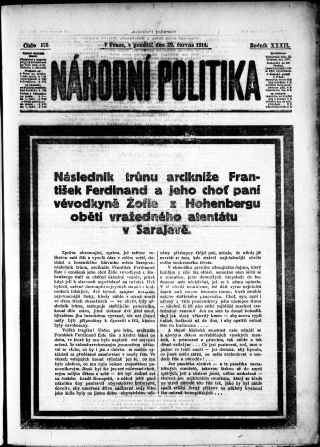
,29.6.1914

,15.11.1915
Národní politika is first mentioned during the interrogation at c.k. policejní ředitelství when Švejk reveals that he reads the afternoon issue to look for dog adverts. He also uses the term "čubička" (the little bitch), which provokes the interrogator with the animal traits to shout: Out!.
Národní politika is mentioned again both in [I.6], [I.13] and in [II.2].
Background
Národní politika was a conservative daily that was published in Prague from 1883 to 1945. The editorial offices were located at Václavské náměstí. The paper printed at least six of Jaroslav Hašek's stories and it was one of the first papers to report both his capture in 1915 and his return to Prague (1920). In other stories he makes fun of the newspaper.
According to Franta Sauer it was the author's preferred newspaper, and at first sight it appears that he inserted snippets from it into The Good Soldier Švejk. The conversation between Oberleutnant Lukáš and hop trader Wendler in [I.14] reveals word for word quotes from the paper and the evening issue from 4 April 1915 is a prime example. That said, Kronika světové války is an even more obvious source for these fragments.
The good soldier Švejk in captivity
In Dobrý voják Švejk v zajetí is actually Národní politika the first institution that is mentioned. Here and in other official publications an arrest order from c.k. zemský co trestní soud regarding Švejk was printed.[1]
Tak daleko jsi to tedy dopracoval, můj dobrý vojáku Švejku! V Národní politice a jiných úředních věstnících objevilo se tvé jméno spojené s několika paragrafy trestního zákona.
Quote(s) from the novel
[I.2] „S kýmpak se stýkáte?“ „Se svou posluhovačko, vašnosti.“ „A v místních politických kruzích nemáte nikoho známého?“ „To mám, vašnosti, kupuji si odpoledníčka „Národní politiky“, ,čubičky’.“ „Ven!“ zařval na Švejka pán se zvířecím vzezřením.
[I.6] posledně od toho pana řídícího z Brna ta záloha šedesát korun na angorskou kočku, kterou jste inseroval v Národní politice a místo toho jste mu poslal v bedničce od datlí to slepé štěňátko foxteriéra.
[I.13] Když tenkrát ta sopka Mont Pelé zničila celý ostrov Martinique, jeden profesor psal v Národní politice, že už dávno upozorňoval čtenáře na velkou skvrnu na slunci. A vona, ta Národní politika, včas nedošla na ten vostrov, a tak si to tam, na tom vostrově, vodskákali."
[II.2] I u nás jsou nadšenci. Četli v ,Národní politice’ o tom obrlajtnantovi Bergrovi od dělostřelectva, který si vylezl na vysokou jedli a zřídil si tam na větví beobachtungspunkt?
Also written:National PoliticsenNationalpolitikdeNasjonal Politikkno
Literature
- Vánoce Národní politikyJaroslav Hašek29.12.1907
- Písemnictví4.4.1915
- Malý oznamovatel Národní politikyJaroslav Hašek8.2.1921
| 1 | Dobrý voják Švejk v zajetí | 1917 |
 | Museum |  | |||
| Praha II./1700, Václavské nám. 74 | |||||
| |||||

Světem letem, ,1896
Museum is mentioned in an anecdote by Švejk about quartering av prisoners in the bad old days. This is supposed to have happened on a hill somewhere by the museum. The museum itself is later mentioned explicitly in an anecdote on the way to Budapest.
Background
Museum which is talked about is certainly the main building of Museum království Českého, now Národní muzeum in Prague. It is located at the southern end of Václavské náměstí. The building was erected between 1885 and 1891.
The good soldier Švejk in captivity
Museum is mentioned also in Dobrý voják Švejk v zajetí when is pushed to the draft board in a wheelchair.[1]
Lidé se smáli, přidávali se k zástupu a u Muzea dostal nějaký žid, který zvolal "Heil!", první ránu.
Quote(s) from the novel
[I.2] Takovejch případů bylo víc a ještě potom člověka čtvrtili nebo narazili na kůl někde u Musea
Literature
| 1 | Dobrý voják Švejk v zajetí | 1917 |



|
I. In the rear |
 | |
3. Švejk before the court physicians | |||
 | C.k. zemský co trestní soud |  | |||||
| Praha II./6, Spalená 2 | |||||||
| |||||||
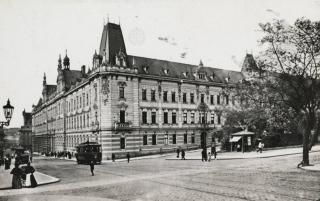
Kol. 1920 (?) Celkový pohled na dům čp. 6 (trestní soud) na nároží Karlova náměstí a Spálené ulice (vlevo) na Novém Městě.
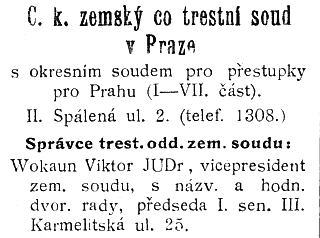
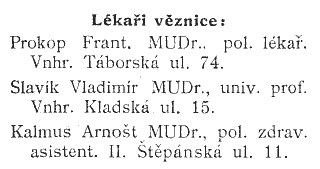
Doctors at the prison
,1907
C.k. zemský co trestní soud is the institution Švejk was driven to in a police car the morning after the arrest. Here he was interrogated by a good-natured judge who, when he read what Švejk had confessed to, questioned his mental health. He concluded that Švejk had to undergo an investigation by a psychiatric commission, which resulted in him being sent to a lunatic asylum.
Background
C.k. zemský co trestní soud was the criminal court for Prague, a department of C. k. zemský soud (k. k. Landesgericht), the highest judicial instance in the Kingdom of Bohemia. It was located in the enormous judiciary complex between Spálená ulice, Karlovo náměstí and Vodičkova ulice. The court also contained a prison. Today this building houses the City Court of Prague.
Hašek before the court
The author of The Good Soldier Švejk was taken to court here after he at an anarchist meeting on 1 May 1907 allegedly incited violence against the police. For this he was sentenced to a month in prison, his longest conviction ever. The verdict fell on 1 July[b] and he served the prison term from 16 August to 16 September.
In 1906 the criminal court employed three medical doctors[c] and it is quite likely that Hašek was in contact with at least one of them during his month in prison.
The good soldier Švejk in captivity
The country court as criminal court features also in Dobrý voják Švejk v zajetí. Švejk's eagerness to serve his emperor is so striking that the authorities perceived it as subversion and took him to court.[1]
"C. k. zemský jakožto trestní soud v Praze, oddělení IV, nařídil zabaviti jmění Josefa Švejka, obuvníka, posledně bytem na Král. Vinohradech, pro zločin zběhnutí k nepříteli, velezrády a zločin proti válečné moci státu podle § 183-194, č. 1334, lit. c, a § 327 vojenského trestního zákona."
Quote(s) from the novel
[I.3] Čisté, útulné pokojíky zemského „co trestního soudu“ učinily na Švejka nejpříznivější dojem. Vybílené stěny, černě natřené mříže i tlustý pan Demartini, vrchní dozorce ve vyšetřovací vazbě s fialovými výložky i obrubou na erární čepici. fialová barva je předepsána nejen zde, nýbrž i při náboženských obřadech na Popeleční středu i Veliký pátek.
Also written:Country- as Criminal CourtenLandes- als StrafgerichtdeLandsretten som strafferettno
| b | Ze soudní sine | 2.7.1907 | |
| c | Adresář královského hlavního města Prahy a obcí sousedních | 1907 | |
| 1 | Dobrý voják Švejk v zajetí | 1917 |
 | Teissig |  | |||||
| Praha II./85, Spálená ul. 5 | |||||||
| |||||||
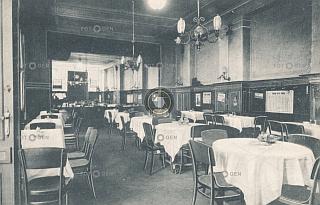
Teissigova plzeňská restaurace,1915
© Photogen.cz
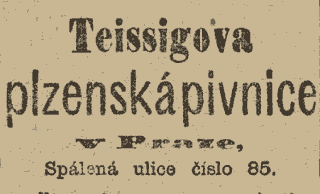
,1.1.1896
Teissig was a restaurant where the employees of c.k. zemský co trestní soud went to fetch peppers and Pilsner beer for lunch. Why they went to get peppers is a mystery. Translators Grete Reiner and Cecil Parrott both interpreted it as goulash, probably a bit far-fetched.
Hans-Peter Laqueur has voiced the theory that the author by "paprika" meant "paprikash" which is the Hungarian goulash, a soup that is quite different from Czech "guláš". In that case, Reiner and Parrott's interpretation is more accurate than "peppers".
Background
Teissig was a restaurant located across the street from the massive City Court complex (former c.k. zemský co trestní soud) and owned by Karel Teissig. He had been running the restaurant at least since 1895. Teissig had previously managed U kotvy, two houses down the road. This restaurant that still exists (2019). Address books confirm that U Teissigů was operating as late as 1940.
Quote(s) from the novel
[I.3] A vyšetřující soudcové, Piláti nové doby, místo aby si čestně myli ruce, posílali si pro papriku a plzeňské pivo k Teissigovi a odevzdávali nové a nové žaloby na státní návladnictví.
Literature
- Románové restaurační a jiné zábavní podniky2009 - 2021
- Anzeige3.6.1896
- Besitzwechsel3.6.1899
- Českoslovanská záložna v Praze-II.25.2.1910
 | Státní návladnictví |  | ||||
| Praha III./2, Malostranské nám. 25 | ||||||
| ||||||
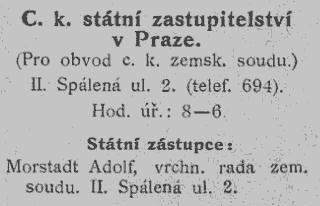
Státní návladnictví was where the detainees were led after their stay at c.k. zemský co trestní soud. Here formal prosecution was in store. The institution had also been briefly mentioned in [I.1].
Background
Státní návladnictví is a term that is rarely used in modern Czech, and is now mostly referred to as Státní zastupitelství, a wording that was used even during the life-time of the author (see cut from the 1907 address book). The expression refers to the state prosecutor's office. Their main seat for Bohemia was at Malostranské náměstí in the building of the regional high court, and their Prague office was located in the same building as c.k. zemský co trestní soud. It is surely those premises that the author had in mind.
Quote(s) from the novel
[I.3] A vyšetřující soudcové, Piláti nové doby, místo aby si čestně myli ruce, posílali si pro papriku a plzeňské pivo k Teissigovi a odevzdávali nové a nové žaloby na státní návladnictví.
Also written:State prosecutor's officeenStaatsanwaltschaftdeStatsadvokatkontoretno
 | U Bansethů |  | |||||
| Nusle/389, Palackého tř. 18 | |||||||
| |||||||
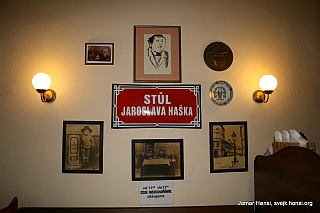
U Bansethů, 2011

,27.2.1906

,1.9.1907

,21.3.1908
U Bansethů crops up in one of Švejk's stories. He was on his way back from this pub when he was assaulted by the bridge across Botič. The perpetrators got the wrong man and gave him an extra slap due to the disappointment.
The tavern is mentioned again in [I.13] in the discussion about volcanic eruptions and sunspots. See Martinique.
It also appears in the final chapter of the novel, and now the owner Banseth is mentioned directly.
Background
U Bansethů was the name of two restaurants in Nusle, owned by Alois Banseth. One of them is still operating and it advertises its connection to Švejk; the interior has numerous pictures of Jaroslav Hašek. There is even a Stůl Jaroslava Haška (Jaroslav Hašek's table).
The original restaurant was located a few steps down the street in house No. 321. Banseth started operation in the autumn of 1900 and in March 1908 it was announced that it was sold to František Kocan, former landlord at U Kocanů. Around the same time he bought house No. 389 which still bears his name. The pub already existed under the name U Palackého and Banseth with his wife Anna paid 100,000 crowns for the house.
Which of the two public houses the author had in mind is uncertain, but the address information given above relates to the one that still exists. Mr. Banseth was in 1910 listed as owner of the building that housed his pub. He also lived here.
The original U Bansethů also arranged public meetings on its premises, for instance on 26 February 1906 where anarchists took part, and amongst them Jaroslav Hašek was very likely to be found. On this occasion the anarchist Čeněk Körber (1875-1951) caused such uproar that the meeting was abandoned. The pub was also hosted meetings by Česká strana národně sociální, Sokol, Volná myšlenka and Mladočeši. Particularly the first seemed to have met a lot here, and in Strana mírného pokroku v mezích zákona Jaroslav Hašek describes on of their meetings where he provoked and caused disorder.
Strana mírného pokroku
Po onom velkém morálním vítězství U Banzetů sešly se naše rozptýlené řady až nahoře na Havlíčkově třídě. Kulhal jsem, pod okem jsem měl modřinu a mé tváře, jak praví Goethe, nevěstily nic dobrého. Byly opuchlé!
Quote(s) from the novel
[I.3] Jako jednou v Nuslích, právě u mostu přes Botič, přišel ke mně v noci jeden pán, když jsem se vracel od Banzetů, a praštil mě bejkovcem přes hlavu, a když jsem ležel na zemi, posvítil si na mne a povídá: ,Tohle je mejlka, to není von.’
[I.13] „Ty skvrny na slunci mají vopravdu velkej význam,“ zamíchal se Švejk, „jednou se vobjevila taková skvrna a ještě ten samej den byl jsem bit ,U Banzetů’ v Nuslích.
[IV.3] Vona potom chtěla mít celou soupravu do domácnosti z takovejch nožů a posílala ho vždycky v neděli do Kundratic na vejlet, ale von byl tak skromnej, že nešel nikam než k Banzetovům do Nuslí, kde věděl, že když sedí v kuchyni, že ho dřív Banzet vyhodí, než může na něho někdo sáhnout.“
Sources: Jaroslav Šerák
Also written:U BanzetůHašek
Literature
- Románové restaurační a jiné zábavní podniky2009 - 2021
- Strana roste, ale je bita
- V zajetí Kartagiňanú
- Pobytové přihlášky pražského policejního ředitelství1851 - 1914
- Adresář královského hlavního města Prahy a obcí sousedních (1910)
- Besitzwechsel10.7.1900
- Hostinský věstník2.11.1900
- Zábavy2.5.1901
- Rozpuštěná schůze27.2.1906
- Změny držebnosti21.3.1908
- K jubileu "Národních Listů"21.12.1929
 | Podolský kostelík |  | ||||
| Podolí/91, Přemyšlova ul. - | ||||||
| ||||||
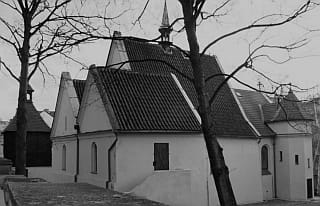
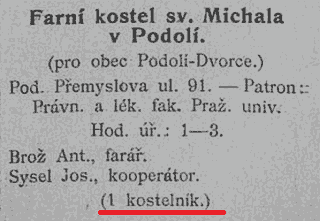
Adresář Prahy (1907)
Podolský kostelík is mentioned in the series of stories about various mistakes that Švejk tells his fellow remand prisoners at c.k. zemský co trestní soud. A lathe operator (turner) who lived in Švejk's house locked himself into the chapel by mistake once he was drunk, and because he thought he was at home he slept overnight and the result was that the church had to be re-consecrated. The unfortunate intruder was convicted and died at Věznice Pankrác.
Background
Podolský kostelík is almost certainly the parish church kostel sv. Michala (Church of Saint Michael) in Podolí, south of Vyšehrad.
Jaroslav Šerák
Podolský kostel bude určitě kostel svatého Michala v ulici Pod Vyšehradem, je to farní kostel dodnes. Ostatní jsou jen hřbitovní kaple, nebo postavené později.
Quote(s) from the novel
[I.3] Nebo vám povím příklad, jak se zmejlil u nás v domě jeden soustružník. Votevřel si klíčem podolskej kostelík, poněvadž myslel, že je doma, zul se v sakristii, poněvadž myslel, že je to u nich ta kuchyně, a lehl si na voltář, poněvadž myslel, že je doma v posteli, a dal na sebe nějaký ty dečky se svatými nápisy a pod hlavu evangelium a ještě jiný svěcený knihy, aby měl vysoko pod hlavou.
Sources: Jaroslav Šerák
Literature
 | Česká radikální strana |  | |||
| |||||
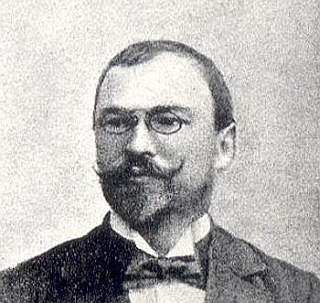
Karel Baxa, member of parliament from 1903-1918 and chairman of Státoprávně radikální strana
Česká radikální strana is indirectly referred to in Švejk's story about the Czech radical deputy who by mistake is chased by Rittmeister Rotter's police dogs.
Background
Česká radikální strana was not the name of any particular political party but it is quite obvious that Švejk had either Strana radikálně pokroková or Státoprávně radikální strana in mind. The former party existed from 1897 to 1908 and campaigned for extensive political reforms, whereas the latter was formed in 1899 and their main goal was extended state rights for the Czech lands.
In 1908 he two parties merged and founded Česká strana státoprávně pokroková. From 1914 the party openly campaigned for an independent Czech state and suffered persecution as a result. It can not be ruled out that label "radical" stuck with even the new party and that indeed was them Švejk had in mind.
Quote(s) from the novel
[I.3] Nakonec se ukázalo, že ten člověk byl českej radikální poslanec, kterej si vyjel na vejlet do lánskejch lesů, když už ho parlament vomrzel.
Literature
 | Parlament |  | |||
| Wien I., Franzens-Ring 1 | |||||
| |||||
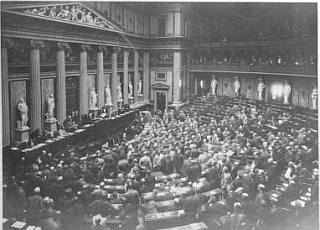
Abgeordnetenhaus 1907

A selection of Czech deputies in Reichsrat in 1914 (Josef Švejk highlighted).
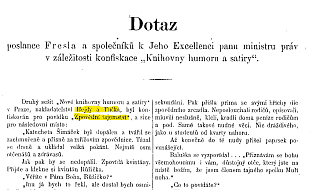
Interpellation regarding the confiscation of Hašek's book.
, 29.11.1911
Parlament is mentioned is Švejk's story about the Czech radical member of parliament who by mistake is chased by Rittmeister Rotter's police dogs.
In [II.2] it is mentioned again because of Major Wenzl's outrageous behaviour in Kutná Hora was reported by some deputy.
Background
Parlament refers to Reichsrat in Vienna. From 1867 until 1918 it was the national assembly of Cisleithania, i.e. the Austrian part of the Dual Monarchy. The council consisted of a Herrenhaus (House of Lords) and a Abgeordnetenhaus (House of Commons).
The last election to the Abgeordnetenhaus was held in June 1911, and that year the house counted 516 deputies, of which 232 were Germans, 108 Czechs and 83 Poles. The remaining seats were occupied by Ukrainians, Slovenes, Italians, Romanians, Croats, Serbs and a lone Zionist!
Several of the politicians mentioned in The Good Soldier Švejk were deputies at the outbreak of war: Professor Masaryk, Kramář, Klofáč, Jos. M. Kadlčák, and a certain agrarian politician Josef Švejk. A former deputy of interest for readers of The Good Soldier Švejk was Alexander Dworski, see Mr. Grabowski. The parliament was suspended at the outbreak of war in 1914 and was only reconvened in 1917.
Hašek's story in Reichsrat
On 29 November 1911 one of Jaroslav Hašek's stories was the subject of an interpellation in the deputy chamber of Reichsrat[a]. It was one of several tales in Hašek's Dobrý voják Švejk a jiné podivné historky, a book that was published in the autumn of 1911. The k.k. Landesgericht als Preßgericht in Prague on 18 November 1911 decided to confiscate the book because of the story Zpovědní tajemství (The seal of confession)[b] because it was deemed blasphemous. A group of deputies with Fresl at the front protested to the minister of justice. They pointed at that the story had been printed in České slovo already in 1908 without having been censored.
The 18 signatories were: eleven from Česká strana národně sociální (Fresl, Vojna, Formánek, Klofáč, Choc, Stříbrný, Lisy, Konečný, Slavíček, Baxa, Šviha), three Czech independent progressives (Professor Masaryk, Kalina, Prunar), two Czech agrarians (Masata, Bradač) and even two Ukrainians (Breiter, Трильовський (Trylowskyj)). Note that the agrarian Josef Švejk didn't sign it... The complaint seems to have been heeded because in 1912 the book was printed again. The segments that had been censored were marked with a note about the petition but nothing seems to have been removed. The interpellation didn't mentioned Hašek or the book's title by name.
Quote(s) from the novel
[I.3] Nakonec se ukázalo, že ten člověk byl českej radikální poslanec, kterej si vyjel na vejlet do lánskejch lesů, když už ho parlament vomrzel. Proto říkám, že jsou lidi chybující, že se mejlejí, ať je učenej, nebo pitomej, nevzdělanej blbec. Mejlejí se i ministři.“
[I.8] Voba byli svázaní do kozelce a regimentsarzt je kopal do břicha, že jsou prej simulanti. Pak když ty voba vojáci umřeli, přišlo to do parlamentu a bylo to v novinách.
[II.2] Slovo padlo, a už to bylo v místních novinách a nějaký poslanec interpeloval chování hejtmana Wenzla v hotelu ve vídeňském parlamentě.
Literature
- Stenographische Protokolle des Abgeordnetenhauses des Reichsrates 1861-1918
- Parlament
- Reichsrat
- Parlaments-Gebäude
| a | Stenographische Protokolle - Abgeordnetenhaus | 29.11.1911 | |
| b | Kundmachungen | 23.11.1911 |



|
I. In the rear |
 | |
4. They threw Švejk out of the madhouse | |||
 | Blázinec |  | |||||
| Praha II./468, Ul. Karlova 15 | |||||||
| |||||||
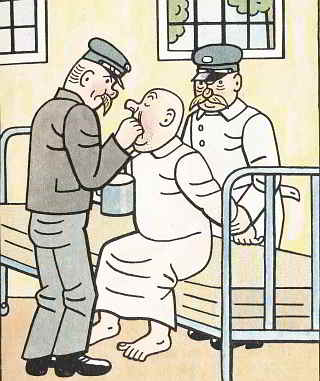
Blázinec is referred to when Švejk is led to a psychiatric institution after a commission of psychiatrists conclude that he is a "malingerer with a feeble mind". He might have spent several weeks here as he was only released on 29 July 1914, the day Austria-Hungary declared war on Serbia.
Background
Blázinec was some mental hospital in Prague which is not explicitly located. Still, we can by near certainty conclude that the author had Kateřinky in mind. This is an institution where he himself spent a few weeks in February 1911.
Quote(s) from the novel
[I.4] Když později Švejk líčil život v blázinci, činil tak způsobem neobyčejného chvalořečení: „Vopravdu nevím, proč se ti blázni zlobějí, když je tam drží. Člověk tam může lézt nahej po podlaze, vejt jako šakal, zuřit a kousat. Jestli by to člověk udělal někde na promenádě, tak by se lidi divili, ale tam to patří k něčemu prachvobyčejnýmu. Je tam taková svoboda, vo kterej se ani socialistům nikdy nezdálo.
Also written:The madhouseenDas IrrenhausdeGalehusetno
 | Ottův slovník naučný |  | ||||
| Praha II./553, Karlovo nám. 35 | ||||||
| ||||||
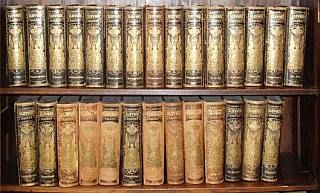


Ottův slovník naučný, , 1892

,1910-1914
Ottův slovník naučný was mentioned in connection with the patient at blázinec who claimed to be the 16th volume of this encyclopedia.
Background
Ottův slovník naučný is an encyclopaedia by the publisher Otto that is regarded an outstanding work of reference also in an international context. A total of 28 volumes were released between 1888 and 1909 with additional supplements appearing thereafter. Otto's Encyclopaedia was at the time one of the largest in the world. The editorial offices were at Karlovo náměstí, in the building next to the publishing house of Otto.
Emil Artur Longen (1928) claims that Jaroslav Hašek made active use of the encyclopaedia when he wrote The Good Soldier Švejk. He may well have a point as the long tirade Rekrut Pech used is almost a direct quote from the encyclopaedia.
The reference to kartonážní šička (cardboard stapler) can not be found in volume 16 (Lih-Media) and Antonín Měšťan also points out that there is no such entry in the encyclopaedia at all. If it had been a real entry it would have been found in volume 14. This volume does however have a reference to kartonáž that simply points to the entry cartonage in volume 5.
Antonín Měšťan
Durch einen Blick in den Ottův slovník naučný läßt sich leicht feststellen, daß das Stichwort "Kartonagenähgrin" nicht nur im 16. Band fehlt - es fehlt in diesem Lexikon überhaupt.
Quote(s) from the novel
[I.4] Nejzuřivější byl jeden pán, kerej se vydával za 16. díl Ottova slovníku naučného a každého prosil, aby ho otevřel a našel heslo ,Kartonážní šička’, jinak že je ztracenej.
Sources: Antonín Měšťan, Emil Artur Longen
Also written:Otto's encyclopaediaenOttos KonversationslexicondeOttos konversasjonsleksikonno
Literature
 | Královy lázně |  | |||
| Praha I./195, Ul. Karoliny Světlé 43 | |||||
| |||||
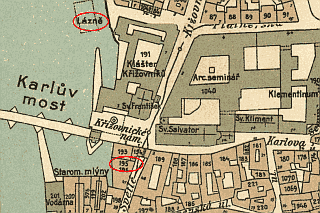
, 1910-1914

Břetislav Hůla

Baedeker
Královy lázně is indirectly mentioned by Švejk when he in blázinec is asked if he enjoys likes getting a bath. "It is better than at the baths by Charles Bridge", is the answer.
Background
Královy lázně was a public bath at the end of Karlův most and is listed on the address Karoliny Světlé 43, indicated on the map. This is confirmed by Baedeker Österreich 1913 that refers to them as Königsbad.
Some baths north of the bridge are also shown, called Gemeindebad (Municipal Bath). This was more likely an open-air bath and to judge by the description in the novel, Švejk is almost certainly talking about the more luxurious indoor Royal Baths.
Břetislav Hůla refers to the bath as Karlovy lázně (Charles' Bath) and this corresponds to the entry in the address book of 1936. It is not known when exactly the renaming took place.
Quote(s) from the novel
[I.4] V koupelně ho potopili do vany s teplou vodou a pak ho vytáhli a postavili pod studenou sprchu. To s ním opakovali třikrát a pak se ho optali, jak se mu to líbí. Švejk řekl, že je to lepší než v těch lázních u Karlova mostu a že se velmi rád koupe.
Sources: Archiv Hlavního Města Prahy (Sbírka map a plánů)
Also written:Royal BathenKönigsbadde
Literature
 | Regimentskanzlei Budweis |  | ||||
| Karlín/20, Palackého třída 10 | ||||||
| ||||||
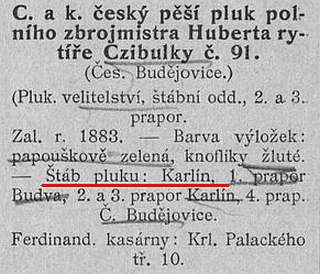
Regimentskanzlei Budweis is mentioned by Švejk when he tells the medical commission at blázinec that he has been released from the army due to feeblemindedness. He adds that this can be confirmed at the Ergänzungskommando in Karlín or the regimental office in Budějovice.
Background
Regimentskanzlei Budweis (main regimental staff office) was in 1914 stationed in Karlín and not in Budějovice as Švejk claims. When the war started, several regimental functions were indeed located in Ferdinandova kasárna in Karlín: 2. field battalion, regimental staff and IR. 91 regimental command itself. This inconsistency is probably due to a mix-up with the Ergänzungsbezirkskommando which together with the 4th battalion and Ersatzbataillon IR. 91 were indeed stationed in Budějovice.
We should also take into account that the barracks in Karlín were converted to a Red Cross reserve hospital soon after the outbreak of war and that the administrative functions of the regiment would now have been moved, some of them no doubt to Budějovice, and others to the front. See Ergänzungskommando.
The good soldier Švejk in captivity
In Dobrý voják Švejk v zajetí the regiment's office and the barracks where it was located the starting point of the plot. Švejk resisted attempt to dismiss him from the army, he wanted to serve his emperor. It is also informed that the barracks were built by emperor Josef II.[1]
V kanceláři regimentu pod číslem 16112 byl uschován akt týkající se průběhu i výsledku superarbitračního řízení s dobrým vojákem Švejkem.
Quote(s) from the novel
[I.4] „Já, pánové,“ hájil se Švejk, „nejsem žádný simulant, já jsem opravdovej blbec, můžete se zpravit v kanceláři jednadevadesátýho pluku v Českých Budějovicích nebo na doplňovacím velitelství v Karlíně.“
Also written:Regimental officeenPlukové kancelářczRegimentskontoretno
Literature
| 1 | Dobrý voják Švejk v zajetí | 1917 |
 | Ergänzungskommando |  | ||||
| Budějovice, Pekárenská ulice | ||||||
| ||||||

IR91, Seidels kleines Armeeschema August 1914
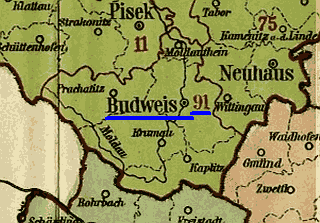
91. Ergänzungsbezirk
Ergänzungskommando is mentioned by Švejk when he tells the medical commission at blázinec that he has been released from the army due to feeble-mindedness. He adds that this can be confirmed at the reserve command in Karlín or Regimentskanzlei Budweis in Budějovice.
Background
Ergänzungskommando by near certainty refers to Ergänzungsbezirkskommando Budweis. It was located in Backhaus in Budějovice (Pekárenská ulice) and not in Karlín as Švejk tells the doctors. At the outbreak of war, several other regimental functions resided Ferdinandova kasárna in Karlín: III. Feldbataillon, regimental staff and IR. 91 Regimentskommando itself. We may therefore be witnessing a straight mix-up between Regimentskanzlei Budweis and Ergänzungsbezirkskommando. Both are mentioned in the same sentence, so Švejk appears to have swapped the respective locations.
The district reserve command Budweis (until 1912 Nr. 91 Budweis) was resposible for draft and call-up of reserves in Ergänzungsbezirk Budweis, see map. The recruitment district covered five hejtmanství: Budějovice, Týn nad Vltavou, Kaplice, Krumlov and Prachatice. The army units that the district provided recruits for were IR. 91 and 14. Dragonerregiment.
Commander in 1914 was colonel Johann Splichal but he was sent to the front soon after hostilities began, and it is not clear who replaced him. Splichal was also head of Ersatzbataillon IR. 91, and in this role, he was replaced by Karl Schlager. It may also be that the latter also succeeded him as head of the district reserve command. Usually, these two positions were held by the same officer. That would however not have been the case after 1 June 1915 when the replacement battalion was transferred to Királyhida, whereas the recruitment command for obvious reasons remained in its home district.
Quote(s) from the novel
[I.4] „Já, pánové,“ hájil se Švejk, „nejsem žádný simulant, já jsem opravdovej blbec, můžete se zpravit v kanceláři jednadevadesátýho pluku v Českých Budějovicích nebo na doplňovacím velitelství v Karlíně.“
[II.2] Že jsem mohl být felddienstunfähig. Taková ohromná protekce! Mohl jsem se válet někde v kanceláři na doplňovacím velitelství, ale má neopatrnost mně podrazila nohy.“
Also written:Replenishment commandenDoplňovací velitelstvíczRekrutteringskommandono
Literature
 | Policejní komisařství Salmova ulice |  | |||||
| Praha II./507, Salmovská ul. 20 | |||||||
| |||||||

Politický kalendář, 1910
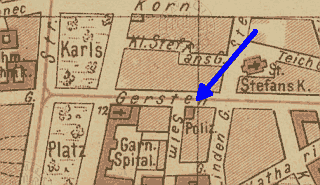
, 1910

Zum Wortschatz des tschechischen Rotwelsch, , 1926
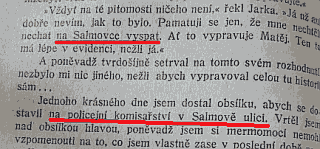
Ve dvou se to lépe táhne, , Z.M. Kuděj

Denní raport - c.k. okresního policejního komisařství III.z. 31./12. 1908
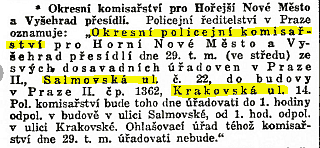
Československá republika, 26.6.1926
Policejní komisařství Salmova ulice is the scene of a full chapter in the novel. Švejk is taken straight here after refusing the leave blázinec without lunch. His first encounter is with the brutal police inspector Inspektor Braun but then the plot revolves mostly around a conversation with his fellow inmate, a very solid citizen who for the moment has slid off the path of virtue. Švejk does his utmost to convince him that his situation is hopeless.
The stay here was only one afternoon, and Švejk taken to the first floor for interrogation, this time by a fat and friendly police officer. Under escort he is led from the guard house (see Strážnice) on the ground floor onwards to c.k. policejní ředitelství. It was on the way he read the emperor's declaration of war.
Background
Policejní komisařství Salmova ulice was the police station of the 3rd police district (Hořejší Nové Město - Upper New Town) in Prague, called "Salmovka" in common speech. It was located on the corner of Ječná ulice and Salmovská ulice. The police station was operating until 29 June 1926 when it was moved to Krakovská ulice where it is still located. The building was subsequently demolished and in 1928 the current edifice was erected on the site.
The station was often called "Salmovka" in day-to-day speech, a term used by e.g. Zdeněk Matěj Kuděj in one of his books about Jaroslav Hašek (Ve dvou se to lépe táhne, 1924). The term is also listed in a German-language dictionary of Czech slang (Eugen Rippl, 1926).
Chief inspector in 1906 and until 1910 was Karel Fahoun, and he was succeeded by Antonín Sklenička. No evidence has been found, in address books or elsewhere, that any Inspektor Braun ever served here.
Hašek at Salmovská
This is a police station that Jaroslav Hašek knew well, because it within this police district he was born and grew up. Also in his adult life he for the most part lived within its jurisdiction. He was christened in Kostel sv. Štefána in the immediate vicinity and on several occasions he lived only a few steps away. It has also been claimed that the author was a personal friend of police chief Karel Fahoun and his family but Břetislav Hůla refutes this claim after consulting Fahoun's son.
Police records from 1902 to 1912 reveal that Jaroslav Hašek was brought to the station several times. Most of the cases refer to breaches of public order and small-scale vandalism, induced by drinking. On New Years eve 1908 he and the Croat student Rudolf Giunio were arrested and locked up here after a pub brawl. Hašek was handed five days in prison for his efforts. See Bendlovka for more information about this incident.
Quote(s) from the novel
[I.5] Švejk prohlásil, že když někoho vyhazují s blázince, že ho nesmějí vyhodit bez oběda. Výtržnosti učinil konec vrátným přivolaný policejní strážník, který Švejka předvedl na policejní komisařství; do Salmovy ulice.
[I.5] „Víte co, Švejku,“ řekl vlídně pan komisař, „nač se zde, na Salmovce, máme s vámi zlobit? Nebude lepší, když vás pošleme na policejní ředitelství?“
Sources: Hůla, Sergey Soloukh, Jaroslav Šerák
Also written:District police station No. 3enPolizeikommisariat Nr. IIIdeBydelspolitistasjon Nr. 3no
Literature



|
I. In the rear |
 | |
5. Švejk at the district police station in Salmova street | |||
 | Emauzský klášter |  | ||||
| Praha II./320, na Slovanech 1 | ||||||
| ||||||
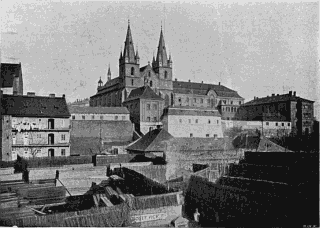
The monastery at the turn of the century
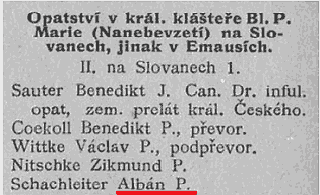
Address book 1907
Emauzský klášter is the place where a monk is supposed to have hung himself in a crucifix according to Švejk. This is a story he tells his unfortunate cell-mate at Salmova ulice police station, when the latter wants to hang himself.
The monastery is mentioned again in [I.9] as the place where Feldkurat Katz was baptised. The priest who christened him was páter Albán, see páter Albán.
In [I.13] the monastery is mentioned for the third time, now by Švejk who tells Feldkurat Katz about a gardening assistant who worked there.
Background
Emauzský klášter is a Benedictine monastery in Prague, located south of Karlovo náměstí. It was founded by emperor Charles IV in 1347. The abovementioned páter Albán served as abbot here from 1908 until 1918 and during the war a part of the monastery was converted to a hospital for soldiers.
After the proclamation of Czechoslovak independence on 28 October 1918 the abbot and the German monks left the country after they were subjected to harassment from crowds and militia groups. This was caused by accusations in the press, one of them being that they spied for Germany.
The monastery was badly damaged during an allied bomb raid in 1945, and was reconstructed in a somewhat different style after the war. It was confiscated by both the Nazis (1941) and the communists (1950) but was in 1990 returned to the Benedictine order.
Quote(s) from the novel
[I.5] Ledaže byste se pověsil vkleče u pryčny, jako to udělal ten mnich v klášteře v Emauzích, co se oběsil na krucifixu kvůli jedný mladý židovce.
[I.9] Křtili ho slavnostně v Emauzích. Sám páter Albán ho na máčel do křtitelnice.
[I.13] "Tak si koupíme katechismus, pane feldkurát, tam to bude," řekl Švejk, "to je jako průvodčí cizinců pro duchovní pastýře. V Emauzích pracoval v klášteře jeden zahradnickej pomocník, ...
Also written:Emmaus MonasteryenEmmausklosterdeCloître d'EmmaüsfrEmmausklosteretno
Literature
- Pohled do vojenské nemocnice v pražském klášteře emauzském2.10.1914
- Historie Emauzského opatství
- Klášter EmauzyZdeňka Kuchyňová
 | Bendlovka |  | |||||
| Praha II./1867, Fügnerovo nám. 2 | |||||||
| |||||||

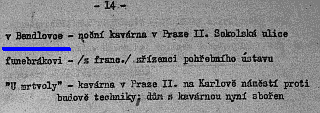
Břetislav Hůla, 1951
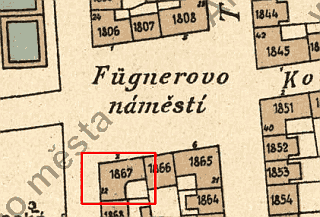
© AHMP

Denní raport - c.k. okresního policejního komisařství III.z. 31./12. 1908
Bendlovka is mentioned in a story Švejk "comforts" his cell-mate at Policejní komisařství Salmova ulice with. Švejk had once at Bendlovka slapped an undertaker, who had returned the compliment. The next day it was in the newspapers.
Background
Bendlovka is by near certainty an alternative term for Bendova kavárna (also Bendovka), a former tavern in Nové město that Jaroslav Hašek knew well. In his explanations from 1951 Břetislav Hůla identifies it as a night-café in Sokolská ulice and is supported by Radko Pytlík who locates it to the corner of Sokolská and Fügnerovo náměstí. The location was next to Apollo, and on the opposite corner of the square was U Šolců, another of Hašek's favourite taverns.
Hašek and Bendovka
A well documented incident that involved the author took place here on 31 December 1908. According to police reports Jaroslav Hašek was involved in a brawl in the café during the small hours of the morning. He and Croatian technical student Rudolf Giunio refused to pay the bill, an argument erupted and glasses were broken. When the patrol-man Slepička arrived the humorist knocked the hat off his head so reinforcements were called. The two troublemakers were subsequently taken to Policejní komisařství Salmova ulice and were released the next morning.
Opočenský remembers
Another brawl involving the author is recorded by his friend Gustav Roger Opočenský’s in his book about Jaroslav Hašek (1948). It was written almost 40 years after the incident, but there is little reason to doubt the essence of the story: a clash between the author and some employee of a funeral agency erupted at Bendovka. It took place “in the small hours of one hot spring Saturday evening, a few years before the war”. This story has certain parallels to both the 1908 incident, but also to the passage in The Good Soldier Švejk. Otherwise Opočenský writes that Bendova kavárna offered live music, had marble tables, and was open until early in the morning, and the beer was cheap and poor. By the time he wrote his book the premises were occupied by some printing works.
Strána mírného pokroku
Jaroslav Hašek devotes a story to Opočenský in his collection of tales about Strana mírného pokroku v mezích zákona and also here the night café is mentioned (as Bendova kavárna) and even in the same breath as Apollo. In another story the term "v Bendlovce" is used in the same manner as in the novel. It seems to refer to a tavern (or at least a place where people met). Jaroslav Hašek had a few showdowns with a certain editor of České slovo here. The editor was of “Mosaic confession”.
In the papers
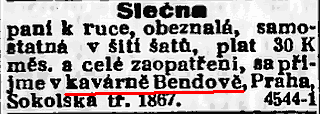
, 20.8.1910

, 3.11.1907
Newspaper reports confirm some of the information from Opočenský and also adds information about dancing arrangements. The café was operating at least from 1900 until the autumn of 1914, but at two locations. In the spring of 1905 the license of Marie Bendová was transferred from Nové město house No. 1816 to No. 1867. An advert from the first autumn of war reveals that opening times were by now shortened, to two in the morning, a common occurrence all over Austria-Hungary after the war broke out.
From time to time adverts seeking employees appeared, but reports about thefts, drunkenness and fighting were more prominent. Jaroslav Hašek was not the only troublemaker here. Here are just some of the incidents: in 1908 three German students caused serious trouble (reported in several newspapers) and in 1913 a stabbing incident was reported by Čech.
Quote(s) from the novel
[I.5] Nebo v Bendlovce jsem dal jednou jednomu funebrákovi facku a on mně ji vrátil. Abychom se smířili, museli nás oba zatknout, a hned to bylo v odpoledníčku.
Sources: Hůla, Radko Pytlík, Jaroslav Šerák, Gustav Roger Opočenský
Literature
- Kavárenská straka14.4.1900
- Přeložení živnosti bylo schváleno5.4.1905
- Bendova kavárna8.9.1907
- Pozor! Taneční zabáva!31.12.1907
- Z nočního působení buršáků21.11.1908
- Krvavá noční rvačka11.3.1913
- Pomstil se28.12.1913
- Kavárna Benda8.11.1914
 | U mrtvoly |  | ||||
| Praha II./310, Karlovo nám. 13 | ||||||
| ||||||
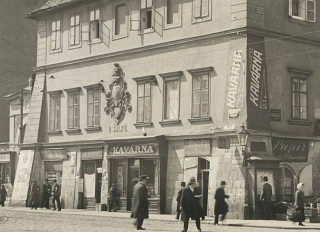
Picture from 1926
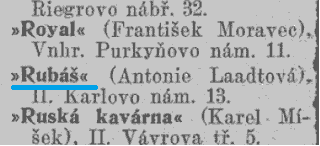

Břetislav Hůla
U mrtvoly is mentioned in a story Švejk tells to "encourage" his fellow prisoner Policejní komisařství Salmova ulice. See Bendlovka.
Background
U mrtvoly has not been identified with certainty, but was in all probability a café at Karlovo náměstí, at the corner of Resslova ulice. The building which amongst others housed Pivovar U Šálků was demolished in 1939. There was a kavárna in the building, with entrance at Karlovo náměstí but the pictures do not reveal any name.
The address book from 1910 has an entry café "Rubáš" here and this gives a hint: "Rubáš" means "shroud" and "mrtvola" means "carcass/body". Břetislav Hůla states that U mrtvoly was a café opposite the technical college and this fits well.The owner in 1910 was Antonie Laadtová who in 1901 obtained the license to run the café[a].
A newspaper article in Národní listy in 1922 reveals that it by then had been renamed Děvín[a], but no further information relating to this name has been found. Vilém Mrštík also mentions the place in his novel Santa Lucia from 1893.
Quote(s) from the novel
[I.5] Nebo když v kavárně „U mrtvoly“ rozbil ten pan rada dva tácky, myslíte, že ho šetřili? Byl taky na druhej den hned v novinách.
Sources: Hůla, Jaroslav Šerák
Also written:At the CorpseenZum LeichnamdeVed Liketno
Literature
- Románové restaurační a jiné zábavní podniky2009 - 2021
| a | Pražské noční lokály | 15.11.1922 |
 | Strážnice |  | |||
| Praha II./507, Ječná ul. 6 | |||||
| |||||

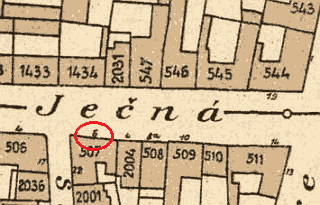
Strážnice is briefly mentioned when Švejk is led onwards from the police station in Salmovská ulice. From the novel it is clear that the guard is on street level because Švejk was interrogated on the first floor and was taken down to the guard room before he was escorted onwards.
Background
Strážnice was the guard house at the police station at Salmovská ulice. It was located in the same building as the police station but the entrance was from Ječná ulice. See Policejní komisařství Salmova ulice.
Quote(s) from the novel
[I.5] Ukloniv se uctivě, odcházel s policejním strážníkem dolů na strážnici a za čtvrt hodiny bylo již vidět na rohu Ječné ulice a Karlova náměstí Švejka v průvodu druhého policejního strážníka, který měl pod paždí objemnou knihu s německým nápisem „Arrestantenbuch“.
Also written:GuardroomenWachstubedeVaktromno



|
I. In the rear |
 | |
6. Švejk at home again, having broken through the vicious circle | |||
 | Kostel svatého Apolináře |  | ||||
| Praha II./443, Apolinářská 20 | ||||||
| ||||||

, 10.9.1911

Kostel svatého Apolináře is mentioned in the narrative because the servant from church was at U kalicha when Švejk dropped by the pub after his final release from c.k. policejní ředitelství. This was probably on 29 July 1914 because Austria-Hungary had just declared war on Serbia.
Background
Kostel svatého Apolináře is a church in Nové město which is located only a few hundred meters from U kalicha. It was built in the 15th century and named after Apollinaris of Ravenna.
Quote(s) from the novel
[I.6] Ve výčepu panovalo hrobové ticho. Sedělo tam několik hostů, mezi nimi kostelník od sv. Apolináře.
Also written:Church of Saint ApollinaireenApollinarkirchede
Literature
 | Volná myšlenka |  | ||||
| Královské Vinohrady/588, Korunní tř. 6 | ||||||
| ||||||
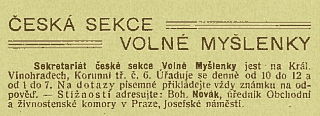
Věstník volné myšlenky, 1910
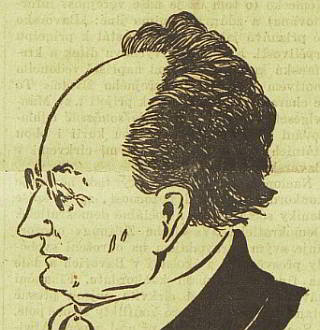
Karel Pelant. Volná myšlenka, 1.2.1925
Volná myšlenka is mentioned in when pubkeeper Palivec cries out in court: "Long live Free thought!". This is what Mrs. Palivcová tells Švejk when he returns to U kalicha after having been released at the time war broke out.
Background
Volná myšlenka was an association of freethinkers, an anticlerical an atheist movement that appeared in many countries in the 19th century. The best known freethinker internationally was Francesc Ferrer i Guàrdia (1859-1909).
The Czech organisation was founded in 1904, and provisionally dissolved in 1915. The best known representative of the Czech organisation was Machar, chairman from 1909. The organization also published a monthly periodical of the same name. Their most immediate goal was separation of state and church.
Karel Pelant (1874 - 1925) was one of the founders of the Czech section and this was a person Hašek knew well. Zdeněk Matěj Kuděj describes a meeting between the two in Plzeň in 1913 that was arranged after Pelant, at the time editor of the weekly Směr, owed Hašek money for a few stories he had written.
Pelant also appears in Strana mírného pokroku v mezích zákona and is listed as publishers of the Freethinker's monthly.
Quote(s) from the novel
[I.6] Já jsem se tak lekla toho příbuzenského poměru, aby snad ještě z toho něco nebylo, tak jsem se vzdala svědectví a on chudák stará se tak na mne podíval, do smrti na ty jeho oči nezapomenu. A potom, po rozsudku, když ho odváděli, vykřik jim tam na chodbě, jak byl z toho cele] pitomej: ,Ať žije Volná myšlenka!`
Literature
 | Mimosa |  | ||||
| Praha I./496, Havelská ul. 31 | ||||||
| ||||||


Právo lidu, 16.5.1914
Mimosa is mentioned because the doorman who had occupied Švejks room worked here.
Background
Mimosa was a well known night café that doesn't exist anymore. The Czech-Jewish reporter Egon Erwin Kisch set the plot of his only novel here. Der Mädchenhirt (The Pimp) was published in May 1914. In the address book of 1910 another café is listed at number 496/31: U Hvězdičky tři zlaté, but already in 1913 newspaper adverts revealed that Mimosa was operating. The café offered music and entertainment and to judge by adverts it started operating early in 1913.
In February 1917 Čech reported that the establishment had been forced to close down on demand from the police[a].
Quote(s) from the novel
[I.6] Když si bral límeček a skládal kravatu, vzpamatoval se již do té míry, že mohl ujistit Švejka, že noční kavárna „Mimosa“ jest opravdu jedna z nejslušnějších nočních místností, kam mají přístup jedině dámy, které mají policejní knížku v úplném pořádku, a zval Švejka srdečně, aby přišel na návštěvu.
Sources: Jaroslav Šerák, Radko Pytlík
Literature
- Románové restaurační a jiné zábavní podniky2009 - 2021
- Ein prager Roman von Egon Erwin Kisch2.5.1914
| a | Z ovzduší hostinské živnosti | 18.2.1917 |



|
I. In the rear |
 | |
7. Švejk goes in the military | |||
 | K.u.k. Kriegsministerium |  | ||||
| Wien I./-, Stubenring 1 | ||||||
| ||||||
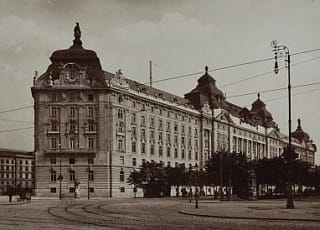
Stubenring 1, neues Kriegsministerium; Foto: A. Stauda (um 1914)
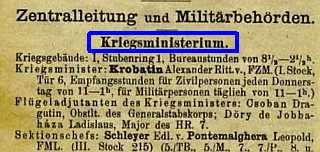
,1914
K.u.k. Kriegsministerium is mentioned by the author when he informs that the ministry remembered Švejk at the time when the Austrians where fleeing across Raba, and that Švejk was to help them out of the difficult situation.
The ministery appears again at the start of [I.13] when Feldkurat Katz receives a directive about how to adminster the last rites. In [II.1] the author notes that issued the propaganda posters that Švejk read at the station in Tábor (see Trainsoldat Bong and Zugsführer Danko).
When Einjährigfreiwilliger Marek describes Fähnrich Dauerling the ministry is mentioned twice. They allegedly published the book Drill oder Erziehung* and Marek also claims that this is where the most stupid officers end up.
* Drill oder Erziehung was published by L.W Seidel & Sohn, not by Kriegsministerium. The author was Johann Orth.
Background
K.u.k. Kriegsministerium was the common ministery of war of Austria-Hungary, one of the three ministeries that the two constituent parts of the Dual Monarchy shared. Minister of War from 1912 until 1917 was Alexander von Krobatin. He was regarded as one of the hawks, who wanted to settle scores with Serbia at the slighest pretext. As can be seen on the picture he gave audience to civilians two hours every week.
The war ministry was not responsible for k.k. Landwehr and Honvéd, the territorial armies of the two parts of the empire. The formal status Švejk held with regards to the ministery is unclear. He was classified as Landsturm (domobranec), reservists that were only called up on in great danger to the motherland.
Quote(s) from the novel
[I.7] V době, kdy lesy na řece Rábu v Haliči viděly utíkat přes Ráb rakouská vojska a dole v Srbsku rakouské divise jedna za druhou dostávaly přes kalhoty to, co jim dávno patřilo, vzpomnělo si rakouské ministerstvo vojenství i na Švejka, aby pomohl mocnářství z bryndy.
[I.13] Polní kurát Otto Katz seděl zadumané nad cirkulářem, který právě přinesl z kasáren. Byl to rezervát ministerstva vojenství
[I.15] Zatraceně, proč ministerstvo vojenství dává takové věci do školního programu. To je přece pro dělostřelectvo.
[II.1] Strážnice byla vyzdobena litografiemi, které v té době dalo rozesílat ministerstvo vojenství po všech kancelářích, kterými procházeli vojáci, stejně jako do škol i do kasáren.
[II.2] A seshora ho bombardovali přípisy, ve kterých ministerstvo zemské obrany poukazovalo, že z píseckého okresu podle zpráv ministerstva vojenství přecházejí k nepříteli.
[II.2] Jeho hloupost byla tak oslňující, že byla největší naděje, že snad po několika desetiletích dostane se do tereziánské vojenské akademie či do ministerstva vojenství.
[II.2] Jednoroční dobrovolník si oddechl a vypravoval dál: „Vyšla nákladem ministerstva vojenství kniha ,Drill oder Erziehung’, ze které vyčetl Dauerling, že na vojáky patří hrůza.
[II.3] Že psaní pošle na velitelství pluku, do ministerstva vojenství, uveřejní je v novinách.
Also written:I. and R. Ministry of WarenC. a k. ministerstvo vojenstvícz
Literature
 | Infanterieregiment Nr. 18 |  | ||||
| Hradec Králové/-, - - | ||||||
| ||||||
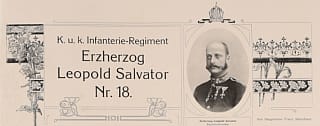
,1908
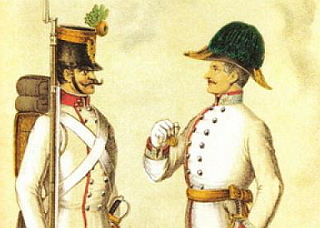
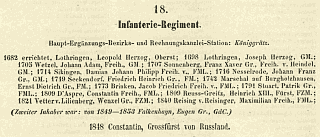
, 1859
Infanterieregiment Nr. 18 is mentioned in the song Jenerál Windischgrätz a vojenští páni through the term "the eighteenth band". See Solferino and Piedmont.
Background
Infanterieregiment Nr. 18 was an infantry regiment with recruitment district Hradec Králové that took part in nearly every war the Habsburg Empire fought ever since the regiment was founded in 1682.
The theme of the song is the battle of Solferino that decided the outcome of the Second Italian war of independence in 1859. During the battle only the regiment's 4th battalion was involved, the other battalions were fortunate enough to be assigned border duty.
In 1914 the bulk of the regiment's soldiers were Czechs (75 per cent), the rest Germans.
An alternative version
Václav Pletka claims that the "18th gang" refers to a Feldjägerbataillon from Prague that was dissolved in 1893[a]. This seems however unlikely as none of the 29 Jäger-Bataillone where in 1859 garrisoned in Prague. Feldjägerbataillon Nr. 18 was located in Krumau but it remains to be investigated whether it participated by Solferino.
The good soldier Švejk in captivity
Some verses of the song about General Windischgrätz are also quoted in Dobrý voják Švejk v zajetí and in a context that is very similar.[1]
Quote(s) from the novel
[I.7] Krve po kolena a na fůry masa, vždyť se tam seka vosumnáctá chasa, hop, hop, hop!
Literature
- 1859 - C.k. řadový pěší pluk č.18 v bitvě u Solferinaz.s.
- Militärschematismus des Österreichischen Kaisertums1859
- Der Oberste Kriegsherr und sein Stab1908
| a | Písničky Josefa Švejka | 1968 | |
| 1 | Dobrý voják Švejk v zajetí | 1917 |
 | Pražské úřední noviny |  | ||||
| Praha III./387, Karmelitská ul. 6 | ||||||
| ||||||
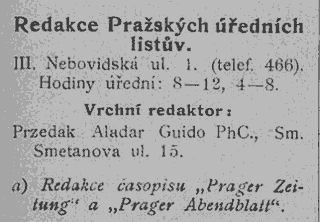

, 1907
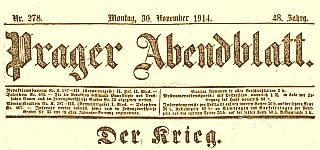
,30.11.1914

,5.7.1914

,8.9.1914
Pražské úřední noviny prints a glowing homage to the patriotic cripple Švejk after he was pushed to the draft commission in a wheelchair. The title was: "Patriotism of a cripple".
Background
Pražské úřední noviny is not listed in the newspaper section of the address books of 1907 and 1910, but there is little doubt that the author refers to the publications of c.k. Místodržitelství (k.k. Statthalterei), often referred to by this or similar names like Pražské úřední listy, in German Prager Amtsblätter. These newspapers were mouthpieces of the Austrian authorities in Bohemia, headed by the Statthalter (governor).
The newspapers were published in Czech and German, with one official and one regular commercial part. The main periodical was Prager Zeitung in German, in Czech Pražské Noviny. Both were morning papers that were published every day except Monday. In the afternoon of working days they also published Prager Abendblatt, albeit in German only. Official announcements were printed in a separate add-on on weekdays: Úřední list Pražských Novin and Amtsblatt der Prager Zeitung respectively. On Sundays an entertainment magazine was added.
The editorial offices were located in Malá Strana, right behind Kampa island[a]. Some time between 1907 and 1910 they changed address, but were still in the same block. Editor in chief for all the papers was Aladar Guido Przedak, for the Czech part Jan Svátek. Przedak (1857-1926) was the chief editor from 1900 until 1918 and also bore the title k.u.k. Regierungsrat. The circulation of Prager Abendblatt was quintupled during his reign as editor[b].
Quote(s) from the novel
[I.7] O celé této události objevil se v „Pražských úředních novinách“ tento článek:
[I.7] Vlastenectví mrzáka. Včera dopoledne byli chodci na hlavních pražských třídách svědky scény, která krásně mluví o tom, že v této veliké a vážné době i synové našeho národa mohou dáti nejskvělejší příklady věrnosti a oddanosti k trůnu stařičkého mocnáře. Zdá se nám, že se vrátily doby starých Řeků a Římanů, kdy Mucius Scaevola dal se odvésti do boje, nedbaje své upálené ruky. Nejsvětější city a zájmy byly včera krásně demonstrovány mrzákem o berlích, kterého stará matička vezla na vozíku pro nemocné. Tento syn českého národa dobrovolně, nedbaje své neduživosti, dal se odvésti na vojnu, aby dal svůj život i statky za svého císaře. A jestli jeho volání „Na Bělehrad!“ mělo tak živý ohlas v pražských ulicích, jest to jen svědectvím, že Pražané skýtají vzorné příklady lásky k vlasti a k panovnickému domu.
[I.8] Zatímco jsem seděl, děly se v kasárnách divy. Náš obršt zakázal vojákům vůbec číst, třebas by to byly ,Pražské úřední noviny’, v kantině nesměli balit do novin ani párky, ani syrečky. Vod tý doby vojáci začli číst a náš regiment byl nejvzdělanější.
Also written:Prague Official NewspaperenPrager AmtszeitungdePraha Amtstidendeno
Literature
| a | Adresář královského hlavního města Prahy a obcí sousedních | 1910 | |
| b | Przedak (Předak), Aladar Guido (1857-1926), Journalist und Fachschriftsteller |
 | Prager Tagblatt |  | ||||
| Praha I./896, Panská ul. 12 | ||||||
| ||||||
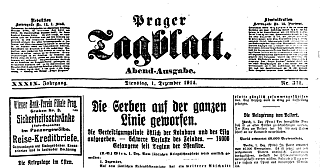
,1.12.1914
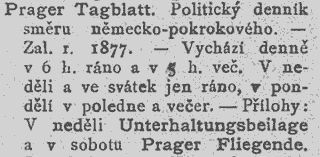
Listed in the 1910 address book.
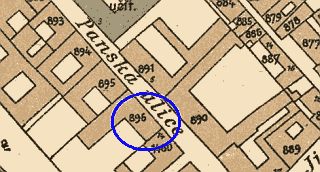
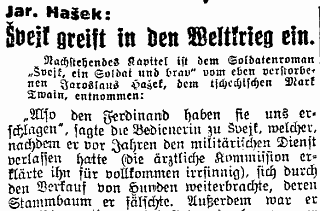
,5.1.1923

,17.1.1926
Prager Tagblatt briefly notes that Švejk was protected by Germans against Czech agents from the Entente who wanted to lynch him on his way to Střelecký ostrov.
The newspapers features again in connection with the theft of Fox. The dog's owner, Oberst Kraus, placed adverts both here and in Bohemia where he promises a reward of 100 crowns.
Background
Prager Tagblatt was a German language daily published in Prague from 1877 until 1939. The paper had a reputation for outstanding journalistic qualities, and was regarded as one of the very best German-language newspapers of its time. It was over the years associated with a number of distinguished writers, amongst them Max Brod, Egon Erwin Kisch, Josef Roth, Michal Mareš and Friedrich Torberg. Franz Kafka was also amongst those who contributed to the newspaper and he was also an avid reader of it.
During World War I the paper aligned with the propaganda, but was often the victim of censorship, and put more emphasis on the human costs of the war than many other papers. In the inter-war years the daily re-established its reputation for journalistic excellence, but hardly two months after the German invasion in March 1939 it was closed for good. The numerous Jewish staff had been dismissed already during the days after the invasion.
Politically it was regarded as liberal-democratic, and in Czech address books it is listed as "German progressive". Chief editor in 1910 was Gustav Horn. The editorial and administration offices were located in Panská ulice (Herrengasse)[c], incidentally very close to where Oberst Kraus caught Oberleutnant Lukáš red-handed with the stolen Fox.
Prager Tagblatt and Hašek
After Jaroslav Hašek's death on 3 January 1923 Prager Tagblatt played a major role in acknowledging and spreading the word about the late author and his satirical masterpiece. This was largely thanks to Max Brod, a writer and journalist who is better known as the custodian of Franz Kafka's literary heritage.
Already on 5 January the paper printed an obituary[a], and Brod's own translation of the first chapter of The Good Soldier Švejk appeared in the same issue[b]. During the next fifteen years Švejk and Hašek showed up repeatedly in the newspaper's columns, particularly in 1926 when the full translation into German by Grete Reiner was published. At least seven of Hašek's short stories (translated into German) were printed in Prager Tagblatt in the years after the author's death.
The good soldier Švejk in captivity
In Dobrý voják Švejk v zajetí Prager Tagblatt is also mentioned but in a differnt setting. In Švejk's cell at c.k. policejní ředitelství was sitting a higher official from the governor's office who had been arrested in front of their editorial offices in Panská ulice.[1]
Velmi zamyšleně se tvářil pán v prostředních letech, velmi slušně oděný, který se včera dostal do chumlu před Prager Tagblattem v Panské ulici. Někdo ho zatkl, radu od místodržitelství, omdlel jim rozčilením, dopravili ho na policejní ředitelství v truhle a pak našli u něho v kapse nějaké kamení. Ještě ho nevyslechli. Domnívají se, že chtěl vytlouci Prager Tagblatt, on, místodržitelský rada, který nečte kromě úředního deníčku jiných novin než Prager Tagblatt, za manželku má Němkyni a …
Švejk greift in den Weltkrieg ein (Max Brod)
"Also den Ferdinand haben die uns erschlagen", sagte die Bedienerin zu Švejk, welcher, nachdem er vor Jahren den militärischen Dienst verlassen hatte (die ärtztliche Kommission erklärte ihn für vollkommen irrsinnig), sich durch den Verkauf von Hunden weiterbrachte, deren Stammbaum er fälschte.
Quote(s) from the novel
[I.7] Ve stejném smyslu psal i „Prager Tagblatt“, který končil svůj článek slovy, že mrzáka dobrovolce vyprovázel zástup Němců, kteří ho svými těly chránili před lynchováním ze strany českých agentů známé Dohody.
[I.15] „Pane nadporučíku,“ pokračoval plukovník, „považujete za správné jezdit na ukradeném koni? Nečetl jste inserát v ,Bohemii’ a v ,Tagblattu’, že se mně ztratil stájový pinč?
[I.15] V tiché resignaci seděl nadporučík na židli a měl takový pocit, že nemá tolik síly nejen dát Švejkovi pohlavek, ale dokonce ukroutit si cigaretu, a sám nevěděl ani, proč posílá Švejka pro „Bohemii“ a „Tagblatt“, aby si Švejk přečetl plukovníkův inserát o ukradeném psu.
Literature
- Theater Adrie25.12.1921
- Der brave Soldat Švejk ist dem Ministerium zu schlimm...22.2.1925
- Ein Blick ins Atelier29.1.1926
- Der brave Soldat Schwejk im Weltkrieg8.5.1926
- Hašek in deustcher Sprache4.9.1926
- Der gute Soldat Švejk vor Gericht6.3.1924
- Abenteuer des braven Soldaten Hašek23.12.1926
- Mužné zakročení pana Silberbergra proti TagblattuJaroslav Hašek11.12.1908
- Smutný konec válečného zpravodaje Prager TagblattuEduard Drobílek25.11.1912
| a | Jaroslav Hašek | 5.1.1923 | |
| b | Švejk greift in den Weltkrieg ein | 5.1.1923 | |
| c | Adresář královského hlavního města Prahy a obcí sousedních | 1910 | |
| 1 | Dobrý voják Švejk v zajetí | 1917 |
 | Bohemia |  | ||||
| Praha I./211, Liliova ul. 13 | ||||||
| ||||||
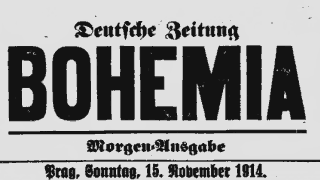
The first issue after the change of names
,15.11.1914

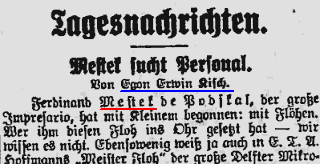
Ferdinand Mestek de Podskal, E.E. Kisch
,5.7.1914
Bohemia published an article that resembled the one from Prager Tagblatt about the cripple Švejk and his journey in a wheelchair. It adds that gifts for the benefit of the soldier can be presented at the administrative office. In the next chapter it becomes clear that it was in this paper Baronesse von Botzenheim read about the keen soldier.
In [I.14] the newspaper is mentioned again as Oberst Kraus placed an advert about the missing dog and offered a reward of 100 crowns.
On the train to Tábor [II.1] it is revealed that even Oberleutnant Lukáš reads Bohemia.
Background
Bohemia was a German-language daily published in Prague from 1828 til 1938, associated with the German Liberal Party. During the war they took a strongly patriotic stance, and from 15 November 1914 even changed the name to Deutsche Zeitung Bohemia. The editorial and administration offices were located in Liliova ulice in Staré město and chief editor in 1914 was Andreas Haase. He held the position for an impressive 40 years, from 1879 to 1919.
E.E. Kisch
Their best known reporter was without doubt the legendary Egon Erwin Kisch. He worked for the paper from 1906 to 1913, and published many reports from Prague, mainly focused on the shady underworld. Kisch dedicated a feuilleton to flea circus director Mestek, mentions murderer Valeš and negro Kristian, and wrote about a number of watering holes that are familiar to readers of The Good Soldier Švejk: Apollo, Tunel, U Kocanů, Montmartre, U Brejšky a.o.
Quote(s) from the novel
[I.7] „Bohemie“ uveřejnila tuto zprávu žádajíc, aby mrzák vlastenec byl odměněn, a oznámila, že pro neznámého přijímá od německých občanů dárky v administraci listu.
[I.15] „Pane nadporučíku,“ pokračoval plukovník, „považujete za správné jezdit na ukradeném koni? Nečetl jste inserát v ,Bohemii’ a v ,Tagblattu’, že se mně ztratil stájový pinč?
[I.15] V tiché resignaci seděl nadporučík na židli a měl takový pocit, že nemá tolik síly nejen dát Švejkovi pohlavek, ale dokonce ukroutit si cigaretu, a sám nevěděl ani, proč posílá Švejka pro „Bohemii“ a „Tagblatt“, aby si Švejk přečetl plukovníkův inserát o ukradeném psu.
[II.1] Nadporučíkovi bezděčně zacvakaly zuby, vzdychl si, vytáhl z pláště „Bohemii“ a četl zprávy o velkých vítězstvích, o činnosti německé ponorky „E“ na Středozemním moři...
Literature
 | Odvodní komise |  | |||||
| Praha I./336, Střelecký ostrov - | |||||||
| |||||||
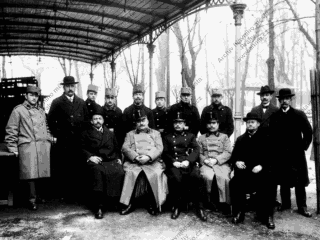
The draft commission on 31 December 1914
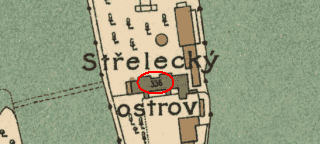
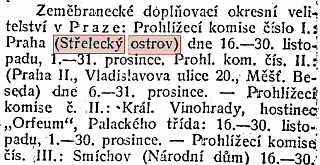
Oveview of Landsturm medical examination commissions in Prague
,8.11.1914
Odvodní komise is the Czech name for Draft commission, the body that examined Švejk at Střelecký ostrov. Head of the commission was the infamous Doctor Bautze.
Background
Odvodní komise refers in this context to Landsturmmusterungskommision No. 1, a temporary body who were tasked with carrying out a renewed medical examination of Landsturm recruits who in peace time had either been declared unfit for armed service (Waffenunfähig) or had been dismissed from the armed forces after initially having started their military service (Superarbitriert).
Commission no. 1 was responsible for recruits who lived in Prague and had Heimatrecht in the city. In addition it examined residents of Prague with right of domicile elsewhere, if these were born from 1878 to 1883. Jaroslav Hašek belonged to the latter group (right of domicile Mydlovary, born 1883) and necessarily also Švejk. As a soldier in Infanterieregiment Nr. 91 his right of domicile must have been in Heeresergänzungsbezirk Nr. 91. See Ergänzungskommando.
The commission started the examinations on 1 October 1914 when those born from 1892 to 1894 were called in. Amongst this group more than half were deemed fit for service. From 16 November to 31 December it was the turn of those born from 1878 to 1890. Amongst this group far fewer were passed capable Tauglich, less than one third. This latter group is the most interesting for us as it was here Jaroslav Hašek fit in. Everything indicates that also Švejk belonged to this group and was thus born between 1878 and 1883. On 20 January 1915 it was announced that those passed for service were to report at their Ergänzungskommando on 15 February.
The examinations took place in the garden restaurant at Střelecký ostrov, on the southern part of the island. The restaurant was in 1914 a popular destination.
Quote(s) from the novel
[I.7] Když Švejk revírnímu inspektorovi ukázal, že to má černé na bílém, že dne musí před odvodní komisi, byl revírní inspektor trochu zklamán; kvůli zamezení výtržnosti dal doprovázet vozík se Švejkem dvěma jízdními strážníky na Střelecký ostrov.
Also written:Draft commissionenMusterungskommisiondeMønstringskommisjonenno
Literature
- Svolávací vyhláška E22.10.1914
- Prodlídka domobranců9.11.1914
- Svolávací vyhláška20.1.1915
- Einberufung der Landsturmjahrgange 1878-188622.1.1915
- Anekdota o Jaroslavu Haškovi5.12.1918
- Románové restaurační a jiné zábavní podniky2009 - 2021



|
I. In the rear |
 | |
8. Švejk as a malingerer | |||
 | Posádková věznice |  | |||||
| Praha IV./214, Kapucínská 2 | |||||||
| |||||||
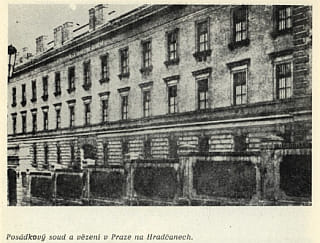
, Karel Pichlík
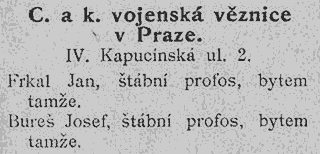
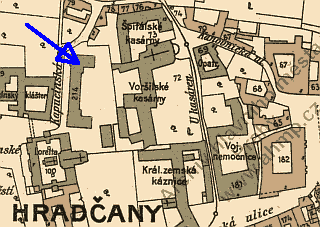
Posádková věznice is apparently the scene of the plot of two entire chapters. Both [I.8] and [I.9] takes place in and around the garrison prison. The first part is set in the sick-barrack of the prison, then moves on to cell no. 16. Švejk's escape starts in the chapel when Feldkurat Katz during holy mass takes to Švejk and consequently employs him as him officer's servant.
The prison is first mentioned at the end of [I.7] and it is said that this is where Švejk is going. Amongst the people Švejk met during his imprisonment are: Doctor Grünstein, Baronesse von Botzenheim, Hauptmann Linhart, the warders Stabsprofus Slavík, Feldwebel Řepa and Korporal Říha - and at the very end: the military prosecution represented by Auditor Bernis.
Background
Posádková věznice is the author's term for c.a k. vojenská věznice v Praze (k.u.k. Militärgefängnis von Prag), a prison that was part of the garrison complex at Hradčany. It shared the building with k.u.k. Militärgericht Prag and the k.k. Landwehr court. The building is located behind Loreta; and was opened in 1896 and is still in use, but not publicly accessible. Its function as a prison and brutal interrogation centre was revitalised during the Nazi and Communist dictatorships.
In 1906 there were two Stabsprofusen employed at the prison, but none of them fit the description of Stabsprofus Slavík, Korporal Říha, or Feldwebel Řepa. The two were Jan Frkal and Josef Bureš and they lived on the premises. If any of them was a model for the literary figures is impossible to say and it can not be determined if the author had anything to do with the garrison prison at all, so we must assumed that the inspiration for those figures hailed from elsewhere. On the other hand it is possible that Jaroslav Hašek had heard some story from former inmates of the prison. The description of the conditions in the prison and the brutality of the warders all in all appears strongly exaggerated.
It seems that the author was not very familiar with the organisation of the garrison. There is contradicting information on where Švejk actually was: at Vojenská nemocnice Hradčany or in a sick-bay within the prison. One passage indicates that the author believes that the military hospital was part of the prison, which it clearly wasn't. In chapter nine the reader gets the impression that the garrison actually WAS the prison, which it wasn't (at most "garrison" was a colloquial term for the garrison prison).
Antonín Matějovský

Antonín Matějovský
In 1923 a series of publications called "Documents from our national revolution" started to appear. Here one witness, A. Matějovský, gives some insight into the conditions at the prison. He was arrested after having distributed the so-called "Tsar Nicholas II's manifest" in 1914 and given a 10 year term. He spent the first 16 months at Hradčany before being transferred to Arad. His description of the prison is completely at odds with what Švejk experienced. The staff behaved impeccably towards the prisoners and gave them a friendly send-off to Arad, where the conditions were much worse. Matějovský was released in 1917 during the general amnesty issued by the new emperor Karl I. [a]
Quote(s) from the novel
[I.8] Švejka v posádkové věznici uložili do nemocničního baráku právě mezi takové malomyslné simulanty. „Už to nevydržím,“ řekl jeho soused na posteli, kterého přivedli z ordinačního pokoje, kde mu již podruhé vyplachovali žaludek. Muž ten simuloval krátkozrakost. „Zítra pojedu k pluku,“ rozhodoval se druhý soused po levé straně, který právě dostal klystýr, simuluje, že je hluchý jako pařez.
[II.4] Když jsem seděl na garnizóně, tak tam s námi byt takovej chytrej člověk vzdělanej, profesor na obchodní škole.
Also written:Garrison prisonenGarnisonsgefängnisdeGarnisonsarrestenno
Literature
| a | Dokumenty naší národní revoluce | 1923 |
 | Vojenská nemocnice Hradčany |  | |||||
| Praha IV./181, Loretánská 4 | |||||||
| |||||||

© Stará Praha
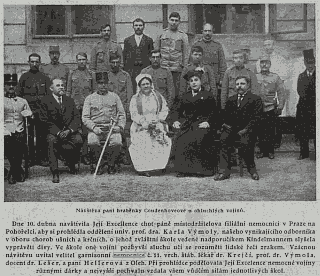
,5.5.1916
Vojenská nemocnice Hradčany is mentioned by Doctor Grünstein when he asks Švejk if he enjoys his stay at the military hospital. It is however unclear if the hospital is part of the plot at all, as the information about Švejk's stay amongst the malingerers at Hradčany is somewhat contradictory. In other parts of the text the reader gets the impression that it is talk of a sick-bay that is part of the garrison prison. See Posádková věznice for more on this topic.
Background
Vojenská nemocnice Hradčany refers to a branch of k.u.k. Militärspital nr. 11 in Prague. It was located in the same barrack complex as the garrison prison, the military court, and other army institutions. The main military hospital in Praha was Vojenská nemocnice na Karlově náměstí.
Chief staff doctor in 1916 was dr. Křejčí as revealed when newspapers reported on a visit by Countess Coudenhove, the wife of Bohemia's governor. The visit took place on 10 April 1916, too late to fit chronologically with the visit of Baronesse von Botzenheim, but nevertheless there are interesting similarities.
Quote(s) from the novel
[I.8] Druhého dne při visitě otázal se dr Grünstein Švejka, jak se mu líbí ve vojenské nemocnici. Švejk odpověděl, že jest to podnik správný a vznešený.
Also written:Military hospital at HradčanyenMilitärspital am HradschindeMilitærsjukehuset på Hradčanyno
Literature
 | Československá Republika |  | ||||
| Praha III./387, Karmelitská ul. 6 | ||||||
| ||||||

,1.1.1920

,1924

Rudé právo,8.5.1921
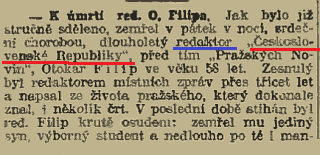
,11.4.1931
Československá Republika is mentioned during the visit of Baronesse von Botzenheim at Hradčany where she gave Švejk the book Episodes from the life of our emperor that was written by the future editor in chief of this paper.
Background
Československá Republika was an official government daily newspaper that was published by this name from 1919 to 1932 (before and after it was called Pražské noviny). It was a direct successor to Pražské úřední noviny, and was even located in the same offices. The mentioned editor Filip, had been an working for the paper also during the old regime. From 1932 to 1938 it continued publishing, but now using the name Pražské noviny. The government's newspaper group also issued Úřední List Československá Republika and the evening paper Prager Abendblatt (in German).
In Rudé Pravo
Jaroslav Hašek also wrote a satirical article in Rudé Pravo where editor Filip and his newspaper is treated in more detail: What I would advise the Communists if I were the Chief Editor of the official Government newspaper Československá Republika. The article was dated 7 April 1921 printed on 8 May[a] - around the time when the passages in the novel were written. In the article he claims that some Svátek was editor in chief, in the novel the author of the book about the emperor (i.e. Filip) has this role. According to the address book from 1924 the chief editor was Josef Hevera, and another of the names mentioned in the Rudé Pravo article, Adolf Zeman, was indeed on the editorial board. The article furthermore suggests that Jaroslav Hašek was still a Communist at heart.
On Hašek
The newspaper wrote about Hašek from time to time, mainly after he became famous, and on 5 January 1923 they printed an obituary. Shortly after his return from Russia they printed adverts for his appearance at the theatre Červená sedma where he related stories from his stay in Russia.
Quote(s) from the novel
[I.8] Potom vytáhla z koše tři láhve vína pro rekonvalescenty a dvě krabice cigaret. Vše elegantně rozložila na prázdnou postel vedle Švejka, kam přibyla ještě pěkně vázaná kniha „Příběhy ze života našeho mocnáře“, kterou napsal nynější zasloužilý šéfredaktor naší úřední „Československé republiky“, který se ve starém Frantíkovi viděl.
Literature
| a | Co bych radil komunistům, kdybych byl šéfredaktorem vládního orgánu Československá republika | Jaroslav Hašek | 8.5.1921 |



|
I. In the rear |
 | |
9. Švejk in the garrison prison | |||
 | Obchodní akademie |  | ||||
| Praha II./1780, Resslova ul. 8 | ||||||
| ||||||
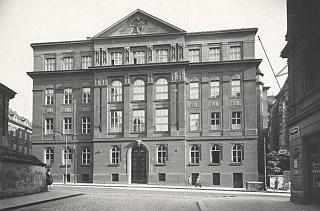
Resslova 1780/8: Českoslovanská akademie obchodní.
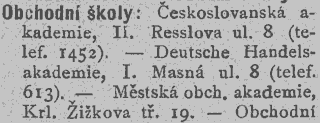
Address book from 1910.
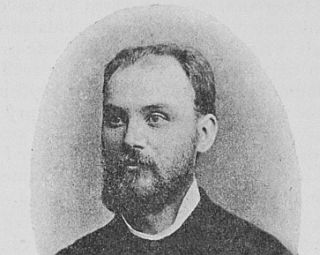
Jan Řežábek
, 21.10.1892
Obchodní akademie is mentioned when the author introduces Feldkurat Katz to the reader. He had studied at a commercial academy.
Background
Obchodní akademie is an ambiguous term, but we must assume that Otto Katz studied at one of the two commercial academies in Prague. Because he was Jewish it is at first glance logical to assume that his mother tongue was German and he therefore studied at the German academy. On the other hand the field chaplain was no doubt bi-lingual so the Czech academy must also be considered.
Českoslovanská akademie obchodní in Resslova ulice is all in all the likelier candidate. Hašek himself studied here and this weighs heavily in favour of the latter when analysing which commercial academy the future field chaplain studied at. It should also be noted that some Otto Katz actually graduated from this academy in 1881 and the author may well have been aware of him. Augustin Knesl claimed that this very person was the model of Hašek's literary field chaplain.
Another Otto Katz graduated from the German academy in 1896, but in 1906 he lived in Trieste so it is less likely that Hašek knew him.
Commercial academies as institutions
In Austria commercial academies were institutions that offered three-year (later four-year) education in commerce and accounting. The first of those academies was founded in Prague in 1856 as Prager Handelsakademie, the first with Czech as instruction language was the very Českoslovanská akademie obchodní that was established in 1872. From the beginning they were located in Staré město but in 1892 they moved to Resslova ulice i Praha II. They are still (2020) operating but located in another building in the same street. Commercial academies as institutions to this day exist in Czechia, Slovakia and Austria.
Hašek and the Czechoslavonic Commercial Academy
Jaroslav Hašek studied here from 1899 to 1902 and left with good grades. Here he met some of his best friends, first and foremost Hájek, but also Karel Marek who probably lent his name to the literary Einjährigfreiwilliger Marek. Another fellow student was Jan Čulen who joined Hašek on a longer journeys in 1900 and 1901. It was this education that enabled Hašek to serve as a one-year volunteer in k.u.k. Heer. The institution was one the list of establishments that gave its graduates the right to shortened term of service and other privileges.
On bad terms with the headmaster
In 1909 Jaroslav Hašek wrote he story Obchodní akademie for Karikatury. Here head teacher "Jeřábek", in real life Jan Řežábek[1], is mercilessly pilloried and the piece was censored and was only printed the next year, in a revised version. Jeřábek was even assigned qualities that readers of The Good Soldier Švejk will recognise in Oberst Kraus. In addition the academy is mentioned multiple times in Strana mírného pokroku v mezích zákona.
Quote(s) from the novel
[I.9] Studoval obchodní akademii a sloužil jako jednoroční dobrovolník. A vyznal se tak dobře v směnečném právu a ve směnkách, že přivedl za ten rok obchodní firmu Katz a spol. k bankrotu tak slavnému a podařenému, že starý pan Katz odjel do Severní Ameriky, zkombinovav nějaké vyrovnání se svými věřiteli bez vědomí posledních i svého společníka, který odjel do Argentiny.
Sources: Augustin Knesl, Jaroslav Šerák
Also written:Commercial academyenHandelsakademiede
| 1. | Jan Řežábek (1862-1925), "Hofrat" and head of the Czechoslavonic Commercial Academy from 1900 to 1918. |
Literature
 | Katz a spol. |  | |||
| |||||
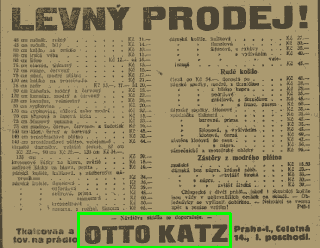
, 1.5.1921

, 1896
Katz a spol. is mentioned when the author introduces Feldkurat Katz to the reader. The company traded in bills-of-exchange and was owned by Katz's father and his companion. When young Katz took over the business he drove it to bankruptcy within a short time. His father settled with the creditors and moved to North America whereas his companion emigrated to Argentina. Thus the firm continued to exists in the new world, as two incarnations.
Background
Katz a spol. is the author's term for a firm in Prague. At least two companies who traded in Praha at the time were owned by an Otto Katz. None of the two companies traded in bills-of-exchange. In 1983 Augustin Knesl made an attempt to identify Feldkurat Katz and thus the company, and concluded that Katz was born in 1864, was educated at Obchodní akademie and owned a company that went bankrupt in 1923.
The firm that Knesl refers to existed from at least 1918 until 1923 and was a weaver and linen manufacturer in Celetná ulice. The firm advertised widely in 1920 and 1921 and it may be that the author picked the name from these (Jaroslav Hašek was an avid reader of newspapers, including adverts).
Another firm existed from 1893 onwards in Libeň (Královská třída 358) and manufactured rape-seed oil. In 1902 the company is no longer listed but Otto Katz is still the owner of the property, as he is as late as 1932.
Quote(s) from the novel
[I.9] Studoval obchodní akademii a sloužil jako jednoroční dobrovolník. A vyznal se tak dobře v směnečném právu a ve směnkách, že přivedl za ten rok obchodní firmu Katz a spol. k bankrotu tak slavnému a podařenému, že starý pan Katz odjel do Severní Ameriky, zkombinovav nějaké vyrovnání se svými věřiteli bez vědomí posledních i svého společníka, který odjel do Argentiny.
Sources: Augustin Knesl, Jaroslav Šerák
Literature
- Obchodní adresář a schematismus pro hlavní město Prahu1927
- Adresář královského hlavního města Prahy a sousedních obcí1896
- Ze vzpomínek bývalých posluchačů Českoslovanské akademie obchodní
- Kolandův adresář VIII. části královského hlav. města Prahy1903
- Adresář královského hlavního města Prahy a obcí sousedních1910
- Zapsané firmy19.12.1893
- Zástěry27.1.1918
- Schürzen17.2.1918
- Vyrovnání a konkursy25.1.1923
 | Ústav šlechtičen |  | ||||
| Praha IV./2-3, U sv. Jíří 1 | ||||||
| ||||||
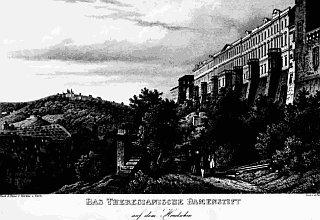
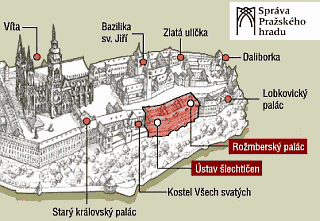
Ústav šlechtičen is mentioned by the author in his description of the baptism of Feldkurat Katz where a lady from this Institute for Noblewomen was present.
Background
Ústav šlechtičen was an institution for education of daughters of noblemen who were incapable of providing their daughter with an existence that was in line with their rank in society. The foundation was created by Maria Theresa in 1755 and accomodated 30 ladies. It was located in Rožmberský palác at Hradčany. The abbess was always an unmarried lady of the house Habsburg-Lothringen, and from 1894 to 1918 Maria Annunziata, the sister of Archduke Franz Ferdinand, held the position.
On 1 May 1919 the nobility institute was dissolved and the palace transferred to the Ministry of Interior. The building is located on the castle premises, and is today (2015) the property of the Czech state. It recently underwent extensive renovation and is used as a museum and exhibition area.
Quote(s) from the novel
[I.9] Křtili ho slavnostně v Emauzích. Sám páter Albán ho na máčel do křtitelnice. Byla to nádherná podívaná, byl u toho jeden nábožný major od pluku, kde Otto Katz sloužil, jedna stará panna z ústavu šlechtičen na Hradčanech a nějaký otlemený zástupce konsistoře, který mu dělal kmotra.
Also written:Institute for NoblewomenenAnstalt für adelige FrauendeInstitutt for adelsdamerno
Literature
 | Konsistoř |  | ||||
| Praha IV./56, Hradčanské nám. 16 | ||||||
| ||||||
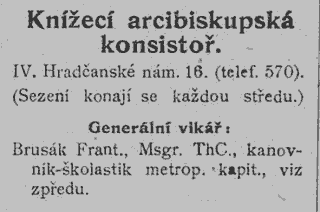
Konsistoř is mentioned by the author in his description of the baptism of Feldkurat Katz where a representative of the consistory acted as Katz's godfather.
Background
Konsistoř (also called Curia) is a religious council that advises for instance the archbishop or the pope. In this case it is surely talk of the archbishop's consistory at Hradčany (Knížecí arcibiskupská konsistoř). In 1907 the council's address was the archbishop's palace itself, and they held meetings every Wednesday
Quote(s) from the novel
[I.9] Křtili ho slavnostně v Emauzích. Sám páter Albán ho na máčel do křtitelnice. Byla to nádherná podívaná, byl u toho jeden nábožný major od pluku, kde Otto Katz sloužil, jedna stará panna z ústavu šlechtičen na Hradčanech a nějaký otlemený zástupce konsistoře, který mu dělal kmotra.
Also written:ConsistoryenKonsistoriumdeKonsistorietno
Literature
 | Seminář |  | |||
| Praha I./1040, Křižovnické nám. 4 | |||||
| |||||
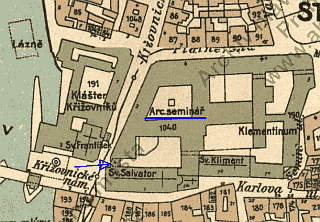

,1907
Seminář is mentioned 3 times in The Good Soldier Švejk.
Seminář is mentioned by the narrator in his introduction of Feldkurat Katz's and his illustrious career. The newly converted priest was educated at the Seminary. In the next chapter [I.10,2] he mentions the Seminary in between some drunk drivel.
Background
Seminář most probably refers to Arcibiskupský seminář (The Archbishop's Seminary), an institution for education of catholic priests that still exists. During the times of Jaroslav Hašek the Seminary was located in Klementinum, but it was in 1929 re-located to Dejvice where it is still housed[a].
Quote(s) from the novel
[I.9] Ale jednoho dne se opil a šel do kláštera, zanechal šavle a chopil se kutny. Byl u arcibiskupa na Hradčanech a dostal se do semináře. Opil se na mol před svým vysvěcením v jednom velmi pořádném domě s dámskou obsluhou v uličce za Vejvodovic a přímo z víru rozkoše a zábavy šel se dát vysvětit.
[I.10.2] Počal se hlasitě smát, ale za chvíli zesmutněl a apaticky se díval na Švejka pronášeje: „Dovolte, pane, já vás již někde viděl. Nebyl jste ve Vídni? Pamatuji se na vás ze semináře.“
[I.13] Zatím polní kurát si v katechismu zopakoval, co kdysi v semináři neutkvělo mu v paměti
Also written:SeminaryenSeminardeSeminaretno
| a | Historie a život v semináři |
 | U Vejvodů |  | ||||
| Praha I./353, Jilská ul. 2 | ||||||
| ||||||
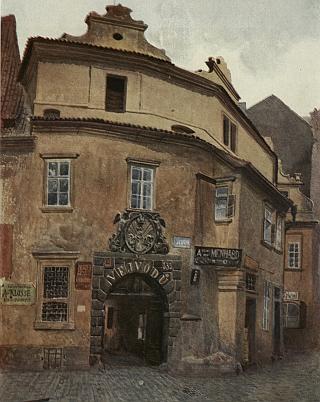

,25.10.1910
U Vejvodů is mentioned in connection with Feldkurat Katz drinking himself to the ground the night before being ordained as chaplain. This is supposed to have happened "in a descent house with lady service" in a small street behind Vejvodovice.
Background
U Vejvodů is a house and a restaurant in Staré město in Prague and one of the oldest of its kind. It has existed at least since 1560. In 1717 Jan Václav Vejvoda bought the property and the building is named after him. Early in the 20th century Karel Klusáček took over and rebuilt it to become what it was known as until 1990. The house was also for a period the home of a cinema as well as hosting Umělecká beseda (the artist's union).
U Vejvodů still exists as a large restaurant which serves Czech food and Pilsner Urquell. The place is totally changed after the renovation in the 1990's, but is still very popular and relatively affordable considering the location.
Quote(s) from the novel
[I.9] Opil se na mol před svým vysvěcením v jednom velmi pořádném domě s dámskou obsluhou v uličce za Vejvodovic a přímo z víru rozkoše a zábavy šel se dát vysvětit.
Sources: Radko Pytlík, Milan Hodík
Also written:VejvodoviceHašek
Literature
 | Dům za Vejvodovic |  | ||||
| Praha I./442, Vejvodova ul. 10 | ||||||
| ||||||
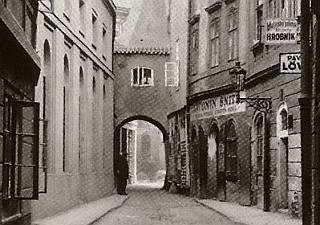
Vejvodova ulice, the brothel by the street lamp
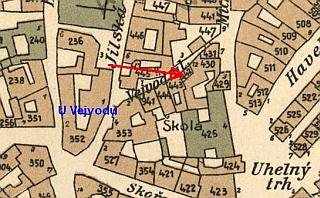

Dům za Vejvodovic is mentioned in connection with Feldkurat Katz drinking himself to the ground the night before being ordained as chaplain. This is supposed to have happened "in a very descent house with lady service in a small street behind Vejvodovice".
Background
Dům za Vejvodovic most probably refers to a brothel owned by Čeněk Bartoníček in Vejvodova ulice 10, just a few steps east of U Vejvodů. Bartoníček was in the address book of 1913 listed as owner of the brothel at this address. This is also the only house of pleasure that fits the description in the novel.
In the address book from 1910 a man who carried this name was listed as a "coffee-house" owner in Věnceslava Lužická ulice 29 in Malá strana. This café was entered as a brothel in 1913 but with František Stránský as owner. Bartoníček thus seems to have sold and re-established himself east of the Vltava. Police registers reveal that he lived in Lužická ulice (Prague III/124) already from 1901 and he is registered in Vejvodová ulice from 24 November 1910.
The house itself, also known as Bílý kříž (the white cross) was in 1910 owned by Josef Sobička. To judge by the address books there was no "café" in Vejvodova 10 in 1910 so Bartoníček seems to have started the establishment from scratch.
Quote(s) from the novel
[I.9] Opil se na mol před svým vysvěcením v jednom velmi pořádném domě s dámskou obsluhou v uličce za Vejvodovic a přímo z víru rozkoše a zábavy šel se dát vysvětit.
Also written:House behind Vejvodovice;noen
Literature
 | Vězeňské kaple |  | ||||
| Praha IV./72, Kanovnická ul. 11 | ||||||
| ||||||

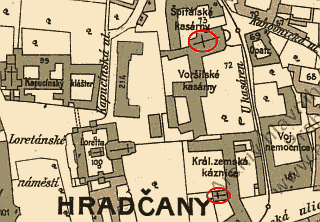
Vězeňské kaple was the scene of Feldkurat Katz' grand sermon for the prisoners in the garrison jail. Here he drunk field chaplain discovered Švejk when the latter started crying during his speech. It ended well for the good soldier who was eventually released and continued in a care-free existence, serving a field chaplain he got on with ever so well.
Background
Vězeňské kaple possibly refers Vojenský kostel sv. Jana Nepomuckého at Hradčany. The church belongs to the same building complex as the military hospital, the garrison prison, and the military court. It is easily accessible across the courtyard between the buildings. It shares the address with Voršilské kasárny.
Another place the author might have had in mind is a chapel on the premises of the Royal Country Penitary next door. This was not an army institution, but that will not necessarily have stopped the author from including it in the plot. It also fits the description in the novel more accurately as a house chapel (of the garrison) and a prison chapel is mentioned.
Quote(s) from the novel
[I.9] „Zejtra máme u nás divadlo. Povedou nás do kaple; na kázání. My všichni v podvlíkačkách stojíme zrovna pod kazatelnou. To ti bude legrace!“. Jako ve všech věznicích a trestnicích, tak i na garnisoně těšila se domácí kaple; velké oblibě. Nejednalo se o to, že by nucená návštěva vězeňské kaple; sblížila návštěvníky s bohem, že by se vězňové více dověděli o mravnosti. O takové hlouposti nemůže být ani řeči.
Also written:Prison chapel at HradčanyenGefängniskapell am HradschindeFengselskapellet på Hradčanyno
Literature
 | Infanterieregiment Nr. 28 |  | ||||
| Praha III./132, Pod Bruskou 2 | ||||||
| ||||||

,1908
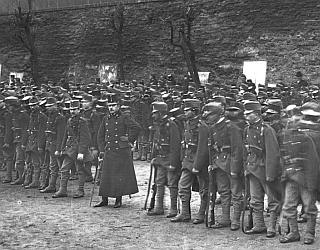
Vojáci 28. pěšího pluku shromáždění při pohovu u kasáren pod Bruskou (dům čp. 132 na Malé Straně). 1.3.1910.
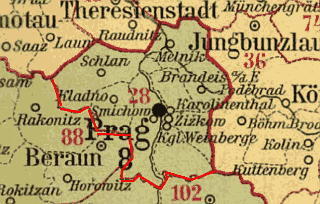
Heeresergänzungsbezirk Nr. 28
, 1911
Infanterieregiment Nr. 28 is mentioned 7 times in The Good Soldier Švejk.
Infanterieregiment Nr. 28 is mentioned many times in The Good Soldier Švejk. Their name first appears when Feldkurat Katz holds his sermon for the soldiers at Vězeňské kaple. His altar boy was a petty thief from the regiment.
In [II.1] the author mentions an episode where a soldier from the regiment explains how the Hungarians in Szeged ridiculed the Czech soldiers by holding their hands up above their heads.
In [III.1] IR. 28 re-enters the narrative in connection with a report that two of their battalions on 3 April 1915 by Dukla crossed over to the Russians to the tunes of the regiment's orchestra. The regiment was disbanded forever by an Army Order issued by Emperor Franz Joseph I. and their standard was handed over to the army museum in Vienna. The order is read out for the departing soldiers in Királyhida, and so is a related order from Archduke Joseph Ferdinand.
The last mention is in [IV.1] as a spy enters Švejk's cell in Przemyśl. He claims to have served in IR. 28 (although he spoke Czech with a Polish accent).
Background
Infanterieregiment Nr. 28 (pěší pluk č. 28) was one of 102 infantry regiments in k.u.k. Heer. It was founded as early as 1698 and was one of the oldest in the entire army. The regiment thus took part in many campaigns and they particularly distinguished themselves by Custoza on 24 June 1866. They also participated in battles during the Napoleonic Wars, for instance at Aspern and Leipzig.
It was a predominantly Czech regiment (95 percent), recruited from Heeresergänzungsbezirk Nr. 28, Prague. They had moved here from Kutná Hora in 1817. Apart from the capital it recruited from Žižkov, Smíchov, Královské Vinohrady, Kladno, Slany, Kralupy a.o.
The regiment's home barracks were at Bruska in Malá Strana. In 1914 only the 2nd battalion and the recruitment district command were located here. The rest of the regiment had since 1912 been garrisoned in Tyrol: staff and the 3rd battalion in Innsbruck and the 1st and 4th battalions in Schlanders (it. Silandro) and Malè respectively. The regimental commander in 1914 was colonel Ferdinand Sedlaczek[a].
During the war
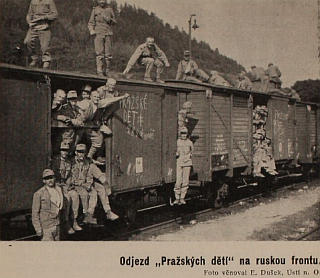
Osmadvacátníci, , 1936
After the outbreak of war, the three battalions from Tyrol[1] were sent to the Eastern Front and took part in the invasion of Russian Poland, including the battle by Komarów on 28 August 1914. The rest of the year and until April 1915 they were fighting north of and in the Carpathians, for instance by Limanowa in December where they suffered severe losses.
Mass surrender and temporary dissolution
Easter Saturday 3 April 1915 would become the most controversial day in the history of the regiment. At the front section north of Bardejov the bulk of the regiment, probably more than 1,000 men, surrendered after having been partly cut off by numerically superior Russian forces. On 8 April Feldmarschall-Leutnant Josef Krautwald, commander of III. Korps of 3. Armee reported that the regiment had surrendered to a single Russian battalion without firing a shot, that the newly arrived 8th march battalion was the main culprit but that the old core of the regiment was reliable. He claimed that he had received this information from the regiment's commander, a claim that the commander Schaumeier[2] later contested. On 10 April, the commander of 3. Armee, general Svetozar Boroević von Bojna decided to dissolve the regiment temporarily, with effect from the next day. He also informed Archduke Friedrich who on 16 April presented the case for the Emperor. He in turn issued a brief order dated 17 April 1915. It rubber-stamped the decision to temporarily dissolve the regiment, ordered its standard to be deposed in Heeresmuseum in Vienna, and that the decision be made public within the army. On 22 April Emperor Franz Joseph I.'s decree was indeed read out to the troops:
Ich genehmige die vom 3. Armeekommando angeordnete, vorläufige Auflösung des Infanterieregiments Nr. 28 und befehle, dass diese Maßregelung in der Armee allgemein verlautbart, die Regimentsfahne aber im Heeresmuseum deponiert werde. Wien, am 17. April 1915. Franz Joseph
The Emperor's order as reproduced in The Good Soldier Švejk contains some element of the original but is much more verbose and is very close in wording to one of the fake versions that started to appear as leaflets during the summer of 1915. On 11 August 1915 Wiener Zeitung reported that a court in Reichenberg (Liberec) had ordered confiscation of the leaflets[k] but by then the word had spread.
Ersatzbataillon
In the meantime (February 1915) the replacement battalion had been transferred from Prague to Szeged. It was thus one of the first of many Czech regiments that were moved away from their recruitment area that year. The reason for these measures was fears in military circles that the pan-slavic sentiments and increasing dissatisfaction with the war amongst Czechs would be political poison for the soldiers. Already from September 1914, there were reports of poor discipline and dissent when the soldiers left Prague with the 2nd march battalion. Many were reportedly drunk and some demonstrated openly. Commander of the Ersatzbataillon, the pensioned but now re-activated Oberst Josef Krček, was later accused of neglect and for allowing an irresponsible lifestyle amongst the officers. After the regiment's transfer to Szeged, he ordered 6,000 litres of beer a month for the officer's mess![c] In their home city they were replaced by Infanterieregiment Nr. 2 from Brassó (now Brasov in Romania).
Investigations and restoration
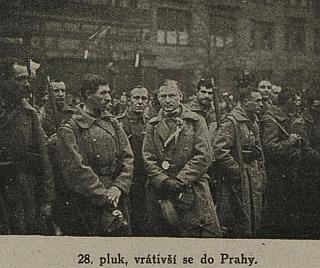
, 21.11.1918
The 28th regiment was reconstituted in December 1915 after court investigations in Kassa (Košice) and Temesvár (Timișoara) concluded that the claimed mass desertion was less serious than first believed. During the rest of the war, the regiment operated in Albania, Sarajevo, Carinthia and on the Isonzo front. They took part in the advance on Piave in October and November 1917 (Caporetto) and also participated in the last battle of the war during the days of the final collapse of Austria-Hungary.
The replacement battalion was in 1916 moved from Szeged to Bruck an der Mur where they were garrisoned until the war ended. These were the first soldiers from the now defunct k.u.k. Heer who returned to Prague. Here they were celebrated as heroes, and the regiment was absorbed into the Czechoslovak army using their old number, and streets were named after them.
In history writing
The assessment of the regiment's failure on 3 April 1915 was in the beginning unison: in one way or another they deserted, even defected, traitors to Austrians, Germans and Hungarians, heroes to Czechs. That judgement has in the last 30 years been somehwat modified (more details below), but historian Manfried Rauchensteiner[3] is probably very close when stating: The subsequent investigation of the incident, which took months, brought to light the fact that there had been an overreaction, and that many factors, not least a dismal leadership style, had caused the regiment to surrender and at least not make efforts to sacrifice itself in a difficult situation.
The Austrian-German view
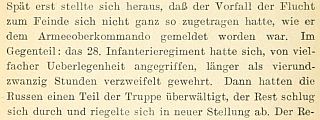
Der Sturz der Mittelmächte, , 1921

Erzherzog Friedrich's army order contained many inaccuracies and falsehoods.
,17.4.1926
In 1921 historian Karl Friedrich Nowak[4] published the book Der Sturz der Mittelmächte (The fall of the Central Powers) where he openly questioned the established narrative. He wrote that the regiment fought for more than 24 hours against a superior enemy before giving up. He added that although some groups no doubt deserted or allowed themselves to be captured, it didn't apply to battalions as units.[f].
Still there is no indication that his observations made any impact on Austrian or Bohemian-German public opinion, nor in anything that was published in German in the inter-war years. Even Österreich-Ungarns letzter Krieg maintained the essence of the "desertion" story. On the 11th anniversary of the Emperor's army order Salzburger Chronik wrote about the 28th regiment but the narrative had not changed. IR. 28 were still traitors, end of discussion. In September 1939 Kronen-Zeitung in the now Nazi-ruled Austria used the affair in some particularly crude anti-Czech propaganda[h]. This was during the days leading up to the infamous Munich-agreement that forced Czechoslovakia to cede Sudetenland to Nazi Germany).
Over many years the former k.u.k. officer Robert Nowak wrote a manuscript titled Die Klammer des Reichs, probably completed around 1960. It deals with the attitudes of the nations of the Dual monarchy during the war. Nowak tried to have parts of it published in a major Viennese newspaper. The editor refused, explaining that the content was not in line with the public mood! Many historians have since referred to the document but it remains unpublished, stored in Vienna's Kriegsarchiv[i] with copies in the Czech Military Institute.
The Czechoslovak version
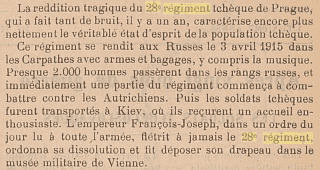
, 1.6.1916
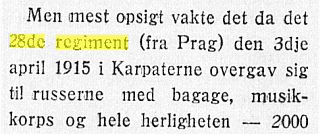
, 22.11.1916
The Czech version of events had already started to develop in 1915. The Petrograd newspaper Čechoslovák reported the "Easter Incident". In 1916 the story was embellished further with claims that nearly 2000 men had crossed over, with their arms, luggage and the military band, that parts of the regiment immediately joined the Russians in fighting the Austrians. Later they were allegedly transported to Kiev where they received an enthusiastic welcome. This narrative seems first to have appeared in Corriere d'Italia[l] on 3 March 1916 and on 1 June the Paris-based mouthpiece of the Czech National Council published a variation of the story[b]. It was not signed but was probably written by director Eduard Beneš or editor-in-chief Ernest Denis. The same article came up with a number of improbable claims and extracts from it also appeared in the press of neutral countries, for instance in Switzerland and Norway. It was added that the 11th march battalion had been deliberately sacrificed as revenge, by being forced to fight in the most exposed sectors of the Isonzo-front. 1000 men at the age 18 to 20 had allegedly been slaughtered, only a handful survived. The news item about the 11th march battalion is said to have originated in the Italian press. Parts of content was reproduced in Čechoslovan on 30 October 1916, quoting the Edinburg publication Everyman[j]. This was at a time when Jaroslav Hašek contributed to the newspaper so he would have been aware of the content. More or less the same story appeared in the Bohemia's case for independence (1917)[5], a book written by Edvard Beneš that was also published in French and Italian.
In inter-war Czechoslovakia the desertion myth was obviously cultivated for different reasons than in Austria. The 28th regiment were celebrated as heroes who had voted with their feet against Habsburg oppression and for an independent Czechoslovak state. The deluge of legionnaire literature further underpinned this narrative and also partly credited the desertion to agitators from Družina (the predecessor the Legions) who were operating in the area when the affair took place.
General Kunz

General Jaroslav Kunz. Probably the first Czech who openly questioned the official narrative of the desertion of IR. 28.
The only dissenting voice from this period seems to have been pensioned general Jaroslav Kunz[6]. In 1931 he published an article called Falešná legenda in the weekly Pestrý týden where he openly questioned the official Czechoslovak and Austrian versions of the affair. Referring to Nowak's book he went further in his analysis, investigating witness accounts from the trial. His conclusion was that although desertions no doubt took place, there was no reason to believe that the battalions deserted without putting up a fight. He pointed out that there were many war graves of 28ers in the area of the battle, that few of those captured on 3 April 1915 ever joined the Legions and when prisoners were returned after the Brest-Litovsk treaty in March 1918, the returning soldiers were not punished for desertion. Later that year Falešná legenda appeared as a chapter in the book Tajnosti rakouského generálního štábu (The secrets of the Austrian general staff). Here Kunz added more observations and noted how hostile the reaction to his article had been, be it in Czechoslovakia or Austria.
General Klecanda who led the Družina reconnaissance patrols in the area where the 28th regiment was operating during Easter 1915 reacted immediately and called Kunz "unpatriotic". Kunz also reveals that his article was refused by many newspapers until Pestrý týden finally agreed to print it in February 1931.
Karel Pichlík

Karel Pichlík, Historie a vojenství, 1959
Under Communist rule there was little interest in revising the established narrative. The most useful study from this period was surely that of the well known historian Karel Pichlík who in 1959 published a detailed and well documented paper in Historie a vojenství.[e] He does not refute the allegations of collective betrayal but takes aim at the agenda of "bourgeois" Czechoslovakia and by the Austrian "imperialists". He takes issues with Kunz and states that Kunz merely proved that the regiment put up some resistance. Drawing on many sources he convincingly documented the anti-Austrian sentiments amongst the Prague recruits both from IR. 28 and k.k. Landwehrinfanterieregiment Nr. 8 and how it manifested itself as open dissent. Predictably he fitted the narrative to the political dogma that prevailed at the time.
The Dukla incident mirrored in Švejk
The popularity of The Good Soldier Švejk has also played a part in spreading the myths about the Prague house regiment. This was however not the work of Hašek, despite the fact that he on half a page disseminated both Austrian and Czechoslovak disinformation. He simply replicated the information that was in circulation when he wrote the novel, including the claim about the regiment's orchestra joining the desertion. In 1957 his biographer Jaroslav Křížek repeated it all and he was surely not alone.
Recent publications
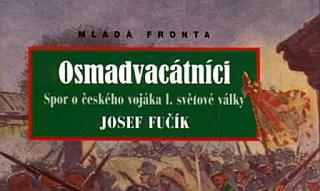
The recent reassessment of the history of IR. 28 seems to have started with Josef Fučík[7] who in 1994 published a paper about the regiment in the journal Střední Evropa. Later he wrote the book Osmadvacátníci (The Twentyeighters, 2006) which is an explicit rehabilitation of the regiment, to the extent that even the sleeve contains quotes from Nowak. The book is rich in details and very well researched. In 2011 Richard Lein followed up with more or less similar conclusions in his Pflichterfüllung oder Hochverrat. "Rehabilitation" in this context does not necessarily mean that the accusations of treason were entirely unfounded, simply that many of the claims made about IR. 28 and the events on 3 April 1915 were false and have since served political purposes.
That said both books suffer from the weakness that they underplay the fact that AOK's distrust of Czech regiments to a degree was justified. Many incidents had preceded that of IR. 28 and the conclusion of historian Manfried Rauchensteiner probably sums it up: it was the straw that broke the camel’s back.
Hašek and IR. 28
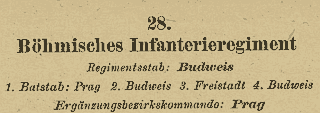
There were no units from IR. 28 in Trento in 1906, the year that Hašek (according to Menger) enrolled with the regiment.
, 1906
Apart from the author's own IR. 91 and its subordinated units IR. 28 is no doubt the military unit that is most often mentioned in The Good Soldier Švejk. This could be explained by the fact that the author himself was from Prague and thus would have known many who served in the regiment. Václav Menger even claimed that Hašek served with them in 1906 for a few weeks until he was superarbitrated. Closer investigations however reveal that this can't be true. See Trento for a background. It is however striking that this garrison features in all three versions of The Good Soldier Švejk but there is scant evidence that Hašek ever visited. Perhaps the inspiration comes from his acquaintances in IR. 28? The major part of the regiment was stationed in Trento from 1895 to 1899 and again in 1911 and 1912 so many men of his age from Prague would have served here.
From Hůla's explanations to Švejk (1951). © LA-PNP
Hašek would, as a volunteer in České legie, have known several of the former soldiers from the 28th regiment. One such person was Břetislav Hůla who according to the service record from the Legions was captured by Dukla on 3 April 1915. Why the document states Dukla instead of Stebnícka Huta is a not known but Austrian loss lists confirm that when Hůla went missing he served in the 10th company (3rd battalion). This battalion was indeed part of the fateful battle. Hůla himself wrote about IR. 28 in his explanations to The Good Soldier Švejk (published in 1953) and states that "without offering serious resistance all three battalions let themselves get captured by much weaker Russian forces".
In the newspapers?
At least two of the historians who have touched on the alleged desertion of IR. 28 claimed that newspapers started to write about the affair already in 1915 but without naming any concrete examples. The two are Josef Fučík and Manfried Rauchensteiner, quoting the unpublished paper by Robert Nowak Die Klammer des Reichs. Searches in the digital libraries of Austria and Czechia do however not show a single hit on the issue. The Austrian Reichsanzeiger is supposed to have printed a news item on this[g] but such a newspaper can't be identified. A similar German/Prussian Reichsanzeiger did exist but this paper shows no trace of any news about IR. 28. It also appears strange that censorship allowed these stories to be printed at all as they would damage the delicate and by now deteriorating relation between the nations of Austria-Hungary. So there is still research to be done (Hungarian newspapers have not been consulted).
Quote(s) from the novel
[I.9] Zrzavý ministrant, dezertér z kostelnických kruhů, specialista v drobných krádežích u 28. pluku, snažil se poctivě vybavovat z paměti celý postup, techniku i text mše svaté.
[II.1] Od vedlejšího stolu řekl nějaký voják, že když přijeli do Segedina s 28. regimentem, že na ně Maďaři ukazovali ruce do výšky.
[II.2] Černožluté obzory počaly se zatahovat mraky revoluce. Na Srbsku, v Karpatech přecházely bataliony k nepříteli. 28. regiment, 11. regiment. V tom posledním vojáci z píseckého kraje a okresu.
[II.3] „Případ vašeho černocha Kristiána,“ řekl jednoroční dobrovolník, „třeba promyslit i ze stanoviska válečného. Dejme tomu, že toho černocha odvedli. Je Pražák, tak patří k 28. regimentu. Přece jste slyšel, že dvacátý osmý; přešel k Rusům.
[III.1] Potom Švejk počal mluvit o známých rozkazech, které jim byly přečteny před vstoupením do vlaku. Jeden byl armádní rozkaz podepsaný Františkem Josefem a druhý byl rozkaz arcivévody Josefa Ferdinanda, vrchního velitele východní armády a skupiny, kteréž oba týkaly se událostí na Dukelském průsmyku dne 3. dubna 1915, kdy přešly dva batalióny 28. pluku i s důstojníky k Rusům za zvuků plukovní kapely.
[III.1]Armádní rozkaz ze dne 17. dubna 1915:
Přeplněn bolestí nařizuji, aby c. k. pěší pluk čís. 28 pro zbabělost a velezrádu byl vymazán z mého vojska. Plukovní prapor budiž zneuctěnému pluku odebrán a odevzdán do vojenského musea. Dnešním dnem přestává existovat pluk, který, otráven mravně z domova, vytáhl do pole, aby se dopustil velezrády.František Josef I.
[III.1]Rozkaz arcivévody Josefa Ferdinanda:
České trupy během polního tažení zklamaly, zejména v posledních bojích. Zejména zklamaly při obraně posic, ve kterých se nalézaly po delší dobu v zákopech, čehož použil často nepřítel, aby navázal styky a spojení s ničemnými živly těchto trup. Obyčejně vždy směřovaly pak útoky nepřítele, podporovaného těmito zrádci, proti těm oddílům na frontě, které byly od takových trup obsazeny. Často podařilo se nepříteli překvapit naše části a takřka bez odporu proniknout do našich posic a zajmouti značný, velký počet obránců. Tisíckrát hanba, potupa i opovržení těmto bídákům bezectným, kteří dopustili se zrady císaře i říše a poskvrňují nejen čest slavných praporů naší slavné a statečné armády, nýbrž i čest té národnosti, ku které se hlásí. Dřív nebo později zastihne je kulka nebo provaz kata. Povinností každého jednotlivého českého vojáka, který má čest v těle, je, aby označil svému komandantovi takového ničemu, štváče a zrádce. Kdo tak neučiní, je sám takový zrádce a ničema. Tento rozkaz nechť je přečten všemu mužstvu u českých pluků. C. k. pluk čís. 28 nařízením našeho mocnáře jest již vyškrtnut z armády a všichni zajatí přeběhlíci z pluku splatí svou krví těžkou vinu.Arcivévoda Josef Ferdinand
[IV.1] Já jsem sloužil u 28. regimentu a hned jsem vstoupil k Rusům do služby, a pak se dám tak hloupé chytit.
[IV.1] ... snad ty si vzpomeneš na někoho, s kým si se tam tak stýkal, rád bych věděl, kdo tam je od našeho 28. regimentu?
| 1. | The Prague-based 2nd battalion was dispatched to the Serbian front by the Drina as part of 9. Infanteriedivision. In February 1915 they were moved to the Carpathians, but were still detached from the rest of the regiment. |
| 2. | Florian Schaumeier, Austrian officer who served with the 28th regiment from 1903 to 1915. In 1914 he was commander of the replacement battalion, rank Major. By March 1915 he was regimental commander but was transferred to Infanterieregiment Nr. 11 after the regiment was dissolved. He later became commander of the regiment on the Italian front. In 1917 he was ennobled, taking the predicative name von Anderschell. |
| 3. | Manfried Rauchensteiner (1942-), Austrian historian regarded as one of the leading experts on the Dual Monarchy and its role in World War I. Former director of Herresgeschichtliches Museum. |
| 4. | Karl Friedrich Nowak (1882-1932), Austrian journalist, publisher and historian who during the war worked for Kriegspressequartier. From 1916 he had access to Feldmarschall Conrad and the general staff. |
| 5. | Edvard Beneš, Bohemia's case for independence, 1917. This book is a political pamphlet that aimed to influence decision-makers in the allied capitals towards accepting the need to break up Austria-Hungary. To achieve his goal Beneš didn't shy away from exaggerations, falsehoods and even conspiracy theories. From pages 57 and 58: To complete this sketch it is necessary to recite the tragic tale of the surrender of the 28th Czech Regiment of Prague, which caused such a stir a year ago, and which illustrates best of all the true spirit of the Czech nation. This regiment had surrendered to the Russians in the Carpathians on April 3rd, 1915, with all their arms and baggage, not even excepting their military band. In this way nearly 2000 men went over to the Russians and the greater part of the regiment commenced immediately to fight the Austrians. After that they were transported to Kieff, where they were received with enthusiasm. The Emperor, in the Order of the Day read to all the soldiers, dishonoured for ever this regiment, ordered it to be dissolved, and its colours placed in the military museum in Vienna. Connected with this incident there is a very painful story for the Czechs, which was enacted on the Italian front, and which has since been mentioned in the Italian Press. The news of the dissolution of the 28th Regiment had everywhere made a great stir abroad and had given the lie to all the Austrian gossips, who were pretending that everything was going well with the Empire. It had also provoked sentiments of revolt among the Czechs in Bohemia and Moravia. The military authorities of Vienna, therefore, determined to correct this impression and to revenge themselves on the Czechs in the most brutal manner. Last autumn they formed a new battalion, the 28th Regiment, composed exclusively of young men of twenty; they were sent to the Isonzo front and without pity or regard, and without the slightest scruple were exposed to the most murderous Italian artillery fire near Gorizia. Only eighteen soldiers survived the massacre, the rest of the thousand young men remained on the battlefield. Immediately afterwards, the Emperor caused a new Order of the Day to be read to the army, proclaiming that the disgrace of the 28th Regiment of Prague was atoned for by the sacrifice of this regiment on the Isonzo. |
| 6. | Jaroslav Kunz (1869-1933), Austrian, later Czechoslovak military lawyer and general. From 1915 to 1918 war he was head of the Divisional Court in Vienna, in Czechoslovakia he held several positions in the ministry of law. He wrote several books about where the theme was the Austro-Hungarian military and judiciary and their relation to Czechs matters. |
| 7. | Josef Fučík (1932-2018), Czech military historian who specialised in World War I. |
Literature
- IR 28 - bojová cesta2014
- Historie c.a k. pěšího pluku č. 28
- Přechod 28. Pražského pluku k rusům1925
- Bohemia's case for independence1917
- Das Verhalten der Tschechen im Weltkrieg1918
- Předání praporu 28. pěšího pluku do Vojenského historického muzea ve Vídni
- Slovenský Zborov1934
- Tajnosti rakouského generálního štábu1931
- Pražský pěší pluk č. 28 v tažení 1914 - 19151995
- Pražský pěší pluk č. 28 na italské frontě 1915 -1918Josef Fučík8.1996
- Jaké byly osudy 28. pěšího pluku během I. světové války?
- DeserteureLudwig Rege33.1.1921
- 28. pluk "Pražské děti"1932
- S osmadvacátníky za světové války1936
- Pravda o Čechách a Praze30.12.1914
- Potrestaný 28. pluk2.6.1915
- Zprávy z rodného kraje4.6.1915
- Jak byl zajat pražský 28. pluk13.10.1915
- Zrušení 28. a 36. pluku29.11.1915
- Výtečné drženi se 11. pochodového praporu c. a k. péšibo pluku čis. 2816.4.1916
- Češi v rakouské armádě28.4.1916
- Češi v rakouské armádě3.5.1916
- K historii 28. pluku23.5.1916
- Das Infanterieregiment Nr. 2820.10.1917
- Das Verhalten des Tschechen im Kriege10.5.1919
- Historický dokument22.8.1924
- Der Armeebefehl vom April 191517.4.1926
- Zur versuchten Ehrenrettung des ehem. I.R. 28 (1)Fritz Kosmath11.6.1926
- Zur versuchten Ehrenrettung des ehem. I.R. 28 (2)Fritz Kosmath18.6.1926
- Ein Ehrenrettungsversuch für das tschechische Infanterie-Regiment Nr. 2827.4.1926
- Wieder die 28er?3.3.1931
- Die Achtundzwanziger7.3.1931
- Osmadvacátníci a česká družinaEduard Stehlík1.5.1990
- Legenda o dezercii pražského 28. pešieho pluku v Karpatoch27.9.2008
- Pražské děti nezradilyPavel Bělina19.6.2018
- Der Oberste Kriegsherr und sein Stab1908
 | K.u.k. Militärgericht Prag |  | ||||
| Praha IV./214, Kapucínská 2 | ||||||
| ||||||
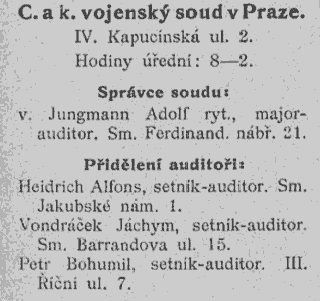
Address book from 1907
K.u.k. Militärgericht Prag the final part of [I.9] takes place here, during the process of transferring Švejk from the garrison prison to Feldkurat Katz. Head of the court was Auditor Bernis. See also Posádková věznice.
The court was first mentioned by the angry policeman at c.k. policejní ředitelství who wishes the devil may take Švejk. If the dares to appear once more he will be sent sraight to the military court.
In [II.2] the court is mentioned again as this is where Pepík Vyskoč was sentened.
Background
K.u.k. Militärgericht Prag was the military court of the Prague-based 8th army group. The court was located at Hradčany in the same building complex as the garrison prison and the military hospital. The k.k. Landwehr court was also located here. An article in Prager Tagblatt also mentions a brigade court, but it is not clear how these administrative subdivisions worked. To judge by newspapers reports from 1914 Hauptmann G. Heinrich led the court[a]. The address book of 1912 lists Major Josef Plzák as the highest ranking officer. His assistant was Oberleutnant Vladimír Dokoupil.
The good soldier Švejk in captivity
In Dobrý voják Švejk v zajetí the miltary court is also part of the plot and to a higher degree than in the novel. An auditor handles Švejk's case but he is not named. The narrator also explains how the Austro-Hungarian military judiciary works.[1]
V duchu opustil hradčanský vojenský soud a mysl jeho zaletěla na Vinohrady do malého krámku, svezla se po obraze Františka Josefa a vyhledala pod starou postelí dvě morčata. Švejk k smrti rád pěstoval morčata. A jich osud byl také jedinou chmurou zde.
Quote(s) from the novel
[I.9] Vyšetřující auditor Bernis byl muž společnosti, půvabný tanečník a mravní zpustlík, který se zde strašně nudil a psal německé verše do památníků, aby měl pohotově vždy nějakou zásobu. Byl nejdůležitější složkou celého aparátu vojenského soudu, poněvadž měl tak hrozné množství restů a spletených akt, že uváděl v respekt celý vojenský soud na Hradčanech. Ztrácel obžalovací materiál a byl nucen vymýšlet si nový. Přehazoval jména, ztrácel nitě k žalobě a soukal nové, jak mu to napadlo.
[II.4] Když jsem seděl u garnisonsgerichtu, tak se ve vedlejší cimře jeden voják přiznal, a jak se to vostatní dozvěděli, tak mu dali deku a poručili mu, že musí svý přiznání vodvolat."
Also written:Military courtenC.a k. vojenský soudczMilitærdomstolenno
Literature
| a | Desertion | 18.10.1914 | |
| 1 | Dobrý voják Švejk v zajetí | 1917 |
 | Policejní komisařství XIII. |  | |||
| Libeň/185, Stejskalova ul. - | |||||
| |||||
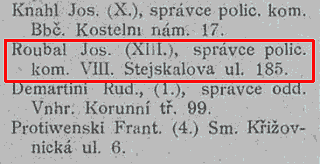
Policejní komisařství XIII. is mentioned by Švejk when Auditor Bernis asks him why he has ended up in the garrison prison. Švejk tells him that he doesn't know, just like the two year old who had walked from Vinohrady to Libeň and was locked up at the local police station. The analogy is that Švejk was also a foundling, just like the two-year old child.
Background
Policejní komisařství XIII. was the police station in Libeň, Prague's police district number 13. It was located in Stejskalova ulice 185 and the station's head in 1906 was chief commissioner Josef Roubal.
Quote(s) from the novel
[I.9] „Poslušně hlásím, že to mohu vysvětlit náramně jednoduchým způsobem. U nás v ulici je uhlíř a ten měl úplně nevinnýho dvouletýho chlapečka a ten se jednou dostal pěšky z Vinohrad až do Libně, kde ho strážník našel sedět na chodníku. Tak toho chlapečka odved na komisařství a zavřeli je tam, to dvouletý dítě. Byl, jak vidíte, ten chlapeček úplně nevinnej, a přece byl zavřenej.
Literature
 | K.k. Landwehr |  | ||||
| Wien I./-, Schillerplatz 4 | ||||||
| ||||||

,1914
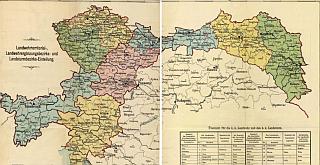
The recruitment districts of Landwehr
, 1913
K.k. Landwehr is first mentioned in the cell at Posádková věznice when Švejk doesn't return because Feldkurat Katz has chosen him as his servant. A Landwehr soldier with a vivid imagination was of the opinion that he had been taken to Motolské cvičiště to be executed.
In [II.1] when an old landverák (home defence soldier) at the station in Tábor explained to a sergeant the meaning of the word miláček (that Švejk had addressed him with). Later in the chapter the author for the first time mentions a Landwehr regiment: k.k. Schützenregiment Nr. 21.
In [II.2] k.k. Landwehrinfanterieregiment Nr. 7 is implicitly referred to as this is where Toníček Mašků was called up to. Later in the chapter Einjährigfreiwilliger Marek mentions k.k. Landwehr patrols and because the plot is now set in Budějovice the unit in question is k.k. Landwehrinfanterieregiment Nr. 29.
A curiosity is the fictive k.k. Landwehrinfanterieregiment Nr. 64 that Feldoberkurat Lacina mentions on the train from Budějovice to Királyhida in [II.3].
Background
K.k. Landwehr (lit. Land Protection) was the territorial army in Cisleithania, a force that was created in 1868 after Ausgleich. Their Hungarian counterpart was Honvéd. Landwehr reported to Ministerium für Landesverteidigung and was rather a regular fighting force than a pure territorial army/reserve force. Their units were not associated with k.u.k. Heer, had their own barracks and infrastructure, even their own military academies. The term of service was two or three years, and the arrangement with one-year volunteers functioned roughly like in the common army. ,1914
Landwehr consisted of 37 infantry regiments but as opposed to k.u.k Heer the numbers of recruitment districts didn't always correspond to those of the infantry regiments. There was for instance a Landwehrergänzungsbezirk Nr. 38 (Beroun) but no corresponding k.k. Landwehr infantry regiment. Landwehr also contained artillery and cavalry units but had no fortresses. The infantry regiments were smaller than their counterparts in k.u.k. Heer, consisting mostly of three instead of four battalions. Because of the lower number of regiments the recruitment districts were larger than those of the common army. Drafting of recruits was however coordinated and the men were divided between k.u.k. Heer and Landwehr, drawn by lot. At army corps level there was also some co-ordination as both the common army and Landwehr reported to the same Korpskommando.
The k.k. Landwehr high command was located in the building of the Ministry of Justice at Schillerplatz in Vienna. From the district of Landwehrterritorialkommando Prag hailed five Landwehr regiments (names according to Schematismus): Nr. 6 Eger, Nr. 7 Pilsen, Nr. 8 Prag, Nr. 28 Pisek and Nr. 29 Budweis. The number of infantry regiments in k.u.k. Heer in the same area was eight.
During the war

Ehrenhalle des k. k. Landwehr, , 1916
Landwehr in Bohemia were mobilised already at the start of the war. As part of 8. Korps with HQ in Prague 21. Landwehr-infanterievisision was sent to the front against Serbia were they suffered huge losses and in addition were partly blamed for the failed invasions of Serbia. In February 1915 the unit was sent to the Carpathians where other k.k. Landwehr troops from Bohemia already were fighting.
Like the Czech regiments in k.u.k. Heer the reserve battalions from k.k. Landwehr in Bohemia were relocated to non-Czech parts of the empire. This happened in the autumn of 1914 and the first half of 1915, a step that was taken due to the feared disloyalty of Czech recruits (not entirely unfounded). Examples were k.k. Landwehrinfanterieregiment Nr. 7 from Pilsen that was relocated to ethnic German Rumburk and k.k. Landwehrinfanterieregiment Nr. 28 from Písek that already in late 1914 were moved to Linz.
K.k. Landwehr ⇒ K.k. Schützen

, 4.4.1917
In April 1917 all k.k. Landwehr units were renamed k.k. Schützen. The justification was that the new name better reflected that Landwehr were indeed fighting units on level with k.u.k. Heer and not a second line home defence as the former name indicated. The Imperial decree deciding the name change was issued on 19 March 1917, published in Verordnungsblatt für die k.k. Landwehr on 4 April.[a]
Hašek and Landwehr
Jaroslav Hašek would obviously have known and been in contact with k.k. Landwehr throughout. In The Good Soldier Švejk Einjährigfreiwilliger Marek tells Švejk about the conflicts with Landwehr in Budějovice. In this setting it would have been k.k. Landwehrinfanterieregiment Nr. 29 who were garrisoned here. At the end of his stay here he might also have been in touch with k.k. Landwehrinfanterieregiment Nr. 6 from Eger (now Cheb) who were moved at the end of May 1915. Parts of this regiment were even housed in Mariánská kasárna, but probably only after IR. 91 vacated it. Two of Hašek's closest friends served with Landwehr: Zdeněk Matěj Kuděj (LIR 6 and LIR 7) and Václav Menger (LIR 28).
Quote(s) from the novel
[I.9] Nějaký pihovatý voják od zeměbrany, který měl největší fantasii, rozhlásil, že Švejk střelil po svém hejtmanovi a že dnes ho odvedli na motolské cvičiště na popravu.
[II.1] „Was ist das Wort: milatschek?“ obrátil se šikovatel k jednomu ze svých vojáků, starému landverákovi, který podle všeho dělal svému šikovateli všechno naschvál, poněvadž řekl klidně: „Miláček, das ist wie Herr Feldwebel.“
[II.2] „U nás byl taky jeden takovej nezbeda. Ten měl ject do Plzně k landvér, nějakej Toníček Mašků,“ povzdechla si babička, „von je vod mojí neteře příbuznej, a vodjel.
[II.2] ...dá se chytit landveráckou nebo dělostřeleckou patrolou v noci...
[II.2] ,Prokristapána,` slyšel jsem ho jednou hulákat na chodbě, ,tak už ho potřetí chytla landverácká patrola.
[II.2] Hejtman Spíro udeřil pěstí do stolu. "Zeměbrana vykonává službu v zemi v čas míru."
Literature
- Schematismus der k.k. Landwehr (s. 1)1914
- Handbuch für den Infanteristen des k.u.k. Heeres, sowie der k. k. Landwehr1914
- Z historie III. zeměbrany v Předlitavsku
- Historie čáslavských regimentů
| a | Verordnungsblatt für die k.k. Landwehr | 4.4.1917 |



|
I. In the rear |
 | |
10. Švejk as a military servant to the field chaplain | |||
 | Česká strana národně sociální |  | |||
| Praha II./739, Dlouhá tř. 27 | |||||
| |||||
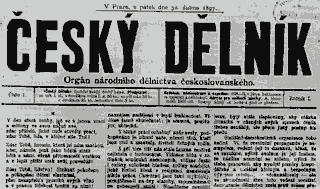
The first party newspaper, one month after the party was founded
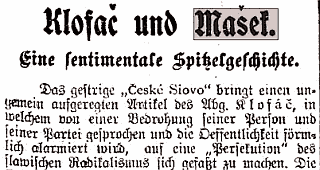
Prager Tagblatt,9.1.1909
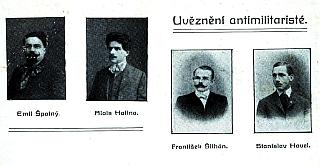
Imprisoned anti-militarists, 1909
© Národní archiv - Archiv České strany národně sociální
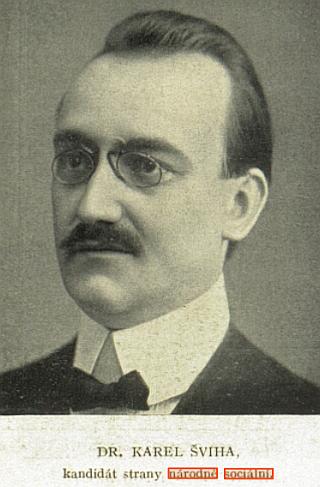
,25.6.1909

, 1910
Česká strana národně sociální is indirectly mentioned when one of the soldiers in Švejk's escort on way from Hradčany to Karlín asks him if he is a national socialist.
Background
Česká strana národně sociální was a political party that was founded in April 1897 as a break-away group from the Social Democrats and some defectors from Mladočeši. The split came about mainly because the mother party advocated working within Cisleithania as a whole, whereas the splinter group advocated state rights for the Czech Lands. The relatively large number of Jews in the mother party also played a part in provoking the break. Their political platform was roughly based on reform socialism, radical nationalism, and anti-militarism. They were also strongly anti-clerical, anti-German, promoted use of the Czech language in the public sector. The party was often referred to as "Czech Radicals". The party chairman from 1898 to 1938 was Klofáč.
The first who printed Švejk
It may, at first sight, appear odd the so much space is dedicated to the party, but in a Švejk context, there are two reasons for doing so. It was the party's own press who printed the first three stories about Švejk in 1911 (Karikatury, Josef Lada), and their principal mouthpiece České slovo was one of the main promoters of The Good Soldier Švejk after the author's death. Hašek was also shortly employed by this paper both in 1908 and 1912 and also contributed in other periods. He was a personal friend of several of the newspapermen who served the party press, and Hašek as a nationalist and socialist was no doubt ideologically close to the party.
Pre-war period
But now back to the party proper... At the 1911 election to Reichsrat the party achieved 9.7 per cent of the votes in Bohemia and had 15 representatives. In Moravia the party was much weaker and had only one representative.
Already from the beginning, Staatspolizei kept a keen eye on the party. Under particular scrutiny was the youth organisation and their newspaper Mladé proudy, led by Emil Špatný and Alois Hatina.
The agent Mašek
On 8 January 1909 party chairman Klofáč claimed in České slovo that an agent provocateur in the service of the police had tried to incriminate the party with highly treasonous fabricated material connecting them to Serbia. A key person in this plot was Hynek Mašek, a well-known adventurer and deceiver who the police already had employed to spy on politically suspect groups like the anarchists. According to Klofáč he was paid by Oberkommisar Chlum in Staatspolizei. Klofáč took the case as a matter of urgency to Reichsrat where he demanded Mašek be arrested and a stop to the illegal activities of the police. The thunderous debate took place on 12 March, but the case was rejected.
Klofáč never managed to prove the allegations, and in parts of the German language press it was ridiculed as a "romantic spy novel". The Czech newspapers were more accomodating but Čas, the paper of Professor Masaryk's Realist Party, commented in a terse and realist way that "the police have a strange connection both to the National Social party and to Hynek Mašek. No less, no more." That said many of the allegations were no doubt true, and none of them can be directly disproved.
Antimilitarist process
The youth organisation increasingly became a thorn in the eye of the authorities, mainly because they started to agitate and spread propaganda even within k.u.k. Wehrmacht, disturbing the draft process etc. In 1909 a court case against 46 of their leaders was instigated. In the first trial, only a few were convicted, but after an appeal by the state attorney, almost all of them were sentenced in 1910. The longest sentences handed out were two years. Again the name Hynek Mašek appears, and Hašek mentions both him and the trial in his feulleton Po stopách státní policie v Praze (On the tracks of the state police in Prague), Jaroslav Hašek, Čechoslovan, 21 August 1916.
The Šviha affair
In the spring of 1914, the party was hit by a scandal of far greater dimensions. The chairman of the party's group in parliament, Karel Šviha, was revealed to be linked to k.u.k. Staatspolizei and as usual when this unit was mentioned, the names Mr. Klíma and Mr. Slavíček appear. Šviha was forced to resign and the scandal signalled the end to his political career.
Banned and persecuted
In 1914 the party was banned and the leaders were arrested, and two party members were executed (editor Kotek and Slavomír Kratochvíl) in November 1914. Klofáč was spared the same fate by the 1917 amnesty issue by the new emperor Karl I.
After the war
In 1918 the party was renamed the Czechoslovak Socialist Party and in 1926 even the National Socialist Party! Their best known public profile after the war was without doubt Eduard Beneš who joined in 1923. The party was during the inter-war years member of the five-party ruling coalition. It was brutally persecuted during Nazi rule and in 1948 it was swallowed up by the communists and became their puppet party. It reappeared after the 1989 Velvet Revolution but with a dwindling number of votes, high debts, and frequent name changes, the party is now for all practical purposes non-existing.
National Socialist
The term "National Socialist" was, as the novel reveals, already used in daily speech already before World War I, but was obviously not related to the notorious Nazi party that emerged in Germany after the war. Although the two parties shared fervent nationalism, anti-Semitism and certain aspects of economic policies, the differences were much more notable.
The Czech national socials didn't seek to overthrow the democratic system, didn't persecute their opponents and were openly anti-militarist. Nor did they share the Nazi party's hatred of Communism or their ideas on racial hygiene. Whereas the Czech party's nationalism was a reaction to external threats to national culture and self-determination, their German namesake was driven by aggressive ambitions to expand at the expense of other nations.
Hašek and the party
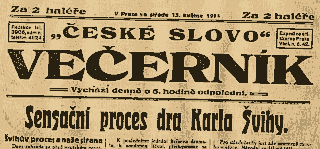
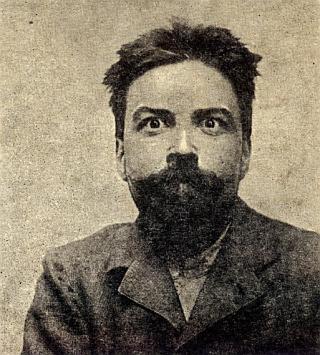
Emil Špatný, friend of Hašek - during a razzia on 27 March 1909 he swallowed a compromising letter!
© Národní archiv - Archiv České strany národně sociální
Jaroslav Hašek was a personal friend of several members of the national social youth organisation, amongst them Alois Hatina and Emil Špatný. Both were editors at the newspaper Mladé proudy, and like Hašek they were at the time close to the anarchists. If Hašek ever was a party member is not clear, but we know that he assisted during election campaigning in 1908 (Radko Pytlík).
Nor was he a stranger to the party's official newspaper České slovo and the leadership of the party proper. Several party leaders and newspapermen are mentioned in his various stories. Klofáč himself appears in The Good Soldier Švejk and features in Strana mírného pokroku v mezích zákona and elsewhere. Otherwise, Karel Šviha, Jiří Škorkovský and many others fell victim to the satirist's sharp pen.
České slovo
České slovo (The Czech Word) was founded in 1907 and Hašek's first story appeared in their columns on 28 June 1908 and he had altogether eleven stories printed in the paper that year. In 1909 his name disappeared, but in 1911 and 1912 there was some scattered activity.
Hašek briefly worked for České slovo as a local reporter in 1912 but was soon dismissed. At the height of the Šviha affair in March 1914, he wrote a stinging obituary over the party in Kopřivy, a satirical magazine associated with the rival Social Democrats!
The publishing house Melantřich was closely linked to the party, and apart from České slovo they published a number of smaller newspapers and magazines. One of them was Karikatury, a satirical magazine edited by Hašek's friend Josef Lada. It was on their pages that The Good Soldier Švejk appeared for the first time, on 22 May 1911.
Following Hašek's return from Russia, a new period of intense activity in the columns of České slovo followed. The first story appeared already on 5 January 1921 and several more followed that spring. They mostly appeared in the evening paper Večerní České slovo.
After Hašek's death, České slovo played a prominent role in popularising his novel. From 11 November 1923 onwards they published Josef Lada's famous drawings that colour our perception of Švejk even until today. In the autumn of 1924, the evening paper printed the first serious study of the links between Hašek's own experiences in k.u.k. Heer and the plot of the novel. See Jan Morávek for more details on this theme.
The letter that was swallowed
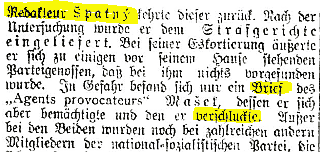
,29.3.1909
As a side note we have also made the following observation: One of Hašek's friends from the party may well have inspired one of the most memorable episodes from Švejk's stay in Királyhida. On 27 March 1909 the police carried out a house search at the homes of various members of Česká strana národně sociální. One of the subjects of the razzia was the aforementioned editor Emil Špatný. He showed himself to be very alert - and allegedly tore up and swallowed a compromising letter from the agent provocateur Mašek! The episode was reported in several papers, amongst them Prager Tagblatt[a] and Neue Freie Presse.
Quote(s) from the novel
[I.10.1] „Nejsi národní socialista?“ Nyní počal být malý tlustý opatrným. Vmísil se do toho. „Co je nám do toho,“ řekl, „je všude plno lidí a pozorujou nás. Aspoň kdybychom někde v průjezdu mohli sundat bodla, aby to tak nevypadalo. Neutečeš nám?
Sources: Svatopluk Herec
Also written:Czech National Social PartyenTschechische national-soziale ParteideDet tsjekkiske nasjonalsosiale partino
Literature
- Exploring the Nature of Nationalism and Socialism in Czech National Socialism2008
- Vztah národně sociální strany a národně sociální mládeže v letech 1901 - 19102014
- Politický klub "Osvěta" strany národně sociální1910
- Historie ČSNS
- Odboj sociálních demokratů proti Českému státu8.4.1897
- Klofač und Mašek9.1.1909
- Grosse Sturmszenen in Abgeordnetenhause10.3.1909
- Persekuce strany národně-sociální za války1921
- Hrst nezabudek, sázených na hrob strany národně sociálníJaroslav Hašek26.3.1914
- Po stopách státní policie v PrazeJaroslav Hašek21.8.1916
| a | Die antimilitaristische Propaganda | 29.3.1909 |
 | Na Kuklíku |  | |||||
| Praha II./1130, Petrské nám. 6 | |||||||
| |||||||

,16.12.1923

,20.5.1901
Na Kuklíku was the tavern where Švejk and his guards had a long and happy break before they, under the influence, continued to Feldkurat Katz in Karlín. A certain pubkeeper Serabona is reported to be the landlord, and as a member of Sokol he can be trusted.
Background
Na Kuklíku was a restaurant in Prague at Petrské náměstí. Newspaper adverts from 1877 reveal that the pub existed and that they also brewed their own beer. Towards the end of the 1880s brewing appears to have ceased, but the restaurant business continued. According to the 1900 census Gustav Holan was the landlord.
Vilém Srp was granted a license 1901 and was in 1923 still the owner. That year a newspaper report reveals that treasures worth Kč 50,000 had been hidden in the loft but had been stolen at a time when the landlord couple were ill. The culprits were caught and sentenced. It is interesting that a postcard from 1906 reveals that the place was also called U Serabono. See pubkeeper Serabona. The building was demolished in 1928.
Kuklík is mentioned in a story by Egon Erwin Kisch: Zitaten vom Montmartre where it is described as a rough place. Over the years several reports of disturbances appeared in the newspapers. There were incidents involving unruly soldiers, and reported cases of theft and a gang cheating at cards.
Quote(s) from the novel
[I.10.1] „Pojďme na Kuklík,“ vybízel Švejk, „kvéry si dáte do kuchyně, hostinský Serabona je Sokol, toho se nemusíte bát. Hrajou tam na housle a na harmoniku,“ pokračoval Švejk, „a chodějí tam pouliční holky a různá jiná dobrá společnost, která nesmí do Represenťáku.“ Čahoun s malým podívali se ještě jednou na sebe a pak řekl čahoun: „Tak tam půjdem, do Karlína je ještě daleko.“ Po cestě jim Švejk vypravoval různé anekdoty a v dobré náladě vstoupili na „Kuklík“ a udělali to tak, jak Švejk radil. Ručnice uschovali v kuchyni a šli do lokálu, kde housle a harmonika naplňovaly místnost zvuky oblíbené písně "Na Pankráci".
[I.10.1] Švejk vzpomínal též na jednoho básníka, který tu sedával pod zrcadlem a v tom všeobecném ruchu „Kuklíku“, zpěvu a pod zvuky harmoniky psával básničky a předčítal je prostitutkám.
[I.10.1] Čahoun byl také toho mínění, že polní kurát může čekat. Švejkovi se však přestalo již na Kuklíku líbit, a proto jim pohrozil, že půjde sám.
Sources: Jaroslav Šerák, M. Smreček
Literature
- Románové restaurační a jiné zábavní podniky2009 - 2021
- Bierfasser13.11.1877
- Schlimme Gäste17.5.1879
- Wirtshausexcess13.4.1880
- Lynchjustiz19.10.1898
- Loupežná vražda na Hradčanech29.4.1902
- Podivná historie s dvouzlatnikem25.8.1904
- Pro ty alimenty5.4.1912
 | Sokol |  | |||
| Praha II./61, Ferdinandova tř. 24 | |||||
| |||||
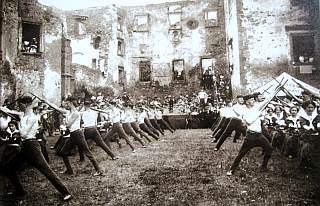
Sokol exercise at Lipnice nad Sázavou castle, some time before 1913
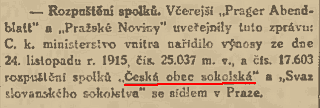
Sokol being dissolved by decree
,30.11.1915
Sokol is briefly mentioned by Švejk when he tells his escort on the way to Feldkurat Katz that the landlord pubkeeper Serabona at Na Kuklíku is a Sokol member and thus no reason to be afraid of. They could without worry leave their rifles in the kitchen and have a drink.
Background
Sokol (Falcon) is a still existing patriotic gymnastics movement founded in Prague in 1862 by Miroslav Tyrš and Jindřich Fügner. They soon became an important part of the Czech national consciousness and also took root amongst other Slav peoples in Austria-Hungary and even in Russia, Serbia and Bulgaria. Throughout the time of the monarchy the authorities kept a close eye on the movement that had strong support from parties that advocated Czech state rights, namely Česká strana národně sociální and Mladočeši. In 1910 the main office was located in Ferdinandova tř. 24, the building has been demolished. The premises are now (2015) occupied by the supermarket Tesco. Scheiner was chairman of both the Czech and the international organisation, and both were located at this address.
On 24 November 1915 the two Prague-based umbrella organisations of Sokol, Česká Obec Sokolská and Svaz Slovanského Sokolstva, were dissolved at the order of the Ministery of Interior. Local organisations were however allowed to function. The official reason for the crackdown was pro-Serbian and pro-Russians activities, anti-Austrian propaganda, and contact with North American Sokol organisation that was very hostile to the ruling dynasty. Sokol leader Scheiner had been arrested already on 25 May. Many Sokol members were indeed active in the Czech resistance movement during the war. Sokol reached its pinnacle during the first republic, but was of course banned by both the Nazis and the Communist.
On 6 January 1923 members of Sokol carried Jaroslav Hašek's coffin to his grave at Lipnice.
The good soldier Švejk in captivity
In Dobrý voják Švejk v zajetí Sokol is mentioned in connection with the interrogation of Švejk at k.u.k. Militärgericht Prag.[1]
Otázky kladou se jen auditorovi, který objasňuje velmi srozumitelně, že obžalovaný je největší lotr na světě, že byl v Sokole, že četl Samostatnost apod.
Quote(s) from the novel
[I.10.1] „Pojďme na Kuklík“, vybízel Švejk, „kvéry si dáte do kuchyně, hostinský Serabona je Sokol, toho se nemusíte bát. Hrajou tam na housle a na harmoniku,“ pokračoval Švejk, „a chodějí tam pouliční holky a různá jiná dobrá společnost, která nesmí do Represenťáku.
Literature
- Historie Sokola
- Sokol v dějinách národa
- Proč byla rozpuštěna Česká Obec Sokolská30.12.1915
- Die amtliche Verstandnis über die Auflösing der Sokolverbande31.12.1915
- Great War and Ban on Sokol
| 1 | Dobrý voják Švejk v zajetí | 1917 |
 | Reprezenťák |  | ||||
| Praha I./1090, Josefské nám. 4 | ||||||
| ||||||
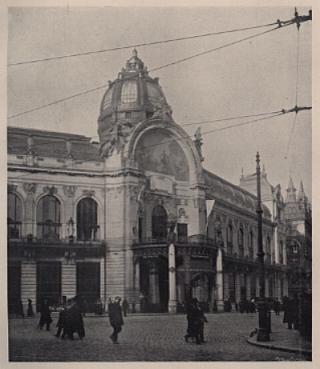
, 12.1912
Reprezenťák is mentioned when Švejk tells his escort that Na Kuklíku is a pleasant place where street girl and other good company who are not allowed at Reprezenťák may enter.
Background
Reprezenťák is a concert hall and entertainment complex in Prague, now officially called Obecní dům. It was originally known as Reprezentační dům, hence the colloquial term that Švejk uses. It is one of the landmark Art Nouveau buildings in the city. The Czechoslovak independence was proclaimed here on 28 October 1918.
Quote(s) from the novel
[I.10.1] Hrajou tam na housle a na harmoniku,“ pokračoval Švejk, „a chodějí tam pouliční holky a různá jiná dobrá společnost, která nesmí do Represenťáku.“
Literature
 | U Valšů |  | ||||
| Praha I./286, ul. Karoliny Světlé 22 | ||||||
| ||||||
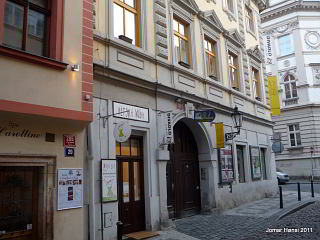
U Valšů, May 2011

,18.9.1910

Policejní ředitelstvi, 30.11.1914
U Valšů is referred to in a conversation at Na Kuklíku where it is claimed that a certain Mařka (Marie) had disappeared to U Valšů with a soldier. The place appears again in a story by Švejk on the train after Moson, [III.1].
Background
U Valšů was a coaching inn and hotel in Staré město, from 1908 owned by František Materna[a], a person who may have leant his surname to Einjährigfreiwilliger Materna. It had long traditions and is mentioned in newspapers like Fremden-Blatt as early as 1861[b]. It was still operating in 1917 (the same owner) but seems to have ceased soon after. In 2021 the building housed a theatre.
A legendary hoax
U Valšů was the scene of one of Jaroslav Hašek's most famous hoaxes. On 24 November 1914 he hired a room there, registering as a Russian businessman, born in Kiev, arriving from Moscow. He was soon arrested and taken to c.k. policejní ředitelství. Here he was interrogated by Mr. Slavíček and eventually sentenced to five days in prison. Hašek claimed that the he did it to check how vigilant the security services were! The story soon appeared in newspapers, including the author's humorous response!
Both Václav Menger and Emil Artur Longen mention the episode in their books about Hašek and both brush up the story with dialogues and other details. The police report didn't mention what name Hašek registered under whereas Václav Menger claims it was Ivan Feodorovič Kuzněcov and Longen names him Lev Nikolajevič Turgeněv. Both these versions ought to be read with some scepticism, particularly Longen's. He lets the narrator be some detective Spanda and he even claims that he was the model for detective Bretschneider.
Another version of the story (origin unknown) claims that he registered under a name which backwards read "lick my arse", but this is surely nothing more than a "good story" and is not supported by the police records, nor by Václav Menger nor Longen.
Quote(s) from the novel
[I.10.1] U hudby hádali se dva, že nějakou Mařku včera lízla patrola. Jeden to viděl na vlastní oči a druhý tvrdil, že šla s nějakým vojákem se vyspat k „Valšům“ do hotelu.
Sources: Václav Menger, Emil Artur Longen
Literature
- Románové restaurační a jiné zábavní podniky2009 - 2021
- Jaroslav Hašek1928
- Jaroslav Hašek doma1935
- Přispěvky3.5.1862
- Falešný uprchlík z Ruska13.12.1914
- Humoristovy rozmary18.12.1914
- Laciné noclehy12.6.1919
- Pražské hotely ve světle statistiky10.1.1924
| a | Pobytové přihlášky pražského policejního ředitelství | 1851 - 1914 | |
| b | Der Judenkrawall in Prag | 4.8.1861 |
 | U Šuhů |  | ||||
| Praha I./722, Benediktská ul. 9 | ||||||
| ||||||
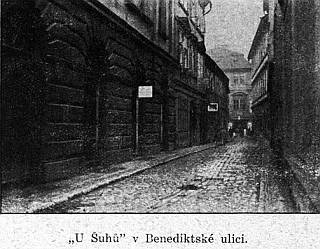
Konec bahna Prahy, ,1927

Národní politika,2.1.1898
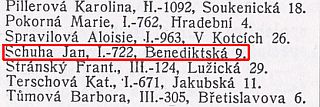
© Milan Hodík
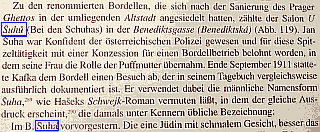
Wo Kafka und seine Freunde zu Gast waren, ,2000
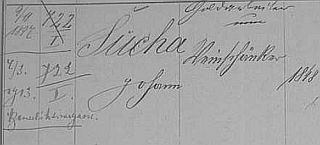
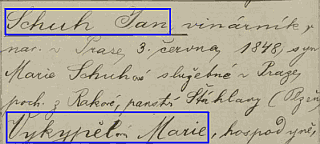
Marriage record,1901
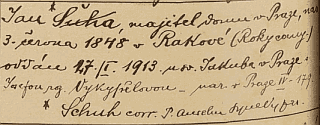
Death record,26.5.1919

U Šuhů was a brothel where Feldkurat Katz owed money, and subsequently didn't want visit any. The place is mentioned twice more: in Part Three in Einjährigfreiwilliger Marek's story about the court of Erzherzogin Marie Valerie and in the story about tinsmith Pimpra.
Background
U Šuhů was a brothel in Benediktská 9. According to Chytilův úplný adresář království českého (1913) it was owned by Jan Schuha whom the establishment presumably was named after. In Cecil Parrott's translation of The Good Soldier Švejk, a footnote describes U Šuhů as a "notorious brothel".
Kafka at Šuha's brothel
Feldkurat Katz and tinsmith Pimpra were not the only notabilities who frequented Šuha. In his diary Franz Kafka discretely mentions a visit on 28 September 1911 when he was served by a "Jewess with a narrow face". He also describes the interior in some detail. The brothel's hostess is described in rather unflattering terms[b].
Kafka expert Hartmut Binder provides interesting information in his book Wo Kafka und seine Freunde zu Gast waren. He reveals that Jan Šuha obtained a brothel's license as a reward for acting as a police informer. It was his wife who managed the brothel, an arrangement that was quite common at the time. It is also revealed that Kafka must have visited more than once. After the death of her husband, Mrs. Šuha married Rudolf Kulhánek, the establishment's bouncer.
Newspaper clips
In a newspaper article from 1891 it is revealed that Šuha was a police informer who contributed to the capture of two thieves who attempted to rob a shop in Michle. The article also states that Šuha was 43 years old so he must have been born in 1848.
Šuha was already in 1896 listed as proprietor of a wine bar at the above mentioned address, and in 1898 a newspaper clip refers to Jan Šuha, owner of a night café in Benedikstká ulice. That year he bought a café in Konviktská ulice in Staré město. In 1907 (3 April) Architektonický ozbor reported that Šuha had bought house no. 1030 in Benediktská for 96,000 crowns. This was the house on the corner next to the brothel.
In 1923 Národní politika reported of a fight in front of the house, when a drunk man tried to enter a flat because he thought this was where the brothel still was. So Šuha had ceased doing business some time between 1913 and 1923. He had by 1913 reached the age of 65 and in 1919 licensed brothels were made illegal although the ban was later relaxed somewhat.
Police registers
The police registration protocols reveal more. They confirm that Johann Šucha was born in 1848 and that he in 1901 married the 29 years younger Marie Wykypěl. Šuha is listed with two occupations: Goldarbeiter (gold craftsman) and Weinschänker (wine tavern waiter), born and with Heimatrecht in Rakov near Plzeň. On 4 March 1913 they are both entered as residents of Benediktinergasse 722/I. It should also be noted that Emilie Rossmann (born Vykypěl, Brno 1887) is entered at the same address. It is tempting to suggest that she may have been the sister of Marie.
Church records
Research in church records by Jaroslav Šerák (2019) provides more details about the proprietor of the brothel. The files provide birth and death dates, and also information about marriages.
Jan Schuh (name according to birth record) was born outside marriage at Hradčany on 3 June 1848, not in Raková as the police registers show. On 18 April 1901 he married the 23 year old Marie Vykypělová who already then served as "madam" at his establishment. Marie Schuhová died already on 5 November 1910 so she could not have been the brothel madam who Kafka wrote about in his diary a year later (but it may have been her that Einjährigfreiwilliger Marek remembers). On 27 January 1913 Schuh married the younger sister of his late wife, Josefa Vykypělová. She also functioned as madam at the establishment so it was probably her Kafka described. Brothel owner Jan Schuh died on 26 May 1919.
It is also confirmed that Josefa Schuhová shortly after her husband's death married the 8 year younger head waiter at the brothel, Rudolf Kulhánek. Emilie Rossmannová, married to Leopold, was the sister of the two brothel mamas. Josefa Kulhánková died on 5 September 1924, at the age of 43.
Census, 1900
The 1900 census reveals more details (the 1910 census records are not yet available digitally). Šůha owned aprtment number 19 and 20, and altogether 15 persons lived there. Apart from they owner they were the waitress (Marie Vykypěl) and two more waitresses/servants (Josefa Vykypěl and Anna Vlachovská). In addition there were 11 prostitutes where the two youngest were 15 and the oldest 23! Everyone in the flats reported Czech as their common speech[a].
Franz Kafka, Diaries, 1 October 1911
In B. Suha two days before yesterday. The sole Jewess with a narrow face, continuing in a narrow chin, but with an extensively wavy and broad hair style . The three small doors leading from the interior of the building to the hall. Guests like in a guard house on the stage, drinks on the table, but are hardly touched. The woman with the flat face in a square dress that begins to move only deep down below the seam. Now, as before, some are dressed like puppets for a children’s theatre, as one sells them on the Christmas market, i.e. covered with ruffles and gold and loosely sewn, so that they can be separated in one go and they fall apart between one’s fingers. The hostess with the light blonde and tightly pulled hair, no doubt covering a disgusting foundation, with sharply declining nose, whose direction has some geometric relation to the sagging breasts and the tightly strung belly, complains of a headache, which is caused by the fact that today, Saturday, there was great hype but nothing to it.
Franz Kafka, Tagebücher, 1. Oktober 1911
Im B. Suha vorvorgestern. Die eine Jüdin mit schmalem Gesicht, besser das in ein schmales Kinn verlauft, aber von einer ausgedehnt welligen Frisur ins Breite geschüttelt wird. Die drei kleinen Türen, die aus dem Innern des Gebäudes in den Salon führen. Die Gäste wie in einer Wachstube auf der Bühne, Getränke auf dem Tisch, werden ja kaum angerührt. Die Flachgsichtige im eckigen Kleid, das erst tief unten in einem Saum sich zu bewegen anfängt. Einige hier und früher angezogen wie die Marionetten für Kinderteater, wie man sie auf dem Christmarkt verkauft d.h. mit Rüschen und Gold beklebt und lose benäht, so daß man sie mit einem Zug abtrennen kann und daß sie einem dann in den Fingern zerfallen. Die Wirtin mit dem mattblonden über zweifellos ekelhaften Unterlagen straff gezogenem Haar, mit der scharf niedergehenden Nase, deren Richtung in irgendeiner geometrischen Beziehung zu den hängenden Brüste und dem steif gehaltenen Bauch steht, klagt über Kopfschmerzen, die dadurch verursacht sind, daß heute Samstag ein so großer Rummel und nichts daran ist.
Quote(s) from the novel
[I.10.2] Polní kurát pustil se vrat a navalil se na Švejka: „Pojďme tedy někam, ale k Šuhům nepůjdu, tam jsem dlužen.“
[III.3] Kvůli pořádku, aby si snad dvorní lokajové nedovolili nějaké důvěrnosti ku dvorním dámám přítomným na hostině, objevuje se nejvyšší hofmistr baron Lederer, komoří hrabě Bellegarde a vrchní dvorní dáma hraběnka Bombellesová, která hraje mezi dvorními dámami stejnou úlohu jako madam v bordelu u Šuhů.
[III.4] Švejk velice vážně a důrazně řekl: „Nic jste neprováděl, pane lajtnant, byl jste jenom na návštěvě v jednom vykřičeným domě. Ale to byl asi nějakej vomyl. Klempíře Pimpra z Kozího plácku taky vždycky hledali, když šel kupovat plech do města, a našli ho také vždycky v podobnej místnosti, buď u ,Šuhů’, nebo u ,Dvořáků’, jako já vás našel.
Sources: Jaroslav Šerák, Franz Kafka, Hartmut Binder, K.L. Kukla
Also written:Schuhade
Literature
- Pobytové přihlášky pražského policejního ředitelství1851 - 1914
- Adressář královského hlavního města Prahy a sousedních obcí1896
- Krádež pod dozorem konfidentů16.4.1891
- Změny držebnosti2.1.1898
- Spletl si to13.4.1923
| a | Sčítání lidu Praha I. | 1900 | |
| b | Tagebücher, Heft 1 | 1.10.1911 |
 | Korpskommando |  | ||||
| Praha III./258, Malostranské nám. 15 | ||||||
| ||||||
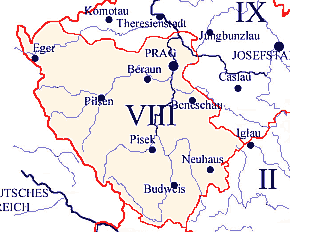
The recruitment area of the 8th Corps
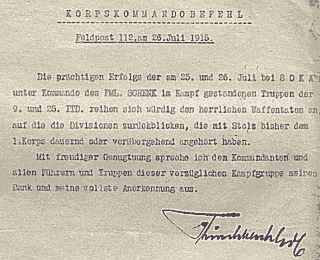
Korpskommando at Sokal. Signed von Scheuchenstuehl.
Korpskommando is mentioned by Feldkurat Katz in his drunken stupor on the way back from Oberleutnant Helmich's party.
Background
Korpskommando here refers to the 8. Korpskommando, one of a total of 16 army groups in Austria-Hungary. The corps, with headquarters in the Lichtenstein Palace in Malá Strana recruited from south, west and central Bohemia. Together with 9. korps (Litoměřice) it covered all of Bohemia.
Subordinated the corps were these units: 9. Infanteriedivision (with IR. 91), 19. Infanteriedivision, L21. Infanteriedivision, 8. Feldartilleriebrigade, 1. Kavaleriebrigade and Traindivision Nr. 8. Corps commander in 1914 was general Artur Giesl von Gieslingen. After the failure in Serbia in 1914 he was replaced by Viktor von Scheuchenstuel.
Employed in the corps was also the master-spy Alfred Redl, chief of their general staff from 18 October 1912. In May 1913 his activities were uncovered: he had been spying for Russia for around 10 years. He is regarded as one of the best (worst) spies ever, and handed over whatever existed of value.
Quote(s) from the novel
[I.10.2] Polní kurát, který zaslechl poslední slova, pobručuje si nějaký motiv z operety, kterou by nikdo nepoznal, vztyčil se k divákům: "Kdo je z vás mrtvej, ať se přihlásí u korpskomanda během tří dnů, aby mohla být jeho mrtvola vykropena."
Literature
 | Infanterieregiment Nr. 75 |  | ||||
| Salzburg | ||||||
| ||||||

,1908
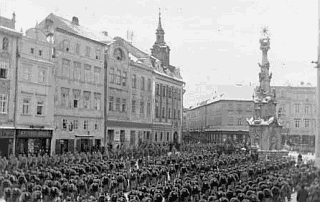
Town square in Jindřichův Hradec
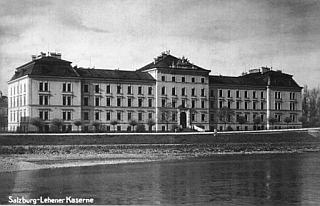
Lehener Kaserne, Salzburg
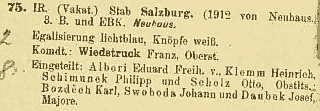
,1914
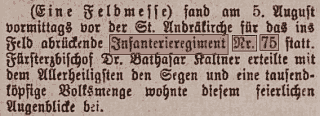
,8.8.1914
Infanterieregiment Nr. 75 is mentioned in passing when the inebriated Feldkurat Katz in the cab home from Oberleutnant Helmich mistakes Švejk for Oberst Just from the 75th regiment.
The regiment is mentioned again when Feldkurat Katz and Švejk have to borrow a trophy from Oberleutnant Witinger for their field mass in [I.11].
In [II.3], on the train to Bruck Švejk mentions Korporal Rejmánek from this regiment in an anecdote. A member of the escort adds more anecdotes that are related to the regiment, for instance from Serbia. In the next chapter Oberst Schröder mentions the regiment when he tells Oberleutnant Lukáš about his experiences by the front south of Belgrade. See II. Marschbataillon.
Background
Infanterieregiment Nr. 75 was one of 102 Austro-Hungarian infantry regiments. It was founded in 1860 and had their baptism of fire already in 1866 at the second battle of Custoza.
It was a predominantly Czech regiment, recruited from Heeresergänzungsbezirk Nr. 75, Jindřichův Hradec (Neuhaus). The Ergänzungsbezirkskommando and 3rd battalion were located here in 1914. The staff and the other three battalions had been garrisoned in Salzburg from March 1912. In Salzburg they raised some attention with their Czech songs, and are said to have caused a boom in the local interest in football.
Regimental commander was colonel Franz Wiedstruck. The regiment had previously been moved around; between 1906 and 1909 in Prague, at Hradčany. Then it moved to Jindřichův Hradec where it remained until the 1912 transfer.
During the war
Already on 5 August 1914 the regiment departed for the front against Russia. They were allocated to the 4. Armee and in 1914 the fought mostly in the area between the river San and Kraków. In the new year they were transferred to the German Süd-Armee and moved to the area east of Munkács. The regiment remained on the eastern front until September 1917 when they were transferred to Tyrol [d].
Zborów
The regiment received particular attention after the battle of Zborów on 2 July 1917. On this day many of the regiment's soldiers were taken prisoners by their own countrymen from the Legions and accusations of treason led to investigations in Vienna and the case was brought up in Reichsrat.
Ersatzbataillon
The replacement battalion was in November 1915[a] relocated to Debrecen where they remained until the end of the war[b]. The unit that replaced them in Jindřichův Hradec was Infanterieregiment Nr. 101 from Hungarian Békéscsaba[c].
Oberst Schröder
In a historical context it is obvious that Oberst Schröder and other figures from The Good Soldier Švejk who claimed that the regiment fought in Serbia are mistaken. See II. Marschbataillon.
Gott strafe England
The regiment is also mentioned in Jaroslav Hašek's polemic story Gott strafe England[e]. In this story the main character Hauptmann Adamička turns insane, is transferred to Infanterieregiment Nr. 75 and is taken prisoner at Zborów. The real Josef Adamička however never served in the regiment - and he was stationed in Belgrade at the time the battle was fought.
Wehrgeschichte Salzburg (Erwin Niedermann):
Auf Wunsch des Erzherzog-Thronfolgers Franz Ferdinand (1863– 1914), der in Blühnbach das Jagdschloß besaß, sollten beim zumeist nur deutschsprachigen Militär in Salzburg aber auch Angehörige einer anderen Sprache des multinationalen und multikulturellen Reiches den (ab 1908) zweijährigen Wehrdienst ableisten, so wie das längst in den anderen Kronländern üblich war. So wurden anstelle der „Rainer“ (es verblieb nur das 4. Bataillon) der Regimentsstab und drei Bataillone des Böhmischen Infanterie-Regimentes Nr. 75 aus Neuhaus/Jindrichuv Hradec (lichtblaue Aufschläge, weiße Knöpfe, 79 Prozent tschechische Umgangssprache, 20 Prozent deutsche,1 Prozent verschiedene) mit März 1912 hierher transferiert, wobei ein Bataillon auch in die Lehener Kaserne kam, die anderen zwei in die Franz Josef-Kaserne, bzw. Hofstall-Kaserne und Nonntalerkaserne, die „Rainer“ in die Hellbrunner-Straße, bzw. auf die Festung. Die Salzburger sollen sehr unverständig erstaunt gewesen sein über die in und außer Dienst gesungenen tschechischen Volkslieder der Soldaten, wie mehrfach überliefert wurde.
Die Soldaten dieses IR 75 sollen bereits vor dem Krieg sich für Fußball interessiert haben. Soldaten dieses Regimentes haben vermutlich den Fußball-Boom in Salzburg ausgelöst. Im Mai 1914 wurde im Rahmen eines Militärsportfestes ein Fußballspiel am Exerziergelände der Hellbrunner-Kaserne abgehalten. Salzburger Realschüler spielten gegen Soldaten des IR 75. Die Realschüler schlossen sich dann zu einem Fußballverein “Die Athletiker” zusammen, aus dem der “Erste Salzburger Athletiker-Klub (1.SAK 1914) entstand. Eine weitere Information dazu spricht von der Landwehr Nr.8 in der Hellbrunner-Kaserne, in der Fußball-Spieler aus den böhmischen Mannschaften SLAVIA und SPARTA als Soldaten Dienst versahen.
Quote(s) from the novel
[I.10.2] Švejk ho vzbudil a za pomoci drožkáře dopravil do drožky. V drožce polní kurát upadl v úplnou otupělost a považoval Švejka za plukovníka Justa od 75. pěšího pluku a několikrát za sebou opakoval: „Nehněvej se, kamaráde, že ti tykám. Jsem prase.“
[I.11] Tak dostaneme sportovní pohár od nadporučíka Witingra od 75. pluku. On kdysi před lety běhal o závod a vyhrál jej za ,Sport-Favorit’. Byl to dobrý běžec. Dělal čtyřicet kilometrů Vídeň-Mödling za 1 hodinu 48 minut, jak se nám vždycky chlubí. Jsem hovado, že všechno odkládám na poslední chvíli. Proč jsem se, trouba, nepodíval do té pohovky.“
[II.3] Potom ještě vím o jednom kaprálovi od pětasedmdesátejch, Rejmánkovi...“
[II.3] „U pětasedmdesátýho regimentu,“ ozval se jeden muž z eskorty, „prochlastal hejtman celou plukovní kasu před válkou a musel kvitovat z vojny, a teď je zas hejtmanem, a jeden felák, kterej vokrad erár vo sukno na vejložky, bylo ho přes dvacet balíků, je dneska štábsfeldvéblem, a jeden infanterista byl nedávno v Srbsku zastřelenej, poněvadž sněd najednou svou konservu, kterou měl si nechat na tři dny.“
[II.4] Brigádní telefonní centrála hlásí, že se nikam nemůže dozvonit, jenom že hlásí štáb 75. regimentu, že právě dostali od vedlejší divise rozkaz ,ausharren’, že se nemůže smluvit s naší divisí, že Srbové obsadili kótu 212, 226 a 327, žádá se o zaslání jednoho batalionu jako svaz a spojení po telefonu s naší divisí.
Literature
- Schematismus für das k.u.k. Heer (s. 527)1914
- Překládání náhradních těles jednotek z Čech2014-2023
- 75. pěší pluk
- Padlí a ranění vojáci IR 75 v bitvě u Zborova - 1. část
- Die Feuertaufe der 75erJosef Daubek1924-1928
- Přísaha c. a k. pěš pl. č. 75.14.8.1914
- Odjezd jindřichohradecké posádky1.1.1915
- Der Oberste Kriegsherr und sein Stab1908
| a | Ctěnému obyvatelstvu města Jindřichova Hradce! | 26.11.1915 | |
| b | Jak prožívali Pětasedmdesátníci státní převrat v Debrecíně | 23.10.1936 | |
| c | Jindř. Hradec a Slovensko v minulosti | 18.9.1936 | |
| d | IR 75 - bojová cesta | 2014-2023 | |
| e | Gott strafe England | Jaroslav Hašek | 15.10.1917 |
 | Sport-Favorit |  | ||||
| Praha I./583, Na Příkopě 15 | ||||||
| ||||||

The club's address in 1910
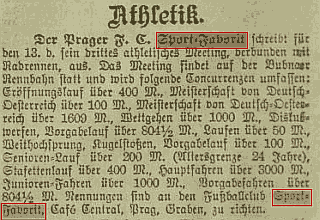
,3.7.1902
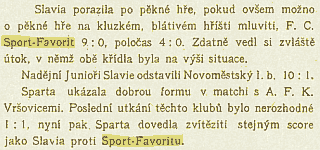
,19.3.1909
Sport-Favorit is mentioned in connected with the running exploits of Oberleutnant Witinger. Years ago he had won the trophy that Feldkurat Katz borrowed to use at the field mass and at the time he was running for Sport-Favorit. Later in the chapter it is revealed that the race in question was from Vienna to Mödling.
Background
Sport-Favorit was a German sports club from Prague and officially named Fussballclub Sport-Favorit. Despite the name and the main focus on football they also did athletics and cycling, at least during the early years.
The club was founded in 1900 by merger between Sport and FavoritlR(a). The offices were located on Na Příkopě (Graben), was associated with Café Central, and the football matches were played at Letná. The running competion mentioned in the article to the right took place at a course in Bubny on 13 July 1902.
Quote(s) from the novel
[I.10.2] Tak dostaneme sportovní pohár od nadporučíka Witingra od 75. pluku. On kdysi před lety běhal o závod a vyhrál jej za 'Sport-Favorit'. Byl to dobrý běžec. Dělal čtyřicet kilometrů Vídeň-Mödling za 1 hodinu 48 minut, jak se nám vždycky chlubí. Jsem hovado, že všechno odkládám na poslední chvíli. Proč jsem se, trouba, nepodíval do té pohovky.“
[I.10.2] Konečně se ozvalo „Zum Gebet!“, zavířilo to prachem a šedivý čtverec uniforem sklonil svá kolena před sportovním kalichem nadporučíka Witingra, který on vyhrál za Sport-Favorit v běhu Vídeň-Mödling.
Literature
- Spolkový katastr
- Fussballclub "Sport Favorit in Prag"1910
- Různé zprávy27.11.1902
- Athletik30.6.1904
- Sportovní věstník18.3.1911
| a | Ein fusion zwischen ... | 7.11.1900 |
 | Bruska |  | |||||
| Praha III./132, Pod Bruskou 2 | |||||||
| |||||||

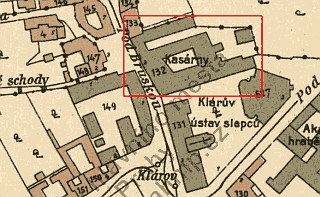
Bruska was the barracks where Hauptmann Šnábl served. Švejk was sent here by Feldkurat Katz to borrow money and to buy ořechovka (nut spirits).
Background
Bruska refers to the now demolished barracks that were located at Klárov in Malá Strana, next to Klárův ústav slepců. They were named after the small (mostly underground) stream Bruska (Brusnice) that flows past the site.
These barracks were for most of the pre-war time the home of the staff of Infanterieregiment Nr. 28, one or more battalions, the replacement district command, and K.u.K. Artillerieregiment Nr. 8. Units were frequently moved around so who occupied the barracks could change as often as each year. In 1914 only the 2nd battalion of IR28 was garrisoned here.
In 1914 the building was sold to the city of Prague and the military personnel were moved to Josefskaserne in Praha II. and Ferdinandkaserne in Karlín. The recruitment command was however still there in October, so if Hauptmann Šnábl had any base in the real world he would surely have belonged to this unit. Still it seems that the building was used by the military also later. In 1915 Landsturm drafts took place here and in 1916 Prager Tagblatt reported on Hungarian soldiers on the site. In 1919 the building was used for recruitment of army volunteers. The barracks were demolished in 1922 and the former site is now only partly occupied by buildings.
Quote(s) from the novel
[I.10.3] Kdyby zde byla pravá ořechovka,“ povzdechl, „ta by mně spravila žaludek. Taková ořechovka, jako má pan hejtman Šnábl v Brusce.“
Literature
 | Vršovice kasárna |  | |||||
| Vršovice/429, Na Mičánkách - | |||||||
| |||||||
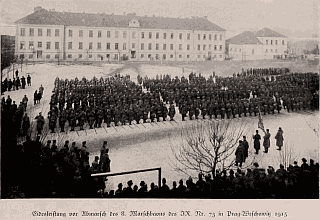
Eidesleistung vor Abmarsch des 8. Marschbaons des IR. Nr. 73 in Prag-Wrschowitz 1915.

,Maxmilian Hoen
Vršovice kasárna was a garrison where Švejk dropped by to borrow money from Oberleutnant Mahler. In [I.14] and [I.15], the plot may the most part takes place in Vršovice, without this being stated explicitly. Some indication is the fact that Blahník took the stolen dog Max here, but in the next chapter Oberleutnant Lukáš seems to live much nearer the centre.
Background
Vršovice kasárna probably refers to the barracks in Vršovice that were home of IR73 at the time. In 1914 it housed the regiment's staff and three battalions. In contrary to other Bohemian regiments they were allowed to stay in their home garrison during the whole war.
Most of the military personnel left the barracks hastily after the revolution of 28 October 1918 and set off to their home region of Eger (now Cheb). The barracks were immediately taken over by local militiamen (Sokol) and a few days later the newly formed Czechoslovak artillery moved in. The site was used by the military until the 1950's and now houses the court of four districts.
There was also another barrack in Vršovice but as it was used by Traindivision Nr. 8 and is a less likely candidate than the above-mentioned infantry barracks. The address was Palackého třída 334 (now Moskevská). This barrack compex was extenisve and contained staff buildings, stables, stores and officer's accommodation. The barracks were gradually demolished between 1965 and 1983 and the housing estate Vlasta now occupies the site.
Quote(s) from the novel
[I.10.3] Jestli tam nepochodíte, tak půjdete do Vršovic, do kasáren k nadporučíkovi Mahlerovi.
Sources: Michael Kummer
Literature
- Letzte Kämpfe vor BelgradMaximilian Hoen1939
- Das k.u.k. IR. 73 im 1. Weltkrieg
- Requisitionen in Prager Kasernen31.10.1918



|
I. In the rear |
 | |
11. Švejk rides with the field chaplain to serve a field mass | |||
 | České legie |  | |||
| |||||
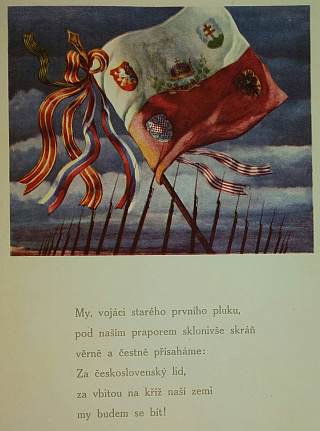
, 1925.

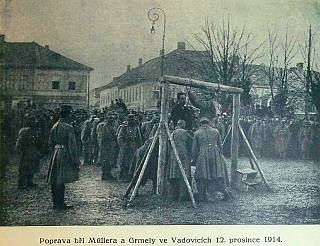
The execution of Josef Müller and Antonín Grmela, 12 December 1914. The chaplain František Havlík was present.

Hašek's notes on execution of legionnaires, Samara spring 1918.
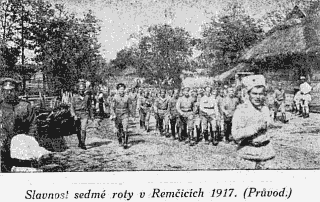
Celebration in the 7th company, 1st rifle regiment.
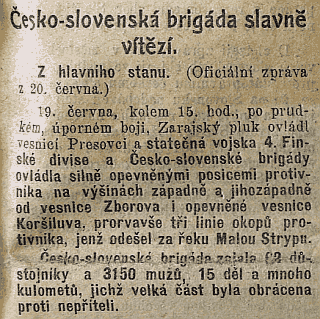
Announcing the victory by Zborów on 2 July 1917.
,25.6.1917

From the trenches by Zborów.
© LA-PNP
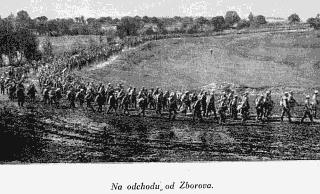
Retreat from Zborów, July 1917.
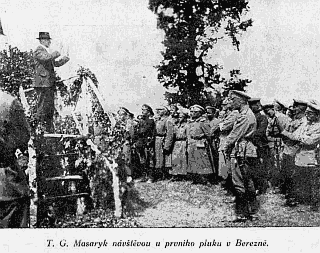
Masaryk visiting in August 1917.

Czech volunteers in Russia, 1917.
© VHU
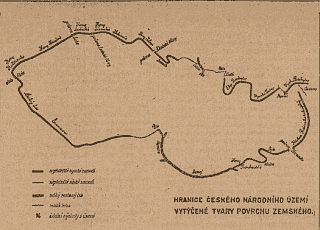
Proposals for the borders of a future Czech state.
, 21.10.1917
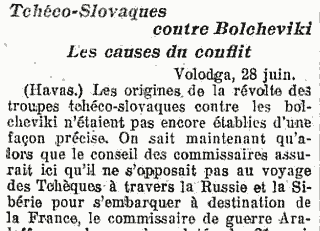
On the origin of the Czechoslovak rebellion.
,29.6.1918
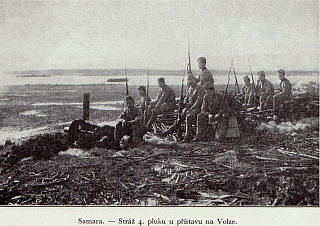
Guards from the 4th regiment in Samara.
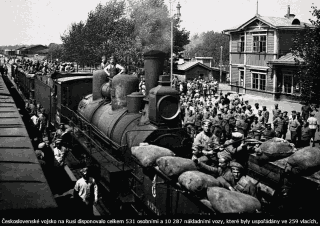
The railway was the mainstay of the Legions.
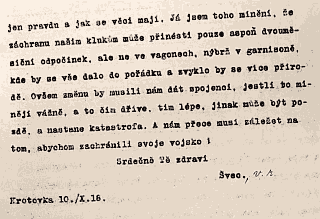
Švec's letter to Stanislav Čeček about the desperate plight of his troops.
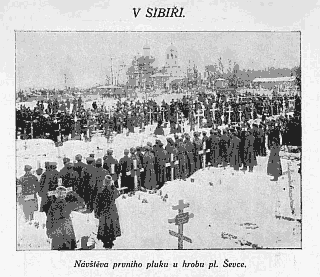
At the grave of colonel Švec, autumn 1918.
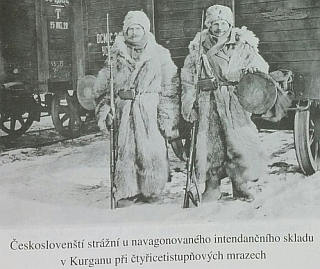
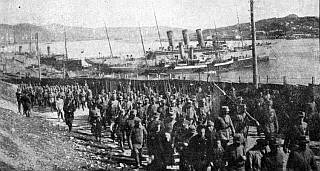
The majority travelled home from Vladivostok.

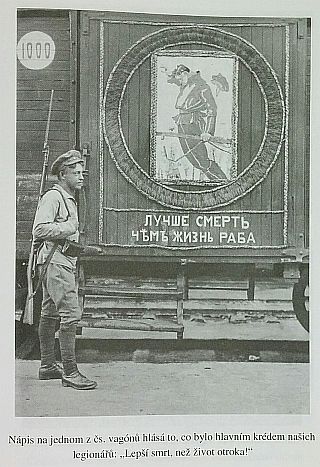
Rather death than the live of a slave
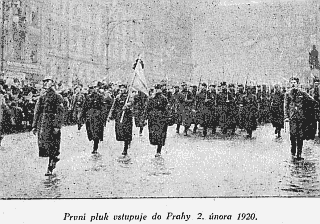
The first regiment "Jan Hus" Prague for the first time.
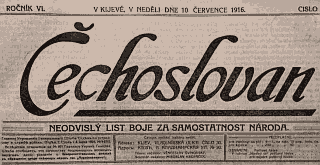
The first issue that Hašek contributed to.
,10.7.1916

The story of the picture of emperor Franz Josef I.
,17.7.1916
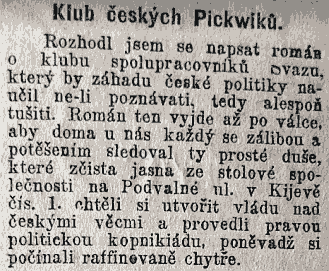
The beginning of Hašek's Klub českých Pickwiků.
,23.4.1917
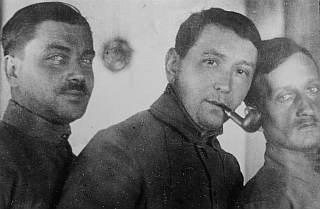
The only known photo of Jaroslav Hašek from his time in the Legions. Here with Jan Šípek and Václav Menger. Berezne 29 September 1917 (12 October).

Advert for Švejk
,29.1.1917
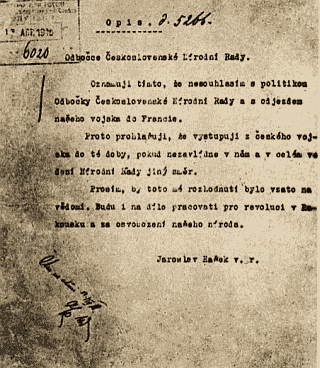
Hašek announcing that he leaves the Czech army.
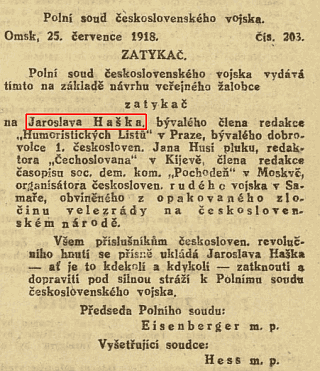
The Czechoslovak Army's arrest order for Hašek, Omsk 25 July 1918. Here imprecisely reproduced in Národní listy, 11 January 1919.
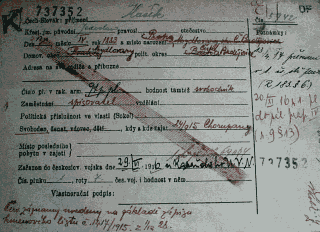
Hašek's service sheet from the legions.
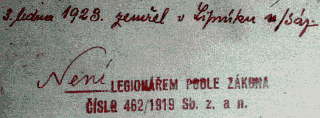
Hašek's had according to Czechoslovak law not status as a legionnaire. The law that defined the status of the legionnaires was ratified in 1919.
České legie is Hašek's term for Československé Legie (Czechoslovak Legions) that he mentions indirectly when discussing field chaplains and their role at executions. He lists several examples to illustrate his point, amongst them execution of Czech legionnaires.
The Legions are barely mentioned in The Good Soldier Švejk so the reader may wonder why a page about the novel dedicates so much space to an organization the author touches upon only once ...
The answer is that there can be no doubt that the Legions would have been a main focus in the three volumes of the novel that the author had planned but never finalised. Jaroslav Hašek dedicated two years of his life to the Czech independence movement, and there is every reason to believe that he would have continued to spice his novel with autobiographical details, add people from his own milieu and episodes from his time there, just as he drew inspiration from his far shorter time of service in k.u.k. Heer.
Background
České legie (more commonly Československé legie or Česko-slovenské legie) is a collective term describing different groups of mainly Czech volunteers who fought for the Entente against the Central Powers during World War I and from May 1918 against the Bolsheviks (communists) in the Russian Civil War. Politically they reported to Československá národní rada (the Czechoslovak National Council) in Paris (from February 1916), militarily they were part of armies of the Entente powers that hosted them. From 1916 the Legions were an important instrument in the National Council's campaign to convince the allies to allow an independent Slavic state in Bohemia, Moravia and Slovakia. As Professor Masaryk, the leader of the Czechoslovak independence movement, later summarised: "a state without an army can hardly make a claim to independence".
Already shortly after the outbreak of war units of Czech volunteers were formed in France and Russia (and later also in Italy). In the novel the author obviously refers to the legions in Russia because it was those he knew and had experience from.
Execution of legionnaires
Austrian and Hungarian citizens who served the enemy voluntarily had to expect rough justice if they were captured. The first Czechs who suffered this grim fate were Josef Müller and Antonín Grmela who were hanged publicly on the square in Wadowice near Kraków on 12 December 1914. František Havlík was the chaplain and witness at the execution (see the next paragraph). Many legionnaires were executed during the war, but this was the first and best known case and Hašek definitely knew about it.
František Havlík, Wadowice, 12 December 1914
Poslední chvíle odsouzenců popsal zpovídající kněz František Korporal Havlík: „Pod šibenicí jim byl znovu přečten rozsudek. Na otázku, mají-li poslední prosbu, vůbec neodpověděli. Rozloučili se spolu kývnutím hlavy. Grmela šel hrdě, se vztyčenou hlavou. Vystoupil po schodkách, svlékl svrchní kabát a odhodil, odvázal šátek, který měl kolem krku a rovněž odhodil, pak se podíval na diváky, kterých bylo všude plno, uklonil se, usmál a vstrčil hlavu do smyčky. Pak přišel na řadu Gefreiter Müller. Zůstali viset do večera do šesti hodin. Potom byli zakopáni v koutě wadowického hřbitova.“
Execution of legionnaires continued throughout the war and as late as May 1918 Hašek himself claimed in a propaganda poster he signed in Samara. The Germans had allegedly executed 200 of his compatriots in Jekaterinoslav (now Dnipro) and in Kharkov an Austrian military court had sentenced 12 members of the Russian branch of the Czechoslovak National Council to death.
The Bolsheviks also executed a number of Czechs, something the author as a political official in the Bolshevik’s 5th army would have been aware of. Still, it is unlikely that these events would have inspired the passage in the novel, because the communists were unlikely to have called in clerics for such occasions and the author would at this stage of the novel surely not have aimed his pen at his former comrades.
Česká družina [The Czech Cohort]
At the outbreak of the World War I around 65,000 Czechs and Slovaks are believed to have resided in Russia (some sources mention 100,000). Most of them lived in the Kiev Gubernate, mostly in Kiev proper and in the Volhynia province near the border with Galicia. Among these were both Russian citizens and Austrian citizens who for various reasons lived in the Russian empire at the time.
From both categories volunteers reported to serve Russia and already in August 1914 the Tsar Nicholas II approved the creation of Česká družina, a semi-autonomous and non-fighting unit in the Russian army. Den 28 September 1914 (the day of St. Václav) they swore allegiance in Kiev and then counted 762 men, a number that had increased to 990 by the end of the year. They were mainly given reconnaissance and agitation duties at the front and were assigned to the Russian 3rd Army that took part in the battles by Dunajec and Raba in November and December.
The number of "družiníci" grew only slowly until 1917 and recruitment of prisoners was rather unsuccessful. Russian authorities were uncooperative for various reasons: distrust ("once a traitor, always a traitor"), need for skilled labour in factories and agriculture and also doubt about the legality of recruiting prisoners. In the beginning the Russians only accepted those who volunteered on the spot after capture, but in April 1916 these restrictions were eased and recruitment in prisoner’s camps was permitted. Still, few of the prisoners were keen to return to war duty and recruitment was sluggish.
Changes in Russia
By January 1916 the number of soldiers in Družina had grown to 1,650 and it was decided to transform the unit into a regiment. It was first renamed Česko-slovenský střelecký pluk (the Czecho-Slovak Rifle Regiment) on 2 February 1916 and then Česko-slovenská střelecká brigáda (the Czecho-Slovak Rifle Brigade) on 17 April 1916. Thus it was the latter Jaroslav Hašek formally was enlisted in on 29 June 1916 after having reported as a volunteer in the prisoner's camp in Totskoye.
During the so-called Kerensky offensive in July 1917 the Czechoslovak brigade for the first time operated as a collective unit in a regular battle. They still counted only around 3,500 (estimates vary) but distinguished themselves by Zborów on 2 July 1917 where they prevailed against numerically superior enemy forces and captured a large number of enemy soldiers, many of them Czechs from Infanterieregiment Nr. 35 and Infanterieregiment Nr. 75. Although the military significance of the victory was negligible, the political impact was substantial: the victory raised attention in Petrograd and even in Western capitals and the awareness that there existed a Czech/Slovak independence movement was now universal.
Important was also that Zborów gave an impetus to recruitment and on 5 September the volunteers were re-organised into 1. Československá střelecká divize (the 1st Czechoslovak Rifle Division) and already on 26 September Československý armadní sbor (the Czechoslovak Army Corps) was formed. At the end of the year they counted around 38,500 and in addition to 8 infantry regiments there was artillery, a sapper company, a reserve regiment, supply- and communication troops. These were functions that mostly had been covered by the Russian army but by now the Czechoslovak Corps was nearly autonomous despite still formally reporting to the Russian chain of command. The commanders were still at this time Russian officers.
From one army to another
Already in 1916 the Czech leadership abroad contemplated a transfer of the Legions to France in view of the increasingly volatile situation in Russia. In the autumn of 1917 the war in Russia was practically over and another motive for the transfer was political: on the Western Front they would be more visible to the people who pulled the threads in the the Entente capitals - western leaders were still opposed to dismembering Austria-Hungary (Professor Masaryk). The October Revolution and the following armistice gave further impetus and on 7 February 1918 the agreement on making the Legions part of the French army was formally signed. A deal covering financial support was agreed in March. Both those agreements were negotiated by Masaryk during his stay in Russia. Prior to this it had been decided to create an official Czechoslovak army of volunteers in France (December 1917) that reported to the French supreme command, but was politically responsible to the National Council.
The new order had led to tangible changes even before the deal was formally signed as French military structure and discipline was being introduced. Dissatisfaction with the new situation and also influence from the Bolsheviks led to attrition and some thousands Czechs eventually lent their services to the new regime in Moscow, amongst them Jaroslav Hašek. Not to be forgotten in this context is the fact that the Bolsheviks offered better pay (Fic).
Siberian anabasis
The transfer to the western front proved difficult to carry out in the chaos that prevailed in Russia in 1918. Some were shipped out early via Murmansk, transfer via Romania and Caucasus was also considered but eventually one decided on an incredible round the world trip via the Trans-Siberian Railway and Vladivostok, later known as Sibiřská anabase.
In February 1918 an agreement was signed between Professor Masaryk and Mikhail A. Murayov (commander of the Red Guards occupying Kiev) on unhindered transport eastwards. Sooner than they had imagined the Legions and the Bolsheviks had to execute the evacuation plan because the Germans on 18 February attacked Russia in order to put force behind their demands in the peace negotiations in Brest-Litovsk. The German advance met little resistance and parts of the Legions avoided encirclement after the 6th regiment successfully held up the German advance by Bachmach.
The deal on free passage eastwards was confirmed by Josef V. Stalin in mid-March on conditions that the Czechs agreed to partial disarmament. During these days the transfer progressed fairly smoothly but soon the authorities in Moscow put obstacles in the way. This was partly in the hope of recruiting the Legions for their own cause and partly a reaction to pressure from Germany. Large Czechoslovak troop units were stuck in cities like Penza and Chelyabinsk and had to witness that scarce rolling stock was used to transport prisoners from the Central Powers home.
Uprising
A serious incident occurred in Chelyabinsk on 14 May 1918. A Hungarian prisoner was lynched by Czechs after having hurled a metal object at them from a train. The event escalated tension and Trotsky ordered the full disarmament of the Legions. The frustrated Czechs started an armed uprising on 25 May, against the expressed will of the National Council. Simultaneously with the crisis, a congress was held in Chelyabinsk and it decided to no longer accept directives from the political leadership. During the next three months the rebels occupied all important points on the railway between the Volga and the Pacific Ocean.
In the regions that the Czechs controlled the civilian administration was placed in the hands of anti-Bolshevik groups; the left-wing democratic Komuch in Samara and the Siberian Government in Omsk. These governments also established their own armed forces but they proved to be relatively useless as allies (according to Czech sources). The Legions had early been engaged in fighting with Czech Red Guards and at Penza and Lipjag hundreds of Czech communists were killed.
An important consequence of the Czechoslovak take-over in Siberia was that the government in Moscow and thus Germany now were without access to vast natural resources. The transport of prisoners of war back home also stopped when the Legions took control of the railway stations and the prisoner's of war camps. German and Hungarian prisoners were often brutally treated and allegedly massacres took place. On one instance two Danish Red Cross nurses were allegedly executed as spies (Brändström).
Counter-order and a new front
The success of the of Czechoslovak Army in June drew attention all over the world, also amongst the the Entente leadership. Plans were developed to use the Legions as the spearhead of a new allied front against Germany (hence also the Bolsheviks). This was agreed by the Russian rebel governments and the Czechoslovak political and military leadership. The ENT powers were however in two minds. With Allied support promised, the order was given that the Czechoslovak Army remain in Russia and fight on a new front on the Volga. The order was given by Stanislav Čeček, commander of the western group. At the same time his group achieved contact with the central group based in Omsk.
In the meantime the Bolsheviks had reintroduced conscription using brutal methods and harsh discipline. The volunteer Red Guards were now supplemented by a regular Red Army that was partly trained by German officers. The army was furthered strengthened by so-called "Internationalists", soldiers recruited from prisoner's camps. In some sectors they were even dominant, and many of them were German and Hungarian officers and soldiers with long war experience.
A dramatic interlude occurred in 10 July. The social-revolutionary colonel Mikhail A. Muravyov, the newly appointed commander of the Bolshevik front on the Volga, defected. His agenda was a common front against the Germans together with the Czechoslovak and the Russian counter-revolutionaries but he was murdered in by Bolsheviks in Simbirsk the next morning.
The new front on the Volga was established by mid-July and in the beginning the Czechoslovaks and their allies made progress against the surprised Bolsheviks, and Simbirsk and Kazan were occupied. But during the summer Trotsky had remarkably quickly built up more powerful Red Army. The stronger army and the fact that promised military support from the the Entente hardly reached the Volga front, left the Czechoslovaks dangerously exposed and from late August 1918 they pulled back with heavy losses, pursued by a numerically superior enemy.
The worst set-back was the loss of Kazan on 10 September which was a turning point in war on the Volga. In many cases the enemy was also better equipped. Reserves were virtually non-existent and the Russian allies proved ineffective and unreliable. Amongst the exhausted legionnaires on the Volga-front demoralization crept in and it proved difficult to motivate soldiers for further participation in the civil war. There was also frustration with their own military leadership. On posters and flyers "defence minister" Rudolf Medek as recently as mid-September dreamt in writing about a march on Moscow, and this at a time when it was clear that the new front was doomed to collapse unless reinforcements arrived. From October the unwillingness to fight became even more pronounced as the world war drew to an end and the goal of an independent Czechoslovak state was in sight.
A tragic incident that illustrated the crisis was the suicide of colonel Josef Jiří Švec on 25 October 1918 at the station of Asakovo. His soldiers had refused to obey order, but this was probably only the trigger for the suicide. Švec, who was commander of the 1st regiment at by Kazan, had already in September in a letter to František Langer expressed frustration over the critical state of his troops and also about his Russian allies who "protected by Czech bayonets enjoy life behind the front" and warned against the increasing demoralization in the ranks of his exhausted men.
By October 1918 all cities on the Volga were under Bolshevik control and they pushed steadily eastwards. Their most dangerous opponent was no longer the weakened Legions but the new ruler of Siberia, Admiral Kolchak. He had assumed power through a coup in Omsk on 18 November.
From the end of October 1918 the Legions for all practical purposes pulled out of the civil war despite ongoing skirmishes with Bolsheviks and other groups. Since the main political goal of the National Council, an independent state, now was achieved, further engagement in Russia made little sense. Still most of the soldiers were stuck in Sibiria and the Far East until the summer of 1920, and some Czechs units, mainly those reporting to maverick commander Radola Gajda, continued fighting the Bolsheviks as part of Kolchak's army.
Early in 1919 the Legions were made to report to the new Czechoslovak authorities, and after the end of the world war the previous policy of non-interference in Russian internal affairs was again in force. Accepting orders from Prague didn't always go down well and in a couple of cases there was danger of mutinies. Another complicating element was admiral Kolchak's coup in the October 1918: the majority of the Czechs had a strained relation to the dictator even if both nominally had a common enemy. After the collapse of his army and his retreat in early 1920 Kolchak relied on Czech protection but the Legions handed him over to a group who later passed him on to the Bolsheviks. In Irkutsk he was summarily executed, an incident that left Maurice Janin and the Legion's leadership in an unfavourable light. The rest of the retreat eastwards passed quite smoothly and by September 1920 the legionnaires had all left for home.
Jaroslav Hašek and the Legions
After having been a prisoner of war from 24 September 1915, Hašek was in June 1916 recruited by emissaries from Československá brigáda in Totskoye, a prisoner’s camp in oblast Orenburg in southern Ural, east of Volga. Together with a small group of other volunteers he departed from the camp on 24 June 1916 for Kiev where they arrvived on the 28th[a]. The next day he was enlisted but was deemed unfit for regular service due to his poor health. Instead he was assigned agitation and recruitment duties. He resumed his activities as a writer and published stories and comments in the weekly Čechoslovan and later in other periodicals. The best known of these was Povídka o obrazu císaře Františka Josefa I. (The story of the picture of Emperor Emperor Franz Joseph I.) where he lets a tom-cat from Mladá Boleslav empty his bladder on a picture of His Imperial Highness. The result was a judicial process "in absentia" and some lively correspondence between Polizeidirektion in Prague and k.u.k. Divisionsgericht in Vienna.
In 1917 he also published the second version of Švejk, Dobrý voják Švejk v zajetí (The Good Soldier Švejk in captivity). It was a book of 100+ pages and shared many details with the future novel. That said it lacked the anecdotes and humour of the successor and is probably better characterised as propaganda than satire. From July 1916 a certain Josef Švejk actually served in the Legions and it is quite possible that Hašek knew him or at least knew about him. Even more striking is the fact that this person lived next door to U kalicha in 1912...
Unsurprisingly disciplinary problems surfaced also during the author’s time in the Legions. One of these incidents of drunken disorderliness led to arrest and jail. The zenith was reached with the merciless satire Klub českých Pickwiků where the non-conformist writer insulted six leaders of the Russian branch of the National Council. It was printed in Revoluce 23 April 1917. The background was the ongoing squabble between Russian oriented and the western oriented groups in the Czech exile movement where Jaroslav Hašek sided with the first. After the episode he was prosecuted and was forced to apologise to the insulted parties. He was also locked up for a week. From now on he was an ordinary soldier and was assigned to the 1st Regiment's machine gun detachment. In this capacity he took part in the battle of Zborów on 2 July. He also took part in the retreat from Tarnopol after the collapse of the Kerensky offensive.
His regiment was from the beginning of August located by Berezne and here Professor Masaryk paid them a visit soon after. Hašek now became a secretary at the regiments's staff, was elected to the regimental committee and was also decorated for his part in the battle of Zborów. During this period he played a part in exposing the alleged Austrian agent Hynek Mašek who was shot when the Legions left Ukraine in February 1918. It was only on 15 November 1917 that Jaroslav Hašek was back in Kiev as a writer, although he had written for Čechoslovan already in August.
Several of the articles and editorials Hašek wrote in the autumn of 1917 were highly critical of the Bolsheviks. He even described Lenin as a "paid agent of German imperialism" and as late as the turn of the year he voiced similar views. He also attacked Alois Muna and Arno Hais, the leaders of the Kiev section of the Czech Bolshevik movement in Russia. Muna didn't forget this and was instrumental in having Hašek "exiled" to Samara in spring 1918. At this time Hašek and other young radicals toyed with the idea of sending sabotage groups into Austria-Hungary, an idea rejected by the National Council.
At the beginning of 1918 the tone seemed to shift towards sympathy for the new regime and there is reason to believe that the young Communist Břetislav Hůla influenced this change in attitude. According to Václav Menger he and Hašek were inseparable at the time. In February this tendency became more pronounced and may have been further influenced by the Bolshevik occupation of Kiev from 8 February 1918. In an article in Průkopník 27 March he mentions two of their leaders directly: Mikhail A. Muravyov and Václav Fridrich. According to Josef Pospíšil he described them (implicitly) as "very capable people". In the article mentioned above Hašek also berated the Legions for not having joined the Red Guards in fighting the advancing Germans. At the beginning of March Hašek and Hůla left for Moscow where they joined the Czech section of the Russian Communist party.
Still it was as late as 13 April 1918 that Hašek officially and in writing left České vojsko. The justification was short: he disagreed with the policies of the National Council; to transfer the army to the western front. He also emphasized that he would still work for Czech interests against Austria-Hungary, so he was not yet in direct conflict with the Legions. His writing shows no trace of Marx or Lenin but he emphasises the similarities between the Hussite movement and the communists. František Langer and Václav Menger wrote that Hašek socialised with his former companions from the Legions even after he had left. These encounters took place both in Moscow in March and in Samara in April and May. From the end of May his situation was complicated by the Czechoslovak rebellion against the Bolshevik authorities.
Hašek was now in direct conflict with his former brothers in arms and on 8 June he went underground as the Legions occupied Samara that day. Only three months later did he re-appear and it has been speculated that he during this time had been in contact with his former comrades. According to his own account he hid in the countryside and acted the retarded son of German colonist. This was revealed in a letter to the Czech Communist Jaroslav Salát-Petrlík (17 September 1920) but the recipient was hardly a person to whom he would have revealed any contacts with the Legions. Scattered pieces from various sources (including himself) indicate that he stayed east of Volga at least until mid July but thereafter news about his whereabouts are less reliable.
Dramatic events at the beginning of July changed the situation to the extent that Jaroslav Hašek now had good reasons to return to the Legions or at least to their Russian allies. As mentioned above it had been decided that the Czechoslovak Army was not going to France after all, but was to remain in Russia as the spearhead of a new anti German front. This meant that the reasons for Hašek leaving them was no longer valid. Again he had strong common interests with the Legions and the National Council. The fact that the Bolsheviks were now de-facto (reluctant) allied with the Central Powers must have made them inedible to the newly converted Czech Communist. He had as a revolutionary agitator always promoted the fight against the Central Powers side by side with a social revolution, and now this confluence of interests was opening up before his eyes.
What went wrong during these turbulent days is unclear but by 25 July 1918 all bridges were burnt. In Omsk the Czechoslovak Army Field Court issued an arrest order for Hašek. The wording was "repeated acts of treason against the Czechoslovak nation". Leading communist politicians like Alois Muna, Arno Hais Václav Knoflíček and František Beneš were also wanted, but the wording was milder and the order issued a week earlier!
In September Hašek was arrested in Simbirsk by the Bolsheviks. Presumably it was on suspicion of espionage or contact with the enemy. The Soviets must still have found him useful: in mid October he was sent to Bugulma where he served the rest of the year as deputy commander.
The most thorough (and probably only) scholarly investigation on Hašek by Volga during this period was presented by Pavel Gan at the Hašek-symposium in Bamberg (1983). His paper "Jaroslav Hašek als Rotarmist an der Volga" is very detailed and well documented, but still leaves more open questions than definite answers. That said it is difficult to argue with Gan’s main point: during those days Hašek shared a common cause not only with the Legions but also with Mikhail A. Muravyov, the colonel who on 10 July left his post as supreme commander of the Bolshevik's Volga front to join the Czechoslovaks and their Russian allies in a common front against the Germans. Muravyov was however shot the next morning in Simbirsk by people who were loyal to Moscow so the whole enterprise was probably too short-lived for Hašek to have got news of it (unless he was directly involved). Gan concludes that Hašek after the death of Muravjov went into hiding, thereafter served the Bolsheviks, disappeared again in Samara before finally reappearing in Simbirsk in October.
From October 1918 to October 1920 Jaroslav Hašek served directly in the Bolshevik 5th army, but was then sent back to his home country by Comintern to support the revolution locally. After returning to the now independent Czechoslovakia in December 1920, his break with the Czechoslovak Army had consequences. He was not a legionnaire according to the letter of the law, which meant he was stripped of pension rights. He was also met with hostility in wide circles and many of his former friends shunned him. In one case the police had to intervene to protect him from a lynch mob (Janouch).
Several of Hašek’s associates from the time in Russia achieved prominent positions in the new Czechoslovak Republic: Jan Šípek, Jaroslav Kejla, Rudolf Medek and František Langer amongst others.
Aftermath

, 3 August 1918
The great majority of the legionnaires were Czechs as Slovaks counted only around 7-8 per cent. There were probably more Russians than Slovaks in the Czechoslovak Army and also some Serbs and representatives of other nationalities. Jaroslav Hašek himself announced in April 1918 that he literally left České vojsko (the Czech Army), reflecting the fact that this was by and large a Czech army. The German and Jewish population of Bohemia and Moravia were virtully non-existent in the Czechoslovak independence movement.
The legionnaires themselves viewed the term "Legion" as an insult and it was only after 1918 the word became widespread. , 21 October 1918
After 1918 the Legions former a natural backbone of the Czechoslovak armed forces and the officers in particular were given prominent positions in the army and in the air force. The Legions were in the First Republic an important part in the nation building and were celebrated as heroes and national symbols. Literature about them proliferated, for instance the magnum opus Za svobodu (For Freedom), an important source for this write-up. Many monuments were erected and many streets were given names that associated them with the legions. Legionnaires advanced quickly in the state hierarchy and not the least in the military command structure, at the expensive of the great majority that after all had stayed loyal to Austria-Hungary.
During Communist rule from 1948 to 1989 the Legions were largely portrayed in a negative light - as "white Czechs" who intervened in the Russian Civil war, paid by imperialists and reactionary states. Since 1990 the Legions have obviously been rehabilitated and is again a source of national pride in Czechia. New literature about them appear regularly and the rich archive material is still not fully researched.
Quote(s) from the novel
[I.11.1] Velká jatka světové války neobešla se bez požehnání kněžského. Polní kuráti všech armád modlili se a sloužili polní mše za vítězství té strany, čí chleba jedli. Při popravách vzbouřených vojáků objevil se kněz. Při popravách českých legionářů bylo vidět kněze.
Sources: Tomáš G. Masaryk, VÚA, Rudolf Medek, Victor M. Fic, Gerburg Thunig-Nittner, Pavel J. Kuthan, Has-J, František Langer, Václav Menger, Jaroslav Křížek, Karel Svoboda, Pavel Gan, Lev Trotsky, Elsa Brändström, Břetislav Hůla, Radko Pytlík, Josef Pospíšil, Radola Gajda
Also written:Czech LegionsenTscehchische LegiondeTsjekkiske legionarno
Literature
- Za Svobodu I.1925
- Za Svobodu II.1926
- Za Svobodu III.1926
- Za Svobodu IV.1929
- Za Svobodu IV.1925
- Pouť do Československa1920
- Česká družina (1914-1916)
- Zborov
- Kyjev 1918
- Antonín Grmela – hrdina Velké války
- Proč padají facky za názor, že legionáři byli zrádci českého národa?
- Wyrok
- Odborné články - ruské legie
- Zborov - víc než mýtus
- The Czechoslovak Mutiny
- Starodružiník pod prvním praporem
- Povídka o obrazu císaře Františka Josefa I.Jaroslav Hašek17.7.1916
- Klub českých PickwikůJaroslav Hašek23.4.1917
- Jubilejní vzpomínka1956
- České vojsko9.2.1917
- Der Hochverrat der Tschechen18.1.1918
- Tschechoslowakische monarchiefeindliche Bewegung in Russland19.6.1918
- Masaryk für die Tscecho-Slowaken6.8.1918
- Jaroslav Hašek v legiích a proti nim1.8.1937
- Jar. Hašek a legie: od zborovské bitvy až do odchodu8.8.1937
- Ohlas Ríjnové revoluce v legiích23.11.1967
| a | Upomínky na můj vojenský život | 2020 |
 | K.u.k. Militärärar |  | ||||
| Wien I., Stubenring 1 | ||||||
| ||||||
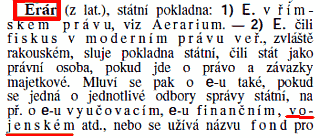

,12.10.1914
K.u.k. Militärärar is first mentioned when Švejk tells the pious teacher in Vršovice how serious it is to illegally posses military property.
The word appears again when Feldkurat Katz argues with the commander at Vojenská nemocnice na Karlově náměstí that the military owes him 150 crowns for the blessed oil and travel expenses.
Background
K.u.k. Militärärar was a term for the military treasury of Austria-Hungary, i.e. the property that belonged to k.u.k. Kriegsministerium and its property administration. The word should not be confused with Ärar, the wider term for all state property.
The term derives from Latin Aerarium militare and was considered an "Austrianism". It is no longer used in the German language, not even in Austria. See also Militärintendantur.
Quote(s) from the novel
[I.11.2] "Kvůli tomu zázraku," dodal Švejk, "můžou mít ještě vopletání. Voni koupili pohovku, a ne žádnej voltář, kterej patří vojenskému eráru.
[I.13] To byla tedy ta veliká sláva, o které mluvil Švejk. Polní kurát šel zatím do kanceláře vyřídit finanční stránku posledního pomazání a vypočítal již účetnímu šikovateli, že je mu vojenský erár dlužen na sto padesát korun za posvěcený olej a cestu.
[II.3] „U pětasedmdesátýho regimentu,“ ozval se jeden muž z eskorty, „prochlastal hejtman celou plukovní kasu před válkou a musel kvitovat z vojny, a teď je zas hejtmanem, a jeden felák, kterej vokrad erár vo sukno na vejložky, bylo ho přes dvacet balíků, je dneska štábsfeldvéblem, a jeden infanterista byl nedávno v Srbsku zastřelenej, poněvadž sněd najednou svou konservu, kterou měl si nechat na tři dny.“
Also written:C.a.k. vojenský erárcz
 | Vršovice kostel |  | |||||
| Vršovice/84, Komenského nám. - | |||||||
| |||||||
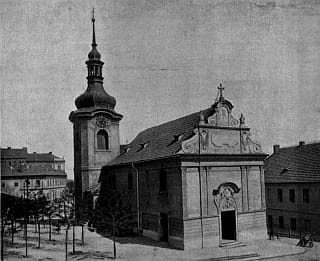
Paměti obce vršovické u Prahy, ,1902
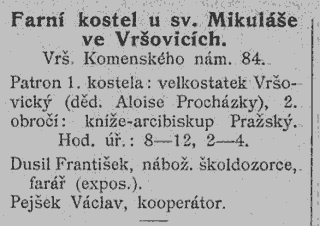
Vršovice kostel is implicitly mentioned when Švejk and Feldkurat Katz go to Vršovice to recuperate the field altar which was hidden inside the sofa Katz had sold. Two spots are mentioned: the vicarage and the sacristy.
Background
Vršovice kostel is without doubt the is a catholic church kostel svatého Mikuláše in Vršovice. It is in baroque style and was built in 1704. The vicarage is next door to the church. The address information shows that František Dusil was vicar in 1907.
Jaroslav Hašek knew this church well because he in the spring of 1912 lived in nearby Palackého třída 363 (now Moskevská 363/33). This was also where his son Richard was born on 2 May 1912. Soon after the family father left his wife and the new-born child.
Quote(s) from the novel
[I.11.2] Nakonec šli do sakristie kostela a farář vydal polní oltář pod touto zápiskou:
Přijal jsem polní oltář, který se náhodou dostal do chrámu ve Vršovicích.
Polní kurát Otto Katz
 | Firma Moritz Mahler |  | ||||
| ||||||
Firma Moritz Mahler was a Jewish enterprise from Vienna who manufactured religious artefacts, in this case the field altar of Feldkurat Katz.
Background
Firma Moritz Mahler is not found in the address book of Vienna, 1915. Suppliers of religious artefacts existed of course but in this case the name appears to be invented. Firma Moritz Löwenstein in [III.2] seems to be a variation of the same theme.
Quote(s) from the novel
[I.11.2] Slavný polní oltář byl od jedné židovské firmy, Moritz Mahler ve Vídni, která vyráběla všemožné mešní potřeby a předměty náboženské, jako růžence a obrázky svatých.
 | Břevnovský klášter |  | |||||
| Břevnov/1, Markétská ul. - | |||||||
| |||||||
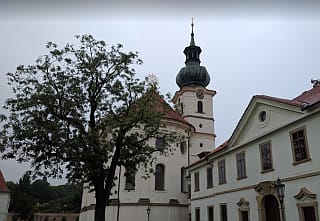
Břevnov 2016
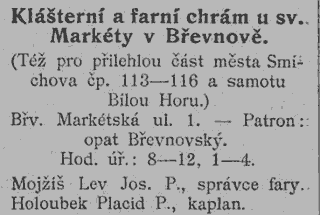
Břevnovský klášter is mentioned because Feldkurat Katz and Švejk got their equipment for the field mass here: monstrance, ciborium and a bottle of mass wine.
Background
Břevnovský klášter is a Benedictine monastery in the Břevnov district of Prague. It was founded by Saint Adalbert in 993 and was the first of its kind in Bohemia. The architectural style is baroque and hails from the 18th century.
Abbot during World War I was Lev Mojžíš, a cleric who by Jan Berwid-Buquoy has been subjected to claims that he was a notorious alcoholic and also the model for Feldkurat Katz.
In 1951 the monastery was dissolved and the premises handed over to the archive of the ministry of interior (Archiv ministerstva vnitra). In 1990 it was handed back to the Benedictine order. Today Hotel Adalbert and restaurant Klášterní šenk are (in addition to the monastery) both located on the premises.
Quote(s) from the novel
[I.11.2] Neboť ještě jeli pro sportovní kalich k nadporučíku Witingrovi a potom pro monstranci, ciborium a jiné příslušnosti ke mši do břevnovského kláštera, včetně i láhve mešního vína.
Literature



|
I. In the rear |
 | |
12. A religious debate | |||
 | Zákopníci |  | ||||
| ||||||
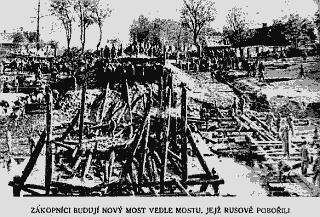
,23.7.1915

© VÚA

, 4.5.1909
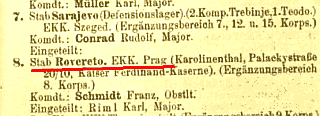
Sappeurbataillone, , 1914
Zákopníci was mentioned when the author mentions that Švejk and Feldkurat Katz carried out yet another field mass, this time for the engineering troops.
Later in the novel the engineering troops are given a face through the aggressive and ill-temperred Sappeur Vodička.
Background
Zákopníci is a Czech term for military engineering troops, literally "trench-diggers". It indicates that their role was to dig trenches but their task went well beyond that, included the building of fortifications, temporary roads and bridges.
Pioniere versus Sappeure
In k.u.k. Heer the engineering units were from 1893 organised in 15 Pionierbataillone. From 1 October 1912 these forces were reorganised by reducing the number of pioneer battalions to 8 and creating 14 Sappeurbataillone. Their area of responsibility were largely overlapping so it is hard to say which branch Hašek had in mind. Translations also diverge. The two latest English translation (Zenny Sadlon and Cecil Parrott) both interpret it as Sapper whereas both German translations use the word Pionier. Both interpretations seem acceptable.
Engineering troops in Prague
Until 1912 Pionierbataillon Nr. 3 was stationed in Prague (Ferdinandová kasárna in Karlín). In connection with the reforms that year, the three battalions were tranferred to the newly formed Sappeurbataillon Nr. 3. Only the Ergänzungsbezirk remained in Karlín as the unit were relocated to Rovereto[a].
At the front
The author probably "transferred" Feldkurat Katz's field masses from the front so in this context it's hardly relevant that there were no engineering troops in Prague in 1914. That said he surely came across them at the front during the summer of 1915 so this sequence is probably inspired by these encounters (if they are fact-based at all).
One such occasion was 20 July 1915 when pioneer company no. 8 from Pionierbataillon Nr. 10 were to assist Infanterieregiment Nr. 91 and their sister regiments in building a bridge across Bug (see General Ritter von Herbert). The attempt was abandoned due to the flooding river and that very night the regiment was ordered to urgently march to Sokal.
The good soldier Švejk in captivity
In the short novel the term sapper is used once.[1]
Zdá se opravdu, že na něho počínalo účinkovat okolí. Při obědě podařilo se 'pánu jenerálu' pomocí jiného blázna propašovat Švejkovi psaní tohoto obsahu: "Ministerstvu námořnictví byl dán rozkaz, aby bylo pohotově kdykoliv přivézti z Asie 300 000 mužů. Povolávám do zbraně všechny výzvy. 60 000 vojska hnulo se na severovýchod. Sapéři pracují na okopech dělostřeleckých."
Quote(s) from the novel
[I.12] Švejk sloužil s polním kurátem ještě jednu polní mši u zákopníků, kam byl omylem pozván ještě jeden polní kurát, bývalý katecheta, neobyčejně nábožný člověk, dívající se na svého kolegu velice udiveně, když ten mu nabízel ze Švejkovy polní láhve, kterou ten vždy nosil na takové náboženské úkony s sebou, doušek koňaku.
[II.3] Vysvětlil mu všechno dopodrobna a Vodička prohlásil, že je starej sapér a že ho nemůže opustit, a že půjdou psaní odevzdat spolu.
[II.3] "Jednou ti už takovýho kluka maďarskýho držím za chřtán v Pausdorfě, kam jsme šli my saperáci na víno, a chci mu dát jednu überšvunkem přes kokos v tý tmě, poněvadž jsme hned, jak to začlo, praštili láhví do visací lampy, a von najednou začne křičet: ,Tondo, dyť to jsem já, Purkrábek, vod 16. landvér!`
[II.3] My saperáci jsme, když to do nás vjede, potvory. My nejsme jako ty železný mouchy.
Also written:PioneersenPionieredePionerarno
Literature
| a | Schematismus für das k.u.k. Heer (s. 944) | 1914 | |
| 1 | Dobrý voják Švejk v zajetí | 1917 |
 | U zlatého věnce |  | |||||
| Karlín/161, Královská tř. 59 | |||||||
| |||||||

House No. 362 Zlatý věnec seen from Pobřezní třída
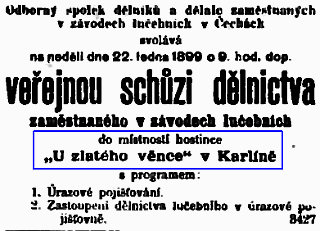
,21.1.1899
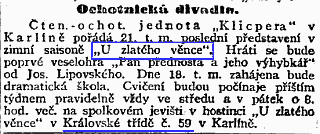
,20.4.1901
U zlatého věnce was mentioned when Švejk tells Feldkurat Katz that he dropped by and overheard a story about the man from Nová Paka who landed in trouble by handing back things he had found. This is, according to Švejk, a universally bad idea.
Background
U zlatého věnce refers to a tavern in Královská třída 59 named after the house Zlatý věnec (The Golden Wreath) in Pobřežní třída 30 that was attached to it from the back. In 1907 the owner of both buildings was Marie Holubová.
Newspaper adverts and minor notices from around the turn of the century show that there was a guest house here. The adverts announced meetings of a trade union and theatre performances so it was probably a spacious establishment. At the end of 1894 the Metal worker's trade union was founded here.
The landlord in 1892 and 1896 was Antonín Beran who already in 1884 is listed as owner of the house. In 1907 Marie Holubová is entered as owner of both house 161 and 362 but no hostelry is listed on the premises. In 1910 Josef Tichý is the landlord but in 1912 no pub is found at this address anymore.
It is not known when the tavern started operation, but it must have been before 1891. Nor do we know when the establishment closed its doors for good.
Quote(s) from the novel
[I.12] Včera jsem mluvil v hospodě ,U zlatého věnce’ s jedním člověkem z venkova, je mu už šestapadesát let, a ten šel se optat na okresní hejtmanství do Nové Paky, proč mu rekvisírovali bryčku.
Sources: Jaroslav Šerák
Also written:The Golden WreathenZum Goldenen Kranzde
Literature
- Románové restaurační a jiné zábavní podniky2009 - 2021
- Adresář královského hlavního města Prahy a obcí sousedních1884
- Adresář královského hlavního města Prahy a obcí sousedních1892
- Adresář královského hlavního města Prahy a obcí sousedních1907
- Adresář královského hlavního města Prahy a obcí sousedních1910
- Stehlíkův historický a orientační průvodce...1929
- Skupina žen při odborném spolku kovodělníků1976
- Spolky a schůze17.3.1898
- Atletic-Club
Heracles
12.3.1901 - Ochotnická divadla15.5.1901
 | Okresní hejtmanství Nová Paka |  | |||
| |||||


Seznam míst v království Českém, 1913
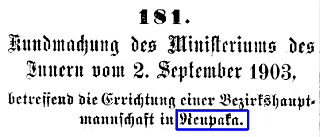
Reichsgesetzblatt, 2.9.1903
Okresní hejtmanství Nová Paka is mentioned by Švejk in anecdote he tells Feldkurat Katz. At U zlatého věnce he had spoken to a 56 year old man from the countryside who had gone to their offices to ask why his carriage had been requisitioned for war duty. Here he had been thrown out immediately.
Background
Okresní hejtmanství Nová Paka was the political administration of the Nová Paka district. It is not known exactly where the offices were located but it assumed that it was in the town centre. In 1913 the district's population number was 64,628 and consisted of the boroughs Hořice and Nová Paka. The district was relatively new, created on 1 October 1903 from areas that previously had belonged to okres Jičín and okres Pardubice.
Quote(s) from the novel
[I.12] Včera jsem mluvil v hospodě ,U zlatého věnce’ s jedním člověkem z venkova, je mu už šestapadesát let, a ten šel se optat na okresní hejtmanství do Nové Paky, proč mu rekvisírovali bryčku.
Also written:Bezirkshauptmannschaft Neupakade
Literature
 | Uršulinky |  | ||||
| Praha II./139, Ferdinandova tř. 8 | ||||||
| ||||||
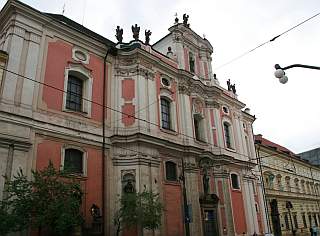
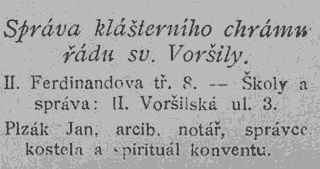
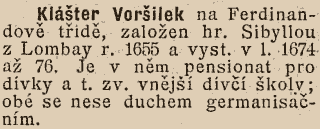
Praha, hlava království Českého
, 1901
Uršulinky is mentioned in the anecdote about the holy water of Lourdes that caused a loose stomach. Sjå Vlašim for more details.
Background
Uršulinky is the good soldier's term for Klášter Voršilek, a monastery with adjoining church in at Národní třída in Prague, until 1918 Ferdinandová třída. It belongs to the Ursuline order, a catholic organisation that is mainly preoccupied with the education of girls. It derives its name from St. Ursula. From 1958 the building complex has been under heritage protection.
The monastery was built from 1674 to 1676 and also during the Habsburg reign it provided boarding and education for girls.
Quote(s) from the novel
[I.12] Vono by jich tam patřilo víc. U uršulinek mají v klášteře lahvičku s mlékem panny Marie, kterým kojila Ježíška, a v sirotčinci u Benešova, když jim tam přivezli lurdskou vodu, dostali po ní sirotkové takovou běhavku, že to svět neviděl.“
Also written:UrsulinenklosterdeUrsula-klosteretnoU uršulinekŠvejk
Literature
 | Sirotčinec u Benešova |  | |||
| |||||
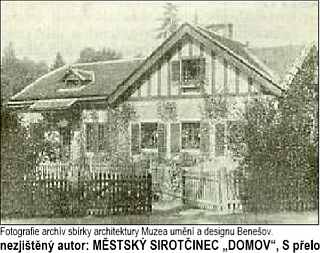
Sirotčinec u Benešova is mentioned when Švejk tells he pious field chaplain about the holy water from Lourdes that caused stomach trouble for the children at the nursery home.
Background
Sirotčinec u Benešova surely refers to the home for parentless children in Benešov, "Domov". It was built around the turn of the century, was owned by the town, and seems to have been located below Konopiště castle.
Quote(s) from the novel
[I.12] U uršulinek mají v klášteře lahvičku s mlékem Panny Marie, kterým kojila Ježíška, a v sirotčinci u Benešova, když jim tam přivezli lurdskou vodu, dostali po ní sirotkové takovou běhavku, že to svět neviděl."
Sources: Muzeum umění a designu Benešov
Literature
 | U Piaristů |  | ||||
| Praha II./892, Panská ul. 1 | ||||||
| ||||||
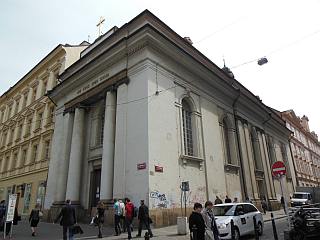

U Piaristů is mentioned by the pious (and drunk) field chaplain when he asks his colleague Feldkurat Katz if he doesn't believe that the thumb of John the Baptist is found in this church.
Background
U Piaristů is a colloquial term for Kostel svatého Kříže, a monastery with church and a school located at the corner of Na Příkopě og Panská ulice that until 1912 belonged to the Piarist order. They are a Catholic educational order founded in 1617 in is the oldest of its kind. Their main purpose is to provide free education for poor children.
The church which is built in a classical style was constructed between 1816 and 1824. Amongst those who studied here was Vrchlický.
After the introduction of a new school law in 1869 the state took over and one part became a gymnasium (German) and the other a teacher's institute. In 1912 the Piarists finally sold the building. Today the church is run by the catholic institute Society of St. Francis de Sales (Salesians of Don Bosco).
It was on the street corner by this church that Oberleutnant Lukáš was to meet a lady, when on a walk with the dog Fox, he unfortunately bumped into Oberst Kraus. We already know the end of that story.
Quote(s) from the novel
[I.12] Mžouraje očima, otázal se Katze: „Vy nevěříte v neposkvrněné početí panny Marie, nevěříte, že palec sv. Jana Křtitele, který se chrání u piaristů, je pravý? Věříte vůbec v pána boha? A když nevěříte, proč jste polním kurátem?“
Literature



|
I. In the rear |
 | |
13. Švejk goes to provide the last rites | |||
 | Vojenská nemocnice na Karlově náměstí |  | ||||
| Praha II./504, Karlovo námestí 39 | ||||||
| ||||||
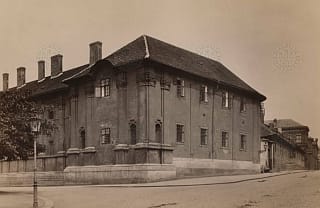
(11.6 1907) Pohled na nároží domu čp. 504 na Karlově náměstí (kolej novoměstských jezuitů - kasárna grenadýrů - vojenská nemocnice) na Novém Městě. Vpravo část ulice U Nemocnice.
© AHMP

Vojenská nemocnice na Karlově náměstí was the destination of Švejk and Feldkurat Katz's mission to administer the last rites to the severely wounded.
Background
Vojenská nemocnice na Karlově náměstí refers to c.a.k vojenská nemocnice č. 11 (k.u.k. Militärspital Nr. 11) in Prague, a military hospital located at the southern end of Karlovo náměstí. Today the building is used by the university hospital (Všeobecná fakultní nemocnice v Praze).
A significant number of the locations mentioned in the first part of The Good Soldier Švejk and in anecdotes throughout the novel are located within 10 minutes walk from the hospital, including U kalicha. The author lived in this area for the first 20 years of his life, and frequently also later in life. He graduated both from gymnasium and the commercial academy only a few hundred metres from here.
The military hospital where Švejk spent time as a malingerer in [I.8] was a branch. See Vojenská nemocnice Hradčany.
Quote(s) from the novel
[I.13] Potom přečetl polní kurát ještě jednou předpis, ve kterém se mu oznamuje, že zítra má jít na Karlovo náměstí do Vojenské nemocnice zaopatřovat těžce raněné.
Also written:Military hospital at Charles squareenMilitärspital am KarlsplatzdeMilitærsjukehuset på Karlsplassenno
Literature
 | Kostel svátého Ignáce |  | ||||
| Praha II./505, Ječná ul. 2 | ||||||
| ||||||
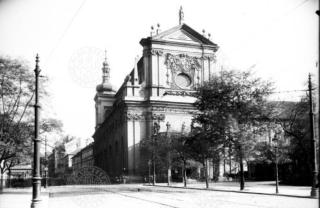
Pohled na kostel sv. Ignáce na Karlově náměstí, vpravo Ječná ulice. 24.10.1907.
© AHMP
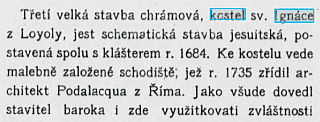
, 9.5.1913
Kostel svátého Ignáce is mentioned first time by Feldkurat Katz in a conversation with Švejk when he reveals that he many years ago performed a mass for military personnel here.
Later on the church appears in the description of Oberst Kraus and in the story about gas worker Zátka on the gas works at Letná [II.5] where Father Jemelka held a sermon.
The third mention is in an anecdote in the final chapter.
Background
Kostel svátého Ignáce is a church at the corner of av Ječná ulice and Karlovo náměstí which today serves as the main seat of the Jesuit order in Czechia. It is named after the founder of the order: Ignatius of Loyola. Construction started in 1665 and was completed in 1699.
Hašek and St. Ignatius
Jaroslav Hašek knew the church very well. Václav Menger tells us that he was ministrant (altar server) there during the 2nd last year at primary school (i.e. when he was around 9 years old). His knowledge of Catholic liturgy is no doubt in part due to this experience.
Quote(s) from the novel
[I.13] Znal tu pakáž, jak ji nazýval, z chrámu od Ignáce, když před léty tam míval kázání pro vojsko. Tenkrát ještě vkládal do kázání mnoho a „Sdružení“ sedávalo za plukovníkem.
[I.15] Byl při své tuposti neobyčejně nábožný. Měl doma v bytě domácí oltář. Chodil často ke zpovědi a k přijímání k Ignáci a od vypuknutí války modlil se za zdar zbraní rakouských a německých.
[II.5] A potom,“ řekl Švejk tiše, „to s tím Zátkou po čase skončilo moc špatně. Dal se do Mariánský kongregace, chodil s nebeskýma kozama na kázání pátera Jemelky k svatýmu Ignáci na Karlovo náměstí a zapomenul jednou zhasnout, když byli misionáři na Karláku u svatýho Ignáce, plynový svítilny ve svým rayoně, takže tam hořel po ulicích plyn nepřetržitě po tři dny a noci.
Sources: Václav Menger
Literature
 | Militärintendantur |  | ||||
| Praha III./258, Malostranské nám. 15 | ||||||
| ||||||
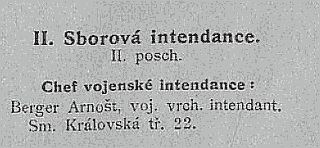
,1907

, 1914
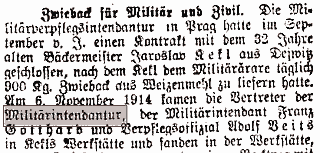
,8.1.1915
Militärintendantur is mentioned by Feldkurat Katz when he says that the army's administrative department apparently doesn't supply holy oil consecrated by a bishop.
Background
Militärintendantur was the administrative body of k.u.k. Heer who's task was to supply the army and perform accounting. The main office was located in Vienna, but here one no doubt refers to their branch by 8th army corps in Prague. The offices were located at the second floor of the Lichtenstein Palace in Malá Strana. See Korpskommando and k.u.k. Militärärar.
The army administrative authority is also the centre of a story by Jaroslav Hašek from 1910, Čáka pěšáka Trunce (The parade helmet of infantryman Trunec). Here it is the head office in Vienna that has to find suitable headgear for Trunec's enormous head. The main office was located in the building of k.u.k. Kriegsministerium to which it also reported.
Quote(s) from the novel
[I.13] Po těchto filosofických úvahách polní kurát umlkl a řekl: „Potřebujeme tedy olej posvěcený od biskupa. Tady máte 10 korun a kupte lahvičku. Ve vojenské intendantuře patrně takový olej nemají.“
Also written:Vojenská intendanturacz
Literature
- Čáka pěšáka TrunceJaroslav Hašek12.10.1910
 | Firma Polák |  | ||||
| Praha I./1085, Soukenická ulice? 4 | ||||||
| ||||||

, 1910

,30.7.1914
Firma Polák was the paint store in Dlouhá třída where Švejk bought Hampseed oil no. 3 for use when giving the last rites. The store was most probably named after the owner. The employee who served the good soldier was Mr. Tauchen.
Background
Firma Polák has not been possibly to identify uniquely although the author locates it in Dlouhá třída. According to the address book of 1910 there was only one outlet in Dlouhá třída that corresponds to the description in the novel, but the owner was Ferdinand Adler. The shop was located in Dlouhá 732/39.
In Soukenická ul. 1085/4, 100 metres to the east, a firm A. J. Pollak had a shop that also traded in oils and paints. It is probably this establishment that the author had in mind as it was located at the western end of Soukenická where it joins Dlouhá. The proprietor in 1910 was Emil Pollak (1848-1914), a Jewish merchant.
The firm Jakub Pollak were located in Dlouhá no. 45 but they were book-binders and would therefore be an unlikely candidate.
Quote(s) from the novel
[I.13] V druhé chtěli telefonovat na ochrannou stanici a ve třetí mu řekl provisor, že firma Polák v Dlouhé třídě, obchod olejem a laky, bude mít rozhodně žádaný olej na skladě.
[I.13] Firma Polák v Dlouhé třídě byla opravdu firma agilní. Nepustila žádného kupce, aby neuspokojila jeho přání. Chtěl-li balsám kopaivu, nalili mu terpentýn a bylo také dobře.
[I.13] „Tak už máme volej,“ řekl slavnostně Švejk, když se vrátil od firmy Polák, „konopnej volej čís. 3, první kvality, můžeme s ním namazat celej batalion. Je to solidní firma. Prodává taky laky, fermež a štětce. Ještě potřebujeme zvoneček.“
Literature
 | Sdružení šlechtičen pro náboženskou výchovu vojáků |  | ||||
| ||||||

Brünner Zeitung, 23.10.1899

,10.9.1903
Sdružení šlechtičen pro náboženskou výchovu vojáků was the Association of nobility ladies for the religious education of soldiers who were to be present when Feldkurat Katz administered the last rites at Vojenská nemocnice na Karlově náměstí the day after Švejk and he first visited. The association consisted of hysterical old ladies.
Background
Sdružení šlechtičen pro náboženskou výchovu vojáků has not been possible to identify. There is no such or similar organisation listed in the 1910 address book and is probably an invention by the author.
Still there existed other organisations where ladies from the nobility were involved, mainly within charitable work. This could be contributing funds for hospitals, support for war veterans, wounded soldiers, widows and orphaned children.
During the war newspapers and magazines often featured ladies from the nobility on hospital visits and it could have been these that inspired the author to write this passage (and the similarly themed visit of Baronesse von Botzenheim to Vojenská nemocnice Hradčany).
Quote(s) from the novel
[I.13] Potom přišel ordonanc a přinesl paket, ve kterém se polnímu kurátovi oznamuje, že zítra bude při zaopatřování v nemocnici přítomno Sdružení šlechtičen pro náboženskou výchovu vojáků.
Also written:Vereinigung adeliger Damen zur Pflege der religiösen Erziehung der SoldatenBrousekAssociation of Noblewomen for the Religious Education of SoldiersSadlon
Literature
 | U Křížků |  | |||||
| Karlín (?) | |||||||
| |||||||
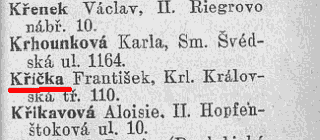
U Křížků is mentioned once because Švejk went here to steal a bell for the journey to give the last rites. It is also stated that it is a roadside inn and that Švejk was back in half an hour.
Background
U Křížků was a hospoda which is unclear where was located. The novel states that Švejk used half an hour to steal the bell so it must have been within easy walking distance from Karlín. The text of the novel limits it further: it was a zajezdní hospoda (coaching inn) so is likely to have been located on a former approach road.
The place that best fit these criteria is no doubt the pub of František Kříčka which in the address book of 1910 is listed as Královská třída 110. This is both on a main road and well within walking distance from Feldkurat Katz's flat. Named after the owners(s) it would have been called U Kříčky/U Kříčků, but this type of minor error is far from uncommon in The Good Soldier Švejk.
Jaroslav Šerák mentions five other alternatives but further away, see web-link. But it should be notet that neither Kříčka nor those five are listed as coaching inns in the address book, so could the autor have mixed it up with some other place? The coaching inn U města Hamburku, which is located on the same street, could be a candidate.
Quote(s) from the novel
[I.13] Obdržev svolení, Švejk přinesl za půl hodiny zvonek. „Je od vrat zájezdní hospody ,U Křížků,’“ řekl, „stál mne pět minut strachu a dlouho jsem předtím musel čekat, poněvadž se pořád trousili lidi.“
Literature
- Románové restaurační a jiné zábavní podniky2009 - 2021
 | Militärgeistlichkeit |  | |||
| Wien VIII., Skodagasse 19 | |||||
| |||||

Besuch des Apostolischen Feldvikars Bjelik, 1916.

Zdeněk M. Kuděj
© LA-PNP
Militärgeistlichkeit is mentioned when Feldkurat Katz reads a directive from k.u.k. Kriegsministerium regarding restrictions on giving the last oil.
Later in the chapter the institution is referred to with contempt by the persistent money-lender when he complains to skriven about military clerics. Feldkurat Katz has just popped out to a café just as the money lender appears at the door to claim his dues.
Background
Militärgeistlichkeit was a collective term for the military clergy of Austria-Hungary. It included Catholic (the largest), Jewish, Greek-Orthodox, Muslim and Protestant. The institution reported to k.u.k. Kriegsministerium. To every division was assigned one divisional field chaplain and one field chaplain and each regiment was assigned one field chaplain. Serving in this role at Infanterieregiment Nr. 91 was Jan Eybl, he was at the regiment from 1 January 1914 to 24 April 1918.
Head of the military clergy from 1911 to 1918 was Emmerich Bjelik. His title was the resounding Apostolischer Feldvikar. Bjelik knew one of the models for figures in The Good Soldier Švejk, namely Ludvík Lacina. Another person who knew Bjelik was Zdeněk Matěj Kuděj who for a period served at the Feldvikariat in Vienna. It may well be that Jaroslav Hašek drew inspiration for some of his field chaplains from what Kuděj told him. The two authors met several times during the period the novel was written.
The institution of military clergy plays a prominent role in The Good Soldier Švejk and it is probably the authority that is subjected to the most stinging satire of them all. Already in [I.11] the author dedicates a complete sub-chapter to an attack on military clergy as a world phenomenon. Later the object of scorn is solely the Catholicy field clergy in Austria-Hungary. The field chaplains Katz, Martinec, Lacina and their pious colleague in [I.12] are either drunkards (and immoral) and those who are not soon slide into debauchery. Feldoberkurat Ibl is however only mentioned briefly, but as an idiotic preacher.
Lacina and to a lesser degree Feldoberkurat Ibl are both inspired by living persons - Ludvík Lacina and Jan Eybl respectively. Feldkurat Martinec and Feldkurat Katz have no obvious link to any existing persons and no field chaplains with these names are listed in Schematismus from 1914. The marginal Feldkurat Matyáš could however have been inspired by a real person. See Link A. Jaroslav Hašek definitely knew Eybl from his time in IR. 91 in 1915, and it is very likely that he also knew Lacina in person.
Quote(s) from the novel
[I.13] Ministerstvo ruší po dobu války platné předpisy týkající se zaopatřování vojínů posledním pomazáním a ustanovuje tyto pravidla pro vojenské duchovní:
Also written:Military ClergyenVojenské duchovniczMilitærgeistlegheitno
Literature
 | U Exnerů |  | |||||
| Libeň/457, Královská tř. - | |||||||
| |||||||
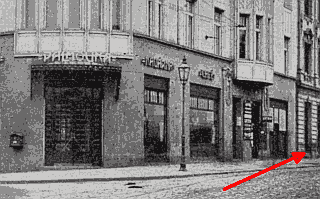
The building that Exner had erected in 1909 and 1910 and where he lived from then on. The pub can be seen to the right.
,20.5.1910

,1896
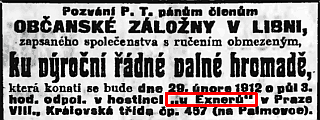
,23.2.1912
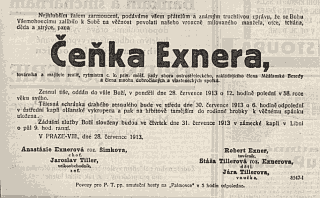
,29.7.1913
U Exnerů is mentioned by Švejk in an anecdote he tells in order to put the persistent money-lender in his place. The soldier tells the uninvited guest about some Boušek from Libeň who was thrown out from this pub repeatedly but still came back time after time.
Background
U Exnerů was a restaurant that existed at least until 1939. It was located on the corner of Primátorská and Královská třída in Libeň. In the address books from 1896, 1907 and 1910 it is listed under the name Na Palmovce.
U Exnerů was also been used for organised meetings and events; in 1915 it is mentioned in the newspaper in connection with charities, for instance for poor children. It existed under the name U Exnerů at least until 1940. Today it is a Chinese restaurant.
Čeněk Exner
U Exnerů was named after local entrepreneur and owner of the property Čeněk Exner (10 July 1855 - 28 July 1913). The owner of the property never managed the restaurant, the pub landlord in 1910 was Karel Klapa. Exner, born in Vrchlabí in the Krkonoše mountains, was the proprietor of a meat company (smoked meat) and owned real estate. In 1890 he founded the enterprise in Karlín and moved it to Libeň in 1897. He was married to Anastazie, had two children and also grandchildren. He was also active in Sokol and other organisations
From 1897 to 1910 the family lived in the same building as the pub and the firm, then they moved to number 890 next door. This was an Art Deco building that he had built in 1909 and 1910 as a wedding present to his daughter Anastazie. Exner suffered a tragic end to his life: newspaper notes reveal that he committed suicide in 1913 by hanging himself in the bathroom. The reason was supposedly financial problems.
Quote(s) from the novel
[I.13] „Poslušně hlásím, pane feldkurát,“ poznamenal Švejk, „že je to hotovej nezmar, jako nějakej Boušek z Libně. Vosumnáctkrát za večer ho vyhodili od ,Exnerů’, a vždycky se jim tam vrátil, že tam zapomněl fajfku.
Literature
- Adresář královského hlavního města Prahy a obcí sousedních (1910)
- Soupis pražských domovských příslušníků 1830-1910 (1920)
- Románové restaurační a jiné zábavní podniky2009 - 2021
- Vycházka Libní
- Zapsané firmy13.1.1890
- Změny při firmách2.1.1897
- Oběsil se v koupelně20.11.1902
- Změny držebnosti10.6.1908
- Novostavvby v nových Čtvrtích pražských20.5.1910
- Oběsil se v koupelně30.7.1913
- U Exnerů...
 | Mariánská kongregace |  | ||||
| Praha II./1354, Ve Smečkách 32 | ||||||
| ||||||
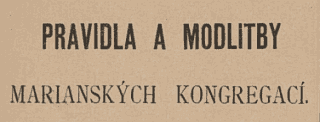
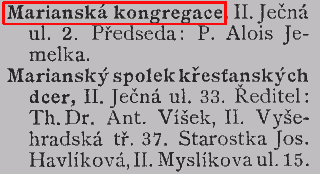
Adresář královského hlavního města Prahy, 1896
Mariánská kongregace is mentioned when Feldkurat Katz and Švejk are on the way to Vojenská nemocnice na Karlově náměstí to administer the last rites. In Vodičkova ulice a female custodian and member of the congregation runs after their horse cart to get blessed but complains how fast they ride.
Background
Mariánská kongregace (lat. Congregatio Mariana) is a Roman-Catholic educational institution, established by the Jesuit father Jean Leunis in 1563 and always associated with the Jesuit order.
The Prague section of the society was founded 28 April 1892. In 1896 the institution was located in Ječná ulice 505/2 (see kostel svátého Ignáce), with father Father Jemelka as chairman. In 1907 and 1910 the address was Ve Smečkách 1354/32, not far from Vodičkova ulice (where Feldkurat Katz and Švejk drove past in their horse cab). The building no longer exists and the site is used by Hotel Fenix.
Quote(s) from the novel
[I.13] A Švejk do toho zvonil, drožkář sekal bičem dozadu, ve Vodičkové ulici nějaká domovnice, členkyně mariánské kongregace, klusem dohnala drožku, dala si v jízdě požehnat, pokřižovala se, odplivla si poté: "Jedou s tím pánembohem jako všichni čerti! Člověk aby dostal souchotiny!" a vracela se udýchána na své staré místo.
Also written:Marianische KongregationdeCongregatio Marianala
Literature
 | K.u.k. Dragoner |  | |||
| Karlín/8, Za Invalidovnou - | |||||
| |||||

,4.9.1914

,1914

,1912
K.u.k. Dragoner is mentioned by Feldkurat Katz when he argues with the commander at Vojenská nemocnice na Karlově náměstí about compensation the cost of blessed oil and also travel expenses. The field chaplain argues that when an officer from the Dragoons go to a stud farm for a horse he is paid subsistence.
Background
K.u.k. Dragoner was the term for some of the cavalry units in the Austrian part of the Dual Monarchy. In total there were 15 Dragoon regiments in k.u.k. Heer, mostly from the German- and Czech-speaking areas of the empire. The organisation of the cavalry in Austria-Hungary was quite complex - in addition to the Dragoons there were also Ulans and Hussars.
In The Good Soldier Švejk the reference is surely to a local Dragoon regiment, and such a regiment actually existed: Dragonerregiment Nr. 14. From 1912 the 2nd and 5th squadron were garrisoned in the barracks behind Invalidovna in Karlín (now U Sluncové 6). The staff was located at Brandys nad Labem, and the rest of the regiment in Stará Boleslav and Dobřany. The recruitment area was No. 8, see Korpskommando. The recruitment command itself was located in Klatovy.
Several Dragoon regiments were recruited from the district of 8. Korpskommando and over the years other regiments were located in Karlín. In 1906 Dragonerregiment Nr. 13 occupied the same premises behind Invalidovna as Dragonerregiment Nr. 14 did from 1912.
Quote(s) from the novel
[I.13] Potom následoval spor s velitelem nemocnice a polním kurátem, přičemž polní kurát několikrát udeřil pěstí do stolu a vyjádřil se: "Nemyslete si, pane hejtmane, že je poslední pomazání zadarmo. Když důstojník od dragounů je komandýrován do hřebčince za koňma, tak se mu také platí diety. Opravdu lituji, že se ti dva posledního pomazání nedočkali. Bylo by to o padesát korun dražší."
Also written:DragoonsenDragounyczDragonarno
Literature
- Z kruhů vojenských7.4.1912
 | K.u.k. Generalstab |  | |||
| Wien I., Stubenring 1 | |||||
| |||||
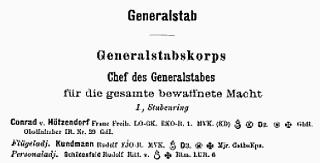
, 1914
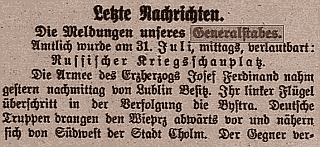
,5.8.1915
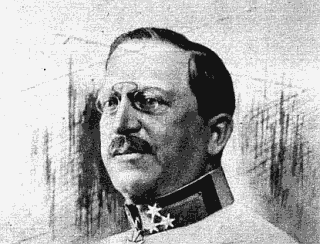
General Arthur Arz
,11.3.1917
K.u.k. Generalstab is mentioned in a conversation at Vojenská nemocnice na Karlově náměstí where a soldier relates about a clerical member of parliament who before the war talk about God and his love for peace and harmony between humans. After the outbreak of war the tone however changed, and now he talked about God as if he was Chief of General Staff.
The General Staff is mentioned again through the pondering of Oberleutnant Lukáš when he is on the disastrous walk with Max, and also during Kadett Biegler's dream on the train to Budapest. A painting of Chief of Staff Feldmarschall Conrad decorates the wall at k.u.k. Gottes Hauptquartier.
Background
K.u.k. Generalstab was an institution that in times of war or times of a threatening war was responsible for planning, execution and supervision of military operations. General Staff formally belonged to k.u.k. Kriegsministerium and was located in the same building.
The Royal and Imperial General Staff existed from 1867 to 1918 but the institution was already in place long before Ausgleich split the Habsburg empire into two parts of equal standing.
Chief of staff from 1912 to 1917 was Feldmarschall Conrad. He was demoted by the new emperor Karl I. and replaced by infantry general Arthur Arz von Straußenburg who was to become the last ever Chief of Staff at k.u.k. Generalstab (picture to the right).
General staff officers were permanently present at major military units; at district, divisional and brigade level.
Quote(s) from the novel
[I.13] A vida ho, vola, jakmile vypukla válka, ve všech kostelích se modlí za zdar zbraní a o pánubohu se mluví jako o nějakém náčelníkovi jenerálního štábu, který tu vojnu řídí a diriguje. Z téhle vojenské nemocnice už jsem viděl pohřbů, a uříznutých noh a ruk vozí odtud vozy.
[I.15] Zatraceně, proč ministerstvo vojenství dává takové věci do školního programu. To je přece pro dělostřelectvo. A jsou přece mapy jenerálního štábu.
[III.1] Uprostřed pokoje, ve kterém po stěnách visely podobizny Františka Josefa a Viléma, následníka trůnu Karla Františka Josefa, generála Viktora Dankla, arcivévody Bedřicha a šéfa generálního štábu Konráda z Hötzendorfu, stál pán bůh.
Also written:Royal and Imperial General StaffenC.a k. generální štábcz
Literature



|
I. In the rear |
 | |
14. Švejk as military servant to senior lieutenant Lukáš | |||
 | Stoletá kavárna |  | ||||
| Praha II./267, Na Zderaze 10 | ||||||
| ||||||
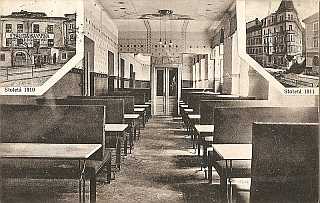

,1.12.1908

,28.6.1909

, 1907
Stoletá kavárna is mentioned in Švejk's long anecdote that he tells Feldkurat Katz after the latter had played away his servant at cards. The game took place in a "hospoda" behind Stoletá kavárna and at the centre of events was the old plumber tinsmith Vejvoda.
Background
Stoletá kavárna was a café with address Na Zderaze in Nové město that existed from some time before 1887, but we don't know with certainty when it started and when it ceased operation. Early adverts show a certain Slavík as landlord. In 1908 these small adverts reveal that the landlord is Antonín Kolář and the address book from 1907 confirms him also as the owner of the building. See also Hospoda za Stoletou kavárnou.
In 1909 the old building was demolished and a new one erected on the premises. Jaroslav Hašek surely knew both versions of the café, but the time of tinsmith Vejvoda was probably before the rebuild. In 1914 they advertised for a piano player, the place was also a dance- and concert establishment. In 1915 the building changed hands after a bankruptcy and in 1916 it is referred to as the former café. By 1918 it appears to have reopened and in 1920 the landlord was B. Michálek. On the present building the inscription "Stoletá kavárna" is still visible.
Quote(s) from the novel
[I.14.1] „A bylo v banku hodně?“ otázal se Švejk klidně, „nebo jste málokdy dělal forhonta? Když nepadá karta, je to velmi špatný, ale někdy je to mizerie, když to jde až příliš dobře. Na Zderaze žil nějakej klempíř Vejvoda a ten hrával vždy mariáš v jedné hospodě za ,Stoletou kavárnou’. Jednou taky, čert mu to napískal, povídá: ,A což abychom si hodili jedníka o pětníček.’
[I.14.1] Kominickej mistr byl už do banku dlužen přes půldruhého miliónu, uhlíř ze Zderazu asi milión, domovník ze Stoletý kavárny 800 000 korun, jeden medik přes dva milióny.
Also written:Century CaféenHundertjähriges kaffeehausde
Literature
- Románové restaurační a jiné zábavní podniky2009 - 2021
- Slavíkova stoletá kavárna15.3.1889
- Athletickí představeni v stoleté kavárně14.12.1901
- Stoletá kavárna1.12.1908
- Pp. podníkatelům staveb10.2.1910
- Pianista10.1.1914
- Exekuční dražba "Stoleté kavárny"27.4.1915
- Byvala "Stoletá kavárna"20.6.1916
- Stoletá kavárna, nejstarší zabavní podník7.9.1918
- Stoletá kavárna a vinárna27.8.1921
- Jak to byloJosef Vejvara13.1.1931
- Z pražských katakomb (s. 212-235)1903
 | Hospoda za Stoletou kavárnou |  | ||||
| Praha II./261, Na Zbořenci 7 | ||||||
| ||||||
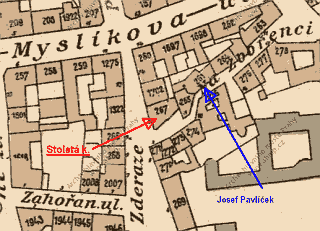

Hospoda za Stoletou kavárnou is mentioned in Švejk's long anecdote that he tells Feldkurat Katz after the latter had played away his servant at cards. The gambling party took place in a "hospoda" behind Stoletá kavárna and at the story was centered around old tinsmith Vejvoda.
Background
Hospoda za Stoletou kavárnou was most probably an inn that belonged to Josef Pavlíček. The pub was located at Na Zbořenci No. 7, two houses up the street from Stoletá kavárna. cook Pavlíček also owned the building, he bought it at a bankrupcy auction in 1904.
Quote(s) from the novel
[I.14.1] „A bylo v banku hodně?“ otázal se Švejk klidně, „nebo jste málokdy dělal forhonta? Když nepadá karta, je to velmi špatný, ale někdy je to mizerie, když to jde až příliš dobře. Na Zderaze žil nějakej klempíř Vejvoda a ten hrával vždy mariáš v jedné hospodě za ,Stoletou kavárnou’. Jednou taky, čert mu to napískal, povídá: ,A což abychom si hodili jedníka o pětníček.’
Also written:Pub behind the "Century Café"enKneipe hinter dem "Hundertjährigen Kaffeehaus"de
Literature
 | Prager Einjährig-Freiwilligenschule |  | |||
| |||||
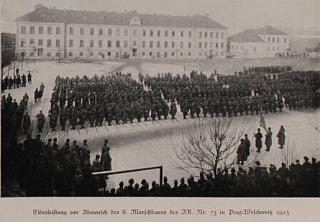
The barracks of IR73 in Vršovice. Was it here that Lukáš trained One Year Volunteers?
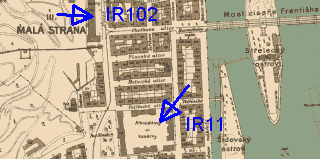
The barracks of IR 11 and IR 102
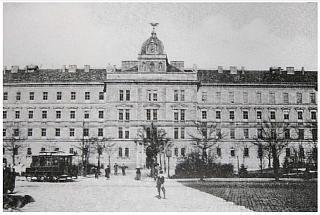
Albrechtova kasárna, Smíchov. Here Sagner served as instructor at the reserve-officer school of IR 11 in February 1915
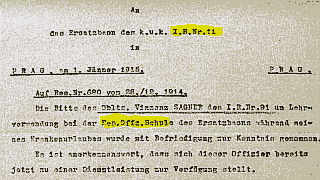
Sagner at the IR 11 reserve officer's school. © VÚA
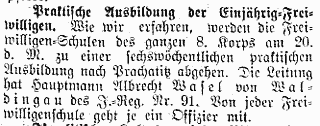
Pilsner Tagblatt, 15.4.1914
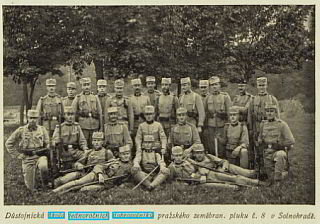
,17.9.1915
Prager Einjährig-Freiwilligenschule was the school where Oberleutnant Lukáš was an instructor at the time he met Švejk. This is revealed when the author introduces Lukáš to the reader. The officer even tells his students: "Let us be Czechs but nobody needs to know about it. I am also Czech". The author also adds that all the students at the school were Czechs.
The school is also mentioned later, for instance when he tells hop trader Wendler what he is doing and about his future plans.
Background
Prager Einjährig-Freiwilligenschule is the author's term for some reserve officer's school in Prague. These schools belonged to the individual regiments, but as it is never revealed at which regiment Oberleutnant Lukáš served, it is impossible to know where the school was located. The next step in the investigation is therefore to look at which infantry regiments still had staff functions located in the city in the winter of 1914-15. Those were Infanterieregiment Nr. 11, IR73 and IR102 and Lukáš surely served as an instructor with one of these (that he was transferred from k.k. Landwehr is unlikely).
Conflicting traces
The description of the later dog theft does give some indication to where the school was located. Blahník dragged Fox in the direction of Vršovice, so it is logical to think that Oberleutnant Lukáš lived there. Coupling this with the fact that Katy Wendler walked together with Švejk to the barracks where the officer taught, indicates IR73 and Vršovice kasárna.
One should however be careful with taking the geographical logic of the plot literally. Later there is the episode where Oberleutnant Lukáš went for a walk with the recently stolen dog Fox. He bumped into the real owner of the dog, Oberst Kraus at Na Příkopě. This suggests that the officer lived for closer to the centre. Walking the dog all the way from Vršovice (3.5 km) seems improbable. In addition the author mentions that the students at the one-year volunteer schools were Czechs, whereas IR73 was a regiment where the overwhelming majority were Germans.
On the other hand the barracks of IR102 and Infanterieregiment Nr. 11 were located much closer (2 km), in Malá strána and Smíchov respectively. So if Oberleutnant Lukáš lived within walking distance of one of these he wouldn't have had to walk that far to get to Na Příkopě.
The literary figure Lukáš partly inspired by the real Sagner?
The discussion about which school/regiment Oberleutnant Lukáš instructed at is highly hypothetical because it is difficult to connect this part of the plot to any real persons or contemporary events. The author still hadn't aligned the story in the novel to that of his own career in k.u.k. Heer like he did from Part Two and onwards. Lukáš' main real life prototype, Rudolf Lukas, never served in Prague between 1911 and 1919. He did however teach one-year volunteers, but this was in Budějovice in 1911-12 and again in the autumn of 1914, that is before he met Jaroslav Hašek. Lukas served his entire career in k.u.k. Heer with IR. 91 so he could not have been transferred there like his literary counterpart was.
Inspiration for his role as an instructor must therefore originate somewhere else, perhaps from some other officer hew knew. These could have been several, for instance Josef Adamička, but similarities with Čeněk Sagner springs to the fore. After a period of recuperation in Prague he volunteered as an instructor at Infanterieregiment Nr. 11 while still being officially on sick leave. He started in this role on 25 January 1915 but because it was against the rules to serve at another regiment, he was called back to IR. 91 in Budějovice on 28 February 1915. Here he was appointed commander of the First Replacement Company..
At the time Jaroslav Hašek served with this very compnay and was also a student at the regiment's reserve officer's school. He therefore probably knew about Čeněk Sagner's position in Prague and also his transfer. A few more details about Oberleutnant Lukáš also fit better with Sagner than with Rudolf Lukas: Sagner was Czech and he is known to have stood up for the Czechs in k.u.k. Heer. On the contrary oberleutnant Lukas was an ethnic German. Exactly like the literary figure Lukáš, Sagner was educated at Prager Infanteriekadettenschule, whereas Lukas was not. Thus we have three details on Lukáš that could have been inspired by Sagner but could NOT have been derived from Lukas.
About one-year volunteers and reserve officer's schools
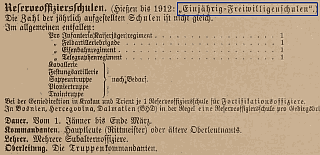
Heerwesen, , 1916
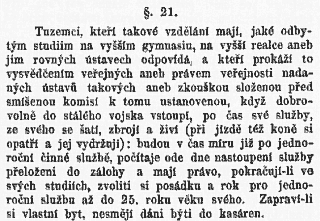
, daný dne 5. prosince 1868

, 1972
© LA-PNP
One-year volunteer was an entitlement given to young men with middle and higher education. They had the option to serve for one year instead of the compulsory three (since 1912 two years), providing they paid for their own equipment. The system was created in 1868 modelled after Prussia and was functioning until 1918. The motive was that it would save the state money and wouldn't unduly damage the careers of the recruits. The "volunteer" part was also that soldier could (but didn't have to) attend a course to become a reserve officer during his term of service. Those who didn't pass the reserve officer's exam had to serve another year, but this duty was abolished in 1912. The one-year volunteer could also apply to serve outside his home unit, but this was only granted when the manpower situation of the units in questions allowed it.
The one-year volunteer was expected to buy his own equipment whereas k.u.k. Militärärar provided accommodation (if the soldier wanted). Eligibility depended on the recruit having completed the eight-year middle school (gymnasium, "Realschule", teacher's academy, commercial academy or similar). It was up to the candidate to apply for the right as a one-year volunteer, and everyone had to pass an exam. Someone who was sentenced for property crimes or immorality automatically lost the right to serve for one year.
Thus Reserveoffizier-Schulen was an institution that educated one-year volunteers to become reserve officers. It may first appear that Jaroslav Hašek is wrong in using the terms "one-year volunteer school" or "school for one-year volunteers", but this is not the case. Until the army reforms of 1912, the schools were officially called Einjährig-Freiwilligenschule. Obsolete terms generally stick for years after the change has taken place (see for instance Salmova ulice).
Quote(s) from the novel
[I.14.3] Mluvil ve společnosti německy, psal německy, četl české knížky, a když vyučoval ve škole jednoročních dobrovolníků, samých Čechů, říkal jim důvěrně: „Buďme Češi, ale nemusí o tom nikdo vědět. Já jsem taky Čech.“
[I.14.5] „Zažádal jsem o přeložení k 91. pluku do Budějovic, kam asi pojedu, jakmile budu hotov se školou jednoročáků.
[I.15] Ukončiv vyučování ve škole jednoročních dobrovolníků, vyšel si nadporučík Lukáš na procházku s Maxem.
| 1. | An example is the article about Jaroslav Hašek in Spanish Wikipedia. Unfortunately this article also contains many other factual errors. |
Literature
- Jednoroční dobrovolníci rakousko-uherské armády
- Jednoroční praesenční služba vojenská1910
- Der k.k. Einjährig-Freiwillige des stehenden (Gemeisamen) Heeres und Landwehr
- Zákon branný1869
- Reserveoffiziere Hugo Schmied1916
- Einjährig-Freiwilligen-Recht22.5.1912
- Officer Aspirant Insignia in the k.u.k. Army/k.k./k.u. Landwehr 1867-19182001 - 2016
 | Pohodnice Pankrác |  | ||||
| Dvorce/37, Na Dvorci | ||||||
| ||||||
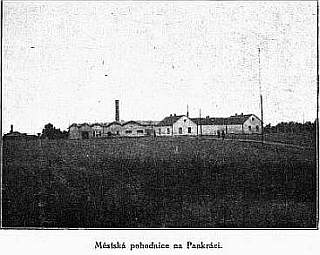
"Prahou tisíciletou z dávna i dneška", Josef Veselý, 1926
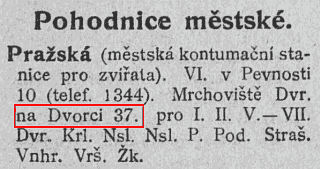
Pohodnice Pankrác is mentioned when the author relates how unfortunate Oberleutnant Lukáš had been with his servants. One of them had sold the senior lieutenant´s dog to the knacker at Pankrác.
Background
Pohodnice Pankrác was a "knacker's yard", i.e. a station for disposal of animal carcasses. It was also called a "Thermochemical station". The animal remains were mostly boiled to make fertilizers, bone flour and other residual products. Those were often used as ingredients in soap and glue. The enterprise was also allowed to collect dogs, cats and other stray animals from the eastern bank of the Vltava (a similar enterprise in Břevnov catered for the western bank). Prague city at the time defined stray dogs as "an animal that walked on its without a muzzle". The enterprises were licensed by the city, but privately owned and managed.
The dogs were kept in a quarantine station at Vyšehrad until their owner reported and paid the fine for allowing his dog onto the street "improperly equipped". Dog owners had to claim their pets within three days, otherwise the animal would be destroyed. The carcass processing factory was located on the open fields between Dvorce-Podolí and Pankrác.
Nešvara, a family of knackers
The owner in 1912 was Rudolf Nešvara, so this is likely to be the person the author refers to as pohodný na Pankrác (the knacker at Pankrác). It is said that he was the nightmare of every dog owner in Prague. Nešvara's father Václav also ran the knacker's yard. He died 19 November 1888 at the age of forty, his father Antonín (1814-1894) and mother Marie both survived him. All in all four generations of Nešvaras ran carcass destruction enterprises in Prague, the latest was Rudolf's son Jaromír who was in business as late as during the Second World War.
The yard had existed at least since 1888 and was operating until 1950, and the building lasted until around 1970 when it was demolished to make way for the new seat of Česká Televize.
Egon Erwin Kisch
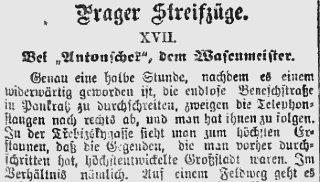
Bohemia, 27.11.1910 (Egon Erwin Kisch)
Nešrava and his undertaking is also the theme in the story Bei "Antouschek", dem Wasenmeister by the famous "raging reporter" Egon Erwin Kisch. The story was first printed in Bohemia on 27 November 1910, and was the 17th in his series called Prager Streifzüge. The story later appeared in books, including Aus Prager Gassen und Nächten (1912) and Abenteuer in Prag (1920). In the story Kisch describes a tour of the factory, his meeting with Herr Nešvara and he provides a number of details, both technical and also about the history and organisation of such enterprises in Prague. Nešvara also tells about his family and that his brother worked there. Kisch writes that the enterprise was relatively odourless, something that is at odds with the complaints that appeared in the inter-war years.
Quote(s) from the novel
[I.14.3] Kanárka mořili hladem, jeden sluha angorské kočce vyrazil jedno oko, stájový pinč byl od nich práskán na potkání a nakonec jeden z předchůdců Švejka odvedl chudáka na Pankrác k pohodnému, kde ho dal utratit, nelituje dát ze své kapsy deset korun. Oznámil potom prostě nadporučíkovi, že mu pes utekl na procházce, a druhý den už mašíroval s rotou na cvičiště.
Sources: Jaroslav Šerák, Jaromír Pešek, Egon Erwin Kisch, Josef Veselý
Literature
- Rasovna
- Proč nevenčit psy na Kavčích Horách?
- Adresář královského hlavního města Prahy a obcí sousedních1907
- Adresář města Král. Vinohradů1912
- Odstranění kontumačních stanic z Prahy28.1.1888
- Václava Nešvaru
- V pražské stanici thermochemickéJaromír Pešek15.4.1910
- Bei "Antouschek", dem WasenmeisterEgon Erwin Kisch27.11.1910
- Nákaza mezí vojenskými koňmi12.8.1912
- Požáry29.7.1921
- Hledá se místo pro pražskou pohodnici9.11.1929
- Kontumační stanice se postěhuje8.11.1935
 | U Štupartů |  | ||||
| Praha I./647, Štupartská ul. 14 | ||||||
| ||||||

U Štupartů, 11 March 1911
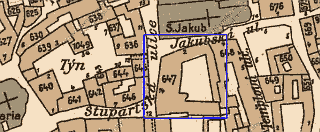
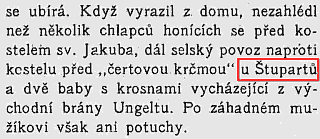
Alois Jirásek "Temno"
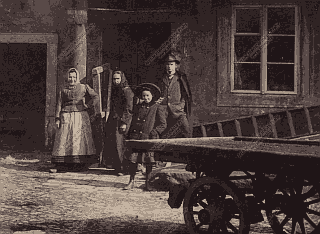
From the courtyard of "U Štupartů", 16 March 1911
U Štupartů is mentioned by Švejk in a conversation with Oberleutnant Lukáš when he describes how the cat devoured the Harz canary. I similar episode is said to have taken place in this house but in this case the cat had eaten a parrot.
Background
U Štupartů is a building in Staré město with a history dating back to the 14th century. The house is named after Peter Stupart von Löwenthal who bought it 20 October 1664. His grandson sold it out of the family on 10 September 1732. In 1910 the house had two street addresses in Štupartská 14 og Jakubská 2 and had many tenants. Amongst them the pub named after the house, run by Rudolf Holeček. It's address was Štupartská 14.
The original building (surely this was the one mentioned in the novel) was demolished in the autumn of 1911 after much opposition. Klub za starou Prahou and others wanted to preserve it due to its historical and architectural value but they were overruled by the city council. Already in December that year the new building was under construction, was ready the next year and still occupies the premises. The builder was Josef Sochor from Prague VII.
The devil's inn
Another author who wrote about U Štupartů was Alois Jirásek, Jaroslav Hašek's teacher at the gymnasium in Žitná ulice. The novel "Temno" (Darkness) was first printed as a serial in Zlatá Praha and was published as a book in1914. It mentions the pub U Štupartů opposite the church Sv. Jakub as čertová krčma (a devil's inn). This historical novel is set at the beginning of the 18th century.
Quote(s) from the novel
[I.14.3] V domě ,U Štupartů’ sežrala před léty kočka dokonce papouška, poněvadž se jí posmíval a mňoukal po ní. Voni ale mají kočky tuhej život. Jestli poručíte, pane obrlajtnant, abych ji vodpravil, tak ji budu muset trhnout mezi dveřmi, jinak nedodělá.“
Also written:Beim StupartReiner
Literature
 | Armin von Barheim |  | |||
| |||||

Břetislav Hůla, "Vysvětlíky". © LA-PNP
Armin von Barheim was kennel in Bavaria. It enters the story when Švejk tells Oberleutnant Lukáš about the finer details of dog breeding, and that one sometimes has to forge the pedigrees, because dog owners don't want mongrel dogs.
Background
Armin von Barheim is an institution which existence remains unidentified. No Bavarian kennel Armin von Barheim has been found, nor any kennel carrying this name anywhere in the world. Generic searches (Google and Wikipedia 2018) provide no meaningful hits, neither on geography nor people. Břetislav Hůla does list the kennel in his explanations to the novel (1951) but doesn't provide any complimentary details.
Searches in the Bavarian, Austrian and Czech digital newspaper collections do however show up a few hits, but nothing that is related to dog breeding in Bavaria or anywhere else. All this indicates that the name Barheim is either invented or misspelt.
Quote(s) from the novel
[I.14.3] A každej hned chtěl rodokmen, tak jsem si musel dát rodokmeny natisknout a dělat z nějakýho košířskýho voříška, kerej se narodil v cihelně, nejčistokrevnějšího šlechtice z bavorskýho psince Armin von Barheim.
 | Kronika světové války |  | ||||
| Karlín/108, Královská tř. 48 | ||||||
| ||||||
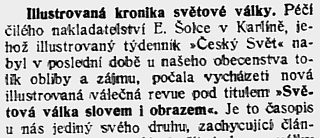
Rovnost, 12.10.1914
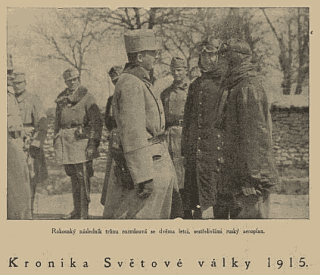
Světová válka slovem i obrazem, s. 505: "Rakouský následník trůnu rozmlouvá se dvěma letci, sestřelivšími ruský aeroplan".
Kronika světové války is mentioned when Švejk escorts Katy Wendler to the barracks where Oberleutnant Lukáš serves. There he has a chat with a soldier about the events of the war. He has an expression as stupid as can be seen on a picture in Kronika světové války where the Austrian successor to the throne appears in a conversation with two pilots who have shot down a Russian plane.
Background
Kronika světové války was not a book like the context here indicates, but sub-titles in the booklet series Světová válka slovem i obrazem (The World War in words and pictures) issued by the publisher Emil Šolc in Karlín from October 1914 onwards. They were published every two weeks and were later assembled in six large volumes. Editor in chief was Adolf Srb who was assisted by a group of experts. The series is richly illustrated, is very detailed and is generally of high quality. In total it contains nearly 2000 pages.
Emil Šolc was also publisher of the weekly Český svět who in 1913 printed the well known picture of Jaroslav Hašek and Zdeněk Matěj Kuděj in female bathing gear. Šolc originated from Telč where he also acted as a publisher. In 1913 he bought the bookshop and publishing house of Rudolf Storch in Karlín. In 1919 the publishing house was merged with publisher Šimáček.
Fragments used in the novel
It is obvious that Jaroslav Hašek used some of the instalments/books from the series as a source when he wrote The Good Soldier Švejk [a]. The quote from Kronika světove války regarding the photo of the heir to the throne Archduke Karl Franz Joseph is copied letter by letter from volume II, page 505. It should be added that these brief daily reports appear also in periodicals like Národní politika and Roskvět, but with a slightly different spelling. Therefore everything indicates that the author used The World War in words and pictures, and not any of the others. The picture also appeared in Český svět 4 June 1915 with exactly the same wording.
In chapter 14 fragments from Kronika appear repeatedly. The first example is the Sultan awarding the German Emperor the war medal, then general General Kusmanek who arrived in Kiev. The longest direct quote is however the sub-title of the picture of the heir to the throne.
The conversation between Lukáš and Wendler
Then follows the conversation between Oberleutnant Lukáš and hop trader Wendler when the latter arrives to fetch his wife. Here the officer lists a number of leading Turkish politicians and high ranking officers, and also three German officers serving the Ottoman Empire.
Wendler retorts with a tirade about the hopeless situation for the hop business, and a number of spots from the front in Belgium and France appear. He assigns a brewery to most of them and the names are all found in Kronika's summary of war events from 24 March to 2 April 1915. Some additional phrases are recognizable but adapted to the novel's context. These place names, persons and text fragments are all found on pages 505 to 507 of Kronika.
Further snippets appear on pages 508 to 511, but these are not from the brief daily updates. Instead they are from a longer article reporting on the Central Power's breakthrough by Dunajec on 2 May 1915, and on page 511 deliberations on Italy's entry in the war.
Quote(s) from the novel
[I.14.4] Jedině když již stáli u kasáren, Švejk vyzval mladou dámu, aby počkala, a dal se do hovoru s vojáky ve vratech o vojně, z čehož musela mít mladá dáma náramnou radost, poněvadž chodila nervosně po chodníku a tvářila se velice nešťastně, když viděla, že Švejk pokračuje ve svých výkladech s tak hloupým výrazem, jaký bylo možno vidět též na fotografii uveřejněné v té době v „Kronice světové války“: „Rakouský následník trůnu rozmlouvá se dvěma letci, sestřelivšími ruský aeroplán“.
Also written:Chronice of the World WarenVerdskrigens krønikeno
Literature
- Českým čtenárům "Svetové války slovem i obrazem"18.10.1914
- Spisy redakce zaslané5.11.1914
- Světová válka slovem i obrazem20.11.1914
- Světová válka 1914-1915 slovem i obrazem. Díl I.
- Světová válka 1914-1915 slovem i obrazem. Díl II.
- Světová válka 1914-1916 slovem i obrazem. Díl III.
- Světová válka 1914-1915 slovem i obrazem
- Der Thronfolger Erzherzog Karl Franz Josef im Gespräche mit den beiden deutschen Fliegern15.5.1915
- Rakouský následník trůnu rozmlouvá se dvěma letci, sestřelivšími ruský aeroplan4.6.1915
- Der Thronfolger Erzherzog Karl Franz Josef im Gespräche mit deutschen Fliegern20.6.1915
| a | The Good Soldier Švejk versus The World War in words and pictures | 1.2.2019 |
 | Turkish Parliament |  | |||
| |||||
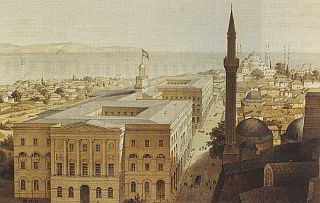
Dünden Bugüne İstanbul Ansiklopedisi 8 vol, İstanbul 1993-1995.
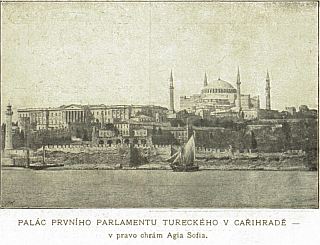
,15.1.1909
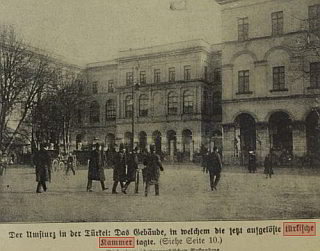
,15.8.1912
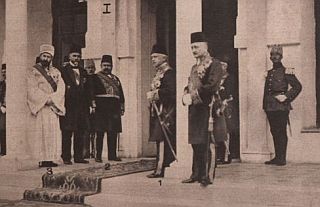
,2.12.1915
Turkish Parliament is mentioned by Oberleutnant Lukáš when he tells hop trader Wendler that the chairman of the Turkish parliament, Hali Bey, has arrived in Vienna.
Background
Turkish Parliament (or General Assembly - tr. Meclis-i Umûmî) was opened in 1876 and functioned until 1920. It was the first attempt of a representative system of government in the Ottoman Empire. It was however dissolved by the Sultan already in 1878 and only revived in 1908 after the Young Turk Revolution.
The assembly consisted of two chambers, the Upper Chamber (Meclis-i Âyân) and the Lower Chamber (Meclis-i Mebusân). The Lower Chambers was made up of elected representatives, the Upper Chamber had its members picked by the Sultan.
At the election in 1908 several parties were represented, with the Committee for Unity and Progress (Young Turks) as the largest group. Many nationalities had seats in the parliament: Turks, Arabs, Armenians, Albanians, Greeks, Slavs, Jews etc.
The 1912 election was however won by the Committee with an overwhelming majority, after an election campaign where democratic rules were pushed to the side. The ethnic composition of the house remained much the same. After this election Halil Bey, the chairman of the Committee, was elected president of the lower chamber.
In 1914 new elections were held, but after the losses in the Balkans Wars the Committee had in 1913 taken power through a coup and in 1914 they were the only party participating. On 13 May 1914 Emir Ali Paşa and Hüseyin Cahit Bey were elected vice presidents of the lower chamber. Halil Bey was at the same time re-elected as speaker of the house with 180 of the 181 votes.
The last ever election to the parliament took place in 1919.
Hans-Peter Laqueur
Initialy (i.e. 1876) it assembled in the building designed for the Darülfünun, the predecessor of the University of Istanbul, but never used for that purpose. After the reopening in 1908 parliament assembled in Çırağan Sarayı on the Bosphorus, between Beşiktaş and Ortaköy (now Kempinski Çirağan Palace Hotel), which unfortunately burnt down two months later. After that the sessions were held in the Darülfünun building near Sultanahmet again.
Quote(s) from the novel
[I.14.5] „Turci se drží dobře,“ odpověděl nadporučík, uváděje ho opět ke stolu, „předseda turecké sněmovny Hali bej a Ali bej přijeli do Vídně.
Also written:Turecká sněmovnáczTürkisches ParlamentdeMeclis-i Umûmîtr
Literature
- Meclisi Mebusan Zabıt Ceridesi
- Die Türkei wieder ein Verfassungstaat25.7.1908
- Das neue türkische Parlament4..1914
- Constitution du bureau de la chambre20.5.1914
- Das türkische Parlament16.12.1914
- Předseda turecké sněmovny jede do Vídně18.3.1915
- How Turkey went to WarMarch 1915
- Světová válka 1914-1915 slovem i obrazem. Díl II.
- Die feierliche Eröffnung der türkischen Kammer durch den Sultan2.12.1915
 | Malý výčep piva |  | |||
| Praha III./196, Thunovská ul. 19 | |||||
| |||||


Adresář hl. města Prahy, 1910
Malý výčep piva (the small beer bar) was a small pub at the lower end Zámecké schody where Švejk and Blahník planned the theft of the dog the soldier had promised Oberleutnant Lukáš, a misdeed that would later have fatal consequences.
Background
Malý výčep piva surely refers to one of the pubs in Thunovská ulice, a street leading up to Zámecké schody. In 1907 the address book shows up three pubs in the street: at No. 14, 15 and 19. In 1910 the one at No. 14 was no longer listed.
No. 19 was located directly at the end of the steps so at first sights it appears to be the bar the author had in mind. Pub landlord in 1907 and 1910 was František Šťáral, born in 1846 and died in 1917. He was registered at the address of the pub from 1900 to 1910. In Chytilův úplný adresář království Českého of 1912 Anna Novotná is entered as landlady.
U krále brabantského
No. 15 hosted the well known U krále brabantského and according to Zdeněk Matěj Kuděj known as a gathering place for secret meetings. This fits the scene from the novel well, but it is odd that Hašek classed it as a small beer bar.
Quote(s) from the novel
[I.14.6] Na Malé Straně u Zámeckých schodů je malý výčep piva. Jednoho dne tam seděli v šeru vzadu dva muži. Jeden voják a druhý civilista. Nakloněni k sobě šeptali si tajemně. Vyhlíželi jako spiklenci z dob Benátské republiky.
Also written:Small beer barenKleine BierkneipedeLiten ølbarno
Literature
 | Psinec nad Klamovkou |  | ||||
| Smíchov/908, Bělohorská silnice | ||||||
| ||||||
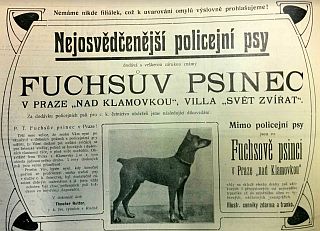
, 1.2.1910
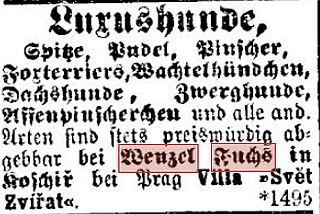
,11.2.1900
Psinec nad Klamovkou (the kennel above Klamovka) is mentioned by Blahník when he and Švejk plan the dog-theft in the little pub by Zámecké schody. It turns out that Blahník worked at the kennel.
Background
Psinec nad Klamovkou refers to a breeding kennel that was owned by publisher and dog breeder Václav Fuchs and located by the villa Svět zvířat in Košíře above Klamovka. The villa also housed the editorial offices of the magazine Svět zvířat where Jaroslav Hašek was lead editor in 1909 and 1910.
The kennel advertised already in 1899, and from 1901 it used the term Hundepark Fuchs or similar in their German language adverts. In Czech newspapers the term Fuchsův psinec or similar is often found. The sales pitch was particularly noticeable in Prague newspapers like Prager Tagblatt, Národní listy and Bohemia, although adverts and news at times appeared in many other newspapers across Austria. The weekly Das interessante Blatt from Vienna also often carried the adverts and even some articles where the breeding kennel was mentioned.
Fuchs moved to Klamovka from Jičín in 1898 and seem to have starting breeding dogs at the premises soon after. In 1906 the kennel advertised a dog exhibition that were open to the public and in 1909 and 1910 they claimed to have more than 100 animals on show. The assistant at the kennel was from 1908 some Ladislav Čížek.
Police dogs
One of the important customers of the kennel was Rittmeister Rotter from k.k. Gendarmerie who let his two German shepherd dogs be trained here (see Wölfin). Rotter was featured in an article in Svět zvířat in 1909, and there was also a picture of him with his dogs. On 1 February 1910 the magazine also printed a letter of acknowledgement from him in an advert for the kennel.
Hašek on Klamovka
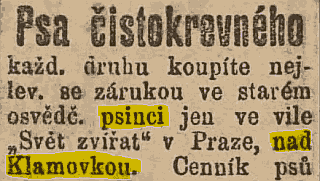
,16.1.1910
In 1908 Hájek, one of Jaroslav Hašek's closest friends, became head editor of Svět zvířat. It was he who later that year brought Hašek to Klamovka and the latter now came in close contact with the kennel, an experience that later was reflected not only in The Good Soldier Švejk, but also in many of the short stories he wrote until 1914. Hájek soon fell out with his boss and resigned as editor. Hašek then succeeded him, this probably happened in February 1909.
According to police register he lived at the villa from 4 February 1909. From to 28 July 1910 he is registered at Smíchov No. 1125, below the Klamovka gardens. Note that these are registered dates and may not correspond to the actual dates he moved.
Hard-hitting adverts
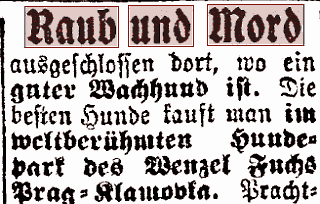
,21.3.1909
From February 1909 the adverts in Prager Tagblatt took on a more bombastic tone. The headline was "Raub und Mord" and the "dog park" was allegedly "world famous". The text of the adverts read: "robbery and murder is ruled out when a good guard dog is present". It is tempting to link the hard-hitting adverts to the arrival of Jaroslav Hašek in the editorial offices of Svět zvířat. These adverts ran for about 6 months and in the autumn they also appeared in Bohemia.
Imaginary animals
A well known theme from The Good Soldier Švejk are the animals that Einjährigfreiwilliger Marek invented and these stories got back to Jaroslav Hašek himself. He wrote improbable articles about animals, some of them real, some of them invented and also advertised some of them for sale. Eventually his tricks were uncovered, he was dismissed and Hájek was re-instated. Exactly when this happened we don't know. Hašek wrote a story in the magazine on 15 August 1910 and Hájek was apparently in charge again by mid October.
Canisport

,19.12.1908
Václav Fuchs passed away 27 September 1911 and a few weeks later adverts show the firm Canisport operating from his address at Klamovka. The adverts for Fuchs however continued for the rest of the year. The two firms presumably shared the premises for some months but from 1912 the adverts for Fuchs disappear. One also assumes that they merged, considering the close ties Canisport already had to the Fuchs family. ,1910
Canisport was a firm at Vinohrady who from 1908 advertised dogs. First it was registered at Manesová ul. 917/28, then in Moravská ul. 1053/25. The proprietor was František Pober, married to Marie Fuchsová, the oldest daughter of Václav Fuchs. Pober had already in 1904 advertised dogs for sale in Prager Tagblatt, so he might have been a dog breeder already then. His address in 1904 was Karlova ulice 24 in Smíchov. The firm moved Radotín south of Prague in 1910. They advertised regularly but at the end of 1910 the adverts from Radotín stopped before surfacing again in November 1911, now using the address Klamovka. Police records show the couple living in villa Svět zvířat from 16 November 1911. Canisport specialized in luxury dogs. ,1939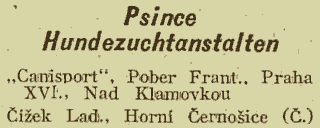
The company seem to have flourished under Pober's management and adverts were even found in Polish newspapers. Address book entries reveal that Canisport remained in business at least until 1938. Pober was still the owner and their address remained "above Klamovka". They advertised even more extensively than before the war, also in Austrian newspapers. As a curiosity can be mentioned that Ladislav Čížek, the former servant at Psinec nad Klamovkou, was still in the dog breeding business. His name appears in the 1939 address book next to Canisport. He was now located in Horní Černošice south of Prague.
Kynologický ústav
Hašek's legendary Cynological Institute should not be confused with the Fuchs kennel, but we include a chapter about it because the two were direct competitors, operating in the same neighbourhood. Importantly Švejk's occupation as a dog dealer was largely inspired by his creator's brief career as owner of the "institute". ,16.11.1910 ,21.4.1914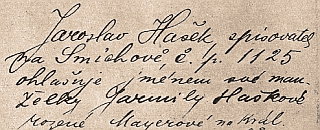


After his dismissal from Svět zvířat in 1910 Hašek set up his own dog trading firm with the imaginative name Kynologický ústav (Cynological institute), and from 16 November 1910 onwards adverts appeared in a.o. Prager Tagblatt, Národní listy and Čech, offering pure-bred dogs at prices half those of the "so-called" Hundeparks and breeding institutions, obviously a kick at the former employer up the hill. One of the adverts claims that the institute is the only of its kind in Central Europe and warns against "mixing up", no doubt another dig at Václav Fuchs.
From 24 November 1910 the latter responded with for him unusually verbose adverts, claiming again to be world famous, and also warning against mix-ups. On 27 November and over the next week the adverts of the competing dog-sellers even appeared in Prager Tagblatt next to each others. The advertising war seems to have been short, at least in the columns of Prager Tagblatt. Hašek's last known entry was on 7 December whereas his competitor flooded the newspaper for the rest of the year, before reverting to the usual briefer notes.
The institute was officially registered on 24 November, in the name of his wife Jarmila Hašková, address Košíře no. 1125, below Klamovka. It is however improbable that he could have kept the dogs here as the recently married couple lived in an apartment.
By February 1911 the firm had gone bankrupt and there are various versions on what happened. Josef Mach wrote that Hašek imported two hyenas from Hamburg destined for a circus that in the end didn't take them. The loss on this deal was one of the reasons why the firm collapsed. There is also mention of tinkering with pedigrees, his agent Čížek stealing dogs, themes that have obvious parallels in The Good Soldier Švejk. Mach confirms that Čížek was put on trial for dog theft.
The Hašek couple were also taken to court but 9 March 1912 they received a letter from their lawyer František Papoušek, informing that the proceedings had been cancelled.
In literature
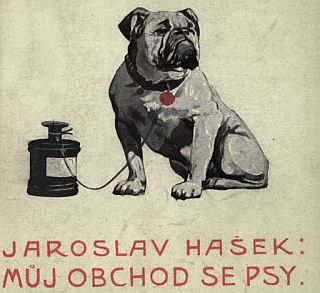
Hašek himself immortalised his institute in the two near identical stories Můj obchod se psy and Kynologický ústav. The first story was featured in the book Můj obchod se psy a jiné humoresky, published in 1915. This book has been reprinted several times and headline story has even been filmed. The story is vague about where the dogs were kept, but the author indicated that the kennel was located "in the countryside", a theme also found in The Good Soldier Švejk.
Animals often appear is Hašek's writing and The Good Soldier Švejk is far from the only example. The famous novel actually borrows a lot from themes that the author had used in his pre-war short stories. The inspiration from his experiences at Klamovka shine through in many of them. Entire stories are dedicated to animals, be it dogs, cats, goats etc. The monkey Miss Julie who features in one story was very real, pictures of her appeared in Svět zvířat.
Quote(s) from the novel
[I.14.6] Voják s civilistou si ťukli a civilista dále šeptal: „Jednou ode mne jeden černej špic, kterýho jsem potřeboval pro psinec nad Klamovkou, nechtěl taky vzít buřt.
Sources: Hájek, Josef Mach, Jaroslav Šerák, Radko Pytlík
Literature
- Z mých vzpomínek na Jaroslava Haška1925
- Kynologický ústavJaroslav Hašek17.4.1914
- Můj obchod se psy a jiné humoresky1915
- V přírodovědeckém časopiseJaroslav Hašek31.7.1911
- ......a hledal psinec a redakci "Světa zvířat"
- Toulavé house1971
- Živnotenský list24.11.1910
- Luxushunde10.12.1899
- Luxushunde25.3.1900
- Hundepark4.8.1901
- Psů25.2.1902
- Psinec "Světa zvířat"4.5.1902
- 1 Doggenrüde24.8.1904
- Ständige Hundeausstellung1.4.1906
- Čistokrevné psy27.5.1906
- Nejkrásnejší psy17.12.1907
- Hunde alle Rassen2.3.1908
- Psy všech druhů16.8.1908
- Eine Aktion der Hundefreunde20.10.1908
- Ústřední stanice6.12.1908
- Ein schöner Hund20.12.1908
- Raub und Mord28.2.1909
- Die ersten österreichischen Gendarmeriehunde13.1.1910
- Časopis "Svět zvířat" č. 29715.10.1910
- Kynologický ústav17.11.1910
- Kynologisches Institut23.11.1910
- Kynologický ústav27.11.1910
- Kynologický ústav30.11.1910
- Kynologisches Institut7.12.1910
- Pěrvyj russkij putěvoditěl'1912
- Papoušek, František. 9.3.1912
- Reklame19.7.1914
- Ein trautes Heim8.12.1931
- Hund im Haus - Glück im Haus!8.12.1931
- Nejmilejší kamarád8.12.1931
- Pobytové přihlášky pražského policejního ředitelství1851 - 1914
 | Pasteur-Institut |  | |||
| Wien III., Boerhavegasse 8 | |||||
| |||||
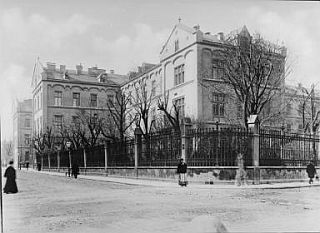
Wien 3, Rudolfspital, Ansicht über Eck Boerhavegasse - Juchgasse, 1900
© Österreichische Nationalbibliothek
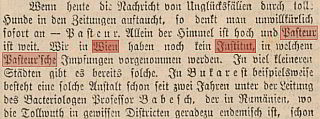
,12.9.1889

Die Gemeinde-Verwaltung Wien, 1894-1896
Pasteur-Institut was mentioned in the context of the dog thief Blahník having been bitten by a rabid dog. He was sent to the institute where he felt quite at home.
Background
Pasteur-Institut is a private non-profit organisation whose main goal is to combat infectious diseases. They were founded by and are named after the world famous bacteriologist and chemist Louis Pasteur. Their headquarters are located in Paris but have research centres and clinics all over the world.
The first institute was opened in Paris 14 November 1888 and very soon others opened all over the world. Their main task until World War I was to battle rabies. Vienna was relatively late in providing a clinic for treatment of rabies and already in 1889 Wiener Allgemaine Zeitung that such an institution existed in Bucharest. Budapest soon followed.
Rudolfsanstalt
The so-called "Pasteur Institute" in Vienna was created in July 1894 as a clinic at k.k. Krankenanstalt Rudolfstiftung in III. Bezirk - Landstrasse. The founder was the renowned bacteriologist Richard Paltauf (1858-1924). The task of the institute was inoculation against rabies, both preventive and after the patient had been infected. Treatment was free apart but the patient had to pay for accommodation (for poor patients the bill was sent to his home council).
The clinic had no official name and the connection to the institute in Paris was probably merely that they used the methods of Pasteur in treating the patients. In address books they are listed as Schutzimpfungsanstalt gegen Wut. They mainly served Vienna but patients from other parts of Austria were also welcome. Newspaper clips reveal that patients from Bohemia were treated here regularly.
Canine madness

Battling rabies in the 16th century
Until around 1900 the of rate of human fatalities in Cisleithania due to rabies was high but steadily decreasing. From 142 victims in 1873 the number was down to 81 by 1886. Measures like a law requiring the use of muzzles helped, and the knackers were permitted to kill any dog that didn't wear hit. Still it was the vaccine of Pasteur that brought the numbers drastically down.
In interwar Czechoslovakia there were still deaths, but far fewer (yearly average slighly above 7). Prague now had its own Pasteur Institute. After the Second World War the disease was nearly eliminated and since then no deaths amongst humans have been recorded.
Already before 1894 another "Pasteur-Institut" existed in Vienna, but their task was to treat animals. This institution operated under the auspices of the department of agriculture.
Quote(s) from the novel
[I.14.6] Oba přátelé si opět ťukli. Ještě když Švejk se živil prodejem psů do vojny, Blahník mu je dodával. Byl to zkušený muž a vypravovalo se o něm, že kupoval pod rukou z pohodnice podezřelé psy a zas je prodával dál. Měl dokonce už jednou vzteklinu a v Pasteurově ústavu ve Vídni byl jako doma.
Also written:Pasteur InstituteenPasteurův ústavczInstitut Pasteurfr
Literature
- Belehrung betreffend die Schutzimpfung der Menschen gegen Wut
- Impfungsanstalt1910
- Grosser Plan von Wien1909
- Richard Paltauf
- Die Opfer der Hundswuth in Oesterreich12.9.1889
- Certifikat31.7.1894
- Vyhláška25.8.1894
- Das Pasteur-Institut in Wien30.9.1894
- Louis Pasteur a jeho výzkumi o vzteklině30.5.1894
- Pasteurs Wut-Schutzimpfung– vor 130 Jahren in Wien mit Erfolg begonnen und doch offiziell abgelehnt7.8.2015
 | Hundezwinger von Bülow |  | |||
| |||||
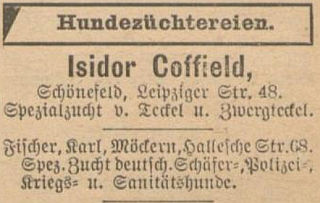
Leipziger Adreß-Buch, 1910
Hundezwinger von Bülow was the name of a kennel in Leipzig where Max (formerly Fox) was supposed to hail from. This was according to his pedigree invented by Blahník.
Background
Hundezwinger von Bülow was almost certainly an invention by Blahník. In the Leipzig address books from 1910 and 1914 four kennels are listed, but none of them were owned by any von Bülow. Two persons with this surname appear in the directory but none of them appear to have been involved in dog breeding.
Quote(s) from the novel
[I.14.6] „To musí bejt tvou rukou napsaný. Napiš, že pochází z Lipska, z psince von Bülow. Otec Arnheim von Kahlsberg, matka Emma von Trautensdorf, po otci Siegfried von Busenthal. Otec obdržel první cenu na berlínský výstavě stájových pinčů v roce 1912. Matka vyznamenána zlatou medalií norimberskýho spolku pro chov ušlechtilých psů. Jak myslíš, že je starej?“
Also written:Kennel von BülowenPsinec von BülowczKennel von Bülowno
 | Berliner Stallpinscherausstellung |  | |||
| |||||
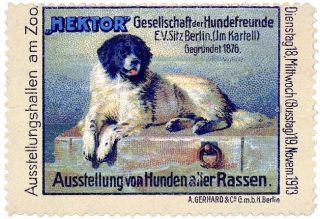
Dog exhibition in Berlin in November 1913

,15.1.1909
Berliner Stallpinscherausstellung took place in 1912 and Arnheim von Kahlsberg, the alleged father of the stolen dog Max (formerly Fox), won a gold medal. All this according to Blahník as he instructs Švejk on how to fill in the pedigree form for "Max".
Background
Berliner Stallpinscherausstellung is supposed to have taken place in 1912, but it is unclear what exhibition Blahník here refers to, and it is probably as invented as the pedigree of Max (formerly Fox). It has in any case not been possible to identify an exhibition that fully corresponds to the details revealed in the novel.
Dog exhibitions in Berlin
Still the author surely drew inspiration from some dog fair in Berlin. The city regularly hosted international dog fairs and those were obviously known to Hašek at the time when he was editor of Svět zvířat in 1909 and 1910. One of the organisers of those exhibitions was the cynological club Hundevreien Hektor and the events took place at Zoologischer Garten. The fairs were at times reported on also in Austrian newspapers. Still Hektor was not the only organiser of such events, so any firm conclusion is not possible.
Quote(s) from the novel
[I.14.6] „To musí bejt tvou rukou napsaný. Napiš, že pochází z Lipska, z psince von Bülow. Otec Arnheim von Kahlsberg, matka Emma von Trautensdorf, po otci Siegfried von Busenthal. Otec obdržel první cenu na berlínský výstavě stájových pinčů v roce 1912. Matka vyznamenána zlatou medalií norimberskýho spolku pro chov ušlechtilých psů. Jak myslíš, že je starej?“
Also written:Berlin stable pinscher exhibitionenBerlínská výstava stájových pinčůczBerlin stallpinscherutstillingno
Literature
 | Nürnberger Verein zur Zucht edler Hunde |  | |||
| Nürnberg, Elisenstraße 30 | |||||
| |||||

Adressbuch von Nürnberg, 1904
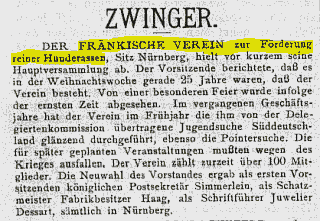
Allgemeine Sport-Zeitung, 7.3.1915
Nürnberger Verein zur Zucht edler Hunde was a society for breeding of thoroughbred dogs that had awarded Emma von Trautensdorf, the fictional mother of the stolen dog Max (previously Fox), a gold medal. At least this was what Blahník told Švejk to put on Max's pedigree form.
Background
Nürnberger Verein zur Zucht edler Hunde can not be identified explicitly from the address directory of 1904 (the only one available for the period), but two dog societies are listed: Dachshundklub Nürnberg and Fränkische Verein zur Förderung reiner Hunderassen.
The latter's name is so close that it could be assumed that this is indeed the society the dog thief refers to. It was located in Nuremberg and regularly arranged exhibitions and other dog-related events.
The association was founded around Christmas 1889 and in 1915 it was still operating although the war restricted their activities. In 1915 they had more than 100 members.
In 1912 an additional dog society was founded: Polizeihundverein Nuremberg 1912. It is however unlikely that Blahník had these in mind when he instructed Švejk on how to fill in the pedigree form of "Max".
Quote(s) from the novel
[I.14.6] „To musí bejt tvou rukou napsaný. Napiš, že pochází z Lipska, z psince von Bülow. Otec Arnheim von Kahlsberg, matka Emma von Trautensdorf, po otci Siegfried von Busenthal. Otec obdržel první cenu na berlínský výstavě stájových pinčů v roce 1912. Matka vyznamenána zlatou medalií norimberskýho spolku pro chov ušlechtilých psů. Jak myslíš, že je starej?“
Also written:Nuremberg society for the breeding of thoroughbred dogsenNorimberský spolek pro chov ušlechtilých psůczNürnberg-selskapet for oppdrett av reinrasa hundarno
Literature
- Hunde-Ausstellung29.7.1890
- Bei der Jagdgebrauchssuche1904
- Chronik



|
I. In the rear |
 | |
15. Catastrophe | |||
 | Kostel svatého Haštala |  | |||||
| Praha I./789, Haštalská ul. 21 | |||||||
| |||||||


"Mistr Kampanus", Zikmund Winter, 1906
Kostel svatého Haštala is mentioned by Švejk when he warns Oberleutnant Lukáš not to walk Fox near U mariánského obrazu, where they have a butcher's dog that is every bit as ill-tempered as the beggar from the Saint Castulus church.
Background
Kostel svatého Haštala is a church in Prague, Staré město, built in Gothic style. It is named after Saint Castulus, one of the first Christian martyrs. The church is one of the oldest in Praha, the predecessor was erected in the 13th century. The current structure was consecrated in 1375 and was finished by 1399.
The beggar
Hašek may have picked the theme of the beggar and the church from the historical novel Mistr Kampanus by Zikmund Winter. It was published in 1906[a].
Quote(s) from the novel
[I.15] Jak uvidí ve svým rayoně cizího psa, hned je na něho žárlivej, aby mu tam něco nesežral. Von je jako ten žebrák od svatýho Haštala.“
Also written:Church of Saint CastulusenKirche zum heiligen Kastulusde
Literature
- Osudy kostela, fary a školy u sv. Haštala v Starém Městě Pražském
- Z letopisů kostela a fary u sv. Haštala na Starém městě Pražském
- Kostel sv. Haštala na Starém Městě pražském
- Haštalská: (I.-Staré město)1929
| a | Mistr Kampanus | 1906 |
 | U mariánského obrazu |  | |||||
| Praha II./1011, Hybernská ul. 30 | |||||||
| |||||||
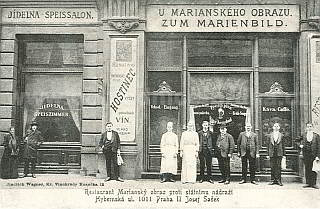
Světlotisk. J. Wagner, kolem 1906
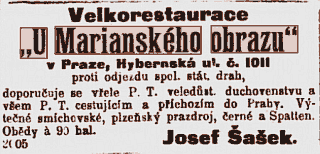
,12.12.1909

, 1909

,3.10.1937
U mariánského obrazu is mentioned when Švejk informs Oberleutnant Lukáš that a mean dog, owned by a butcher, has his territory here and that he better not go there with Max.
Background
U mariánského obrazu was a restaurant in Hybernská ulice. It was located on the ground floor in number 1011, right opposite the departure hall of Státní nádraží (Staatsbahnhof), present-day Masarykovo nádraží. It should not be confused with the current restaurant (2011) by the same name in Žižkov.
There were several pubs with this name in Prague at the time, but due to the fact that the wicked dog strayed to Havlíčkovo náměstí, we can safely assume that Švejk had the pub in Hybernská in mind. It was a large tavern, obviously popular with travellers. In the decade before World War I they served beer from Smíchov and Plzeň and offered soup from five o'clock in the morning!
Long history
The restaurant has a history at least back to 1877 in what was then house number 104. In 1878 some Leopold Ortl became landlord. Some time around 1890 the old house was demolished and number 1011 erected on the site. The restaurant continued operating in the new building. From 1897 and at least until 1914 Josef Šašek was landlord, running the place together with his wife Marie. The couple and their three children lived on the premises.
The address book from 1939 shows that the establishment was still operating, managed by Jan Cimický. He had presumably succeeded Karl Špirek who had managed the restaurant until the autumn of 1937. As late as 27 June 1948 an advert appeared in Rudé právo, but when the establishment closed down for good is not known.
Quote(s) from the novel
[I.15] A taky bych vám neradil vodit ho přes Havlíčkovo náměstí, tam se potlouká jeden zlej řeznickej pes vod ,Mariánskýho vobrazu’, kterej je náramně kousavej.
Sources: Jaroslav Šerák
Also written:Zum Marienbildde
Literature
- Románové restaurační a jiné zábavní podniky2009 - 2021
- Můj omyl s Mariánským obrazem
- Soupis pražského obyvatelstva
- Adresář královského hlavního města Prahy a obcí sousedních1910
- Adresář Protektorátu Čechy a Morava...1939
- Versuchter Raubanfall20.12.1877
- Leopold Ortl30.11.1878
- Chtěli oklamati loterii a oklamali sebe6.11.1888
- Velkorestaurace "U Marianského obrazu"2.1.1898
- Selbstmordversuch eines Piccolo19.8.1905
- Velkorestaurace :U Marianského obrazu:28.6.1914
- Buffet restaurace27.6.1948
 | Číňan Staněk |  | |||
| Praha II./40, Ferdinandova tř. 32 | |||||
| |||||

Petr Štembera, Nový Orient, 1996

, 1913

, 3.1.1914
Číňan Staněk was a "Chinese" who had a convex mirror. Švejk told Oberleutnant Lukáš this story when the latter was wondering if he liked his own looks. Švejk revealed that he did not like the sight of himself in Staněk's mirror.
Background
Číňan Staněk no doubt refers to the warehouse Maison Staněk. It was located at Ferdinandova třída 32, with stores and offices at the nearby Vladislavova ulice no. 13 (from 1896 no. 17). They imported and sold art and industrial goods from the Far East, tea, wine and rum. They also manufactured bamboo furniture. The firm was founded in 1876 by Vilém Staněk and adverts from after 1880 reveal that they focused on importing tea. The firm's name was Staňkův ruský obchod s čajem (Staněk's Russian tea trade).
Thus it was not a question of a "Chinese" in the true meaning of the word although the Chinese Li Gü was employed there and was well known in the city. One of the shop windows displayed a convex mirror.
Vilém Staněk
The owner was born in 1853 and was only 23 when he established the enterprise. He had travelled a fair deal in British and French colonies, amongst them India, and had lived in Paris for a few years. The firm grew rapidly and full-page adverts in Prager Tagblatt a.o. reveal details from their history. They were represented in several cities around the world, amongst them Yokohama and Hong Kong. In 1909 they opened a new outlet in Pilsen.
Every year Staněk attended auctions in Nishny Novgorod and London. He wrote expert articles on tea and also published the magazine Staňkův Světem (Staněk across the world). It appeared from 1889 to 1896, with content in Czech and German, edited by Hanuš Wahner. Staněk was regarded a master at marketing, helped by his younger brother Emanuel who provided illustrations.
Staněk died on 22 November 1893 from lung tuberculosis, at a mere age of 40. His wife Kateřina (born 1866) took over the enterprise after her husband passed away. The company remained in business until 1938 when it went bankrupt.
Quote(s) from the novel
[I.15] „Poslušně hlásím, pane obrlajtnant, že se nelíbím, jsem v tom zrcadle nějakej takovej šišatej nebo co. Vono to není broušený zrcadlo. To jednou měli u toho Číňana Staňka vypouklý zrcadlo, a když se někdo na sebe podíval, tak se mu chtělo vrhnout. Huba takhle, hlava jako dřez na pomeje, břicho jako u napitýho kanovníka, zkrátka figura. Šel kolem pan místodržitel, podíval se na sebe a hned to zrcadlo museli sundat.“
Sources: Milan Hodík, Petr Štembera
Literature
- Staněk's Importgesellschaft16.12.1883
- Pokud se vývozu čaje týkáVilém Staněk17.3.1888
- Staňkův Světem20.9.1890
- China und Japan in Prag20.12.1891
- Sterbefälle22.11.1893
- Staneks Importhaus2.10.1909
- Maison Staněk anebo zboží z Orientu1.1996
- Kateřina Staňeková
- Adressář královského hlavního města Prahy1884
- Adressář královského hlavního města Prahy1892
- Adressář královského hlavního města Prahy1896
- Adresář královského hlavního města Prahy1907
- Adresář královského hlavního města Prahy1910
- Adresář hlavního města Prahy1936
 | Oberkommando |  | |||
| |||||
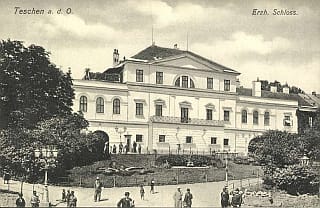
Archduke Friedrich's palace served as the headquarters of k.u.k. Armeeoberkommando from 1914 to 1916.
Oberkommando is mentioned Oberst Kraus when he tells Oberleutnant Lukáš that high command had informed that there is a lack of officers at Infanterieregiment Nr. 91 because the serbs had killed them all.
Background
Oberkommando in this context seemingly refers to AOK, the highest military authority during the war. From the outbreak of war the formal head was Archduke Friedrich but the war effort was for most practical purposes directed by k.u.k. Generalstab, headed by Feldmarschall Conrad. At the time of the plot in the novel Armeeoberkommando was located in Teschen (now Cieszyn)[a], in the palace that was incidentally owned by Friedrich himself[b].
In The Good Soldier Švejk the terms Oberkommando and Militärkommando both probably refer to AOK, although commands at subordinated levels can't be ruled out.
Quote(s) from the novel
[I.15] Vrchní velitelství nedávno nám oznámilo, že jest u 91. pluku velký nedostatek důstojnictva, poněvadž to všechno Srbové pobili. Zaručuji se vám čestným slovem, že do tří dnů jste u 91. pluku v Budějovicích, kde se formují maršbatalióny.
Also written:High Commanden
Literature
| a | AT-OeStA/KA FA AOK Armeeoberkommando (AOK), 1914-1918 (Bestand) | ||
| b | Habsburg Palace, Cieszyn |



|
II. At the front |
 | |
1. Švejk's mishaps on the train | |||
 | Nádraží císaře Františka Josefa |  | |||||
| Král. Vinohrady/300, Sadová silnice 2 | |||||||
| |||||||
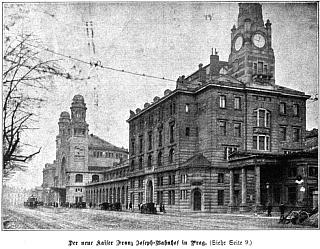
,27.1.1909
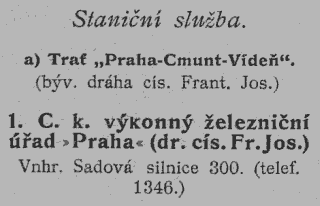
Nádraží císaře Františka Josefa (now Hlavní nádraží) is not mentioned explicitly but it is clear from the circumstances that Oberleutnant Lukáš and Švejk set out on their journey from this station. The trip got off to a bad start as their luggage was stolen at the station.
Background
Nádraží císaře Františka Josefa was until 1918 the name of the main railway station in Prague. It has since then also been called Wilsonovo nádraží after president Woodrow Wilson. Since 1953 it has been named Praha hlavní nádraží (Prague main station). The station was opened in 1871 and is by far the busiest railway station in the country.
In 1914 the station had remote connection with Vienna and it served a number of other destinations both locally and regionally. It was one of the three major railway stations in Prague, together with Státní nádraží (now Masarykovo) and Severozápadní nádraží (now demolished).
Quote(s) from the novel
[II.1] „Poslušně hlásím, pane obrlajtnant,“ ozval se tiše Švejk, „doopravdy ho ukradli. Na nádraží se vždycky potlouká moc takových šizuňků a já si to představuju tak, že jednomu z nich se nepochybně zamlouval váš kufr a ten člověk že nepochybně využitkoval toho, jak jsem vodešel od zavazadel, abych vám vohlásil, že s našima zavazadlama je všechno v pořádku.
Also written:Emperor Franz Joseph StationenKaiser-Franz-Joseph-Bahnhofde
 | Severozápadní nádraží |  | ||||
| Praha II./1583, Tešnov 2 | ||||||
| ||||||
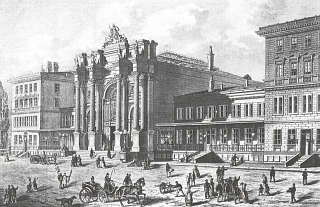
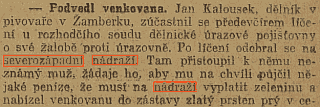
,5.7.1912
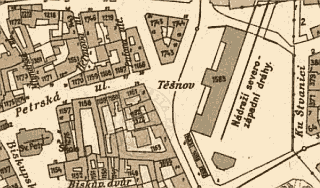
, 1909-1914
Severozápadní nádraží is mentioned when Švejk explains Oberleutnant Lukáš that theft at railway stations always occur. This was after their luggage had been stolen at the station they left Prague from, presumably Nádraží císaře Františka Josefa.
According to the soldier a theft took place here at the North West Station. A pram with a little girl was stolen and handed in at Švejk's local police station.
Background
Severozápadní nádraží was a major railway station in Prague, from 1953 called Praha-Těšnov. It was located in Florenc and was in service until 1972. (The building was demolished in 1985). It was from here Jaroslav Hašek took the train to Světlá nad Sázavou (on his way to Lipnice) on 25 August 1921.
In Prague it was the main hub of Österreichische Nordwestbahn, a private railway operator that was founded in 1868 and functioned until it was nationalised in 1909. The headquarters were located in Vienna. During Austria-Hungary the station served Vienna and Berlin, and several regional desitinations.
Attempts to find any mentioning of the episode with the stolen pram have been futile. If the soldier is to be believed the theft took place in 1912 and the child handed in at Policejní komisařství Salmova ulice (the police station closest to where we assume that Švejk lived).
It should also be noted that Jaroslav Hašek was a reporter on local affairs in České slovo for a period in 1908 and 1912 and it can't be ruled out that he re-used one of his own reports (it has even been claimed that some of these were invented).
Quote(s) from the novel
[II.1] Před dvěma léty na Severozápadním nádraží ukradli jedné paničce kočárek i s holčičkou v peřinách a byli tak šlechetní, že holčičku vodevzdali na policejním komisařství u nás v ulici, že prej ji našli pohozenou v průjezdě. Potom noviny udělaly z tý ubohý paní krkavčí matku.“
Also written:North West StationenNordwestbahnhofdeNordveststasjonenno
 | Neue Freie Presse |  | ||||
| Wien I., Kolowratring, Fichtegasse 12 | ||||||
| ||||||
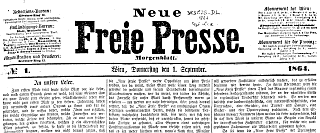
The front page of the first issue, 1.9.1864
,1.9.1864
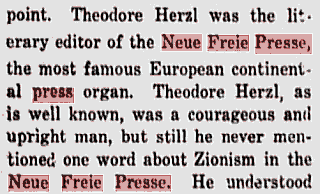
, 29.10.1920
Neue Freie Presse is mentioned in connection with Švejk and Oberleutnant Lukáš and their train journey to Budějovice. Opposite them in the compartment sat a completely bald man and red this paper. Later it became clear that this man was the notorious Generalmajor von Schwarzburg.
Background
Neue Freie Presse was a daily newspaper that was published in Vienna from 1864 to 1939, founded as a break-away from Die Presse. It published both a morning and an evening issue. It's political stance was bourgeois liberal, along the lines of e.g. Prager Tagblatt and Bohemia.
The newspaper eventually became very influential, led by the powerful editor in chief, Moritz Benedikt (1849-1920). It was also one of the largest of its kind in Austria, employing around 500, and it also enjoyed a reputation abroad. They were known for outstanding journalism and succeeded in enlisting writers like Theodor Herzl, Hugo von Hoffmannsthal, Bertha von Suttner and Stefan Zweig.
During World War I they took an aggressive patriotic stance, but had also during the French-German war in 1870-71 shown a pro German tendency.
In the inter-war years the newspaper continued to publish but was closed by the Nazis in 1939. The paper always had many Jewish employees and Benedikt himself was of Jewish descent.
Quote(s) from the novel
[II.1] „Dohromady nic, pane obrlajtnant,“ odpověděl Švejk, nespouštěje oči s lysé lebky civilisty sedícího naproti nadporučíkovi, který, jak se zdálo, nejevil pražádný zájem o celou záležitost a četl si „Neue Freie Presse“, „v celým tom kufru bylo jen zrcadlo z pokoje a železnej věšák z předsíně, takže jsme vlastně neutrpěli žádný ztráty, poněvadž zrcadlo i věšák patřily panu domácímu.“
Literature
- Wien, 27. Juli28.7.1914
- Neue Freie Presse
- Verzeichnis der in Wien erscheinende Zeitungen1914
- Moritz Benedikt
- Idylka z peklaJaroslav Hašek12.6.1908
- Ein Jubiläum der "Neuen Freien Presse"31.8.1914
- Im Raimund-Theater5.10.1930
 | V čubčím háji |  | ||||
| Praha II., Nekázanka ul. | ||||||
| ||||||
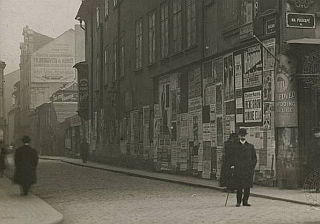
, 1907
V čubčím háji is mentioned in an anecdote by Švejk when he tells Oberleutnant Lukáš about Nechleba who always wants to do good but rarely succeeds.
Background
V čubčím háji was according to Švejk a pub in Nekázanka but additional information is not available. The name has surely been a colloquial term for an existing pub in the street or even a somewhere else. In 1910 there were several pubs in the street, where the best known was U zlatého křížku.
| Folta Josef | 858-II. Nekázanka 1 |
| Hýna Antonín "U zlatého křížku" | 880-II. Nekázanka 7 |
| Stejskal Karel | 879-II. Nekázanka 9 |
Quote(s) from the novel
[II.1] „Poslušně hlásím, že jsem to, pane obrlajtnant, pozoroval. Já má, jak se říká, vyvinutej pozorovací talent, když už je pozdě a něco se stane nepříjemnýho. Já mám takovou smůlu jako nějakej Nechleba z Nekázanky, který tam chodil do hospody ,V čubčím háji’.
Also written:The Bitches' GroveenHündin im Hainde
Literature
- Románové restaurační a jiné zábavní podniky2009 - 2021
- Otevření restaurace15.8.1909
 | U Špírků |  | |||
| Praha I./1024, Kožná ul. 14 | |||||
| |||||


Adressář hl.m. Prahy 1896
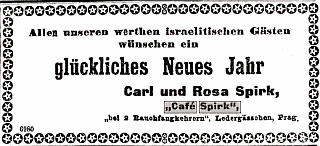
,26.9.1897

,11.5.1912

,5.3.1916

,27.9.1929
U Špírků is mentioned on the train to Budějovice as Švejk loudly ponders the possible causes of loss of hair, and unfortunately quotes a medical student from U Špírků on this. The bald gentleman sitting opposite him is the feared Generalmajor von Schwarzburg, who doesn't take lightly to Švejk's comments.
Background
U Špírků was a coffee-house in Staré město in Prague which still exists albeit in a different setting. According to the restaurant's website it was founded as early as 1870 and renovated in a traditional style between 2004 and 2006.
The café is not listed in the pre-war address books, but in 1891 the police registered a certain Karel Špirk, entered with cafetier as occupation. During the 1890's Špirk and his wife on several occasions placed adverts in Prager Tagblatt where they wishes their Jewish guests a Happy New Year. In the 1896 address book the café is entered under the name U dvou kominíků (At the two Chimneysweeps) with wife Rozalie Špirková as the owner.
In 1912 Národni listy reported that Karel Špirk had passed away and they also add that he was 54 years old, was a café owner and a proprietor of real estate. Špirk was according to the police books born 12 October 1858 in Prague so the connection to the café is indisputable. He was married to the ten year younger Roselie, and they had a daughter Anna who was born in 1887. Karel Špirk died on 9 May 1912 in Senohraby and was buried at Vyšehrad cemetery.
A newspaper notice in Právu Lidu from 1916 confirms that the café was still in business and that it was subjected to a police raid on suspicion of illegal prostitution (Tunel is mentioned in the same item). As late as 1929 adverts reveal that the establishment was still running, now officially using the name U Špírků. They hosted concerts, and served Prazdroj (Pilsner Urquell).
The owner in 1924 was Josef Baloun. In 1936 Marie Balounová was the owner. A picture from 1945 reveals that the establishment survived the Nazi protectorate. During the first republic U Špírků also functioned as an unofficial brothel (licensed brothels were banned in 1921).
Another "U Špírků"
From 1920 onwards another tavern carrying the name appears in newspaper adverts. It was located in Sokolská třída in Nové město and is also a place the author surely would have known about as he frequented this part of the city a lot (see Apollo, Bendlovka, and U kalicha). Newspaper adverts reveal that this U Špírků was often used for meetings. Although there is no trace of this café in pre-war address books, one shouldn't rule out "backdating" as Jaroslav Hašek at times added pieces of information to his novel that were chronologically at odds with the 1914/1915 plot. See Siedliska, Artur Lokesch, and Kriegskalender for more examples.
Quote(s) from the novel
[II.1] “A pokračoval neúprosně dál: „Potom říkal jednou jeden medik v kavárně „U Špírků“, že padání vlasů zaviňuje duševní pohnutí v šestinedělí.“
Literature
- Románové restaurační a jiné zábavní podniky2009 - 2021
- Pobytové přihlášky pražského policejního ředitelství1851 - 1914
- Soupis pražských domovských příslušníků 1830-1910 (1920)
- Glückliches Neues Jahr26.9.1897
- Umrtí11.5.1912
- Poděkování Karla Špirka14.5.1912
- Boj s prazškou prostituci5.3.1916
- Opet mystifikace4.2.1934
- O nás
 | Banka Slavia |  | ||||
| Praha II./978, Havlíčkovo nám. 23 | ||||||
| ||||||
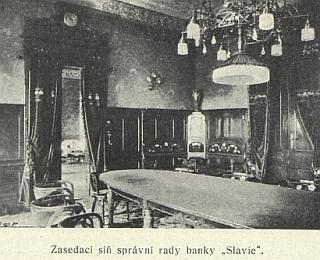
Rozkvět, 10.4.1910

Český Lloyd, 13.9.1902
Banka Slavia is mentioned on the train to Budějovice when Švejk in an innocent manner asks general Generalmajor von Schwarzburg if he may happen to be Mr. Purkrábek, the representative of this bank.
Background
Banka Slavia was a mutual insurance company (and bank) with headquarters at Havlíčkovo náměstí. The company was founded in 1868 by a group of businessmenn led by F. L. Chleborad. The first general assembly was held 14 May 1869. The company expanded quickly and by the turn of the century they were established in Prague, Brno, Vienna, Lwów, Zagreb and Lubljana. At the outbreak of war they were present also in Sarajevo.
The inter-war years saw the firm prosper even more and they were part owners of many foreign financial institutions, even as far as New York. They remained in business until 1945.
Hašek and Slavia
Jaroslav Hašek was employed as an apprentice by the bank from October 1902 until he was dismissed in June 1903. The reason was two longer absences without permission, the latest occurred 30 May 1903. Hašek disappeared without a trace and went off on a trip that may have lasted up to 4 months.
The author's family were strongly connected to Slavia: both his father Josef and his younger brother Bohuslav worked for the bank.
Quote(s) from the novel
[II.1] „Dovolte, vašnosti, neráčíte být pan Purkrábek, zástupce banky Slavie?“
Sources: Vojtěch Pojar, Radko Pytlík
Literature
- "Slavia", vzájemně pojišťovací banka v Praze1910
- "Slavia", vzájemně pojišťovací banka v Praze1907
- Renter-Versicherungsbank "Slavia"19.5.1869
- Roční zpráva Slavie1871
- Banka "Slavie" v Praze10.4.1910
- "Slavie"20.5.1916
- Banka Slavia v roce 193118.5.1932
- Toulavé house1971
- History
- Banka Slavia 1869 -1918. Podnikání, podnikatelské strategie a sociální zakotvení.
 | Prager Infanteriekadettenschule |  | ||||
| Praha IV./221, Mariánské hradby - | ||||||
| ||||||
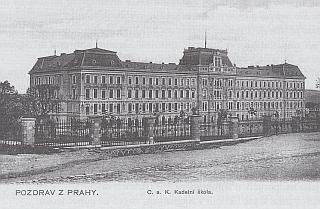
© Milan Hodík
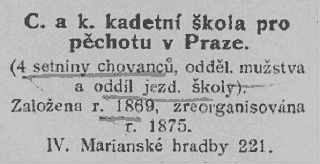
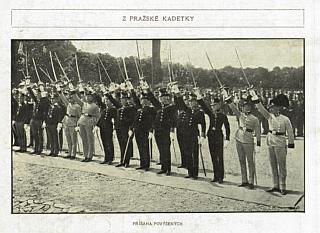
, 1913
Prager Infanteriekadettenschule is directly mentioned first time in the conversation between Generalmajor Generalmajor von Schwarzburg and Oberleutnant Lukáš after the infamous episode on the train to Tábor. Here Lukáš is asked where he absolved cadet school, and the answer is Prague.
When the author introduces Oberleutnant Lukáš in [I.14] the cadet school is mentioned but it was not revealed where it was located.
In [III.1], at the station in Győr, Hauptmann Ságner and station commander Bahnhofskommandant Zykán have a serious conversation. It is revealed that Ságner and Oberleutnant Lukáš were class-mates at the school, together with Zykán.
Background
Prager Infanteriekadettenschule refers to an infantry cadet school in Prague that was opened in 1869 and was situated in the northern part of Hradčany (from 1900 onwards). The building still exists and has had various functions since, including its use by Nazi and Soviet occupants. Today the building hosts the Czech Ministry of Defence.
The real life Čeněk Sagner actually attended this school from 1901 to 1905 whereas Rudolf Lukas did not. He graduated from Královo Pole (Königsfeld) by Brno. These two were the only infantry cadet schools on Czech lands. In addition Moravia hosted the only cavalry cadet school in the monarchy, in Hranice na Moravě (Mährisch Weisskirchen).
Cadet schools were institutions that educated active officers for the land forces. Most of them belonged to the infantry, but there were schools also for cavalry, artillery and pioneers. The education lasted for four years and beside military subjects general subjects were also taught. The graduates obtained the rank Fähnrich, until 1908 called Kadett-Stellvertreter. The schools' elite profile was underpinned by an arrangement were sons of officers paid much lower tuition fees than others.
Quote(s) from the novel
[II.1] „Pane nadporučíku,“ řekl, „kde jste navštěvoval kadetní školu?“ „V Praze.“ „Vy jste tedy chodil do kadetní školy a nevíte ani, že důstojník je zodpověden za svého podřízeného. To je pěkné.
[III.1] Pamatuji se jenom na to, že jsem jednou v kadetce v Praze vám pomáhal na hrazdu jako jeden ze staršího ročníku. Tenkrát jsme oba nesměli ven. Vy jste se pral s Němci ve třídě? Tam byl s vámi také Lukáš.
Sources: Milan Hodík
Also written:Infantry Cadet School PragueenPěchotní kadetní škola PrahaczPraha Infanterikadettskuleno
Literature
 | Táborské nádraží |  | ||||
| ||||||
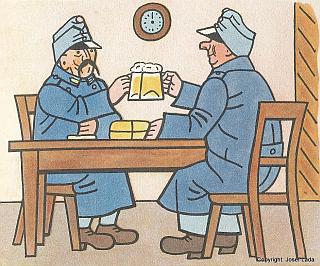
, 1955
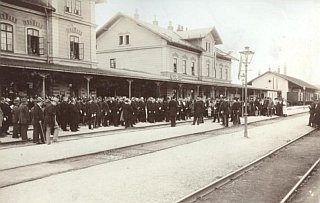
Bechyňská dráha, zahájení, nádraží, 1903
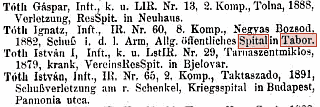
Wounded Hungarian soldiers in Tábor
, 9.1.1915
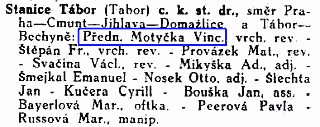
Táborské nádraží plays an important role in the plot because Švejk and Oberleutnant Lukáš's journey from Prague to Budějovice to join their regiment was unexpectedly interrupted here. This was after Švejk's many mishaps on the train, culminating in him pulling the emergency brake. As he couldn't pay the fine he had to leave the train to explain himself to the station master.
A benefactor at the station who were sympathetic to his plight paid the fine and gave him money for the trip onwards, but the money were spent at the station restaurant instead. Here Švejk treated a Hungarian reconvalescent with beer (one after the other) and the chance to buy a ticket onwards disappeared progressively with each beer.
Švejk was in the end discovered by a patrol and taken to the station's military commander who in the end ordered him to continue on foot. This was the beginning of his famous anabasis where he, despite his great enthusiasm, for a long timed struggled to join his regiment.
Tábor and the railway station is then mentioned several times when Wachtmeister Flanderka interrogates Švejk at Gendarmeriestation Putim. The soldier informs that station are easy to photograph because they don't move.
Background
Táborské nádraží is the railway station in Tábor, situated appx. 2 km east of the town centre. It is one of the major stops on the line Prague - Budějovice.
The railway station was built between 1869 and 1971 and was used by the company Kaiser Franz Josephs-Bahn[1] who operated the line Prague - Vienna. Other important stops on the line were Benešov, Veselí nad Lužnicí, Třeboň and Gmünd. The station was also served Budějovice and from 1903 the local train to Bechyně. In 1914 the station also served lines going east-west: Jihlava - Domažlice. Station manager in 1914 was Vincenc Motyčka so this was the person Švejk would have reported to (if his mishaps were based on any real-life incident).
Magyars in Tábor
It may at first sight appear strange that Švejk would meet a wounded Hungarian soldier in Tábor, far from the Hungarian heartlands. Further investigations do however reveal that it was quite likely. Tábor had a large hospital, good railway connections, and admitted wounded soldiers from all over the monarchy. Lists of wounded and infirm from early 1915 show up several Hungarian names at this hospital.
Outbreak of war also led to the establishment of temporary hospitals. Already in August 1914 Sokol put their building at the disposal for sick-beds and the waiting rooms at the station were used by the Red Cross. In january 1915 military hospitals were also established elsewhere in town. That there were several of them in Tábor is also mentioned by the author.
Hašek at the station?
Jaroslav Hašek didn't write much about Tábor in his short stories so it is unclear if he ever visited before World War I. In February 1915 there is however no doubt that the train that brought him to Budějovice to enrol in Infanterieregiment Nr. 91 must have stopped here. The contingent of Landsturm recruits that Hašek belonged to was called up on 15 February 1915 and he enlisted at the regiment two days later. Whether this delay was due to a stop-over in Tábor or simply a result of queues during enrolment is anybody's guess. In the novel the author mentions two propaganda posters that fit fairly well with mid February 1915, namely those of Trainsoldat Bong and Zugsführer Danko. There is no doubt that he saw the items, otherwise he wouldn't have been able to describe them so accurately. It does however turn out the these propaganda motifs were all from the Kriegskalender for 1919 and some of them even describing events from 1917 so the possibility that Hašek observed them in February 1915 is none. It should also be added that his description of the station restaurant as "third class" doesn't seem to correspond to facts. Photos and other information indicates that it was an up-market establishment. See Táborská nádražní restaurace.
Quote(s) from the novel
[II.1] Zůstal průvodčí se Švejkem a mámil na něm dvacet korun pokuty, zdůrazňuje, že ho musí v opačném případě předvést v Táboře přednostovi stanice. „Dobrá,“ řekl Švejk, „já rád mluvím se vzdělanejma lidma a mě to bude moc těšit, když uvidím toho táborskýho přednostu stanice.“
[II.1] Celý personál četnické stanice podíval se na sebe pátravě a strážmistr pokračoval: „V Táboře jste byl tedy na nádraží. Máte něco u sebe? Vyndejte to.“
[II.1] Strážmistr opět vyměnil s celým personálem stanice významný pohled. „Ty vaše kruhy, to mně připadá, že se potloukáte po okolí. Zdržel jste se dlouho v Táboře na nádraží?“
[II.2] Asi před týdnem, po svém příjezdu k pluku, podal jste mně raport o přidělení sluhy, poněvadž se vám váš sluha ztratil na nádraží v Táboře. Poněvadž se vrátil...
Also written:Tábor railway stationenTábor BahnhofdeTábor jernbanstasjonno
| 1. | Nationalised and incorporated into k.k. Staatsbahnen 1 May 1884. |
Literature
 | Táborská nádražní restaurace |  | ||||
| ||||||
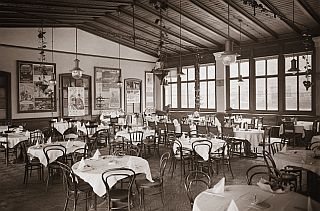
Interiér, Nádražní restaurace


, 4.6.1915
Táborská nádražní restaurace was a third class restaurant at the station in Tábor that was visisted by Švejk after he had to leave the train because of the episode with the emergency break. A friendly gentleman both paid his fine and also gave him a fiver for the journey onwards. Švejk however suffered the misfortune that he drank one beer after the other and he also invited a Hungarian reconvalescent to join him. The result was that he had no money left and had to continue on foot, thus starting on his famous anabasis.
Background
Táborská nádražní restaurace is today (2010) a basic bistro but earlier it was a large and up-market restaurant with a summer terrace. It was situated between the two main blocks of the station building.
A restaurant existed at the station already from 1871 when the station opened, and in 1886 it was run by Antonín Jonáš. Who ran the restaurant through the years is unknown but in 1913 Antonín Stětina was in charge. He seems to have gone bankrupt in the spring of 1914.
From 1914 Jan Zimák is officially listed as proprietor and he was also in charge when Jaroslav Hašek passed through Tábor in mid February 1915. From August 1914 Zimák also provided food for the Red Cross clinic that was set up at the station. In 1915 the restaurant advertised itself as elegant, with excellent food, serving draught beer from Pilsen. In 1932 it was still operating and not much had changed - and the beer was still from Pilsen. The landlord was now Karel Hokův and he was listed as owner also in 1939. What happened to the restaurant since then is not known.
The information we have about the restaurant does not correspond to the author's description of it as "third class" so it must be assumed that he didn't visit himself, and that Švejk's stop-over is inspired by events that took place elsewhere.
Quote(s) from the novel
[II.1] Mezitím dobrý muž věřící v nevinnost Švejkovu zaplatil za něho v kanceláři pokutu a odvedl si Švejka do restaurace třetí třídy, kde ho pohostil pivem, a zjistiv, že všechny průkazy i vojenský lístek na dráhu nalézají se u nadporučíka Lukáše, velkomyslně dal mu pětku na lístek i na další útratu. When this large scale restaurant ceased to exist is not known.
Also written:Tábor station restaurantenTábor BahnhofgaststättedeTábor stasjonsrestaurantno
Literature
 | Traineskadron Nr. 3 |  | ||||
| Kraków, ul. Zwierzynieckiej | ||||||
| ||||||

Verordnungsblatt für das k.u.k. Heer, 5.12.1914
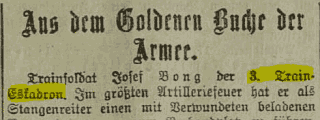
Grazer Tagblatt, 19.2.1915
,19.2.1915
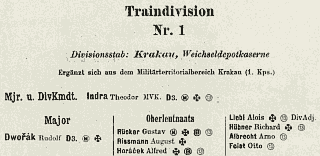
Schematismus für das K.u.k. Heer.., 1914
1914
Traineskadron Nr. 3 is mentioned as the unit where the Trainsoldat Bong performed his heroic deeds. This according to a propaganda poster Švejk observed at Táborské nádraží.
Background
Traineskadron Nr. 3 refers to the 3. squadron of Traindivision Nr. 1, a supply unit in k.u.k. Heer. Trainsoldat Bong was real enough, confirmed by several newspaper notices in early 1915.
Supply divisions
K.u.k. Heer had 16 Traindivisionen (supply divisions), numbered according to the army district from which they were recruited. Armeekorps Nr. 1 and the Kraków military distric covered western Galicia and parts of Silesia and Moravia and this is where Traindivision Nr. 1 were recruited from. Czech cities like Moravská Ostrava, Opava and Olomouc were thus within the district, together with notable Polish cities like Kraków, Cieszyn, Wadovice, Nowy Targ, and Tarnów.
The 16 train (supply) divisions consisted of a varying number of squadrons. Traindivision Nr. 1 was garrisoned in Kraków itself, in the so-called Weichseldepotkaserne (in 1918 renamed koszary Bartosza Głowackiego). It was located near the centre in ul. Zwierzynieckiej.
Head of Traindivision Nr. 1 since 1 November 1912 was Major Theodor Indra, from 1 May 1915 Oberstleutnant. A glance at the list of officers from 1914 reveals a curiosity: none of them had Polish surnames, all the officers seem to have been Czechs or Germans.
Quote(s) from the novel
[II.1] Zatímco šikovatel šel shánět nějakého důstojníka, Švejk si přečetl na plakátu:
VOZATAJEC JOSEF BONG
Vojáci zdravotního sboru dopravovali těžce raněné k vozům, připraveným v kryté úžlabině. Jakmile byl plný, odjelo se s ním na obvaziště. Rusové, vypátravše tyto vozy, počali je obstřelovati granáty. Kůň vozatajce Josefa Bonga od c. a k. 3. vozatajské švadrony byl usmrcen střepinou granátu. Bong bědoval: „Ubohý můj bělouši, je veta po tobě!“ Vtom sám zasažen byl kusem granátu.
Literature
 | K.k. Schützenregiment Nr. 21 |  | ||||
| St. Pölten, Schießstattring 8 | ||||||
| ||||||
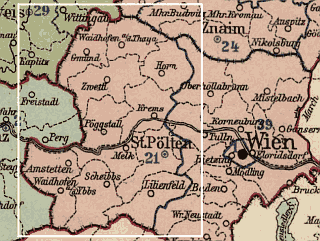
Landwehr-Ergänzungsbezirk Nr. 21, 1913
1913
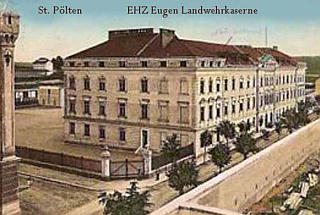
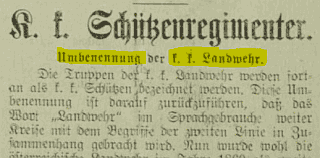
Eggenburger Zeitung, 6.4.1917

,Jänner 1918
K.k. Schützenregiment Nr. 21 is mentioned in passing as Švejk at the station in Tábor observes a propaganda poster that features Zugsführer Hammel, Korporal Paulhart, and Korporal Bachmayer. All three served in this regiment.
Background
K.k. Schützenregiment Nr. 21 was one of 37 Austrian k.k. Landwehr infantry regiments. Together with most of its peer units it was established in 1889. The recruitment district was St. Pölten and consisted of roughly the western half of current Niederösterreich. Some of the men were also recruited from the district Vienna B. Ethnically the regiment was almost entirely German. Staff and all three battalions were in 1914 garrisoned in St. Pölten. Commander in 1914 was Oberst Eduard von Dietrich[a].
The regiment was housed in a barrack complex at Schießstattring (Eugenkaserne, Rainerkaserne and Franz-Josephs-Kaserne), now Hesserkaserne[b].
During the war they first fought on the eastern front. In 1915 they were relocated to the Italian front and transported to Galicia in 1916 after the Brusilov offensive. Thereafter they were sent back to the south-west front where they took part in the advance on Piave in the autumn of 1917.
K.k. Landwehr ⇒ K.k. Schützen
It was only in 1917 that the term Schützenregiment (Rifle Regiment)[1] was officially introduced as all k.k. Landwehr units were renamed in April that year. This indicates that the author drew inspiration from propaganda material originating from late in the war, and not from what he himself may have witnessed in 1915. See the next paragraph for confirmation of this hypothesis.
1. The translation into English by Cecil Parrott erroneously concludes that this was an artillery regiment.
Tagliamento, 1917
The events that were described on the posters that Švejk observed in Tábor in early 1915 actually took place, but almost three years later. Zugsführer Hammel, Korporal Paulhart and Korporal Bachmayer all served in k.k. Schützenregiment Nr. 21 and they were mentioned together in a battlefield report in early 1918. The title was Das St. Pöltner Schützenregiment Nr. 21 am Tagliamento and it was printed in Streffleur's Militärblatt, Linzer Volkszeitung a.o. It dealt with the regiment's engagement by the river Tagliamento in northern Italy on 5 November 1917, and includes a few lines about the three soldiers who are mentioned in The Good Soldier Švejk. All three distinguished themselves during the battle and were awarded silver medals for bravery.
Korporal Paulhart and Korporal Bachmayer have been identified and information about them confirmed by their Belohnungsantrag whereas the identity of Zugsführer Hammel remains unclear (this may be due to a misspelling of his surname).
Not invented
In the novel Hašek states that these posters were created at k.u.k. Kriegsministerium by conscripted German journalists. This is mostly true, Egon Erwin Kisch was for instance one of them. On the other hand his claim that the people on the posters were "invented rare model soldiers" is untrue. Zugsführer Hammel, Korporal Bachmayer, Korporal Paulhart, Zugsführer Danko, and Trainsoldat Bong were all real enough but their exploits were obviously glorified for propaganda purposes.
Der Soldatenfreund. Kalender für das Jahr 1919
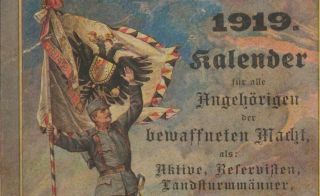

The inspiration for the propaganda posters that Švejk observed in Tábor is no doubt Kriegskalender, or more precisely: Der Soldatenfreund. Kalender für das Jahr 1919 and probably the Czech version of it. The reason that we can be so sure is that all the four motifs (six persons) that are described in this sequence of The Good Soldier Švejk also feature in the calendar. In addition, the text sequences that Hašek uses are more or less to the letter copies of text fragments from the calendar. In the case of Doctor Vojna even a spelling mistake in the surname found its way into The Good Soldier Švejk.
The motifs are fetched from pages 6 to 29 which is a pure calendar section. For each month there are two pages presenting a "shining role model of courage and gallantry". One page contains a drawing with a brief subtitle and on the next page. there is a detailed description of the heroic deed.
In the case of Zugsführer Danko and Zugsführer Hammel (with Korporal Paulhart and Korporal Bachmayer) the short subtitles are reproduced as is. In the case of Trainsoldat Bong, the entire description is copied almost to the letter. For Doctor Vojna it was different: only brief extracts from the description found their way into The Good Soldier Švejk and the soldier's vivid imagination provided the rest.
Quote(s) from the novel
[II.1] Dobrého vojáka Švejka uvítal obraz znázorňující dle nápisu, jak četař František Hammel a desátníci Paulhart a Bachmayer od c. k. 21. střeleckého pluku povzbuzují mužstvo k vytrvání. Na druhé straně visel obraz s nadpisem: „Četař Jan Danko od 5. pluku honvédských husarů vypátrá stanoviště nepřátelské baterie.“
Literature
- Das St. Pöltner Schützenregiment Nr. 21 am Tagliamento12.1.1918
- Das St. Pöltner Schützenregiment Nr. 21 am Tagliamento24.2.1918
- Geschichte von den Einundzwanzigern1917
- Der Oberste Kriegsherr und sein Stab1908
| a | Schematismus der k.k. Landwehr (s. 265) | 1914 | |
| b | Hesserkaserne |
 | K.u. Honvéd Husaren Regiment Nr. 5 |  | ||||
| Kassa (Košice) | ||||||
| ||||||

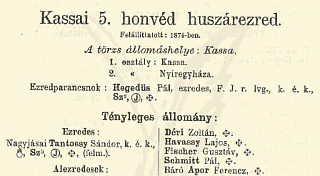
Honvédség és Csendőrség Névkönyve, 1914

Oesterreichische Volks-Zeitung, 21.10.1914
K.u. Honvéd Husaren Regiment Nr. 5 is mentioned in passing as Švejk at the station in Tábor observes a propaganda poster that features Zugsführer Danko from this regiment.
Background
K.u. Honvéd Husaren Regiment Nr. 5 (M. kir. 5. Honvéd Huszárezred) was one of 10 Hungarian Honvéd cavalry regiments. It was recruited from Honvéd district no. III Kassa (now Košice). Commander in 1914 was Oberst Pál Hegedűs. The regiment was garrisoned in Košice and Nyíregyháza.
During the war
Immediately upon outbreak of war the regiment was sent to the front in Galicia and had their baptism of fire on 15 August 1914 by Stojanów (now Стоянів) on the border with Russia. They experienced the disastrous defeat at the end of August that forced Austria-Hungary to abandon Lemberg. At the turn of the year they were fighting in the Carpathians and took part in the advance eastwards from early May 1915. By now they were however operating as foot soldiers. In the summer of 1916 they were moved to the front against Romania whereas the final year of the war was spent fighting on the Italian front.
Dankó János
In 1935 the regiment's history was published as a book. The history confirms that Zugsführer Danko, the soldier Švejk observed on a propaganda poster in Tábor, indeed was a Zugsführer in the regiment and took part in the early battles in Galicia. His Hungarian name was János Dankó but he may also have been a Slovak.
Quote(s) from the novel
[II.1] Dobrého vojáka Švejka uvítal obraz znázorňující dle nápisu, jak četař František Hammel a desátníci Paulhart a Bachmayer od c. k. 21. střeleckého pluku povzbuzují mužstvo k vytrvání. Na druhé straně visel obraz s nadpisem: „Četař Jan Danko od 5. pluku honvédských husarů vypátrá stanoviště nepřátelské baterie.“
Literature
 | Honvéd |  | ||||
| Budapest I., Szent György tér 3 | ||||||
| ||||||
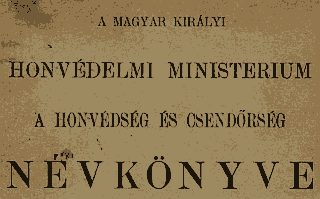
A Magyar Királyi Honvédelmi Ministerium, a Honvédség és Csendőrség Névkönyve 1895

Feldküche eines Honved-Infanterieregimentes
,20.8.1914

, 1910
Honvéd is mentioned many times in The Good Soldier Švejk, mostly from Királyhida and onwards. In [II.3] soldiers from Honvéd directly under the plot during the brawl in Királyhida. Before that they had been mentioned in connection with k.u. Honvéd Husaren Regiment Nr. 5 and also Hauptmann Spíro's listing the various branches of k.u.k. Wehrmacht.
Background
Honvéd (Magyar Királyi Honvédség) was the Hungarian land guard, an equivalent to the Austrian k.k. Landwehr. It consisted of 32 infantry regiments, 10 cavalry regiments, 8 field artillery regiment and various auxiliary functions. The Hungarian land guard was recruited from 6 districts (Budapest, Szeged, Kassa (Košice), Pozsony (Bratislava), Kolozsvár (Cluj), Zágráb (Zagreb)). Each infantry regiment consisted of three battalions and the service lasted for two years. The recruits were distributed between Honvéd and the Gemeinsame Armee by drawing lots, just like in Cisleithania.
Despite the names that suggest territorial armies both Honvéd and k.k. Landwehr were fully operative troops that during wartime were given much the same tasks as the common army. As opposed to k.u.k. Heer and the Austrian Landwehr the command language was Hungarian and also Croat[1].
Backround
The term Honvéd first appeared during the revolution and Hungarian uprising against Habsburg rule in 1848. The following year the rebellion was put down (with Russian help) and Honvéd was dissolved. After the 1867 Ausgleich they were reconstituted as a home defence force in Transleithanien and as such formed part of the military command structure of the Dual Monarchy.
The Honvéd ministery
Politically Honvéd reported to the Hungarian Royal Honvéd Ministry (Magyar Királyi Honvédelmi Minisztérium) that were located in Buda. Minister from 1910 til 1917 was general Samu Hazai (1851-1942), the highest ranking Jewish officer in the entire k.u.k. Wehrmacht. In 1917 he was succeeded by Sandor Szurmay (1860-1945) who thus became the last ever Honvéd minister. Honvéd was dissolved after World War I and today the term describes the entire Hungarian army.
Quote(s) from the novel
[II.1] Na druhé straně visel obraz s nadpisem: "Četař Jan Danko od 5. pluku honvédských husarů vypátrá stanoviště nepřátelské baterie."
[II.2] ... tyrolské císařské střelce, bosenské pěšáky, uherské pěší honvédy, uherské husary, ...
[II.3] Český voják vyspí se s maďarskou dívkou a ubohá česká děvečka přijme k sobě maďarského honvéda, a po staletích bude to zajímavé překvapení pro antropology, proč se objevily vysedlé lícní kosti u lidí na březích Malše.“
[II.3] Zato jsme jim to tam, tajtrlíkům maďarským, vodplatili pořádně u Neziderskýho jezera, na který jsme se šli před třemi tejdny podívat. Leží tam ve vedlejší vsi nějaký oddělení strojních pušek nějakejch honvédů, a my jsme náhodou všichni zašli do jedný hospody, kde voni tančili ten svůj čardáš jako pominutý a roztahovali si držku na celý kolo se svým ,Uram, uram, biró uram’ nebo ,Láňok, láňok, láňok a faluba’.
[II.3] Tak ten náš Mejstřík skočí do kola a tu největší fešandu chce brát jednomu honvédovi, kerej začal něco brebentit, a Mejstřík mu hned jednu hodil, ten se svalil, my už hned chytli überšvunky, votočili jsme si je kolem ruky, aby nám bajonety neulítly, skočili mezi ně, já jsem vykřik: ,Vinnej nevinnej, berte to po řadě!’ a už to šlo jako na másle.
[II.3] Pana Kákonyiho odtáhli do protějšího průjezdu, kde ho polívali vodou, a uprostřed ulice bil se starý sapér Vodička jako lev proti několika honvédům a honvéd-husarům, kteří se zastali svého krajana.
[II.4] "Netvař se tak vážně, Švejku, ono ti to na frontě přejde, prát se s nějakými honvédy," pokračoval, "líčení se s vámi oběma zastavuje a každý z vás jde k své části, kde budete potrestáni u raportu, a pak půjdete s marškou na frontu.
| 1. | In Honvéd units that were recruited from the autonomous kingdom of Croatia and Slavonia, the command language was Croat. |
Literature
 | Feldjägerbataillon Nr. 7 |  | ||||
| Canale (Kanal ob Soči) | ||||||
| ||||||
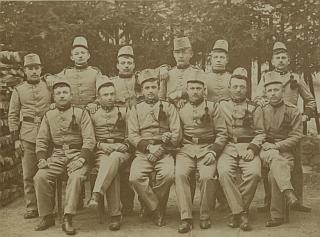
7. Feldjägerbataillon. Champagne in Tolmin
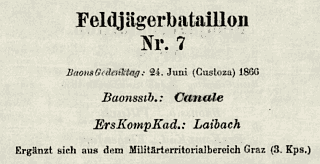
Schematismus für das k.u.k. Heer..., 1914
1914
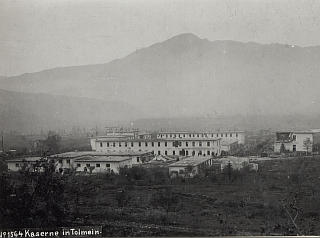
Kaserne in Tolmein
Feldjägerbataillon Nr. 7 is mentioned by Švejk in a conversation with a k.k. Landwehr soldier at the railway station in Tábor. Švejk has read in Pražské úřední listy about the heroic deeds of Doctor Vojna, a one-year volunteer from this battalion.
Background
Feldjägerbataillon Nr. 7 was one of 32 Feldjäger (light infantry) battalions in k.u.k. Heer. The regiment was formed as early as 1808 and took part in the campaigns against Italy around the middle of the century. The replacement battalion was located in Laibach (now Ljubljana). Staff and the troops were from 1905 to 1914 garrisoned in Canale and Tolmein[1] by the river Isonzo on the border with Italy, currently in Slovenia. The vast majority of the battalion's soldiers were Slovenes. Battalion commander in 1914 was Oberstleutnant Wilhelm Staufer. The battalion formed part of 94. Infanteriebrigade in Tolmein who in turn reported to 28. Infanteriedivision in Laibach.
Detailed information about the battalion during World War I is scarce. Österreich-Ungarns letzter Krieg reveals that they were now assigned to 56. Infanteriebrigade, still reporting to 28. Infanteriedivision, III. Korps, operating on the eastern front. In 1914 they were involved in battles by Gologóry, Jaroslav, Przemyśl, Homonna and Dukla. For the rest of the war it is difficult to trace them but in July 1916 they were fighting south of Valsugana on the Tirolean front. Their exploits here were even mentioned in the daily official war bulletins.
1. Slovenian: Kanal ob Soči, Tolmin
Quote(s) from the novel
[II.1] Když Švejk dočetl a šikovatel se ještě nevracel, řekl k landverákům na strážnici: „Tohle je moc krásnej příklad zmužilosti. Takhle budou u nás v armádě samý nový postroje na koně, ale když jsem byl v Praze, tak jsem čet v Pražskejch úředních listech ještě hezčí případ vo nějakým jednoročním dobrovolníkovi Dr Josefu Vojnovi. Ten byl v Haliči u 7. praporu polních myslivců, a když to přišlo na bodáky, tak dostal kulku do hlavy, a když ho vodnášeli na obvaziště, tak na ně zařval, že kvůli takovému šrámu se nenechá obvázat.
Literature
 | Pražské úřední listy |  | ||||
| Praha III./387, Karmelitská ul. 6 | ||||||
| ||||||

Adresář královského hlavního města Prahy a obcí sousedních, 1907
Pražské úřední listy is referred to by Švejk at the station in Tábor. In this paper he had read about the glorious deeds of the one-year volunteer Doctor Vojna from Feldjägerbataillon Nr. 7.
Background
Pražské úřední listy was a collective term that applied to the newspapers of c.k. Místodržitelství (k.k. Statthalterei) in Prague. These newspapers were mouthpieces of the Austrian authorities in Bohemia, headed by the Statthalter (governor). For more information see Pražské úřední noviny.
Quote(s) from the novel
[II.1] Když Švejk dočetl a šikovatel se ještě nevracel, řekl k landverákům na strážnici: „Tohle je moc krásnej příklad zmužilosti. Takhle budou u nás v armádě samý nový postroje na koně, ale když jsem byl v Praze, tak jsem čet v Pražskejch úředních listech ještě hezčí případ vo nějakým jednoročním dobrovolníkovi Dr Josefu Vojnovi. Ten byl v Haliči u 7. praporu polních myslivců, a když to přišlo na bodáky, tak dostal kulku do hlavy, a když ho vodnášeli na obvaziště, tak na ně zařval, že kvůli takovému šrámu se nenechá obvázat.
Also written:Prague Official NewspaperenPrager AmtsblattdePraha Amtsbladno
Literature



|
II. At the front |
 | |
2. Švejk's budějovická anabasis | |||
 | K.k. Landwehrinfanterieregiment Nr. 7 |  | |||
| Plzeň, Doudlevecká třída | |||||
| |||||
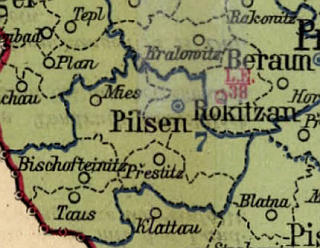
Landwehr-Ergänzungsbezirk Nr. 7, 1913
1913
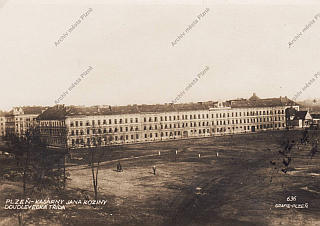
The barracks of LIR7, Plzeň
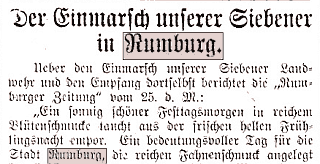
, 27.5.1915
K.k. Landwehrinfanterieregiment Nr. 7 is indirectly referred to through the term k.k. Landwehr in Pilsen. The old woman in Vráž tells Švejk about Toníček Mašků who was called up here.
Background
K.k. Landwehrinfanterieregiment Nr. 7 was one of 37 Austrian k.k. Landwehr infantry regiments and like most of its peer units it was established in 1889. The regiments was recruited from the districts Plzeň, Beroun and Písek. Staff and two battalions were in 1914 garrisoned in Pilsen, the other battalion in Rokycany. Commander in 1914 was Oberst Franz Sappe[a]. The barracks were located in Doudlevecká třida, south of the city centre[d] at Dobytčí trh, currently Štefánikovo náměstí.
During the war they first fought in Serbia, from February 1915 in the Carpathians, Galicia and Russian Poland, in 1916 in Bukovina and by the river Dniestr. In June 1917 they were transferred to the Italian front were they remained for the rest of the war, except from an interlude in Ukraine in early 1918[b].
During the first half of 1915 all replacement battalions from Czech-speaking areas were transferred to areas populated by other nationalities. This also applied to k.k. Landwehrinfanterieregiment Nr. 7 who were moved to Rumburg (Rumburk) in northern Bohemia, an region almost exlusively populated by Germans. They arrived in Rumburg in the morning of the 23 May 1915 [c]. In 1918 soldiers from the replacement battalon were involved in the so-called Rumburk rebellion and several of them were executed when the insurrection had been put down.
Kuděj
Hašek might have had second hand information from the regiment through his friend Zdeněk Matěj Kuděj who enrolled with them in 1902. He also participated in periodical exercises in 1905, 1909, 1911 and 1913 but during the war he got off lightly. Being called up as late as 1917 he never served at the front.
Quote(s) from the novel
[II.2] „U nás byl taky jeden takovej nezbeda. Ten měl ject do Plzně k landvér, nějakej Toníček Mašků,“ povzdechla si babička, „von je vod mojí neteře příbuznej, a vodjel. A za tejden už ho hledali četníci, že nepřijel ku svýmu regimentu. A ještě za tejden se vobjevil u nás v civilu, že prej je puštěnej domů na urláb. Tak šel starosta na četnictvo, a voni ho z toho urlábu vyzdvihli. Už psal z fronty, že je raněnej, že má nohu pryč.“
Literature
| a | Schematismus der k.k. Landwehr (s. 234) | 1914 | |
| b | LIR 7 - bojová cesta | 2014 | |
| c | Der Einmarsch unserer Siebener in Rumburg | 27.5.1915 | |
| d | Kolaudace zeměbraneckých kasáren |
 | Infanterieregiment Nr. 35 |  | ||||
| Plzeň/37, Palackého nám. 2 | ||||||
| ||||||

,1908
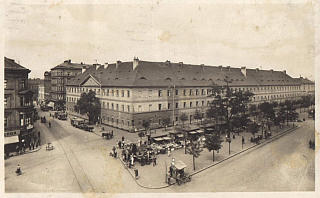
The barracks of IR35, Plzeň
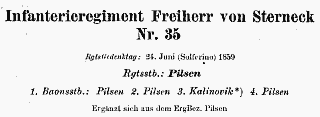
, 1914
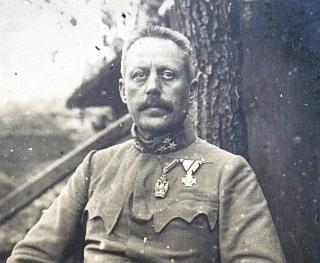
Until 1.2.1915 Oberstleutnant, Alfred Steinsberg was one of the senior officers in IR. 35. Here a picture from 1915, now as colonel and commander of IR. 91.
Infanterieregiment Nr. 35 is mentioned as Švejk sleeps over in a haystack by Putim and discovers that he is in the company of three deserters. Two of them are from IR 35. In [II.3] it is revealed that the soldier Koníček served in the regiment.
Background
Infanterieregiment Nr. 35 was one of 102 regular infantry regiments in k.u.k. Heer. It was also one of the oldest as it was formed as early as 1683[a]. During it's long history the regiment participated in several famous battles, amongst them: Vienna (1689), Aspern (1809), and Solferino (1859). The soldiers were recruited from Heeresergänzungsbezirk Nr. 35, Pilsen. Staff and three battalions were in 1914 garrisoned in Plzeň, whereas the third battalion in 1912 were relocated to Kalinovik in Bosnia. The regiment's barracks were located at Palackého náměstí, slightly west of the city centre.
Commander at the outbreak of war was Oberst Johann von Mossig. One of the other senior officers was Alfred Steinsberg[a] who 1 February 1915 assumed command of Infanterieregiment Nr. 91 and remained in that position during Jaroslav Hašek's time in the regiment.
During the war
From the beginning of the war until May 1915 battalions 1, 2 and 4 fought in Russian Poland by Komarów, in Galicia by Rawa Ruska, along the river San and east of Kraków, later in the Carpathians. The rest of 1915 and the time until September 1917 was spent in eastern Galicia where they on 2 July 1917 fought their own countrymen from the Legions at Zborów. The remainder of the war was spent on the Italian front[b]. The detached 3rd battalion never joined the bulk of the regiment, it operated first in Serbia, then on the Italian front[c].
Controversies
Infanterieregiment Nr. 35 was like some other Czech regiments accused of treason during World War I. During the battle of Zborówon 2 July 1917 many soldiers from the regiment were taken prisoner, leading to accusations of disloyalty, and consequently to investigations and debates in the newly re-assembled Reichsrat. There had also been an incident in September 1915 that led to the regiment's loyalty being questioned. The minister of defence in Cisleithania however concluded that were was no reason to distrust the regiment as a whole[e].
As a counter-point can be mentioned the book Bohemia's case for independence by Edvard Beneš (1917). Here it is claimed that the regiment defected and reached the Russian trenches half an hour after disembarking from the train[f]. This is obviously nonsense as it would take many hours for such a mass of soldier's with equipment just to get off a train and start marching. Nor did the troop transport trains travel close enough to the front for this even to be possible.
Ersatzbataillon
IR. 35's replacement battalion was on 14 June 1915 moved to Székesfehérvár[c] in Hungary as part of a larger initiative to "shield" recruits from presumed disloyal nations from the subversive influence of the local population. In Hungary was another one of Hašek's superiors, Karl Schlager, on 26 July 1915 appointed head of the regiment's convalescents unit and served here until the end of the war.
Songen om regimentet
The well known soldier's song Pětatřicátníci deals with this regiment and Švejk sings fragments from it twice. First he entertains Feldkurat Katz in [I.13] and then he sings for himself by Květov in [II.2][d]. The song didn't actually exists in 1915 as it was penned two years later.
Quote(s) from the novel
[II.2] Když se smích utišil, optal se Švejk, od jakého regimentu jsou oni. Zjistil, že dva jsou od 35. a jeden že je od dělostřelectva, taktéž z Budějovic. Pětatřicátníci že utekli před marškou před měsícem a dělostřelec že je od samé mobilisace na cestách.
[II.3] „Pro tyhle samý věci, pro takový sekýrování, zapích před léty u pětatřicátýho regimentu nějakej Koníček sebe i kaprála. Bylo to v ,Kurýru’.
Sources: Jaroslav Šerák
Literature
- Kasárna 35. pěšího pluku
- Z historie slavného 35.pěšího pluku a jeho kasáren
- Česši v rakouské armádě3.5.1916
- Der Oberste Kriegsherr und sein Stab1908
| a | Schematismus für das k.u.k. Heer (s. 447) | 1914 | |
| b | IR 35 - bojová cesta | 2014 | |
| c | Překládání náhradních těles jednotek z Čech | 2014 | |
| d | Kterou Švejk určitě nezpíval | Kuzma | 1.1.1966 |
| e | Das Verhalten tschechischer Regimenter an der Front | 15.6.1918 | |
| f | Bohemia's case for independence | 1917 |
 | Feldkanonenregiment Nr. 24 |  | ||||
| Budějovice, Pražská ul. | ||||||
| ||||||
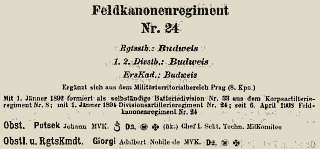
, 1914
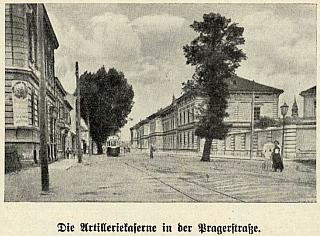
, 1930
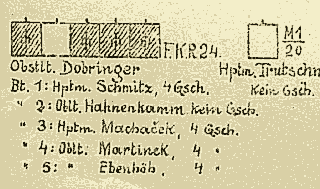
Ordre de bataille. 9th infantry division, 11.7.1915
© ÖStA
Feldkanonenregiment Nr. 24 is mentioned as Švejk sleeps over in a haystack by Putim and discovers that he is in the company of three deserters. One is from the artillery in Budějovice and would thus have been called up to this regiment. A few paragraphs further the author changes his mind and makes him a Dragoner (cavalry soldier). The deserter is from Putim and is the owner of the haystack. Later in the chapter Einjährigfreiwilliger Marek mentions artillery patrols and because the plot now is set in Budějovice the unit in question is again the 24th field artillery regiment.
Background
Feldkanonenregiment Nr. 24 was one of 42 field artillery regiments in k.u.k. Heer, garrisoned in Budějovice. It was established in 1892 and was recruited from Militärterritorialbereich Prag (8. Korps), i.e southern and western Bohemia and the area around the capital. In 1914 Oberleutnant Giorgi di Nobile was their commander. The regiment was housed in Erzherzog Wilhelm Kaserne, situated on the northern outskirts of the city.
During the war
The regiment was mobilised on the outbreak of war and with 9. Infanteriedivision sent to the front by the Drina where they took part in the failed attempts to invade Serbia. It was part of Feldartilleriebrigade Nr. 9 and consisted of five batteries[d].
In July 1915 the regiment was still assigned to 9. Infanteriedivision[b] so one must assume that they largely followed the route of Infanterieregiment Nr. 91 and other units in the division throughout the war. Jan Eybl's diaries[c] confirm that they operated on the Isonzo-front as part of this division in 1916.
The war-time history of the regiment until 1916 is therefore roughly as follows: Serbia August-December 1914, Carpathians February-May 1915, then Galicia and Volhynia until November before they were transferred to the Isonzo-front. In 1915 they took part in the battles by Sokal and Chorupan.
Sometime in spring 1916, they were renamed Feldkanonenregiment Nr. 9 and in 1918 Feldartillerieregument Nr. 9. Artillery regiments were also often moved around between divisions[e] so we have not investigated their whereabouts from 1916 onwards. It transpires from Ranglisten that their commander from 1915 to 1918 was Oberst Lorenz Dobringer.
Quote(s) from the novel
[II.2] Když se smích utišil, optal se Švejk, od jakého regimentu jsou oni. Zjistil, že dva jsou od 35. a jeden že je od dělostřelectva, taktéž z Budějovic. Pětatřicátníci že utekli před marškou před měsícem a dělostřelec že je od samé mobilisace na cestách.
[II.2] Napohlavkoval omylem jednomu poručíkovi od dělostřelectva v noci na náměstí v podloubí v opilém stavu. Vlastně ani nenapohlavkoval, srazil mu jenom čepici s hlavy. Stalo se to tak, že ten poručík od dělostřelectva stál v noci pod podloubím a patrně čekal na nějakou prostitutku.
[II.2] ...dá se chytit landveráckou nebo dělostřeleckou patrolou v noci...
[II.2] Mensch! Ještě štěstí, že to byl jen takový důstojník od dělostřelectva.“
[II.2] V tom posledním byla soustředěna všechna zášť 91. regimentu proti dělostřelectvu v Budějovicích. Běda dělostřelci, který padl v noci do rukou patroly od pluku a naopak. Zášť hrozná, nesmiřitelná, vendetta, krevní msta, dědící se z ročníku na ročník, provázená na obou stranách tradičními historkami, jak buď infanteristi naházeli dělostřelce do Vltavy, nebo opačně.
Literature
- Die Armee-Manöver in Süd-Böhmen3.9.1913
- Abmarsch und erste Gefechte der 2. Batterie des Feldkanonenregimentes Nr. 24 1924-1928
- Die 2. Batterie des Feldkanonenregimentes Nr. 24 am ersten Rückzuge aus Serbien und in den Tagen bis 5. September 19141924-1928
- Vojenské posádky v Budějovicích v roce 1906
- Kasárny
- Der Oberste Kriegsherr und sein Stab1908
| a | Schematismus für das k.u.k. Heer (s. 810) | 1914 | |
| b | ITD.9, Ordre de bataille | 11.7.1915 | |
| c | První světová válka v denících feldkuráta P. Jana Evangelisty Eybla | 2014,2015,2018 | |
| d | Kriegsgliederung | ||
| e | A-H Field Artillery Organization 1917/18 | 2001 - 2016 |
 | Švarcenberský ovčín |  | |||||
| Bavorov/12, Útěšov | |||||||
| |||||||
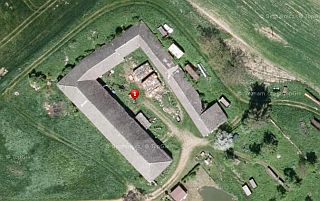
Ovčín u Leskovce.
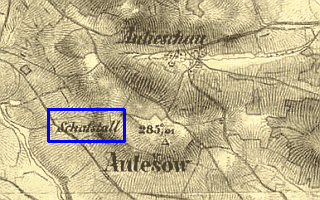
Švarcenberský ovčín was a place where Švejk stayed overnight in the company of an old wanderer (se Štěkeň) and an even older shepherd. Here, as elsewhere, he was assumed to have run away from the army. He was told many tales, amongst them stories of defectors from the Thirty Year War (here called the Swedish War) and the Napoleonic Wars. The earlier anecdote about Rittmeister Rotter is repeated, the name Jareš reappears, and Lipnice is mentioned for the first time. The latter indicates that this sequence of The Good Soldier Švejk was written shortly after 25 May 1921, the day Hašek moved to Lipnice.
Background
Švarcenberský ovčín was obviously a sheep-house that belonged to the Schwarzenberg estate. It is not known exactly where it was located, but according to Radko Pytlík and local sources, it could have been near Skočice and Protivín. This theory fits well both with the topography of the area, and the author's description. We know from the novel that it was a four hour walk from Štěkeň, that it was located in a forest, and that Švejk had a glimpse of Vodňany to his right when he appeared from the forest.
The large Schwarzenberg estate owned several sheep farms so it is difficult to guess which one the author had in mind. Hašek surely drew most of his knowledge about the area from summer holidays with his mother in 1896 and 1897 and also from stories told by his grandfather Jareš who was employed by Schwarzenberg.
Candidates
There was a sheep house in Albrechtice by Drahonice (near Skočice), a farm called Ovčín by Čepřovice, and another sheep farm in Leskovec by Bavorov. All of the three are more or less a four hours walk (appx. 15 km) from Štěkeň as stated in the novel.
Leskovec
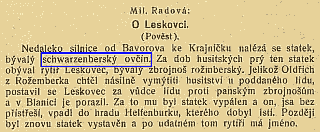
, 09.1936
Amongst the three Leskovec is no doubt the best fit to the description in The Good Soldier Švejk. As opposed to the two others it has been verified that it belonged to the Schwarzenberg family, more precisely their Libějovice estate[a]. When Švejk leaves in the morning he comes out of the forest and to the right he can see Vodňany. This makes sense considering the location of Leskovec. This candidate is further underpinned when the wanderer talks about "down in Skočice" (for the other two places this doesn't make sense). The Leskovec sheep-shed is seen on the military survey map from the mid 19th century and the large building seems to be intact still (2016). The address is Útěšov 12, Bavorov.
Quote(s) from the novel
[II.2] Dnes půjdeme na Strakonice,“ rozvinoval dál svůj plán. „Odtud čtyry hodiny je starej švarcenberskej ovčín. Je tam můj jeden známej ovčák, taky už starej dědek, tam zůstaneme přes noc a ráno se potáhnem na Strakonice, splašit tam někde ve vokolí civil.“
Sources: Jaroslav Šerák, Radko Pytlík, Miroslav Vítek
Literature
- Vzpurný Leskovec
- Popis okresního hejtmanství Píseckého1889
- Vznik, úpadek a vzkřížení osad na politicém okresu píseckém10.4.1886
- Bavorov15.4.1938
- Bavorov17.4.1940
| a | Po cestách Švejkovy budějovické anabáze | 2020 |
 | Hrad Lipnice |  | |||
| |||||
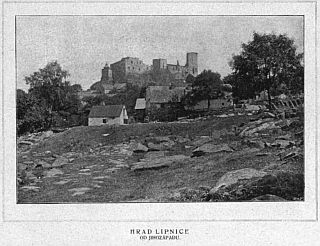
Království České, , 1912
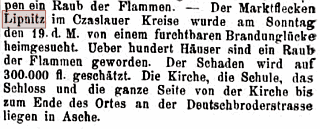
, 26.9.1869
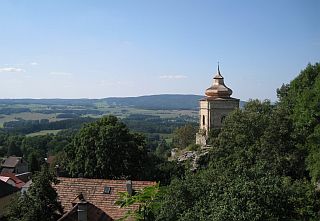
View from the castle 8.9.2009
Hrad Lipnice is mentioned when the tramp in Švarcenberský ovčín tells the story about that time when he was begging in Lipnice and he by accident knocked on the door of the police station that was located below the castle. Here he received such a whack that he ended up all the way down in Kejžlice.
Background
Hrad Lipnice was built at beginning of the 14th century and at the end of the 16th century it was altered in a renaissance style. In 1645, during the Thirty Year War, the Swedes occupied and partly destroyed the castle. The following centuries witnessed further decline and on 19 September 1869 the castle and Lipnice town were ravaged by a disastrous fire. In 1913 work began to safeguard and restore it, work that has continued on and off until today[a].
The castle is owned by the state and open to the public, provides guided tours, and is a major tourist attraction. The view from the top of the castle across Vysočina is spectacular.
Hašek and the castle
Jaroslav Hašek was very fond of the castle, spent considerable time there and also arranged drinking binges on the premises. He virtually had unlimited access because his friend forest warden Böhm gave him the keys. His favourite room there was the so-called "mazhaus"[b].
Quote(s) from the novel
[II.2] A zatímco ovčák cedil brambory a nalíval do mísy kyselé ovčí mléko, dělil se dál vandrák se svými vzpomínkami na četnické právo: „V Lipnici bejval jeden strážmistr dole pod hradem.
Sources: Radko Pytlík
Literature
- Lipnický hrad
- Hrad Lipnice1900
- Hrad Lipnice30.12.1924
- Lipnice Castle: the stone guardian of the Sázava region2018
| a | Hrad Lipnice | ||
| b | Toulavé house | 1971 |
 | Gendarmeriestation Lipnice |  | |||
| |||||
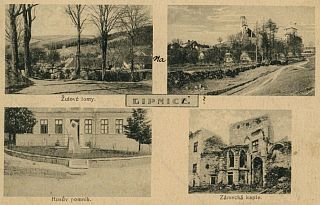
Postcard from Jaroslav Hašek to Marie Panušková, 26.9.1922 (page 6)
Gendarmeriestation Lipnice is mentioned when the tramp in Švarcenberský ovčín tells the story about that time when he was begging in Lipnice and he by accident knocked on the door of the police station that was located in a side street below the castle.
Background
Gendarmeriestation Lipnice was according to the tramp located below Hrad Lipnice in a side street but this doesn't say much as almost everything in Lipnice is somewhat below the castle. We can however deduce that it was not located on the square and seems to have been on the outskirts of town.
Hašek was surely referring to the location of the police station in 1921 but we can pretty safely assume that it would have been in the same building also before 1915. Exact details are difficult to get hold of without consulting the census records from 1910 or 1920. Information from an unofficial website about Lipnice does however indicate that the police station was located in the so-called činžák, a building next to the school that provided flats for rent[a]. The witness accounts quoted on this web page is however from the time around World War II so one can't take for granted that this was the location also 20-30 years earlier.
Dagmar Kalenská
Hned vpravo bokem školy stál takzvaný činžák. Byl to dům inteligence. Byly tu čtyři dvoupokojové byty a tři garsoniéry. V prvním patře zleva bydlela rodina Šulcových - četnická, pan Šulc měl dole vpravo úřadovnu.
František Bouma
O bezpečnost se starala četnická stanice v činžáku. Byli zde četnící p. Maxera a Šulc, posléze p. Vaňkát. Obec měla ještě obecního strážníka p. Pitche. Ten měl k dispozici na radnici obecní šatlavu.
Quote(s) from the novel
[II.2] A zatímco ovčák cedil brambory a nalíval do mísy kyselé ovčí mléko, dělil se dál vandrák se svými vzpomínkami na četnické právo: „V Lipnici bejval jeden strážmistr dole pod hradem. Bydlel přímo na četnické stanici a já, dobrák stará, pořád jsem byl všude v tý domněnce, že četnická stanice musí být přece někde na vystrčeným místě, jako na náměstí nebo podobně, a ne někde v zastrčenej uličce.
| a | Vzpominky |
 | Gendarmeriestation Putim |  | ||||
| ||||||

There was no gendarmerie station in Putim.
, 1915
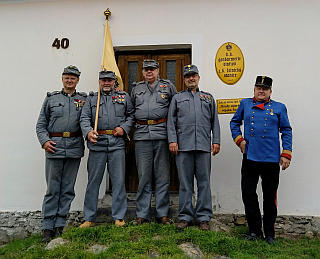
Putim no. 40 in 2020. This is a fictional location and the sign merely commemorates the casting of Steklý's film.
Gendarmeriestation Putim is the scene of Švejk's entire stay in Putim. Here he is suspected of being a Russian spy and interrogated by Wachtmeister Flanderka, the head of the local police.
Background
Gendarmeriestation Putim was a literary creation, an example of licensia poetica. There simply wasn't any k.k. Gendarmerie station in Putim in 1915 or during the preceding years. Putim was organised under the Písek station and there was also an office in nearby Protivín.
Steklý's film
In 1957 the de-facto standard Czech film about The Good Soldier Švejk was released, directed by Karel Steklý. For casting purposes building no. 40 was selected as the police station and by the entrance was mounted a sign that still remains in place (2020).
The film is still very popular, and most Czechs know Švejk only from the film. This obviously has had a profound effect on how Czechs perceive the good soldier. Because the film fails to convey the satirical edge of the novel, most people regard The Good Soldier Švejk as a comedy and nothing more. This distortion is particularly evident in Putim where a disproportionate amount of the cast is set. It even includes a tedious invented comic scene where Švejk pushes his drunk police escort to Písek in a wheelbarrow.
Quote(s) from the novel
[II.2] Četník se sarkasticky usmál: „Vy jdete přece od Budějovic. Máte ty vaše Budějovice už za sebou,“ a vtáhl Švejka do četnické stanice.
Sources: Václav Pixa, Miroslav Vítek
Literature
 | Na Kocourku |  | ||||
| ||||||
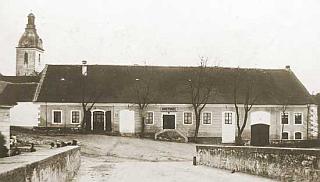
Stará hospoda, Putim č.p. 42

, 1915
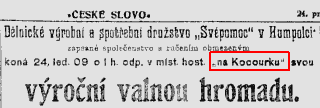
,24.12.1908
Na Kocourku was a pub in Putim where the gendarmes sent old Pejzlerka to fetch food and drink. There is no description of the inn apart from that Pejzlerka told the innkeeper what was going on over at Gendarmeriestation Putim.
Background
Na Kocourku was according to The Good Soldier Švejk a pub in Putim. In 1914 there existed three inns in the village: U Srnků at no. 9 (where the large U Cimbury is today), U Pavlů at no. 7, and Stará hospoda (U Žižků) at no. 42[a].
The latter is the more likely candidate but as the whole Putim section of the plot (including the police station) is not based on historical circumstances one shouldn't put too much emphasis on the details conveyed in The Good Soldier Švejk.
Name from Humpolec?
In the years before World War I there existed a well known public house Na Kocourku in Humpolec[b] and if it was still operating after the war Hašek may well have been aware of it or even visited. Humpolec is only 11 km from Lipnice and by the time Hašek wrote this part of the novel he had already moved to Lipnice. In 2023 Jakub Vazač confirmed that the pub was operating until after 1980 and that the address was Havlíčkovo nám. 90.
Quote(s) from the novel
[II.2] „Tohle je velká výjimka,“ důstojně řekl strážmistr, „to je nějaký vyšší důstojník, nějaký štábní. To víte, že Rusové na špionáž sem nepošlou nějakého frajtra. Pošlou mu do hospody ,Na Kocourku’ pro nějaký oběd. Jestli už nic není, ať uvaří něco.
[II.2] Od té doby neměl četnický strážmistr informátora a musel se spokojit tím, že si vymyslil jednoho, udav fingované jméno, a zvýšil tak svůj příjem o padesát korun měsíčné, které propíjel v hospodě Na Kocourku.
[II.2] Neobyčejné četné stopy těžkých velkých bot báby Pejzlerky na té spojovací linii svědčily o tom, že strážmistr si vynahražuje plnou měrou svou nepřítomnost na Kocourku.
Sources: Václav Pixa, Jakub Vazač, Jaroslav Šerák
| a | Hospody v Putimi | ||
| b | Výroční valnou hromadu | 24.12.1908 |
 | Okresní soud Písek |  | |||
| Písek/119, Velké nám. 13 | |||||
| |||||

Velké náměstí in Písek (1917). The large building to the left housed the regional court, the smaller building next to it the district court.
© Písecký deník
Okresní soud Písek is mentioned in connection with Wachtmeister Bürger at Gendarmeriestation Putim who never bothered to interrogate suspects and instead passed them directly to the district court in Písek. This was an entirely different approach to that of his vigilent successor Wachtmeister Flanderka.
Background
Okresní soud Písek was an institution that was part of the judiciary of Austria, and exists also today (2021). It resided on the southern part of Velké náměstí, down towards Otava and adjacent to the larger Krajský soud Písek.
Quote(s) from the novel
[II.2] Vzpomněl si na svého předchůdce strážmistra Bürgera, který se zadrženým vůbec nemluvil, na nic se ho netázal a hned ho poslal k okresnímu soudu s krátkým raportem: „Dle udání závodčího byl zadržen pro potulku a žebrotu.“ Je to nějaký výslech?
Also written:Písek District CourtenBezirksgericht PísekdeDistriktsretten Písekno
 | Landesgendarmeriekommando Prag |  | |||
| Praha III./388, Karmelitská 2 | |||||
| |||||
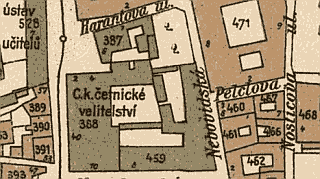
K.k. Landesgendarmeriekommando Nr. 2 für Böhmen
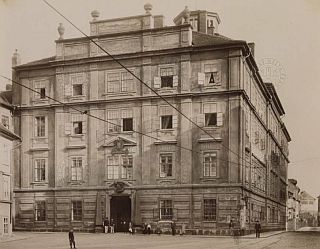
Pohled do Karmelitské ulice s domem čp. 388 na Malé Straně (četnická kasárna), 1904
Landesgendarmeriekommando Prag is mentioned by the author when he explains in detail how the HQ of k.k. Gendarmerie in Prague floods the police stations with directives that mostly were stamped "strictly confidential".
Background
Landesgendarmeriekommando Prag (zemské četnické velitelství v Praze) refers to the headquarters of k.k. Gendarmerie in Bohemia. It was number 2 of the 14 gendarmerie country commands in Cisleithania.
Their location was Gendarmeriekaserne in Malá Strana, in a group av buildings at the junction of Karmelitská and Harantova.
The institution supervised a total of 29 Gendarmerieabteilungskommandos where the most important in a The Good Soldier Švejk context was No. 14 in Písek. Commander in chief of k.k. Gendarmerie in Bohemia in 1914 was Václav Řezáč (colonel)[a].
Quote(s) from the novel
[II.2] A strážmistr dívaje se na stránky svého raportu se usmál se zadostiučiněním a vytáhl ze svého psacího stolu tajný reservát zemského četnického velitelství v Praze s obvyklým „Přísně důvěrné“ a přečetl si ještě jednou:
[II.2] Zemské velitelstvo nařizuje proto zadržet všechny podezřelé a zejména zvýšiti bedlivost v těch místech, kde v blízkostí nalézají se posádky, vojenská střediska a stanice s projíždějícími vojenskými vlaky.
[II.2] Na zemském četnickém velitelství v Praze nestačili je rozmnožovat a rozesílat.
[II.2] a že zemské četnické velitelství ho připraví o poslední špetku rozumu a že se nebude moci těšit z vítězství rakouských zbraní
| a | Schematismus der k.k. Landwehr (s. 476) | 1914 |
 | K.k. Innenministerium |  | |||
| Wien I., Judenplatz 11 | |||||
| |||||
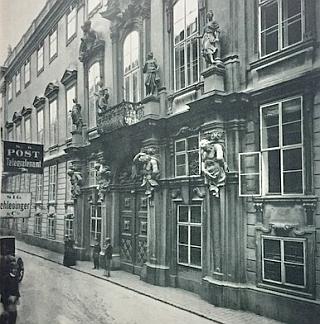
K.k. Ministerium des Innern (Wipplingerstraße)
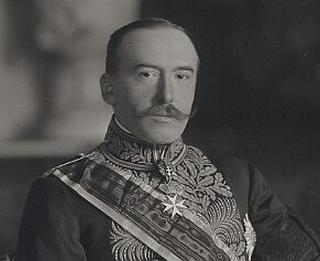
Innenminister 1911-1915, Karl Heinold
K.k. Innenministerium is mentioned by the author when he in detail describes how the ministry floods the police with directives on how to keep an eye on the population and their attitudes to the war. They even created a classification for degrees of loyalty.
Background
K.k. Innenministerium (cz. ministerstvo vnitra) was the ministry of interior of Cisleithania, on of the nine ministeries in the Austrian part of the Dual Monarchy. It was housed in am enormous building between Judenplatz and Wipplingerstraße in the centre of Vienna. Minister of the interior from 1911 to 1915 was Karl Heinold von Udyński.
As opposed to like-named ministries in other countries and also what is suggested in The Good Soldier Švejk, this ministry had little to do with inner state security. Their main task seems to have been public health and during World War I they were accordingly in charge of the prisoner of war camps.
Quote(s) from the novel
[II.2] Bylo jich mnoho, které vypracovalo ministerstvo vnitra za součinnosti ministerstva zemské obrany, kterému podléhalo četnictvo.
[II.2] Zaplaven tou spoustou vynálezů rakouského ministerstva vnitra, strážmistr Flanderka měl ohromnou spoustu restů a dotazníky zodpovídal stereotypně, že je u něho všechno v pořádku a loyalita že je mezi místním obyvatelstvem stupnice I.a.
[II.2] Rakouské ministerstvo vnitra vynalezlo pro loyalitu a neochvějnost k mocnářství tyto stupnice: I.a, I.b, I.c - II.a, II.b, II. - III.a, III.b, III. - IV.a, IV.b, IV.c.
[IV.1] Rakouské ministerstvo vnitra tápalo ještě ve tmách, pokud se týkalo zjištění nějaké bojovné organisace z přeběhlíků na ruskou stranu. Neznalo ještě nic určitého o revolučních organisacích v cizině a teprve v srpnu na linii Sokal - Milijatin - Bubnovo obdrželi velitelé batalionů důvěrné reserváty, že bývalý rakouský profesor Masaryk utekl za hranice, kde vede proti Rakousku propagandu.
Also written:I.R. Interior MinistryenC.k. ministerstvo vnitracz
Literature
- Heinold von Udynski (Udyński)10.12.2019
| c | Grégrova příručka | 1912 |
 | K.k. Ministerium für Landesverteidigung |  | |||
| Wien I., Babenbergerstraße 5 | |||||
| |||||
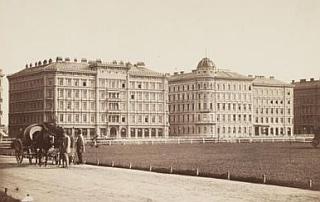
Babenbergerstraße
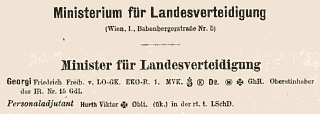
Schematismus der K. K. Landwehr..., 1914
1914
K.k. Ministerium für Landesverteidigung is mentioned by the author when he in detail describes how the ministry floods the police with directives on how to keep an eye on the population and their attitudes to the war. They even created a classification for degrees of loyalty.
Background
K.k. Ministerium für Landesverteidigung (Ministry for National Defence) was the ministry of defence in Cisleithania, i.e. the Austrian part of the Habsburg empire. It was in charge of k.k. Landwehr and also k.k. Gendarmerie. In peace time their task was primarly inner security whereas after the outbreak of war Landwehr became a fully functional army.
Secretary of home defence from 1907 to 1917 was Friedrich von Georgi. See Minister für Landesverteidigung.
Quote(s) from the novel
[II.2] Bylo jich mnoho, které vypracovalo ministerstvo vnitra za součinnosti ministerstva zemské obrany, kterému podléhalo četnictvo.
[II.2] V příloze B1 zasílá se účet za stravování dotyčného k laskavému převedení na účet min. zem. obrany s žádostí o potvrzení přijetí předvedeného.
Also written:I.R. Land Defence MinistryenC.k. ministerstvo zemské obranycz
Literature
- Grégrova příručka1912
- Friedrich Freiherr von Georgi2001 - 2016
 | K.k. Gendarmerie |  | |||
| Wien I., Opernring 6 | |||||
| |||||
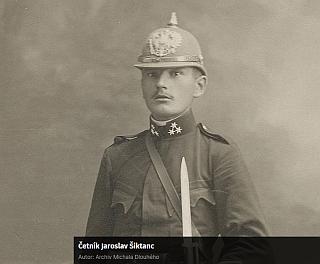
© Michal Dlouhý
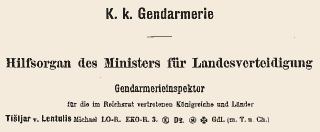
K.k. Gendarmerie is mentioned by the author when he in detail describes how k.k. Ministerium für Landesverteidigung to which the gendarmery reported floods the police stations with directives on how to keep an eye on the population and their attitudes to the war.
Background
K.k. Gendarmerie (c.k. četnictvo) was an armed state police force of Cisleithania, responsible for public order and homeland security. It's history goes back to 1848 but at the time it operated in the entire Habsburg emprire, an situation that changed after Ausgleich. As the author correctly notes it reported to k.k. Ministerium für Landesverteidigung where its official role was assisting body to the ministry (Hilfsorgan). It was organised as a military unit and the policemen were classed as soldiers. During the war they were also serving in the field, mainly as military police, so-called Feldgendarmen.
In 1914 the institution was headed by General Michael Tišljar von Lentulis[a]. His title was Gendarmerieinspektor and his office was located at Opernring 6 whereas other parts of the administration were housed at the defence ministry's building in Babenbergerstraße 5.
At the outbreak of World War I gendarmerie force counted nearly 15,000 men[b] and was organised in 14 Landesgedarmeriekommandos where no. 2 (see Landesgendarmeriekommando Prag) is the most relevant in the context of The Good Soldier Švejk. These in turn supervised a number of Gendarmerieabteilungskommandos (29 in Bohemia) that again managed a few Bezirksgendarmeriekommandos. The lowest unit was the Gendarmeriestation (or Gendarmeriepost) that in the countryside (like at Gendarmeriestation Putim) counted one or two police officials, generally headed by a Wachtmeister.
Quote(s) from the novel
[II.2] Bylo jich mnoho, které vypracovalo ministerstvo vnitra za součinnosti ministerstva zemské obrany, kterému podléhalo četnictvo.
Literature
| a | Schematismus der k.k. Landwehr (s. 465) | 1914 | |
| b | Polizeigeschichte |
 | U černého koně |  | ||||
| ||||||

Pubs is Protivín 1915
1915
U černého koně was a pub in Protivín where gendarm Rampa was playing cards with some shoemakers even when on duty.
Background
U černého koně was according to the novel the name of a pub in Protivín. In the address book of 1915 there were 13 public houses in the town but as they are listed by owners it is impossible to tell if any of them was named U černého koně. Miroslav Vítek has even investigated the census records from 1910 and concludes that none of the 15 hostelries in town seem to have had such a name[a].
Inspiration from elsewhere?
U černého koně was the name of hotels and restaurants in various places in Bohemia, a.o. in Prague, Beroun and Domažlice. There is however no indication that Hašek had any connection to any of those. He would at least have been aware of the one in Prague at Na Příkopě and also may have stumbled upon the other two on his travels to Domažlice in 1904 and Beroun in 1913. Jihočeské listy, 31.10.1914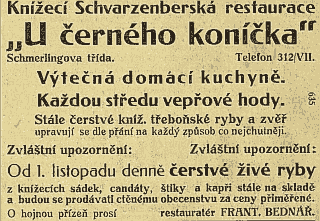
A more likely though still far-fetched source of inspiration is U černého koníčka/Zum Schwarzen Rössl (The little black horse) in Budějovice[b], a restaurant located a few steps from k.u.k. Reserve-Spital where Hašek was receiving treatment from 6 March 1915 onwards. From the hospital he allegedly escaped with his Krankenbuch like his alter ego Einjährigfreiwilliger Marek did in The Good Soldier Švejk. To our knowledge it has not been recorded that he visited the pub but given the location it would be no surprise if he dropped by.
The restaurant was owned by the Schwarzenberg dynasty and served beer from their Třeboň brewery. The address in 1915 was Schmerlingová třída 540/28, now Žižkova třída. Attached was a cinema called The Royal Biograf[c]. The landlord in 1915 was František Bednář. The restaurant has been operation since 1854, is still functioning, and serves beer from Protivín (2011).
Quote(s) from the novel
[II.2] Strážmistr zůstal sedět na strážnici vedle Švejka na kavalci prázdné postele četníka Rampy, který měl do rána službu, obchůzku po vesnicích, a který v tu dobu klidně seděl „U černého koně“ v Protivíně a hrál s obuvnickými mistry mariáš, vykládaje v přestávkách, že to Rakousko musí vyhrát.
Also written:The Black HorseenDen svarte hestno
Literature
- Zum Schwarzen Rössl31.1.1914
| a | Po cestách Švejkovy budějovické anabáze | 2020 | |
| b | Hostinec U Černého koníčka existoval již před rokem 1854. Měl k dispozici stáje pro 40 koní | 28.7.2016 | |
| c | The Royal Biograf | 31.12.1909 |
 | Schönbrunn |  | |||
| Wien XIII./1 | |||||
| |||||
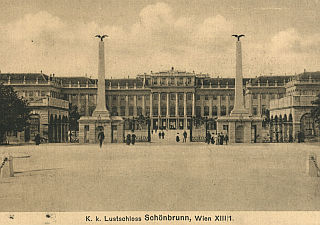
Schönbrunn, 1911
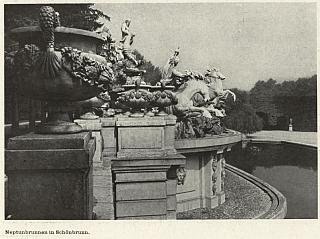
Schönbrunn is mentioned when it is revealed what unpatriotic utterances appeared during the policemen's drinking binge Gendarmeriestation Putim. Emperor Franz Joseph I. had to be locked away in the toilets to prevent him from shitting all over Schönbrunn it was claimed.
In [II.3] the zoo by the castle is mentioned. See Schönbrunner Menagerie.
Background
Schönbrunn is a palace in Vienna that served as the summer residence of the Emperor until the monarchy was abolished in 1918. Today it is mostly a museum and is on the UNESCO World Heritage list. The palace has 1441 rooms and is on of the major tourist attractions of Wien.
Schönbrunn dates back to the 18th century and associated with the palace is a large park, the zoo Schönbrunner Menagerie and various lesser buildings. It is located in Hietzing in XIII. Bezirk, on the south-western outskirts of the city.
It was here that Emperor Franz Joseph I. was born on 18 August 1830[a].
Quote(s) from the novel
[II.2] Závodčí se zastavil u okna, a bubnuje na ně, prohlásil: „Vy jste si také, pane strážmistr, nedal ubrousek na ústa před naší bábou a pamatuji se, že jste jí řekl: ,Pamatujou, bábo, že každý císař a král pamatuje jen na svou kapsu, a proto vede válku, ať je to třebas takový dědek jako starý Procházka, kterého nemohou už pustit z hajzlu, aby jim nepodělal celý Schönbrunn.’„
[II.3] Vídeň je vůbec důležité město,“ pokračoval, „jenom co mají divokejch zvířat v tej schönbrunnskej menažerii. Když jsem byl před lety ve Vídni, tak jsem se nejradši chodil dívat na vopice, ale když jede nějaká osobnost z císařskýho hradu, tak tam nikoho nepouštěj přes kordon. Byl se mnou jeden krejčí z desátýho okresu a toho zavřeli, poněvadž chtěl mermocí ty vopice vidět.“
Literature
| a | Wien, den 18. August | 19.8.1830 |
 | Bezirksgendarmeriekommando Pisek |  | |||||
| Písek/262, Pražská ul. 17 | |||||||
| |||||||
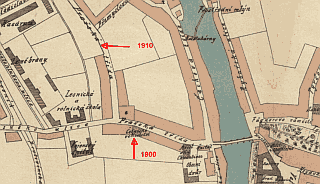
Gendarmeriekommando in 1900 and 1910
Královské město Písek, , 1898
Bezirksgendarmeriekommando Pisek is the scene of the end of Švejk's Anabasis. Rittmeister König soon verified that Švejk was no Russian spy, and dispatched him immediately to his regiment in Budějovice.
Background
Bezirksgendarmeriekommando Pisek (Okresní četnické velitelství) was the former state police headquarters in hejtmanství Písek. The police station was in the inter-war years located in Pražská ulice čp. 262[a] and presumably this was also the case in 1915. This is however at odds with information found in a book from 1898 where a map shows some police station much closer to the town centre but still in the same street[b], in house number 181.
Gendarmerie in Písek

Kolský seems to have served diligently
, 16.11.1918
In Písek k.k. Gendarmerie was present on two command levels. The lowest ranked of the units was the one we know from The Good Soldier Švejk: Bezirksgendarmeriekommando. In 1915 it was commanded by Wachtmeister Antonín Kolský[c], an indication that Rittmeister König firmly belongs in the category of fiction. Kolský's department was responsible for 13 gendarmerie posts in the area, amongst them Vráž, Protivín, Bavorov, Mitrovice and Vodňany.
His unit reported to Abteilungskommando Nr. 14 that again reported to Landesgendarmeriekommando Prag. Abteilungskommando was from 1910 to 1916 headed by a person familiar to readers of The Good Soldier Švejk, the well known policeman and dog expert Rittmeister Rotter, a person Hašek knew. Apart from the Písek district his department supervised the districts of Strakonice and Blatná, and Rotter's unit counted 91 gendarmes.
Location

, 1915
Rittmeister Rotter's office was at Pražská čp. 262, this is confirmed by the 1910 census records[d]. On this address were three flats: one for Rotter and his family (with servants), one for another tenant, and the third for lower ranking gendarmes. In this flat lived four Wachtmeister, one assistant and one female servant. Our unconfirmed assumption is that also Bezirksgendarmeriekommando resided at this address because there was no longer any k.k. Gendarmerie presence at the former address at Pražská čp. 181.
Quote(s) from the novel
[II.2] Zítra ho budeme lifrovat do Písku, k panu okresnímu.
[II.2] Četnickému strážmistrovi Flanderkovi se situace, čím déle psal tou podivnou úřední němčinou, vyjasňovala, a když skončil: "So melde ich gehorsam, wird der feindliche Offizier heutigen Tages, nach Bezirksgendarmeriekommando Písek, überliefert"
[II.2] Strážmistr vyzval Švejka, aby šel zas na strážnici, a rychle, aby nezapomněl, připsal do svého raportu na okresní četnické velitelství v Písku: "Ovládaje dokonale český jazyk, chtěl se v Českých Budějovicích pokusit vstoupit do 91. pěšího pluku."
[II.2] Závodčího zmocnila se naprostá deprese, a když po hrozném utrpení pozdě večer dorazili do Písku k četnickému velitelství, na schodech řekl úplně zdrceně závodčí Švejkovi: „Teď to bude hrozné. My od sebe nemůžem.“ A opravdu bylo to hrozné, když strážmistr poslal pro velitele stanice, rytmistra Königa. První slovo rytmistrovo bylo: „Dýchněte na mne.“ „Teď to chápu,“ řekl rytmistr, zjistiv nesporně situaci svým bystrým, zkušeným čichem, „rum, kontušovka, čert, jeřabinka, ořechovka, višňovka a vanilková.
Also written:Regional State Police HeadquartersenOkresní četnické velitelstvícz
Literature
- Domácí odboj v Písku15.9.1934
| a | Historie | ||
| b | Královské město Písek | 1898 | |
| c | Chytilův úplný adresář Království Českého | 1915 | |
| d | Sčitání lidu 1910 |
 | Infanterieregiment Nr. 11 |  | ||||
| Písek, Svatoplukova ul. | ||||||
| ||||||
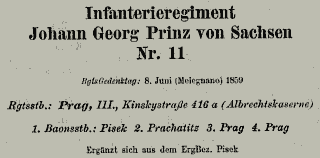
, 1914
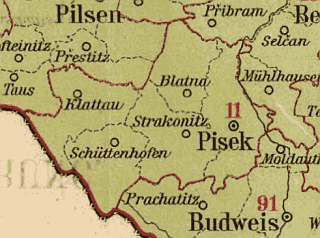
Heeresergänzungsbezirk Nr. 11
, 1911
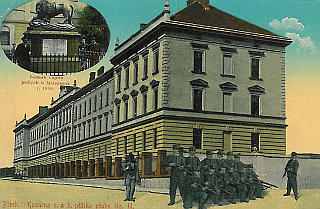
, 20.10.1910
Infanterieregiment Nr. 11 is mentioned by the author when he describes the state of affairs and general mood in the area at the time when Švejk is handed over to Bezirksgendarmeriekommando Pisek. Rebellion is in the air and battalions from Infanterieregiment Nr. 28 and Infanterieregiment Nr. 11 have crossed over to the enemy in Serbia and in the Carpathians.
Background
Infanterieregiment Nr. 11 (pěší pluk č. 11) was one of 102 Austro-Hungarian infantry regiments. According to Schematismus[a] it was founded in 1629 and was as such the oldest infantry regiment in the entire k.u.k. Heer [a]. The name Infanterieregiment Nr. 11 is however much more recent; it dates back to 1873. From 1854 onwards the regiment was recruited from the Písek area and the city was also home of the replacement battalion and at least one of the four regular battalions.
Due to its long history the regiment took part in nearly every war the Habsburg empire was involved in: The Thirty Year War, the War of Austrian succession, the Napoleonic wars and the campaigns in northern Italy during the mid 19th century. The regiment's memorial day was 8 June 1859, commemorating the battle of Melagnano.
Recruitment and garrison
Heeresergänzungsbezirk Nr. 11 (recruitment district) encompassed five hejtmanství: Písek, Strakonice, Sušice, Klatovy and Blatná. Eighty per cent of the men were of Czech nationality. Almost all the places mentioned in Švejk's anabasis fell within the district which also included Kašperské Hory, a place mentioned after Švejk's march battalion left Királyhida.
It was customary in Austria-Hungary to move regiments around in various parts of the empire and it rarely occurred that an entire regiment served in the same location. The four (sometimes three) battalions of an infantry regiment was usually located in 2-3 places, and this was also the case with Infanterieregiment Nr. 11. In 1914 staff and 3rd and 4th battalion were located in Prague (Albrechtkaserne), 1st battalion in Písek and 2nd battalion in Prachatice[a]. In Písek the local units of the regiment were originally housed in the barracks in the city centre, but at the turn of the century new barracks were built in Pražské předměstí (the Prague suburb), next to the already existing barracks of k.k. Landwehrinfanterieregiment Nr. 28.
During the war
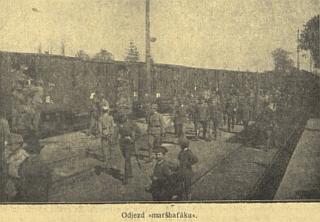
, 25.12.1915
The regiment was mobilised at the outbreak of war and as part of Prague's 9. Infanteriedivision[1] sent to the Drina front as part of the 5th army and VIII. Korpskommando[f]. Together with IR73 they formed 18. Infanteriebrigade. They took part in the three failed invasions of Serbia in the autumn of 1914. Forced into a calamitous withdrawal onto Hungarian soil around 20 December, they were in early February 1915 transferred to the Carpathians. 11 March was to become the worst day in the regiment's World War I history. By Smolnik a part of the regiment was crushed and 777 men with 40 officers were killed, captured or reported missing. From early May they took part in the Central Powers' offensives in Galicia and Volhynia. In November 1915 they were transferred to the Isonzo-front east of Monfalcone, on the so-called Karst-plateau in current Slovenia. Here they remained until October 1917 (apart from a short interlude south of Trento in early summer 1916). In September 1916 they were placed under the command of 28. Infanteriedivision. The regiment took part in the advance into Italy after the October breakthrough at Caporetto and in November they reached Piave where they saw out the rest of the war.
Until September 1916 their battlegrounds were roughly the same os those of their sister regiments in 9th division. Jaroslav Hašek may have been in touch with Infanterieregiment Nr. 11 during the period from 11 July 1915 until he was captured on 24 September. Like Infanterieregiment Nr. 91 and the rest of division the Písek regiment took part in the bloody battles by Sokal and Chorupan that year.
Regimental commander at the outbreak war was Walter Schreitter von Schreiterfeld[a]. He was soon replaced by Karl Wokoun who served until the autumn 1915. Thereafter the regiment had several commanders. One of them was Florian Schaumeier, commander of Infanterieregiment Nr. 28 during the debacle on 3 April 1915.
A reliable regiment

, 1.6.1916
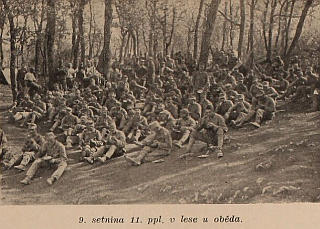
Hašek claims in The Good Soldier Švejk that entire battalions from Infanterieregiment Nr. 11 had crossed over to the Serbs but here he seems to be relaying allied propaganda, much like he does later in the novel when he describes the circumstances around Infanterieregiment Nr. 28's alleged defection by Dukla.
In 1916 the mouthpiece of the Czechoslovak National Council in Paris, La Nation tchèque, printed a piece of propaganda that also mentioned Infanterieregiment Nr. 11. It was relating to the campaign in Serbia[c], and the content also appeared in abroad, for instance in Kiev. La Nation tchèque didn't hold back: "the 11th regiment refused to march on Valjevo, was decimated and taken prisoners. The parts that remained were ordered to positions that were exposed to Serbian artillery fire and the rest were wiped out by Hungarian artillery as revenge". These claims are reproduced in the book Bohemia's case for independence by Edvard Beneš (1917)[2]. IR 11 praised in an official communique ,27.11.1914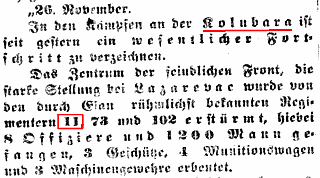
There seemed to be little substance in the allied propaganda. There were indeed several reports that praised Infanterieregiment Nr. 11 - they were mentioned in glowing terms three times in official war bulletins, first 26 November 1914 for their performance by the river Kolubara in northern Serbia. During a parliamentary inquiry in 1918 into the performance of Czech regiments the minister of defence in Cisleithania said that the regiment had performed bravely and had no complaints[e]. Nor is there any mention of such events in Kisch's book and the regiment was fighting some distance north of Valjevo[g].
That said entire companies from Infanterieregiment Nr. 11 "vanished" (were captured or broken up) during the retreat from Belgrade in December 1914 but this was the case also with their sister regiments on that section of the front. That entire units were wiped out was a common occurence throughout the war.
Schreib das auf, Kisch!
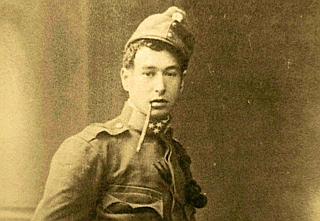
Egon Erwin Kisch as soldier in k.u.k. Heer
One prime witness to the Serbian campaign was the famous journalist and writer Egon Erwin Kisch. In 1922 he published Soldat im Prager Korps, based on his diaries from war, and in 1930 an enhanced version titled Schreib das auf, Kisch![g] appeared. Kisch gave a chilling account of the horrors he observed, and also laid bare cases of self-mutilation, corruption and incompetence within the army, all themes that reader of Švejk would recognise.
Korporal Kisch was living in Berlin when the war broke out, returned home to join Infanterieregiment Nr. 11 in Písek and describes the journey to the front and the disastrous invasions of Serbia in 1914. Then follows the chaotic retreat by Belgrade to southern Hungary (by current Novi Sad in Serbia), a 6 weeks of restitution followed by the transfer to the Carpathians. Here he was wounded on 18 March 1915 and he narrative ends as he return to Prague. After recovering he worked for Kriegspressequartier in Vienna and also as a censor at the regiment's replacement battalion in Gyula. Kisch never returned to active front service.
Ersatzbataillon

, 30.6.1915
The replacement battalion of Infanterieregiment Nr. 11 was like their equivalents from other Czech regiments relocated to non-Czech soil. Their destination was Hungary, temporarily Kolozsvar (now Cluj in Romania), then Gyula on the current Hungarian-Romanian border. The transfer took place in May 1915 (reported on 19 May)[b] and the battalion returned to Písek 10 November 1918[d]. Presumably a Hungarian regiment took their place in the barracks in Písek but it is not known which.
Quote(s) from the novel
[II.2] Černožluté obzory počaly se zatahovat mraky revoluce. Na Srbsku, v Karpatech přecházely bataliony k nepříteli. 28. regiment, 11. regiment. V tom posledním vojáci z píseckého kraje a okresu. V tom předvzpourovém dusnu přijeli rekruti z Vodňan s karafiáty z černého organtinu.
Sources: Martin Zeman, Egon Erwin Kisch
| 1. | In August 1914 the division contained Infanterieregiment Nr. 11, IR73, Infanterieregiment Nr. 91, IR102, one battalion from Infanterieregiment Nr. 28, artillery (a.o. Feldkanonenregiment Nr. 24) and cavalry. |
| 2. | Edvard Beneš, Bohemia's case for independence, 1917. This book is a political pamphlet that aimed to influence decision-makers in the allied capitals towards accepting the need to break up Austria-Hungary. To achieve his goal Beneš didn't shy away from exaggerations, falsehoods and even conspiracy theories. From page 56: The 11th Czech Regiment of the town of Pisek, who refused to march on Valjevo in Serbia, was on two different occasions decimated. The rest were put in the front of Serbian guns and finally crushed by the Magyar artillery, who seeing themselves in danger thus cruelly revenged themselves on the Czechs. |
Literature
- Písek vojenský 1848-1918
- Seznam velitelů pěšího pluku č.11 v letech 1629-1918
- C. a k. pěší pluk č.11 ve Válce světové. I. část: Na srbské frontě (srpen-prosinec 1914)
- C. a k. pěší pluk č.11 ve Válce světové. II. část: Na ruské frontě (únor-říjen 1915)
- C. a k. pěší pluk č.11 ve Válce světové. III. část: Na italské frontě (listopad 1915-listopad 1918)
- Vojákem pražského sboru
- Maršbaťáček1927
- IR 11 - bojová cesta2014
- Ein Denkmal für die Helden von Melegnano und Solferino
- Nové kasárny v Písku15.9.1900
- Jak se vyznamenal 11. pěší pluk z Písku14.12.1914
- Česši v rakouské armádě3.5.1916
- Neznámí spojenci spojenců30.10.1916
- Das Verhalten der Tschechen im Weltkrieg1918
- Jedenáctej25.12.1925
- Der serbische Feldzug15.6.1930
- Der Oberste Kriegsherr und sein Stab1908
| a | Schematismus für das k.u.k. Heer (s. 399) | 1914 | |
| b | Změna vojenských posádek | 19.5.1915 | |
| c | Les soldats tchécoslovaques | 1.6.1916 | |
| d | Příjezd 11. pěš. pluku do Písku | 16.11.1918 | |
| e | Das Verhalten tschechischer Regimenter an der Front | 15.6.1918 | |
| f | Kriegsgliederung | ||
| g | Schreib das auf Kisch! | 1930 | |
| h | Bohemia's case for independence | 1917 |
 | Písecké nádraží |  | |||
| |||||
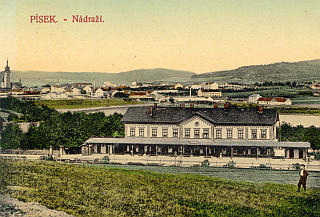
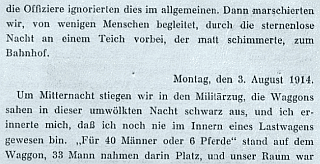
"Scrieb das auf Kisch", , 1930
Písecké nádraží is mentioned by the author when he wrote that soldiers who travelled through from Prague threw back cigarettes and chocolate that society ladies from Písek gave them.
Švejk would also either have boarded the train here or travelled past when he finally concluded his anabasis by being escorted to his regiment in Budějovice.
Background
Písecké nádraží probably refers to the main railway station in Písek that is by far the largest of the four stops in the city. It is located on the southern outskirts of Písek and is a regular stop on the line Prague - Beroun - Protivín - Budějovice. It would be logical to assume that soldiers from Prague passed through this station on the way to the battlefield in Serbia.
Egon Erwin Kisch also mentions a station in his book Schreib das auf Kisch!. The settings was Infanterieregiment Nr. 11's transport to the front in Serbia in early August 1914. The soldiers left around midnight and Kisch noted that they marched past a pond but that few people accompanied them along the route. The regiment travelled via Tábor to Vienna, a journey that took 30 hours!
Quote(s) from the novel
[II.2] Píseckým nádražím projížděli vojáci od Prahy a házeli nazpátek cigarety a čokoládu, kterou jim podávaly do prasečích vozů dámy z písecké společnosti.
Literature
 | Budějovické nádraží |  | |||
| |||||

The new station in 1914
, 1930

, 18.12.1908
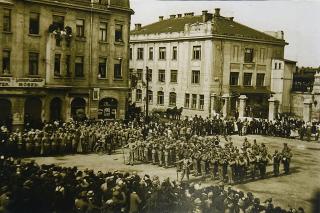
The 91st regioment's orchestra by the railway station before departure to the front, 1.8.1914.
Jednadevadesátníci, , 2018
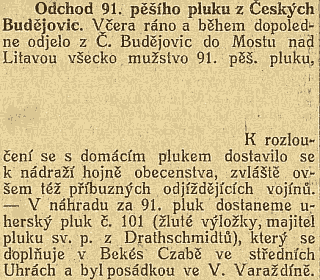
IR91 transferred to Bruck (sensored)
, 2.6.1915
Budějovické nádraží is mentioned when Švejk is escorted from Písek til Budějovice to join Infanterieregiment Nr. 91. This marks the end of his famous anabasis.
In [II.3] the station takes a more prominent place in the plot. Švejk and his cell-mate Einjährigfreiwilliger Marek boarded the train here later in when the whole replacement battalion of IR. 91 was transferred to Királyhida.
Background
Budějovické nádraží (Budweiser a railway station in Vienna) refers to the main railway station in Budějovice that is located slightly more than a kilometre east of the centre. The orginal station was opened for traffic in 1872 but replaced by the current and much larger one in 1908. The first passenger train rolled into the station on 17 December 1908[a].
During the war
The railway's had a crucial role in military logistics, so also in Budějovice. Already on mobilisation staff, 2nd and 3rd battalion of IR. 91 arrived from Prague and was together with the already present 4th battalion put on a war footing. On 1 August 1915 the regiment left for the front by Drina in four stages, a journey that lasted three days. Around the same time the local k.k. Landwehrinfanterieregiment Nr. 29 boarded the trains and headed for the eastern front.
During 1914 the station witnessed the departure of 5 march battalions to Serbia, in January 1915 the 6th was shipped to southern Hungary were the regiment spent six weeks recovering after the withdrawal from Serbia. March battalions numbered 6 to 11 were subsequently dispatched to the battlefields of the Carpathians and Galicia.
Jaroslav Hašek's XII. Marschbataillon was actually the first that was not shipped from Budějovice. In early summer 1915 the replacement battalions of the city's two house regiments were relocated to non-Czech soil. IR. 91 was on 1 June 1915 moved to Királyhida in two stages[b], an event that is extensively covered in The Good Soldier Švejk. Almost two weeks earlier k.k. Landwehrinfanterieregiment Nr. 29 had been relocated.
Quote(s) from the novel
[II.2] Po celé cestě se Švejkem od nádraží do Mariánských kasáren v Budějovicích upíral své oči křečovitě na Švejka, a kdykoliv přicházeli k nějakému rohu nebo křižovatce ulic, jako mimochodem vypravoval Švejkovi, kolik dostávají ostrých patron při každé eskortě, načež Švejk odpovídal, že je o tom přesvědčen, že žádný četník nebude po někom střílet na ulici, aby neudělal nějaké neštěstí.
[II.3] Jednadevadesátý pluk se stěhoval do Mostu nad Litavou-Királyhidy. Právě když po třídenním věznění měl být za tři hodiny Švejk propuštěn na svobodu, byl s jednoročním dobrovolníkem odveden na hlavní strážnici a s eskortou vojáků doprovozen na nádraží.
[II.3] Blížili se ostatně k nádraží, kde se loučili Budějovičáci se svým regimentem. Nemělo to oficielního rázu, ale náměstí před nádražím bylo naplněno obecenstvem, které očekávalo vojsko.
[II.3] Švejk nemohl se udržet, aby nevykřikl do špalíru „Nazdar!“a nezamával čepicí. Působilo to tak sugestivně, že zástup to hlučně opakoval a „Nazdar“ šířilo se dál a zaburácelo před nádražím, kde daleko odtud se začalo říkat: „Už jdou.“
[II.3] Byla to pořádná manifestace. Z hotelu naproti nádraží z oken mávaly nějaké dámy kapesníky a křičely „Heil!“ Do „nazdar“ mísilo se „heil“ i ze špalíru a nějakému nadšenci, který použil té příležitosti, aby vykřikl: „Nieder mit den Serben“, podrazili nohy a trochu po něm šlapali v umělé tlačenici.
[II.3] Tak vešli na nádraží a šli k určenému vojenskému vlaku, když málem by byla ostrostřelecká kapela, jejíž kapelník byl vážně popleten nečekanou manifestací, spustila „Zachovej nám, Hospodine“.
[II.3] Ráno dostal nápad, že musí dělat pořádek při odjezdu prvních ešalonů regimentu, a proto se potloukal po celé délce špalíru, účinkoval na nádraží tak, že důstojníci řídící dopravu pluku uzavřeli se před ním v kanceláři přednosty stanice.
[II.3] Objevil se proto opět před nádražím v pravý čas, aby strhl taktovku kapelníka ostrostřelců, který už chtěl dirigovat „Zachovej nám, Hospodine“.
[II.3] „Halt,“ řekl, „ještě ne, až dám znamení. Teď rút a já zas přijdu.“ Odešel do nádraží a pustil se za eskortou, kterou zastavil svým křikem: „Halt!
[II.3] „To se divím,“ řekl jednoroční dobrovolník k desátníkovi, „že u nás se ještě neobjevila inspekce. Podle předpisu měl jste nás hlásit u komandanta vlaku hned na nádraží a nezabývat se nějakým opilým vrchním polním kurátem.“
[II.3] Kromě toho na poslední stanici hlášený stav mužstva z jednotlivých vagonů kolísal s číslem udaným po skončeném nástupu do vagonů na budějovickém nádraží.
[II.3] „Milerád,“ kamarádským tónem řekl jednoroční dobrovolník, „vy jste se prostě ráno na nádraží při nastupování do vlaku k nám přidal, poněvadž jste měl v hlavě.“
Literature
- Nové nádraží v Č. Budějovicích19.12.1908
- Unser neuer Bahnhof22.12.1908
- Inspizierung1.6.1915
- Abmarsch der 91er4.6.1915
| a | Der neue Bahnhof | 18.12.1908 | |
| b | Odchod 91. pluku | 2.6.1915 |
 | Mariánská kasárna |  | |||||
| Budějovice/1851, Pražská tř. 1 | |||||||
| |||||||

Mariánská kasárna / Marienkaserne, the home of IR. 91 until 1 June 1915.
, 1932
Mariánská kasárna plays a prominent role in this chapter as part of the plot takes part in this garrison in Budějovice. This is where Švejk and Einjährigfreiwilliger Marek spent three days together in the regimental prison.
Background
Mariánská kasárna was a military barrack in Budějovice that was build in 1843-1844. From 1883 to 1915 it housed the replacement battalion of Infanterieregiment Nr. 91 ( Ersatzbataillon IR. 91) and at least one regular battalion, in 1914 the 4th. Jaroslav Hašek himself served here from 17 February 1915 until the end of May. His experiences here are to a large degree retold by his alter ego Einjährigfreiwilliger Marek. The school for Einjährigfreiwilliger that Hašek and Marek attended was on the third floor. The building also housed the garrison arrest, a place that Švejk and his creator knew very well.
On 1 June 1915 the IR. 91 replacement battalion was transferred to Királyhida under circumstances very similar to those described in the novel. Their replacement was, as in the novel a Hungarian regiment. Infanterieregiment Nr. 101 from Békéscsaba in south eastern Hungary arrived on the 9th[b]. Staff and the machine gun company of k.k. Landwehrinfanterieregiment Nr. 6 from Eger (now Cheb) also occupied parts of the barracks. They arrived in the city 19 May 1915 as they were swapped with the local k.k. Landwehrinfanterieregiment Nr. 29[a].
In 2015 the building was renovated and now hosts restaurants, shops, flats and galleries. By the main entrance there is a memorial plaque to Jaroslav Hašek.
Quote(s) from the novel
[II.2] Po celé cestě se Švejkem od nádraží do Mariánských kasáren v Budějovicích upíral své oči křečovitě na Švejka, a kdykoliv přicházeli k nějakému rohu nebo křižovatce ulic, jako mimochodem vypravoval Švejkovi, kolik dostávají ostrých patron při každé eskortě, načež Švejk odpovídal, že je o tom přesvědčen, že žádný četník nebude po někom střílet na ulici, aby neudělal nějaké neštěstí.
[II.2] V tmavém prostoru lidomorny Mariánských kasáren Švejka uvítal srdečně tlustý jednoroční dobrovolník, provalující se na slamníku.
[II.2] A ta jeho řeč nemá konce a vy čekáte, že co nejdřív musí spadnout celé Mariánské kasárny.
[II.2] Nedívej se tak hloupě, klíčníku Mariánských kasáren.
[II.2] ...když například přelézá voják v noci zeď Mariánských kasáren a usne nahoře na zdi...
[II.2] Tak mně připadá,“ řekl jednoroční dobrovolník po krátké pomlčce, „že duch vojenský v nás upadá, navrhuji, milý příteli, abychom v noční tmě, v tichu našeho vězení si zazpívali o kanonýrovi Jabůrkovi. To povznese vojenského ducha. Ale musíme řvát, aby to bylo slyšet po celých Mariánských kasárnách. Navrhuji proto, abychom se postavili ke dveřím.“
Sources: Franta Hofer, Jaroslav Kejla
Also written:Mariánské kasárnyHašekMarienkasernede
Literature
| a | Geschichte des ehemaligen Schützenregimentes Nr. 6 | 1932 | |
| b | Einzug der Infanterie-Regimentes 101 in Budweis | 11.6.1915 |
 | Infanterieregiment Nr. 91 |  | ||||
| Budějovice/1851, Pražská tř. 1 | ||||||
| ||||||
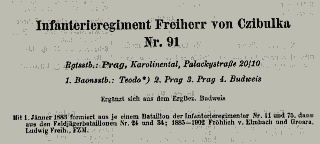
, 1914
Infanterieregiment Nr. 91 is the backdrop to almost the entire plot from the moment Švejk reunites with Oberleutnant Lukáš in Mariánská kasárna in Budějovice. This happened after he had concluded his famous anabasis. The word "regiment" in this context of novel rather means Ersatzbataillon IR. 91 because Švejk's unit never joined the field regiment at the front.
Background
Infanterieregiment Nr. 91 was one of 110 infantry regiments in k.u.k. Heer[a] and because of The Good Soldier Švejk it is arguably the best known regiment in the entire Austro-Hungarian armed forces. Jaroslav Hašek's own period of service in IR. 91 in 1915 explains why he chose this very regiment as the backdrop for the plot.
Švejk's whereabouts and itinerary from Budějovice onwards roughly follows the author's own movements with XII. Marschbataillon of IR. 91 in 1915. Hašek also introduced a considerable number of fellow soldiers and officers to the plot. From some of them he borrowed names, biographical details and personal qualities from the "prototype", in other cases he used only the name and/or rank.
The history of Infanterieregiment Nr. 91 is being prepared on a dedicated page.
Quote(s) from the novel
[II.2] ...
Sources: Rudolf Kießwetter, Jan Ev. Eybl, Jan Vaněk, Gustav Jungbauer, Josef Novotný, Jan Ciglbauer, Milan Hodík
Literature
| a | Schematismus für das k.u.k. Heer (s. 559) | 1914 |
 | Budějovická nemocnice |  | ||||
| Budějovice I./185, Radeckého tř. 37 | ||||||
| ||||||
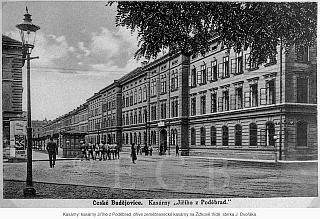
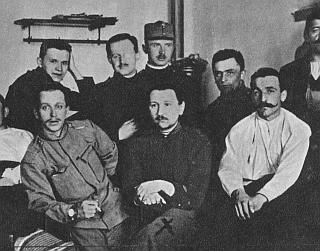
Spisovatel-humorista a spolupracovník Světozora Jaroslav Hašek v reservní vojenské nemocnici v Českých Budějovicích.
, 30.4.1915
Budějovická nemocnice is mentioned by Einjährigfreiwilliger Marek when he tells Švejk how he used the Regimentskrankenbuch to nip out of the hospital to enjoy himself on the town. The name of the hospital is not mentioned explicitly.
Background
Budějovická nemocnice almost certainly refers to k.u.k. Reserve-Spital, although other military hospitals existed in Budějovice already from August 1914. The reason for this assumption is that this was the hospital to which Jaroslav Hašek himself was admitted on 6 March 1915. Here he was diagnosed with rheumatism and heart problems. He was placed in room No. 77[a].
The hospital was located in the former k.k. Landwehr barracks. The building is still in military use and is located near the railway station at in Žižkova třída, in 1915 still Radeckého třída - Radetzkystrasse.
Hašek later spent some time for recuperation in a military hospital in the so-called Linz-suburb[b]. It is obviously possible that this is the hospital Einjährigfreiwilliger Marek nipped out from, but since the latter was located quite far from the centre the former is the more likely inspiration.
Krankenbuch
There is to our knowledge no firm evidence that the episode with Krankenbuch actually took place. Radko Pytlík is content to state "perhaps"[a] whereas Kejla categorically claims that it was not the reason why Hašek was expelled from the reserve officer's school. According to him the reason for his expulsion was rather mundane: behaviour not in line with what was expected of a k.u.k. officer[c].
Hašek's sick story started on 6 March 1915 when he was admitted to hospital. On 8 April he was investigated by doctors with view to a possible superarbitration and an application was signed by dr. Peterka on the 12th. On 30 April he was declared fit for lighter duties, a verdict signed by Peterka and higher ranking officers like Karl Schlager and Pallweber. On 25 May the verdict was confirmed by k.u.k. Miltärkommando Prag. His stay at hospitals in Budějovice may conceivably be mirrored in Švejk's experiences at Vojenská nemocnice Hradčany, but this is a mere assumption.
Quote(s) from the novel
[II.2] Může být,“ připouštěl jednoroční dobrovolník, „že při té tahanici padlo pár pohlavků, ale to myslím nic na věci nemění, poněvadž je to vyložený omyl. On sám přiznává, že jsem řekl: ,Servus, Franci’ a jeho křestní jméno je Anton. To je úplně jasné. Mně snad může škodit jenom to, že jsem utekl z nemocnice, a jestli to praskne s tím ,krankenbuchem’...
[II.2] Vracel jsem se na svou postel do nemocnice až k ránu, a když mě v noci zastavila patrola, ukázal jsem jí na svůj krankenbuch 91. regimentu a víc se mne nikdo na nic neptal. Ve vratech nemocnice opět mlčky ukázal jsem na knihu a nějak jsem se vždy do postele dostal.
Literature
- Vojenské posádky v Budějovicích v roce 1906
- Jaroslav Hašek v Českých BudějovicíchFrantišek Skřivánek14.8.1954
- Jaroslav Hašek v Č. BudějovicíchJaroslav Šťastný5.5.1963
| a | Raněný český spisovatel v Č. Budějovicích | 13.3.1915 | |
| b | Toulavé house | 1971 | |
| c | Jak to bylo v bitvě u Chorupan kde se dal Jaroslav Hašek zajmout | 1972 |
 | Port Arthur |  | ||||
| Budějovice III./326, Rudolfovská tř. | ||||||
| ||||||

The brothel Port Arthur was located in the building to the left. The current address is Rudolfovská třída 47.
Českobudějovický deník,8.4.2021
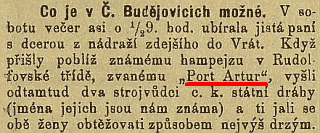
Jihočeské listy,8.4.1907
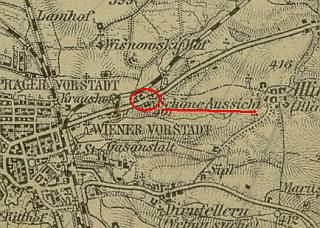

Budivoj,8.1.1904

Budivoj,7.11.1906

Jihočeské listy,20.5.1914

Budweiser Kreisblatt,19.8.1914

Port Arthur was a brothel in Budějovice that was visited daily by Einjährigfreiwilliger Marek. By doing this he hoped to contract venereal diseases and thus get declared unfit for service. Later in the chapter it is revealed that it was the scene of brawls between soldiers from the infantry and artillery.
Background
Port Arthur is commonly known as the European term for Lüshunkou, a harbour in Manchuria that was besieged and captured by Japanese forces during the Russo-Japanese war in 1904-05.
Brothel from 1904
More important in the context of The Good Soldier Švejk is that a brothel named Port Arthur (also written Port Artur) actually existed in Budějovice at the time when Jaroslav Hašek served in the city. The establishment was located in Rudolfovská třída in the eastern outskirts of the city, on or near a hill called Pěkná vyhlídka (de. Schöne Aussicht). The name literally means "Pretty View".
In January 1904 Jan Filip bought the inn Na pěkné vyhlídce[a] and in the autumn it was already operating as a brothel after it had been awarded a license[b]. From the first moment there were reports in the newspapers about disorder, a fact that may have led to the nick-name "Port Artur", inspired by the war in the far east and the siege of the port that at the time was under way.
In 1906 the owner Jan Filip was mentioned in the newspapers, accused of having betrayed the Czech nation and sold his vote for the city council election to the German mayor G(Josef Taschek). For this favour it was claimed that he was granted a license to run a brothel[c].
The following year "Port Artur" again appeared in the news due to disturbances, but the negative items from the Czech press smells of a smear campaign against the "Judas" Filip, the German national Taschek, and Germans in general. Newspapers were at this time, be it German or Czech, replete with chauvinistic outbursts.
The 1910 census
In 1909 a Bernard Machatý bought the property[d] and built stables behind the house. The 1910 census reveals that 8 people lived at the address and strikingly enough six of them were young women and four of them are listed as prostitutes. Two hostesses were listed: Rosalie Blažek og Barbora Pachek. The owner Machaty was born in 1874 in Chrudim, divorced, and listed with profession "trade in beer and wine"[e]. The census also reveals that he owned six horses and eight pigs, that the house had four windows facing the street and altogether six facing the rear and the sides.
1914 - 1918
The business seems to have gone badly because in March 1914 much the inventory was auctioned off[f]. In May some newspaper reported that the entire building was to follow and this was to happen on 3 July[g]. In August 1914 it was reported that the waiter at Prostituiertenheim des B. Machaty in der Rudolfstädterstraße had suddenly died from a heart cramp[h].
In June 1915 there was news item about two thieves who had been arrested and they had been drinking at "a certain brothel" in Rudolfovská třída[i]. In 1917 it was noted that Rosalie Blažková as landlady at the premises had been fined after having ignored the mandatory closing time[j].
Horses and furniture
In October 1918 Theodor Löwy sold the building to the horse trader Felix Vazda[k]. When Löwy bought the property and from whom is not known. In 1920 Václav Vazda moved here from Ledenice and established a successful furniture factory. It existed until 1950 when it was nationalised[l].
Recent information
Port Arthur was not an official name and it has proved difficult to locate with certainty. Newspaper clips however leaves not doubt that the site was house No. 326 in Rudolfovská třída but because of changes in house numbering over the years the current numbers give few leads. Local historian Milan Binder informs that buildings in Budějovice have been renumbered twice, the latest in 1979.
In June 2023 it was finally brought to light who owned the brothel at the time when Jaroslav Hašek served in Budějovice, and also exactly where it was located. Mrs. Renata Schmidtmajerová contacted Jaroslav Šerák and passed on unique information, including a picture of the "mama" who ran the establishment from 1913 to 1915, Rozálie Blažková.
In 2021 local historian Jan Shinko published a more detailed article about Port Arthur appeared in a regional newspaper, supplied by a related web article[m].
Renata Schmidtmajerová
Do roku 1913 byl vlastník Bernard Machatý, poté Rozálie Blažková (prababička mého manžela Josefa Schmidtmajera). V roce 1915 prodala nemovitost Vincenzi Machatému (otci Bernarda Machatého), později byl vlastníkem Vazda (známá firma s nábytkem). A teď to hlavní: Port Artur stál v místě, dnešní číslo domu je 213/74 na Rudolfovské (přikládám obrázek), na pravé straně kdysi stály stáje, ty byly zbourané, dnes tam stojí Lidl. Dům stojí dodnes.
Quote(s) from the novel
[II.2] Denně jsem chodil do „Port Arthuru“, někteří kolegové už dostali zánět varlat, řezali jim pauchy, a já jsem byl pořád imunní. Smůla, kamaráde, nekřesťanská. Až jsem se ti jednou „U růže“ seznámil s jedním invalidou z Hluboké.
[II.2] Jak se seprali v „Port Arthuru“, „U růže“ a v jiných četných zábavních místnostech jihočeské metropole.
Sources: Jan Schinko, Renata Schmidtmajerová, Jaroslav Šerák
Literature
- Port Arthur2018 - 2023
- Románové restaurační a jiné zábavní podniky2009 - 2021
- Změny držebnosti8.1.1904
- Také novinka z "Port Arturu"30.11.1904
- Co je v Č. Budějovicích možné8.4.1907
- Kde byla v noci na minulou sobotu policie...13.7.1907
- Kurze Freuden10.7.1915
| a | Z kruhů hostinských | 6.1.1904 | |
| b | Nová atrakce v Českých Budějovicích | 2.11.1904 | |
| c | Zradil národ za — 'bordel' | 7.11.1906 | |
| d | Změny držebnosti | 30.7.1909 | |
| e | Sčitání lidu 1910 | ||
| f | Versteigerungs-Edikt | 3.3.1914 | |
| g | Exekuční dražby nemovitostí | 20.5.1914 | |
| h | An Herzkrämpfen plötzlich gestorben | 19.8.1914 | |
| i | Zatčení lupiči | 5.6.1915 | |
| j | Politické tresty | 14.4.1917 | |
| k | Besitzwechsel | 18.10.1918 | |
| l | Port Artur na Rudolfovské končil dražbou klisen i věšáků | 8.4.2021 | |
| m | Nevěstince v Českých Budějovicích | 25.2.2021 |
 | U růže |  | ||||
| Budějovice/-, Pražská ul. 5 | ||||||
| ||||||
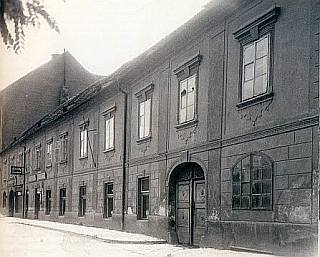
Zaniklé hospody, s.157
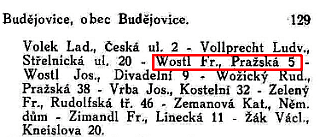
,1915
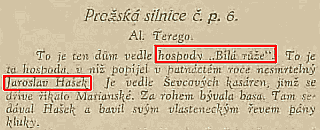
Jihočeské listy,9.1.1937
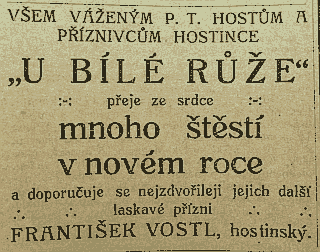
,31.12.1914
U růže was a pub in Budějovice that is mentioned as Einjährigfreiwilliger Marek met a cripple from Hluboká here who could help him with rheumatism. Later in the chapter it is revealed that it was the scene of brawls between soldiers from the infantry and artillery.
Background
U růže probably refers to U bílé růže, a pub two doors north of Mariánská kasárna in Pražská ulice 5, Budějovice. The inn has existed at least from 1879 and was used also for meetings, for instance election gatherings. In 1884 František Smauš announced that he had taken over the inn that at the time also was known as U hlavů. In 1896 there were puppet shows here and the landlord at the time was Jindřich Kopecký. He is also listed as innkeeper in 1905 when he advertised a carousel for sale. This apparatus has surely had its place in the restaurant's garden. In the 1890s they sold beer from Protivín but we don't know if this was still the case in 1915.
The landlord as of 31 December 1910 was František Vostl (also written Wostl), a person Jaroslav Hašek most definitely would have known as he is still listed as innkeeper in 1915. Vostl also ran a horse cab business and traded in fish. He died on 22 June 1933 at the age of 62. He was landlord at U bílé růže at least until 1924 and frequently placed adverts in Jihočeské listy wishing his customers "Happy New Year". The premises were used as an inn even after World War II and he building was demolished as late as 1992.
Hašek at The White Rose
An article in Jihočeské listy from 1937 confirms that Jaroslav Hašek visited the pub back in 1915. He entertained guests with his patriotic shouting. The article is signed with the pseudonym Al. Terego mentions that the pub also was called simply "U růže"[a].
An alternative
Einjährigfreiwilliger Marek may also have had the café U černého růže (Zur schwarzen Rose) in mind. It was situated on the corner of Piaristická ulice and Česká ulice. This hypothesis is however much weaker as the joint was located further away from the barracks and it also seems to have been largely frequented by Germans. Proprietor in 1915 was Anna Czech.
Milan Binder
Zmiňovaná hospoda "U růže" bude určitě hospoda "U bílá růže", která byla hned vedle Mariánských kasáren. Informace o ní najdete také v knize "Zaniklé hospody", na straně 157 a 158.
Quote(s) from the novel
[II.2] Denně jsem chodil do ,Port Arthuru’, někteří kolegové už dostali zánět varlat, řezali jim pauchy, a já jsem byl pořád imunní. Smůla, kamaráde, nekřesťanská. Až jsem se ti jednou ,U růže’ seznámil s jedním invalidou z Hluboké. Ten mně řekl, abych jednou v neděli k němu přišel na návštěvu, a na druhý den že budu mít nohy jako konve. Měl doma tu jehlu i stříkačku, a já jsem opravdu sotva došel z Hluboké domů.
[II.2] V tom posledním byla soustředěna všechna zášť 91. regimentu proti dělostřelectvu v Budějovicích. Běda dělostřelci, který padl v noci do rukou patroly od pluku a naopak. Zášť hrozná, nesmiřitelná, vendetta, krevní msta, dědící se z ročníku na ročník, provázená na obou stranách tradičními historkami, jak buď infanteristi naházeli dělostřelce do Vltavy, nebo opačně. Jak se seprali v „Port Arthuru“, „U růže“ a v jiných četných zábavních místnostech jihočeské metropole.
Sources: Milan Binder, Jihočeské listy, Budivoj
Also written:The RoseenZur RosedeVed rosano
Literature
- Románové restaurační a jiné zábavní podniky2009 - 2021
- Chytilův úplný adresář Království Českého1915
- Koncert13.3.1879
- "U bílé růže" (U Hlavů)29.6.1884
- Protívinské pivo26.2.1893
- Jindř. Kopeckého loutkové divadlo17.10.1896
- Kolotoč11.2.1905
- Diebstahl9.5.1915
- Café "Zur schwarzen Rose" - Prosit Neujahr31.12.1915
- Umrtí24.6.1933
| a | Pražká silnice č.p. 6 | 9.1.1937 |
 | Měšťanská beseda |  | ||||
| Budějovice/-, Na Sádech - | ||||||
| ||||||
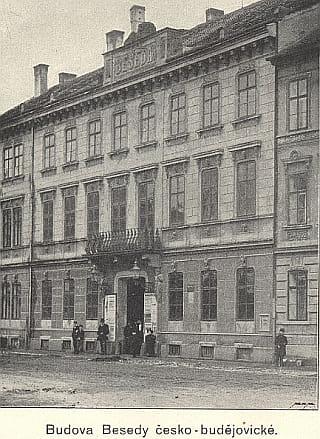
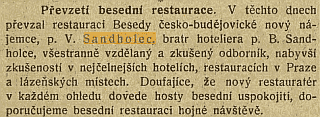
Hlas lidu, 29.9.1914
Měšťanská beseda does according to Einjährigfreiwilliger Marek serve good food, as opposed to the garrison arrest where he and Švejk are locked up.
Later in the chapter while still sitting in the arrest Einjährigfreiwilliger Marek mentions the place again. He knows the officer on duty, Leutnant Pelikán, from here. Here he uses the name Česká beseda but we can safely assume that he has the same place in mind.
Background
Měšťanská beseda was a community building, restaurant and hotel in Budějovice that existed from 1870, owned by the citizen's association Českobudějovická Beseda[a]. It was primarily used by the Czech part of the city's population and it was here Český akciovný pivovar (now known as Budweiser Budvar) was founded on 21 January 1894[b]. The brewery commenced operation in 1895 and it is a foregone conclusion that the restaurant served beer from this brewery (and they still did at the outbreak of war).
From September 1914 and at least until 1922 the Beseda restaurant was run by Vilém Sandholec, brother of the owner of Hotel Slunce[c] at Budějovické náměstí (the square). According to Radko Pytlík the restaurant was indeed frequented by Jaroslav Hašek so Einjährigfreiwilliger Marek presumably knew well what he was talking about. In 1924 the building was revamped and in 2015 the restaurant was still there but we don't know if it's been operating continuously.
Quote(s) from the novel
[II.2] Himlhergot, není co kouřit, kamaráde. Nechcete, abych vás naučil plivat na strop? Podívejte se, to se dělá takhle. Myslete si přitom něco, a vaše přání se splní. Jestli rád pijete pivo, mohu vám odporučiti výbornou vodu tamhle ve džbáně. Máte-li hlad a chcete-li chutně pojíst, doporučuji vám ,Měšťanskou besedu’.
[II.2] „To je profous,“ řekl jednoroční dobrovolník, „jde s ním lajtnant Pelikán, který má dnes službu. Je to reservní důstojník, můj známý z ,České besedy’, v civilu je matematikem v jedné pojišťovně. Od toho dostaneme cigarety. Řveme jen dál.“
Sources: Radko Pytlík, Milan Binder, Jihočeské listy
Also written:City ClubParrottBurghers'ClubSadlonBürgerressourcedeBorgarklubbenno
Literature
- Románové restaurační a jiné zábavní podniky2009 - 2021
- Paměti Besedy Česko-Budějovické 1862-19021903
- Českobudějovická Beseda
| a | Beseda českobudějovická | ||
| b | Budějovický Budvar | ||
| c | Beseda má zase nového hostinského | 24.9.1914 |
 | Budějovický berní uřád |  | |||
| |||||
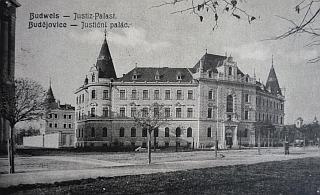
Justiční palác (Justizpalast) - the location of c.k. berní úřad (k.k. Steueramt)

,1915

, 8.5.1908
Budějovický berní uřád is mentioned by Einjährigfreiwilliger Marek when he tells Švejk that after leaving the hospital with his Krankenbuch he changed into civilian clothes at some acquaintance's from the tax office.
Background
Budějovický berní uřád surely refers to one of the two (or three) tax offices in Budějovice. These were Městský berní úřad / Städtisches Steueramt and c.k. berní úřad / k.k. Steueramt (city and state tax office respectively). The latter was from 1905 located in Justiční palác / Justizpalast by the river Malše slightly south of the city centre. We don't know where the former was housed but the City Hall at Budějovické náměstí is a probable location. There may also have been a tax office or financial function related to hejtmanství.
According to Radko Pytlík the author of The Good Soldier Švejk indeed changed into civilian clothes at home by an official from the tax office. His name was allegedly J. Neproud[b]. No person with this combination of surname and occupation is listed in the address book from 1915[a] but some Josef Neproud worked in a bank. Pytlík's source is unknown but presumably it is from one of the many reminiscences of Hašek in Budějovice that were collected after World War II.
Quote(s) from the novel
[II.2] Pak šel jsem k jednomu známému úředníkovi od berního úřadu, tam jsem se převlékl do civilu a šel jsem do hospody, kde jsme vedli ve známé společnosti různé velezrádné řeči.
Literature
| a | Chytilův úplný adresář Království Českého | 1915 | |
| b | Osudy a cesty Josefa Švejka | 2003 |
 | Budweiser Einjährigfreiwilligenschule |  | ||||
| ||||||

Mariánská kasárna / Marienkaserne, the reserve officer's school was located on the 2nd floor.
,1932
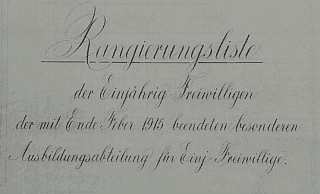
© ÖStA
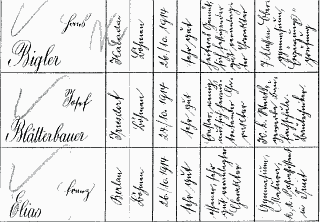
Three of the officer candidates in Josef Novotný's class who completed the course at the end of February 1915: Hans Bigler, Josef Blätterbauer, and Franz Elias. The two latter were killed in Galicia in 1915 whereas Bigler survived the war.
© ÖStA
Budweiser Einjährigfreiwilligenschule was the school that Einjährigfreiwilliger Marek was expelled from after the episode with the Krankenbuch. He uses several terms for the school: officers school, simply "the school" and also one-year volunteer school. Later it was revealed that the head of the school was Hauptmann Ságner.
Background
Budweiser Einjährigfreiwilligenschule refers to the reserve officer's school of Infanterieregiment Nr. 91 in Budějovice. It was located on the upper (second) floor of Mariánská kasárna and the officer candidates also had their quarters here[a]. On this floor were also located the offices of the school's commander and his assistant, the Dienstführender Feldwebel. How many officer's aspirants the school produced is not known, but we have a rough indication. From k.k. Landwehrinfanterieregiment Nr. 29 (also in Budějovice), the class that graduated in late December 1914, 49 Kadett-Aspiranten finished the course[e].
Josef Novotný
Thanks to the diary of Josef Novotný[d] we have some information about the school. The course itself lasted for approximately eight weeks, but the one-year volunteers were even before entering separated from their Ersatzkompanie and assembled in a so-called Einjährigfreiwilliger-Abteilung where they served while waiting for the current class to finish. The first class of officer apprentices started 1 November 1914 and graduated by the turn of the year. The commander of the school was initially Hauptmann Julius Pleban and instructors were Oberleutnant Rudolf Lukas and Leutnant Livora. The former was a "serious and strict German who knew this trade". The latter was an "incompetent Jewish accountant who hated Czechs". He was soon replaced by reserve lieutenant Josef Wolf, a forest warden from Gratzen (Nové Hrady) who also "hated Czechs". Later lieutenant Viktor Kabelák joined, he was "perhaps a Czech, but a renegade". Lukas was according to his Vormerkblatt instructor at the school from 16 October to 9 December 1914 so Novotný presumably had little to do with him.
Novotný himself started in the second course after New Year 1915 and by then Oberstleutnant Otto Husserl had assumed command of the course. Novotný remembers fellow soldiers like the well-liked German Josef Blätterbauer and also Hans Bigler. The latter was "ambitious, immature, touchy, and presented himself as a Swiss who had volunteered for service out of enthusiasm". He was every bit as enthusiastic as Kadett Biegler in The Good Soldier Švejk and was likewise an object of ridicule. Novotný even claims that it was Bigler's fault that Blätterbauer fell in Carpathians, but this can't be true because Bigler never served there. He arrived at the front first time on 11 July 1915 and by then Blätterbauer was already reported missing.
Novotný was, together with around 20 other Czechs, expelled from the course and claims that Germans were favoured, especially by the German Höfer, a Dienstführender Feldwebel from Krumlov. Novotný was never told the reason why he was expelled. It could have been his strained relation with Höfer, that he was often ill, or that he had applied for a transfer to other regiments because his German was poor. The process was thus very different to what Einjährigfreiwilliger Marek experienced in The Good Soldier Švejk: that the matter was escalated to regimental report and the verdict announced in front of the men.
Hauptmann Adamička
On 20 January 1915 captain Josef Adamička assumed command of the school but he left for the front with the 8th march battalion on 18 March 1915. Franta Hofer remembered that Adamička took a liking to the future author of The Good Soldier Švejk and even invited him to the officer's dining room to entertain the gentlemen with anecdotes about priests and Jews[a].
Hašek at the school
Hašek reported at IR. 91/I. Ersatzkompanie in Budějovice on 17 March 1915 but he did not enroll straight away. In the beginning, he wore civilian clothes together with the rank and file and started at the school when his uniform was ready. Like Einjährigfreiwilliger Marek he was eventually expelled but we have no documents that record when he started or quit, nor anything about the cause for his dismissal. Kejla assumed it was due to behaviour that didn't befit a future reserve offiscr[b], whereas Hofer refrains from making assumptions. The latter noted that even though the amusing author was popular there were also those who were envious because Adamička favoured him[a].
It is also likely that the sick record weighed towards the decision to expel Hašek. He was admitted to hospital already on 6 March 1915 and the application for superarbitration was submitted on 8 April. He must therefore have missed much of the education and training. In the third class (March - April) there were a few officer's candidates who later wrote about Hašek's time there. Amongst these were Jaroslav Kejla and Franta Hofer.
Gott strafe England
Hašek told his own versions of what happened at the school. First through his alter ego Einjährigfreiwilliger Marek in the novel but also the story Gott strafe England from 1917. In this account, the goodwill that Adamička two years earlier had shown towards the author was by no means appreciated. His former superior was ridiculed as a clown who at any occasion promoted the slogan Gott strafe England and Hašek given the task of writing a patriotic poem. This he did but the poem was not well received and Hašek was given 30 days severe arrest[c].
The rest of the war
Who succeeded Adamička as head of the school we don't know but it may well have been Čeněk Sagner. This was after all a role his literary counterpart Hauptmann Ságner had in The Good Soldier Švejk. Another candidate is Franz Wenzel whose literary counterpart in some respect succeeded Adamička from the novel. Novotný estimates that during the war about 20 courses were held by the school for reserve officers. Sometime after Ersatzbataillon IR. 91 was moved to Bruck/Királyhida (1 June 1915) the school was merged with the schools from the other units in the garrison. The 14th course started in April 1917 and the by now battle-hardened Novotný was admitted and completed the course. More in the entry on the school in Bruck (TBD).
About one-year volunteers and reserve officer's schools

Heerwesen, , 1916

, daný dne 5. prosince 1868

, 1972
© LA-PNP
One-year volunteer was an entitlement given to young men with middle and higher education. They had the option to serve for one year instead of the compulsory three (since 1912 two years), providing they paid for their own equipment. The system was created in 1868 modelled after Prussia and was functioning until 1918. The motive was that it would save the state money and wouldn't unduly damage the careers of the recruits. The "volunteer" part was also that soldier could (but didn't have to) attend a course to become a reserve officer during his term of service. Those who didn't pass the reserve officer's exam had to serve another year, but this duty was abolished in 1912. The one-year volunteer could also apply to serve outside his home unit, but this was only granted when the manpower situation of the units in questions allowed it.
The one-year volunteer was expected to buy his own equipment whereas k.u.k. Militärärar provided accommodation (if the soldier wanted). Eligibility depended on the recruit having completed the eight-year middle school (gymnasium, "Realschule", teacher's academy, commercial academy or similar). It was up to the candidate to apply for the right as a one-year volunteer, and everyone had to pass an exam. Someone who was sentenced for property crimes or immorality automatically lost the right to serve for one year.
Thus Reserveoffizier-Schulen was an institution that educated one-year volunteers to become reserve officers. It may first appear that Jaroslav Hašek is wrong in using the terms "one-year volunteer school" or "school for one-year volunteers", but this is not the case. Until the army reforms of 1912, the schools were officially called Einjährig-Freiwilligenschule. Obsolete terms generally stick for years after the change has taken place (see for instance Salmova ulice).
Quote(s) from the novel
[II.2] Ať si nemyslí, že když mne pošlou na front, že dám jednu ránu. Regimentsraport! Vyloučení ze školy! Ať žije c. k. kretenismus! Budu já jim dřepět ve škole a skládat zkoušky. Kadet, fähnrich, lajtnant, obrlajtnant. Naseru jim! Offiziersschule. Behandlung jener Schüler derselben, welche einen Jahrgang repetieren müssen!
[II.2] Narukoval jsem ve vysokých botách a na hlavě jsem měl cylindr, a poněvadž mně krejčí včas nedodal uniformu, tak jsem přišel za školou jednoročáků na cvičiště i ve vysokých botách a v cylindru a postavil jsem se do řady a mašíroval s nimi na levém flangu.
[II.2] Hejtman Ságner, který má na starosti školu jednoročních dobrovolníků, vidí v Schröderovi pravý typ vojáka, ačkoliv plukovník Schröder nebojí se ničeho tak jako toho, kdyby měl jít do pole.
[II.2] Konečně se objevil zachmuřený plukovník v průvodu hejtmana Ságnera ze školy jednoročních dobrovolníků, nervózně sekaje bičíkem přes holinku svých vysokých bot.
[II.2] Pane hejtmane," zvolal na Ságnera, "přiveďte sem celou školu jednoročních dobrovolníků.
[II.2] Škola jednoročních dobrovolníků vstoupila na nádvoří. „Do čtverce!“ rozkázal plukovník. Obklopili souzené i plukovníka úzkým čtvercem.
[II.2] "Nicméně," pokračoval plukovník, "taková věc se musí bezpříkladně potrestat, chlap musí být vyloučen ze školy jednoročních dobrovolníků, morálně zničen. Máme už dost takových inteligentů v armádě. Regimentskanzlei!"
[II.2] Obraceje se ke škole jednoročních dobrovolníků, dal plukovník rozkaz k seřazení.
[II.2] Řekněte jim, že celá škola jednoročních dobrovolníků má po pět dní kasárníka, aby nikdy nezapomněli pna svého bývalého kolegu, toho lumpa Marka."
Sources: Franta Hofer, Jaroslav Kejla, Josef Novotný
| 1. | An example is the article about Jaroslav Hašek in Spanish Wikipedia. Unfortunately this article also contains many other factual errors. |
Literature
- Jednoroční dobrovolníci rakousko-uherské armády
- Jednoroční praesenční služba vojenská1910
- Der k.k. Einjährig-Freiwillige des stehenden (Gemeisamen) Heeres und Landwehr
- Zákon branný1869
- Reserveoffiziere Hugo Schmied1916
- Einjährig-Freiwilligen-Recht22.5.1912
- Officer Aspirant Insignia in the k.u.k. Army/k.k./k.u. Landwehr 1867-19182001 - 2016
| a | Jak se Jaroslav Hašek učil oficírem | ||
| b | Jak to bylo v bitvě u Chorupan kde se dal Jaroslav Hašek zajmout | 1972 | |
| c | Gott strafe England | Jaroslav Hašek | 15.10.1917 |
| d | Z mých válečných pamětí | 2021 | |
| e | Kameradschafts-Abend | 29.12.1914 |
 | Budweiser Übungsplatz |  | |||
| |||||
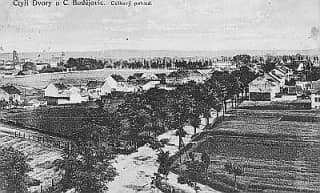
Budweiser Übungsplatz is mentioned by Einjährigfreiwilliger Marek when he in the cell in Budějovice tells Švejk about his first appearance at the trainings ground. He was dressed in civilian attire, including a bowler-hat and high boots. Oberst Schröder was furious and gave him 14 days arrest.
Background
Budweiser Übungsplatz refers to a military training ground in Budějovice, Einjährigfreiwilliger Marek only refers to it as "the training ground". In 1915 IR. 91 exercised at various places in and around the city but the main training ground at was Čtyři Dvory / Vierhöf. It was located 4 kilometres west of the centre and this is surely the place Marek had in mind.
Marek turning up in civilian clothes at the military training ground is a motif inspired by Hašek's own experience. The author of The Good Soldier Švejk also appeared there in civilian clothes and Kejla can confirm that this indeed happened at Čtyři Dvory in February 1915[a].
Quote(s) from the novel
[II.2] Narukoval jsem ve vysokých botách a na hlavě jsem měl cylindr, a poněvadž mně krejčí včas nedodal uniformu, tak jsem přišel za školou jednoročáků na cvičiště i ve vysokých botách a v cylindru a postavil jsem se do řady a mašíroval s nimi na levém flangu.
[II.2] To už zvolal jen, že zítra mám jít k regimentsraportu, a hnal to na koni ze vzteku až bůhvíkam jako divoký jezdec, a zas přicválal, opět nanovo řval, zuřil, bil se v prsa a poručil mne okamžitě ze cvičiště odstranit a dát na hauptwachu.
[II.2] Honí vás na cvičišti po celý den a na noc vás ještě zavřou. Tak se stalo, že u kumpanie Dauerlinga nebylo marodů. ,Kumpanienmarodi’ seděli v díře. Dauerling stále zachovává na cvičišti onen nenucený kasárenský tón, začínající slovem svině a končící podivnou zoologickou záhadou: svinským psem.
[II.2] Na začátku zimy, než jsem šel do nemocnice, cvičili jsme na cvičišti vedle 11. kompanie, a když byl rast, měl Dauerling řeč k svým českým rekrutům:...
Sources: Jan Ciglbauer, Jaroslav Kejla, Josef Novotný
Also written:Budějovická cvičištěcz
| a | Jak to bylo v bitvě u Chorupan kde se dal Jaroslav Hašek zajmout | 1972 |
 | 11. Kompanie |  | ||||
| ||||||
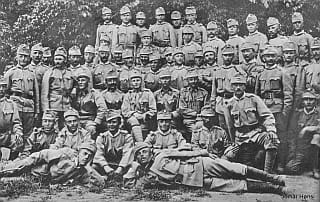
11. Feldkompanie, probably by Żdżary in August 1915.
,1959.
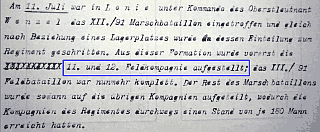
11. Feldkompanie reconstituted on 11.7.1915, now with Jaroslav Hašek in their ranks.
,1927.
© VHA
11. Kompanie (the 11th company) is first mentioned by Einjährigfreiwilliger Marek as the unit where the brutal junior officers Korporal Althof, Gefreiter Müller, and Feldwebel Sondernummer tyrannise and verbally abuse recruits, first and foremost Czechs. As if this wasn't enough the notorious Fähnrich Dauerling served as an instructor in the company.
In [II.4] the company is mentioned again, now explicitly as a march company. Oberst Schröder tells Oberleutnant Lukáš that the company has been formed and is to be sent to the front within a week. It would be commanded by Lukáš with Švejk as his messenger.
Background
11. Kompanie is not unambiguously identifiable but the numbering indicates that it was meant one of the 16 field companies of Infanterieregiment Nr. 91. This assumption does however have a weakness. The plot at this stage takes place at the replacement battalion in Budějovice whereas the field companies had been fighting at the front since the start of the war. Thus one would assume that the company was an Ersatzkompanie or Marschkompanie. However, this is at odds with the fact that in 1915 these companies were never numbered as high as 11. The march battalions usually consisted of 4 companies and the reserve battalions rarely more than that.
This contradiction is rather a result of the author’s disregard for details like the numbering of military units and the logical connection between them. This is best illustrated by Švejk's own 11. Marschkompanie, a unit that never existed in 1915 but rather reflected 11. Feldkompanie.
11. Feldkompanie
The company was one of four in III. Feldbataillon, and from 11 July to 24 September 1915 Jaroslav Hašek himself served here. This is obviously the reason why 11. Kompanie and 11. Marschkompanie (hereafter MK) is mentioned so often in The Good Soldier Švejk. Hašek was a messenger in the company, serving in the same role as Švejk had in the 11. march company.
Company commander during the period Hašek served was Rudolf Lukas, a parallel to the position Oberleutnant Lukáš held in the fictional march company. During this period the company reported to Čeněk Sagner and his III. Feldbataillon. This hierarchy in the field again mirrors that of the fictional march units as Hauptmann Ságner in The Good Soldier Švejk was commander in Švejk's unnumbered march battalion. Other models for characters in the novel also served in the company: Hans Bigler and Jan Vaněk in addition to the more peripheral inspirations František Strašlipka and Emanuél Michálek.
The 11. Feldkompanie company was like other units repeatedly decimated. This happened for instance 23 March 1915 in the Carpathians, during the battles by Złota Lipa in early July 1915, by Sokal at the end of July the same year and again by Chorupan on 24 September 1915. At the time when Jaroslav Hašek's XII. Marschbataillon arrived at the front, the company had ceased to exist altogether and was only reconstituted when this march battalion joined the regiment on 11 July.
Quote(s) from the novel
[II.2] U 11. kompanie kaprál Althof používá slova: engadinská koza. Svobodník Müller, německý učitel z Kašperských Hor, nazývá nováčky českými smraďochy, šikovatel Sondernummer volskou žábou, yorkshirským kancem a slibuje přitom, že každého rekruta vydělá.
[II.2] Přitom všechny šarže 11. kompanie koulí očima jako ubohý pes, který z hltavosti spolkne houbu namočenou v oleji a nemůže ji dostat z krku.
[II.2] Nyní vám, kamaráde, musím něco říct o Dauerlingovi,“ pokračoval jednoroční dobrovolník, „o něm si vypravují rekruti u 11. kompanie tak, jako nějaká opuštěná babička na farmě v blízkosti mexických hranic bájí o nějakém slavném mexickém banditovi.
[II.2] Na začátku zimy, než jsem šel do nemocnice, cvičili jsme na cvičišti vedle 11. kompanie, a když byl rast, měl Dauerling řeč k svým českým rekrutům:
[II.4] Během týdne bude vypravena marška na ruský front. Jste nejstarším důstojníkem u 11. kompanie, pojedete s ní jako kompaniekomandant.
Literature
 | Stephansdom |  | |||
| Wien I., Stephansplatz | |||||
| |||||
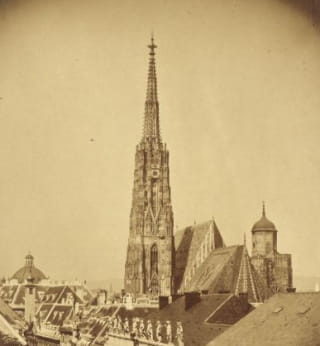
Stephansdom, aufgenommen von der Terrasse der kaiserlichen Wiener Hof- und Staatsdruckerei, um 1852.
Stephansdom is mentioned because Fähnrich Dauerling's teacher wanted to jump off the steeple of this cathedral due to his pupil's gross stupidity.
Background
Stephansdom is the most important cathedral in Vienna and one of the city's major attractions. It is located in the historical centre of the city. Construction started in 1137 and has been completed in stages over the years, with the latest being a new roof after a fire at the end of World War II. Südturm is by far the tallest of the steeples and reaches 136.7 metres[a].
Quote(s) from the novel
[II.2] Mladý Dauerling po hrozném zápase s čtyřmi třídami nižší reálky, které vystudoval soukromě, přičemž předčasně zešedivěl a zblbl jeho domácí učitel a druhý chtěl skočit v zoufalství se svatoštěpánské věže ve Vídni, přišel do hainburské kadetní školy. V kadetce se nikdy nedbalo na předběžné vzdělání, neboť to většinou nehodí se pro rakouské aktivní důstojníky.
Also written:Saint Stephen's CathedralenDóm svatého ŠtěpánaczStephansdomde
Literature
| a | Stephansdom |
 | Hainburger Kadettenschule |  | ||||
| Hainburg an der Donau, Freiunggasse | ||||||
| ||||||
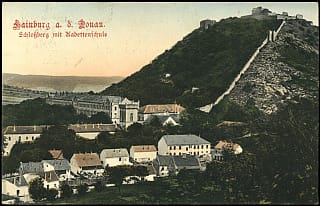
Kadettenschule; Schloßberg. 1906.
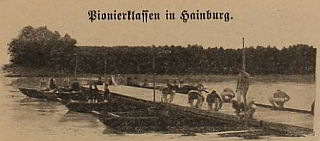
Heerwesen
,1916

Hainburger Kadettenschule is mentioned as Einjährigfreiwilliger Marek tells Švejk about the moronic Fähnrich Dauerling who did his training at this school.
Background
Hainburger Kadettenschule was a military educational establishment that existed from 1869 and to 1918. The institution was located in the former castle beneath Schlossberg in Hainburg and the official name was Pionierkadettenschule as it educated officers for the engineer troops. The education lasted four years and the capacity was 100 students.
In 1913 the school was merged with Technische Militärakademie in Mödling and the branch in Hainburg was thereafter named Technische Militärakademie - Pionierklassen[a]. Commander of the school in 1914 was Oberstleutnant Theodor Weidinger (1857-1938) from Pionierbataillon Nr. 2 (Linz).
After World War I the building was used as ordinary barracks, in 1945 taken over by the Red Army who left it in such a state that it had to be demolished[b].
Quote(s) from the novel
[II.2] Mladý Dauerling po hrozném zápase s čtyřmi třídami nižší reálky, které vystudoval soukromě, přičemž předčasně zešedivěl a zblbl jeho domácí učitel a druhý chtěl skočit v zoufalství se svatoštěpánské věže ve Vídni, přišel do hainburské kadetní školy. V kadetce se nikdy nedbalo na předběžné vzdělání, neboť to většinou nehodí se pro rakouské aktivní důstojníky.
[II.2] Žák kadetky Dauerling nevynikal ani v těch předmětech, které každý jakžtakž ovládal. I v kadetce bylo znát stopy toho, že si Dauerling v mládí narazil hlavičku.
[II.2] ... že profesoři kadetky jinak ho nenazývali než ,unser braver Trottel’.
Also written:Hainburská kadetní školacz
Literature
- Geschichte Hainburgs
- 50 Jahre Militär-Bildungsanstalt29.9.1918
- Schematismus für das k.u.k. Heer (s. 1088)1914
- Generalmajor d. R. Theodor Weidinger6.5.1938
- Der Oberste Kriegsherr und sein Stab1908
| a | AT-OeStA/KA MEB PKS Hainburg | ||
| b | Kalender mit Ansichten Hainburg einst und jetzt | 2010 |
 | Theresianische Militärakademie |  | ||||
| Wiener Neustadt, Burgplatz 1 | ||||||
| ||||||
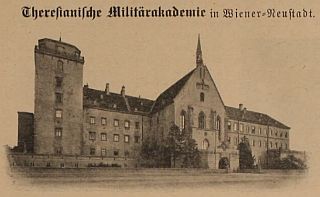
Heerwesen, , 1916
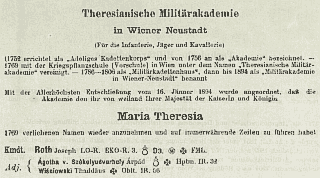
Theresianische Militärakademie is the academy where, according to Einjährigfreiwilliger Marek, the biggest idiots end up.
Background
Theresianische Militärakademie is the oldest existing military academy in the world, located in Wiener Neustadt. It was founded by empress Maria Theresa on 14 December 1751 and educated officers for infantry and cavalry. The course lasted for 3 years and graduates automatically obtained the rank Leutnant. Today it is Austria's only remaining military educational establishment.
The academy was then like now located in the castle and has been known as Theresianische Militärakademie since 1894. The commander in 1914 was Feldmarschall-Leutnant Joseph Roth (1859-1927) who from August served in the field. He particularly distinguished himself during the battle by Limanowa in December[a].
Quote(s) from the novel
[II.2] Jeho odpovědi při zkouškách jasně hovořily o tom neštěstí a vynikaly takovou pitomostí, a byly považovány přímo za klasické pro svou hlubokou pitomost a popletenost, že profesoři kadetky jinak ho nenazývali než ,unser braver Trottel’. Jeho hloupost byla tak oslňující, že byla největší naděje, že snad po několika desetiletích dostane se do tereziánské vojenské akademie či do ministerstva vojenství.
Also written:Theresian Military AcademyenTereziánská vojenská akademieczTheresianum Katonai Akadémiahu
Literature
| a | Josef Freiherr Roth von Limanowa-Lapanów |
 | Kutnohorský hotel |  | |||
| |||||
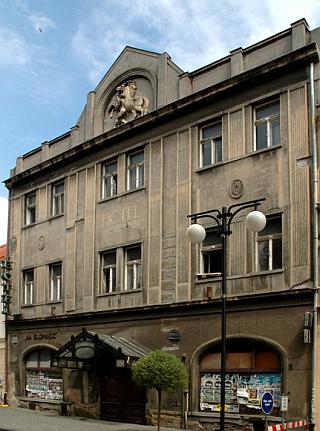
Former Hotel Černý kůň

Guide to the Bohemian section and to the Kingdom of Bohemia, 1906
Kutnohorský hotel was the scene of a row between Major Wenzl (then still a captain) and the head waiter of the hotel restaurant. The captain called the waiter "Czech rabble" and this caused waves all the way to Reichsrat since Kadettstellvertreter Zítko had revealed the episode to the local newspaper.
Background
Kutnohorský hotel (a hotel in Kutná Hora) is from the novel alone impossible to identify as there were several hotels in the city. Only by studying Dobrý voják Švejk v zajetí do we get any further. Here the episode is very similar and the author explicitly states that Major Wenzl swore at the head waiter of Haškův hotel (Hašek's hotel).
The term suggests that Jaroslav Hašek referred to Hotel Černý kůň (The Black Horse) in Kollárova ulice 314/6. The owner from 1892 was Emil Hašek but by 1906 he had sold it and established a new hotel in Prague opposite Severozápadní nádraží. The owner of the hotel in Kutná Hora in 1912 was Arnošt Moravec. Despite the change of owner it may still have been known as Hašek's hotel when Jaroslav Hašek visited the city in 1914 and also when Franz Wenzel, the prototype of Major Wenzl, served there from 1 May 1913 until after the outbreak of war.
Dobrý voják Švejk v zajetí
Major Wenzl nebyl sice žádná zvláštní vojenská hvězd rakouská, ale měl strach z národnostních sporů. Měl za manželku Češku a kdysi, když ještě sloužil jako hejtman v Kutné Hoře, přišel do novin, poněvadž jednou v napilosti vynadal číšníkovi v Haškově hotelu "česká pakáž", ačkoli mluvil sám jinak jen česky v domácnosti i ve společnosti.
Quote(s) from the novel
[II.2] Když před lety sloužil jako hejtman v Kutné Hoře vynadal jednou v opilosti v jednom hotelu vrchnímu, že je česká pakáž. Upozorňuji přitom, že ve společnosti mluvil major Wenzl výhradně česky, stejně jako ve své domácnosti, a že jeho synové studují česky.
[II.2] Slovo padlo, a už to bylo v místních novinách a nějaký poslanec interpeloval chování hejtmana Wenzla v hotelu ve vídeňském parlamentě.
Literature
 | Apollo |  | ||||
| Praha II./1866, Fügnerovo nám. 4 | ||||||
| ||||||


, 14.2.1914 (Kisch)
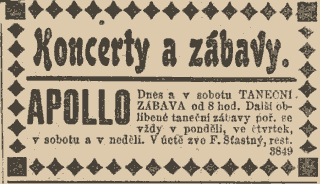
, 25.2.1915
Apollo is mentioned in the story Švejk tells Einjährigfreiwilliger Marek about Mlíčko who had been wounded very early in the war and became an artificial leg. In a brawl at Apollo some butchers tore the leg off and whacked him on the head with it.
Background
Apollo was a large night café with dancing at Fügnerovo náměstí in Nové město, not in Vinohrady as Švejk says.
Newspaper adverts indicate that Apollo existed from 1897. An advert i Prager Tagblatt desribes it as Grand-Restaurant[a]. The adverts also reveal that the large restaurant hosted meetings for associations and political parties. Who owned it from the beginning is not known but in 1900 Jan Beutler was teaching dancing there. In 1902 and 1906 the owner was Antonín Žalud (he had lived at the address since 1901[c]), and in 1910 František Šťastný who had lived at the address since 1906[d].
Throughout 1915 adverts for dance entertainment appeared in Národní listy, and it confirms that Šťastný was still the landlord (he is listed as such in the address book of 1910). The adverts continued until 1917 but in the address book from 1924 the establishment does not longer exist on the premises.
Verbotene Lokale
On 15 February 1914 an article by Egon Erwin Kisch was printed in Bohemia. It listed 11 establishments that were forbidden to enter for ordinary soldiers from the Prague garrison[b]. The ban came into effect on 25 January 1907. The article was later printed in the book Die Abenteuer in Prag (1920), now titled Konsignation über verbotene Lokale.
Quote(s) from the novel
[II.2] Jednou přišel do ,Apolla’ na Vinohradech a tam se dostal do sporu s řezníky z porážky, kteří mu nakonec utrhli umělou nohu a praštili ho s ní přes hlavu.
Sources: Jaroslav Šerák, Egon Erwin Kisch
Literature
- Velkorestaurace "Apollo"1900
- Zábavy a koncerty15.6.1902
- Velkou veřejnou schůzi voličů - živnostíků4.4.1909
- Koncerty a zábavy25.2.1915
- Konsignation über verbotene Lokale
- Románové restaurační a jiné zábavní podniky2009 - 2021
| a | Vergnügungsanzeiger | 18.4.1897 | |
| b | Verbotene Lokale | Egon Erwin Kisch | 15.2.1914 |
| c | Pobytové přihlášky pražského policejního ředitelství | 1851 - 1914 | |
| d | Pobytové přihlášky pražského policejního ředitelství | 1851 - 1914 |
 | Porážka |  | |||
| Královské Vinohrady/973, Korunní tř. - | |||||
| |||||
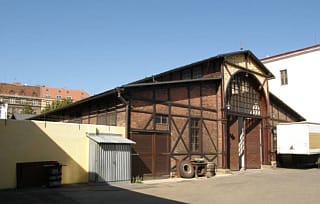
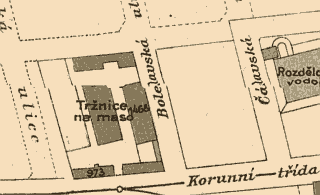
Porážka (the slaughterhouse) is mentioned in the story Švejk tells Einjährigfreiwilliger Marek about Mlíčko who had been wounded very early in the war and became an artificial leg. In a brawl at Apollo some butchers from the slaughterhouse tore the leg off and whacked him on the head with it.
Background
Porážka is not named directly but to judge from the plot it appers to have been located near Apollo or Vávrova ulice. However, no slaughterhouse was located in the immediate vicinity so one is forced to look further away. The most obvious candidate is the city slaughterhouse and meat market in Vinohrady. It was located in Vinohrady no. 973 Korunní třída, but 2.3 kilometres away.
There was also a private slaughterhouse in Vinohrady, at Paláckého tř. 56. This one is closer to Apollo but still almost 1 km away. In 1912 it belonged to Eugen Bossanyi.
Considering the significant distance to both slaughterhouses and the fact that Švejk claimed that Apollo was located in Vinohrady it is tempting to believe that Švejk mixed up Apollo with some pub in Vinohrady that was situated much closer to the slaughterhouses.
Quote(s) from the novel
[II.2] Jednou přišel do ,Apolla’ na Vinohradech a tam se dostal do sporu s řezníky z porážky, kteří mu nakonec utrhli umělou nohu a praštili ho s ní přes hlavu.
Literature
 | Rudolfinum |  | |||
| Praha I./79, Rudolfovo nábřezí 10 | |||||
| |||||

, 1900
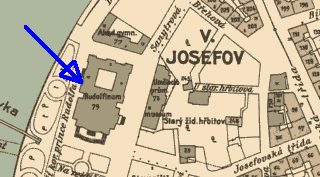
, 1909-1914
Rudolfinum is mentioned by Einjährigfreiwilliger Marek when he in the arrest in Budějovice tells the guard that the loud singing by the two inmates is because they form a branch of Rudolfinum and that they are performing a war symphony.
Background
Rudolfinum is a concert hall and art centre in Staré město on the banks of Vltava next to Josefov. It was opened in 1884[a] and named after Crown Prince Rudolf. It is mostly used for concerts and art exhibitions.
Quote(s) from the novel
[II.2] „Pardon,“ odpověděl jednoroční dobrovolník, „.zde je filiálka Rudolfina, koncert ve prospěch uvězněných. Právě ukončeno první číslo programu: ,Válečná symfonie’.
Literature
| a | Adresář královského hlavního města Prahy a obcí sousedních | 1910 |
 | Budějovický hotel |  | |||
| |||||
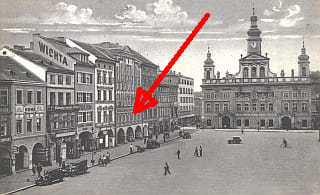
Hotel Slunce / Hotel Sonne, 1935
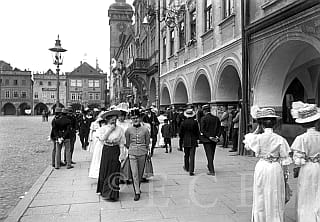
Many officers are seen here in front of Hotel "Silberne Glocke" (now Hotel Zvon).

,15.6.1909

, 29.12.1914
Budějovický hotel (a hotel in Budějovice) was the scene of a drinking binge amongst officers from IR. 91, described by the narrator himself. Central to the description is the mood of Oberst Schröder and him remembering the good old days when officers really knew how to drink and how they engaged in imaginative debauchery (see Hauptmann Skoday). Apart from Schröder the others who participated were Hauptmann Ságner, Major Wenzl, Oberleutnant Kretschmann, Hauptmann Spíro and some reserve officers. Schröder despised the reserve officers and also bemoaned the fact that the regular officer Oberleutnant Lukáš didn't want to mix with his colleagues.
Background
Budějovický hotel is an unnamed hotel in Budějovice that almost certainly was located in the centre. It is tempting to believe that the author had either Hotel Slunce or Hotel Zvon in mind as they were often visited by military personnel. Both hotels were located at Budějovické náměstí and thus only a short walk from Mariánská kasárna.
Hotel "Silberne Glocke"
Hotel "Silberne Glocke" (Hotel "U střibrného zvonu") was situated on the eastern side of the square. This part was mainly frequented by Germans, including officers[a] so it would have been a natural place for gatherings like the one described in The Good Soldier Švejk. This hotel was a high-end establishment where several members of the house of Habsburg are known to have stayed when visiting Budweis. Amongst the celebrities are Emperor Franz Joseph I., Archduke Franz Ferdinand and Archduke Friedrich.
On the facade of the hotel, the name was displayed in German only, quite unusual for this mixed population city with a Czech majority. In 1914 the hotel was managed by Anton Rödl. The hotel is still operating, now (2021) under the name Hotel Zvon.
Hotel "Slunce"
Hotel "Slunce" (Hotel "Sonne") was located on the southern perimeter of the city square and was popular with one-year volunteers (including Hašek) and it is well documented that officers also visited. Even colonel Karl Schlager, the model of the literary Oberst Schröder dropped by during a celebration in December 1914 for newly graduated reserve officers from k.k. Landwehrinfanterieregiment Nr. 29[b]. The fact that Hašek himself frequented it suggests that this was indeed the hotel he had in mind. In 1914 the hotel was managed by Bedřich Sandholec and it is still (2021) operating, now under the name Hotel Dvořák.
Quote(s) from the novel
[II.2] Zatímco jednoroční dobrovolník pronášel zdrcující kritiku poměrů v kasárnách, plukovník Schröder seděl v hotelu ve společnosti důstojníků a poslouchal, jak nadporučík Kretschmann, který se vrátil ze Srbska s bolavou nohou (trkla ho kráva), vypravoval, jak se díval od štábu, ku kterému byl přidělen, na útok na srbské posice.
Literature
| a | Voják Jaroslav Hašek v Českých Budějovicích | ||
| b | Kameradschafts-Abend | 29.12.1914 |
 | Budějovické divadlo |  | |||
| Budějovice I./424?, Divadelní ulice 19 | |||||
| |||||
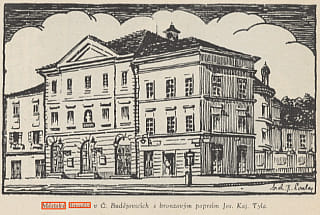

, 24.10.1914
Budějovické divadlo (a theatre in Budějovice) was where Oberleutnant Lukáš fell in love with Mrs. Schreiterová, the wife of an engineer. This according to Hauptmann Ságner.
Background
Budějovické divadlo is an unnamed theatre in Budějovice but we can with relative confidence assume that Hauptmann Ságner refers to Městské divadlo/Stadttheater (the city theatre). The building is located by the banks of Malše at the southern end of ulice Dr. Stejskala, in 1915 Divadelní ulice/Theatergasse. The theatre still exists (2021), now called Jihočeské divadlo (South Bohemian theatre).
Quote(s) from the novel
[II.2] „On skládá básničky,“ posměšně se ozval hejtman Ságner, „sotva přijel, tak se zamiloval do paní inženýrové Schreiterové, s kterou se setkal v divadle.“
Literature



|
II. At the front |
 | |
3. Švejk's happenings in Királyhida | |||
 | Lada |  | ||||
| Praha II./1733, Křemencová ul. 13 | ||||||
| ||||||

,15.12.1902

, 1910
Lada is briefly mentioned in Švejk's anecdote about negro Kristian. A female teacher wrote poems about shepherds and streams in the forest and published them in Lada. She also fornicated with an Abyssinian king and gave birth to the mentioned Kristian.
Background
Lada was a women's magazine that was published by Karel Vačlena in Mladá Boleslav with Věnceslava Lužická as its Prague-based editor[a]. It was published from 1889 to 1944 and a like-named magazine also appeared from 1861 to 1866. Whether there was a connection between the two is not known but in any case, Švejk definitely referred to the newer publication. In 1910 the magazine was published twice a month.
The magazine did print poems (at times even on the front page) but anything about shepherds and streams in the forest has not been found so far. At present (December 2021), only the year 1902 is publicly available.
Quote(s) from the novel
[II.3] Do toho se zamilovala jedna učitelka, která psala básničky do ,Lady’ vo pastejřích a potůčku v lese, šla s ním do hotelu a smilnila s ním. jak se říká v písmu svatým, a náramně se divila, že se jí narodil chlapeček úplně bílej.
| a | Adresář královského hlavního města Prahy a obcí sousedních | 1910 |
 | Kateřinky |  | ||||
| Praha II./468, Kateřinská ul. 30 | ||||||
| ||||||

15.5.1906 • Pohled na vstupní portál domu čp. 468 v Kateřinské ulici na Novém Městě.

Kateřinky is mentioned in Švejk's story about negro Kristian. His mother was taken admitted to this asylum when she discovered that the dark skin of her son indeed was real.
It almost certainly the very institution where Švejk himself spent some time before the outbreak of war. See blázinec.
Background
Kateřinky was the colloquial name of a hospital for the mentally ill in Nové město. The official name was Královský český zemský ústav pro choromyslné v Praze, established in 1822[a]. It had subsidiaries at Na Slupi and Bohnice. These institutions still exist (2021).
Hašek at Kateřinky
Here Jaroslav Hašek spent some time in February 1911 after an apparent suicide attempt, where he tried to jump from Karlův most. Shortly after he was released he printed a story that in part seems related to this episode[b]. Nor is there any doubt that Hašek's stay here inspired the chapter on Švejk at blázinec.
It has been claimed that this suicide attempt was staged but the fact is that he was hospitalised on 9 February and left on the 27. Hašek actually asked to be allowed to stay at the asylum because he wanted to get rid of his alcohol habits. According to Radko Pytlík the incident was triggered by a domestic quarrel[c].
Quote(s) from the novel
[II.3] Tak se z toho pomátla, začala se ptát v časopisech o radu, co je proti mouřenínům, a vodvezli ji do Kateřinek a mouřenínka dali do sirotčince, kde z něho měli náramnou legraci.
Literature
| a | Řivnáčův Průvodce po Praze a okolí | 1881 | |
| b | Psychiatrická záhada | Jaroslav Hašek | 24.4.1911 |
| c | Toulavé house | 1971 |
 | Varieté |  | |||
| Karlín/283, Palackého tř. 6 | |||||
| |||||

Praha moderní i historická ve 250 obrazech, ,1907
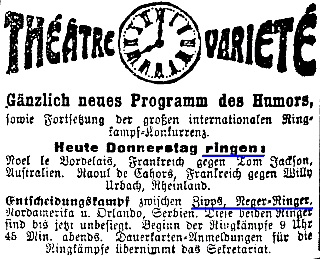
,18.4.1912

Průvodčí cizinců a jiné satiry z cest i domova, ,1913
Varieté is mentioned in Švejk's story about negro Kristian. Here it regards a case wehere a white lady unexpectedly gives birth to a black child. If this lady had been visiting Varieté on her own to watch a some negro in a game of wrestling one would certainly think certain thoughts.
Background
Varieté was the name of a theatre in Karlín that was opened in 1881. It is this one of the oldest theatres in Prague and is still operating, albeit with the name Karlín Music Theatre[a]. According to the address book from 1907 the official name was Théâtre Variété. Newspaper adverts reveal that they also arranged wrestling games[b].
Wrestling at Varieté
The thematic chain of Varieté-wrestling-negro is a re-use from two of Hašek's pre-war stories. Here the black wrestler is clearly identified as a North American champion with the surname Zipps[c][d]. This makes is straightforward to trace the inspiration for this sequence of The Good Soldier Švejk. In April 1912 Varieté arranged a major wrestling tournament and amongst the participants was the black wrestler Zipps [b].
Jak jsem přemohl černošského obra Zippse ze Severní Ameriky
Docílil snad vynálezce rádia Curie tak krásného výsledku, že německý zápasník Urbach položil se na lopatky za 5 minut? A dovolte ještě jednu otázku. Dostal někdy Svatopluk Čech do takového krásného mostu Skota Rankina, aby z toho mostu přehodil si onoho siláka přes rameno na zem, jako to udělal Zipps, ten šampión Severní Ameriky, o kterém mluvila celá Praha, když vystupoval v řeckořímských zápasech ve Varieté?
Machar si to velmi popletl s tou antickou kulturou. Nejsou to nějaké staré hrníčky, vykopané v Aténách a v Římě, ani básně starých Řeků a Římanů, synové Hélioví zanechali nám jiný, nehynoucí pomník, řeckořímské zápasy ve Varieté, kde z chumelenice hladkých těl vztyčuje se postava slavného zápasníka černocha Zippse, kterému jsem šlápl na kuří oko v Brejškově plzeňské restauraci.
Jaroslav Hašek, Dobrá kopa, 3.5.1912.
Quote(s) from the novel
[II.3] Ale najednou v nějakém kolenu že se vobjeví černoch. Představte si ten malér. Vy se voženíte s nějakou slečnou. Potvora je úplně bílá, a najednou vám porodí černocha. A jestli před devíti měsíci se šla podívat bez vás do Varieté na atletické zápasy, kde vystupoval nějakej černoch, tu myslím, že by vám to přeci jen trochu vrtalo hlavou.“
| a | Historie divadla | ||
| b | Théâtre Variété | 18.4.1912 | |
| c | Jak jsem přemohl černošského obra Zippse ze Severní Ameriky | Jaroslav Hašek | 3.5.1912 |
| d | Průvodčí cizinců a jiné satiry z cest i domova | 1913 |
 | Pražské ledárny |  | |||
| Praha VII./862, Ostrov Velké Benátky - | |||||
| |||||

Branické ledárny s ledovým zálivem
,1.1.1913
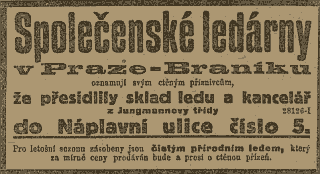
,14.3.1912
Pražské ledárny is mentioned in the conversation between Švejk and Einjährigfreiwilliger Marek on the way from Mariánská kasárna to Budějovické nádraží. It regards Franz Joseph Land and deliveries to Prague's ice works.
Background
Pražské ledárny was a company that delivered ice to breweries, restaurants, hospitals, dairies, butchers and other enterprises that used ice for cooling purposes. To judge by newspaper adverts it was established in 1884[a] and was privately owned. Owner in 1892 was Ivan Čížek and in 1896 Bernard Lüftschitz is listed as owner. In both cases there were also other ownersdet. The ice works were from located at Štvanice island (also called Velké Benátky).
In 1898 the city had plans to build a new ice plant that was better able to satisfy the growing demand. The plans didnẗ materialise but in 1901 Lüftschitz sold his ice works[c] to a newly formed co-operative company named Společenské ledárny v Praze. It was owned by its customers and in 1908 they had 234 members[d], a number that by 1912 had grown to 299.
In Dolní Krč existed a rival enterprise owned by Tomáš Welz. In 1913 they two companies merged.
New plant
From 1909 to 1911 a new and bigger plant was constructed at Braník south of the city. The construction cost was however so high that the firm went bankrupt, but convertion to a limited company and investment of fresh capital saved it. The new company was registered in 1913 under the name Akciové ledárny v Praze[e]. In 1914 it reported a profit.
The company operated until 1954 and the building is still intact but in need of repair (2021). It was since 1964 been under heritage protection.
Quote(s) from the novel
[II.3] Podle statistiky je tam samý led a vyváží se odtud na ledoborcích patřících pražským ledárnám. Tento ledový průmysl je i cizinci neobyčejně ceněn a vážen, poněvadž je to podnik výnosný, ale nebezpečný.
Literature
- Adresář královského hlavního města Prahy a obcí sousedních1892
- Adresář královského hlavního města Prahy a obcí sousedních1896
- Adresář královského hlavního města Prahy a obcí sousedních1910
- Prager Eiswerke12.7.1884
- Jak se děla led a v Praze na Vltavě zvláště1.2.1907
- Die Eiswerke in Branik19.2.1911
- Společenské ledárny v Praze akciovou společností22.2.1912
- Prazšké společenské ledárny31.3.1912
- Konkurs9.7.1912
- Ledárny7.9.1912
- (Die Eiswerke in Branik)13.3.1913
| a | Sägespäne | 12.1.1884 | |
| b | Prager Eiswerke | 1.11.1898 | |
| c | Genoßenschafs-Eiswerke in Prag | 23.1.1901 | |
| d | Společenské ledárny v Praze | 29.2.1908 | |
| e | Nové české podniky | 5.7.1913 |
 | K.k. Handelsministerium |  | |||
| Wien I., Postgasse 8 | |||||
| |||||
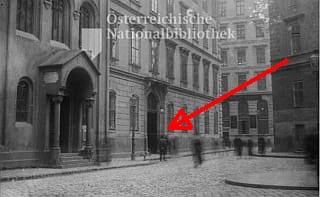
Nr. 10 (St. Barbara) und Nr. 8 (Handelsministerium).
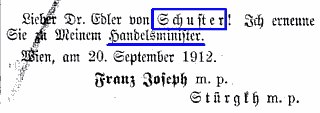
,21.9.1912
K.k. Handelsministerium is mentioned in the conversation between Švejk and Einjährigfreiwilliger Marek on the way from Mariánská kasárna til Budějovické nádraží. The theme is supply of ice from Franz Joseph Land.
Background
K.k. Handelsministerium was the ministry of trade of Cisleithania and one of nine ministeries[1] in the Austrian part of the Dual Monarchy. It was housed in Postgasse in the centre of Vienna. Secretary of trade from 20 September 1912 was Rudolf Schuster Edler von Bonott[a], an office he held until 30 November 1915[b].
The ministry of trade was one of the heavyweights of its kind in Cisleithania. Their areas of resposibility including trade, industry, the merchant fleet, mail, telephone, telegraph, customs, and from 1908 worker's welfare and social security[c].
1. Ministerium des/für Innern, Justiz, Unterricht, Finanz, Handel, öffentliche Arbeiten, Eisenbahn, Ackerbau, Landesverteidigung.
Quote(s) from the novel
[II.3] Nicméně úpravou klimatických poměrů, na které má velký zájem ministerstvo obchodu i zahraniční ministerstvo, je naděje, že budou náležitě využitkovány velké plochy ledovců.
Also written:R.I. Trade MinistryenC.k. ministerstvo obchoducz
| a | Amtlicher Teil | 21.9.1912 | |
| b | Amtlicher Teil | 1.12.1915 | |
| c | Grégrova příručka | 1912 |
 | K.u.k. Außenministerium |  | |||
| Wien I., Ballhausplatz 2 | |||||
| |||||
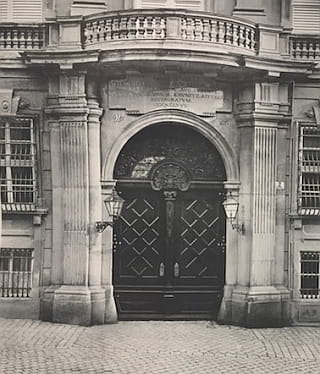
Ballhausplatz 2

,19.2.1912
K.u.k. Außenministerium is mentioned in the conversation between Švejk and Einjährigfreiwilliger Marek on the way from Mariánská kasárna til Budějovické nádraží. The theme is supply of ice from Franz Joseph Land.
Background
K.u.k. Außenministerium (officilally k.u.k. Ministerium des kaiserlichen und königlichen Hauses und des Äußern) was the ministry of foreign affairs for the Dual Monarchy, one of thre three common ministeries (the others were k.u.k. Kriegsministerium and k.u.k. Finanzministerium). It was housed at Ballhausplatz by Hofburg in the centre of Vienna.
Secretary of foreign affairs from february 1912 was Count Leopold Berchtold, an office he held until January 1915. Berchtold played the dominant role in the decision-making process in Vienna that led to war in the summer of 1914[a], and it was he who drafted the 10 point ultimatum to Serbia. Berchtold was succeeded by István Burián.
Not only foreign affairs
As is evident from the full title of the ministry it was not only tasked with running foreign affairs in the classic sense (diplomacy, embassies, consulates, foreign policy etc.). It was even responsible for archives of the Imperial and Royal House (k.u.k. Haus, Hof und Staatsarchiv)[b].
Quote(s) from the novel
[II.3] Nicméně úpravou klimatických poměrů, na které má velký zájem ministerstvo obchodu i zahraniční ministerstvo, je naděje, že budou náležitě využitkovány velké plochy ledovců.
Also written:I. and R. Foreign MinistryenC. a k. zahraniční ministerstvocz
Literature
| a | Ballhausplatz | ||
| b | Grégrova příručka | 1912 |
 | K.k. Unterrichtsministerium |  | |||
| Wien I., Minoritenplatz 5 | |||||
| |||||
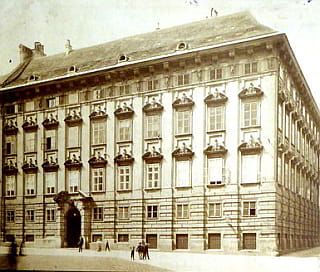
Palais des Unterrichtsministeriums
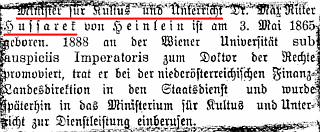
,4.11.1911
K.k. Unterrichtsministerium is one of three ministries mentioned by Einjährigfreiwilliger Marek in the conversation between him, Švejk and the escort Korporal on the way from Mariánská kasárna til Budějovické nádraží. The theme is the supply of ice from Franz Joseph Land.
Background
K.k. Unterrichtsministerium (officilally k.k. Ministerium für Kultus und Unterricht) was the ministry of culture and education for Cisleithania. It was housed at Minoritenplatz in the centre of Vienna.
Secretary of Education from 4 November 1911 was Max Hussarek von Henlein[a], a position he held until 1917.
Responsibilities
The ministry was responsible for education (apart from academies for trade, industry and agriculture), the Evangelical Church (Protestant), art, memorials, museums, science academies, meteorological institutes and son on[b].
Quote(s) from the novel
[II.3] „Ministerstvo vyučování, pane kaprále, zbudovalo pro ně s velkým nákladem a obětmi, kdy zmrzlo pět stavitelů...“ „Zedníci se zachránili,“ přerušil ho Švejk, „poněvadž se vohřáli vod zapálený fajfky.“
Also written:I.R. Education MinistryenC.k. ministerstvo vyučovánícz
Literature
| a | Inland | 4.11.1911 | |
| b | Grégrova příručka | 1912 |
 | Budějovický hotel (naproti nádraži) |  | |||
| |||||
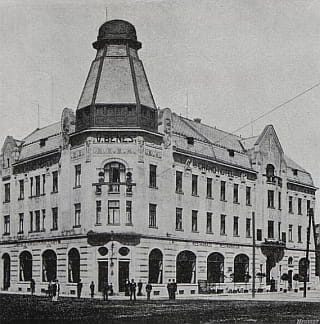
, 30.7.1909
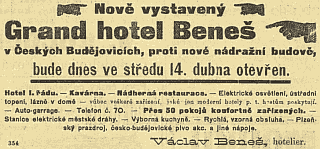
, 14.4.1909
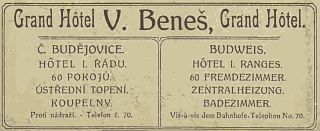
Budějovický hotel (naproti nádraži) (hotel opposite the station) is mentioned when the arrestees Švejk and Einjährigfreiwilliger Marek are escorted to Bud-Nad during the regiment's transfer from Budějovice to Bruck an der Leitha - Királyhida. From the windows of a hotel opposite the station, some ladies waved with handkerchiefs and shouted "Heil!".
Background
Budějovický hotel (naproti nádraži) refers to one of several hotels that were located around the railway station in Budějovice. Opposite the new station were situated Hotel Grand and Hotel Imperial, whereas opposite the old one were Hotel Bahnhof and Hotel Kaiser von Österreich[a]. Following the most direct route from Mariánská kasárna to Budějovické nádraží (the new station) the soldiers would first have arrived by Imperial but this hotel existed from 1924[b] so Grand remains as the obvious alternative. Nor should the two hotels by the old station be ruled out, but these were located further to the south so it is less likely that Hašek had one of these in mind.
Grand Hotel "Beneš"
This hotel opened in 1909 and the owner was Václav Beneš (1860-), an experienced hotel owner who also had managed Hotel U třech kohoutů and Hotel Slunce på Budějovické náměstí [c]. Grand was the most modern hotel in the city, equipped with electric lighting, central heating and parking space for automobiles, which was very rare at the time.
Prominent guests often stayed here and one example is Feldmarschall-Leutnant Simon Schwerdtner (see Generalmajor von Schwarzburg) who slept at Grand when he inspected the garrison in Budějovice in April 1915[d]. Other guests were Archduke Joseph Ferdinand and Erzherzog Leopold Salvator from the house of Habsburg, noblemen Baron Alfred Rotschild and Duke Ernst August von Cumberland, moreover military notabilities like Andeas Pitlik, Wenzel Wurm and (Arthur Gieslingen).
In 1918 Beneš sold the hotel[e], in 1949 was nationalised and renamed Hotel Vltava, until it in 1989 again became Grand. Today (2022) there is still a hotel and restaurant operating in the building, but according to the reviews at Google the standard is poor.
Quote(s) from the novel
[II.2] Byla to pořádná manifestace. Z hotelu naproti nádraží z oken mávaly nějaké dámy kapesníky a křičely „Heil!“ Do „nazdar“ mísilo se „heil“ i ze špalíru a nějakému nadšenci, který použil té příležitosti, aby vykřikl: „Nieder mit den Serben“, podrazili nohy a trochu po něm šlapali v umělé tlačenici.
Sources: Jan Schinko
Literature
- Hotel Grand
- Grand Hotel "Beneš" v Čes. Budějovicích20.8.1909
- Hotelu Internacional se nedařilo, skončil po dvanácti letech5.5.2016
| a | Hotely | ||
| b | "Imperial" - bar a kavárna | 31.10.1924 | |
| c | Původní majitel Grandu načasoval stavbu šikovně | 1.6.2017 | |
| d | Inspizierung | 16.4.1915 | |
| e | Hotelkauf | 21.6.1918 |
 | K.u.k. Kavallerietruppendivision Nr. 7 |  | ||||
| Kraków | ||||||
| ||||||
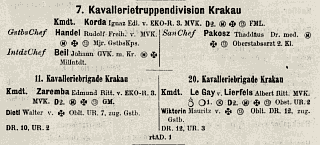
1914
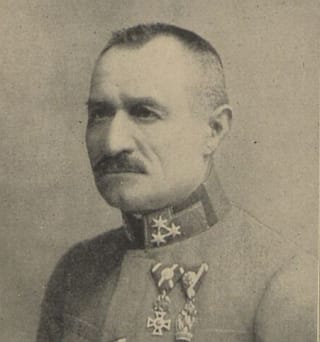
GdK. Ignaz Edler von Korda
Unteilbar und Untrennbar, , 1917
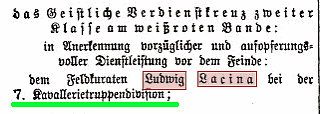
,25.12.1915
K.u.k. Kavallerietruppendivision Nr. 7 was according to the text of The Good Soldier Švejk the unit where Feldoberkurat Lacina served.
Background
K.u.k. Kavallerietruppendivision Nr. 7 was a cavalry division headquartered in Kraków, reporting to the 1. Korpskommando. The four regiments of the division were scattered across a large area: Dragonerregiment Nr. 10 (Kraków), Ulanenregiment Nr. 2 (Tarnów), Dragonerregiment Nr. 12 (Olmütz) and Ulanenregiment Nr. 3 (Gródek Jagielloński). The division's commander in 1914 was Feldmarschall-Leutnant Ignaz von Korda (1858-1918)[a]. The exact address of the divisonal HQ is not known.
Ludvík Lacina
The direct reason why the division is mentioned in The Good Soldier Švejk is that Ludvík Lacina, the model for Feldoberkurat Lacina was actually assigned to this unit from January 1913 to August 1916. That Jaroslav Hašek knew in such detail where Lacina served indicates that the two knew each other.
Cavalry divisions
At the outbreak of war k.u.k. Heer contained eight cavalry divisions, numbered 1 to 10 where the numbers 5 and 9 were unused. The divisions were organised in one to three brigades. These usually consisted of to Ulan- Hussar- or Dragon-regiments. The cavalry brigades in Bohemia (Prague and Pardubice) were not assigned to any particular division[a].
During the war
From 6 August 1914 the division operated on Russian soil in the area around Kielce, north of Krákow. From May 1915 in the offensive in Russian Poland and in the autumn they operated by the river Styr (Стир) east of Lutsk (Луцьк) in current Ukraine. At the turn of the year, they were stationed by Brody. During the Brussilov offensive (from 4 June 1916) it suffered disastrous losses and was no longer of value as a fighting unit. After reinforcement and recuperation, they were in November 1916 moved to the new front against Romania.
Quote(s) from the novel
[II.3] Tak vešli na nádraží a šli k určenému vojenskému vlaku, když málem by byla ostrostřelecká kapela, jejíž kapelník byl vážně popleten nečekanou manifestací, spustila „Zachovej nám, Hospodine“. Naštěstí v pravé chvíli objevil se v černém tvrdém klobouku vrchní polní kurát páter Lacina od 7. jízdecké divise a počal dělat pořádek.
[II.3] Pohlcoval mísy s omáčkami a knedlíky, rval jako kočkovitá šelma maso od kostí a dostal se v kuchyni nakonec na rum, kterého když se nalokal, až krkal, vrátil se k večírku na rozloučenou, kde se proslavil novým chlastem. Měl v tom bohaté zkušenosti a u 7. jízdecké divise dopláceli vždy důstojníci na něho.
[II.3] Dostal nyní nový záchvat velkodušnosti a tvrdil, že všem udělá dobře, jednoročnímu dobrovolníkovi že koupí čokoládu, mužům z eskorty rum, desátníka že dá přeložit do fotografického oddělení při štábu 7. jízdní divize, že všechny osvobodí a že na ně nikdy nezapomene.
| a | Schematismus für das k.u.k. Heer (s. 80) | 1914 |
 | 12. Kompanie |  | |||
| |||||

12. Feldkompanie reconstituted 11.7.1915.
"Das Infanterieregiment Nr.91 am Vormarsch in Galizien", , 1927.

Some names from 12. Feldkompanie. These soldiers were decorated on 18.8.1915.
© VÚA/VHA
12. Kompanie is mentioned on the train from Budějovice to Bruck an der Leitha - Királyhida. The author remarked that the company consisted of Germans from Krumlovsko and Kašperské Hory.
In [IV.3] it is revealed that they were commanded by some Kompaniekomandant Zimmermann.
Background
12. Kompanie is not unambiguously identifiable but the numbering indicates that it was meant one of the 16 field companies of Infanterieregiment Nr. 91. This assumption does however have a weakness. The plot at this stage takes place at the replacement battalion in Budějovice whereas the field companies had been fighting at the front since the start of the war. Thus one would assume that the company was an Ersatzkompanie or Marschkompanie. However, this is at odds with the fact that in 1915 these companies were never numbered as high as 12. The march battalions usually consisted of four companies and the reserve battalions rarely more than that.
This contradiction is rather a result of the author of The Good Soldier Švejk didn't bother much about details like the numbering of military units and the logical connection between them. See also 11. Kompanie.
12. Feldkompanie
Throughout the novel Hašek consistently uses the numbering of field companies when he refers to "march companies" or simply "companies". This connection is particulalrly evident with the fictional "11th march company" where not only the number is borrowed from the corresponding field company but also the people in the command hierarchy (Rudolf Lukas, Čeněk Sagner). Thus there is every reason to assume that the same applies to 12. Kompanie. This company was one of four in III. Feldbataillon, the battalion that from 3 July 1915 was commanded by Sagner. The company commander from 11 July was Paul Kandl (1884-?), a reserve lieutenant from Prachatice[b] who propably arrived at the front with XII. Marschbataillon and surely was the commander of one of the battalion's four march companies. The 12th company was probably created directly from one of the four newly arrived march companies.
Jaroslav Kejla
Jaroslav Kejla who was taken prisoner together with Hašek on 24 September 1915 by Choruoan wrote about the four months he served with the company. As opposed to 11. Kompanie they were miserable catered for and parts of their rations were frequently stolen. The soldiers were dirty, exhausted, hungry, lice-ridden, and demoralised and during these four months, Kejla had a bath only once! He explained the difference between the 11th and the 12th company by the fact that the commander of the 11th company, Rudolf Lukas, was on friendly terms with battalion commander Čeněk Sagner and that his company, therefore, were better provided for[b].
Quote(s) from the novel
[II.3] Teprve řev z vagonů vzadu přerušil vypravování Švejkovo. 12. kumpanie, kde byli samí Němci od Krumlovska a Kašperských Hor, hulákala: Wann ich kumm, wann ich kumm, wann ich wieda, wieda kumm.
| a | Das Infanterieregiment Nr. 91 am Vormarsch in Galizien | 1927 | |
| b | Jak to bylo v bitvě u Chorupan kde se dal Jaroslav Hašek zajmout | 1972 |
 | Svět zvířat |  | ||||
| Smíchov/908, Bělohorská silnice | ||||||
| ||||||
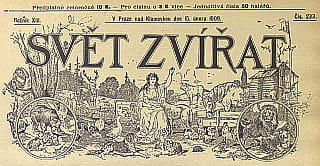
, 1.11.1909

, ~ 1900
Svět zvířat is the theme of the longest anecdote in the entire novel, Einjährigfreiwilliger Marek's monologue in the prison carriage on the way from Budějovice to Bruck an der Leitha - Királyhida. He relates in great detail about his experiences as an editor of this magazine.
It started when Hájek, his friend, was fired as editor by the magazine's owner Václav Fuchs after having fallen in love with the owner's daughter. Hájek was also given the task of finding a new editor and he picked Einjährigfreiwilliger Marek who subsequently was interviewed as the prospective editor. He was questioned on his knowledge about animals, if he was capable of cutting and translating from foreign periodicals, from Brehm and his classic "The Life of Animals", and how he envisaged the content of the magazine. Marek answered that he would introduce novelties like "Animals on animals", "The jolly corner" and about "The development from animal to human". Fuchs was convinced and employed Marek. In the beginning it all went well, but dark clouds were soon to gather above the head of the new editor.
The inventive editor Marek however soon hit upon the idea that he ought to contribute even more to zoology than the venerable Brehm had done in his "World of Animals". The creatures from this book were after all well known and would thus be of little interest to the reader. At least this is what the newly appointed editor of the magazine thought. Out of the hat he pulled novel creatures like "The sulphur-bellied whale", "The Icelandic remote bat", "Engineer Khún's flea" etc. This flea would eventually trip up Marek's career at the magazine because it became the theme of a polemic between the newspapers Čech and Čas, where the latter blew the entire story. This incident, in addition to a heated debate with Jos. M. Kadlčák about the name of the jay eventually led to the editor being dismissed and even to Fuchs's premature death.
Background

, 15.8.1910
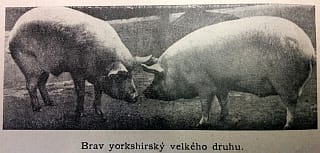
Many themes from the magazine found their way into The Good Soldier Švejk
Svět zvířat was a Czech language magazine with a focus on animals that was founded by the rabbit- and dog-breeder Václav Fuchs in 1897. It started as a monthly in Jičín but already in 1898, Fuchs moved to a villa above the Klamovka gardens in Smíchov and from here he continued to publish. From 1901 the magazine was issued twice a month. Associated with the magazine and the villa was a kennel (see Psinec nad Klamovkou). The founder and owner Fuchs died in 1911 but the magazine seems to have continued at least until 1923. The best known editors were Karel Ladislav Kukla, Jaroslav Hašek and Ladislav Hájek.
Hašek at Klamovka
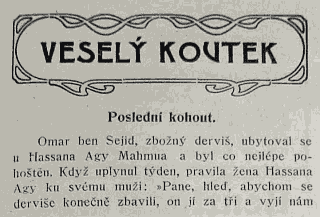
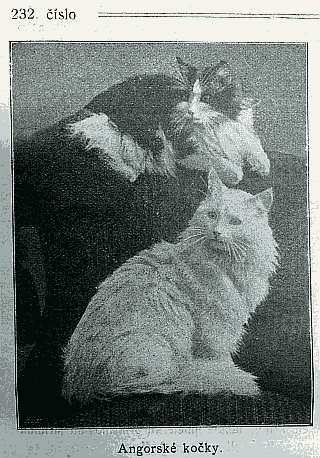
, 22.2.1909
In 1908 the above mentioned Hájek, one of Jaroslav Hašek's closest friends, became chief editor of Svět zvířat. It was he who later that year brought Hašek to Klamovka where he was offered to stay provided that he contributed to the editorial work. Hájek who was in love with the owner's daughter at some stage fell out with his boss and resigned as editor. He had hoped that Hašek would show some solidarity and leave together with him but the "traitor" Hašek instead took over his job[a]. This seems to have happened in January or February 1909. Hájek found a new job as editor of the newspaper Nezavislost in Poděbrady.
According to the police registers Hašek lived in the villa from 4 February 1909 until 28 July 1910[b]. Then he is registered at Smíchov No. 1125, below the Klamovka gardens. Note that these are registered dates and may not necessarily correspond to the actual dates he moved.
Permanently employed
Hašek's engagement with Svět zvířat was only the second time he was permanently employed and this time he lasted somewhat longer, probably around 20 months. He was decently paid and was finally able to convince his future father-in-law that he was worthy of his daughter and would live an orderly life. In the beginning, Václav Fuchs was satisfied with him but became increasingly discontent as his editor spent less and less time in the office. He had also been alarmed by reports on incredible stories about animals that appeared in his magazine. Fuchs drove to Poděbrady and begged Hájek to return. A confrontation with Hašek took place and he asked for mercy and was allowed to stay on for another three months[a]. In the end, he left and started his own dog trade, another short-lived enterprise that is also mirrored in The Good Soldier Švejk. The last story by Hašek appeared on 15 October 1910 and Hájek was in charge again by the same time[c].
Václav Fuchs died in 1911 and the kennel was taken over by František Pober, his son-in-law. Pober already owned the kennel Canisport and now moved to Klamovka, and in effect merged the two firms. The editorial offices were however relocated to Hájek's flat at Ferdinandova třida (now Narodní). In the autumn of 1912, Hašek again stayed with him and also contributed to the magazine. Hájek continued as editor until 1915.
Mystification
Although Hašek surely wrote some inventive items in Svět zvířat one should be careful in taking the events described in The Good Soldier Švejk at face value. It is highly probable that Hašek at least spiced up Einjährigfreiwilliger Marek's story and invented certain details. A systematic comparison of Marek's account of his time as an editor with the actual content of the magazine has to my knowledge never been carried out (2022)[1]. Altogether 33 stories and articles from the magazine have been identified as written by Hašek. Most of them are signed by himself but there are also some signed with a pseudonym or even left unsigned[d]. In addition there are several shorter notes that one assumes he is behind.
The Animal World mirrored in Švejk
With Einjährigfreiwilliger Marek's story, there is a very direct connection to Hašek's own time as editor in 1909 and 1910, but there are themes from other parts of The Good Soldier Švejk that also can be traced back to the magazine. One of such is no doubt the story about Rittmeister Rotter and his police dogs. Then here are animals like Leonberger (dog), Engadin (goat), Yorkshire (pig), and Angora (cat). However, one has so far (January 2024) seen no traces of animals that Marek invented, so here Hašek surely mystified his own mystifications.
Quote(s) from the novel
[II.3] Jednoroční dobrovolník chvíli o něčem přemýšlel a pak se obrátil na zdrceného desátníka: „Jestlipak znáte časopis ,Svět zvířat’?“
[II.3] Jak jsem se vlastně stal kdysi redaktorem ,Světa zvířat’, onoho velice zajímavého časopisu, bylo pro mne nějaký čas hádankou dosti složitou do té doby, kdy jsem sám přišel k tomu názoru, že jsem to mohl provést jen ve stavu naprosto nepříčetném, ve kterém jsem byl sveden přátelskou láskou ku starému kamarádovi Hájkovi, který redigoval do té doby poctivě časopis, ale zamiloval se přitom do dcerušky majitele časopisu pana Fuchse, který ho vyhnal na hodinu pod tou podmínkou, že mu zaopatří redaktora pořádného.
[II.3] Prohlásil jsem, že jsem již velice mnoho přemýšlel o správném vedení takovéhoto časopisu, jako je ,Svět zvířat’, a že všechny ty rubriky a body dovedu plně reprezentovat, ovládaje zmíněné náměty.
[II.3] Vycházel jsem z toho principu, že na př. slon, tygr, lev, opice, krtek, kůň, čuně atd. jsou dávno již každému čtenáři ,Světa zvířat’ úplně známými tvory.
[II.3] Mohu vás ubezpečit, že jsou vůbec čtenáři ,Světa zvířat’ velice zvědaví.
[II.3] Z této nepatrné události vyvinula se veliká polemika mezi ,Časem’ a ,Čechem’, poněvadž ,Čech’ v rozmanitostech ve svém feuilletonu, cituje článek o bleše mnou objevené, prohlásil: ,Co Bůh činí, dobře činí.’ ,Čas’ přirozeně čistě realisticky rozbil celou mou blechu i s velebným ,Čechem’, a od té doby zdálo se, že mne opouští šťastná hvězda vynálezcova a objevitele nových stvoření. Abonenti ,Světa zvířat’ začali se znepokojovat.
[II.3] Můj šéf, pan Fuchs, seděl jako vždy v kavárně a četl krajinské noviny, poněvadž poslední dobou náramně často hledal zmínky o mých poutavých článcích ve Světě zvířat, a když jsem přišel, ukázal na ležící na stole ,Selský obzor’ a řekl tiše, dívaje se na mne svýma smutnýma očima, který výraz měly jeho oči stále poslední dobou.
[II.3] Četl jsem klidně dál: ,Nato jsem od vašeho redaktora ,Světa zvířat’ obdržel dopis nesmírně hrubého, osobního a neomaleného rázu, kde jsem byl nazván trestuhodně ignorantským hovadem, což zasluhuje pokárání důrazného. Tak se neodpovídá na věcné vědecké výtky mezi slušnými lidmi. Rád bych věděl, kdo je z nás obou větší hovado. Snad, pravda, neměl jsem činiti výtky dopisnicí a dopsati listem, ale pro nával práce nevšiml jsem si té malichernosti, ale nyní po sprostém výpadu vašeho redaktora ,Svět zvířat’ vedu na veřejný pranýř.
[II.3] Než to jsou věci vedlejší, ač by zajisté nebylo na škodu, kdyby se váš redaktor ,Světa zvířat’ dříve přesvědčil, komu vytýká hovadinu, nežli nájezd vyjde z pera, třeba je určen na Moravu do Frýdlandu u Místku, kde byl do tohoto článku též odbírán váš časopis.
[II.3] Sojka zůstane sojkou, i kdyby se redaktor ,Světa zvířa’ z toho podě..l, a zůstane to jen dokladem, jak lehkomyslně a nevěcně se leckdys píše, byť by se i on dovolával Brehma nápadně neurvale.
Sources: Ladislav Hájek, Jaroslav Šerák, Radko Pytlík
Also written:The Animal WorldenDyreverdano
| 1. | Update 2023: Some studies were carried out by Břetislav Hůla and Radko Pytlík, published in Malá zoologická zahrada (1950) and Zábavný a poučný koutek Jaroslava Haška (1973). |
Literature
- O jednom hrozném psuJaroslav Hašek15.2.1909
- Milostný román lidoopa konsula Petra15.5.1909
- Moderní lov velrybFrant. Winter1.6.1909
- Účinek hudby na zvířata15.6.1909
- Oslík Guat. Jaroslav Hašek15.6.1909
- Opilství mezi zvířaty1.8.1909
- Objevení severní točnyJaroslav Hašek15.9.1909
- Vítězný boj o severní točnu. 1.10.1909
- Štědrý večer Jana Gočvary a Michala BeckovjanaJaroslav Hašek15.12.1909
- Karikatury v říši zvířat1.1.1910
- Akciová továrna na výrobu vajecLaszló Emmere1.1.1910
- Sedm mudrců od východu uvažuje o škodlivosti alkoholu1.1.1910
- Manželská věrnost v říši zvířat. Dr. Th. Zell1.1.1910
- Největší dravec světa. 15.2.1910
- O domýšlivém kocouru BobešoviJaroslav Hašek15.3.1910
- První apríl pana FabiánkaJaroslav Hašek1.4.1910
- Význam hospodářské výstavy pro povznesení chovu domácího zvířectva. Jaroslav Hašek15.5.1910
- Jak pan Rosol fotografoval pytláka. A.K.15.5.1910
- Utrpení zvířatdr Vilém Stanko1.6.1910
- Před ukončením školního rokuJaroslav Hašek1.7.1910
- Některé záhady pravěkuJaroslav Hašek15.8.1910
- Chirurgie a celní sazba15.9.1910
- Sdružování mezi zvířatyJosef Pexider15.10.1910
- Odstraňte bolest!Vladmír Mayer15.10.1910
- Na výstavě psůJaroslav Hašek15.5.1912
- Z přírodopisu mrzutého profesora: Kanár obecný. Wilde1.7.1912
- Vánoční noc v leseJaroslav Hašek15.12.1912
- Silvestr zajíce s černou skvrnou na břišeJaroslav Hašek1.1.1913
- Ohař pana baronaJaroslav Hašek1.2.1913
- Nač vše se děti ptajíJ.H1.2.1913
- O spletené rosničceJaroslav Hašek15.2.1913
- O slepičce idealistceJaroslav Hašek15.3.1913
- O nejošklivějším psu BalabánoviJaroslav Hašek15.4.1913
- Kobyla DžámaJaroslav Hašek15.5.1913
- V přírodovědeckém časopiseJaroslav Hašek31.7.1911
- Zvláštní zvířeJaroslav Hašek6.6.1912
- Můj obchod se psy a jiné humoresky1915
- Básník Louis Křikava, jinak Blažej Jordán zvanýJ. Hašek3.10.1937
- ......a hledal psinec a redakci "Světa zvířat"
- Toulavé house1971
- Ústřední stanice6.12.1908
- Ochočení vlci15.4.1909
- Haškova blecha a katolická věda21.8.1913
- Život v přirodě (Svět zvířat)25.12.1925
- Rybí jikry, které se dávají vysedět kvočnám20.7.1932
| a | Z mých vzpomínek na Jaroslava Haška | 1925 | |
| b | Pobytové přihlášky pražského policejního ředitelství | 1851 - 1914 | |
| c | Časopis 'Svět zvířat' č. 297 | 15.10.1910 | |
| d | Bibliografie Jaroslava Haška |
 | Čas |  | ||||
| Praha II./26, Jungmannova tř. 21 | ||||||
| ||||||
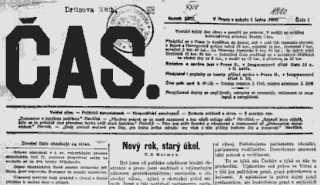
, 1.1.1910

, 1907

Čas,21.8.1913
Čas and Čech are both mentioned in connection with Einjährigfreiwilliger Marek's story about engineer Kún's flea. Marek "invented" the flea during his time as editor of Svět zvířat and Čech printed an article about it in good faith. Čas however understood that something was wrong and revealed the entire invention, causing a sharp polemic in the columns of the two newspapers. Unfortunately this episode turned out to be the beginning of the end for Marek's career at Svět zvířat.
Background
Čas was a newspaper that was founded in 1886 by Jan Erben and supported by a group of so-called realist politicians, amongst them Professor Masaryk and Kramář. From 1901 it was published as a daily. In 1915 it was barred from publishing, a fate that hit many Czech newspapers during the war.
Palaeopsylla Kuniana
It was in August 1913 that the Catholic daily Čech printed a short note about "the geologist engineer Kun who not long ago discovered a flea from ancient times in a piece of amber". The discovery happened by Královec[1], the flea was blind and was named Palaeopsylla Kuniana after the man who discovered it[c].
The first publication to unravel the story of Kun's flea was the Social-Democratic mouthpiece Právo lidu who revealed that the "news" was printed in Svět zvířat (The Animal World) during fasting time four years ago and that the "inventor" of the flea was the humorist Jaroslav Hašek. Právo lidu drily observed a new development in Catholic science, that Čech who previously drew wisdom from the Holy Scriptures now turned to The Animal World. The article in Právo lidu was reproduced in several newspapers and one of them was the Realist Party paper Čas[c]. This seems to have alerted Čech as they provided an irate response[e]. The similarities to Einjährigfreiwilliger Marek's story in The Good Soldier Švejk are thus obvious. The flea-story was even printed in USA where it appeared in several Czech-language newspapers, among them Minnesotské noviny on 11 September 1913.
Mystification
Even though Einjährigfreiwilliger Marek's story no doubt is inspired by Hašek's experiences as editor of Svět zvířat there are also some differences. The debate between Čech and Čas took place three years after Hašek's dismissal as editor and can as such not have contributed to him losing the job. Nor is it true that Čech wrote that "what God does he does well". The original article in Svět zvířat has to our knowledge never been identified but to judge by the information from Právo lidu it appeared "at masopust (Lenten period) four years ago"[d]. If this is true it would have been published in February 1909 but there is no trace of such an article in the issues of Svět zvířat from February and March 1909.
Lidové noviny tripped up first

Neues Wiener Journal,6.1.1911
Recently (2023) it was pointed out by Alena Kráčmarová that Lidové noviny already five days before Čech's mishap had printed the "revelation"[b]. Thus it was not only the clerical mouthpiece that fell into the trap! The two newspapers used the same headline and the wording corresponded to the letter. The article may also have been published by other news outlets but that's a subject for further investigations.
Palaeopsylla Klebsiana
Still, this is not the entire story. Already in January 1911 appeared an article in Neues Wiener Journal that largely aligned with the "news" from Lidové noviny and Čech from 1913. In August 1911 a similar item appeared and here the wording in very close to the later Czech version[f].
There is however one glaring difference: the man who discovered the ancient flea was the known geologist Dr. Klebs and not the geologist Kún! The flea was officially named Palaeopsylla Klebsiana[a] and is scientifically recognised. It is exposed in a museum in Göttingen.
From Klebs to Kún
How the slightly distorted story found its way to the columns of the two Czech newspapers more than two years later is a mystery but one must assume that a certain prankster from Prague played a part! However, it is impossible that the news could have appeared in Svět zvířat in 1909 because Klebs obviously discovered the flea in 1910. Nor has it been possible to identify any mention of such a flea in the Animal World during the time that Jaroslav Hašek edited the periodical (February 1909 - October 1910), and not even in 1913 when he also contributed to the magazine. So when and how the flea metamorphosed from Klebs to engineer Kún remains an enigma.
Quote(s) from the novel
[II.3] Z této nepatrné události vyvinula se veliká polemika mezi Časem a Čechem, poněvadž Čech v rozmanitostech ve svém fejetonu cituje článek o bleše mnou objevené, prohlásil: ,Co Bůh činí, dobře činí: Čas přirozené čistě realisticky rozbil celou mou blechu i s velebným Čechem, a od té doby zdálo se, že mne opouští šťastná hvězda vynálezcova a objevitele nových stvoření.
Sources: Alena Kráčmarová
| 1. | Královec is the Czech name of Königsberg (now Kaliningrad), a city by the Baltic Sea. |
| 2. | Richard Klebs (1850-1961) was a well known German geologist and an expert on amber. |
Literature
- Richard Klebs
- Ein fossiler Floh11.2.1912
- Pravěká blecha - a klerikální Čech23.8.1913
- Haškova blecha a katolická věda11.9.1913
- Nehody tisku20.10.1913
| a | Ein vorweltlicher Bernsteinfloh | 6.1.1911 | |
| b | Blecha z dávnověku | 12.8.1913 | |
| c | Blecha z dávnověku | 17.8.1913 | |
| d | Haškova blecha a katolická věda | 21.8.1913 | |
| e | Novověká kukačka lapajicá pravěké blechy | 22.8.1913 | |
| f | Ein Floh der Vorwelt | 19.8.1911 |
 | Čech |  | ||||
| Praha II./200, Pštrossova ul. 15 | ||||||
| ||||||
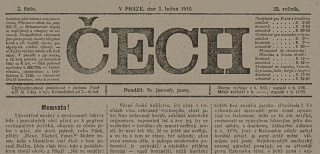
, 3.1.1910
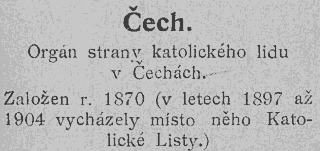
, 1907
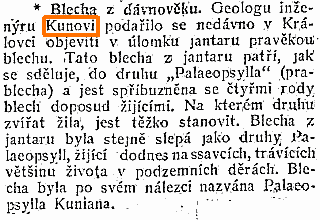
, 17.8.1913
Čech and Čas are mentioned in connection with Einjährigfreiwilliger Marek's story about engineer Kún's flea. Marek "invented" the flea during his time as editor of Svět zvířat and Čech printed an article about it in good faith. Čas however understood that something was wrong and revealed the entire invention, causing a sharp polemic in the columns of the two newspapers. Unfortunately this episode turned out to be the beginning of the end for Marek's career at Svět zvířat.
Background
Čech was a Catholic-oriented daily with strong ties to Strana katolického lidu (The Catholic People's Party). The newspaper was established in 1869 as a weekly but already from 1873 ut was published every working day. During the years 1897 to 1903 it was called Katolické listy. After World War I the circulation fell and in 1937 Čech closed down for good. It was one of the few major Czech newspapers that seems to have never printed any of Jaroslav Hašek's stories. On the other hand the author of The Good Soldier Švejk wrote several satirical pieces directed against the newspaper.
Palaeopsylla Kuniana
It was in August 1913 that the Catholic daily Čech printed a short note about "the geologist engineer Kun who not long ago discovered a flea from ancient times in a piece of amber". The discovery happened by Královec[1], the flea was blind and was named Palaeopsylla Kuniana after the man who discovered it[c].
The first publication to unravel the story of Kun's flea was the Social-Democratic mouthpiece Právo lidu who revealed that the "news" was printed in Svět zvířat (The Animal World) during fasting time four years ago and that the "inventor" of the flea was the humorist Jaroslav Hašek. Právo lidu drily observed a new development in Catholic science, that Čech who previously drew wisdom from the Holy Scriptures now turned to The Animal World. The article in Právo lidu was reproduced in several newspapers and one of them was the Realist Party paper Čas[c]. This seems to have alerted Čech as they provided an irate response[e]. The similarities to Einjährigfreiwilliger Marek's story in The Good Soldier Švejk are thus obvious. The flea-story was even printed in USA where it appeared in several Czech-language newspapers, among them Minnesotské noviny on 11 September 1913.
Mystification
Even though Einjährigfreiwilliger Marek's story no doubt is inspired by Hašek's experiences as editor of Svět zvířat there are also some differences. The debate between Čech and Čas took place three years after Hašek's dismissal as editor and can as such not have contributed to him losing the job. Nor is it true that Čech wrote that "what God does he does well". The original article in Svět zvířat has to our knowledge never been identified but to judge by the information from Právo lidu it appeared "at masopust (Lenten period) four years ago"[d]. If this is true it would have been published in February 1909 but there is no trace of such an article in the issues of Svět zvířat from February and March 1909.
Lidové noviny tripped up first

Neues Wiener Journal,6.1.1911
Recently (2023) it was pointed out by Alena Kráčmarová that Lidové noviny already five days before Čech's mishap had printed the "revelation"[b]. Thus it was not only the clerical mouthpiece that fell into the trap! The two newspapers used the same headline and the wording corresponded to the letter. The article may also have been published by other news outlets but that's a subject for further investigations.
Palaeopsylla Klebsiana
Still, this is not the entire story. Already in January 1911 appeared an article in Neues Wiener Journal that largely aligned with the "news" from Lidové noviny and Čech from 1913. In August 1911 a similar item appeared and here the wording in very close to the later Czech version[f].
There is however one glaring difference: the man who discovered the ancient flea was the known geologist Dr. Klebs and not the geologist Kún! The flea was officially named Palaeopsylla Klebsiana[a] and is scientifically recognised. It is exposed in a museum in Göttingen.
From Klebs to Kún
How the slightly distorted story found its way to the columns of the two Czech newspapers more than two years later is a mystery but one must assume that a certain prankster from Prague played a part! However, it is impossible that the news could have appeared in Svět zvířat in 1909 because Klebs obviously discovered the flea in 1910. Nor has it been possible to identify any mention of such a flea in the Animal World during the time that Jaroslav Hašek edited the periodical (February 1909 - October 1910), and not even in 1913 when he also contributed to the magazine. So when and how the flea metamorphosed from Klebs to engineer Kún remains an enigma.
Quote(s) from the novel
[II.3] Z této nepatrné události vyvinula se veliká polemika mezi Časem a Čechem, poněvadž Čech v rozmanitostech ve svém fejetonu cituje článek o bleše mnou objevené, prohlásil: ,Co Bůh činí, dobře činí: Čas přirozené čistě realisticky rozbil celou mou blechu i s velebným Čechem, a od té doby zdálo se, že mne opouští šťastná hvězda vynálezcova a objevitele nových stvoření.
Sources: Alena Kráčmarová
| 1. | Královec is the Czech name of Königsberg (now Kaliningrad), a city by the Baltic Sea. |
| 2. | Richard Klebs (1850-1961) was a well known German geologist and an expert on amber. |
Literature
- Richard Klebs
- Ein fossiler Floh11.2.1912
- Pravěká blecha - a klerikální Čech23.8.1913
- Haškova blecha a katolická věda11.9.1913
- Nehody tisku20.10.1913
| a | Ein vorweltlicher Bernsteinfloh | 6.1.1911 | |
| b | Blecha z dávnověku | 12.8.1913 | |
| c | Blecha z dávnověku | 17.8.1913 | |
| d | Haškova blecha a katolická věda | 21.8.1913 | |
| e | Novověká kukačka lapajicá pravěké blechy | 22.8.1913 | |
| f | Ein Floh der Vorwelt | 19.8.1911 |
 | Selský obzor |  | ||||
| Ostrov u Macochy | ||||||
| ||||||
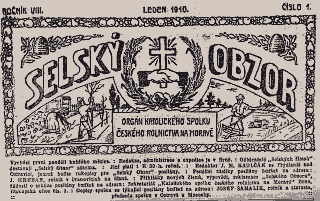
, leden 1910

, 27.2.1908
Selský obzor is mentioned by Einjährigfreiwilliger Marek when he relates about his time as editor of Svět zvířat. The paper's editor, Jos. M. Kadlčák wrote an angry editorial where he rebuffed Marek's renaming of the jay to "walnutter".
Background
Selský obzor (Farming Horizon) was a monthly that was published from 1902 to 1911. It was founded by the farmers Ševčík and Josef Šamalík (from 1907 a deputy in Reichsrat) and was the mouthpiece of Katolický spolek českého rolnictví na Moravě (Catholic Society of Czech Farming in Moravia) of which Šamalík was chairman. The first issue was published in February 1903 in Ostrov u Macochy (35 km north of Brno) where Šamalík lived. By 1907 Jos. M. Kadlčák had become editor of the magazine and the administration had relocated to Brno. The last issue appeared in March 1911.
No editorial in sight
It has not been possible to identify any editorial like the one that Einjährigfreiwilliger Marek talks about in The Good Soldier Švejk. All the issues of Selský obzor have been investigated to no avail, be it before, during or after Hašek's time as editor of Svět zvířat.
It must therefore be assumed that any dispute between Jaroslav Hašek and Jos. M. Kadlčák was in the form of personal correspondence. Perhaps Kadlčák even wrote directly to the magazine's owner Václav Fuchs to make him aware of the excesses of his inventive editor. Another possibility is that Kadlčák wrote in one of the other periodicals of the Catholic Farming Society (Selské hlasy and Zemědelský obzor). Nor have any pictures of jays been identified in Svět zvířat from 1909 or 1910. That said the studies of these volumes have so far not been thorough enough for any firm conclusion to be drawn.
Quote(s) from the novel
[II.3] Poslanec Kadlčák odpověděl v ,Selském obzoru’ úvodním článkem. Můj šéf, pan Fuchs, seděl jako vždy v kavárně a četl krajinské noviny, poněvadž poslední dobou náramně často hledal zmínky o mých poutavých článcích ve Světě zvířat, a když jsem přišel, ukázal na ležící na stole ,Selský obzor’ a řekl tiše, dívaje se na mne svýma smutnýma očima, který výraz měly jeho oči stále poslední dobou.
Literature
 | Country Life |  | |||
| London, 20 Tavistock Street (now No. 8) | |||||
| |||||
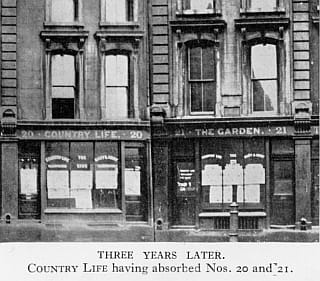
© Country Life, 2022
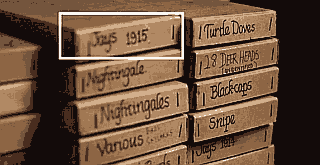
© Country Life, 2022

© Country Life, 2022
Country Life is mentioned by Einjährigfreiwilliger Marek when he relates his time as editor of Svět zvířat. From the English magazine Country Life, he had cut a photo of a jay sitting in a walnut tree and printed it, giving it the title "walnutter", a term he had invented himself. This caused a sharp reaction from Jos. M. Kadlčák, a clerical deputy in Parlament and editor of Selský obzor.
Background
Country Life was an English magazine founded in 1897 by the businessman Edward Burgess Hudson (1854-1936). Originally the name was Country Life Illustrated and the editorial offices were located at 20 Tavistock Street, central London. The magazine pioneered high-quality photos and glossy prints. It was an immediate success and the income permitted Hudson to erect a new building on the same site, a house that until today bears the name Hudson Building. In 1905 the magazine's editorial offices and print works were located here.
In the beginning, Country Life focused on horse racing, golf and other activities that were favourite pursuits amongst the upper classes. Still, it gradually introduced other subjects that were related to lifestyle, nature, and the countryside. The property section was also an important feature and many estates were advertised for sale in its columns. The magazine has been published uninterrupted throughout the years. In 2022 the magazine is located at another address in London.
With regards to Einjährigfreiwilliger Marek's cutting and pasting a picture of a jay sitting in a walnut tree: the archive of Country Life has a collection of photos of jays, dated 1915! The collection is not yet fully digitised so it has not been possible to ascertain from which issue of the magazine Marek (or rather Hašek) may have copied the picture. Nor has it been verified that such a photo ever appeared in Svět zvířat during Hašek's period as editor.
As a curiosity can be mentioned that the current internet issue of Country Life (April 2022) provides an entry by Simon Lester on the jay and other birds in the crow family![a]
Quote(s) from the novel
[II.3] Vystřihl jsem z anglického časopisu ,Country Life’ obrázek nějakého ptáčka, který seděl na ořechu. Dal jsem mu název ořešník, stejně jako bych se nijak logicky nerozpakoval napsat, že pták sedící na jalovci je jalovník, případně jalovice.
Literature
- Country Life web page
- Edward Hudson: The tale of the man who founded Country Life, 125 years ago this monthClive Aslet15.1.2022
| a | Crows: Everything you need to know about the whole corvid family, from ravens and jackdaws to rooks, magpies, jays and choughs | Simon Lester | 9.4.2022 |
 | Tunel |  | ||||
| Praha I./642, Týn 6 | ||||||
| ||||||

, 1929


Tunel from Štupartská, around 1910
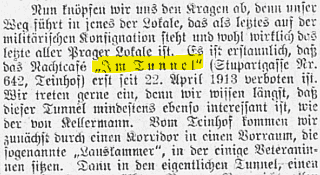
,8.3.1914

Tunel, 2022
© Tunel
Tunel is mentioned by Švejk when he coincidentally talks about orangutangs when the intellectual capabilities of the escorting corporal become the theme of the conversation on the train from Budějovice to Királyhida.
Background
Tunel was a café in Staré město that was located on the ground floor of the building U černého medvěda (At the Black Bear) behind the Týn church. It had two entrances, at Týn no. 6 and Štupartská no. 5. The official address was Týn 6 and in 1910 Františka Janusová (born 1854) was listed as the owner[d]. She moved to this address on 15 March 1907 but registered at another address already on 31 August 1911. Whoever succeeded her at Tunel in 1911 was presumably still managing it in 1914.
Address books confirm the existence of a restaurant in Týn no. 6 in these years: 1884, 1892, 1910, 1936 and 1946. In 2013 the address was occupied by an Indian restaurant and in 2022 there is a Tapas bar on the premises, appropriately named Tunel Restaurant & Tapas bar[c].
Verbotene Lokale
In early 1914 Egon Erwin Kisch published the series Verbotene Lokale (Forbidden Taverns) in the newspaper Bohemia. It describes 11 establishments where soldiers from the Prague garrison were forbidden to enter. Three of these are mentioned in The Good Soldier Švejk: Apollo, U Kocanů and Tunel itself.
In the part of the series that Bohemia published on 15 March 1914, Kisch writes about Im Tunnel. He describes it as the worst of the worst, frequented by street prostitutes, thugs and other individuals from the lower echelons of society. The head waiter was the famous Jarda (Jaroslav), a huge bloke who enforced order at the premises by using brute strength and a bullwhip! Kisch himself witnessed a serious brawl there that was resolved when the landlord and the two waiters intervened, armed with Jarda's strength and the bullwhip. Kisch does not reveal the identity of the landlord.
On 22 April 1913, the military authorities added Tunel to their list of banned establishments but the only surprise for Kisch was that this had not happened even earlier. He also noted that Tunel once had been a decent restaurant and that he himself had enjoyed visiting it together with his fellow students[a].
In 1920 the series was reprinted in his book Die Abenteuer in Prag, collected under the title Konsignation über verbotene Lokale[b]. The story about Tunel was now slightly abridged and the author's Marxist interpretation of society shone through. He even pulls in Das Kapital and Das Kommunistische Manifest! Kisch had also removed the note about himself having frequented Tunel as a student.
E.E. Kisch: Konsignation über verbotene Lokale (1920)
Nun knöpfen wir uns den Kragen ab, denn unser weg führt in jenes der Lokale, das als letztes auf der militärischen Konsignation steht und wohl wirklich das letzte aller Prager Lokale ist. Hier hat die verfaulte unterste Schicht der relativer Überbevölkerung ihr Stammlokal, jene Menschen, die nicht mehr direkt als Opfer der kapitalistischen Akkumulation anzusehehen sind, jene, die Marx im "Kapital" Verbrecher, Verkommenene und Verlumpte, das eigentliche Lumpenproletariat nennt, und vor deren Käuflichkeit zu reaktionären Zwecken das Kommunistische Manifest warnt. Es ist erstaunlich, dass das Nachtcafé "Im Tunnel" (Stupartgasse Nr. 642, Teinhof) erst seit 22. April 1913 verboten ist.
Quote(s) from the novel
[II.3] „Zajisté,“ potvrdil Švejk, „vám zde nikdo neřek ani slůvka , který byste si mohl nějak křivě vykládat. Vono to vždycky špatně vypadá, když se někdo cítí uraženej. Jednou jsem seděl v noční kavárně v ,Tunelu’ a bavili jsme se vo orangutanech. Seděl tam s námi jeden mariňák a ten vyprávěl, že orangutana často nerozeznají od nějakýho vousatýho vobčana, že takovej orangutan má bradu porostlou chlupy jako... Jako,’ povídá, ,řekněme třebas tamhleten pán u vedlejšího stolu.’ Vohlédli jsme se všichni, a ten pán s tou bradou šel k mariňákovi a dal mu facku a mariňák mu rozbil hlavu flaškou od piva a ten bradatej pán se svalil a zůstal ležet bez sebe a s mariňákem jsme se rozloučili, poněvadž hned vodešel, když viděl, že ho přizabil. Potom jsme vzkřísili toho pána, a to jsme rozhodně neměli dělat, poněvadž hned po svým vzkříšení na nás všechny, kteří jsme přece s tím neměli prachnic co dělat, zavolal patrolu, která nás vodvedla na komisařství. Tam von pořád ved svou, že jsme ho považovali za orangutana, že jsme vo ničem jiným nemluvili než vo něm. A on pořád svou. My, že ne, že není žádnej orangutan. A von, že je, že to slyšel. Prosil jsem pana komisaře, aby mu to vysvětlil. A ten mu to zcela dobrácky vysvětloval, ale ani pak si nedal říct a řekl panu komisařovi, že tomu on nerozumí, že je s námi spolčenej. Tak ho pan komisař dal zavřít, aby vystřízlivěl, a my jsme se zas chtěli vrátit do ,Tunelu’, ale už jsme nemohli, poněvadž nás taky posadili za katr.
Sources: Hans-Peter Laqueur, Egon Erwin Kisch
Literature
- Románové restaurační a jiné zábavní podniky2009 - 2021
| a | Verbotene Lokale | Egon Erwin Kisch | 8.3.1914 |
| b | Konsignation über verbotene Lokale | 1920 | |
| c | Tunel | 2022 | |
| d | Pobytové přihlášky pražského policejního ředitelství | 1851 - 1914 |
 | Malý Čtenář |  | ||||
| Praha II./89, Spálená ul. 13 | ||||||
| ||||||
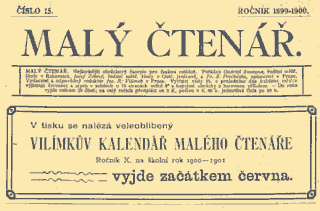
Malý čtenář, , 1899-1900

Story on verse by Růžena Jesenská
Malý čtenář, , 1889-1890
Malý Čtenář is mentioned in passing by Švejk when Einjährigfreiwilliger Marek ridicules the Korporal who escorted the two prisoners on the train from Budějovice to Bruck an der Leitha - Királyhida.
Background
Malý Čtenář (Young Reader) was a magazine for children and youth that was published from 1882 to 1941. It first appeared in Poděbrady but from 1887 the Prague-based publisher Vilímek took over. The magazine appeared bi-weekly and contained illustrations, stories, and, as Švejk pointed out: poems. Several distinguished writers contributed to the magazine, amongst them Vrchlický and Růžena Jesenská, the latter before 1890. The publication had both educational and enlightening purposes and influenced entire generations of young Czechs.
The editorial office was located in Spálená ulice, not far from Teissig and c.k. zemský co trestní soud. In 1907 editor in chief was the publisher Vilímek himself, and the main co-editors were Gabriel Smetana, Josef Zelený, and František Procházka. The magazine continued operating until 1941 when it was closed by the Protectorate authorities.
Quote(s) from the novel
[II.3] „...kerej koberec vobjímá potůček,“ poznamenal Švejk, „a von pan desátník sliní tužku, sedí na nějakým pařezu a píše básničku do ,Malýho čtenáře’.“
Literature
- Malý čtenář1884-1941
 | Landgericht |  | ||||
| Terezín, Prokopa Holého 78 | ||||||
| ||||||

, 1912
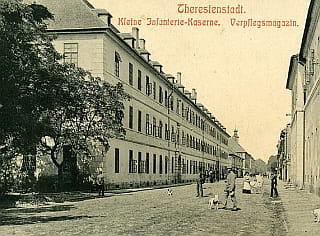
Kleine Infanteriekaserne in 1903. In 1914 this building also hosted Landwehrgericht
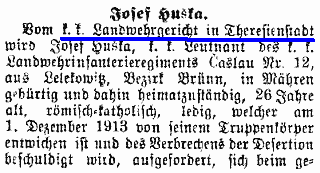
,20.12.1913
Landgericht in Terezín features in one of Švejk's anecdotes on the train from Budějovice to Királyhida. It was from his time doing military service in 1912 when he was unfairly accused of writing: "we'll shit on the war" on a wall by a munition dump. Švejk was tried at Landgericht in Terezín because of his alleged scribbling.
Background
Landgericht was a judicial institution that did not exist in 1912. Courts thus named were once present in Austria but only until 1848[c]. The similar-sounding Landesgericht existed, but this institution covered all of Bohemia and was located in Prague (see c.k. zemský co trestní soud). It also appears odd that a military case was heard in a civilian court, and particular when considering that no such court was located in Terezín.
Landwehrgericht
These contradictions are best explained by assuming that Švejk had k.k. Landwehrgericht (Home Defence Court) in mind and simply got the terms mixed up. Such a court was indeed present in Terezín[a] and there was also a Garnisonsgericht[b]. That Švejk actually was talking about a military court becomes clear in the subsequent lines where he directly uses the term vojenský soud.
Landwehrgericht in Terezín was one of 13 of its kind in Austria (in Hungary Honvéd had their own courts). It was according to Schematismus from 1914 located in Kleine Infanteriekaserne (malá pěchotní kasárna)[a]. In 1912 the head of the court was Major Josef Kučera, and by 1914 his position was taken by Josef Wollmann. At the time of writing (2022) the barracks are called Kasárny Prokopa Holého and serve as storage for the Czech National Museum.
Trials
It is quite likely that Švejk's story is inspired by something that Hašek had read or heard about. Still, it has not been possible to identify any obvious example. Before the war, these trials were rarely covered by the press but were more frequently mentioned from August 1914 onwards. It is also evident that Landwehrgericht had the power to judge civilians who were suspected of betrayal. It is however unlikely that a soldier from Infanterieregiment Nr. 91 (that Švejk surely served in also in 1912) would have been put on trial in Terezín and not before the equivalent court in Prague under which jurisdiction his regiment belonged.
Quote(s) from the novel
[II.3] Nešťastnou náhodou ještě nad tím nápisem byl jinej: ,My na vojnu nepůjdeme, my se na ni vyséreme’, a to bylo v roce 1912, když jsme měli jít do Srbska kvůli tomu konsulovi Procházkovi. Tak mě hned poslali do Terezína k landgerichtu. Asi patnáctkrát tu zeď od magacínu s těma nápisama i s mým podpisem páni od vojenskýho soudu fotografovali, desetkrát mně dali napsat, aby zkoumali můj rukopis: ,My na vojnu nepůjdeme, my se na ni vyséreme’, patnáctkrát musel jsem psát před nimi ,Supák Schreiter je hnát’ a nakonec přijel jeden znalec písma a dal mně napsat: ,Bylo 29. července 1897, kdy Králový Dvůr nad Labem poznal hrůzy prudkého a rozvodněného Labe’.
[II.3] „To je vidět,“ řekl desátník s uspokojením, „že přece jen nezůstalo to bez trestu, že jste pořádnej kriminálník. Já bejt na místě toho landgerichtu, napařil bych vám ne šest neděl, ale šest let.“
Also written:Regional Courten
Literature
| a | Schematismus der k.k. Landwehr (s. 110) | 1914 | |
| b | Schematismus für das k.u.k. Heer (s. 126) | 1914 | |
| c | Landgericht (Österreich) |
 | Kurýr |  | ||||
| Praha II./618, Štěpánská ul. 26 | ||||||
| ||||||
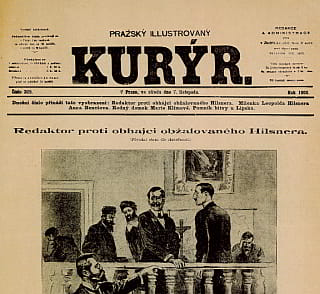
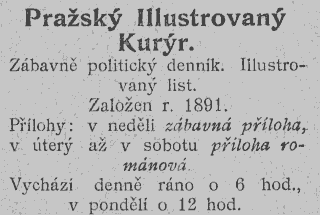
,1906
Kurýr is mentioned when Švejk on the train to Bruck reminded the escorting corporal about Koníček from Infanterieregiment Nr. 35 who years ago had stabbed his Korporal to death and then killed himself. Švejk had read about the incident in Kurýr.
Background
Kurýr almost certainly refers to Pražský illustrovaný kurýr, a pioneer boulevard daily[b] that was published from 1891 to 1918. It was associated with Hlas národa with whom they shared administration and editorial offices. The owner of both newspapers was Edvard Jan Baštýř (1861-1937), lawyer, publisher and politician. After Národní politika, Kurýr enjoyed the highest circulation of all Czech newspapers[a].
Hašek and the Baštýr press
As far as recorded, Jaroslav Hašek contributed only two stories to Kurýr (both in 1907) and none of his stories were printed by Hlas národa. Nor did he touch them much in his stories. The only recorded mention is also peripheral: a line about Baštýr and Hlas Národa in a story from 1916[c].
Martin Sekera, Český rozhlas, 28.10.2020
Mezi průkopníky tehdejšího bulváru patřil Pražský ilustrovaný kurýr, což byla příloha deníku Hlasu národa, který na první stránce zveřejnil senzaci nějaké patologie, ať už to byla vražda, neštěstí či mimořádný nadpřirozený úkaz. Kurýr tak ukojil hlad po senzaci i příběhu na pokračování a potěšil oko většinového čtenáře satirickými karikaturami.
Quote(s) from the novel
[II.3] „Pro tyhle samý věci, pro takový sekýrování, zapích před léty u pětatřicátýho regimentu nějakej Koníček sebe i kaprála. Bylo to v ,Kurýru’.
Literature
- Ferrerova smrt a Pražský kurýr17.10.1909
- Kovář ČekajJaroslav Hašek16.6.1907
- O Halálovi, tulákoviJaroslav Hašek18.8.1907
| a | Pražský illustrovaný kurýr | Jakub Machek | 2012 |
| b | Jak se rodil bulvár aneb Co ještě snesete? | 28.10.2020 | |
| c | Povídka o obrazu císaře Františka Josefa I. | Jaroslav Hašek | 17.7.1916 |
 | K.k. Landwehrinfanterieregiment Nr. 64 |  | ||||
| ||||||

Proof that the 64th Landwehrregiment didn't exist
,1914
K.k. Landwehrinfanterieregiment Nr. 64 is mentioned by Feldoberkurat Lacina when he tells that he was served kidneys ala Madeira in the officer's dining room of this regimentet.
Background
K.k. Landwehrinfanterieregiment Nr. 64 was a unit that only existed in Lacina's imagination because k.k. Landwehr consisted of 37 regiments and these were numbered 1 to 37[a].
Only Hašek would know which k.k. Landwehr regiment the senior field chaplain really had in mind but if he had his dubious meal in Budějovice it would have been with officers from the city's k.k. Landwehrinfanterieregiment Nr. 29 (or k.k. Landwehrinfanterieregiment Nr. 6 from Cheb who replaced them on 19 June 1915).
If the meal was enjoyed in Kraków (where his k.u.k. Kavallerietruppendivision Nr. 7 was garrisoned) he may have endulged in the company of officers from k.k. Landwehrinfanterieregiment Nr. 16.
Quote(s) from the novel
[II.3] A tytéž ledvinky a la madeira jedl jsem v důstojnické mináži 64. landwehrregimentu. Dali do nich kmín, jako když se dělají v obyčejné hospodě na pepři. A kdo je dělal, čím byl ten kuchař v civilu? Krmič dobytka na jednom velkostatku.“
| a | Schematismus der k.k. Landwehr (s. 234) | 1914 |
 | Na krásné vyhlídce |  | ||||
| Praha IV./156, Úvoz 31 | ||||||
| ||||||
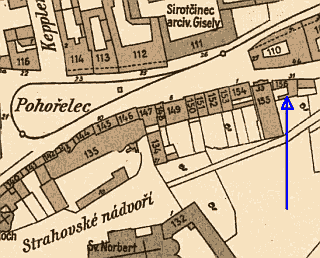
,1909-1914

,1891
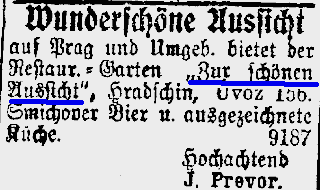
,22.7.1900

,1910

,31.7.1909

Krásná vyhlídka was in January 1927 entering the end of its existence. That same year the building was demolished.
,28.1.1927
Na krásné vyhlídce is mentioned when Švejk retells a story he had heard from a soldier who had reported sick by Przemyśl. During a bayonet charge he faced a huge Russian with a drop under his nose. When seeing the nosedrop he felt unwell and was carried to Hilfsplatz. From here was dispatched to some cholera barracks in Pest where he actually contracted cholera! When recuperating in Prague the soldier told his story in the restarurant na Vyhlídce at Pohořelec and this is where Švejk picked it up.
Whereas Švejk used the term 'na Vyhlídce' when he first mentioned the pub but in [III.3] he uses the official name. This is in his endless anecdote about gardener Kalenda and Vyhlídka was one of the eight pubs that Kalenda visited on his "world tour".
Despite the minor difference between the names there is no doubt that Švejk talks about the same tavern.
Background
Na krásné vyhlídce was a pub at Hradčany near the Strahov Monastery and Pohořelec. According to the address books from 1891 and 1910 it was located at Úvoz 31 and the description in The Good Soldier Švejk fits well with this spot. Landlord from 30 June 1898[e] and at least until 1912 was Josef Převor (b. 1864) but the restaurant had a history that stretched back to at least 1888[d] and it continued to operate until 1927. In 1900 an advert in Prager Tagblatt (see picture) reveals that they served beer from Smíchov (in modern times known as Staropramen).
In 1927 the old building was demolished[a] and from 1945 the new one hosts the embassy of Sweden and adjoining functions[b]. The site is one of the best outlook points in Prague with panoramic views of Hradčany, Malá Strana, Staré město, Nové město, Karlín, Žižkov etc. Both the old and the new building were called Na krásné vyhlídce. In some adverts the term Pěkná vyhlídka was also used[c].
Quote(s) from the novel
[II.3] „Někdy,“ řekl Švejk, „se zas v gefechtu člověku udělá špatně, člověk si něco zvoškliví. Vypravoval v Praze na Pohořelci na Vyhlídce’ jeden nemocnej rekonvalescent od Přemyšlu, že tam někde pod festungem přišlo k útoku na bajonety a proti němu se vobjevil jeden Rus, chlap jako hora, a mazal si to na něho s bajonetem a měl pořádnou kapičku u nosu. Jak se mu von podíval na tu kapičku, na ten vozdr, že se mu hned udělalo špatně a musel jít na hilfsplac, kde ho uznali zamořenýho cholerou a odpravili do cholerovejch baráků do Pešti, kde se taky vopravdu nakazil cholerou.“
[III.3] Počal se tedy dál a dál vzdalovat vod svýho domova, až se přivalil do ,Černýho pivovaru’ na Karlově náměstí, a vodtamtuď šel na Malou Stranu k Sv. Tomáši do pivovaru a odtamtud přes restauraci ,U Montágů’ a ještě vejš přes hospodu ,U krále brabanskýho’, pak na ,Krásnou vyhlídku’, odtud do Strahovskýho kláštera do pivovaru.
Also written:The Beautiful ViewenSchöne AussichtdeDen vakre utsiktno
Literature
- Klenotnice Loretánská7.7.1911
| a | Kašna na terase švédského velvyslanectví | 2000 | |
| b | Ambassadanläggning i Prag, Tjeckien | 29.4.2022 | |
| c | Pěkná vyhlídka | 4.3.1902 | |
| d | Románové restaurační a jiné zábavní podniky | 2009 - 2021 | |
| e | Soupis pražského obyvatelstva 1830-1910 (1920) |
 | Schönbrunner Menagerie |  | ||||
| Wien XIII./1 | ||||||
| ||||||

Zoo, ,1927
Schönbrunner Menagerie is mentioned by Švejk when he tells the escort corporal in the arrest wagon on the way from Budějovice to Királyhida that Vienna is an important city.
Background
Schönbrunner Menagerie was (and still is) a zoological garden on the grounds of Schönbrunn. It is now the main zoo in the city. Founded in 1752 it is the oldest existing of its kind in the world.
The good soldier Švejk in captivity
Correspondingly the zoo is mentioned in Dobrý voják Švejk v zajetí, but also here only briefly.[1]
Po jednom takovém rozhovoru zdálo se v noci Švejkovi, že k němu přišel císař pán. Přijde a povídá: "Ohol mne, Švejku, v těchhle licousech vypadám jako orangutan z schönbrunnského zvěřince."
Quote(s) from the novel
[II.3] Vídeň je vůbec důležité město,“ pokračoval, „jenom co mají divokejch zvířat v tej schönbrunnskej menažerii. Když jsem byl před lety ve Vídni, tak jsem se nejradši chodil dívat na vopice, ale když jede nějaká osobnost z císařskýho hradu, tak tam nikoho nepouštěj přes kordon.
Also written:Schönbrunnské menažeriecz
Literature
| 1 | Dobrý voják Švejk v zajetí | 1917 |
 | Hofburg |  | ||||
| Wien I./Hofburg | ||||||
| ||||||
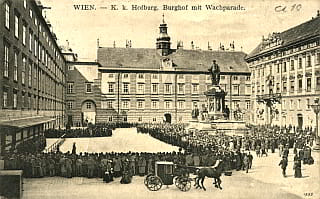
K. k. Hofburg; Burghof, Wachparade

,13.3.1884

,26.7.1914
Hofburg is mentioned by Švejk through the term the imperial castle when he on the train from Budějovice to Királyhida touches on his experiences from the capital. When the corporal in the escort asks if he's been there he answers "no", but he had heard it's very beautiful. Members of Burgwache (the castle guards) must according to Švejk be about two metres tall and after finishing their service they are awarded a Trafika.
Background
Hofburg is not mentioned directly but there is no doubt that Švejk refers to Hofburg when he mentions the imperial castle. It is a castle or rather a complex of palaces in the centre of Vienna.
It was until 1918 the principal imperial palace of the Habsburg dynasty. It was built in the 13th century and expanded several times afterwards. It also served as the imperial winter residence, as Schönbrunn was the summer residence.
Since 1946 it is the official residence and workplace of the president of Austria. The large building complex also houses museums, chapels, the Spanish riding school, the National Library and other institutions.
The good soldier Švejk in captivity
I Dobrý voják Švejk v zajetí Hofburg is just about mentioned because Franz Rypatschek, town counsiler from VI. Bezirk was arrested by the guarsd, totally naked and sent to the madhouse by Hall in Tyrol.[1]
Netrvalo to ani týden, odváželi Švejka do blázince v Hallu k dalšímu pobytu, kde byl zavřen též Franz Rypatschek, městský vídeňský radní ze šestého okresu, kterého jednou v noci zadržela hlídka u císařského hradu úplně nahého a pomalovaného fermežovými barvami.
Quote(s) from the novel
[II.3] Vídeň je vůbec důležité město,“ pokračoval, „jenom co mají divokejch zvířat v tej schönbrunnskej menažerii. Když jsem byl před lety ve Vídni, tak jsem se nejradši chodil dívat na vopice, ale když jede nějaká osobnost z císařskýho hradu, tak tam nikoho nepouštěj přes kordon. Byl se mnou jeden krejčí z desátýho okresu a toho zavřeli, poněvadž chtěl mermocí ty vopice vidět.“ „A byl jste taky ve hradě?“otázal se desátník. „Je tam moc krásně,“ odpověděl Švejk, „já tam nebyl, ale vypravoval mně jeden, kterej tam byl. Nejhezčí je z toho burgwache. Každej z nich prej musí bejt na dva metry vysokej a potom dostane trafiku. A princezen je tam jako smetí.“
Literature
| 1 | Dobrý voják Švejk v zajetí | 1917 |
 | A railway station in Vienna |  | ||||
| Wien IX./Althanplatz | ||||||
| ||||||
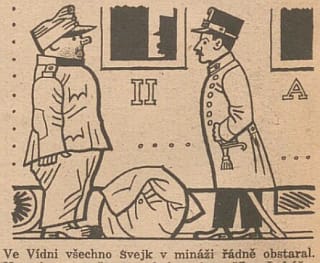
Švejk reunited with Lukáš at the station in Vienna.
,9.3.1924
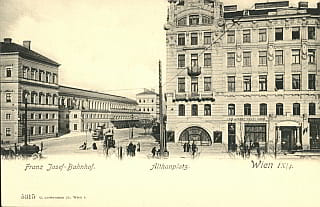
Wien, IX/4., Althanplatz, Franz Josef-Bahnhof, vor 1907
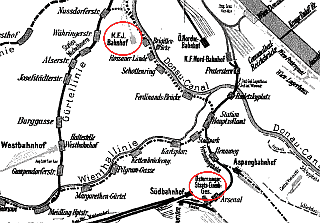
The railway network in Vienna around 1905
A railway station in Vienna refers to the station in Vienna where Švejk's transport on the way from Budějovice to Királyhida stopped and were given mess. This is also where Švejk was released after having been locked up for three days. At the station they were welcomed by representatives of Österreichische Gesellschaft vom Roten Kreuze, Magistrat der Stadt Wien and others who handed out pepper cakes with patriotic inscriptions.
Feldoberkurat Lacina sends Švejk on a mission to find some good food for him but at the station he meets Oberleutnant Lukáš who takes pity on him and takes him back as his servant. This meant that the good soldier took temporary leave with Einjährigfreiwilliger Marek and field chaplain Lacina disappeared from the story for good.
Background
A railway station in Vienna is from the plot in The Good Soldier Švejk alone impossible to identify because Vienna in 1914 had nine major railway stations and numerous smaller ones. The large ones were Aspangbahnhof, Donaukai, Franz-Josephs-Bahnhof, Kahlenberg-Eisenbahn, Nordbahnhof, Nordwestbahnhof, Ostbahnhof, Südbahnof and Westbahnhof[a].
Most of these can be ruled out for technical and topological reasons but it is likely that Švejk's transport stopped or passed at least two of the stations. Those that spring to mind are Franz-Josephs-Bahnhof and Ostbahnof. The former was connected to Budějovice and the latter eastwards to Királyhida and Hungary.
Josef Novotný's journey
On 1 June 1915 Ersatzbataillon IR. 91 were transferred from Budějovice to Királyhida and it happened largely according to the description in The Good Soldier Švejk. The journey is in rough terms lined out by Josef Novotný from Lišov who was one of the soldiers on the transport[b].
In his diary he noted that they left the barracks at 5-6 in the morning, that there was no public announcement of the departure but that a sizable crowd turned up to bid farewell to their house regiment. On the way to the station in Budějovice IR. 91 were guarded by "foreign troops"[1]. None of the soldiers in IR. 91 were allowed to carry sharp ammunition and the regiment's band was not allowed to play.
The soldiers were transported in cattle carriages, 50 to 60 men per wagon, and it took a while before they departed. They travelled via České Velenice and Gmund onto Sigmundsherberg where they early in the afternoon were given a meal. They continued down towards Danube and by Tulln they noticed fortifications along the railway line, a scene resembling the description in The Good Soldier Švejk.
The next stop was Franz-Josephs-Bahnhof and here a new meal was handed out, now at sunset[2]. It was getting dark and the journey through Vienna took a long time and they passed several stations that Novotný didn't name. He fell asleep around midnight and at 2 in the morning they finally arrived at the station in Királyhida. Here they remained in the wagons for another few hours.
Franz-Josephs-Bahnhof
In view of Novotný's description, there is little doubt that the station where Švejk was released and encountered his obrlajtnant was Franz-Josephs-Bahnhof. The transfer of the regiment did however take place in two stages. Thus one can't be sure that Novotný was on the same transport as Jaroslav Hašek but the itinerary would have been the same. In The Good Soldier Švejk one notices that between the station where Švejk and Oberleutnant Lukáš met and Királyhida there is no plot. This fits with Novotný's notes, that the passage through Vienna took place when it was dark. Thus Hašek would have seen little of Vienna that he could have fitted into the novel.
Quote(s) from the novel
[II.3] Přejeli nějaké nádraží, kde za nimi doznívaly zvuky rakouské hymny kapely, která sem přišla snad omylem, poněvadž teprve za hezkou dobu se dostali s vlakem na nádraží, kde se zastavili, byla mináž a bylo slavnostní uvítání.
[II.3] Potom byl rozkaz jít si pro mináž po rotách k polním kuchyním, které stály za nádražím.
Also written:BahnhofczEin jernbanestasjon i Wiennn
| 1. | Presumably k.k. Landwehrinfanterieregiment Nr. 6 Eger (now Cheb) who already in May had swapped garrisons with the local k.k. Landwehrinfanterieregiment Nr. 29. |
| 2. | Sunset in Vienna on 1 June is at 20:46. |
Literature
| a | Lehmanns Wohnungs-Anzeiger Wien | 1915 | |
| b | Z mých válečných pamětí | 2021 |
 | Magistrat der Stadt Wien |  | ||||
| Wien I./Lichtenfelsg. 2 | ||||||
| ||||||

Rathaus, 1907
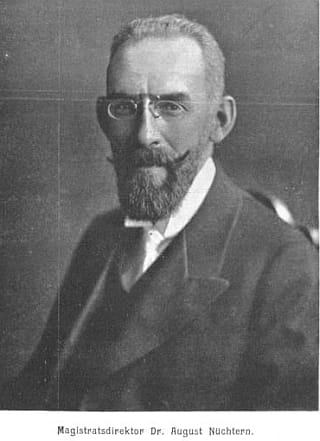
,17.8.1915
Magistrat der Stadt Wien is mentioned by the narrator in connection with the transport of Švejk's regiment from Budějovice to Királyhida. On a railway station in Vienna they were welcomed by three female members of Österreichische Gesellschaft vom Roten Kreuze, two members of some female war support society, and one representative of the city administration and the military authorities respectively. At the station the soldiers were given pepper cakes with patriotic inscriptions. Amongst those was Gott strafe England, a slogan that the reader of The Good Soldier Švejk will recognise from Baronesse von Botzenheim's sick visit in [I.8].
Background
Magistrat der Stadt Wien refers to the city administration of Vienna, headed by the Bürgermeister (mayor). The term Magistrat has been used since 1783 and still is. All statuary cities (15 in Austria, 27 in Czechia) are governed by a magistrat.
The executive of Magistrat was logically enough located in the city hall but such a large administrative body had many branches and was also represented in the 21 Bezirke (districts) of the capital. Mayor from 1913 to 1919 was Dr. Richard Weißkirchner (1861-1926) and director of the magistrate between 1914 and 1918 was Dr. August Nüchtern (1861-1929).
Quote(s) from the novel
[II.3] Uvítání ve Vídni sestávalo ze tří členkyň spolku Rakouského červeného kříže a ze dvou členkyň nějakého válečného spolku vídeňských paní a dívek, jednoho oficielního zástupce vídeňského magistrátu a vojenského zástupce.
Also written:Vienna City AdministrationenWien byforvaltningno
Literature
| a | Lehmanns Wohnungs-Anzeiger Wien | 1915 |
 | Österreichische Gesellschaft vom Roten Kreuze |  | |||
| Wien I./Milchgasse 1 | |||||
| |||||
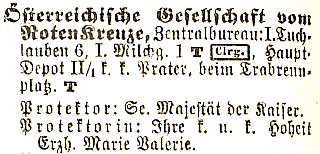
, 1915
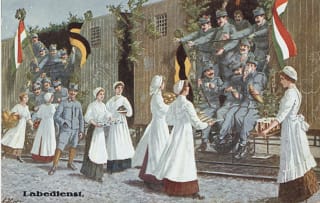
Hartmann, A. Labedienst, 1915
© ÖNB
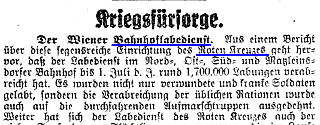
,11.8.1915
Österreichische Gesellschaft vom Roten Kreuze is mentioned by the narrator in connection with the transport of Švejk's regiment from Budějovice to Királyhida. On a railway station in Vienna they were welcomed by three female members of the Austrian Red Cross, two members of some female war aid society, and one representative of Magistrat der Stadt Wien and the military authorities respectively. At the station the soldiers were given pepper cakes with patriotic inscriptions. Amongst them was Gott strafe England, a slogan the reader of The Good Soldier Švejk will recognise from Baronesse von Botzenheim's sick visit in [I.8].
Background
Österreichische Gesellschaft vom Roten Kreuze was the official name of the Austrian Red Cross, the national branch of the International Red Cross. The society's orginated from Patriotische Hilfsverein that was founded in 1859 but the Red Cross in Austria was constitued as late as 1880. Patrons were Emperor Franz Joseph I. and Erzherzogin Marie Valerie, his daughter[a].
Bahnhoflabedienst
After the outbreak of war the Red Cross introduced aid centres at railway stations, amongst them Franz-Josefs-Bahnhof[b]. The name of this aid arrangement was Bahnhoflabedienst, an austrianism (roughly meaning support/care/rescue service at railway stations).
Franz-Josefs-Bahnhof is where Ersatzbataillon IR. 91 with Jaroslav Hašek stopped for mess in the evening of 1 June 1915, on the way from Budějovice to Királyhida. This suggests that this particular description of Švejk's break at a railway station in Vienna is authentic.
Quote(s) from the novel
[II.3] Uvítání ve Vídni sestávalo ze tří členkyň spolku Rakouského červeného kříže a ze dvou členkyň nějakého válečného spolku vídeňských paní a dívek, jednoho oficielního zástupce vídeňského magistrátu a vojenského zástupce.
| a | Lehmanns Wohnungs-Anzeiger Wien | 1915 | |
| b | Der Wiener Bahnhoflabedienst | 11.8.1915 |
 | Brucker Lager |  | ||||
| Királyhida, Lagerstrasse | ||||||
| ||||||
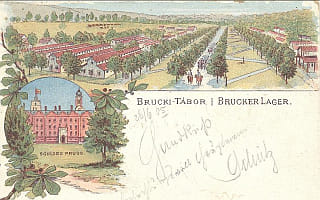
Bruckneudorf, Militärlager - Übersicht Brucker Lager & Schloss Prugg 28.8.1897

,1913

Bruckneudorf, Militärlager, Geschütz-Abteilung in Feuerstellung
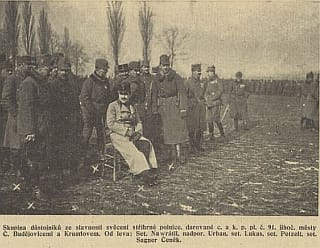
Officers from IR. 91 in Brucker Lager, 20 February 1918. Amongst them are two prototypes from the novel: Rudolf Lukas and Čeněk Sagner.
,7.3.1918

Gardehaus, former 2. Offizierskasino, 2010
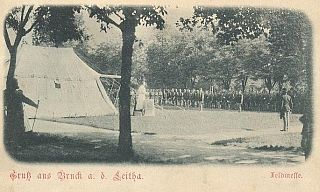
Bruckneudorf, Militärlager - Feldmesse
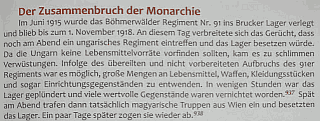
Bruck - Ujfalu - Királyhida - Bruckneudorf
,2011
Brucker Lager plays a vital part of the plot of The Good Soldier Švejk as the larger part of Part Two and the first chapter of Part Three takes place here. In total, more than a third of The Good Soldier Švejk is set in this camp and in the surrounding twin towns of Királyhida and Bruck. The author mostly uses the Czech word tábor when referring to the camp but the czechified German term lágr also appears. To judge by the text of The Good Soldier Švejk it is not clear where the camp was located but deputy Barabás places it in Bruck (it was actually in Királyhida).
Švejk and his transport would have arrived at night as the author states that night silence reigned over the camp. He also noted that in the men's barrack the soldiers shivered with cold whereas the officer's barracks were overheated so the windows had to be opened.
Background
Brucker Lager is a military camp and training ground in Bruckneudorf that was founded in 1867 and has been used continuously ever since. World War I saw the camp's most active period and at any time up to 26,000 soldiers were garrisoned here. This number dwarfed the combined populations of Bruck and Királyhida. During World War I the area also hosted a prisoner of war camp[c].
Jaroslav Hašek served in the camp throughout June 1915 and this explains why it became the backdrop for parts of The Good Soldier Švejk. The camp's commander from 1913 to 1918 was Oberstleutnant Wladimir Rollé, a person who may have lent his name to Auditor Ruller.
The camp consisted of wooden barracks that for the most part have been demolished since the time when Hašek served there. By far the largest part was Altes Lager (the old camp) that also housed Korpskommando. Neues Lager was much smaller and geographically separated from the old camp. It was established in 1873 and primarily used by the cavalry. Brucker Lager now (2010) exists as a military training ground, although parts of it has been turned into a nature reserve. The shooting range is one of the institutions that is still operaating.
In The Good Soldier Švejk many buildings, spots, and military institutions in the camp are mentioned. Amongst these we find (German terms): Lagerallee, Militärschießstätte, Hauptwache, Divisionsgericht, Divisionskommando, Mannschaftsbaracken, Offiziersbaracken, Offiziersmenage, Offiziersküche, Offizierskasino, and Rotes Kreuz[a].
IR. 91 in Brucker Lager
For Infanterieregiment Nr. 91 Brucker Lager was no ordinary training ground. In early 1915 it was decided that most regiments from Bohemia and Moravia were to be relocated to other parts of Austria-Hungary to avoid too much contact with the increasingly discontent Czech population. The Ersatzbataillon IR. 91 (replacement battalion) was thus transferred to Királyhida on 1 June 1915 and in Budějovice the Hungarian Infanterieregiment Nr. 101 replaced them.
Hašek's march battalion
The XII. Marschbataillon, to which Jaroslav Hašek belonged, was formed and trained here and left for the front on 30 June 1915. It was surely here in the camp that Hašek for the first time met Jan Vaněk, one of the best sources we have with regards to information about the author's time in k.u.k. Heer. It was also here that Rudolf Lukas from 1 June became Hašek's superior in the capacity of commander of the 4th march company.
Josef Novotný
One of the soldiers who was transferred to Királyhida on the same day as Hašek was Josef Novotný. Like Hašek he had been expelled from Budweiser Einjährigfreiwilligenschule and like the author of The Good Soldier Švejk he had a history of illness. He described the transport from Budějovice in detail and also the conditions in the camp. The transport arrived at Királyhida station at 2 in the night (2 June), but were kept in the carriages until dawn. This corresponds to Hašek's statement that "night silence reigned over the camp". The soldiers were housed in the barracks of Altes Lager (the old camp), decrepit wooden buildings with leaking roofs[b]. See Mannschaftsbaracken for more information.
After the war
When IR. 91 left the camp on 1 November 1918 they plundered it in order not to leave supplies on Hungarian hands, and a new round of destruction was inflicted in 1921 by Hungarian paramilitaries. During World War II the camp was again used for prisoners of war, and from 1944 Hungarian Jews and other forced labour were interned here[d].
The good soldier Švejk in captivity
Brucker Lager and the surrounding twin towns are also the stage for three of the fourteen chapters of Dobrý voják Švejk v zajetí. The major common theme with The Good Soldier Švejk is the Kakonyi affair where Fähnrich Dauerling is the main character and not Oberleutnant Lukáš. The dog theft we know from the novel takes place in Bruck instead of Prague and again Dauerling is found in the role of Lukáš. The sequences that describe Dauerling and the brutal German junior officers Feldwebel Sondernummer, Korporal Althof and Gefreiter Müller are almost identical and the same goes for the description of Major Wenzl. Lukáš and Hauptmann Ságner merely linger on the periphery and characters like Rechnungsfeldwebel Vaněk, Sappeur Vodička and Oberst Schröder don't feature at all. The role of the latter is however taken by Oberst Schlager but is far less prominent. Kadett Biegler does feature but in a different role.[1]
Quote(s) from the novel
[II.3] Nad vojenským táborem v Mostě panovalo noční ticho. V barácích pro mužstvo třásli se vojáci zimou a v důstojnických barácích otvírali okna, poněvadž bylo přetopeno. Od jednotlivých objektů, před kterými stály stráže, ozývaly se občas kroky hlídky, která si plašila chůzí spánek. Dole v Mostě nad Litavou zářily světla z c. k. továrny na masité konservy, kde se pracovalo dnem i nocí a zpracovávaly se různé odpadky. Poněvadž šel odtud vítr do alejí ve vojenském táboře, šel sem smrad z hnijících šlach, kopyt, paznehtů a kostí, které vařili do polévkových konserv.
[II.3] V jednom z důstojnických baráků v táboře čekal v noci Švejk na svého nadporučíka Lukáše, který šel večer do města do divadla a doposud se nevrátil.
[II.3] Nyní byl přidělen k vojenské střelnici v Királyhidě jako velitel a měl také co dělat s hospodářstvím v táboře. Mezi důstojníky se vypravovalo, že si major Wenzl nyní pomůže na nohy.
[II.3] Nadporučík Lukáš neměl původně v úmyslu někde se zdržet. Šel kvečeru z tábora do města jen do maďarského divadla v Királyhidě,
[II.3] Najít Sopronyi utczu čís. 16 nebylo by bývalo tak těžké, kdyby ho náhodou nebyl potkal starý sapér Vodička, který byl přidělen k „štajerákům“, jejichž kasárna byla dole v lágru. Vodička bydlíval před léty v Praze na Bojišti, a proto při takovém setkání nezbylo nic jiného, než že oba zašli do hospody „U černého beránka“ v Brucku, kde byla známá číšnice Růženka, Češka, které byli všichni čeští jednoročáci, kteří kdy byli v lágru, nějaký obnos dlužni.
[II.3] Poslední dobou sapér Vodička, starý partyka, dělal jí kavalíra a měl v seznamu všechny maršky, které odjížděly z tábora, a chodil v pravý čas Čechy jednoročáky upomínat, aby se neztratili bez zaplacení útraty ve válečné vřavě.
[II.3] Potom nás dohonil až nahoře u samýho lágru a povídal, že vždycky myslel, že sou Maďarky vohnivější, ale ta svině že ležela jako pařez a pořád jen něco brebentila.
[II.4] Plukovník Schröder se zalíbením pozoroval bledý obličej nadporučíka Lukáše, s velkými kruhy pod očima, který v rozpacích nedíval se na plukovníka, ale úkradkem, jako by něco studoval, díval se na plán dislokace mužstev ve vojenském táboře, který byl také jedinou ozdobou v celé kanceláři plukovníka.
[II.4] K jaké národnosti patřili vojáci z nedalekého vojenského tábora v Brucku nad Litavou, kteří přepadli a ztrýznili tamějšího obchodníka pana Gyulu Kákonyie?
[II.4] Toto se týká zejména jednoho pána, který se dle doslechu zdržuje doposud beztrestně ve vojenském táboře a stále ještě nosí odznaky svého papageiregimentu a jehož jméno bylo též uveřejněno předevčírem v Pester Lloydu a Pesti Napló.
[II.4] Včera jsem eskortoval taky dva do lágru a někdo mně sežral půl veky, kterou pro mne vyfasovali.
[II.5] Pane rechnungsfeldvébl," pravil důstojně Švejk, "dovoluji si vám prohlásit, že vašemu rozkazu nemůžu vyhovět při nejlepší vůli klidit se třebas z celýho lágru, neboť já podléhám vyššímu nařízení.
Sources: Klara Köttner-Benigni, Petra Weiß
Literature
- Kde to bylo6.4.1983
- Kaisers Geburtstag in Brucker Lager24.8.1915
- Wohltätigkeitskonzert in Brucker Lager21.9.1915
 | Mannschaftsbaracken |  | ||||
| Királyhida, Lagerstrasse | ||||||
| ||||||
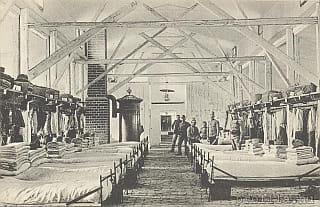
Bruckneudorf, Militärlager - Mannschaftsbaracke, Innenansicht
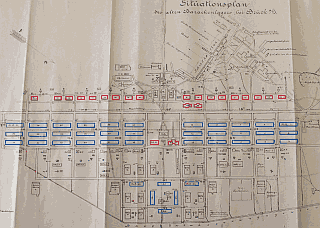
The men's barracks marked blue
,1908
Mannschaftsbaracken are mentioned when the author introduces Brucker Lager. In the barracks for the rank and file the men were shivering from cold, whereas the Offiziersbaracken where overheated so the windows had to be opened.
There is no indication that the plot took place here because Švejk was an officer's servant and would therefore stay with his superior in Offiziersbaracken.
Background
Mannschaftsbaracken refers to the men's barracks in Brucker Lager. These were found both in Altes Lager and in Neuer Lager but thanks to the notes of Josef Novotný we know that soldiers from Infanterieregiment Nr. 91 were lodged in wooden barracks in Altes Lager[a].
The men's barracks were found in the northern part of the camp, to the left of the Lagerallee (as approached from the main entrance of the camp). In 1908 the camp provided 39 barracks for the men[b].
The war led to big changes in the camp. Novotný's account[a] of conditions differs markedly from the impression of relative comfort one gets from pictures of the interior of the barracks. He noted that the barracks were overcrowded, that the soldier's slept on half rotten straw on the earth floor, so crowded that the men had to sleep three in a space intended for two. The roofs were leaking and the walls in part rotting.
Shivering from cold in june?
Hašek and his transport arrived on 2 June 1915 so it appears odd that the soldiers were shivering from cold at this time of the year. The weather reports (Vienna) reveal temperatures towards 26 degrees those days[c].
Quote(s) from the novel
[II.3] Nad vojenským táborem v Mostě panovalo noční ticho. V barácích pro mužstvo třásli se vojáci zimou a v důstojnických barácích otvírali okna, poněvadž bylo přetopeno.
Sources: Klara Köttner-Benigni, Petra Weiß
Literature
| a | Z mých válečných pamětí | 2021 | |
| b | 150 Jahre Brucker Lager/TÜPl Bruckneudorf | ||
| c | Das Wetter | 3.6.1915 |
 | Offiziersbaracken |  | ||||
| Királyhida, Lagerstrasse | ||||||
| ||||||
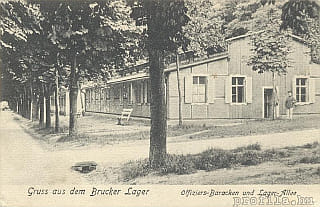
Bruckneudorf, Militärlager - Lagerallee mit Offiziers-Baracken

The officer's barracks a.o. marked red
,1908
Offiziersbaracken are mentioned when the author introduces Brucker Lager. Whereas in the Mannschaftsbaracken the men were shivering from cold, the officer's barracks were overheated so the windows had to be opened.
It was in one of these barracks that Švejk was in a conversation with Offiziersdiener Mikulášek when he was tasked by Oberleutnant Lukáš to deliver the fateful letter to Etelka Kakonyi. Major Wenzl and Lukáš stayed in the same barracks with their servant Mikulášek and Švejk.
Background
Offiziersbaracken refers to the officer's barracks in Brucker Lager. These were found both in Altes Lager and in Neuer Lager but thanks to the notes of Josef Novotný we know that soldiers from Infanterieregiment Nr. 91 were lodged in Altes Lager[a].
The officer's barracks were found in the northern part of the camp, to the right of the Lagerallee, seen in the direction from the main entrance. In 1908 the old camp had 20 officer's barracks[b].
Quote(s) from the novel
[II.3] Nad vojenským táborem v Mostě panovalo noční ticho. V barácích pro mužstvo třásli se vojáci zimou a v důstojnických barácích otvírali okna, poněvadž bylo přetopeno.
[II.3] V jednom z důstojnických baráků v táboře čekal v noci Švejk na svého nadporučíka Lukáše, který šel večer do města do divadla a doposud se nevrátil. Švejk seděl na odestlané posteli nadporučíkově a naproti němu seděl na stole sluha majora Wenzla.
Sources: Klara Köttner-Benigni, Petra Weiß
Literature
| a | Z mých válečných pamětí | 2021 | |
| b | 150 Jahre Brucker Lager/TÜPl Bruckneudorf |
 | Lagerallee |  | ||||
| Királyhida, Lagerstrasse | ||||||
| ||||||
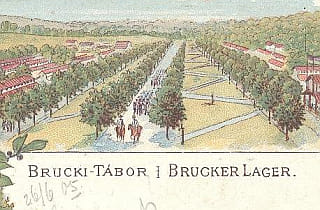
Lagerallee
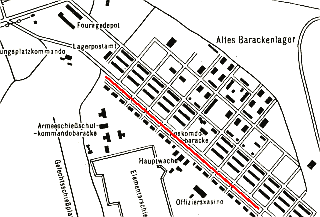
,1913
Lagerallee is mentioned when the author introduces Brucker Lager. He explains that when the wind blows from the direction from k.k. Fleischkonservenfabrik down in Bruck the stench from the factory is noticed even up in the alley in the military camp.
Background
Lagerallee refers to a broad alley that stretches through Brucker Lager from the main entrance in Lagerstrasse and eastwards. It has streets on both sides and a green area with trees in the middle. On the southern side the Offiziersbaracken were, on the northern side Mannschaftsbaracken. Korpskommando, Hauptwache, Offizierskasino, and Militärschießstätte were also located along the alley.
Almost all the buildings on the northern side of the alley have long been demolished and Benedek-kaserne is now one of the buildings on the site.
Quote(s) from the novel
[II.3] Dole v Mostě nad Litavou zářily světla z c. k. továrny na masité konservy, kde se pracovalo dnem i nocí a zpracovávaly se různé odpadky. Poněvadž šel odtud vítr do alejí ve vojenském táboře, šel sem smrad z hnijících šlach, kopyt, paznehtů a kostí, které vařili do polévkových konserv.
Sources: Klara Köttner-Benigni, Petra Weiß
Literature
 | K.k. Fleischkonservenfabrik |  | |||
| Királyhida, Lagerstrasse 8 | |||||
| |||||
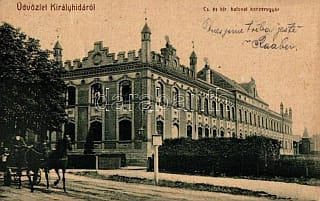
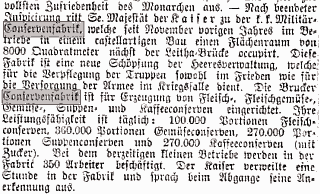
,2.6.1897
K.k. Fleischkonservenfabrik (the Royal-Imperial Meat tinning factory) is pungently described by the author in his introduction to Királyhida. Here they tin and make soup from sinews, hoofs and intestines, even rotten. When the wind blew from that direction the stench spread up to Lagerallee.
Background
K.k. Fleischkonservenfabrik refers to k.u.k. Militärkonservenfabrik, a tinning factory that operated from November 1896 in Királyhida. Thus it was not located in Bruck as stated in The Good Soldier Švejk and also belonged to the common military (k.u.k) and not to the military of Cisleithania as the abbreviation k.k. indicates.
Apart from meat it tinned vegetables, soups and coffee[a]. Emperor Franz Joseph I. honoured the factory with a visit already on 1 June 1897 in connection with an inspection of Brucker Lager. He spent more than an hour there and even sampled the produce.
At the time the factory had 350 employees but during World War I up to 3000 worked there, including prisoners of war. The running of the factory was outsourced to various enterprises and operation ceased with the end of the war.
In 2010 the 4,000 sqm building housed a shopping centre, a police office and a car accessory dealer, but most of it is no longer used.
The good soldier Švejk in captivity
The factory is mentioned also in Dobrý voják Švejk v zajetí, but the description is less detailed. It is however explicitly (and wrongly) located in Bruck.[1]
Bylo to ale přece jen blíž. Přejde se Litavka v Brucku a již je člověk v 'magyarországu' červenozelenobílými sloupy. Sem táhne sice ještě zápach z velké c. k. továrny na konzervy v Brucku nad Litavou, dávaje Maďarům tušit, že tam za Litavou leccos prodělává hnilobný proces, ale míchá se tu se zápachem uherských prasat, která za tratí jsou vehnána do velkých ohrad a odtud s honvédy, honvédhusary a červenými husary dopravují se dále na frontu.
Klara Köttner-Benigni
In Királyhida war noch im Ersten Weltkrieg die „K.u.k. Militär-Conserven-fabrik” (im „Schwejk” „k.u.k. Fleischkonserven-fabrik”) in Betrieb. (S. 324) In ihr dürften sehr vorwiegend Fleisch-, Suppen-, Gemüse- und Kaffeekonserven hergestellt worden sein. Zumindest im Frieden waren die Rezepturen einwandfrei, wie Konrad Biricz nach deren Prüfung in Akten des Staatsarchivs (Kriegsarchivs) erklärt. Wegen kriegsbedingter Versorgungsschwierigkeiten wird die Qualität sicherlich schlechter geworden sein, aber die Bemerkung, daß dort — bereits 1915! — eine Mischung von stinkenden „verfaulten Sehnen, Hufen, Klauen und Knochen” zu „Suppenkonserven” verarbeitet wurde (S. 325), ist eine der grotesken Übertreibungen des Gourmets Hašek, dem es vor dem kulinarischen Massenbetrieb geekelt haben muß.
Quote(s) from the novel
[II.3] Dole v Mostě nad Litavou zářily světla z c. k. továrny na masité konservy, kde se pracovalo dnem i nocí a zpracovávaly se různé odpadky. Poněvadž šel odtud vítr do alejí ve vojenském táboře, šel sem smrad z hnijících šlach, kopyt, paznehtů a kostí, které vařili do polévkových konserv.
Sources: Petra Weiß, Klara Köttner-Benigni, Konrad Biricz
Literature
- Kde to bylo6.4.1983
- K.u.k. Militär-Conservenfabrik
- Truppen-Inspizierung1.6.1897
- Eine Militär Conserven-Fabrik3.6.1897
| a | Die „Abenteuer des Braven Soldaten Schwejk” in Österreich | 1983 | |
| 1 | Dobrý voják Švejk v zajetí | 1917 |
 | Militärschießstätte |  | |||
| Királyhida, Lagerstrasse | |||||
| |||||
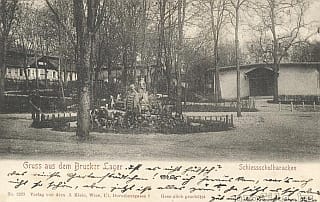
Bruckneudorf, Militärlager - Schießschul-Baracken

,4.12.1868
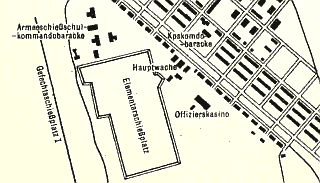
,1913
Militärschießstätte vert nemnd når forteljaren deler sine fyrste inntrykk frå Brucker Lager. Soon later it is revealed that Major Wenzl is the commander of the shooting range.
Background
Militärschießstätte refers to the shooting range in Brucker Lager that belonged to k.u.k. Armeeschieß-Schule (the Army shooting school). It was opened already on 1 September 1868, a year after the camp came into operation[a]. The instruction mainly regarded rifle shooting but also machine guns.
The shooting range was situated behind Offiziersbaracken in the southern direction. Commander in 1913 was Oberst Otto Bartusch from Infanterieregiment Nr. 36. Before the war, the shooting school in Brucker Lager was operating from May to September but this may have changed at the outbreak of war. The rest of the year they were based in Wien[b].
The shooting school was a central institution for the entire k.u.k. Wehrmacht and was during the pre-war years greatly expanded. How important the institution was can be seen by the fact the commanders of the camp had high ranks and Bartusch's predecessor even held the rank Generalmajor. At the time there were also discussions on de-centralising the shooting education due to capacity problems in Brucker Lager[d].
In June 1915
Who the commander was in the period that Jaroslav Hašek served in Brucker Lager (June 1915) is not known because Bartusch was called up for service at the outbreak of war[c]. According to The Good Soldier Švejk Major Wenzl was the commander of the shooting range (not necessarily the shooting school) and his prototype Franz Wenzel was in the camp as commander of XII. Marschbataillon. Before the war he had been head of the shooting range in Kutná Hora so there may be connection. Going against the assumption that Wenzel headed the shooting range is the short period he stayed here (4 weeks) and that the school commanders had much higher ranks than Major (at least before the war ). It is therefore unlikely that the occupied exactly this position but he may still have had a another position at the school.
Parts of the shooting school/range are still (2010) operating but obviously with a much lower lever of activity than in 1915.
Quote(s) from the novel
[II.3] Od opuštěného pavilónku, kde dřív za času míru fotografoval nějaký fotograf vojáky trávící zde mládí na vojenské střelnici, bylo vidět dole v údolí u Litavy červené elektrické světlo v bordelu „U kukuřičného klasu“, který poctil svou návštěvou arcivévoda Štěpán při velkých manévrech u Šoproně v roce 1908 a kde se scházela denně důstojnická společnost.
[II.3] Nyní byl přidělen k vojenské střelnici v Királyhidě jako velitel a měl také co dělat s hospodářstvím v táboře. Mezi důstojníky se vypravovalo, že si major Wenzl nyní pomůže na nohy.
Sources: Petra Weiß, Klara Köttner-Benigni, Konrad Biricz
Also written:The military shooting rangeenVojenská střelniceczMilitærskytebanano
Literature
- Die „Abenteuer des Braven Soldaten Schwejk” in Österreich1983
- Wechsel auf höheren militärischen Posten29.7.1912
| a | Teil 1: Von der Gründung 1867 bis zum Ersten Weltkrieg 1914 | 5.12.2017 | |
| b | Armeeschießschule | 1913 | |
| c | Generalmajor Otto Bartusch | 16.10.1931 | |
| d | Aufstellung von "Lehrkompanien" | 6.2.1912 |
 | Zum Kukuruzkolben |  | ||||
| ||||||

Hotel Erzherzog Franz Ferdinand.
, Wolfgang Gruber

6.4.1983
Zum Kukuruzkolben was honoured by a visit from Archduke Stephan during the Imperial and Royal manoeuvres by Sopron in 1908. Now, in 1915, it was the playground of officers and ordinary soldiers were not allowed to enter. It was located in the valley by the Leitha and it's red electric lights were visible from the abandoned photo pavilion in Brucker Lager.
Background
Zum Kukuruzkolben was according to the narrative in The Good Soldier Švejk a distinguished brothel in the valley by the river Leitha, on which side is not known. There was no establishment here carrying this name in 1915. One possibility is Hotel Erzherzog Franz Ferdinand (also called Hotel Graf) on the riverbank the entrance to Brucker Lager[a]. A well known brothel was the so-called Blaues Haus but this was located some distance west of the river in Bruck [b].
The Archduke
The reported story about the Archduke Stephan's visit to a brothel is surely hearsay because it can be ruled out that he was in the area when the manoeuvres took place in 1908. Nor did the local newspaper Bezirksbote record any other visit by him between 1902 and 1915. Nor did it print anything about any archduke visiting in 1908.
Ethymology
Kukuruz is the Austrian variant of the German word Mais, derived from Turkish kokoroz. The Czech word kukuřice is of the same origin.
The good soldier Švejk in captivity
The brothel is mentioned also in Dobrý voják Švejk v zajetí and explicitly located in Királyhida. The context is also here Archduke Stephan's alleged visit in 1908.[1]
Jinak Királyhida je zaprášené město. Obyvatelé nevědí, jestli jsou Němci nebo Maďaři. Městské děvy pěstují flirt s důstojníky vojenského tábora z Brucku. Také tu kvete prostituce jako všude v Maďárii. Jsou tam jen dvě památnosti, zříceniny cukrovaru a vykřičený dům U kukuřičního klasu, který ráčil poctíti svou návštěvou arcivévoda Štěpán roku 1908 za velkých manévrů.
Quote(s) from the novel
[II.3] Od opuštěného pavilónku, kde dřív za času míru fotografoval nějaký fotograf vojáky trávící zde mládí na vojenské střelnici, bylo vidět dole v údolí u Litavy červené elektrické světlo v bordelu „U kukuřičného klasu“, který poctil svou návštěvou arcivévoda Štěpán při velkých manévrech u Šoproně v roce 1908 a kde se scházela denně důstojnická společnost.
Sources: Klara Köttner-Benigni, Radko Pytlík, Wolfgang Gruber
Also written:The Maize CobParrottAt the Ear of CornSadlonU kukuřičného klasuczKukoricakalászhozhu
| a | Die „Abenteuer des Braven Soldaten Schwejk” in Österreich | 1983 | |
| b | Kde to bylo | 6.4.1983 | |
| 1 | Dobrý voják Švejk v zajetí | 1917 |
 | Rosenhaus |  | ||||
| ||||||
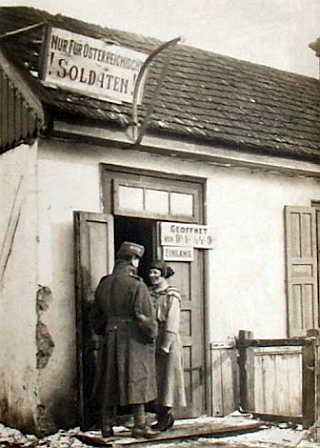
K.u.k. Mannschaftspuff, unkown where.

6.4.1983
Rosenhaus is mentioned as a house of ill repute where even ordinary soldiers cold enjoy themselves. It's green lights were visible from the abandoned photo pavillion in Brucker Lager.
Background
Rosenhaus was the author's name of a brothel in Bruck or Királyhida that has not been identified[a]. In 1915 there were five official brothels in the twin towns but none of them carried this name (Petzneck). There were also some unregistered brothels. Judging by the description in the novel it must be assumed that it was located near the river. Růžový dům may also be translated Das rosa Haus. One well known brothel was Das Blaue Haus, located at the end of the street Altstadt in Bruck an der Leitha[b].
Quote(s) from the novel
[II.3] Ti chodili do „Růžového domu“, jehož zelená světla byla též vidět od opuštěného fotografického ateliéru. Bylo to roztřídění jako později na frontě, kdy mocnářství nemohlo už svému vojsku ničím jiným pomoct než přenosnými bordely u štábů brigád, takzvanými „puffy“. Byly tedy k. k. Offizierspuff, k. k. Unteroffizierspuff a k. k. Mannschaftspuff.
Sources: Wolfgang Gruber, Friedrich Petzneck
Also written:Růžový důmHašekThe House of RosesParrottRosenhausReinerPink HouseSadlonRózsaházhu
| a | Die „Abenteuer des Braven Soldaten Schwejk” in Österreich | 1983 | |
| b | Kde to bylo | 6.4.1983 |
 | Hungarian Theatre |  | ||||
| ||||||

Raiffeisengürtel - Stadttheater

,12.6.1904

,4.4.1915
Hungarian Theatre was the theatre in Királyhida where Oberleutnant Lukáš got so enchanted by Etelka Kakonyi that he wrote the letter that set in motion the infamous Kakonyi affair. He was present at a squalid performance where officers from the artillery sat on the orchestra floor and observed the Jewish actresses (who were naked beneath their skirts) with artillery glasses. Otherwise it is revealed that the theatre had a gallery. In the letter itself Lukáš uses the term municipal theatre.
Background
Hungarian Theatre refers to a theatre that was supposed to be located in Királyhida but there is no trace of such an establishment in 1915. The only leisure institution in town was a cinema/provisional theatre. The nearest theatre was across the river in Bruck an der Leitha where there indeed existed a theatre, the so-called Sommertheater[a].
Mix-ups
Klara Köttner-Benigni concludes that the author mixes up institutions. There was a temporary theatre in Királyhida but this one doesn't fit the description in The Good Soldier Švejk. It is clear that the author had a permanent theatre building in mind, and in this context the one in Bruck is best fit. In the letter that Oberleutnant Lukáš wrote to Etelka Kakonyi he even uses the term Stadttheater (City Theatre). Köttner-Benigni also notes that Hašek didn't put much emphasis on locating buildings/institutions in Bruck or in Királyhida respectively[a].
Theatre in Bruck
Brucker Sommertheater was built in 1904 and performances started even before the construction had finished. The premiere took place on 16 June 1904 and the operette Die Fliedermaus by Johann Strauss the younger was performed in front of a sold-out theatre[b]. The theatre was supplied with electric power and also had a gallery. It was located in the current Raiffeisengürtel and associated with it was the restaurant of Josef Nowotny. The owner in 1911 was Eva Rappel who recently had aquired it. That same year she also bought Apollo-Theater in Bruck[d]. Newspaper articles reveal that the theatre also hosted cabarets.
Cinema in Királyhida
TBD
Quote(s) from the novel
[II.3] V jednom z důstojnických baráků v táboře čekal v noci Švejk na svého nadporučíka Lukáše, který šel večer do města do divadla a doposud se nevrátil.
[II.3] Nadporučík Lukáš neměl původně v úmyslu někde se zdržet. Šel kvečeru z tábora do města jen do maďarského divadla v Királyhidě, kde hráli nějakou maďarskou operetku s macatými židovkami-herečkami v předních úlohách, jejichž báječnou předností bylo to, že vyhazovaly při tanci nohy do výše a nenosily ani trikot, ani kalhoty a kvůli větší přitažlivosti pánů důstojníků holily se dole jako Tatarky, z čehož ovšem neměla žádný požitek galérie, a zato tím větší důstojníci od dělostřelectva sedící dole v parteru, kteří si na tu krásu brali s sebou do divadla dělostřelecké triedry.
[II.3] Milostivá paní!
Byl jsem včera přítomen v městském divadle hře, která Vás rozhořčila. Sledoval jsem Vás již při celém prvním jednáni, Vás i Vašeho pana manžela. Jak jsem pozoroval...
Sources: Klara Köttner-Benigni, Konrad Biricz
Also written:Maďarské divadloczUngarisches Theaterde
Literature
- Verschiedenes aus Bruck12.6.1904
| a | Die „Abenteuer des Braven Soldaten Schwejk” in Österreich | 1983 | |
| b | Theater und Kunst | 19.6.1904 | |
| c | Ein neues Kinotheater in Bruck | 17.8.1913 | |
| d | Vom Brucker Sommertheater | 11.6.1911 |
 | Zum Erzherzog Albrecht |  | ||||
| ||||||
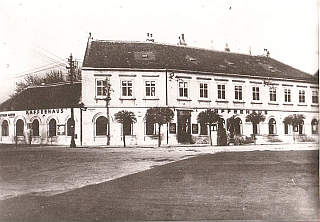
Deutsches Kaffehaus
, Wolfgang Gruber
Zum Erzherzog Albrecht is mentioned because Oberleutnant Lukáš dropped by after having visited the Hungarian Theatre in Királyhida where he had seen the enchanting Etelka Kakonyi. The author describes it as a large café and wine restaurant.
Background
Zum Erzherzog Albrecht was supposedly a large café and wine tavern in Bruck which was frequented by officers, but there are no historical traces of any café with this name. To judge by the author's description it may have been Deutsches Kaffehaus where only officers were allowed[a]. Another possibility is upmarket Hotel Erzherzog Franz Ferdinand.
Quote(s) from the novel
[II.3] Nadporučík Lukáš vzal si též z garderoby plášť a šel do města, kde setkal se ve velké vinárně a kavárně „U arcivévody Albrechta“ s několika důstojníky od 91. pluku.
Sources: Klara Köttner-Benigni, Friedrich Petzneck
Also written:The Archduke AlbrechtParrottAt the Archduke AlbertSadlonU arcivévody AlbrechtaczAlbrecht főherceghezhu
Literature
- Kde to bylo6.4.1983
| a | Die „Abenteuer des Braven Soldaten Schwejk” in Österreich | 1983 |
 | Zum Kreuz des Heiligen Stephan |  | ||||
| ||||||
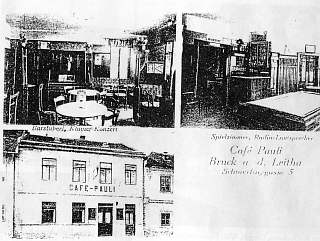
, Wolfgang Gruber
Zum Kreuz des Heiligen Stephan is mentioned as Oberleutnant Lukáš wrote the famous letter to Etelka Kakonyi here.
Background
Zum Kreuz des Heiligen Stephan was supposedly a small café cum brothel in Bruck or Királyhida, but even this one can not be historically traced. According to Klara Köttner-Benigni the brothels in Bruck were not associated with cafés[a], so this connection is most likely invented and re-located from somewhere else. Small cafés did exist though, one of them was Café Pauli which fits the description quite well.
Quote(s) from the novel
[II.3] Ve velice dobré náladě odešel do malé kavárny „U kříže sv. Štěpána“, kde zašel do malého chambre séparée, vyhnal odtamtud nějakou Rumunku, která se nabízela, že se svlékne do naha a že si s ní může dělat, co chce, poručil si inkoust, péro a dopisní papír, láhev koňaku a napsal po bedlivé úvaze toto psaní, které se mu zdálo být vůbec nejhezčím, které kdy napsal:
Also written:At the Cross of St StephenParrottAt the Cross of St. StevenSadlonU kříže sv. ŠtěpánaczSzent István keresztjéhezhu
| a | Die „Abenteuer des Braven Soldaten Schwejk” in Österreich | 1983 |
 | Die Steirer |  | ||||
| ||||||

1914

Korpsbereich Nr. 3
1914
Die Steirer is mentioned by the author as a military unit that was garrisoned in Brucker lager. Sappeur Vodička was assigned to this unit.
Background
Die Steirer (Styrians) is a term that usually refers to people from Styria but in this context it is obvious that the narrator has an army unit from this region in mind, most likely an engineering battalion (Sappeure or Pioniere).
Sapper battalions
In k.u.k. Heer the pure engineering troop units were the so-called Zákopníci who until 1912 had counted 15 battalions. In 1912 these were reorganised into 8 Pionierbataillone and 14 Sappeurbataillone. As a rule a sapper battalion was recruited from one of the 16 army corps districts. Thus Sappeurbataillon Nr. 3 was recruited from Korpsbereich Nr. 3 (Graz), an area that apart from Styria also included the areas westwards towards the Adtriatic Ocean and the border with Italy. So if any sapper-unit was to be classed as "Styrians" it would be this one. Their command of the Ergänzungsbezirk was located in Pettau (now Ptuj) and the battalion command in Görz (now Gorizia/Gorica). Commander in 1914 was Major Leo Maschek[a].
Styrians in Brucker Lager
Attempts to establish which Styrian units were present in Brucker Lager in 1915 have so far failed. It is not known if other replacement units than Infanterieregiment Nr. 91 were located here. Moreover, many units may have passed through the camp for training purposes.
Infanteriavdelingar
Infanteriregiment hadde òg sine eigne ingeniørsoldatar så Vodička kan i teorien ha vore tildelt eitt av desse. Tree infanteriregiment i k.u.k. Heer var rekrutterte frå Styria: Infanterieregiment Nr. 27 (Graz), Infanterieregiment Nr. 47 (Marburg) og Infanterieregiment Nr. 87 (Cilli). I tilleg stitle området soldatar til det lette infanteriet, her Feldjägerbataillon Nr. 9 (Graz) og delvis nokre andre. I tillegg vart k.k. Landwehrinfanterieregiment Nr. 3 (Graz) og k.k. Landwehrinfanterieregiment Nr. 26 (Marburg) rekrutterte frå Steiermark.
Infantry units
All infantry regiments kept their own engineering soldiers so Vodička could also in theory have been assigned to one of these. Three infantry regiments in k.u.k. Heer were recruited from Styria: Infanterieregiment Nr. 27 (Graz), Infanterieregiment Nr. 47 (Marburg) and Infanterieregiment Nr. 87 (Cilli). In addition the area provided manpower for the light infantry: Feldjägerbataillon Nr. 9 (Graz) and partly others. In addition k.k. Landwehrinfanterieregiment Nr. 3 (Graz) and k.k. Landwehrinfanterieregiment Nr. 26 (Marburg) were recruited from Styria.
Quote(s) from the novel
[II.3] Nadporučík zabalil se opět do deky, ze které ho Švejk vytáhl, a spal dál, zatímco Švejk putoval dál do Királyhidy. Najít Sopronyi utczu čís. 16 nebylo by bývalo tak těžké, kdyby ho náhodou nebyl potkal starý sapér Vodička, který byl přidělen k „štajerákům“, jejichž kasárna byla dole v lágru.
Also written:The StyriansenSteierbuamReinerŠtajerácicz
| a | Schematismus für das k.u.k. Heer (s. 1580) | 1914 |
 | Zum schwarzen Lamm |  | ||||
| ||||||
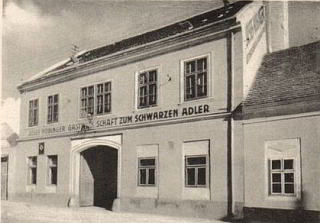
, Wolfgang Gruber

Grete Reiner mixing the colours
,1.3.1927
Zum schwarzen Lamm was the pub where Švejk and Sappeur Vodička refreshed themselves before going to Soproni utca to deliver the infamous letter from Oberleutnant Lukáš to Etelka Kakonyi. Here served the well-known Czech waitress Růženka who was owed money by all the Czech one-year volunteers that had been in Brucker Lager.
Background
Zum schwarzen Lamm was supposedly a pub in Bruck, but there are no historical traces of it. The name may be a corruption of Zum schwarzen Adler, a café located in Altstadt. During World War I this street functioned as the entertainment district of Bruck.
Swapped colours?
A strange detail appears in Grete Reiner's German translation. She calls it Zum roten Lamm, a place that according to Gerhard Tötschinger may have existed. His source was however some unnamed teacher. If it against all probability existed, it would have been located in Raiffeisengürtel 7 at the end of Altstadt[a]. Has Jaroslav Hašek been "corrected", and in that case why? Reiner was not very solid in Czech but to make a basic error like mixing red and black (červený and černý) seems unlikely.
No lamb in sight
Red Lamb was in any case a rare and unlogigal name for a tavern. Unsurprising, a search in ÖNB (term "Zum roten Lamm") yields only 1 hit, whereas "Zum schwarzen Lamm" has 189, a more plausible number. Still, at the end of the day no "Lamm", whatever colour or shape, is known to have ever existed in Bruck or Királyhida.
Quote(s) from the novel
[II.3] Nadporučík zabalil se opět do deky, ze které ho Švejk vytáhl, a spal dál, zatímco Švejk putoval dál do Királyhidy. Najít Sopronyi utczu čís. 16 nebylo by bývalo tak těžké, kdyby ho náhodou nebyl potkal starý sapér Vodička, který byl přidělen k „štajerákům“, jejichž kasárna byla dole v lágru. Vodička bydlíval před léty v Praze na Bojišti, a proto při takovém setkání nezbylo nic jiného, než že oba zašli do hospody „U černého beránka“ v Brucku, kde byla známá číšnice Růženka, Češka, které byli všichni čeští jednoročáci, kteří kdy byli v lágru, nějaký obnos dlužni.
Sources: Klara Köttner-Benigni, Konrad Biricz
Also written:The Black LambParrottZum Roten LammReinerAt the black Ram/The Little black RamSadlonU černého beránkaczFekete báránythu
Literature
- Kde to bylo6.4.1983
| a | Die „Abenteuer des Braven Soldaten Schwejk” in Österreich | 1983 |
 | K.k. Landwehrinfanterieregiment Nr. 16 |  | ||||
| Krowodrza, Wrocławska 82 | ||||||
| ||||||

Landwehr-Ergänzungsbezirk Nr. 16
1913

The barracks of LIR. Nr. 16, Krowodrza
K.k. Landwehrinfanterieregiment Nr. 16 is mentioned by Sappeur Vodička when he tells Švejk about a brawl he had been involved in by Pausdorf. He was about to attack Landwehrsoldat Purkrábek because he though the latter was a Hungarian. Purkrábek then exclaims: "Tonda, come on, it's me, Purkrábek, from 16. landwehr!"
Background
K.k. Landwehrinfanterieregiment Nr. 16 was one of 37 k.k. Landwehr infantry regiments and like most of its peer units it was established in 1889. The regiment was recruited from the districts Kraków and Wadowice. Their barracks were located in Krowodrza, now a district in Kraków. In 1914 staff and all three battalions were garrisoned in Kraków. Their commander was Oberst Heinrich von Dürfeld[a]. At the start of the war they were reporting to 46. Landwehrdivision. The regiment was predominantly manned by Poles, more than 80 per cent.
During the war
The regiment was part of the invasion of Russian Poland in August 1914 and participated in the battle of Kraśnik at the end of the month. During the fighting, colonel Dürfeld and several staff officers were wounded[b]. On 25 October 1914 they took part in the battle of Ivangorod (now Dęblin)[c] and later that year and until April 1915 they stayed near the river Nidą. In May they participated in the Central Powers' breakthrough by Gorlice-Tarnów. After this battle and during the summer they pursued the enemy to Volhynia and reached the area by Lutsk in early September[d].
From 30 November 1915, they were in reserve between Dubno and Chorupan, the area where 9. Infanteriedivision with Infanterieregiment Nr. 91 had been fighting in September and where Jaroslav Hašek was taken prisoner. In June 1916 the regiment suffered disastrous losses during the first day of the Brusilov offensive by Sapanow. In August they were transferred to the Romanian front and during the spring and summer of 1918 they were taking part in the occupation of Ukraine. In August 1918 they were transported to the Italian front[d].
Quote(s) from the novel
[II.3] „Jednou ti už takovýho kluka maďarskýho držím za chřtán v Pausdorfě, kam jsme šli my saperáci na víno, a chci mu dát jednu überšvunkem přes kokos v tý tmě, poněvadž jsme hned, jak to začlo, praštili láhví do visací lampy, a von najednou začne křičet: ,Tondo, dyť to jsem já, Purkrábek, vod 16. landwehr!’
Sources: Wacław Szczepanik, Österreich-Ungarns letzter Krieg, Jaroslav Šerák
| a | Schematismus der k.k. Landwehr (s. 253) | 1914 | |
| b | Auf dem Schlachtfeld zum Major befördert | 5.9.1914 | |
| c | Auf dem Felde der Ehre gefallen | 16.5.1915 | |
| d | Między armią austro-węgierską a Wojskiem Polskim | 2018 |
 | Ein stilles Lokal |  | |||
| |||||

Gasthof zur Ungarische Krone before the First World War.

Der neue Bezirksbote,26.12.1920
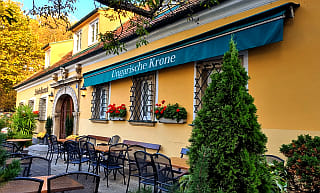
Ungarische Krone, 14.10.2023
Ein stilles Lokal is described by Sappeur Vodička when tells Švejk about "an inn between the gardens by the river, quiet as a chapel, made for causing trouble". He doesn't name the place, but goes into some details about how he provoked a fight there. Needless to say, the recipients of his wrath were Hungarians.
Background
The quiet pub by the river was very likely Gasthof zur Ungarische Krone in Királyhida, a restaurant that is still operating (2023). Sappeur Vodička's description fits perfectly: the establishment is located by the Leitha between the gardes and provides a quite atmosphere, a situation that probaly wasn't much different in 1915.
Steeped in history
The restaurant is one of the oldest in the entire area and the building itself dates back 300 years. It was originally a monastery that was destroyed during an Ottoman incursion. In 1726 it was rebuilt and functioned thereafter as hostel, mail station and eventually a roadside inn[a]. The municipality owned the property but already before World War I it was leased to private landlords. During a round of lease auctions in 1920 it is revealed that the property had a restaurant with a garden and also five guest-rooms[d].
According to Cilla Krakhofer (who owned it in 1983) fighting between soldiers definitely took place during World War I. Eventually it was leased to the Krakhofer family who in the end purchased it[b].
It is still owned by the family (Maria Krakhofer) and functions as hotel and restaurant. When the ownership transition happened is not known but as late as 1935 the municipality still owned the place[c].
Klara Köttner-Benigni
Wahrscheinlich meint Hašek mit dem stille Gasthaus, das am Fluß bei Gäne steht, die „Ungarische Krone”. Sie wurde 1726 auf Weisung Karls V als Herberge errichtet und diente später als Einkehrgasthof. Sein Eigentümer war die Stadtgemeinde Bruck an der Leitha. Er wurde späters verpachtet und schließlich an die Familie Krakhofer verkauft. Neben dem etwas abgesetzt von die Straße liegenden Restaurant un mittelbar an der Leitha erstrecht sich noch jetzt ein Park mit alte Bäumen. Andere Lokale in Flußnähe bestanden nur vorübergehen. In der „Ungarischen Krone” sind Raufereien zwischen Soldaten während des Ersten Weltkriege verbürgt, wie die heutige Besitzerin Cilli Krakhofer berichtet.
Quote(s) from the novel
[II.3] Člověk míní, ale pánbůh mění. Tam u řeky až mezi zahradami našel jsem vopravdu takovej lokál, tichej jako kaple, jako stvořenej pro kravál.
Sources: Klara Köttner-Benigni, Konrad Biricz
Literature
- Aus der am 25. Oktober i. J. abgehaltenen Gemeinde-Ausschußsitzung22.12.1912
- Gestorben28.9.1913
- Gartenfest4.8.1918
| a | "Ungarische Krone" | 2020 | |
| b | Die „Abenteuer des Braven Soldaten Schwejk” in Österreich | 1983 | |
| c | Bruck a. d. L. | 24.3.1935 | |
| d | Gasthausverpachtung | 26.12.1920 |
 | Invalidovna |  | |||
| Karlín/24, Královská tř. | |||||
| |||||
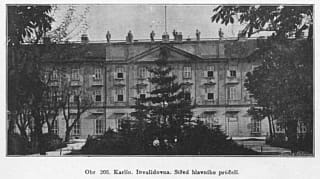
,1901

,1900
Invalidovna appears in the story Švejk tells Sappeur Vodička about liquor trader Paroubek who chased a Slovak across Karlín and Žižkov, all the way to Malešice.
Background
Invalidovna is a former institution for war invalids and veterans in Karlín, built from 1731-1737. Its model was Les Invalides, a building for veterans inaugurated in Paris in 1679. The building was seriously damaged by the floods in August 2002. Until 2013 it was partially used by VÚA. During World War I it was used as a lasaret.
Quote(s) from the novel
[II.3] Potom ještě řekl Paroubkovi, že je huncút a šaščínská bestie, tak ho milej Paroubek chyt, votlouk mu jeho pastě na myši a dráty vo hlavu a vyhodil ho ven a mlátil ho po ulici tyčí na stahování rolety až dolů na Invalidovnu a hnal ho, jak byl zdivočelej, přes Invalidovnu v Karlíně až nahoru na Žižkov, vodtud přes Židovský pece do Malešic, kde vo něj konečně tyč přerazil, takže se moh vrátit nazpátek do Libně.
Literature
 | Na Růžovém ostrově |  | ||||
| Zaběhlice/59, - | ||||||
| ||||||
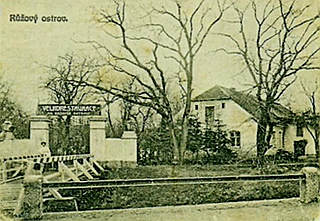
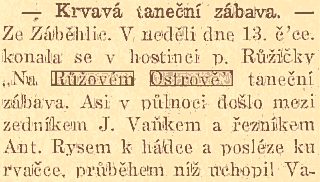
,26.7.1909
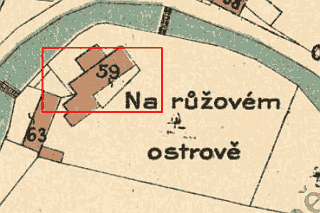
Na Růžovém ostrově in Záběhlice was yet another place where Sappeur Vodička had been involved in fighting, the noise could be heard all the way to Michle.
Background
Na Růžovém ostrově was a large restaurant with a garden, owned by Václav Růžička, located in Záběhlice on an artificial island in the Botič stream called Růžový ostrov (Rose Island).
The restaurant was in business from at least 1880[a] and was in 1883 owned by some Almer[b]. By 1886 Růžička had been taken over[c] and he probably managed it until he died on 21 February 1924. He was buried at the cemetry in Zaběhlice[d]. After Růžička's death the restaurant was managed by his daughter Růžena Burgetová[e].
Rose Island was a popular excursion destination, and arranged dancing, meetings, and other gatherings. It was operating until 1928 but since then the building has been used for other purposes.
Quote(s) from the novel
[II.3] „Plácnu taky ženskou, Švejku, mně je to jedno, to ještě neznáš starýho Vodičku. Jednou v Záběhlicích na ,Růžovým ostrově’ nechtěla se mnou jít jedna taková maškara tančit, že prej mám voteklou hubu. Měl jsem pravda hubu vopuchlou, poněvadž jsem právě přišel z jedný taneční zábavy v Hostivaři, ale považ si tu urážku vod tý běhny. ,Tak tu máte taky jednu, velectěná slečno,’ řek jsem, ,aby vám to nebylo líto.’ Jak jsem jí tu jednu utrh, povalila celej stůl na zahradě i se sklenicema, za kterým seděla s tatínkem a s maminkou a s dvěma bratry. Ale nebál jsem se celýho ,Růžovýho ostrova’.
Sources: Jaroslav Šerák, Česká televize
Also written:Roseninselde
Literature
| a | Ze Záběhlic | 26.8.1880 | |
| b | Krádeže | 9.2.1883 | |
| c | Hospodářský spolek okresu Král. Vinohradského | 5.5.1886 | |
| d | Úmrti | 23.2.1924 | |
| e | Románové restaurační a jiné zábavní podniky | 2009 - 2021 |
 | Hauptwache |  | ||||
| Királyhida, Lagerstrasse | ||||||
| ||||||
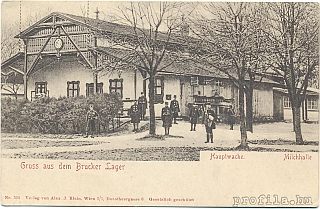

,1913
Hauptwache is mentioned because Švejk and Sappeur Vodička were led to the prison here after the fight in Soproni utca. It is also the place where Einjährigfreiwilliger Marek re-enters the story for the first time since the troop transport had a break at a railway station in Vienna. He had refused to clean the latrines and been locked up. The greater part of the action in [II.4] takes place here.
Background
Hauptwache was the main guard building and command centre in Brucker Lager in Királyhida. This was also where the camp prison was located. Some time after 1955 the building was demolished[a]. There was also a guard in the so-called Neues Lager but this was merely referred to as Wachhaus. It has not been possible to verify that it has prison cells here. Soldiers from Infanterieregiment Nr. 91 were garrisoned in Altes Lager (old camp) so this is surely where the action in The Good Soldier Švejk took place[b]. The main guard house in the old camp was located halfway down Lagerallee.
Klara Köttner-Benigni
Die Hauptwache war das Zentrum des „Brucker Lagers”. Hier wurden die Wachen vergattert und in ihre Lagerbereiche abkommandiert, um für Ordnung und Disziplin zu sorgen. So liefen hier auch alle Nachrichten und Meldungen zusammen. In der Hauptwache waren auch die Arreste untergebracht. Die wechselnden Regimentsmusikkapellen konzertierten vor der Hauptwache. Nach 1921 wurde das Objekt umgebaut und als Offizierscasino und Lagerkaffeehaus verwendet. Die Bevölkerung nannte es "Milchmariandl”. 1955 fand in dem Objekt das Bankett aus Anlaß der Übergabe des „Brucker Lagers” durch die sowjetische Besatzungsmacht an die österreichischen Behörden statt. Anschließend wurde es nicht mehr verwendet und bedauerlicherweise abgerissen.
Quote(s) from the novel
[II.3] Starý sapér Vodička po celou cestu tvrdošíjně mlčel. Až teprve když vcházeli na hauptvachu, řekl zasmušile k Švejkovi: „Nepovídal jsem ti to, že Maďary neznáš?“
[II.3] Je s ním nějaký sapér Vodička, u kterého po rvačce našli, když je přivedli na hauptvachu, váš dopis, který jste poslal paní Kákonyiové.
[II.4] "Nechtěl jsem pucovat hajzly na hauptvaše," odpověděl, "tak mě vedli až k obrštovi. A to je pěkná svině..."
Also written:Main guard-houseenHauptvacha/HauptwachaHašekHovudvaktannHlavní stražnicecz
| a | Die „Abenteuer des Braven Soldaten Schwejk” in Österreich | 1983 | |
| b | Z mých válečných pamětí | 2021 |



|
II. At the front |
 | |
4. New afflictions | |||
 | Regimentskanzlei Bruck a.d. Leitha |  | |||
| Bruck a.d. Leitha, Schloss Prugg | |||||
| |||||
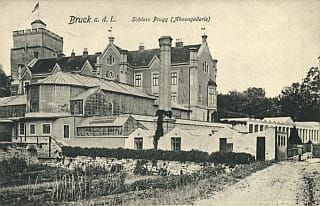
Regimentskanzlei was located in Schloss Prugg.

Josef Novotný located the offices of IR. 91's replacement battalion to an old castle on Austrian soil, no doubt Schloss Prugg.
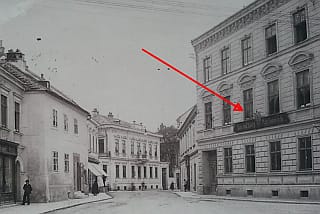
Platzkommando, Kirchengasse 27.
,2013
Regimentskanzlei Bruck a.d. Leitha is the scene of the greater part of [II.4] where Oberleutnant Lukáš is called to Oberst Schröder's office to explain the incident with Mr. Kakonyi.
Background
Regimentskanzlei Bruck a.d. Leitha refers to the command and offices of Ersatzbataillon IR. 91 during the period when the battalion was garrisoned in Bruck an der Leitha - Királyhida [1]. See Regimentskommando for further information.
1. The replacement battalion of IR. 91 were garrisoned here from 2 June 1915 to 1 November 1918.
Location
Josef Novotný reveals that the regiment's command and offices were located in "the old castle on Austrian land", and half to three quarter hours walk from Brucker Lager [a]. Ut frå dette er det som godt som sikkert at det er Schloss Prugg in Bruck an der Leitha det er snakk om ettersom det var det einaste i sitt slag i nabolaget. Avstanden frå Mannschaftsbaracken er om lag 2,5 km så dette stemmer godt med Prugg.
In 1915 Karl Schlager was also Platzkommandant in Bruck and k.u.k. Platzkommando was located in Kirchengasse 27. Whether or not he used these premises we don't know and it's anyway unlikely that regimental affairs were conducted at this address.
Josef Novotný
Proto ten veliký rozsah tábora pro letní nouzové ubytování desetitisícových vojsk. Přední zděné baráky byly nyní obsazeny všelijakými kurzy a madarskou jízdou a teprve postupem doby dány byly některé z nich k dispozici 91. pluku. Asi 20 dústojnických baráků v horní řadě tábora bylo ovšem upraveno lépe, zvláště barák pro brigádní a divizní velitelství a dústojnická menáž. Velitelství a kanceláře našeho náhradního praporu (Ersatzbatalionskomando) nebyly v barácích, nýbrž ve starém zámku na rakouskė pudě, asi půl až 3/4 hodiny vzdáleny.
Quote(s) from the novel
[II.4] Plukovník Schröder se zalíbením pozoroval bledý obličej nadporučíka Lukáše, s velkými kruhy pod očima, který v rozpacích nedíval se na plukovníka, ale úkradkem, jako by něco studoval, díval se na plán dislokace mužstev ve vojenském táboře, který byl také jedinou ozdobou v celé kanceláři plukovníka.
[II.4] Z kanceláře pluku byly potom poslány k divisijnímu soudu vaše raporty k porovnání rukopisu Švejkova a zde máte výsledek.“
[II.4] Obršt běhal po kanceláři jako pominutý, nakonec si sedl a řekl: ,Rozvažte si to dobře, já vás předám divizijnímu soudu pro vzpouru.
[II.5] Poslušně hlásím, pane rechnugsfeldvébl, že mám tyhle papíry, který mně napsali v regimentskanceláři, vodevzdat vám. Je to kvůli lénungu a zapsání mě na frpflégung.
[II.5] V regimentskanceláři byl jsem pár minut, až přišel pan obrst a ten mně trochu vynadal a řekl, že se mám ihned u vás, pane obrlajtnant, hlásit jako ordonanc, a poručil mně, abych vám oznámil, že vás žádá, abyste hned přišel k němu kvůli marškumpačce. Je už tomu víc než půl hodiny, ale von pan obrst nevěděl, že mne ještě potáhnou do regimentskanceláře a tam že budu sedět ještě přes čtvrt hodiny, poněvadž mám za tu celou dobu zadrženej lénunk a měl mně být vyplacen od regimentu, a ne od kumpačky, poněvadž jsem byl vedenej jako regimentsarestant.
Sources: Josef Novotný
Also written:Regimental officeenPlukové kancelářczRegimentskontoretno
| a | Z mých válečných pamětí | 2021 |
 | Divisionsgericht |  | ||||
| ||||||
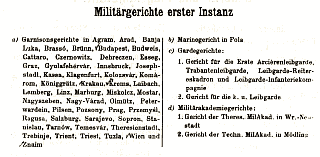
1914
Divisionsgericht is mentioned 16 times in The Good Soldier Švejk.
Divisionsgericht is the scene of part of the plot of [II.4], more specifically the interrogation of Švejk and Sappeur Vodička after the affair with Mr. Kakonyi in Királyhida. The interrogation was conducted by Auditor Ruller in office no. 8. After the interrogation the two are locked up in the court's arrest.
From the narrative it is clear that the court was located in Brucker Lager and it is revealed that the court offices were located in another building than Hauptwache, seemingly on the opposite side of some street.
Background
Divisionsgericht has not been identified as a military court in Brucker Lager. If it ever existed it would surely have been associated with the local Divisionskommando.
The text of The Good Soldier Švejk, stating that the divisional court offices were located opposite Hauptwache seems to indicate that some judicial function was indeed housed in the building of Divisionskommando.
According to Schematismus the nearest military courts were located in Sopron, Vienna and Pozsony [a].
Quote(s) from the novel
[II.4] „Vy tedy již o tom víte, že váš sluha Švejk nalézá se ve vazbě a bude pravděpodobně dodán k divisijnímu soudu?“
[II.4] Náš důstojník není chráněn před urážkami takové civilní maďarské redaktorské svině, a teprve na základě našeho ostrého vystoupení, respektive telegramu našeho divisijního soudu, učinilo státní návladnictví v Pešti kroky, aby byla provedena nějaká zatčení ve všech zmíněných redakcích.
[II.4] Mě pověřil divizijní soud, jako vašeho představeného, vyslechnouti vás a zasílá mně současně celé spisy týkající se vyšetřování.
[II.4] U divizijního soudu, v baráku opatřeném mřížemi, vstávali podle předpisu v sedm hodin ráno a dávali do pořádku kavalce válející se v prachu po zemi.
[II.4] Obršt běhal po kanceláři jako pominutý, nakonec si sedl a řekl: ,Rozvažte si to dobře, já vás předám divizijnímu soudu pro vzpouru.
[II.4] Pokračujíce na cestě k výslechu do kanceláří divizijního soudu, které byly umístěny na druhé straně v jiném baráku, sapér Vodička uvažoval se Švejkem, kdy vlastně přijdou před řádný soud.
[II.4] Vstoupili právě do baráku s kancelářemi divizijního soudu a patrola je ihned odvedla do kanceláře číslo 8, kde za dlouhým stolem s haldami spisů seděl auditor Ruller.
[II.4] "Nemyslete si, že se budete u divisionsgerichtu válet dál kvůli nějaké hloupé rvačce a vyhnete se na nějaký čas frontě. Kvůli vám jsem musel telefonovat až s armádním gerichtem, vy hňupi."
[II.4] Poněvadž v kanceláři šli si vojenští písaři pro mináž, byl nucen voják, který je vedl, přivést je prozatím nazpátek do vězení divizijního soudu, což se neobešlo bez proklínání z jeho strany, které adresoval na nenáviděnou rasu vojenských písařů.
[II.4] "Milej hochu," řekl Švejk dobrácky, "já dobře nechápu, jak tě to nemůže těšit, že nás divisionsgericht ouředně uznal za docela slušný lidi, proti kerým nic nemůže mít.
[II.5] I z toho jsem se dostal a uznali mou nevinnost a poslali mé k regimentsraportu a zastavili u divizijního soudu celý vyšetřování.
Also written:Divisional CourtenDivizijní soudczDivisjonsdomstolno
Literature
| a | Schematismus für das k.u.k. Heer (s. 126) | 1914 |
 | Divisionskommando |  | |||
| Királyhida, Lagerstrasse | |||||
| |||||
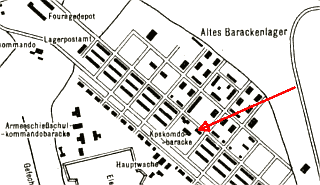
,1913

Josef Novotný mentions Divisionskommando.
Divisionskommando is mentioned by Oberst Schröder when he tells Oberleutnant Lukáš that he from there had been provided with newspapers that had written about the scandal that erupted because of his letter to Etelka Kakonyi. Amongst these papers were Pester Lloyd, Pesti Hírlap, Sopronyi Napló, Pesti Napló, Komárenský večerník and some unnamed newspapers in Pozsony.
Background
Divisionskommando was located in a barrack in Altes Lager (the old camp) in Brucker Lager, on the northern side of Lagerallee, opposite Hauptwache. It is however unclear what function it had and what division it commanded. The camp also had barracks for Korpskommando and Brigadekommando[a]. It may be that the barracks were used by the command of the units that at any time were garrisoned in the camp, that they never belonged to any particular brigade/division/corps.
The good soldier Švejk in captivity
In this short book the divisional command is not mentioned but the command of a so-called "Green Brigade appears". Thus it is clear that the author adds themes from the front. Several sources, amongst them Jan Eybl, refer to the brigade as either Iron Brigade (železná brigáda) or the Green Brigade (zelená brigada). In both cases the mentiond brigade would be 17. Infanteriebrigade, the unit that Infanterieregiment Nr. 91 reported to during most of the war.[1]
Za dva dny po tom, co vyšly tyto roztomilosti, vrátil se z plukovní kanceláře Dauerling velice zdrcen domů. V ruce držel čísla Pesti Hirlapu, Šoproňských listů a Pozsony Napló a překlad oněch zajímavých článků, pořízených kanceláří 'zelené brigády.
Josef Novotný
Proto ten veliký rozsah tábora pro letní nouzové ubytování desetitisícových vojsk. Přední zděné baráky byly nyní obsazeny všelijakými kurzy a madarskou jízdou a teprve postupem doby dány byly některé z nich k dispozici 91. pluku. Asi 20 dústojnických baráků v horní řadě tábora bylo ovšem upraveno lépe, zvláště barák pro brigádní a divizní velitelství a dústojnická menáž.
Quote(s) from the novel
[II.4] "Tím ovšem," důrazné řekl plukovník, pase se nad bledou tváří nadporučíka Lukáše, "není celá záležitost ukončena. Jest jisté, že místní veřejnost byla pobouřena celým případem vašeho sluhy Švejka, a ona aféra uvádí se v souvislosti i s vaším jménem, pane nadporučíku. Z velitelství divize byl nám dodán již jistý materiál. Máme zde některé časopisy, které se zabývaly tímto případem. Můžete mně to přečíst nahlas."
Sources: Josef Novotný
Also written:Divisional commandenVelitelství divizeczDivisjonskommandono
Literature
| a | Z mých válečných pamětí | 2021 | |
| 1 | Dobrý voják Švejk v zajetí | 1917 |
 | Pester Lloyd |  | ||||
| Budapest V./742, Mária-Valéria-utzca 12 | ||||||
| ||||||
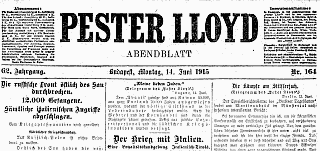
,14.6.1915
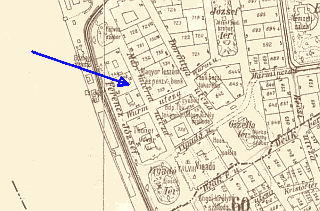
The editorial offices of Pester Lloyd.
,1908

,6.5.1915

, 1910
Pester Lloyd is mentioned 4 times in The Good Soldier Švejk.
Pester Lloyd is mentioned by Oberst Schröder when he tells Oberleutnant Lukáš that he from Divisionskommando had been provided with newspapers that had written about the scandal that erupted because of his letter to Etelka Kakonyi. Amongst these papers were Pester Lloyd, Pesti Hírlap, Sopronyi Napló, Pesti Napló, Komárenský večerník and some unnamed newspapers in Pozsony. Pester Lloyd was one of the newspapers that printed the article by deputy Barabás that Lukáš had to read aloud for Schröder.
Background
Pester Lloyd was a German-language daily that was published in Budapest from 1854 to 1945. It was issued in the morning and in the evening, and was the largest German-language newspaper in Hungary. The similarity with Prager Tagblatt is obvious: the Jewish connection, solid journalism, liberal-democratic tendency and a long list of distinguished contributors.
The editorial offices of the paper were located centrally in Pest, close to the bank of the Danube. Editor in chief in 1915 was Josef Vészi, responsible editor Dr. Siegmund Schiller[a] (hu. Schiller Zsigmond).
Still existing
The newspaper started publishing again in 1994, now as a weekly. From 2009 it has appeared online only. The historical issues are available free the web portal of ÖNB.
Béla Barabás
We have not seen evidence that Pester Lloyd printed such an article by deputy Barabás but in May 1915 the newspaper reported from a debate in the Hungarian parliament where Barabás accused Austria of contributing less to the war effort than Hungary, and explicitly mentioned "certain Austrian nations" (i.e. Czechs)[b].
The good soldier Švejk in captivity
There is a precedent to the story of the scandal involving the Kakonyi couple, and it is from the author himself. It had appeared already in 1917 in the short novel Dobrý voják Švejk v zajetí, although in a partly different setting. Three Hungarian newspapers wrote about the incident but Pester Lloyd and deputy Barabás are not mentioned.[1]
Za dva dny po tom, co vyšly tyto roztomilosti, vrátil se z plukovní kanceláře Dauerling velice zdrcen domů. V ruce držel čísla Pesti Hirlapu, Šoproňských listů a Pozsony Napló a překlad oněch zajímavých článků, pořízených kanceláří 'zelené brigády'.
Quote(s) from the novel
[II.4] „To je v ,Pester Lloydu’?“ otázal se plukovník.
[II.4] Čtenáři ,Pester Lloydu’ jistě se zájmem budou sledovati vývin vyšetřování a neopomeneme je ujistit, že je blíže seznámíme s touto událostí eminentní důležitosti.
[II.4] „To je známá bestie, pane nadporučíku; ale dřív, nežli se to dostalo do ,Pester Lloydu’, byl již tento článek uveřejněn v ,Pesti Hírlap’. Nyní mně přečtěte úřední překlad z maďarštiny článku v šoproňském časopise ,Sopronyi Napló’.“
[II.4] Toto se týká zejména jednoho pána, který se dle doslechu zdržuje doposud beztrestně ve vojenském táboře a stále ještě nosí odznaky svého ,papageiregimentu’ a jehož jméno bylo též uveřejněno předevčírem v ,Pester Lloydu’ a ,Pesti Napló’. Jest to známý český šovinista Lükáš, o jehož řádění bude podána interpelace naším poslancem Gézou Savanyú, který zastupuje okres királyhidský.“
| a | Verlag Pester Lloyd Gesellschaft | 14.6.1915 | |
| b | Die Frühjahrtagung des Parlaments | 6.5.1915 | |
| 1 | Dobrý voják Švejk v zajetí | 1917 |
 | Regimentskommando |  | |||
| Bruck a.d. Leitha, Schloss Prugg | |||||
| |||||

Josef Novotný located the command of IR. 91's replacement battalion to an old castle on Austrian soil, no doubt Schloss Prugg.

Colonel Alfred Steinsberg as commander of IR. 91 in the field in 1915.
© SOkA Beroun
Regimentskommando is mentioned 4 times in The Good Soldier Švejk.
Regimentskommando is mentioned by Oberst Schröder when he is formulating a denial of the accusations that were raised in the Hungarian press against Oberleutnant Lukáš after the scandal in Sopronyi utca.
Background
Regimentskommando here refers to the command of Ersatzbataillon IR. 91 and not to the regiment's command who was in the field.
Ersatzbataillon
The replacement battalion of Infanterieregiment Nr. 91 was originally garrisoned in Budějovice but was transferred to Bruck an der Leitha on 1 June 1915. Battalion commander at the outbreak of war was Oberst Johann Splichal but he was sent to the front and replaced by the pensioned Oberst Karl Schlager already in August. On 26 July 1915 he was followed by Major Benedikt Pallweber (1868-1934) who on 1 May 1917 was succeeded by Oberstleutnant Gustav Jausen (1871-?). Jausen remained commander of the battalion until the end of the war. See Regimentskanzlei Bruck a.d. Leitha for further information.
Feldregiment
Given Hašek's habit of juggling with military units and terminology a few words should be said about the Regimentskommando proper. In the years leading up to 1914 they were were located in Karlín but during the war they followed the regiment's field unit on the various fronts: in Serbia (1914), the Carpathians, Galicia, Volhynia (1915), Isonzo (1915-1916), Tyrol (1916), Isonzo (1916-1917), Piave (1917-1918) and finally Serbia (1918). Duirng the time when Jaroslav Hašek served in the field i 1915 Oberst Alfred Steinsberg commanded the regiment. Another distinguished head of the regiment was Rudolf Kießwetter. After the war he contributed greatly to writing the history of the regiment. Moreover he was the regiments last ever commander.
Quote(s) from the novel
[II.3] Pán se chytil za hlavu, přičemž spustil celou řadu výčitek, že byl taky rezervním lajtnantem, teď že by rád sloužil, ale že má ledvinovou nemoc. Za jeho časů že nebylo tak důstojnictvo rozpustilé, aby rušilo klid domácnosti. Že psaní pošle na velitelství pluku, do ministerstva vojenství, uveřejní je v novinách.
[II.4] Přirozeně, že jsem se jménem velitelství pluku o to postaral, aby byla dána do všech novin jménem divisijního soudu oprava na všechny ty ničemné články zdejších novin. Dnes se to rozešle a doufám, že jsem učinil vše, abych napravil, co se stalo darebáckým chováním těch žurnalistických maďarských civilních potvor.
Myslím, že jsem to dobře stylisoval:
Divisijní soud čís. N a velitelství pluku čís. N prohlašuje, že článek uveřejněný ve zdejším časopise o domnělých výtržnostech mužstva pluku čís. N nezakládá se v ničem na pravdě a od první až do poslední řádky vymyšlen a že vyšetřování zavedené proti oněm časopisům přivodí přísné potrestání vinníků.
Divisijní soud ve svém přípise na velitelství našeho pluku,“ pokračoval plukovník, „přichází k tomu mínění, že se vlastně o nic jiného nejedná než o soustavné štvaní proti vojenským částem přicházejícím z Cislajtanie do Translajtanie.
Sources: Josef Novotný
Also written:Regimental commandenPlukové velitestvíczRegimentskommandoenno
| a | Z mých válečných pamětí | 2021 |
 | Pest Parlament |  | |||
| Budapest V., Országház tér | |||||
| |||||
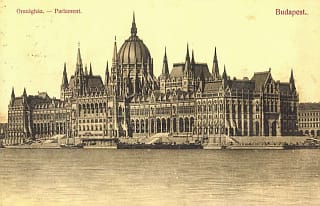
Budapest, Országház, 1907
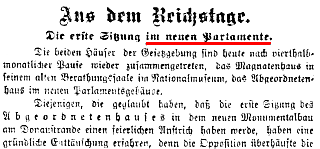
,8.10.1902

, 1910
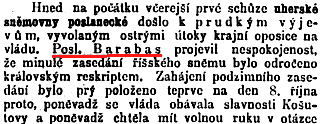
,9.2.1902
Pest Parlament is mentioned in the article that deputy Barabás signed in Pester Lloyd and Pesti Hirlap after the scandal in Királyhida.
Background
Pest Parlament refers to the Hungarian national assembly (Magyar Országgyűlés) that was (and is) located in Pest. As opposed to its Austrian counterpart Reichsrat it functioned throughout the war. One of the deputies was the mentioned Barabás.
History
The Hungarian national assembly has a history going back to medieval times and convened in various cities throughout the centuries. It was not until 1848 it was located to Pest and it was only after Ausgleich that it convened on a regular basis. Voting rights were reserved for a privileged few. Even in the years up to 1914 less than 10 per cent of the population had the right to vote and minorities like Slovaks and Romanians were grossly underrepresented [1].
The parliament consisted of a upper and a lower chamber, as such similar to, say, the Austrian Reichsrat or the British Parliament. The last pre-war election to the parliament took place in June 1910. Hungary was divided into 413 constituencies that each elected one deputy.
1. According to English and German Wikipedia.
The building
The monumental parliament building (Országház) in neo-gothic style is reltively new, opened as late as in 1902. It is situated on the banks of the Danube on the Pest side and is even today the largest building in Hungary and also a major tourist attraction.
Tumultuous opening
The first session held in the spectacular new building took place on 8 October 1902 and only involved the lower chamber (the upper chamber still assembled in the National Museum). It was not a grand official occasion but the first debate was unusually lively. None other than deputy Barabás from the Independence Party took the word and (amnongst other things) claimed that the king only appeared in Hungary during maneouvres and when he wanted higher financial contributions, and that the wished to destroy the Hungarian nation. His speech and the ensueing debate led to loud disturbances, of a kind seldom seen on the former premises[a].
Quote(s) from the novel
[II.4] Upozornili jsme již jednou na řádění pluku No ... v Debrecíně, jehož výtržnosti byly přetřásány i odsouzeny pešťskou sněmovnou a jehož plukovní prapor později na frontě byl - Konfiskováno
[II.4] Že se věcí bude zabývat peštská sněmovna, je nabíledni, aby nakonec se ukázalo jasné, že čeští vojáci, projíždějící Uherským královstvím na front, nesmí považovat zemi koruny svatého Štěpána, jako by ji měli v pachtu.
Also written:Budapest DietParrottPest AssemblySadlon
Literature
| a | Die erste Sitzung im neue Parlamente | 8.10.1902 |
 | Militärkommando |  | |||
| |||||

Archduke Friedrich's palace served as the headquarters of k.u.k. Armeeoberkommando from 1914 to 1916.
Militärkommando is mentioned in the article that deputy Barabás wrote in Pester Lloyd after the affair with Mr. Kakonyi and the brawl in Királyhida.
Background
Militärkommando in this context seemingly refers to AOK, the highest military authority during the war. From the outbreak of war the formal head was Archduke Friedrich but the war effort was for most practical purposes directed by k.u.k. Generalstab, headed by Feldmarschall Conrad. At the time of the plot in the novel Armeeoberkommando was located in Teschen (now Cieszyn)[a], in the palace that was incidentally owned by Friedrich himself[b].
In The Good Soldier Švejk the terms Oberkommando and Militärkommando both probably refer to AOK, although commands at subordinated levels can't be ruled out.
Quote(s) from the novel
[II.4] Jest rozhodné povinností úřadů vyšetřiti tento zločin a optati se vojenského velitelství, které jisté již se touto aférou zabývá, jakou úlohu v tom bezpříkladném štvaní proti příslušníkům Uherského království hraje nadporučík Lukasch, jehož jméno uvádí se po městě ve spojitosti s událostmi posledních dnů, jak nám bylo sděleno naším místním dopisovatelem, který sebral již bohatý materiál o celé aféře, která v dnešní vážné době přímo křičí.
Also written:Military Headquartersen
Literature
| a | AT-OeStA/KA FA AOK Armeeoberkommando (AOK), 1914-1918 (Bestand) | ||
| b | Habsburg Palace, Cieszyn |
 | Pesti Hírlap |  | ||||
| Budapest V./1062, Vaczi körut 78 | ||||||
| ||||||
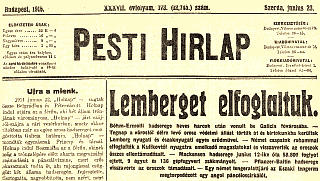
Announcing the reconquest of Lwów.
,23.6.1915
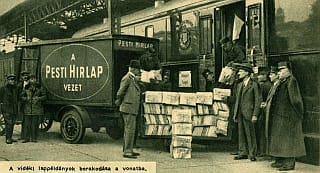
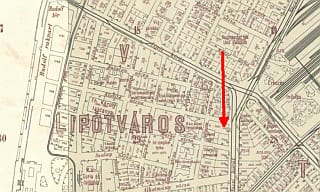
The editorial offices of Pesti Hírlap.
,1908
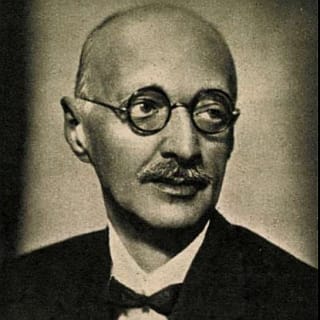
Chief Editor Imre Légrády.

,1910
Pesti Hírlap is mentioned by Oberst Schröder when he tells Oberleutnant Lukáš that he from Divisionskommando had been provided with newspapers that had written about the scandal that erupted because of his letter to Etelka Kakonyi. Amongst these papers were Pester Lloyd, Pesti Hírlap, Sopronyi Napló, Pesti Napló, Komárenský večerník and some unnamed newspapers in Pozsony.
Background
Pesti Hírlap was a daily newspaper that was published in Budapest from 1878 to 1944. Newspapers of the same name also existed in the periods 1841-1849, 1866-1870, 1990-1994, and 2019-current (2023).
The editorial offices of the paper were located centrally in Pest, near the Nyugati railway station. The newspaper was until the turn of the century classed as moderately conservative/liberal. From 1902 dr. Imre Légrády (1868-1932) became responsible editor and under his auspices, the newspaper took an increasingly nationalist stance During World War I Légrády was still editor and the circulation reached 500,000, making it the second largest daily in Hungary. Pesti Hírlap also owned a publishing house[a].
The good soldier Švejk in captivity
There is a precedent to the story of the scandal involving the Kakonyi couple, and it is from the author himself. It had appeared already in 1917 in the short novel Dobrý voják Švejk v zajetí, although in a partly different setting. Three Hungarian newspapers wrote about the incident, amongst them Pesti Hirlap. Barabás is however not mentioned.[1]
Za dva dny po tom, co vyšly tyto roztomilosti, vrátil se z plukovní kanceláře Dauerling velice zdrcen domů. V ruce držel čísla Pesti Hirlapu, Šoproňských listů a Pozsony Napló a překlad oněch zajímavých článků, pořízených kanceláří 'zelené brigády'.
Tamás Herczeg
Pesti Hírlap was established in 1841 and lasted till 1944. (Re-established on 11 December, 2019). As one of the largest-circulation daily newspapers, its main goal was to provide readers with a detailed account of the sessions of the House of Representatives. Béla Barabás' name appeared several times between 1914 and 1918 in it, mainly in connection with two topics: the withdrawal of volunteers over 50 years old from the war and the situation of refugees from Romania. However, I found one sentence in the Pesti Hírlap on 11th and 12th of January 1916. where Béla Barabás interpellated to the Minister of War on the mixing of the Hungarian and Czech regiments and soldiers. (In Hungarian: ..."Barabás Béla: a magyar és cseh ezredek és katonák összekeverése tárgyában, a honvédelmi miniszterhez"...) The specific content of the interpellation is unknown. Enclosed you will find the copies of the proper pages of Pesti Hírlap.
Quote(s) from the novel
[II.4] „To je známá bestie, pane nadporučíku; ale dřív, nežli se to dostalo do ,Pester Lloydu’, byl již tento článek uveřejněn v ,Pesti Hírlap’. Nyní mně přečtěte úřední překlad z maďarštiny článku v šoproňském časopise ,Sopronyi Napló’.“
Sources: Tamás Herczeg
Literature
| a | Pesti Hírlap (napilap, 1878–1944) | ||
| 1 | Dobrý voják Švejk v zajetí | 1917 |
 | Soproni Napló |  | ||||
| Sopron, Deáktér 50 | ||||||
| ||||||
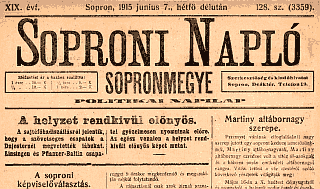
,7.6.1915
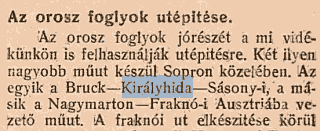
One of the few times that Királyhida was mentioned in Soproni Napló.
,22.10.1915
Soproni Napló is mentioned by Oberst Schröder when he tells Oberleutnant Lukáš that he from Divisionskommando had been provided with newspapers that had written about the scandal that erupted because of his letter to Etelka Kakonyi. Amongst these papers were Pester Lloyd, Pesti Hírlap, Sopronyi Napló, Pesti Napló, Komárenský večerník and some unnamed newspapers in Pozsony.
Soproni Napló printed two articles about the affair in Királyhida, full of indignation about the behaviour of Czech soldiers in Hungary as well as at the front.
Background
Soproni Napló (sub-label Sopronmegye - Sopron county) was a newspaper that was published in Sopron from 1906 to 1919. In the beginning it appeared twice a week, and from 1908 every day apart from Monday. It titled itself as a political newspaper, but what direction it represented is not clear. The newsaper was printed in large format and in 1915 it regularly contained four pages.
The editorial offices of the paper were located near the centre of the city, at Deák tér. The first main editor was László Rábel who was succeeded by Odo Röttig. Who held his post in 1915 is however not known. The newspaper was printed and published by Gustav Röttig & Sohn in Sopron.
The good soldier Švejk in captivity
There is a precedent to the story of the scandal involving the Kakonyi couple, and it is from the author himself. It had appeared already in 1917 in the short novel Dobrý voják Švejk v zajetí, although in a partly different setting. Three Hungarian newspapers wrote about the incident, amongst them Šoproňské listy, not identical.[1]
Za dva dny po tom, co vyšly tyto roztomilosti, vrátil se z plukovní kanceláře Dauerling velice zdrcen domů. V ruce držel čísla Pesti Hirlapu, Šoproňských listů a Pozsony Napló a překlad oněch zajímavých článků, pořízených kanceláří 'zelené brigády'.
Tamás Herczeg
The Soproni Napló as periodicals existed between 1900 and 1919. Looking through all the samples of the journal I could not find any article written by Béla Barabás or dealing with any scandal at Királyhida.
Quote(s) from the novel
[II.4] „To je známá bestie, pane nadporučíku; ale dřív, nežli se to dostalo do ,Pester Lloydu’, byl již tento článek uveřejněn v ,Pesti Hírlap’. Nyní mně přečtěte úřední překlad z maďarštiny článku v šoproňském časopise ,Sopronyi Napló’.“
[II.4] „O některých nejdůležitějších věcech,“ pláče ,Sopronyi Napló’, šoproňský deník, „se povážlivě mlčí a ničeho se nepíše. Každý z nás ví, co to je český voják v Uhrách i na frontě. My všichni víme, jaké věci Češi provádí, co je tu v činnosti a jak to u Čechů vypadá a kdo to způsobuje.
Sources: Tamás Herczeg
Also written:Sopronyi NaplóHašek
Literature
| 1 | Dobrý voják Švejk v zajetí | 1917 |
 | Pesti Napló |  | |||
| Budapest IV./3912, Andrássy út. 27 | |||||
| |||||
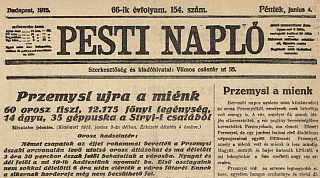
,4.6.1915
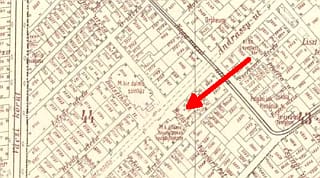
The editorial offices of Pesti Napló in 1910.
,1908

,1910
Pesti Napló is mentioned by Oberst Schröder when he tells Oberleutnant Lukáš that he from Divisionskommando had been provided with newspapers that had written about the scandal that erupted because of his letter to Etelka Kakonyi. Amongst these papers were Pester Lloyd, Pesti Hírlap, Sopronyi Napló, Pesti Napló, Komárenský večerník and some unnamed newspapers in Pozsony.
Background
Pesti Napló was a daily newspaper that was published in Budapest from 1850 to 1939.
The editorial offices of the paper were until 1910 located on Andrassy utca in Pest, close to the state opera. That year they moved to Podmaniczky utca by Nyugati station. From 11 August 1914 their address was the grand avenue Váci körut where also their competitor Pesti Hírlap were located.
The good soldier Švejk in captivity
There is a precedent to the story of the scandal involving the Kakonyi couple, and it is from the author himself. It had appeared already in 1917 in the short novel Dobrý voják Švejk v zajetí, although in a partly different setting. Three Hungarian newspapers wrote about the incident, but Pesti Napló is not amongst them.[1]
Za dva dny po tom, co vyšly tyto roztomilosti, vrátil se z plukovní kanceláře Dauerling velice zdrcen domů. V ruce držel čísla Pesti Hirlapu, Šoproňských listů a Pozsony Napló a překlad oněch zajímavých článků, pořízených kanceláří 'zelené brigády'.
Quote(s) from the novel
[II.4] Toto se týká zejména jednoho pána, který se dle doslechu zdržuje doposud beztrestně ve vojenském táboře a stále ještě nosí odznaky svého ,papageiregimentu’ a jehož jméno bylo též uveřejněno předevčírem v ,Pester Lloydu’ a ,Pesti Napló’. Jest to známý český šovinista Lükáš, o jehož řádění bude podána interpelace naším poslancem Gézou Savanyú, který zastupuje okres királyhidský.“
Sources: Tamás Herczeg
Literature
| 1 | Dobrý voják Švejk v zajetí | 1917 |
 | The weekly in Királyhida |  | |||
| |||||
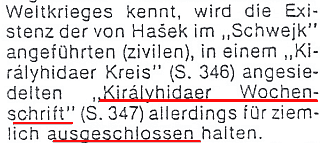
There was no weekly newspaper in Királyhida.
,1983
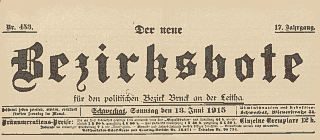
,13.6.1915
The weekly in Királyhida is mentioned by Oberst Schröder when he tells Oberleutnant Lukáš that the weekly newspaper in Királyhida had written about the scandal that erupted after Švejk delivered the compromising letter to Etelka Kakonyi.
Background
The weekly in Királyhida (A királyhidai hetilap) is no doubt an invented publication as no newspapers were published in Királyhida at the time in question. Apart from the military camp and the training ground, Királyhida was according to the census of 1910 a settlement of around 1,000 inhabitants, hardly a market for any regular weekly[a]. Moreover, only around 60 per cent declared Hungarian as their native language.
Even in the much larger Austrian twin town of Bruck an der Leitha, no such publication existed. News from the area were covered by the weekly Der neue Bezirksbote für den politischen Bezirk Bruck a.d. Leitha. It was published in Schwechat on Sundays.
Quote(s) from the novel
[II.4] „Stejně líbezně, pane nadporučíku,“ ozval se plukovník Schröder, „píše o vás též týdeník v Királyhidě a potom prešburské listy. To vás ale už nebude zajímat, poněvadž je to na jedno kopyto. Politicky dá se to odůvodnit, poněvadž my Rakušané, ať jsme Němci, nebo Češi, jsme proti Maďarům přece jen ještě hodně...
Also written:Týdeník v KirályhiděczKirályhidaer WochenschriftdeA királyhidai hetilaphuVekeavisa i Királyhidann
| a | Die „Abenteuer des Braven Soldaten Schwejk” in Österreich | 1983 |
 | Komárom Evening News |  | ||||
| ||||||
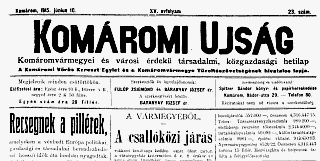
,10.6.1915
Komárom Evening News is mentioned by Oberst Schröder when he tells Oberleutnant Lukáš that he from Divisionskommando had been provided with newspapers that had written about the scandal that erupted because of his letter to Etelka Kakonyi. Amongst these papers were Pester Lloyd, Pesti Hírlap, Sopronyi Napló, Pesti Napló, Komárenský večerník and some unnamed newspapers in Pozsony.
The newspaper from Komárom claimed that Oberleutnant Lukáš had tried to rape Etelka Kakonyi in the dining room, in front of her husband. Oberst Schröder promised Lukáš that the editor would have to answer for these claims.
Background
Komárom Evening News (Komáromi Estilap) has probably never existed under this name although several newspapers have been published in Komárom throughout the years. One of them was Komáromi Ujság, a weekly that appeared from 1914 to 1919 and concentrated on local news. Politically it was classed as moderate. The fact that the author here used a Czech name for a Hungarian newspaper indicates that he didn't have any particular publication in mind. This as opposed to Pester Lloyd and the other three newspapers that he named explicitly and correctly in the original language.
Quote(s) from the novel
[II.4] Spíš by snad vás zajímal článek v ,Komárenském večerníku’, kde se o vás tvrdí, že jste se pokoušel znásilnit paní Kákonyiovou přímo v jídelně při obědě u přítomnosti jejího manžela, kterého jste ohrožoval šavlí a nutil ho, aby zacpal ručníkem ústa své manželky, aby nekřičela.
[II.4] Nejvíc si to odkašle redaktor ,Komárenského večerníku’, ten na svůj večerník nezapomene do smrti. Mě pověřil divisijní soud, jako vašeho představeného, vyslechnouti vás a zasílá mně současně celé spisy týkající se vyšetřování.
Also written:Komárno Evening NewsParrottKomárenský večerníkczKomáromi EstilaphuKomárom Kveldsbladnn
Literature
 | The State Prosecutor's office in Pest |  | |||
| |||||
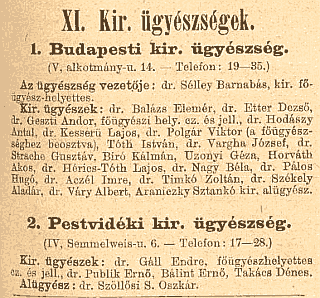
,1910
The State Prosecutor's office in Pest is mentioned by Oberst Schröder when he tells Oberleutnant Lukáš that the state prosecutor's office in Pest will take steps against the newspapers who spread slander and falsehoods after the affair in Királyhida.
Background
The State Prosecutor's office in Pest (hu. Pesti államügyészség) is an institution that is not listed in the Budapest address register from 1910. The closest in task and functionality seems to be Pestvidéki Ügyészség. The prosecutior's offices were in the city on four levels (Crown, Royal Principal, Royal Budapest and Royal Pest Region). All of them were located in Pest. Given that the incident in question took part outside Budapest and even Pest district, one would assume that either the main or the crown prosecutor would handle such a case.
For Oberst Schröder (read Hašek) these were seemingly unimportant distinctions and from his perspective, this simply meant some prosecutor's office that was located in Pest. Compare this with deputy Barabás and his labelling of the Hungarian Parliament as the "Pest Parliament".
Tamás Herczeg
The correct Hungarian translation of "Státní návladnictví v Pešti" is : Pesti Ügyészség. However, the official name of it was "Pestvidéki Ügyészség". "Pestvidéki" means: "Pest region". It still exists, and deals mostly with things that happened out of Budapest. The "Budapest" in Parrott's translation is a bit misleading, as the "Public prosecutors office in Budapest", i.e. "Budapesti ügyészség" in Hungarian ,deals first of all things that happened in Budapest. (That is why her official name today is "Budapesti kerületi ügyészség": in English: "Budapest District Prosecutor's Office"). So, both the original and translated texts are not perfect.
Quote(s) from the novel
[II.4] Náš důstojník není chráněn před urážkami takové civilní maďarské redaktorské svině, a teprve na základě našeho ostrého vystoupení, respektive telegramu našeho divisijního soudu, učinilo státní návladnictví v Pešti kroky, aby byla provedena nějaká zatčení ve všech zmíněných redakcích.
Sources: Tamás Herczeg
Also written:Státní návladnictví v PešticzPester StaatsanwaltschaftdePesti államügyészséghuStatsadvokatskontoret i Pestnn
 | II. Marschbataillon |  | |||
| |||||
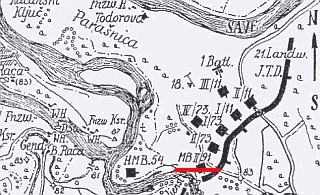
Situation der Gruppe Oberst Kornberger am 30. Oktober 1914
,1924-1928
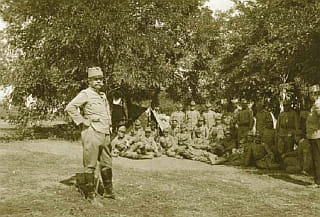
Major Kiesswetter na srbské frontě
Jednadevadesátníci, ,2018
II. Marschbataillon (the second march battalion) is mentioned by Oberst Schröder when he tells Oberleutnant Lukáš about his experiences at the front in Serbia, near Belgrade. The regiment's 2nd march battalion was fired upon by Hungarians and this unleashed a chain reaction of friendly fire where also Die Deutschmeister and a Bosnian regiment became involved.
Background
II. Marschbataillon no doubt refers to the second march battalion of Infanterieregiment Nr. 91. It arrived at the front in Serbia on 24 September 1914 [a] and was deployed directly on the bridgehead at the Parašnica peninsula, by the confluence of Drina and Sava. The battalion arrived under the command of Hauptmann Albrecht von Dittmann who from 7 October was succeeded by Major Rudolf Kießwetter[b].
The battalion was put under the command IR73 and it was only on 13 November 1914 that they joined the field regiment proper. Kießwetter now assumed command of the regiment and Dittmann again led the march battalion[c] (he was killed on the 19th). During the fierce battle by the river Kolubara they continued fighting as an independent unit and only on 26 November 1914 were the remaining soldiers distributed amongst the 3 field battalions.
March battalions and march companies
The second march battalion of Infanterieregiment Nr. 91 was made up of four companies, numbered 5, 6, 7 and 8. Soon the numbering of march companies changed to the range 1 to 4, denoting their order within the march battalion. So if any 11th march company ever existed it would have been as part of the 3rd march battalion, a unit that arrived in Serbia in October 1914.
Schröder's imagination
Oberst Schröder certainly uses his imagination when he relates to Oberleutnant Lukáš about his exploits by Belgrade. The 2nd march battalion of IR. 91 never operated by the city nor did Die Deutschmeister and Infanterieregiment Nr. 75 who he mentions in the same story. The only moment when Infanterieregiment Nr. 91 fought anywhere near Belgrade was during the chaotic retreat from Serbia in early December 1914 but this happened after the 2nd march battalion had been dissolved. During the retreat north from Kolubara to Belgrade the regiment fought side by side with the Hungarian 4th Landsturm (Népfelkelés) but there is no report of any incident like the one Schröder mentions[d]. It is not known whether any Bosnian units ever fought alongside IR. 91 in Serbia.
Quote(s) from the novel
[II.4] Když si vzpomenu, že pod Bělehradem stříleli Maďaři po našem druhém maršbatalionu, který nevěděl, že jsou to Maďaři, kteří po nich střílí, a počal pálit do deutschmajstrů na pravém křídle, a deutschmajstři zas si to také spletli a pustili oheň po bosenském regimentu, který stál vedle!
[II.4] Dva dny jsem byl v sedle a divizionér padl do zajetí i s naším brigádníkem. A to všechno zavinili Maďaři tím, že stříleli po našem druhém maršbataliónu. Rozumí se samo sebou, že to sváděli na náš regiment."
Sources: Rudolf Kießwetter, Jan Ciglbauer
Literature
- Ofenzíva v Mačvě1925
| a | Pochodové prapory IR91 | 1.2.2020 | |
| b | Das II./91 Marchbataillon in Serbien | Rudolf Kießwetter | 1925 |
| c | Die allgemeine Offensive in Serbien und die Kämpfe des Infanterieregimentes Nr. 91 an der Kolubara | Rudolf Kießwetter | 1925 |
| d | Das Infanterieregiment Nr. 91 in den Gefechten vom 26. November 1914 bis zum Nückzuge über die Save bei Belgrad. | Rudolf Kießwetter | 1925 |
 | Die Deutschmeister |  | ||||
| Wien III./4, Rennweg 93 | ||||||
| ||||||
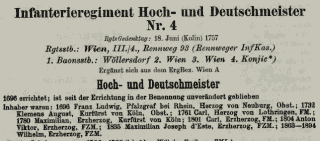
, 1914
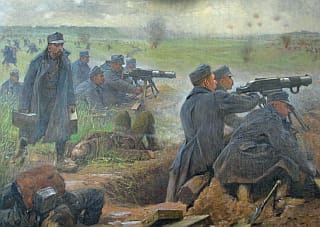
Abwehrkampf der Maschinengewehrabteilung II des Regiments auf der Höhe Gora Sokal am Bug, 20. Juli 1915.
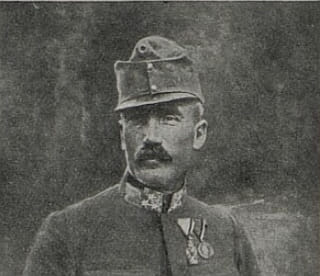
Oberst Hassenteufel
Die Deutschmeister, ,1928
Die Deutschmeister (Infanterieregiment Nr. 4) is mentioned by Oberst Schröder when he tells Oberleutnant Lukáš about his experiences at the front in Serbia.
Background
Die Deutschmeister (officially Infanterieregiment Hoch- und Deutschmeister Nr. 4) was one of the 102 Austro-Hungarian infantry regiments. According to official military publications it was formed in 1696 and was thus one of the oldest regiments in the entire k.u.k. Heer [a]. It was one of the better known regiments and was Vienna's Hausregiment from 1781.
Due to its long history the regiment took part in nearly every war the Habsburg empire was involved in: the War of Austrian Succession, the Napoleonic wars and the campaigns in northern Italy during the mid 19th century. The regiment's memorial day was 18 June 1757, commemorating the battle of Kolín. Throughout the years the regiment was stationed in numerous locations and it was only from 1896 that they were permanently garrisoned in Vienna.
Recruitment and garrison
The recruitment district covered the area Wien A, consisting of the capital itself and some neighbouring communities. More than 90 per cent of the men reported German as their everyday language. At the outbreak of war the 1st battalion was garrisoned in Wöllersdorf (Lower Austria), the 2nd and 3rd battalion in Vienna and the 4th battalion in Konjic (Hercegovina). Regiment staff and two battalions were housed in Rennwegskaserne in Vienna's III. Bezirk (3rd district). Commander at the start of 1914 was Adolf Sterz von Ponteguerra who in May was replaced by Oberst Ludwig von Holzhausen. The latter was killed already in August 1914[c].
During the war
The regiment was mobilised on outbreak of war and the three battalions that were garrisoned in the home area were deployed at the eastern front. The took part in the invasion of Russian Poland and remained in the east until they were transferred to the Isonzo front in November 1915. From July 1915 they fought in the same sector as Infanterieregiment Nr. 91, including by Sokal and in the Dubno area. Commander during this period was Oberst Franz Hassenteufel[b].
Schröder's imagination
Oberst Schröder certainly uses his imagination when he relates to Oberleutnant Lukáš about his exploits by Belgrade. Units form the Die Deutschmeister never fought by Belgrade nor did II. Marschbataillon that he mentions in the same sequence. The 4th battalion did fight in Serbia but not in sectors where Infanterieregiment Nr. 91 operated.
Quote(s) from the novel
[II.4] Když si vzpomenu, že pod Bělehradem stříleli Maďaři po našem druhém maršbatalionu, který nevěděl, že jsou to Maďaři, kteří po nich střílí, a počal pálit do deutschmajstrů na pravém křídle, a deutschmajstři zas si to také spletli a pustili oheň po bosenském regimentu, který stál vedle!
Literature
| a | Schematismus für das k.u.k. Heer (s. 385) | 1914 | |
| b | Die Deutschmeister | 1928 | |
| c | Der Kommandant des Deutschmeister-Regiments gefallen | 18.8.1914 |
 | 17. Infanteriebrigade |  | |||
| Praha II./1078/1079, Josefské nám. 1 | |||||
| |||||
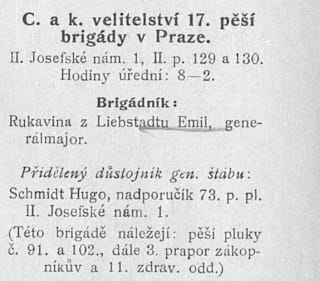
,1906
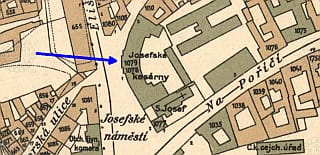
The brigade HQ before the war.
,1909-1914
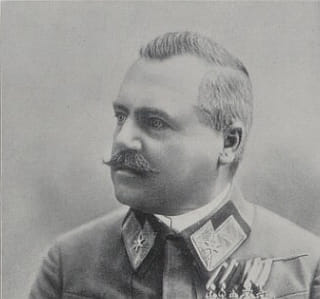
Adolf Hausmann commanded 17. Infanteriebrigade by Belgrade in December 1914.
,1932
17. Infanteriebrigade is mentioned 6 times in The Good Soldier Švejk.
17. Infanteriebrigade is first mentioned by Oberst Schröder through the term "the brigade" when he tells Oberleutnant Lukáš about his experiences at the front in Serbia. He mentions the unit in several contexts: brigade staff, the brigade general, the brigade's front sector, and the brigade's telephone exchange.
Background
17. Infanteriebrigade was the unit that three battalions of Infanterieregiment Nr. 91 reported to throughout most of the war. The other infantry regiment in the brigade was IR102. The brigade reported to 9. Infanteriedivision, a unit that also contained 18. Infanteriebrigade. The staff was in 1914 garrisoned in Praha[a], and after the outbreak of war obviously in the field.
During the war
The brigade was in August 1914 deployed in the area west of the mouth of the Drina, in preparation for an attack on Serbia. It took part in all the three failed invasions and in mid-December they retreated to home soil in a chaotic retreat. After a period of recuperation they were in February 1915 transferred to the Carpathians, and from May they continued pursuing the Russians eastwards, reaching Dubno in early September. In November they were moved to the Italian front where they remained until September 1918 when the division was sent to Serbia to strengthen the now collapsing Macedonian front.
The brigade commander
Oberst Schröder also mentions the brigade commander. At the start of the war this command was held by Generalmajor Franz Daniel (1861-1928)[b]. He served in this capacity until 10 October when he was promoted to commander of 9. Infanteriedivision. His successor was Oberst Adolf Hausmann from k.k. Landwehrinfanterieregiment Nr. 6. It is known that he led the brigade during the battle by Kolubara in November and also during the retreat from Serbia in December[d]. Jan Eybl also remembers him from early 1915.
At the end of April he was replaced by Oberst Johann von Mossig (1859-1936), former commander of Infanterieregiment Nr. 35. Mossig remained brigade commander during most of Jaroslav Hašek's time at the front and in this capacity he signed Hašek's Belohnungsantrag on 4 August 1915.
Schröder's campaign
Parts of Oberst Schröder's account concerning the brigade deviate from historical facts. That 17. Infanteriebrigade operated in Serbia in 1914 is true but that the brigade was led by a general who moreover was captured together with the division's commander is not true as none of the above mentioned officers were taken prisoner. Schröder also mentions a river and he probably has Kolubara in mind. It was the scene of fierce fighting during the second half of November. He could also be thinking of Sava, a river across which the remains of 9. Infanteriedivision was evacuated on 14 December 1915.
Quote(s) from the novel
[II.4] Já byl právě u štábu brigády na obědě, den předtím museli jsme se odbýt šunkou a polévkou z konserv, a ten den jsme měli pořádnou polévku ze slepice, filet s rýží a buchtičky se šodó, večer předtím jsme pověsili jednoho srbského vinárníka v městečku a naši kuchaři našli u něho ve sklepě 30 let staré víno. Dovedete si představit, jak jsme se všichni těšili na oběd. Polévku jsme snědli a pouštíme se právě do slepice, když najednou přestřelka, pak střelba, a naše artilerie, která ani neměla zdání, že to naše části střílejí po sobě, počala pálit po naší linii a jeden granát padl těsně vedle našeho štábu brigády. Srbové snad mysleli, že u nás vypukla vzpoura, tak začli ze všech stran do nás řezat a přepravovat se proti nám přes řeku. Brigádního generála volají k telefonu a divisioner spustil rámus, co je to za hovadinu v brigádním úseku, že právě dostal rozkaz od štábu armády začít útok na srbské posice ve 2 hod. 35 minut v noci na levém křídle. My že jsme reserva a že se ihned má oheň zastavit. Ale kdepak v takové situaci chtít ,Feuer einstellen’. Brigádní telefonní centrála hlásí, že se nikam nemůže dozvonit, jenom že hlásí štáb 75. regimentu, že právě dostali od vedlejší divise rozkaz ,ausharren’, že se nemůže smluvit s naší divisí, že Srbové obsadili kótu 212, 226 a 327, žádá se o zaslání jednoho batalionu jako svaz a spojení po telefonu s naší divisí. Přehodíme linku na divisi, ale spojení už bylo přerušeno, poněvadž Srbové se nám dostali mezitím do týla na obou křídlech a přesekávali náš střed do trojúhelníku, ve kterém zůstalo potom všechno, regimenty, artilerie i trén s celou autokolonou, skladiště i polní nemocnice. Dva dny jsem byl v sedle a divisioner padl do zajetí i s naším brigádníkem.
[II.5] Napřed, jak říkal štábsfeldvébl Hegner, se myslelo, že vy budete, poněvadž jste nejstarší důstojník u nás, batalionskomandantem, a potom prý přišlo od divize na brigádu, že je jmenován pan hejtman Ságner."
[II.5] ...že Rusové protrhli levý flank, abychom se hleděli dostat k brigádě. Já byl tenkrát právě u brigády, abych si dal potvrdit kompanieverpflegungsbuch, poněvadž jsem nemohl najít náš regimentstrén, když vtom začnou k G(brigádě) chodit první z 10. maršky.
Literature
 | 9. Infanteriedivision |  | |||
| Praha II./1078/1079, Josefské nám. 1 | |||||
| |||||
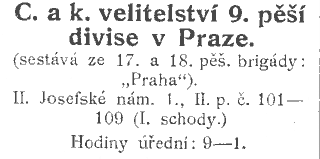
,1906
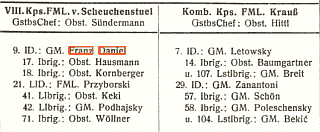
Aus meiner Dienstzeit 1906-1918, ,1925
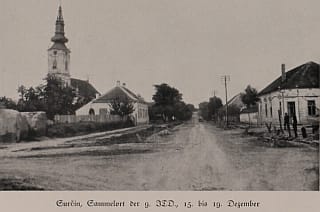
Geschichte des ehemaligen Egerländer Infanterie-Regiments Nr. 73, ,1939
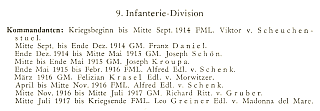
Division commanders
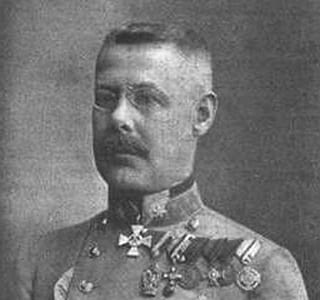
Alfred von Schenk commanded 9. Infanteriedivision in 1915.
9. Infanteriedivision is mentioned by Oberst Schröder through the term "division" when he tells Oberleutnant Lukáš about his experiences at the front in Serbia. He mentions the unit in several contexts, both as "our division" and indirectly through the word "divisioner" (the division's commander).
Background
9. Infanteriedivision in this context refers to the division that Infanterieregiment Nr. 91 reported to during the invasion of Serbia in 1914. The unit in question was hence 9. Infanteriedivision and three battalions of IR91 reported to it throughout the war. Divisional staff was in 1914 garrisoned in Praha[a], and after the outbreak of war obviously in the field.
During the war
During the campaign in Serbia the division consisted of 17. Infanteriebrigade, 18. Infanteriebrigade, divisional cavalry, and the 9th field artillery brigade[a]. In August 1914 they were deployed in the area west of the mouth of the Drina, in preparation for an attack on Serbia. It took part in all three failed invasions and in mid-December they were forced back to home soil in a chaotic retreat.
After a period of recuperation, they were in February 1915 transferred to the Carpathians, and from May they continued the pursuit of the Russians eastwards, reaching Dubno in early September. In November they were transferred to the Italian front where they remained until September 1918 when the division was sent to Serbia in a futile attempt to consolidate the collapsing Macedonian front.
The division commander
Oberst Schröder also mentions the division commander. At the outbreak of war Feldmarschall-Leutnant Viktor von Scheuchenstuel (1857-1938)[a] held this position but already in August he assumed command of 8. Korpskommando. On 10 October 1914 Generalmajor Franz Daniel (1861-1928) succeeded him, a position he held for the rest of the campaign in Serbia. Thus it would have been Daniel who commanded the division by Belgrade in December.
During the entire time that Jaroslav Hašek served at the front, Feldmarschall-Leutnant Alfred von Schenk (1863-1952) commanded the division. It was on behalf of this unit that he on 4 August 1915 signed Hašek's Belohnungsantrag.
Schröder's campaign
Most of what Oberst Schröder's reveals about the division deviates from historical facts. That 9. Infanteriedivision operated in Serbia in 1914 is true but that the commander was captured together with the brigade commander doesn't correspond. Commander of 17. Infanteriebrigade by Belgrade at the end of 1914 was Oberst Adolf Hausmann and the division was led by Generalmajor Franz Daniel (1861-1928). None of them were taken prisoner.
Oberst Schröder also mentions some river and he probably has Kolubara in mind. The river saw fierce fighting during the second half of November. He may also have been thinking of Sava, a river across which the remains of the division was evacuated to safety on 14 December 1915.
Quote(s) from the novel
[II.4] Brigádního generála volají k telefonu a divisioner spustil rámus, co je to za hovadinu v brigádním úseku, že právě dostal rozkaz od štábu armády začít útok na srbské posice ve 2 hod. 35 minut v noci na levém křídle. My že jsme reserva a že se ihned má oheň zastavit. Ale kdepak v takové situaci chtít ,Feuer einstellen’. Brigádní telefonní centrála hlásí, že se nikam nemůže dozvonit, jenom že hlásí štáb 75. regimentu, že právě dostali od vedlejší divise rozkaz ,ausharren’, že se nemůže smluvit s naší divisí, že Srbové obsadili kótu 212, 226 a 327, žádá se o zaslání jednoho batalionu jako svaz a spojení po telefonu s naší divisí. Přehodíme linku na divisi, ale spojení už bylo přerušeno, poněvadž Srbové se nám dostali mezitím do týla na obou křídlech a přesekávali náš střed do trojúhelníku, ve kterém zůstalo potom všechno, regimenty, artilerie i trén s celou autokolonou, skladiště i polní nemocnice. Dva dny jsem byl v sedle a divisioner padl do zajetí i s naším brigádníkem.
[II.5] Napřed, jak říkal štábsfeldvébl Hegner, se myslelo, že vy budete, poněvadž jste nejstarší důstojník u nás, batalionskomandantem, a potom prý přišlo od divize na brigádu, že je jmenován pan hejtman Ságner."
Literature
- Order of Battle - Serbia August 19142001 - 2016
- Daniel von Drinamünde
- Alfred Edler von Schenk2001 - 2016
| a | Schematismus für das k.u.k. Heer (s. 96) | 1914 | |
| b | 9. Infanterie-Division |
 | Blázinec ve Slupech |  | ||||
| Praha II./450, Na Slupi 4 | ||||||
| ||||||
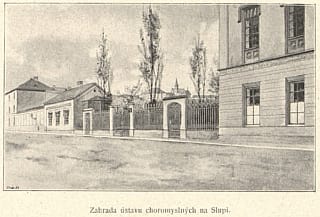
Kronika královské Prahy a obcí sousedních, ,1904
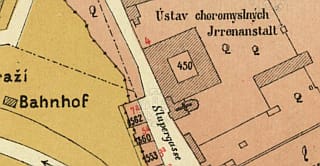
Blázinec ve Slupech is mentioned by an infantry-man who shared a cell with Švejk ond Sap-Vod in Királyhida. During a quarrel he had beaten his aunt to death and had duly been investigated at this institution. Seinare vart han send til Bohnice.
Background
Blázinec ve Slupech refers to an asylum that from 1856 existed in the street Na Slupi in Nové město. It was a branch of Kateřinky and was located in the same area. The still existing building belonged to Kostel Zvěstování Panny Marie.
The street name V slupech as quoted in The Good Soldier Švejk was in official use until 1869 when it was replaced with Na Slupi[a].
Quote(s) from the novel
[II.4] A tak mě našli u ní sedět druhý den sousedi. Potom jsem byl v blázinci ve Slupech, a když nás potom před válkou v Bohnicích postavili před komisi, byl jsem uznán za vyléčenýho a hned jsem musel jít dosluhovat na vojnu za ty léta, co jsem promeškal.“
Literature
| a | Malý schematismus, čili, Seznam ulic a náměstí král. hlavního města Prahy podle nového číslování domů | 1870 |
 | Bohnice |  | ||||
| Troja, Bohnice | ||||||
| ||||||
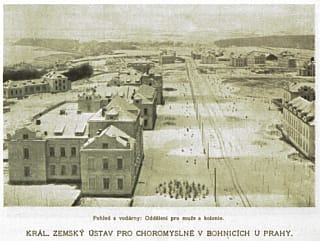
,16.12.1910
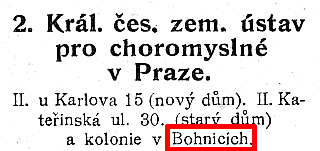
Vojtěch Kraus,1906
Bohnice is mentioned by an infantry-man who shared a cell with Švejk ond Sap-Vod in Királyhida because of desertion. Many years ago he had beaten his aunt to death and had duly been examined at this institution. Oberst Just in time for the war he was declared fit by the medical commission. Still, the history with his aunt came in handy when he was accused of desertion.
Background
Bohnice is a suburb of Prague where in 190 mental hospital was built, one of the most modern in. It operated as a branch of Kateřinky[b].
From the perspective of The Good Soldier Švejk it is of interest that Čeněk Sagner died here in 1927, and he was indeed mentally ill.
Quote(s) from the novel
[II.4] A tak mě našli u ní sedět druhý den sousedi. Potom jsem byl v blázinci ve Slupech, a když nás potom před válkou v Bohnicích postavili před komisi, byl jsem uznán za vyléčenýho a hned jsem musel jít dosluhovat na vojnu za ty léta, co jsem promeškal.“
Literature
| a | Bohnitz | 4..1906 | |
| b | Adresář královského hlavního města Prahy a obcí sousedních | 1906 |
 | 10. Kompanie |  | |||
| |||||
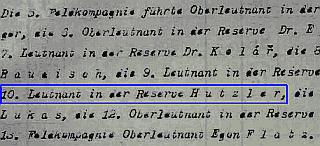
VHA,1927
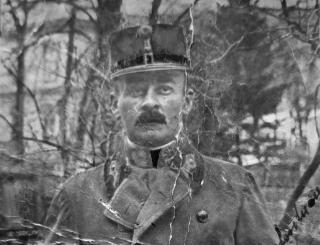
Johann Hutzler commanded IR. 91/10. Feldkompanie during the summer of 1915
© Spolek Jednadevadesátníci

VHA,1927
10. Kompanie is mentioned by Oberst Schröder during his row with Einjährigfreiwilliger Marek when the latter refused to clean the latrine at Hauptwache. The colonel reminded Marek that two one-year volunteers had been hanged by Šabac after having refused to obey orders. In fact, they had hesitated when asked to stab the wife and the son of a Serb irregular fighter. See also 10. Marschkompanie.
Background
10. Kompanie was one of the 16 field companies of Infanterieregiment Nr. 91 and reported to III. Feldbataillon. They did indeed operate near Šabac during the campaign in Serbia, namely in November 1914 when the regiment moved towards the river Kolubara. On 8 November they actually marched through the city itself.
In 1915
During the summer of 1915 Jaroslav Hašek was in close contact with the company as they belonged to the same battalion as his own 11. Kompanie. Commander of 10. Kompanie at the time was Johann Hutzler[a], a reserve lieutenant who Hašek seems to have partly used as inspiration for the moronic Leutnant Dub [b].
Bohumil Vlček
Zugsführer Bohumil Vlček served with the company during Hašek's time in IR. 91 in 1915[c]. In 1956 he recorded in writing his memories and handed them over to Zdena Ančík. They have never been published but used by researchers. Like Hašek Vlček had arrived at the front with XII. Marschbataillon. Vlček was assigned to 1. Marschkompanie, a unit that was commanded by the mentioned Hutzler (Vlček called him Hucl)[d].
Quote(s) from the novel
[II.4] V Srbsku jsme pověsili dva jednoroční dobrovolníky od 10. kompanie a jednoho od 9. jsme zastřelili jako jehně. A proč? Pro jejich paličatost. Ty dva, kteří byli pověšeni, zdráhali se propíchnout ženu a chlapce jednoho čúžáka pod Šabacem a jednoročák od 9. kumpačky byl zastřelen, poněvadž nechtěl jít kupředu a vymlouval se, že má oteklé nohy a že je platfus. Tak budete pucovat hajzl, nebo nebudete?`
 | 9. Kompanie |  | |||
| |||||
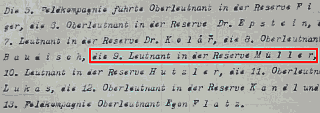
Richard Müller commanded IR. 91/9. Feldkompanie during the summer of 1915
VHA,1927
9. Kompanie is mentioned by Oberst Schröder during his row with Einjährigfreiwilliger Marek when the latter refused to clean the latrine at Hauptwache. The colonel reminded Marek that a one-year volunteer had been shot by Šabac after having refused to obey orders. He objected to go forward, making excuses that he had a swollen leg and was also flatfooted.
Background
9. Kompanie was one of the 16 field companies of Infanterieregiment Nr. 91 and reported to III. Feldbataillon. They did indeed operate near Šabac during the campaign in Serbia, namely in November 1914 when the regiment moved towards the river Kolubara. On 8 November they marched through the city itself.
In [II.5] an 9. Marschkompanie is mentioned by Rechnungsfeldwebel Vaněk, and now the settings in the Carpathians. The context however leaves no doubt that Vaněk had the same unit in mind despite him calling it a march company.
In 1915
During the summer of 1915 Jaroslav Hašek was in close contact with the company as they belonged to the same battalion as his own 11. Kompanie. Commander of 9. Kompanie at the time was Richard Karl Müller[a], a reserve lieutenant who arrived at the front with XII. Marschbataillon and who Hašek surely knew. Müller was born in Vienna in 1892 and was fatally wounded by Murawica in Volhynia on 4 September 1915 and died in a Russian field hospital on the 10th[b].
Quote(s) from the novel
[II.4] V Srbsku jsme pověsili dva jednoroční dobrovolníky od 10. kompanie a jednoho od 9. jsme zastřelili jako jehně. A proč? Pro jejich paličatost. Ty dva, kteří byli pověšeni, zdráhali se propíchnout ženu a chlapce jednoho čúžáka pod Šabacem a jednoročák od 9. kumpačky byl zastřelen, poněvadž nechtěl jít kupředu a vymlouval se, že má oteklé nohy a že je platfus. Tak budete pucovat hajzl, nebo nebudete?`
[II.4] A všechny marškumpačky byla jedna jako druhá, žádná nebyla o chlup lepší než vaše, pane obrlajtnant. Nejhorší byla devátá. Ta s sebou odtáhla do zajetí všechny šarže i s kompaniekomandantem.
| a | Das Infanterieregiment Nr. 91 am Vormarsch in Galizien | 1927 | |
| b | K. und k. Infanterieregiment Nr. 91. Sterb-Register | 1914-1916 |
 | Kartouzy |  | ||||
| Valdice/55, Nám. Míru | ||||||
| ||||||
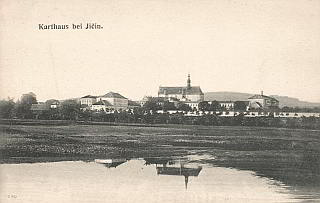
Valdice prison in 1905

,1899
Kartouzy is mentioned in an anecdote by Švejk, where he explains the advantages of feigning retardedness. See Hamburg.
Background
Kartouzy or Věznice Valdice (Valdice prison) is a prison and former monastery in Valdice by Jičín. In 1627 it was established Carthusian monastery by the famous military leader Valdštejn (Wallenstein) but converted into a male prison in the mid 19th century. The murderers Babinský and gipsy Janeček are amongst the most notorious criminals that served time there[a].
Kartouzy was still in use in 2016 as a high security prison and some of the inmates are amongst the most dangerous in the country, several of them serving life sentences. The population of inmates is around 1,000.
Quote(s) from the novel
[II.4] Mladší sestra že se utopila, starší že se vrhla pod vlak, bratr že skočil s železničního mostu na Vyšehradě, dědeček že zavraždil svou ženu a polil se petrolejem a zapálil se, druhá babička že se toulala s cikány a otrávila se ve vězení sirkami, jeden bratranec že byl několikrát souzen pro žhářství a podřezal si v Kartouzích žíly na krku kouskem skla, sestřenice z otcovy strany že se vrhla ve Vídni s šestýho patra, von sám že je strašně zanedbanýho vychování a do deseti let že neuměl mluvit, poněvadž ve věku šesti měsíců, když ho převazovali na stole a někam vodběhli, kočka ho stáhla se stolu a pádem že se uhodil do hlavy.
Literature
| a | Babinský, Janeček a jiní graselové | 3.4.2012 |
 | U Fleků |  | ||||
| Praha II./183, Křemencová 7 | ||||||
| ||||||
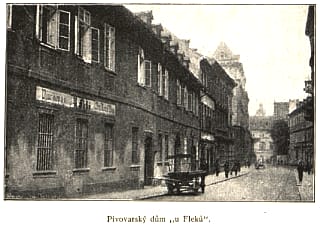
,1904

,1910
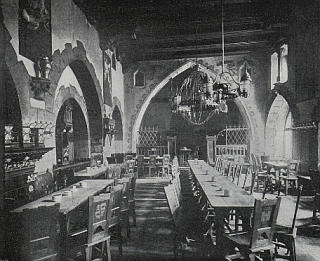
Český svět,26.6.1908
U Fleků is mentioned 2 times in The Good Soldier Švejk.
U Fleků is mentioned in an anecdote by Švejk, where he explains the advantages of feigning retardedness. See Hamburg.
In [I.4] during the interrogation Švejk in Przemyśl the pub reappears. Here it was the setting of the good solder's anecdote about bookbinder Božetěch who was sitting here everyday and related the content of the books he had received for binding.
Background
U Fleků is arguably the most famous tavern in Prague and is considered the worlds oldest brew-pub, reportedly founded in 1499. They are known for their dark 13 degree beer. Landlord in 1910 was Ludvík Hotovec.
Hašek and U Fleků
This was a pub that Jaroslav Hašek frequented and he mentions it in at least one of his stories[a]. Karel Vika[b] and Franta Sauer[c] both published details of Hašek's visits to the pub.
Quote(s) from the novel
[II.4] Mívá též občasné silné bolení hlavy a v takových okamžicích že neví, co dělá, a v takovým stavu že taky vodešel z fronty do Prahy, a teprve když ho zatkla ,U Fleků’ vojenská policie, že přišel k sobě.
[IV.1] Abych nezapomněl, sedával denně u Fleků a vyprávěl obsah všech knih, které právě si dali k němu vázat.
Literature
- Románové restaurační a jiné zábavní podniky2009 - 2021
- Historie U Fleků
- U Fleků26.6.1908
| a | Můj přítel Hanuška | Jaroslav Hašek | 5.10.1913 |
| b | Hašek - kanonýr | 1926 | |
| c | Franta Habán ze Žižkova II. | 1923 |
 | Offizierskasino |  | ||||
| Királyhida, Lagerstrasse | ||||||
| ||||||
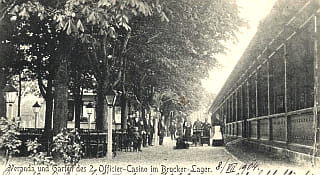
Veranda und Garten des 2. Officier-Casino im Brucker Lager, 8.7.1904
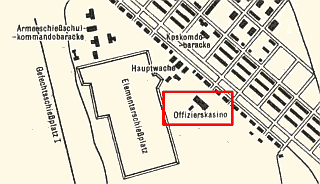
Militär-Adressbuch für Wien und Umgebung,1913
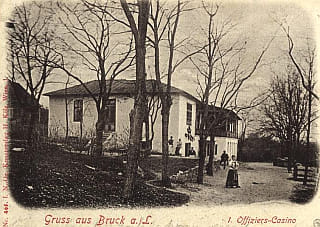
1. Offiziers-Casino, 10.3.1900
Offizierskasino is mentioned because Auditor Ruller borrowed a book by Fr. S. Kraus here. The book had the promising title Forschungen zur Entwicklungsgeschichte der geschlechtlichen Moral and contained for instance toilet grafiti with drawings of reproductive organs.
In [II.5] the casino is mentioned again as Hauptmann Ságner here allegedly declared that was looking forward to return to the front.
Background
Offizierskasino refers to one of two officer's club in Brucker Lager. The first one was found near the main entrance to the camp[a] but this is not indicated on a map of the camp from 1913[b]. On a map from 1873 it is however visibile, indicating that it may have been demolished before World War I.
The second and much larger club was located centrally in Alter Lager, next to Hauptwache in Alter Lager. It was in 1983 in use as Gardehaus[c], is under heritage protection and still exists (2023). The building was erected in 1867 and as such one of the oldest in the entire camp.
Despite the term kasino this was not a gambling joint as one usual associates with this word. It is not known whether gambling took place on the premises, but the Offizierskasino was more a general entertainment establishment with restaurant, bar og live music. The landlords were civilians.
Petra Weiß
Im Brucker Lager selbst gab es mehrere Gaststätten für die Soldaten. Während sich das erste Offiziers-Casino beim Eingang des Alten Lagers befand, war das zweite in der Nähe der Hauptwache bei den Offiziersbaracken. Jeden Abend spielte eine Musikkapelle beim ersten oder zweiten Offiziers-Casino oder bei einer der Mannschaftskantinen.
Quote(s) from the novel
[II.3] Vyprostiv sklenici z objetí zákoníku, listoval se dál v knize vypůjčené z důstojnického kasina. Byla to kniha Fr. S. Krause s mnohoslibným názvem Forschungen zur Entwicklungsgeschichte der geschlechtlichen Moral.
[II.5] Z celého batalionu zbylo jen 80 mužů, pan hejtman Ságner sám dostal handšús, potom v nemocnici ještě úplavici, a zase se objevil v Budějovicích u regimentu a včera prý večer vypravoval v kasině, jak se těší na front, že tam nechá celý maršbatalion, ale že něco dokáže a dostane signum laudis, za Srbsko že dostal nos, ale teď že buď padne s celým maršbatalionem, nebo bude jmenován obrstlajtnantem, ale maršbaťák že musí zařvat.
Sources: Klara Köttner-Benigni, Petra Weiß
Also written:Officers' ClubenOffisersklubbenno
Literature
| a | 150 Jahre Brucker Lager/TÜPl Bruckneudorf | ||
| b | Militär-Adressbuch für Wien und Umgebung | 1913 | |
| c | Die „Abenteuer des Braven Soldaten Schwejk” in Österreich | 1983 |
 | Armeegericht |  | |||
| |||||
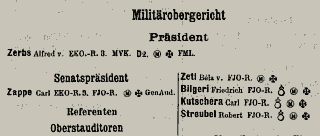
Schematismus für das k.u.k. Heer (s. 125),1914
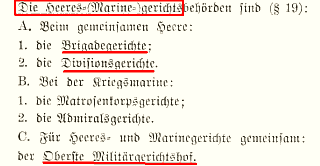
Strafprozeß der gemeinsamen Wehrmacht,1914
Armeegericht is mentioned by Auditor Ruller when he interrogates Švejk and Sappeur Vodička at Divisionsgericht in Brucker Lager. Much to his annoyance he had to ring all the way up to Armeegericht regarding their case.
Background
Armeegericht is a body that remains unidentified. Officially there was't any entity within k.u.k. Wehrmacht called Armeegericht or the synonymous Heeresgericht, but we can assume that Auditor Ruller refers to the very highest body in the military judiciary, the so-called Oberster Militärgerichtshof. Subordinated to it was the Militärobergericht[a] (military supreme court). Garnisonsgerichte (Garrison courts) were in 1914 located at 50 different places across the Dual Monarchy.
Heeresgericht
Heeresgericht and Armeegericht are synonyms but in Austria-Hungary the former seem to be have been more common. It was mostly used as a generic term for military courts of k.u.k. Heer (to distinguish them from the Landwehrgericht of k.k. Landwehr). An army court at a garrison could be either a brigade court or a divisional court[b].
Quote(s) from the novel
[II.4] "Nemyslete si, že se budete u divisionsgerichtu válet dál kvůli nějaké hloupé rvačce a vyhnete se na nějaký čas frontě. Kvůli vám jsem musel telefonovat až s armádním gerichtem, vy hňupi."
Also written:Army CourtenArmádní soudczHærdomstolenno
Literature
- Fahnenflucht28.2.1915
- Richterliche Funktionäre zu Oberleutnant-Auditoren ernannt1.4.1916
| a | Schematismus für das k.u.k. Heer (s. 125) | 1914 | |
| b | Strafprozeß der gemeinsamen Wehrmacht | 1914 |
 | Časopis českých turistů |  | |||
| Praha II./1892, Přičná ul. 4 | |||||
| |||||
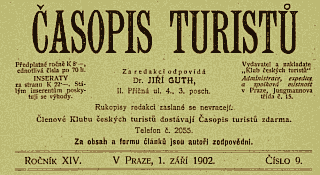
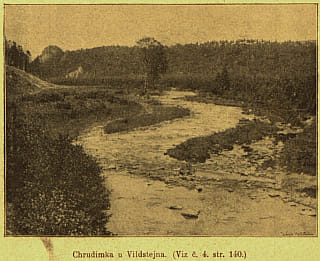
,1.9.1902
Časopis českých turistů is briefly mentioned by Einjährigfreiwilliger Marek during a conversation at Divisionsgericht in Királyhida.
Background
Časopis českých turistů no doubt refers to Časopis turistů, a monthly that from 1889 was published by Klub českých turistů (the Czech Tourist Association).
From 1896 until 1926 Doctor Guth served as chief editor and for a short period after World War I Hašek's good friend Zdeněk Matěj Kuděj was his secretary.
The periodical is still being published (2023) but since 1962 with the name Turista. Between 1949 and 1962 it changed name several times. Only four a short period after the 1948 Communist putsch did the publishing stop entirely[a].
Quote(s) from the novel
[II.4] Když jednoročnímu dobrovolníkovi oznámili, jak to s nimi dopadlo, zvolal: "Tedy marška, přátelé! Je to jako v časopise českých turistů: ,Dobrý vítr!`
Literature
| a | Historie a archiv | Michal Bařinka |



|
II. At the front |
 | |
5. From Bruck on the Leitha toward Sokal | |||
 | 11. Marschkompanie |  | ||||
| ||||||
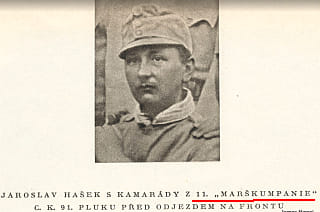
An example of the confusion that the term march company caused in the early years of Hašek research.
,1959
11. Marschkompanie becomes the scene of the plot in [II.5] in Királyhida but the unit has already been mentioned, using the more ambiguous wording 11. Kompanie. The author freely mixed the terms 11th company and 11th march company, but from the context of The Good Soldier Švejk, it is clear that he always had the 11th march company in mind.
Commander of the company is Oberleutnant Lukáš who had, in his own words, "inherited" the company, unknown from who. The company reported to an unspecified march battalion that was commanded by Hauptmann Ságner.
Background
11. Marschkompanie never existed as a unit in Infanterieregiment Nr. 91 in 1915. The number 11 the author evidently borrowed from the 11th field company in which he served as a soldier from 11 July until 24 September 1915. From 1 June until arriving at the front he had belonged to the 4th march company of XII. Marschbataillon of IR91. Like most other march units it was dissolved soon after arriving at the front.
Confusion of terms
Early experts on Hašek like Zdena Ančík believed that because Švejk served in the 11th march company the same must necessarily have been the case with his creator.
Quote(s) from the novel
[II.5] Nadporučík Lukáš chodil rozčileně po kanceláři 11. maršové roty. Byla to tmavá díra v baráku roty, přepažená z chodby prkny. Stůl, dvě židle, baňka s petrolejem a kavalec.
[II.5] To je jedenáctá marškumpanie, kterou jsem zdědil. Co z nich mohu udělat? Jak si budou počínat v opravdovém gefechtu?
[II.5] Vypravoval nedávno štábsfeldvébl Hegner, že příliš neladíte s panem hejtmanem Ságnerem a že on právě pošle naši 11. kumpačku první do gefechtu na ta nejhroznější místa."
[II.5] Nadporučík Lukáš otočil se na židli ke dveřím a zpozoroval, že se dveře pomalu a tiše otvírají. A stejné tak tiše vstoupil do kanceláře 11. marškumpanie dobrý voják Švejk, salutuje již ve dveřích a patrně již tenkrát, když klepal na dveře, dívaje se na nápis "Nicht klopfen!"
[II.5] Švejk pohyboval se tak volně společensky v kanceláři 11. marškumpanie, jako by byl s Vaňkem nejlepším kamarádem, na což účetní šikovatel reagoval prostě slovy: "Položte to na stůl."
[II.5] Já jsem totiž zde ordonanc," řekl hrdě dodatkem, "pan obršt Schröder mě sem přidělil k 11. marškumpačce k panu obrlajtnantovi Lukášovi, u kterého jsem byl pucflekem, ale svou přirozenou inteligencí jsem byl povýšenej na ordonanc.
Literature
- "Rodokmen" či spíše "vývod" lajtnanta DubaKarel Dub2009
 | 10. Marschkompanie |  | ||||
| ||||||

VHA,1927
10. Marschkompanie is mentioned by Rechnungsfeldwebel Vaněk i [II.5] when he chatters away to Oberleutnant Lukáš when he was with this company at the front by Dukla and how incompetent Hauptmann Ságner had proven to be.
The unit has already been mentioned in the previous chapter, using the more ambiguous wording 10. Kompanie. The author freely mixed the terms company and march company, but from the context of The Good Soldier Švejk, it is clear that he always had the 10th march company in mind.
Background
10. Marschkompanie never existed as a unit in Infanterieregiment Nr. 91 in 1915. The number 10 was no doubt borrowed from the 10th field company, a pattern that repeated itself with all the companies from IR. 91 that are mentioned in The Good Soldier Švejk.
Mystifications
As little as any 10th march company existed could Rechnungsfeldwebel Vaněk ever have served with them in the area around Dukla. Three battalions of Infanterieregiment Nr. 91 operated 100 kilometres to the east, in Východní Beskydy. They were deployed in this area from mid February until early May 1915.
Rechnungsfeldwebel Vaněk also claims that Hauptmann Ságner took part in the operations by Dukla. This may have been true Hašek's literary figure but not for his real-life counter-part Čeněk Sagner. The latter was wounded in Serbia in November 1914 and only returned to front duty in June 1915.
Quote(s) from the novel
[II.5] Účetní šikovatel si vzdychl: „Já bych byl toho náhledu, že v takové válce, jako je tahle, kdy je tolik vojska a taková dlouhá fronta, že by se spíš mohlo docílit víc jenom pořádným manévrováním nežli nějakými zoufalými ataky. Já to viděl pod Duklou při 10. marškumpačce. Tenkrát se to všechno odbylo úplně hladce, přišel rozkaz ,Nicht schießen’, a tak se nestřílelo a čekalo, až se Rusové přiblížili až k nám. Byli bychom je zajali bez výstřelu, jenomže tenkrát měli jsme vedle sebe na levém flanku ,železné mouchy’, a ti pitomí landveráci tak se lekli, že se k nám Rusové blíží, že se začali spouštět dolů ze strání po sněhu jako na klouzačce, a my jsme dostali rozkaz, že Rusové protrhli levý flank, abychom se hleděli dostat k brigádě. Já byl tenkrát právě u brigády, abych si dal potvrdit kompanieverpflegungsbuch, poněvadž jsem nemohl najít náš regimentstrain, když vtom začnou k brigádě chodit první z 10. maršky. Do večera jich přišlo sto dvacet, ostatní prý po sněhu sjeli, jak při ústupu zabloudili, někde do ruských štelungů, jako by to byl tobogan. Tam to bylo hrozné, pane obrlajtnant, Rusové měli v Karpatech štelungy nahoře i dole. A potom, pane obrlajtnant, pan hejtman Ságner...“
Literature
 | Offiziersmenage |  | ||||
| Királyhida, Lagerstrasse | ||||||
| ||||||
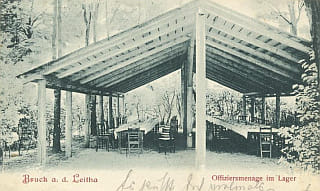
Offiziersmenage im Lager

,26.5.1912
Offiziersmenage is by Oberleutnant Lukáš when he complains to Rechnungsfeldwebel Vaněk that he sent Offiziersdiener Baloun here to get him lunch but the latter ate half of it.
Background
Offiziersmenage refers to an officer's mess in Brucker Lager. There is no doubt that it existed[a], perhaps there were several both in the old and the new camp. In this case it would surely have been a mess in Altes Lager where Hašek himself served. We don't know where the mess(es) was located but it would surely have been along Lagerallee or not far from it.
Quote(s) from the novel
[II.5] "Vybral jste mně opravdu znamenitého pucfleka," mluvil nadporučík Lukáš k účetnímu šikovateli, "děkuji vám srdečně za to milé překvapení. První den si ho pošlu pro oběd do oficírsmináže, a on mně ho půl sežere."
Sources: Klara Köttner-Benigni
Also written:Officers' messenOffisersmessano
| a | Die „Abenteuer des Braven Soldaten Schwejk” in Österreich | 1983 |
 | Brucker Einjährigfreiwilligenschule |  | |||
| Bruck an der Leitha, Alte Wiener Straße 36 | |||||
| |||||
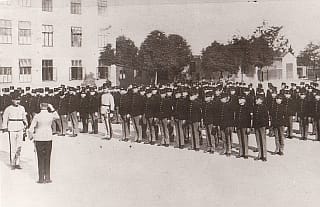
Bruck, Alte Wiener Straße - Landwehrkaserne ca.1915

K.u.k. Platzkommando, Wien,1913
Brucker Einjährigfreiwilligenschule is mentioned by Oberleutnant Lukáš when he in a conversation with Rechnungsfeldwebel Vaněk complains over having been given the command of 11. Marschkompanie, a completely hopeless unit. It is also revealed that Hauptmann Ságner commanded the school during night exercies but had got lost and only stopped when they reached the mud by Neusiedler See.
Background
Brucker Einjährigfreiwilligenschule refers to the reserve officer's school in Bruck an der Leitha. It was located in Landwehrkaserne in the western part of town. The building is still intact and in 1983 it was occupied by council houses[b].
Some time after Ersatzbataillon IR. 91 was moved to Bruck an der Leitha - Királyhida (1 June 1915) the reserve officer's schools from the various units in the garrison were merged. The 14th course started in April 1917[a]. See also Budweiser Einjährigfreiwilligenschule.
Quote(s) from the novel
[IV.5] „Předevčírem při nachtübungu měli jsme, jak víte, manévrovat proti Einjährigfreiwilligen Schule za cukrovarem. První švarm, vorhut, ten šel ještě tiše po silnici, poněvadž ten jsem vedl sám, ale druhý, který měl jít nalevo a rozeslat vorpatroly pod cukrovar, ten si počínal, jako kdyby šel z výletu.
[IV.5] A to nevíte, pane obrlajtnant, že při tom posledním nachtiibungu, o kterém jste vypravoval, einjährigfreiwilligenschule, která měla naši kumpačku obejít, dostala se až k Neziderskému jezeru?
Sources: Josef Novotný
Literature
| a | Z mých válečných pamětí | 2021 | |
| b | Die „Abenteuer des Braven Soldaten Schwejk” in Österreich | 1983 |
 | Brucker Zuckerfabrik |  | |||
| |||||
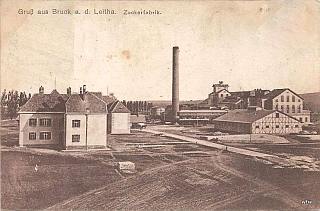
Zuckerfabrik 1910
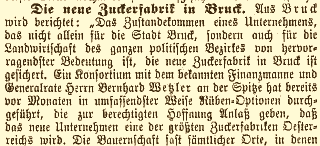
Der neue Bezirksbote,31.1.1909
Brucker Zuckerfabrik is mentioned by Oberleutnant Lukáš, through the term "sugar factory" when he tells Rechnungsfeldwebel Vaněk about some manouvres he took art in behind the factory.
Background
Brucker Zuckerfabrik refers to a sugar factory in Bruck and der Leitha that started production in 1909. It was owned by Österreichischen Zuckerindustrie-Aktiengesellschaft until 1931 and had several owners throughout the years. Until it was closed in 1986 it remained one of the largest sugar refineries in Austria. Wolfgang Gruber and Erwin Sillaber have written a detailed history of the sugar factory[a]. Today the building is occupied by a biodiesel factory.
The good soldier Švejk in captivity
The factory is mentioned also in Dobrý voják Švejk v zajetí but is erroneously placed in Királyhida.[1]
Jinak Királyhida je zaprášené město. Obyvatelé nevědí, jestli jsou Němci nebo Maďaři. Městské děvy pěstují flirt s důstojníky vojenského tábora z Brucku. Také tu kvete prostituce jako všude v Maďárii. Jsou tam jen dvě památnosti, zříceniny cukrovaru a vykřičený dům U kukuřičního klasu, který ráčil poctíti svou návštěvou arcivévoda Štěpán roku 1908 za velkých manévrů.
Wolfgang Gruber
Trotz regionaler Widerstände und Schwierigkeiten entstand in Bruck im Jahre 1909 ein moderner Verarbeitungsbetrieb für Zuckerrüben. Die Brucker Zuckerfabrik wurde für die Ostregion südlich der Donau über Jahrzehnte zu einem wichtigen Arbeit- und Auftraggeber.
Quote(s) from the novel
[II.5] „Předevčírem při nachtübungu měli jsme, jak víte, manévrovat proti Einjährigfreiwilligen Schule za cukrovarem. První švarm, vorhut, ten šel ještě tiše po silnici, poněvadž ten jsem vedl sám, ale druhý, který měl jít nalevo a rozeslat vorpatroly pod cukrovar, ten si počínal, jako kdyby šel z výletu.
Sources: Wolfgang Gruber
Also written:Bruck Sugar FactoryenBruck cukrovarczBruck sukkerfabrikkno
Literature
- Die „Abenteuer des Braven Soldaten Schwejk” in Österreich1983
- Die neue Zuckerfabrik in Bruck31.1.1909
- Zur Tage der Böhmischen Maschinenfabriken16.7.1909
- Der Fabriksbrand in Bruck an der Leita11.8.1916
| a | Die Brucker Zuckerfabrik | ||
| 1 | Dobrý voják Švejk v zajetí | 1917 |
 | 9. Marschkompanie |  | |||
| |||||

IR. 91/9. Feldkompanie captured on 22 March 1915.
,1915
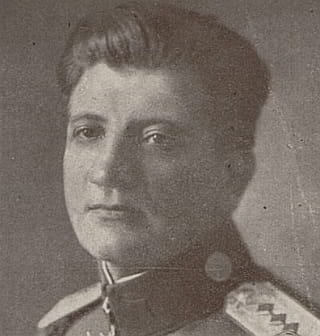
Lieutenant Ladislav Kvapil was one of eight officers from IR. 91 who were taken prisoner on 22 March 1915.

Captain Viktor Wessely, taken prisoner on 22 March 1915.
© ÖStA
9. Marschkompanie is mentioned by Rechnungsfeldwebel Vaněk when he tells Oberleutnant Lukáš about his experiences at the front. This company was according to him the worst of them all and were at one stage captured as a unit, together with its commander.
Background
9. Marschkompanie never existed as a unit in Infanterieregiment Nr. 91 in 1915. The number 9 was evidently borrowed from 9. Kompanie (field company), a pattern that repeat itself with all the companies from IR. 91 that are mentioned in The Good Soldier Švejk.
Entire companies captured
That entire companies (appx. 180 men) were captured didn't happen often with Infanterieregiment Nr. 91 but during the retreat from Serbia in December 1914 three companies "disappeared". According to Jan Eybl the 5th, 14th and 15th company were captured[a]. Hašek was surely aware of these events and may at least hypothetically have knitted it into the novel.
Disaster in the Eastern Beskids
That said, events in Východní Beskydy on 22 March 1915 provide more solid clues. During a Russian attack in the early hours, large parts of 9. Infanteriedivision were caught in their sleep and captured. Worst hit was Infanterieregiment Nr. 91 and IR73 and both regiments lost entire companies. III. Feldbataillon was nearly wiped out and three of its four companies were captured. These were the 9th, 10th and 12th and the 11th was severely decimated. Who the commander of 9. Feldkompanie was at the time is not known. Jan Eybl noted that the "lieutenant of the company" and 20 men fell asleep on guard and this lieutenant may well have been the company commander. 11. Kompanie was subjected to investigations after the battle and there also on other occasions the company had come under scrutiny[b].
The Verlustliste of Infanterieregiment Nr. 91 for the 22 and 23 of March contains almost 600 names, and most of them are listed as "taken prisoner". Amongst those captured were the captains Franz Wild and Viktor Wessely, the lieutenants (Ladislav Kvapil and Viktor Dostal), and the reserve lieutenants (Karel Výška, Rudolf Förster, Josef Richter, and Johann Trapl)[c]. Hauptmann Wessely was almost certainly the commander of III. Feldbataillon as this had been his position during the campaign in Serbia a few months earlier. To which units the other officers belonged has not yet been ascertained, but it can be stated with near certainty that all the officers of the 9th company were amongst those captured.
Considering that III. Feldbataillon ceased to exist, and the 9th company was captured with its officers, it is very likely that the regiment's collapse in the Carpathians inspired Rechnungsfeldwebel Vaněk's words to Oberleutnant Lukáš. Such a disaster would have been known by everyone in the regiment and Hašek would defintely have picked up some of the details.
Jan Ev. Eyvl
22.3. Ráno hned padla Malá Zolobona a tři setniny (9,10 a 12) zajaty. Úplně překvapeni o ½ 6 ráno. Poručík 9. setniny a všech 20 mužů usnulo na stráži.
Quote(s) from the novel
[II.5] A všechny marškumpačky byla jedna jako druhá, žádná nebyla o chlup lepší než vaše, pane obrlajtnant. Nejhorší byla devátá. Ta s sebou odtáhla do zajetí všechny šarže i s kompaniekomandantem.
 | Drogerie Kokoška |  | |||
| Praha I./360, Na Perstyně 4 | |||||
| |||||
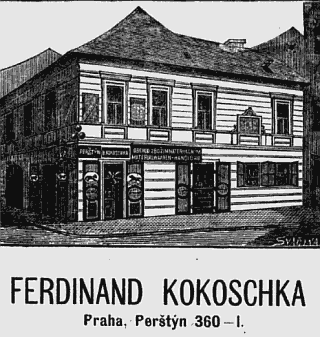
Adresař města Turnova,1892
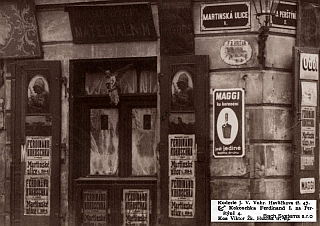
2.1.1905. Pohled na dům čp. 360 (U Tří zlatých koulí) na nároží ulic Martinské a Na Perštýně na Starém Městě těsně před zbořením roku 1905.
© AHMP

,1.7.1890
Drogerie Kokoška is mentioned during the first conversation between Švejk and Rechnungsfeldwebel Vaněk. The former he tells an anecdote about his time as a chemist's apprentice by Mr. Kokoška in Na Perštýně.
Background
Drogerie Kokoška was a chemist's store where Jaroslav Hašek in 1898 worked as an apprentice after prematurely ending his studies at the gymnasium. The shop was located at the corner of Na Perštýně and Martinská ulice, in the house U třech zlatých koulí. The information is confirmed by newspaper adverts, address books and a photo from 1905. The owner Mr. Kokoška opened the store/workshop in the summer of 1890. It was operating until 1906 when the proprietor died.
From the old pharmacy
The author's time at the chemists inspired a series of eight stories that were published in Veselá Praha in 1909 and 1910. Here Kokoška, Tauchen and Ferdinand all appear but the former two with their names slightly twisted but easily recognizable (Kološka and Tauben). The stories were translated into English by Cecil Parrott and were included in the book The red commissar.
The stories that are written in the first person form describe the pharmacy, the people who worked there, and also customers and neighbours. Pivotal to the story is Mr. Kološka who is an elderly man with a kind heart. His assistant is the lazy Mr. Tauben who doesn't take his duties too seriously and also encourages the young apprentice Hašek not to run his shoes off for the boss. Another employee is Ferdinand who is known for his colourful and immaculately kept carriage into which he puts all his diligence and pride. Mrs. Kološka is described in extremely unflattering terms and she is also given the nick-name "acid". She torments her husband and the staff at the pharmacy. Her name is Marie (born Vanouš), she is a tall and corpulent lady but with quite attractive features. She and her father continuously remind Kološka that the business would have gone under by now if it hadn't been for their help. It is also revealed that Kološka and his wife live together with the evil father-in-law and that the marriage came about for financial reasons. They lived somewhere else, not in the pharmacy building, and appeared to be quite well off.
Ficton and facts
Throughout Hašek's writing one will find a mix of facts, half-facts and invention, and so it is here. Starting with the facts: that the author was an apprentice at the pharmacy is beyond dispute, the owner was indeed Mr. Kokoška and the location of the business is precisely where Švejk puts it. Václav Menger also confirm that a Tauben worked there, likewise a Ferdinand Vavra who probably is the model of the Ferdinand with the colourful cart. On the other had the apprentice seem to have had a much more strained relationship with Tauben than what is apparent from the stories. The young Hašek was subjected to some envy from other staff members because he was capable and thus became a favourite of the boss. Further Václav Menger mentions Mrs. Kokošková and that she came from a wealthy background. This appears to be true but otherwise her biographical details are differ from those of her literary counterpart. From population registers we know that Mrs Kokošková was born Anna Milnerová in 1857 and not Marie Vanouš as in the stories.
As Hašek stated, the family didn't live on the premises of the pharmacy. Their address was Praha II., Pštrossová ul. 221/25. Here they are registered from 1880 and the next year their daughter Anna was born, so moving there was clearly a result of the marriage. Hašek may also have been touching real life when describing the obnoxious behaviour of Mrs. Kološková: Anna Kokošková eventually died in a lunatic asylum in Prague. On the other hand Tauben (or Tauchen) is a mystery. Despite Václav Menger's claim that he existed there is not a single Tauben to find in population records or police registers, and the few Tauchen who are listed have no obvious link to Kokoška or any pharmacy.
Aftermath
After the death of Mr. Kokoška in 1906 the shop and the workshop was taken over by Václav Rubeš. In the meantime it had also moved from No. 360 to the next-door No. 359 with address Martinská ulice. Anna Kokošková died as late as 1916, 59 years old. It is not known what happened to the daughter Anna who was 26 when her father died.
Quote(s) from the novel
[II.5] „Já jsem se taky učil materialistou,“ řekl Švejk, „u nějakýho pana Kokošky na Perštýně v Praze. To byl náramnej podivín, a když jsem mu jednou vomylem ve sklepě zapálil sud benzinu a von vyhořel, tak mne vyhnal a gremium mne už nikde nepřijalo, takže jsem se kvůli pitomýmu sudu benzinu nemoh doučit. Vyrábíte také koření pro krávy?“
Also written:Drogerie Kokoschkade
Literature
- Adresář královského hlavního města Prahy a obcí sousedních1907
- Ferdinand Kokoschka1892
- Ferdinand Kokoška & spol.
- Sterbefall18.2.1906
- Převzeti závodu4.10.1906
- Z droguerieJaroslav Hašek24.3.1904
- Ze staré drogerieJaroslav Hašek1909 - 1910
- Hašek inteligentním praktikantemVáclav Menger2.7.1933
- Hašek si loučí s drogeriíVáclav Menger9.7.1933
 | U milosrdných |  | |||
| |||||
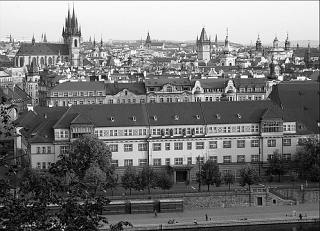
U milosrdných is mentioned by Švejk in his story from when he was a chemist's apprentice at drogerie Kokoška.
Background
U milosrdných refers to the hospital Nemocnice na Františku associated with the monastry-komplex klášter milosrdných bratří s kostelem sv. Šimona a Judy in Staré město. This hospital was the first in Europe to carry out anasthaesia (1847).
Quote(s) from the novel
[II.5] Chytal holuby na půdě, uměl votvírat pult s penězma a ještě nás učil jinejm melouchům se zbožím. Já jako kluk jsem měl doma takovou lékárnu, kterou jsem si přines z krámu domů, že ji neměli ani ,U milosrdnejch’. A ten pomoh panu Tauchenovi; jen řek: ,Tak to sem dají, pane Tauchen, ať se na to kouknu,’ hned mu poslal pan Tauchen pro pivo.
Also written:U milosrdnejchŠvejk
 | Plynární stanice Letna |  | |||
| Praha VII./138, U Královské Obory 37 | |||||
| |||||
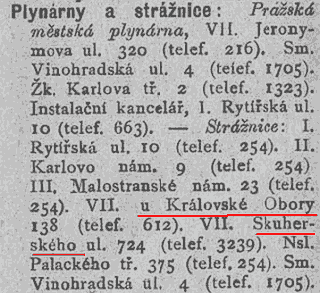
Plynární stanice Letna is mentioned in the story about gas worker Zátka.
Background
Plynární stanice Letna refers to a gas station at Letná of which there were two in 1910. Both were guard-houses (strážnice) whose main duty was the street-lighting. The most obvious candidate is situated on the Letná plain, in U Královské Obory 138 (now Nad Královskou oborou 138/37), but the station in Skuherského 724/32 (now Pplk. Sochora 724/30) can not be ruled out entirely.
Quote(s) from the novel
[II.5] „Co se mý osoby týká, pane rechnungsfeldvébl, když jsem to slyšel, co vy jste vo těch outvarech povídal, tak jsem si vzpomněl na nějakýho Zátku, plynárníka; von byl na plynární stanici na Letný a rozsvěcoval a zas zhasínal lampy.
 | Kostel svaté Kateřiny |  | |||
| |||||
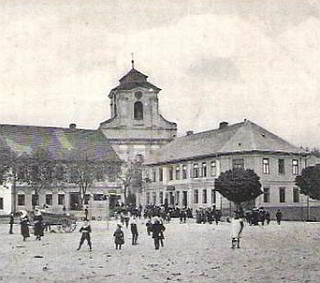
Kostel svaté Kateřiny is mentioned in the same story as Rekrut Pech who was from nearby Dolní Bousov where this church is.
Background
Kostel svaté Kateřiny is the parish church in Dolní Bousov. According to local sources it was built in 1759 and 1760 in baroque style. There was probably a church there already, just as Rekrut Pech says.
Quote(s) from the novel
[II.5] Dolní Bousov, Unter Bautzen, 267 domů, 1936 obyvatelů českých, hejtmanství Jičín, okres Sobotka, bývalé panství Kosť, farní chrám svaté Kateřiny ze 14. století, obnovený hrabětem Václavem Vratislavem Netolickým, škola, pošta, telegraf, stanice české obchodní dráhy, cukrovar, mlýn s pilou, samota Valcha, šest výročních trhů.’
 | Church of Saint Sava |  | |||
| |||||
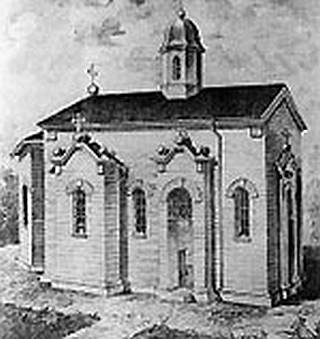
The first church of St. Sava, 1895
Church of Saint Sava is mentioned because the entire 6th March Company got lost here during the withdrawal from Belgrade. This is brought up in connection with the trial of Zugsführer Teveles.
Background
Church of Saint Sava at first glance seems to refer to the largest and most important cathedral in Serbia, and the largest cathedral in south-eastern Europe, and also the largest orthodox cathedral in the world.
This assumption is however wrong, because in 1914 the cathedral was still only being planned. Construction started as late as 1935, but in 1914 there was a small church with the same name on the site, and this is surely the one the author has in mind. Both churches were/are located on the Vračar hill.
The missing march company
The story about the missing 6th March Company may be based on real events although this company never existed (each march battalion consisted of four companies, numbered I,II,III and IV). The author may however had IR. 91/6th field company or another company of IR. 91 in mind. These fought by Belgrade during the withdrawal from Serbia in the week before 15 December 1914. During this time the regiment lost three entire companies before the remainder pulled out to Hungary across the river Sava. The three missing field companies (5th, 13th and 14th) were however captured by Borak south of Belgrade, not in the city itself.
Quote(s) from the novel
[II.5] Byl-li však pěšák Teveles povýšen v bělehradské válečné kampani za četaře, nedalo se naprosto zjistit, poněvadž celá 6. marškumpanie se ztratila u cerkve sv. Sávy v Bělehradě i se svými důstojníky.
Sources: Rudolf Kießwetter, Petr Novák
Also written:Cerkev svaté SavyHašekKostel svaté Savyczцрква Светог Савеsr
Literature
 | Zur weißen Rose |  | |||
| |||||
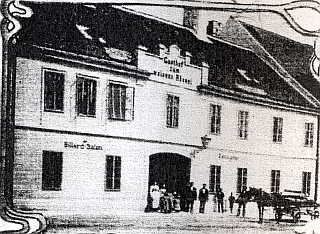
Zur weißen Rose is mentioned because this is where Gefreiter Peroutka was found when the company was about to depart for the front.
Background
Zur weißen Rose has not been identified, but may be a mistranslation or misspelling of Zum weißen Rössel, a former guest-house in Bruck. Zum weißen Rössel was located in Altstadt 6, and on the first floor was a Mannschaftspuff (brothel for the lower ranks). Altstadt is the name of a street, not the old town as the name suggests. During World War I the street was centre of night-life and entertainment in Bruck.
Bohumil Vlček recalls a Czech waitress Růženka who worked in a certain tavern named u Růže (Zur Rose) and that many Czechs, including Jaroslav Hašek, visited regularly[a]. Further Jan Morávek, in an interview that was printed in Průboj 3 March 1968, adds that the author, before departure to the front was picked up by the patrol at U zlatého růže (Zur goldenen Rose). It is surely the same place, but there is great confusion about the real name of the place. Vlček also mentions that Jaroslav Hašek in the same situation was detained in a pub by the railway station. If this is the case, the hypothesis about Zum weißen Rössel is invalid as it was located about 10 minutes walk from the station. On the other hand Vlček explicitly states that the "Rose" was in Bruck, whatever colour or shape it might have appeared in. Josef Novotný also mentions the place in his memories from the war[b].
Bohumil Vlček
V lágru nás nic nepoutalo, proto po zaměstnáni navštěvovali jsme v Mostě hostinec u "Růže" kde nás obsluhovala naše česká číšnice Růženka / jak v románě též o tom zmínka :/ Tam byl stalým hostem Jaroslav Hašek, kterého jsem tam též osobni poznal. Většinou do restaurace chodili Češi, jednoročáci a i mužstvo od náhr. praporu.
Quote(s) from the novel
[II.5] Vymlouval se, že chtěl před odjezdem prohlédnout známý skleník hraběte Harracha u Brucku a na zpáteční cestě že zabloudil, a teprve ráno celý unavený že dorazil k „Bílé růži“. (Zatím spal s Růženkou od „Bílé růže“.)
Sources: Bohumil Vlček, Josef Novotný, Wolfgang Gruber, Friedrich Petzneck, Klara Köttner-Benigni, Jan Morávek
Also written:At the White RoseenU bílé růžeczFehér RózsahuDen kvite roseno
Literature
| a | Připomínky k románu "Dobrého vojáka Švejka" | 20.3.1956 | |
| b | Z mých válečných pamětí | 2021 |



|
III. The famous thrashing |
 | |
1. Across Magyaria | |||
 | Bruck-Királyhida pályaudvar |  | ||||
| ||||||
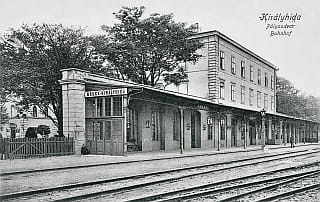

From Jan Vaněk's diary, 2 July 1915
Bruck-Királyhida pályaudvar is the scene of Švejk's march company's departure to the front, the date seems to have been 22 May 1915. The station is not mentioned explicitly in the narrative but the plot will necessarily have taken place here.
Background
Bruck-Királyhida pályaudvar was the railway station in Királyhida, opened in 1846. It is now officially called Bruck/Leitha Bahnhof. The old station building was demolished a long time ago.
It was from where Jaroslav Hašek's XII. Marschbataillon departed from on 30 June 1915 at 8:15 PM. They arrived at the front near Gołogóry on 11 July.
Jan Vaněk, deník 2.7.1915
Když jsem v březnu putoval do špitálu, nepomyslel jsem si, že v červenci se budu zase těmi samými místy vracet do pole. Vyjeli jsme 30. června večer o 1/4 9 hod. z Brucku. Chtěli nám ten těžký moment loučení osladit. Znají dobře svoje lidi, co žádají a co na ně platí, Dali nám na nádraží—muziku—.
Quote(s) from the novel
[III.1] Konečně se všichni dočkali toho okamžiku, kdy je nacpali do vagonů v poměru 42 mužů k 8 koním. Koním ovšem se jelo pohodlněji než mužstvu, poněvadž mohli spát vstoje, ale to nevadilo. Vojenský vlak vezl do Haliče opět novou skupinu lidí hnaných na jatky. Celkem však se všem těm tvorům přece jen ulehčilo; bylo to něco již určitého, když se vlak hnul, ale předtím to byla jen trapná nejistota, panika, zdali se pojede již dnes, nebo zítra, či pozítří. Některým bylo jako odsouzeným k smrti, kteří očekávají se strachem, kdy si pro ně přijde kat. A potom nastane uklidnění, že už to bude odbyto.
Literature
 | Kriegskalender |  | |||
| |||||
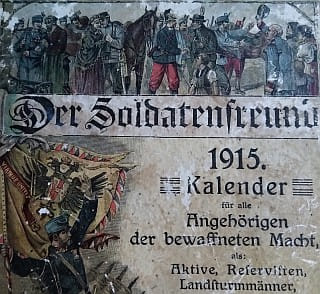
Kriegskalender is mentioned by the author when he comments on Feldoberkurat Ibl's field sermon before Švejk's march battalion departs from Bruck. He notes that the speech clearly was picked from war calendars.
Background
Kriegskalender in the context of The Good Soldier Švejk no doubt refers to "Der Soldatenfreund. 1915 Kalender". The quoted field sermon by Feldoberkurat Ibl is almost word by word copied from pages 72 and 73 of this calendar.
Der Soldatenfreund was a series of calendars that were published by the firm J. Steinbrener from 1892 until 1919. The calendar was issued in several of the languages of the empire: German, Hungarian, Czech, Polish... Steinbrener were headquartered in Winterberg (now Vimperk) in the Šumava region, but were represented also elsewhere in Austria-Hungary and even in New York.
The title page sounded: Der Soldatenfreund Kalender für das Jahr 1915. Für alle Angehörigen der bewaffneten Macht als: Aktive, Reservisten, Landsturmmänner, sowie für Veteranen und ehemalige Soldaten, und für alle Freunde des Soldatenstandes.
Hašek and war calendars
Radko Pytlík notes in Kniha o Švejkovi (1982) p. 87 that Hašek had publisher Synek send old Austrian calendars to Lipnice and Feldoberkurat Ibl's mass leaves no doubt that he fitted elements from at least one of them into The Good Soldier Švejk. Looking for further fragments we have browsed the calendars from 1914 to 1919. The mentioned entry from the 1915 issue is obvious but the issue from 1919 is even more rewarding as it identifies no less than six people associated with Švejk's involuntary stay at Táborské nádraží in [II.1]. For more on Hašek's use of published material, see Kronika světové války.
Der Soldatenfreund. Kalender für das Jahr 1919


The inspiration for the propaganda posters that Švejk observed in Tábor is no doubt Kriegskalender, or more precisely: Der Soldatenfreund. Kalender für das Jahr 1919 and probably the Czech version of it. The reason that we can be so sure is that all the four motifs (six persons) that are described in this sequence of The Good Soldier Švejk also feature in the calendar. In addition, the text sequences that Hašek uses are more or less to the letter copies of text fragments from the calendar. In the case of Doctor Vojna even a spelling mistake in the surname found its way into The Good Soldier Švejk.
The motifs are fetched from pages 6 to 29 which is a pure calendar section. For each month there are two pages presenting a "shining role model of courage and gallantry". One page contains a drawing with a brief subtitle and on the next page. there is a detailed description of the heroic deed.
In the case of Zugsführer Danko and Zugsführer Hammel (with Korporal Paulhart and Korporal Bachmayer) the short subtitles are reproduced as is. In the case of Trainsoldat Bong, the entire description is copied almost to the letter. For Doctor Vojna it was different: only brief extracts from the description found their way into The Good Soldier Švejk and the soldier's vivid imagination provided the rest.
Quote(s) from the novel
[III.1] Měl přitom velice nadšenou řeč a bylo znát, že bral materiál z vojenských kalendářů.
Literature
 | Klárův ústav slepců |  | |||
| |||||
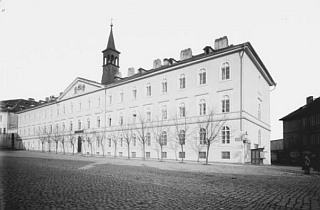
Klárův ústav slepců was the institution where the cook who replaced cook Jurajda in the officers mess at Királyhida hailed from.
Background
Klárův ústav slepců was from 1832 to 1945 an institute for the blind, now the location of Česká geologická služba (Czech Geology Service). The institute was founded by and is named after Alois Klar.
Quote(s) from the novel
[III.1] Toto psaní bylo vynuceno okolnostmi, když kuchař okultista nadobro si rozlil ocet s plukovníkem Schröderem, který mu dosud držel palec, ale na kterého se při večeři na rozloučenou s důstojníky maršbatalionu opět, nešťastnou náhodou, nedostala porce rolované telecí ledviny, a plukovník Schröder ho poslal s marškumpačkou do pole, svěřiv důstojnickou kuchyni pluku nějakému nešťastnému učiteli z ústavu slepců na Klárově.
Also written:Klárov Institute of the BlindenKlárov Blindeinstituttno
 | Průmyslová jednota |  | |||
| Praha I./539, Rytířská ul. 31 | |||||
| |||||
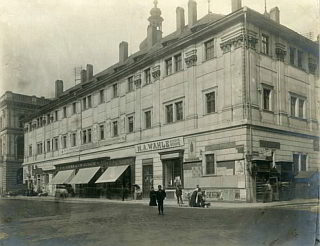
Průmyslová jednota in Prague is mentioned by Švejk because he once was refused admission in the reading room there due to his shabby appearance.
Background
Průmyslová jednota was an institution for promotion of technical education. It was founded in 1833 and was closed in 1950. The library and reading room in question was located in Rytířská ulice i Staré město.
Quote(s) from the novel
[III.1] „Vo tom stěhování duší jsem už taky slyšel,“ ozval se Švejk. „Já jsem si také jednou umínil před léty, že se, jak se s vodpuštěním říká, sám budu vzdělávat, abych nezůstal pozadu, a chodil jsem do čítárny Průmyslové jednoty v Praze, ale poněvadž jsem byl roztrhanej a svítily mně díry na zadnici, tak jsem se nemoh vzdělávat, poněvadž mne tam nepustili a vyvedli ven, poněvadž myslili, že jsem šel krást zimníky.
Sources: Milan Hodík, Radko Pytlík
 | Daňkovka |  | |||
| |||||
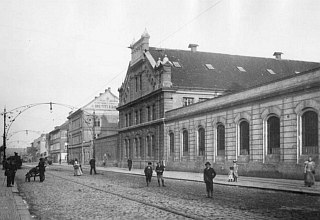
Paláckého třída towards the east with the main gate of Breitfeld-Daněk to the right. Around 1900.
© AHMP
Daňkovka was the factory where the metal caster metal caster Adamec worked. This is in an anecdote Švejk tells Oberleutnant Lukáš, but the latter cuts off.
Background
Daňkovka refers to the industrial group Breitfeld-Daněk a spol. that in 1927 was merged with Českomoravská-Kolben, a.s. to ČKD, a company that still exists. The Tatra tram is probably their best known product, still running in many of the former socialist countries. The first factory was located in Karlín and this is surely the one referred to by Švejk. See also negro Kristian.
Quote(s) from the novel
[III.1] Nadporučík Lukáš mluvil takovým hlasem, jako by se o něho pokoušela horečka, a toho okamžiku, když umlkl, využitkoval Švejk k nevinné otázce: „Poslušně hlásím, pane obrlajtnant, za prominutí, proč se nikdy nedozvím, co jsem vyved hroznýho: Já, pane obrlajtnant, jsem se vopovážil na to zeptat jenom kvůli tomu, abych se příště mohl takový věci vystříhat, když se všeobecně povídá, že se vod chyby člověk učí, jako ten slejvač Adamec z Daňkovky, když se vomylem napil solný kyseliny...“
 | Wiener Illustrierte Zeitung |  | |||
| Wien VI./-, Gumpendorfer str. 87 | |||||
| |||||
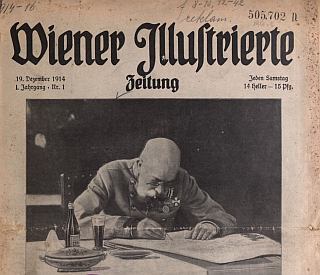
The front page of the first issue, 19.12.1914
Wiener Illustrierte Zeitung is mentioned when the author describes Kadett Biegler's dream on the train to Budapest. The landscape the cadet experiences in the dream is as cut out of this magazine.
Background
Wiener Illustrierte Zeitung was an illustrated weekly that was published every Saturday. The first issue appeared on 19 December 1914. The magazine continued to the end of 1916, altogether 107 issues. In the address book of 1917 the paper is not listed. The emphasis was on pictures from the war, celebrities, and patriotic propaganda, and the photos were for that time of good quality.
The paper was published by Gesellschaft für grafische Industrie, located in the city district of Mariahilf (VI. Bezirk) near the centre of Vienna.
Vídeňské illustrované noviny
A Czech weekly with the same title was also published in Vienna. This is however an entirely different periodical and was in circulation much longer, from 1906 to 1920.
Quote(s) from the novel
[III.1] Krajina měla týž ráz jako na obrázcích „Wiener Illustrierte Zeitung“. Po pravé straně bylo vidět u stodoly dělostřelectvo, jak střílí do nepřátelských zákopů vedle silnice, po které projížděl s automobilem.
Literature
 | C.F. Amelang’s Verlag |  | |||
| Leipzig/-, Königstrasse 33 | |||||
| |||||
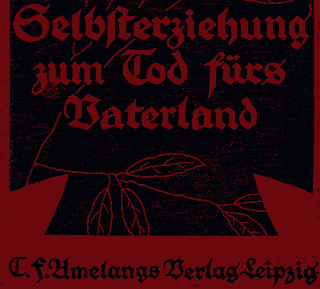
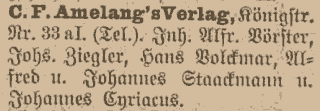
Leipziger Adreß-Buch, 1915
C.F. Amelang’s Verlag is mentioned in a footnote by the author, as the publishing house in Leipzig that published the book Self Education for death for the Emperor by Udo Kraft.
Background
C.F. Amelang’s Verlag was a publishing house head-quartered in Leipzig. They specialised in school text books, pedagogy, and history of literature. The firm was founded by Carl Friedrich Amelang (1785–1856) in 1806, but by 1915 the ownership was no longer with the family.
Newspaper items from the early years indicate that they were established in Berlin as a bookshop, and traded from there until 1850 when they appear to have moved to Leipzig. In 1853 it seems that the ownership has been passed to a certain Fr. Volckmar, and Hans Volckmar is listed as co-proprietor in 1915.
From 1917 to 1924 they gradually merged with other publishers to become Koehler & Amelang GmbH, a company that still exists.
Quote(s) from the novel
[III.1] Udo Kraft: Selbsterziehung zum Tod Für Kaiser. C.F. Amelang’s Verlag, Leipzig.
Literature
- Korrespondenz-Nachrichten14.10.1808
- Bei C.F. Amelang in Berlin ...10.7.1810
- In der Buchhandlung von Carl Friedrich Amelang in Berlin ...12.11.1816
- Einladung zur Pränumeration8.6.1850



|
III. The famous thrashing |
 | |
2. In Budapest | |||
 | Kis Színkör |  | |||
| |||||
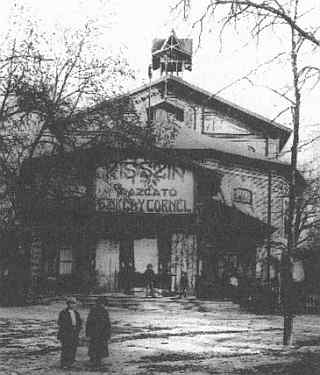
Kis Színkör is mentioned in a comment by Hauptmann Ságner who read in Pester Lloyd that the actress Weiner was to perform there.
Background
Kis Színkör was a theatre and cabaret in Városliget (City Park) in Budapest. It was founded in 1904.
Quote(s) from the novel
[III.2] Zklamal se však úplně, neboť hejtman Ságner, kterému přinesl batalionsordonanc Matušič ze stanice večerní vydání „Pester Lloydu“, řekl, dívaje se do novin: „Tak vida, ta Weinerová, kterou jsme viděli v Brucku vystupovat pohostinsky, hrála zde včera na scéně Malého divadla.“
Sources: László Polgár
Also written:Small TheatreenVesle TeaternnMalé divadloczKleines TheaterdeKis Színkörhu
Literature
 | Firma Moritz Löwenstein |  | |||
| |||||
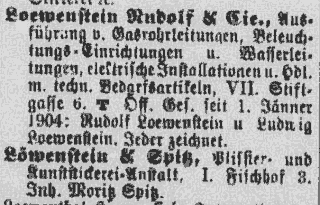
Firma Moritz Löwenstein was a company from Vienna who delivered religious gadgets. Here Offiziersdiener Baloun was eating little balls from a rosary manufactured by them, and the firm supplied Klokoty as well. The author mentions in [I.11] Firma Moritz Mahler as a similar company.
Background
Firma Moritz Löwenstein can not be traced in the address book of Vienna 1915. Presumably these names have been picked fairly randomly apart from the common Jewish first name Moritz. See Firma Moritz Mahler.
Quote(s) from the novel
[III.2] A opravdu, Baloun ve svém největším hoři hledal spásu v drobných kuličkách z klokočí od firmy Moritz Löwenstein ve Vídni. „Ten je taky z Klokot,“ řekl smutně Baloun. „Než mně ho přinesly, zařvala dvě housata, ale to není žádný maso, to je měkkotina.“
 | U staré paní |  | |||
| Praha I./441, Michalská ul. 11 | |||||
| |||||
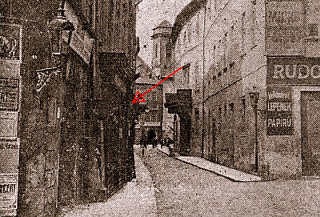
U staré paní was the pub where lathe operator Matějů had his jaw smashed by a brick. This is Švejk commenting that Mr. István was hit in they eye with a chicken.
Background
U staré paní was a pub in Staré město, now a restaurant and hotel.
Quote(s) from the novel
[III.2] To vyrazili ,U starý paní’ soustružníkovi Matějů celou sanici cihlou za dvacet zlatejch, s šesti zubama, a tenkrát měly peníze větší cenu než dnes.
Literature
- Románové restaurační a jiné zábavní podniky2009 - 2021
 | Filipa |  | |||
| |||||
Filipa is part of Švejk's perception of Leutnant Dub's quote from Shakespeare on Philippi. In a conversation with cook Jurajda he concludes that Dub is a "buserant" (homosexual).
Background
Filipa was by interpreting the text a meeting place for homosexuals, surely somewhere in Prague.
Quote(s) from the novel
[III.2] „Pro nás, poslušně hlásím, pane lajtnant. Podívejte se, co má sádla.“ Poručík Dub odcházel bruče: „U Filippi se sejdeme.“ „Cože ti říkal?“ obrátil se k Švejkovi Jurajda. „Ale dali jsme si schůzku někde u Filipy. Voni tihle vznešení páni bejvají obyčejně buseranti.“



|
III. The famous thrashing |
 | |
3. From Hatvan to the borders of Galicia | |||
 | U Rozvařilů |  | |||
| Praha II./1047, Na Pořící 24 | |||||
| |||||

U Rozvařilů is mentioned in the anecdote about Oberst Fliedler.
Background
U Rozvařilů was a brewery and restaurant at Pořící, also offering entertainment in the form of concerts.
The enterprise still exists (2010), albeit in another form: as a restaurant in the department store Bílá Labuť. The original building has obviously been demolished.
Quote(s) from the novel
[III.3] Železnýmu už to bylo všechno jedno. Tak jak šli přes Poříč, kolem Rozvařilů, Železný skočil do průjezdu a ztratil se mu průchodem a zkazil Kaučukovýmu dědkovi tu velikou radost, až ho bude sázet do arestu.
Literature
- Románové restaurační a jiné zábavní podniky2009 - 2021
 | U Bucků |  | |||
| Praha II./1046, Na Pořící 22 | |||||
| |||||
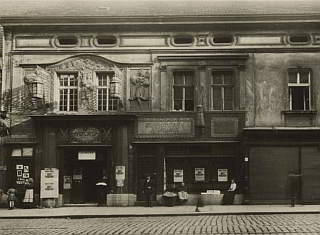
U Bucků is mentioned in the anecdote about Oberst Fliedler.
Background
U Bucků was a brewery with restaurant at Pořící in Prague, next door to U Rozvařilů.
Quote(s) from the novel
[III.3] Až takhle jednou vod našeho regimentu podařilo se jednomu probodnout jednoho dragouna v hospodě ,U Bucků’, kterej mu chodil za holkou, a tu nás seřadili do čtverce, museli vyjít všichni, i marodka, kdo byl moc marod, toho dva drželi.
Literature
- Románové restaurační a jiné zábavní podniky2009 - 2021
- Nejstarří zpevní síň6.2.1896
 | Šimáček |  | |||
| |||||

Šimáček is indirectly mentioned by Leutnant Dub who points to a melodramatic article about the killings Sarajevo in the magazine publisher Šimáček's Four-leaved Clover from July 1914.
Background
Šimáček was a Czech publishing house founded by František Šimáček in 1856. In 1914 it was managed by Bohuslav Šimáček. They published the illustrated magazine Šimáčkův čtyřlístek which is referred to in The Good Soldier Švejk. The magazine appeared twice a month. The company was located in Jerusalémská ulice in Nové město.
Quote(s) from the novel
[III.3] Nadporučík Lukáš jen zamručel k sobě, že asi zde v Humenném četníci odebírali Šimáčkův Čtyřlístek s tím dojemným článkem. Vůbec se mu počalo vše najednou hnusit a cítil jenom potřebu opít se, aby ho opustil světobol. Vyšel tedy z vagonu a šel vyhledat Švejka.
 | Vilímek |  | |||
| |||||
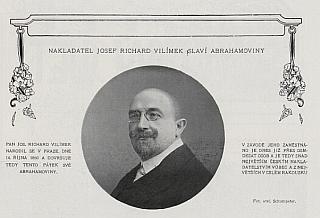
,14.10.1910
Vilímek is mentioned by Einjährigfreiwilliger Marek when he refers to their magazine The Illustrated War Correspondent and their material from the Russo-Japanese war of 1904-1905.
Background
Vilímek was a Czech publishing house founded in 1858 by Josef Richard Vilímek (1835-1911). His identically named son (1860-1938) took over in 1886 and they became on of the three largest publishers in the Bohemia and later in Czechoslovakia.
The company was nationalised and closed after the Communist coup in 1948. It briefly re-emerged as a brand-name after the 1989 revolution, only to disappear in a privatisation scandal.
The magazine mentioned, Ilustrovaný válečný zpravodaj is not listed in the catalogue of the Czech National Library so the author surely had Obrazový zpravodaj z bojiště in mind. It was printed by Unie in 1904-1905 and edited by Jan Klecanda (1855-1920), the father of explorer Havlasa.
Quote(s) from the novel
[III.3] Zajímavé bude, jak náš batalion přepadne spícího nepřítele, k čemuž ovšem je potřeba slohu ,Ilustrovaného válečného zpravodaje’, který vycházel u Vilímka za rusko-japonské války.
Sources: Sergey Soloukh
Literature
 | Na zastávce |  | |||
| Královské Vinohrady/713, Palackého tř. 78 | |||||
| |||||
Na zastávce was one of the pubs where gardener Kalenda made a stop on his world tour. A pub with the same name is mentioned again in the next chapter in the anecdote about the construction site foreman who was not to drink alcohol.
Background
Na zastávce was seemingly a pub in Vinohrady. It is most probably referred to a pub in Palackého třída 713, now Franczouska. There were nevertheless two other pubs with this name in Prague but none of them fit the route of gardener Kalenda.
Quote(s) from the novel
[III.3] Strašnickej zahradník, nějakej Josef Kalenda, ten se taky jednou vzdálil z domova, šel ze Strašnic na Vinohrady, stavil se ,Na zastávce’ v hospodě, ale to mu ještě nic nebylo, ale jakmile přišel do Korunní třídy k vodárně, bral v Korunní třídě až za kostel svaté Ludmily hospodu za hospodou a cítil už malátnost.
 | Vinohradská vodárna |  | |||
| |||||
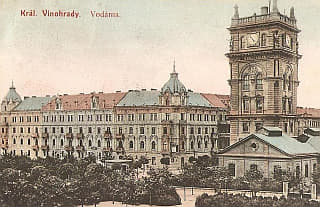
Vinohradská vodárna, 1905
Vinohradská vodárna was the place where gardener Kalenda started to enter pubs on his way around the world.
Background
Vinohradská vodárna is a former water tower in Korunní třída, a neo-renaissance building finished in 1891.
Quote(s) from the novel
[III.3] Strašnickej zahradník, nějakej Josef Kalenda, ten se taky jednou vzdálil z domova, šel ze Strašnic na Vinohrady, stavil se ,Na zastávce’ v hospodě, ale to mu ještě nic nebylo, ale jakmile přišel do Korunní třídy k vodárně, bral v Korunní třídě až za kostel svaté Ludmily hospodu za hospodou a cítil už malátnost.
 | Kostel svaté Ludmily |  | |||
| |||||
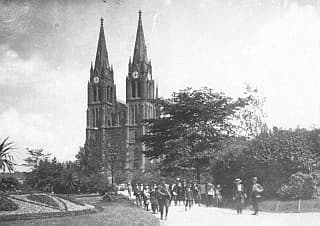
Pohled na náměstí Míru s kostelem sv. Ludmily s parkovou úpravou (kol. 1900)
Kostel svaté Ludmily is amongst the many places mentioned in Švejk's long anecdote about gardener Kalenda. He walked past this church on his world tour.
Background
Kostel svaté Ludmily is a twin-spired, neo-gothic church at Náměstí míru in Vinohrady that was opened in 1893. Jaroslav Hašek married Jarmila Mayerová here on 23 May 1910.
Quote(s) from the novel
[III.3] Strašnickej zahradník, nějakej Josef Kalenda, ten se taky jednou vzdálil z domova, šel ze Strašnic na Vinohrady, stavil se ,Na zastávce’ v hospodě, ale to mu ještě nic nebylo, ale jakmile přišel do Korunní třídy k vodárně, bral v Korunní třídě až za kostel svaté Ludmily hospodu za hospodou a cítil už malátnost.
 | U remisy |  | |||
| Královské Vinohrady/107, Jungmannova tř. - | |||||
| |||||
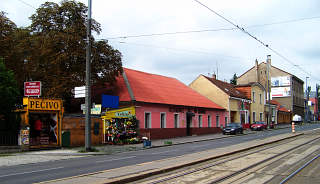
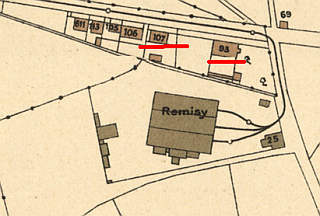
Map from 1911
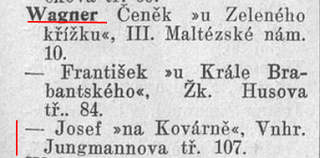
U remisy was the pub where gardener Kalenda from Švejk's anecdote made a bet with a tram driver from that he could walk around the earth in three weeks.
Background
U remisy was apparantly a pub in Strašnice, to judge by the name near a tram depot (vozovna). There is a tram depot in Strašnice still, located in Vinohradská třída. It was opened in 1908 and was the oldest of its kind in Prague.
In 1910 there were three taverns close to the tram depot, two of them next door at Jungmannová třida 93 and 107. The landlords were Josef Šmíd and Josef Wagner respectively. Both are listed as na Kovárně but may still have been known as "U remisy" in day to day speak. The exact identification is therefore difficult, but Wagner's pub is probably the best bet as he is the only one listed in the address book for Vinohrady from 1912.
Note that the border between Strašnice and Vinohrady went between the tram depot and the two pubs but Švejk would probably not have been aware of this fine distinction.
A restaurant with the same name in the same place still existed in 2010 although the address was very different both with respect to street names and house numbering.
Quote(s) from the novel
[III.3] Nedal se však tím odstrašit, poněvadž se vsadil předtím ten večer v Strašnicích v hospodě ,U remisy’ s jedním řídičem vod elektriky, že udělá pěšky cestu kolem světa za tři neděle. Počal se tedy dál a dál vzdalovat vod svýho domova, až se přivalil do ,Černýho pivovaru’ na Karlově náměstí, a vodtamtuď šel na Malou Stranu k Sv. Tomáši do pivovaru a odtamtud přes restauraci ,U Montágů’ a ještě vejš přes hospodu ,U krále brabanskýho’, pak na ,Krásnou vyhlídku’, odtud do Strahovskýho kláštera do pivovaru.
 | Černý pivovar |  | |||
| Praha II./292, Karlovo nám. 15 | |||||
| |||||
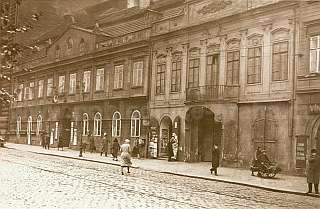
Černý pivovar was one of the pubs gardener Kalenda dropped by on his legendary pub crawl (world tour).
Background
Černý pivovar was a brewery and restaurant with address Karlovo náměstí 15. In 1891 it was registered in the name of František Fiala and was operating until 1920.
In 1934 the restaurant re-opened in the new building constructed on the site but we don't know when it closed down again. The bulding still exists but has an entirely different function.
Quote(s) from the novel
[III.3] Počal se tedy dál a dál vzdalovat vod svýho domova, až se přivalil do ,Černýho pivovaru’ na Karlově náměstí, a vodtamtuď šel na Malou Stranu k Sv. Tomáši do pivovaru a odtamtud přes restauraci ,U Montágů’ a ještě vejš přes hospodu ,U krále brabanskýho’, pak na ,Krásnou vyhlídku’, odtud do Strahovskýho kláštera do pivovaru.
Sources: Jaroslav Šerák
Also written:Black BreweryenSchwarze BrauereideSvarte Bryggerino
Literature
 | U svatého Tomáše |  | |||
| Praha III./28, Letenská ul. 20 | |||||
| |||||

U svatého Tomáše was one of the pubs gardener Kalenda dropped by.
Background
U svatého Tomáše was a restaurant and brewery in Malá Strana, known for their dark beer. It was one of the oldest breweries in Bohemia but closed in 2006 when the building was converted to a hotel.
Quote(s) from the novel
[III.3] Počal se tedy dál a dál vzdalovat vod svýho domova, až se přivalil do ,Černýho pivovaru’ na Karlově náměstí, a vodtamtuď šel na Malou Stranu k Sv. Tomáši do pivovaru a odtamtud přes restauraci ,U Montágů’ a ještě vejš přes hospodu ,U krále brabanskýho’, pak na ,Krásnou vyhlídku’, odtud do Strahovskýho kláštera do pivovaru.
 | U Montágů |  | |||
| Praha III./6, Malostranské nám. 19 | |||||
| |||||

U Montágů was one of the pubs gardener Kalenda dropped by.
Background
U Montágů was a restaurant at Malostranské náměstí which in 1891 and even as late as 1910 was owned by Antonín Janda. The building U Montágů still exists but is better known by the name Palác Smiřických. It is a part of the building complex that is used as a seat of the Chamber of Deputies of the Czech Parliament. Note that the pub was in the next building down, also known as Šternberský palác.
Quote(s) from the novel
[III.3] Počal se tedy dál a dál vzdalovat vod svýho domova, až se přivalil do ,Černýho pivovaru’ na Karlově náměstí, a vodtamtuď šel na Malou Stranu k Sv. Tomáši do pivovaru a odtamtud přes restauraci ,U Montágů’ a ještě vejš přes hospodu ,U krále brabanskýho’, pak na ,Krásnou vyhlídku’, odtud do Strahovskýho kláštera do pivovaru.
Sources: Jaroslav Šerák
 | U krále brabantského |  | |||
| Praha III./198, Thunovská ul. 15 | |||||
| |||||
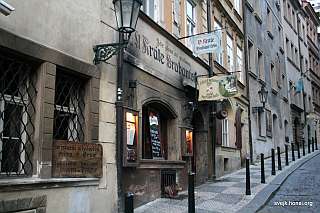
U krále brabantského, 2011
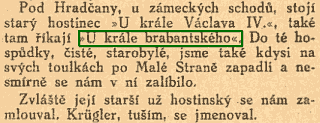
Ladislav Hájek, 1925

Humoristické listy, 27.8.1915
U krále brabantského was one of the eight named pubs that gardener Kalenda visited on his world tour which ended up as a gigantic pub-crawl.
It was also probably here that Blahník and Švejk planned the dog-theft in [I.14]. See Malý výčep piva and Zámecké schody.
Background
U krále brabantského is one of the oldest existing pubs in Prague, now (2010) part of a chain which uses the Medieval times as a theme. According to their web page it was opened as early as 1375 and has been operating almost continuously ever since.
Hašek and the King of Brabant
Hájek provides a number of details about the establishment, and describes his visits there with Hašek, Opočenský, Lada a.0. He remembers the entertaining landlord Krügler, a former regiment musician. The landlord was good at whistling and playing drums with his fingers. He also entertained his guests with his story telling.
In one of the stories Krüger claims it that a former landlord murdered a guest who defrauded him and dumped the body in the underground sever on the street. The body, with the head down the sever and feet sticking up, was only found further down the street when the sewer flooded a few days later. This grotesque tale was one of Hašek's favourites.
Another story that Hašek also liked was about a group of schoolchildren from the countryside who were treated by the landlord to beer and sausages. They thanked the landlord by singing, although he would rather have been paid! This story was eventually published by Antonín Nečásek in Humoristické listy.
In the end Hájek and his friends stopped going there after Hašek caused an outrage by tearing apart a painting of king Václav IV.
Used for secret meetings
Sergey Soloukh points to an important note by Zdeněk Matěj Kuděj in his book Ve dvou se to lépe táhne. Kuděj describes the tavern as dark and dingy, popular for secret meetings. This information alone makes the pub a good candidate as host for the conspirational meeting between Švejk and Blahník in the novel.
Landlords

Věstník obecní královského hlavního města Prahy, 13.7.1912
The address books show that the landlord in 1891 was František Simáček, and in 1907 and 1910 a Josef Král ran the bar. He was succeeded by Emanuel Klucker (born in Graz in 1867) who on 4 July 1912 was granted a license by the city magistrate to serve alcohol at the premises.
Klucker was a colourful character with a background as regiment musician, vividly described by Antonín Nečásek in Humoristické listy in 1915. His tavern struggled in the beginning but already by 1915 it was thriving. Klucker (also written Kluker) was definitely the landlord "Krügler" that Hájek described. Klucker was not new in the restaurant business: in 1907 he was running U Pavlanských at Újezd 25, also in Malá Strana.
Murder
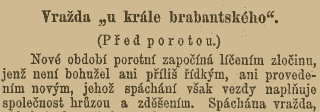
,18.5.1885

,16.12.1884
The murder that Klucker describes (as retold by Hájek) took place in the early hours of 10 December 1884, but the victim was landlord Václav Petráň, not a guest. He was robbed and in the resulting fight he was suffocated. The body was thrown into the sewers outside the pub and discovered a few days later after a flood.
The murderer Antonín Hrdlička was arrested four days later and put on trial in May 1885. The case was heard for two days and the verdict fell on 19 May 1885. Hrdlička was sentenced to death by hanging but on 11 July the sentence was converted to life imprisonment through an imperial decree. The case was widely reported in newspapers across Austria.
Quote(s) from the novel
[III.3] Počal se tedy dál a dál vzdalovat vod svýho domova, až se přivalil do ,Černýho pivovaru’ na Karlově náměstí, a vodtamtuď šel na Malou Stranu k Sv. Tomáši do pivovaru a odtamtud přes restauraci ,U Montágů’ a ještě vejš přes hospodu ,U krále brabanskýho’, pak na ,Krásnou vyhlídku’, odtud do Strahovskýho kláštera do pivovaru.
Sources: Sergey Soloukh
Also written:U krále brabanskýhoŠvejk
Literature
- Hostinec opředený mnoha bájemi a legendami
- Швейк. Время 3. Шаг 7
- Pobytové přihlášky pražského policejního ředitelství1851 - 1914
- U krále Václava z Brabantu27.8.1915
- Z mých vzpomínek na Jaroslava Haška1925
- Adressář královského hlavního města Prahy
- Adresář královského hlavního města Prahy a obcí sousedních1907
- Ein Vermißter11.12.1884
- Loupežná vražda v Praze15.12.1884
- Der Raubmord in den Thun'schen Gasse18.5.1885
- Vražda "u krále brabantského"18.5.1885
- Vražda "u krále brabantského"19.5.1885
- Vražda "u krále brabantského"20.5.1885
- Begnadigt12.7.1885
- Dostal milost12.7.1895
- Věstník obecní královského hlavního města Prahy13.7.1912
 | Strahovský klášter |  | |||
| |||||
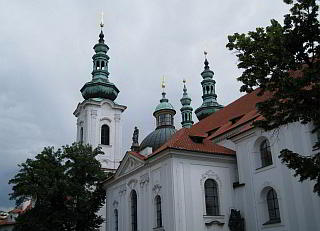
Strahovský klášter is mentioned because gardener Kalenda popped into the monastery brewery just before homesickness overwhelmed him.
Background
Strahovský klášter is a monastery on the Strahov Hill in Prague and one of the Czech capitals many beautiful landsmarks. It is situated in the Hradčany area, not far from the castle itself. It belongs to the Premonstratensians order and was founded around 1140.
Quote(s) from the novel
[III.3] Počal se tedy dál a dál vzdalovat vod svýho domova, až se přivalil do ,Černýho pivovaru’ na Karlově náměstí, a vodtamtuď šel na Malou Stranu k Sv. Tomáši do pivovaru a odtamtud přes restauraci ,U Montágů’ a ještě vejš přes hospodu ,U krále brabanskýho’, pak na ,Krásnou vyhlídku’, odtud do Strahovskýho kláštera do pivovaru.
Also written:Strahov MonasteryenKloster StrahovdeStrahovklosteretno
 | Strahovský pivovar |  | |||
| Praha IV./135, Strahovské nádvoří 10 | |||||
| |||||
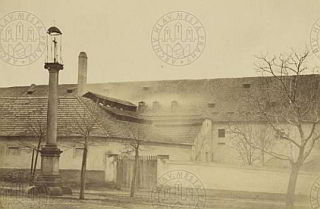
Strahovský pivovar, 1867

,1.12.1900

,20.1.1910
Strahovský pivovar was the final stop on the odyssey of gardener Kalenda, before homesickness got the better of him down at Loretánské náměstí.
Background
Strahovský pivovar was a brewery and restaurant that appeared to have closed down some time before 1919, and is listed in the address books at least from 1870 to 1910. Beer has been brewed on the site at least since the 15th century, although not continuously.
Before the First World War
Tenant from 1896 to 1908 was Jan Řezníček (born 1841) and he was also the last ever brew master to make beer on the monastery premises in the 20th century. In 1899 the production volume was 2,304 hectolitres. In a speech at the 1908 Jubilee exhibition in Prague Řezníček informed that the brewery had been operating since 1780.
The brewery ceased operation in the autumn of 1908 and Řezníček took on a similar position in Stará Boleslav. In 1910 the restaurant part was re-opened after refurbishment but now with beer from the Smíchov brewery and František Švancar as landlord.
New beginning
In 2000 a microbrewery with restaurant called Klášterní pivovar Strahov was established on the same site but has no connection with the old brewery.
Quote(s) from the novel
[III.3] Počal se tedy dál a dál vzdalovat vod svýho domova, až se přivalil do ,Černýho pivovaru’ na Karlově náměstí, a vodtamtuď šel na Malou Stranu k Sv. Tomáši do pivovaru a odtamtud přes restauraci ,U Montágů’ a ještě vejš přes hospodu ,U krále brabanskýho’, pak na ,Krásnou vyhlídku’, odtud do Strahovskýho kláštera do pivovaru.
Literature
- Autentický ukazatel ulic a náměstí i čísel domovních král. hl. města Prahy, 1870
- Adressář královského hlavního města Prahy a sousedních obcí, 1884
- Personalien15.3.1896
- Z kruhů pivovarnických17.3.1896
- Biererzeugung Böhmens im Jahre 18991.12.1900
- Pivovarství na pražské vystavě 190820.7.1908
- Die Brauindustrie auf der Prager Ausstellung 190820.7.1908
- Nájmy1.9.1908
- Kassierte Brauereien10.12.1908
- Zrušené pivovary10.12.1908
- Personalnachrichten5.12.1911
- Soupis pražských domovských příslušníků 1830-1910 (1920)
- Historie pivovaru
 | Odkolek |  | |||
| |||||
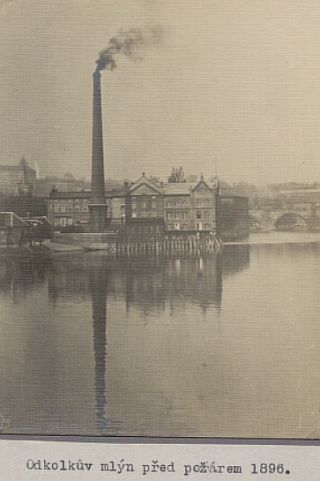
Zmizelá Praha sv.5, 1919
Odkolek and the fire at their mills are mentioned by Švejk in his sleep when he slept away the effects of the bottle of cognac at the station in Humenné.
Background
Odkolek was a flour mill and bakery which was founded by František Odkolek in 1850. The fire referred to happened in 1896, and it was the original mill at Kampa that burnt down.
It was not reconstructed, a new mill was built at Vysočany instead. The factory is now owned by United Bakeries. The old mill has since been rebuilt and today it houses Muzeum Kampa.
Quote(s) from the novel
[III.3] Jednoroční dobrovolník začal budit Švejka. „Švejku, hoří, vstávej!“ „Když tenkrát hořely Odkolkovy mlejny,“ zabručel Švejk, obraceje se opět na druhý bok, „přijeli hasiči až z Vysočan...“
Literature
 | Polevkové ústav města Prahy |  | |||
| |||||
Polevkové ústav města Prahy is mentioned by Švejk during a discussion on Einjährigfreiwilliger Marek's invented story about Rechnungsfeldwebel Vaněk's glorious death. This scene took place on the train just before Sanok.
Background
Polevkové ústav města Prahy has sureley been a municipal institution that ran soup kitchens, but further information is not available.
Jaroslav Hašek also wrote a short story called Polevkový ústav, which might reveal more information.
Quote(s) from the novel
[III.3] „Moh to ten náš nebožtík,“ řekl Švejk, „vodevzdat polívkovýmu ústavu města Prahy, ale takhle je to přeci jen lepší, von by si třeba pan starosta za ten vobnos koupil jitrnici na gábl.“
Also written:Soup institute of the city of PragueenSuppenanstalt der Stadt Pragde



|
III. The famous thrashing |
 | |
4. Forward March! | |||
 | Gimnazjum |  | ||||
| ||||||
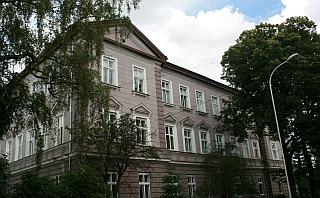
Szkoła Podstawowa nr 8, Sanok, 2010.

The gymnasium in Sokal where parts of IR. 91 rested from 1 to 2 August 1915.
© Daniel Abraham
Gimnazjum is mentioned 9 times in The Good Soldier Švejk.
Gimnazjum was where the march battalion was meant to be lodged in Sanok. They stayed only for a few hours because the reserves of the German Hanover division soon laid claim to it.
Background
Gimnazjum is assumed to be Szkoła Podstawowa nr 8 w Sanoku, a gymnasium (middle school) in the centre of Sanok that is still in use. The name of the school is not explicitly mentioned in The Good Soldier Švejk but a town the size of Sanok would probably not hosted more than one gymnasium, at least not in the centre.
Mystification becoming reality
Despite this apparent obviousness it would be prudent to take the information from The Good Soldier Švejk with a pinch of salt. XII. Marschbataillon of Infanterieregiment Nr. 91 with Jaroslav Hašek surely never set foot here, at least not under the circumstances described in the novel.
Thus Hašek probably drew from his experiences elsewhere, and the gymnasium in Sokal is the only similar institution where the regiment during Hašek's service is known to have been lodged[a]. There could of course have been others but Sanok was definitely not one of them.
Early history
The school was built in 1880 and until 1922 it had the name Gimnazjum Męskiego (Men's Middle School). In 1906 it catered for 820 pupils, amongst them of 520 Polish, 170 Rusyns and 70 Jewish[b].
Quote(s) from the novel
[III.4] U slečny Elly byl pan poručík Dub, který, když maršbatalion byl už ve svých ubikacích v gymnasiu, zavolal si celý svůj šik a upozorňoval jej v dlouhé řeči, že Rusové při svém ústupu zakládali všude bordely s personálem pohlavně nakaženým, aby způsobili rakouské armádě tímto svým trikem velké ztráty.
Also written:Gymnasium in SanokenGymnas in SanokdeGymnas i Sanokno
Literature
- 454. Sitzung des Abgeordnetenhauses9.5.1879
- Schulwesen1.12.1880
- Po Švejkových (a Haškových) stopách v HaličiJosef Schwarz2006
| a | Válečný deník Jana Vaňka | 2014 | |
| b | Historia szkoła | 2024 |
 | Bank Krakowski |  | ||||
| ||||||
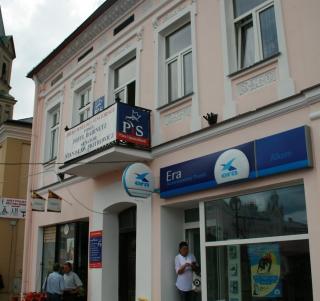
Bank Krakowski was the headquarters of the Eiserne Brigade (Iron Brigade) staff but these also had be evacuated for the benefit of the reserves of the Hanover division.
Background
Bank Krakowski was a reportedly bank at the Sanok town square (Rynek) but the information is not very solid. The building still exists but now (2010) it has other uses.
Quote(s) from the novel
[III.4] Plukovník reserv hanoverské divise ukazoval totiž disposice svého štábu, že má ubytovat své mužstvo v gymnasiu, kde právě nyní byli ubytováni jednadevadesátníci. Pro umístění svého štábu žádal vyklizení domu krakovské banky, ve kterém právě byl štáb brigády.
Also written:Krakovská Bankacz
Literature
- Po Švejkových (a Haškových) stopách v HaličiJosef Schwarz2006
 | Kawiarnia Miejska |  | ||||
| ||||||
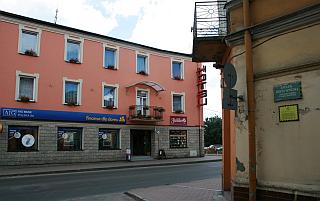
Hotel Pod Trzema Różami
Kawiarnia Miejska was the café/brothel in Sanok that Leutnant Dub inspected so throurougly that Švejk had to go and grab him so he could take part in the trip onwards. Švejk here showed that he could be forceful and decisive.
Background
Kawiarnia Miejska is said to have existed and is claimed still be functioning as Hotel Pod Trzema Różami (Under the three Roses). At present (2010) it is a normal decent hotel with a restaurant/pizzeria attached. It should be added that Jaroslav Hašek and XII. Marschbataillon never passed through Sanok so the inspiration must be looked for somewhere else.
Quote(s) from the novel
[III.4] „Spojené zábavní místnosti a městská kavárna“, podnik, o kterém se Švejk zmiňoval, byly rozděleny také na dvě části. Kdo nechtěl jít přes kavárnu, šel zadem, kde se vyhřívala na slunci nějaká stará paní, která mluvila německy, polsky a maďarsky asi v tomto smyslu: „Pojďte, vojáčku, máme zde pěkné slečinky.“
Also written:City CaféenMěstská kavárnaczBykaféenno
| a | Po Švejkových (a Haškových) stopách v Haliči | Josef Schwarz | 2006 |
 | U Kocanů |  | |||
| Praha II./605, ve Smečkách 3 | |||||
| |||||
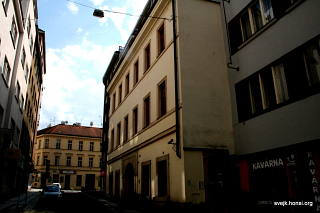
The building in 2011.
U Kocanů is mentioned in the angry letter from Božena that Švejk tells Oberleutnant Lukáš about on the march from Sanok.
Background
U Kocanů was a dance restaurant which according to Egon Erwin Kisch was identical to U města Slaného in Nové město. The unofficial name U Kocanů is taken from the former owner Karel Kocan who had sold the place some time before 1910. Kisch noted that the owner was Herr W. Kocourek, and this was definitely the case in 1910. He was even listed in the address book from 1936.
U města Slaného was one of eleven establishment soldiers from the garrison in Prague were forbidden to enter.
Quote(s) from the novel
[III.4] Pan kaprál Kříž přijel do Prahy na urláb a já jsem s ním tančila ,U Kocanů’, a von mně povídal, že prej ty tancuješ v Budějovicích ,U zelený žáby’ s nějakou pitomou flundrou a že jsi mě už úplně vopustil.
Sources: Milan Hodík, Hans-Peter Laqueur
Also written:Zum Stadt Schlande
 | U zelené žáby |  | |||
| |||||
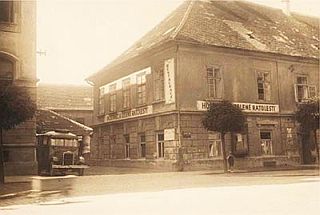
U zelené ratolesti
U zelené žáby is mentioned in the angry letter from Božena to Švejk. She had been informed by Korporal Kříž that Švejk had danced with a silly tart here. All this is revealed when Švejk empties his heart to Oberleutnant Lukáš during the march from Sanok.
Background
U zelené žáby was a pub in Budějovice that remains unidentified and surely never existed under this name. Božena probably mixed up U zelené ratolesti (At the green Wig) and U žaby (At the Frog).
The former was a coaching inn at Říšská třída (now Husová) next to Mariánská kasárna. It also arranged dancing and this fits well with the description in the novel. The building is still in use as a restaurant and pension and the name is the same.
U žaby was in 2015 a café at Piaristické náměstí, probably named after a stone frog on the façade of the church opposite. The name has surely been used as a name by inns at the square also in 1915, although this has not been verified.
Č. Beránek
Myslím že hospoda „U zelené žáby“ byla buď na Piaristickém náměstí, kde je to tradiční název (podle místní pověsti o žábě a konci světa) a i dnes jsou tam dva podniky „U žáby“, druhou (dle mne pravděpodobnější) je možnost, že Hašek když psal román si to popletl, kousek od kasáren 91IR (tak 100m) je hostinec „U zelené ratolesti“ což byl známý hostinec už od počátku 19. století, byl a je dodnes velký s prostory pro tančírnu a pokoji.
Quote(s) from the novel
[III.4] Pan kaprál Kříž přijel do Prahy na urláb a já jsem s ním tančila ,U Kocanů’, a von mně povídal, že prej ty tancuješ v Budějovicích ,U zelený žáby’ s nějakou pitomou flundrou a že jsi mě už úplně vopustil.
Sources: Jaroslav Šerák, Č. Beránek
Also written:The Green FrogenDen grøne froskno
Literature
 | Beseda |  | |||
| Praha II./1477, Vladislavova ul. 20 | |||||
| |||||
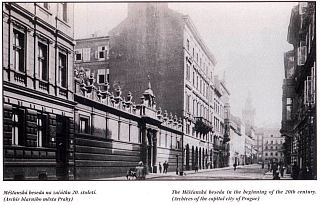
Beseda is mentioned by Švejk when he tells Oberleutnant Lukáš how unlucky he has been with the ladies.
Background
Beseda surely refers to Měšťanská beseda in Praha II.. The institution existed from 1845 until 1952 and the associated restaurant was in 1891 listed as belonging to Gustav Stejskal. The building has from 2008 hosted a four-star hotel.
Quote(s) from the novel
[III.4] To se ví, že se všichni smáli a její matinka, která ji tam hlídala, že ji vodvedla na chodbu v ,Besedě’ a že tu svou blbou nánu zkopala.
Also written:Burghers' ClubSadlon
Literature
- Románové restaurační a jiné zábavní podniky2009 - 2021
 | U Dvořáků |  | |||
| Praha I./774, Na Františku 44 | |||||
| |||||
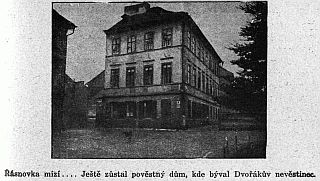
Konec bahna Prahy, , 1927
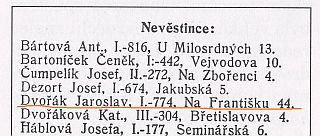
Encyclopedie Švejka díl II., ,1999
U Dvořáků was one of the brothels the tin-smith tinsmith Pimpra often ended up at when he went out to buy sheet metal. This is an anecdote Švejk appropriately tells Leutnant Dub after the latters escapades in a similar establishment in Sanok.
Background
U Dvořáků was a brothel in Staré město (Radko Pytlík). Milan Hodik underpins this information by providing a list of brothels from Chytilův adresář 1912[a]. It contains two entries with Dvořák as proprietor, but Jaroslav Dvořák is by far more likely, because the other address is in Malá Strana, and this story about tinsmith Pimpra is clearly set in Staré Město.
Quote(s) from the novel
[III.4] Ale to byl asi nějakej vomyl. Klempíře Pimpra z Kozího plácku taky vždycky hledali, když šel kupovat plech do města, a našli ho také vždycky v podobnej místnosti, buď u ,Šuhů’, nebo u ,Dvořáků’, jako já vás našel.
Sources: K.L. Kukla, Milan Hodík
Literature
 | Karmelitány |  | |||
| |||||
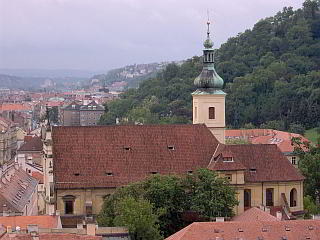
Karmelitány is mentioned by Švejk in the long anecdote about Mr. Jenom, bookbinder Bílek and the thundering fart.
Background
Karmelitány probably refers to kostel Panny Marie Vítězné in Malá Strana, Prague. It was owned by the Carmelitan order until 1784 and again from 1993.
Quote(s) from the novel
[III.4] Naproti karmelitánům v Praze měl, pane obrlajtnant, před lety krám s králíky a jiným ptactvem pan Jenom. Ten si udělal známost s dcerou knihaře Bílka.
 | Národní divadlo |  | |||
| |||||
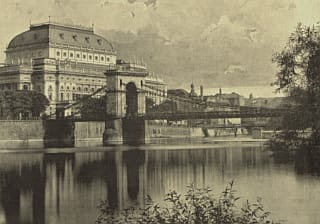
Světem letem, ,1896
Národní divadlo is mentioned in the anecdote about nadstrážník Hubička. The couple who got arrested in Resslova ulice had walked from the theatre to get some fresh air.
Background
Národní divadlo is the Czech National Theatre. The building was erected in neo-renaissance style in the years 1868-1883 and has become a national symbol.
Quote(s) from the novel
[III.4] Ekvipáž že je dovezla až za Národní divadlo a nyní že se chtí provětrat a bydlí nedaleko, na Moráni, on že je vrchní místodržitelskej rada s chotí.
 | Svatý Jindřich |  | |||
| |||||
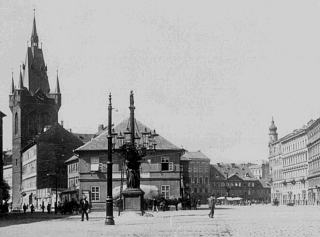
The police station in the middle
Svatý Jindřich where was the editor dressed as a policeman said he was stationed.
Background
Svatý Jindřich probably refers to a police station by kostel Svatého Jindřicha in Prague. There is no police station there today, but in Švejk's lifetime there was a police station at Havlíčkovo náměstí 979/35, an address which is very close to the mentioned church.
Quote(s) from the novel
[III.4] Ta paní už ani plakat nemohla a pan vrchní místodržitelský rada rozčilil se tak, že začal mluvit něco vo sprosťáctví, načež byl zatčen a předveden k nejbližší patrole v rayonu komisařství v Salmově ulici, které řekl převlečený redaktor, aby ten párek odvedli na komisařství, on že je od svatého Jindřicha a byl za služební cestou na Vinohradech, oba dopadl při rušení nočního klidu, při noční rvačce, a zároveň že ještě spáchali přestupek urážky stráže.



|
IV. The famous thrashing continued |
 | |
1. Švejk in the transport of russian prisoners of war | |||
 | Na Zavadilce |  | |||
| Karlín/68, Královská tř. 91 | |||||
| |||||
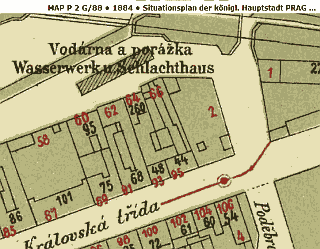
Na Zavadilce is mentioned in Švejk's comment to the conversation between Major Wolf and the captain where the formers conclusion is that Švejk is to be hanged after a summary trial. According to Švejk it was a pub in Libeň.
Background
Na Zavadilce has not been possible to identify with certainty. Any hospoda carrying this name doesn't seem to have existed in Libeň, but in Karlín there was a restaurant with this name. The location, Královská třída 91, isn't that far from Libeň, so it might be this one Švejk had in mind.
Quote(s) from the novel
[IV.1] Švejk, kterého vedli napřed a slyšel celý zajímavý rozhovor, neřekl nic jiného svým průvodčím než: „Pěšky jako za vozem. To jsme se vám jednou v hospodě ,Na Zavadilce’ v Libni hádali mezi sebou, jestli máme nějakýho kloboučníka Vašáka, kerej vždycky dělal při zábavě neplechu, vyhodit, hned jak se vobjeví ve dveřích, nebo ho vyhodit, až si dá pivo, zaplatí a dopije, nebo mu vyndat boty, až přetančí první kolo.
Literature
- Románové restaurační a jiné zábavní podniky2009 - 2021
 | Ratskeller |  | |||
| |||||
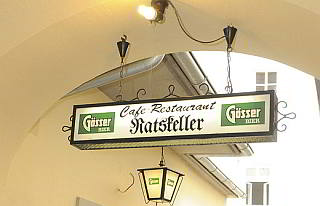
Ratskeller is the mentioned in the anecdote Švejk uses against the spy who enters his cell in Przemyśl.
Background
Ratskeller is a restaurant in Graz which is still in business. The address is Hauptplatz 17. The English translation of Cecil Parrott for some reason locates it to Steyr.
Quote(s) from the novel
[IV.1] Všechny lidi, který potkával na ulici, viděl buď na nádraží v Miláně, nebo s nimi seděl ve Štýrským Hradci v radničním sklepě při víně.
Also written:Townhall Cellaren
 | Lustige Blätter |  | |||
| Berlin/-, Markgrafenstraße 77 | |||||
| |||||
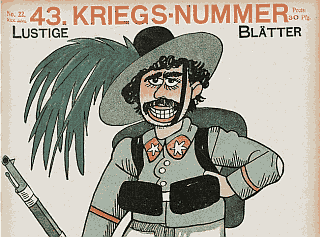
Lustige Blätter, 2.6.1915

Berliner Adreßbuch, 1915
Lustige Blätter is by the author mentioned as the publisher of some silly booklets that General Fink likes to quote from.
Background
Lustige Blätter was an illustrated humorous weekly that was published from 1886 to 1944. It was founded in Hamburg in 1886 by Alexander Moszkowski and Otto Eysler. The former was editor in chief until 1928 and in 1915 the publisher of the magazine was Verlag der "Lustigen Blätter" (Dr. Eysler & Co.) G.m.b.h.. Already in 1887 the editorial offices moved to Berlin.
Tornister-Humor series
From early 1915 they published a collection of patriotic booklets called Tornister-Humor, each of 64 pages. The author's description of the circumstances around the booklets is very accurate. In 1915 both Schloemp and Artur Lokesch contributed and Jaroslav Hašek correctly lists the names of some of the booklets the two were involved in[a]. He also mentions some subtitles but gives the impression that these were also full titles.
Quote(s) from the novel
[IV.1] Po všech instrukcích, které mu dával velitel garnisonní posádky, dával vždycky generál Fink něco ostrého nalít a potom mu vypravoval nejnovější anekdoty z nejblbějších svazečků, které pro vojsko byly vydány v „Lustige Blätter“. Měl celou knihovnu takových svazečků s pitomými názvy jako „Humor v tornistře pro oči i uši“, „Hindenburgovy anekdoty“, „Hindenburg v zrcadle humoru“, „Druhá tornistra plná humoru, naládovaná Felixem Schlemprem“, „Z našeho gulášového kanonu“, „Šťavnaté granátové třísky ze zákopů“, nebo tyto hovadiny: „Pod dvojitým orlem“, „Vídeňský řízek z c. k. polní kuchyně. Ohřál Artur Lokesch“. Někdy mu také předzpěvoval ze sbírky veselých vojenských písní „Wir müssen siegen!“, přičemž naléval neustále něco ostrého a nutil polního kuráta Martince, aby pil a hulákal s ním.
Sources: Antonín Měšťan
Literature
- Realien und Pseudorealien in Hašeks "Švejk"1983
- Lustige Blätter
- Tornister-Humor1.3.1916
- Alexander Moszkowski
| a | "Tornister-Humor" and 'The Good Soldier Švejk' | 10.5.2020 |



|
IV. The famous thrashing continued |
 | |
3. Švejk again with his march company | |||
 | Przemyśl City Baths |  | |||
| |||||
Przemyśl City Baths were paid a visit by Major Derwota who needed to repair his appetite the day after the giant party and the ensuing stay in Švejk's cell.
Background
Przemyśl City Baths is yet to be identified.
Quote(s) from the novel
[IV.3] Major na strážnici nedělal už žádných výstupů, zcela odměřeně poručil, aby došli pro drožku, a za drkocání drožky po mizerném dláždění Přemyšlu měl v hlavě jen ty představy, že delikvent je blbec prvního řádu, ale že to bude patrně přece jen nevinné hovado, a pokud se týká jeho, majora, že mu nic jiného nezbývá, než aby se buď zastřelil ihned, jak přijede domů, nebo aby si poslal pro plášť a šavli ke generálovi a jel se vykoupat do městských lázní a po vykoupání zastavil se ve vinárně u Vollgrubera, spravil si povšechně chuť a na večer objednal si po telefonu lístek na představení do městského divadla.
Also written:Přemyšl městské laznécz
 | Vollgruber |  | |||
| |||||
Vollgruber (or the nearby wine bar) was paid a visit by Major Derwota who needed to restore his appetite the day after the giant party and the ensuing stay in Švejk's cell.
Background
Vollgruber was some place in Przemyśl mentioned through a nearby wine bar, yet to be identified. According to Radko Pytlík it actually existed. It might also have been the name of the wine bar itself.
Quote(s) from the novel
[IV.3] Major na strážnici nedělal už žádných výstupů, zcela odměřeně poručil, aby došli pro drožku, a za drkocání drožky po mizerném dláždění Přemyšlu měl v hlavě jen ty představy, že delikvent je blbec prvního řádu, ale že to bude patrně přece jen nevinné hovado, a pokud se týká jeho, majora, že mu nic jiného nezbývá, než aby se buď zastřelil ihned, jak přijede domů, nebo aby si poslal pro plášť a šavli ke generálovi a jel se vykoupat do městských lázní a po vykoupání zastavil se ve vinárně u Vollgrubera, spravil si povšechně chuť a na večer objednal si po telefonu lístek na představení do městského divadla.
Sources: Radko Pytlík
 | Przemyśl City Theatre |  | |||
| |||||
Przemyśl City Theatre is mentioned in connection with Major Derwota and his tortured day after he had woken up in the cell with Švejk. Only after a visit to the city baths and a visit to the wine bar Vollgruber did he recover sufficiently to order tickets for the City Theatre.
Background
Przemyśl City Theatre is yet to be identified.
Quote(s) from the novel
[IV.3] Major na strážnici nedělal už žádných výstupů, zcela odměřeně poručil, aby došli pro drožku, a za drkocání drožky po mizerném dláždění Přemyšlu měl v hlavě jen ty představy, že delikvent je blbec prvního řádu, ale že to bude patrně přece jen nevinné hovado, a pokud se týká jeho, majora, že mu nic jiného nezbývá, než aby se buď zastřelil ihned, jak přijede domů, nebo aby si poslal pro plášť a šavli ke generálovi a jel se vykoupat do městských lázní a po vykoupání zastavil se ve vinárně u Vollgrubera, spravil si povšechně chuť a na večer objednal si po telefonu lístek na představení do městského divadla.
Also written:Přemyšl městské divadlocz
 | Bartůňkův mlýn |  | |||
| Kunratice/45, Kunratice - | |||||
| |||||
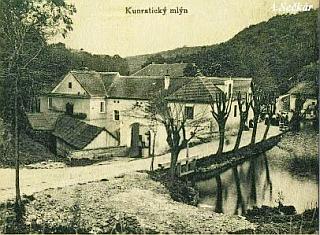
Kunratický mlýn, 1900
Bartůňkův mlýn is part of the anecdote about Mr. Hauber from Nusle who been on a Sunday trip and was stabbed by mistake in Kundratice on his way home.
Background
Bartůňkův mlýn is a mill by Kunratický potok (Kunratice stream) in south-eastern Prague. It is also called Dolní mlýn and Kunratický mlýn. The mill was built in 1764 and was from 1841 owned by the Bartůněk family. During Švejk's time the mill belonged to Jan Bartůněk. Attached to the mill was also a popular open-air restaurant.
Jaroslav Šerák
Je to Dolejší mlýn, Dolní mlýn. Má dodnes č.p. 45 a podle skizzy Josefského katastru z roku 1841 ho vlastnil skutečně Johann Bartůněk.
Quote(s) from the novel
[IV.3] Takovej člověk musí bejt skromnej a trpělivej. V Nuslích je nějakej pan Hauber, toho jednou v neděli v Kundraticích na silnici píchli omylem nožem, když šel z výletu od Bartůňkovýho mlejna. A von s tím nožem v zádech přišel až domů, a když mu žena svlíkala kabát, tak mu ho pěkně vytáhla ze zad a dopoledne už s tím nožem rozkrajovala maso na guláš, poněvadž byl ze solingenský vocele a pěkně nabroušenej a voni měli doma všechny nože pilkovatý a tupý.
Also written:Bartůněk's MillParrottBartůněk's millSadlon
Literature
- Dolní kunratický, Bartůňkův mlýn
- Do Kunratického mlýna13.5.1899
- Z metropole29.8.2015
| © 2008 - 2024 Jomar Hønsi | Last updated: 14.5.2024 |


